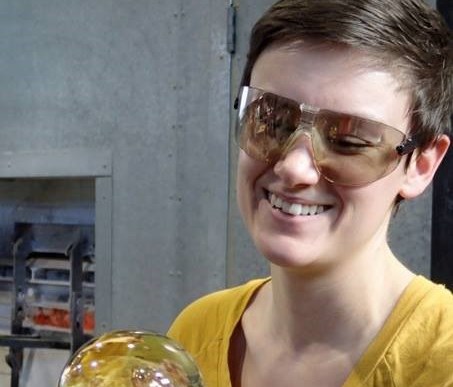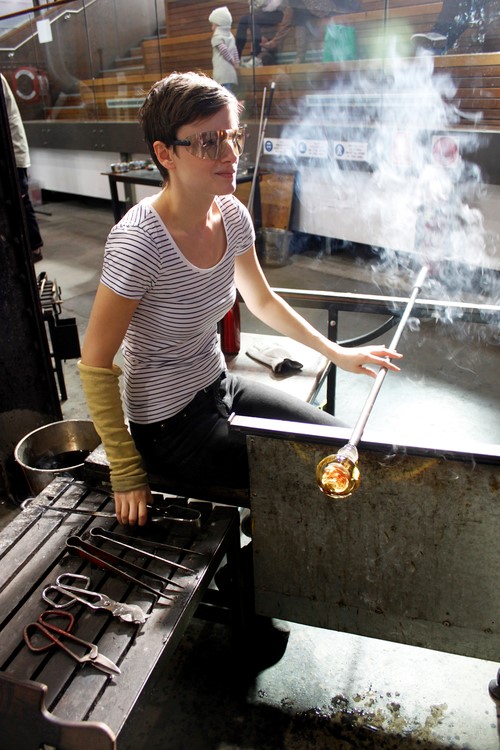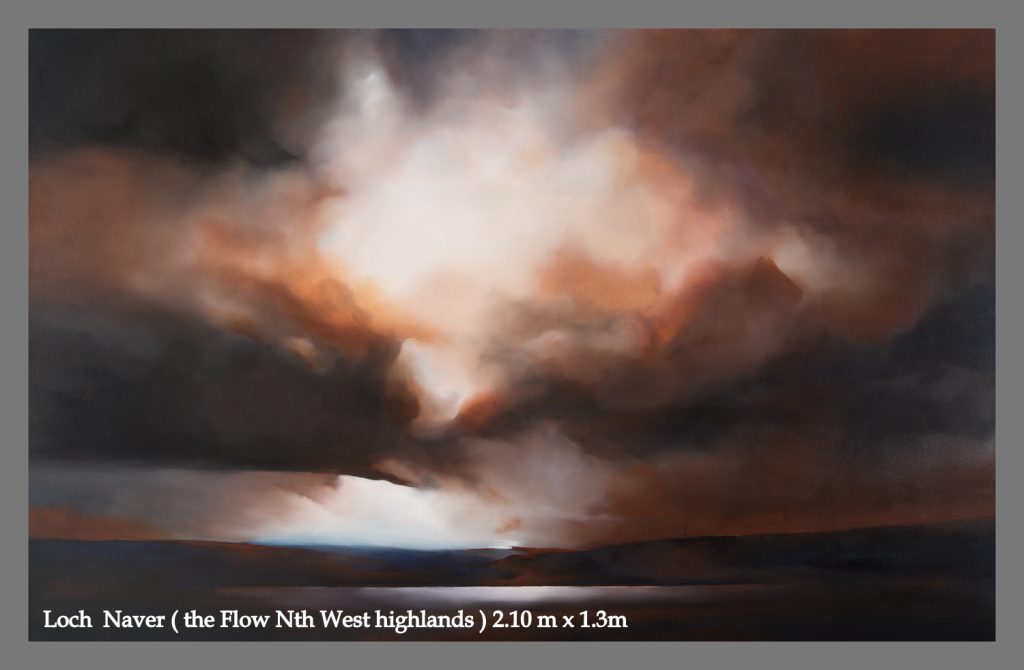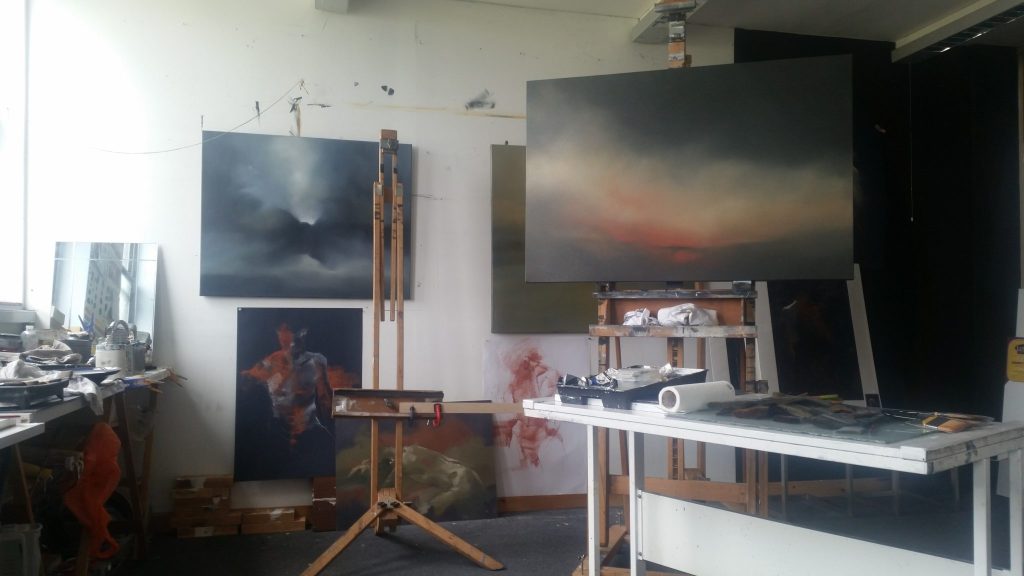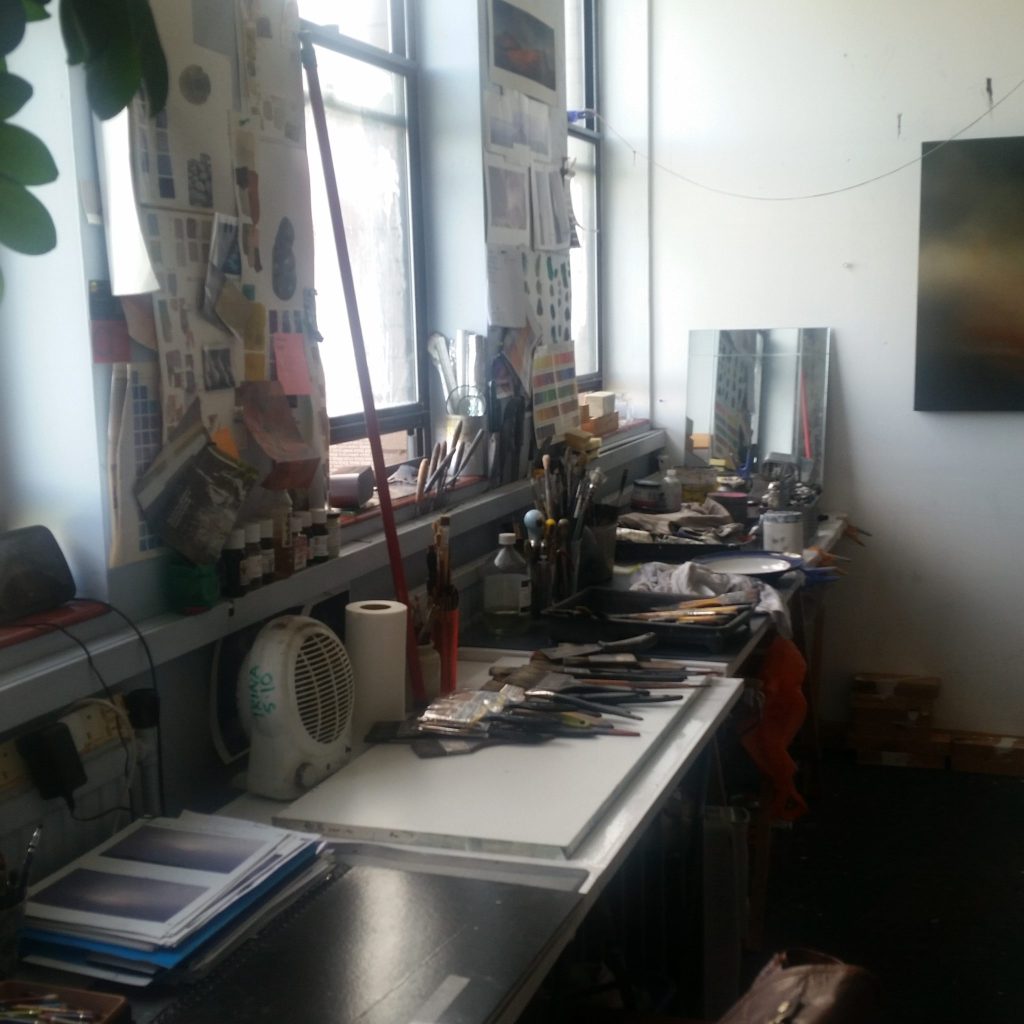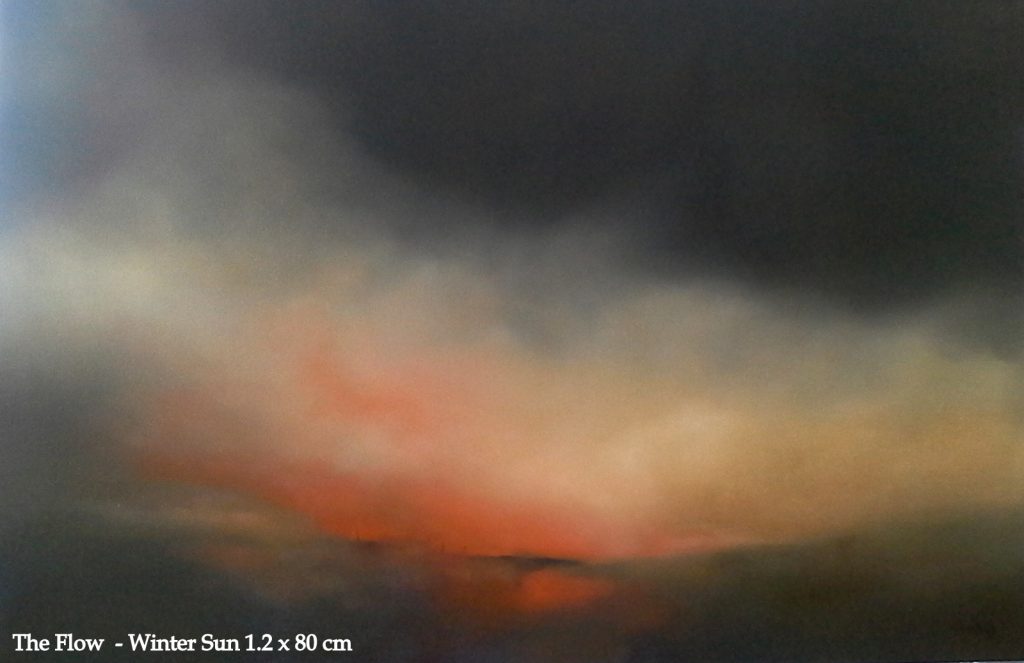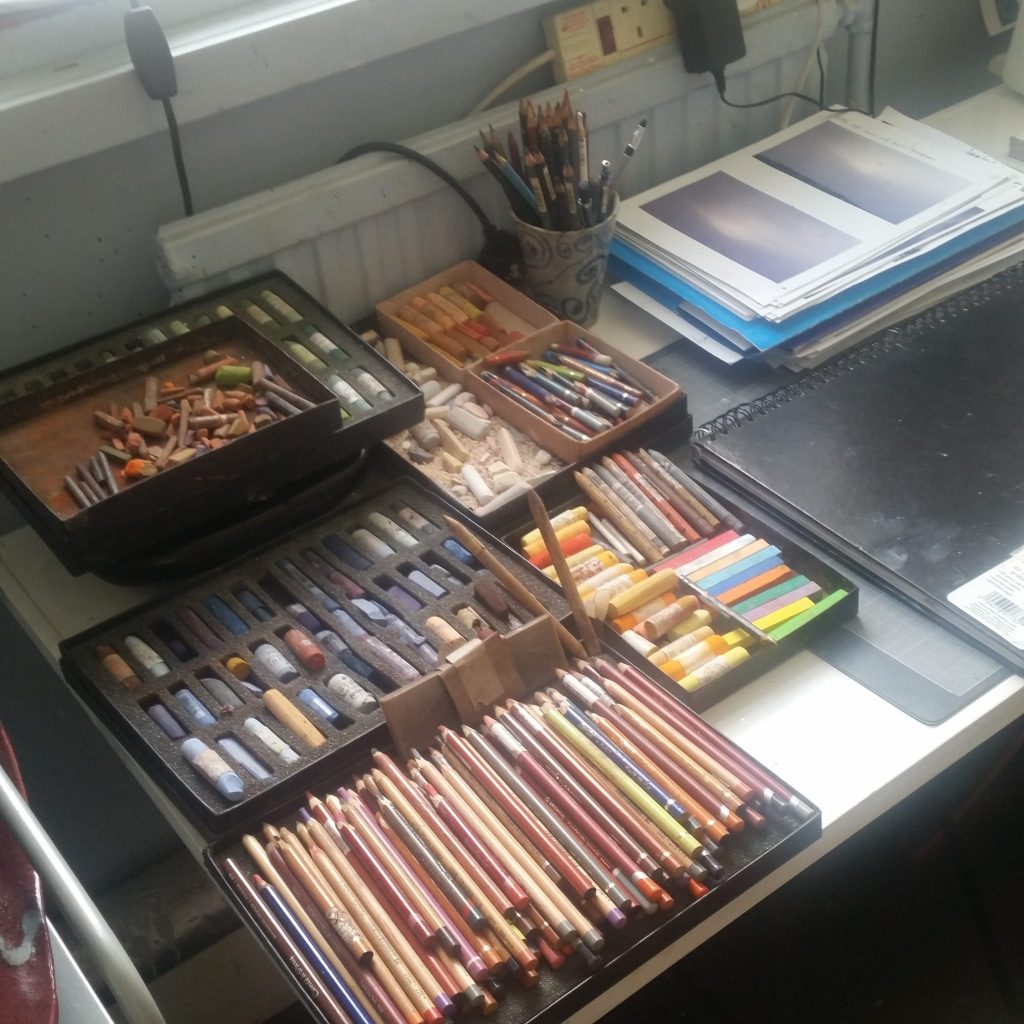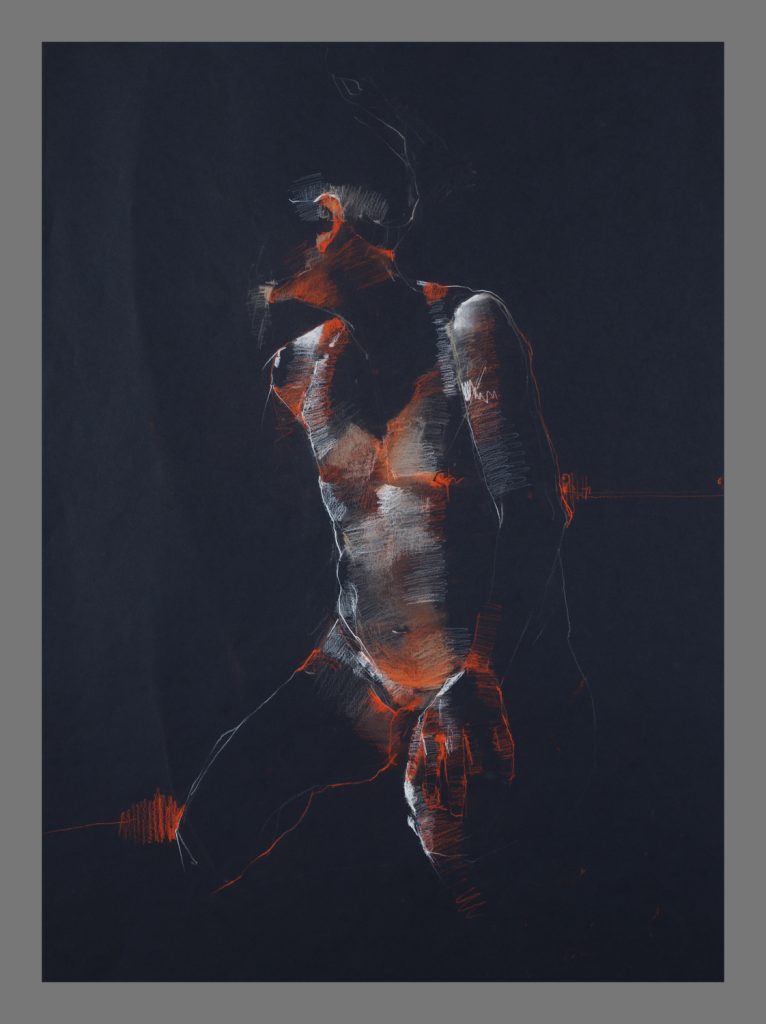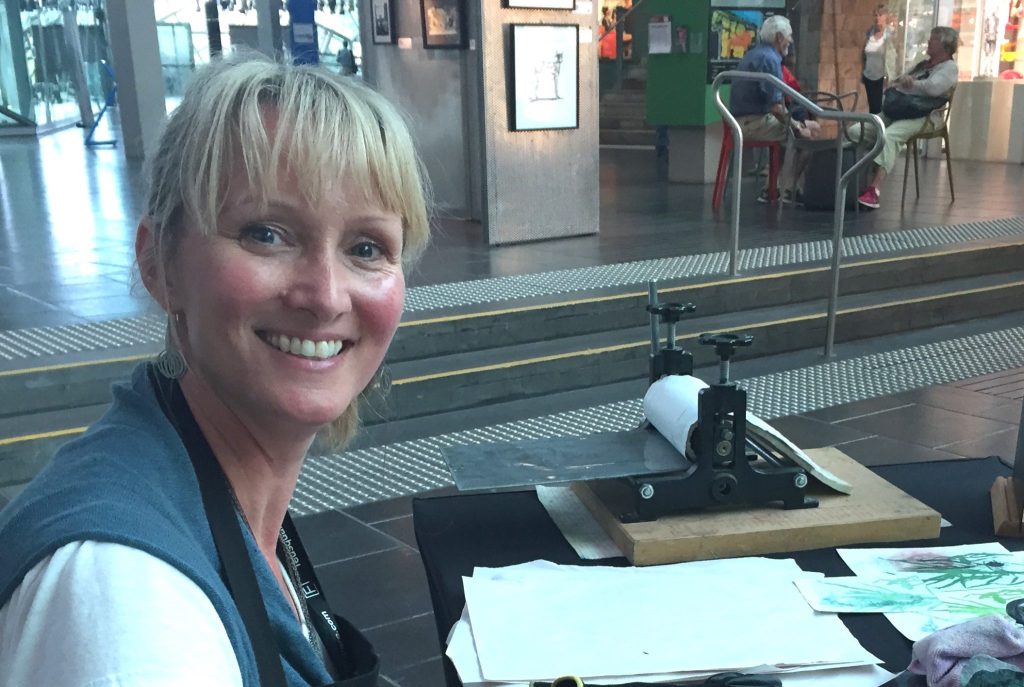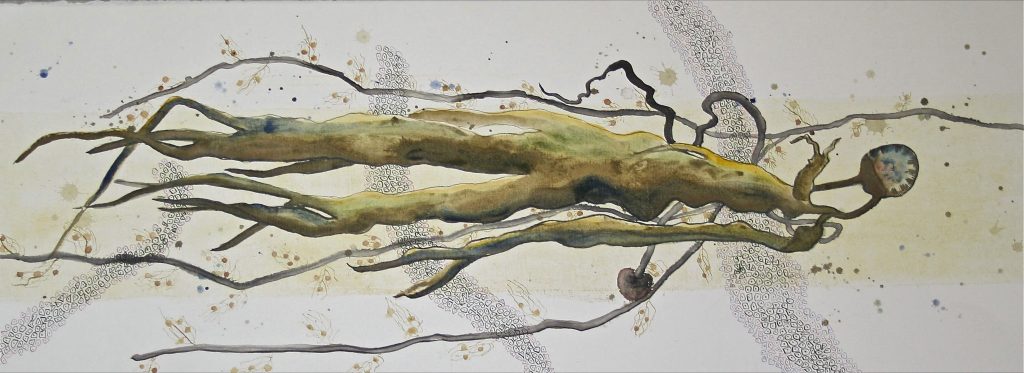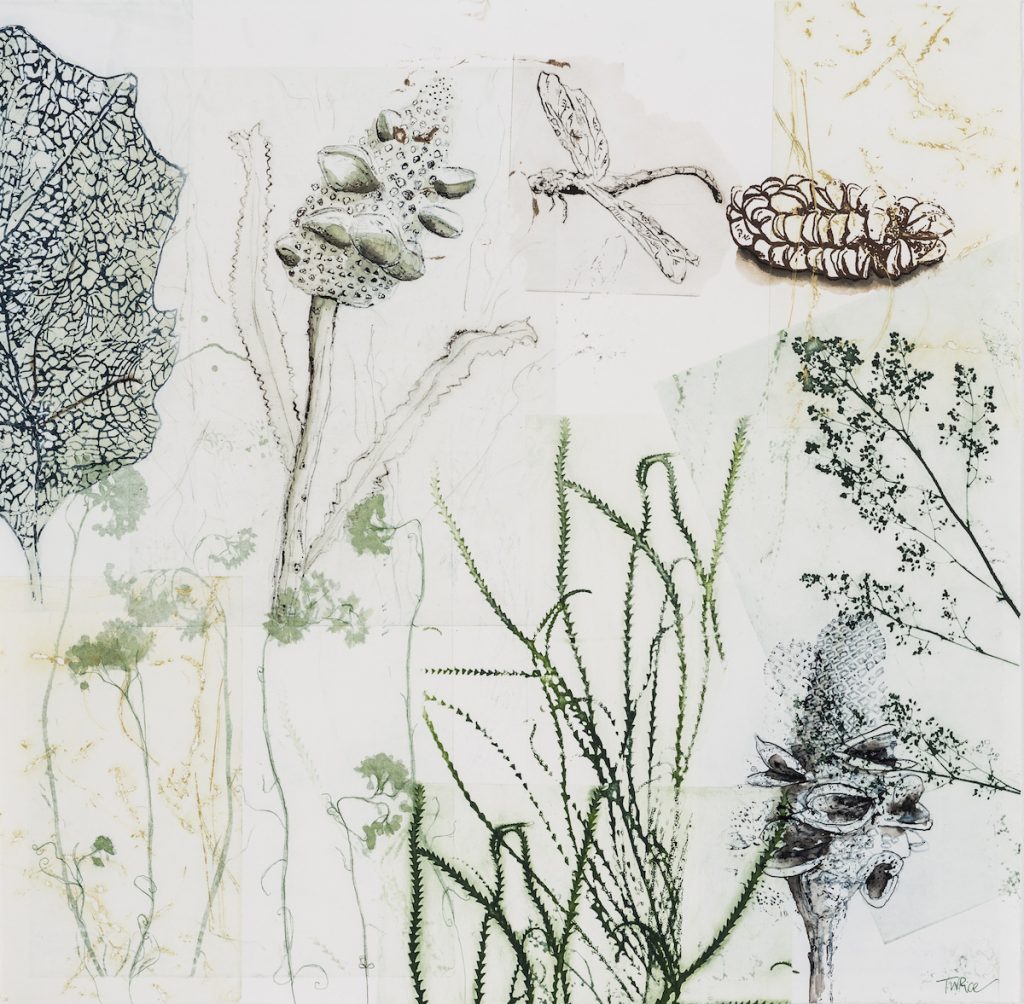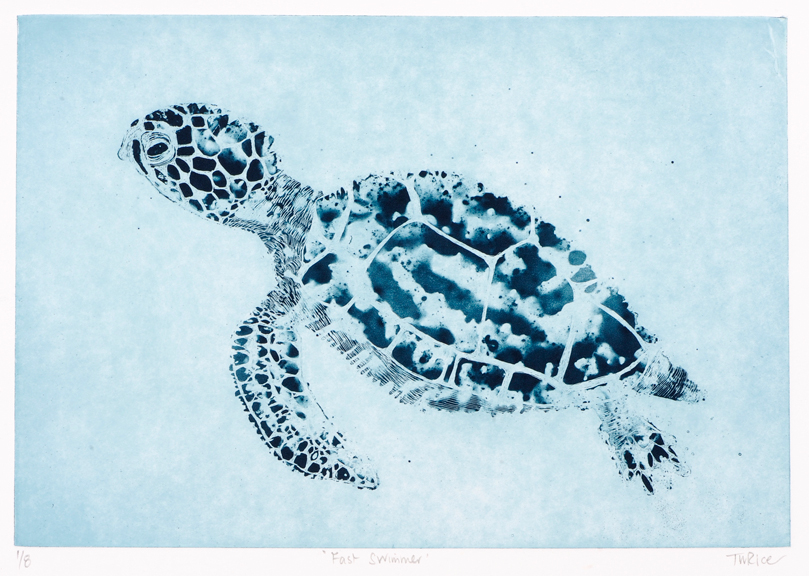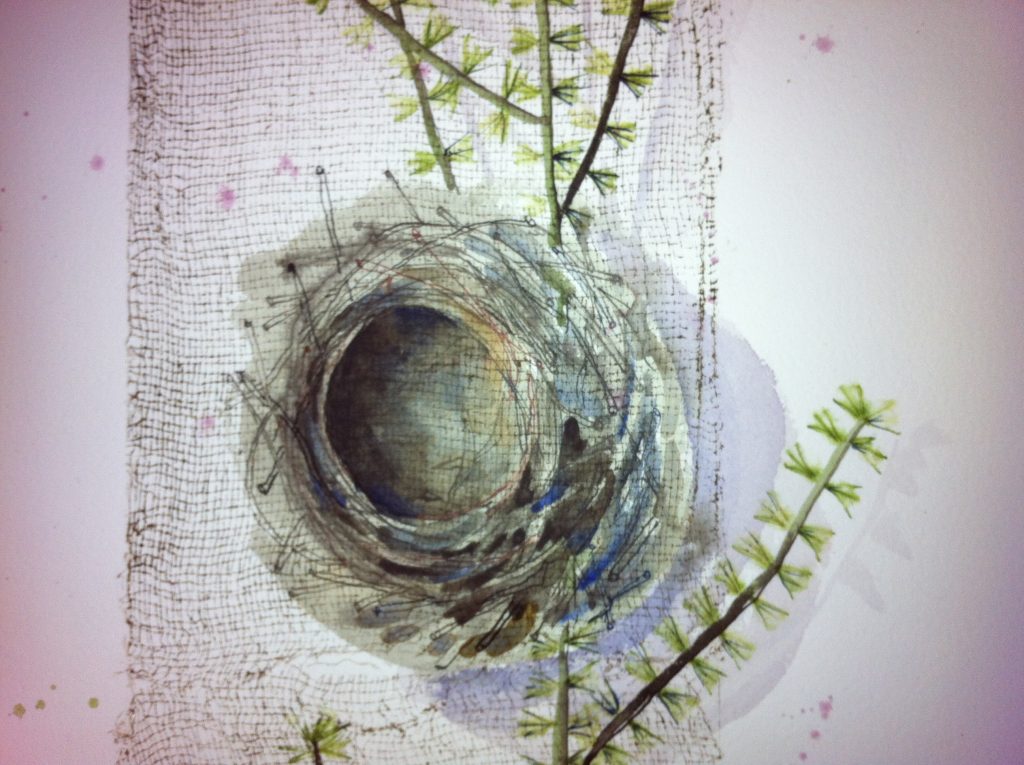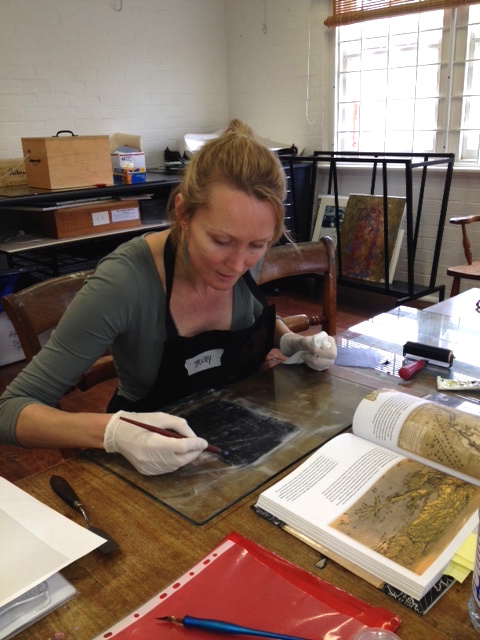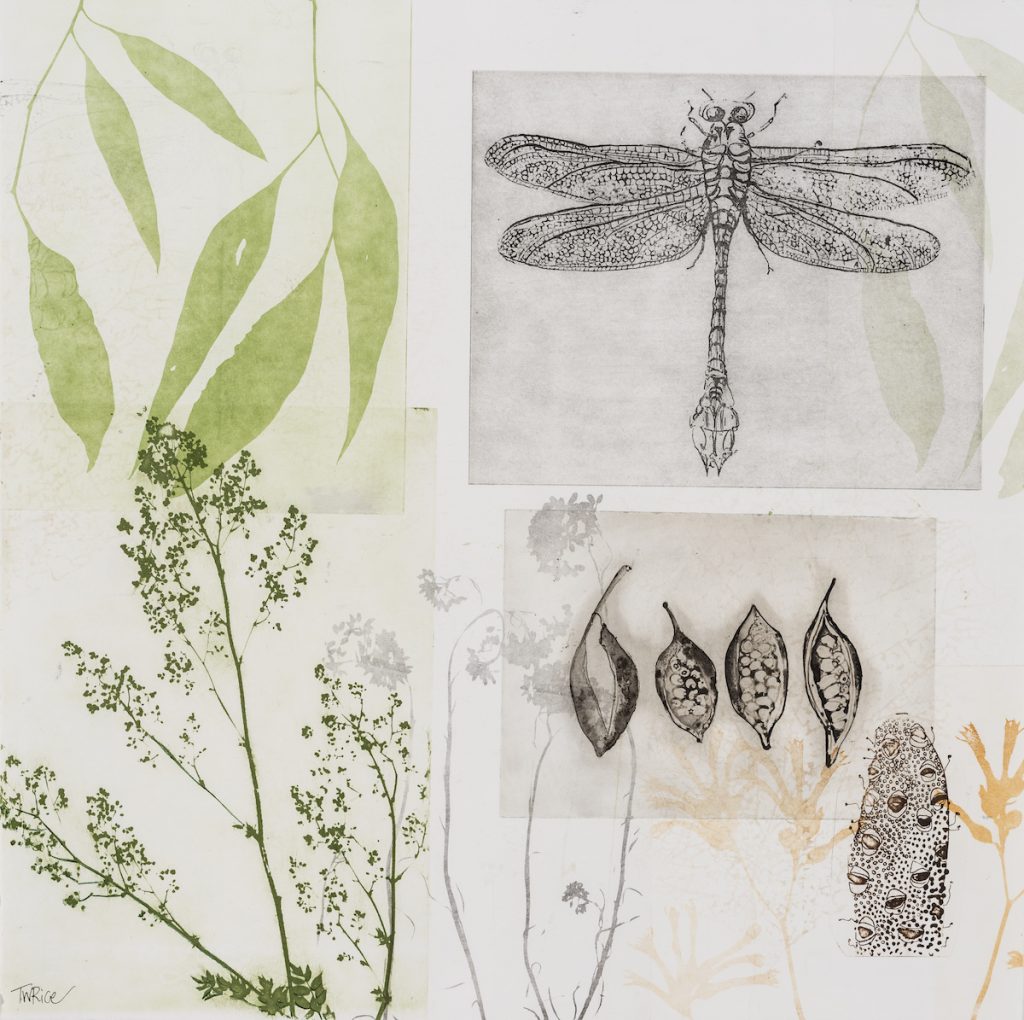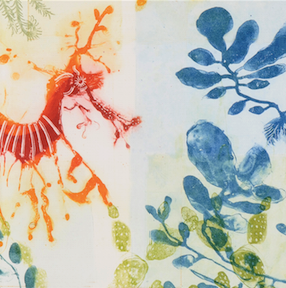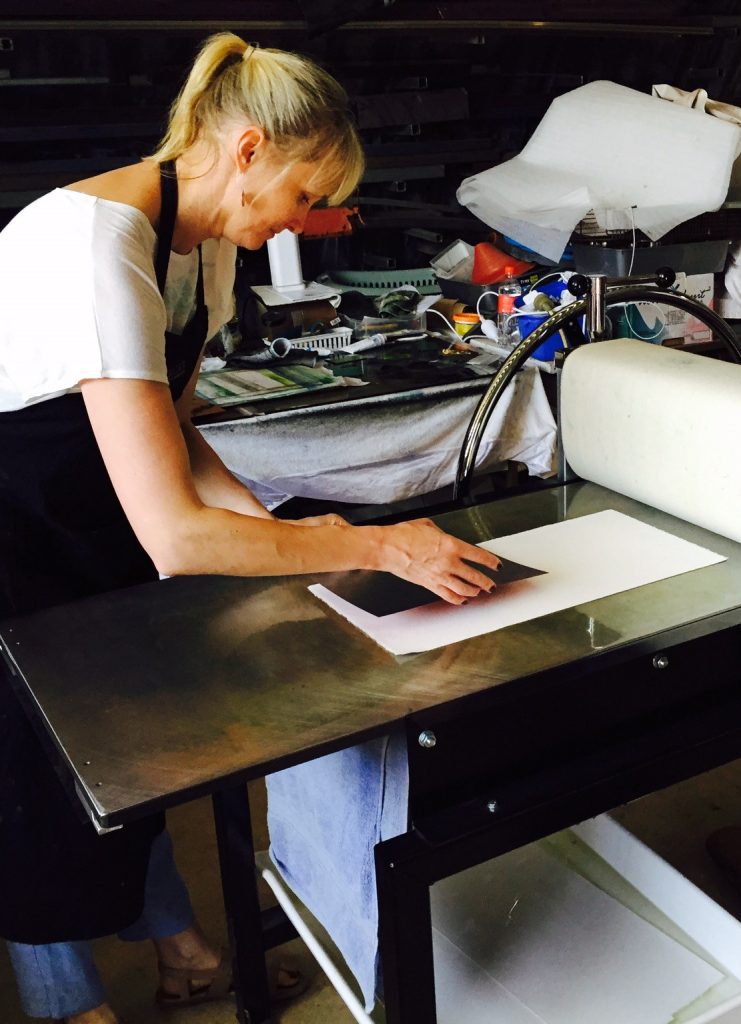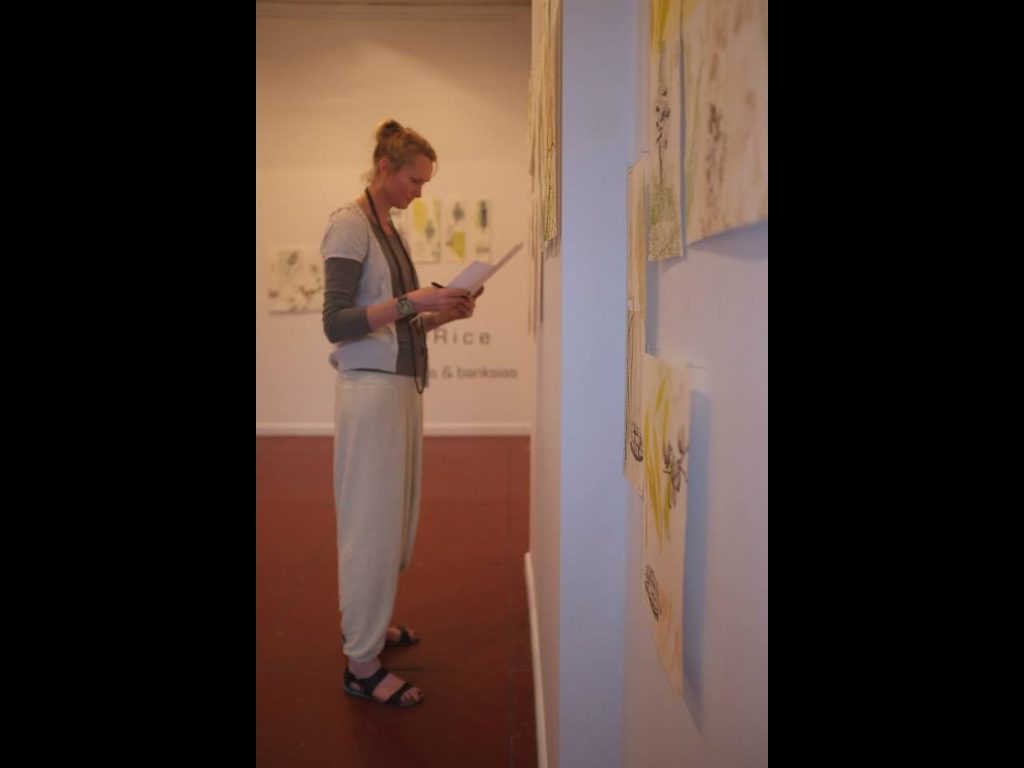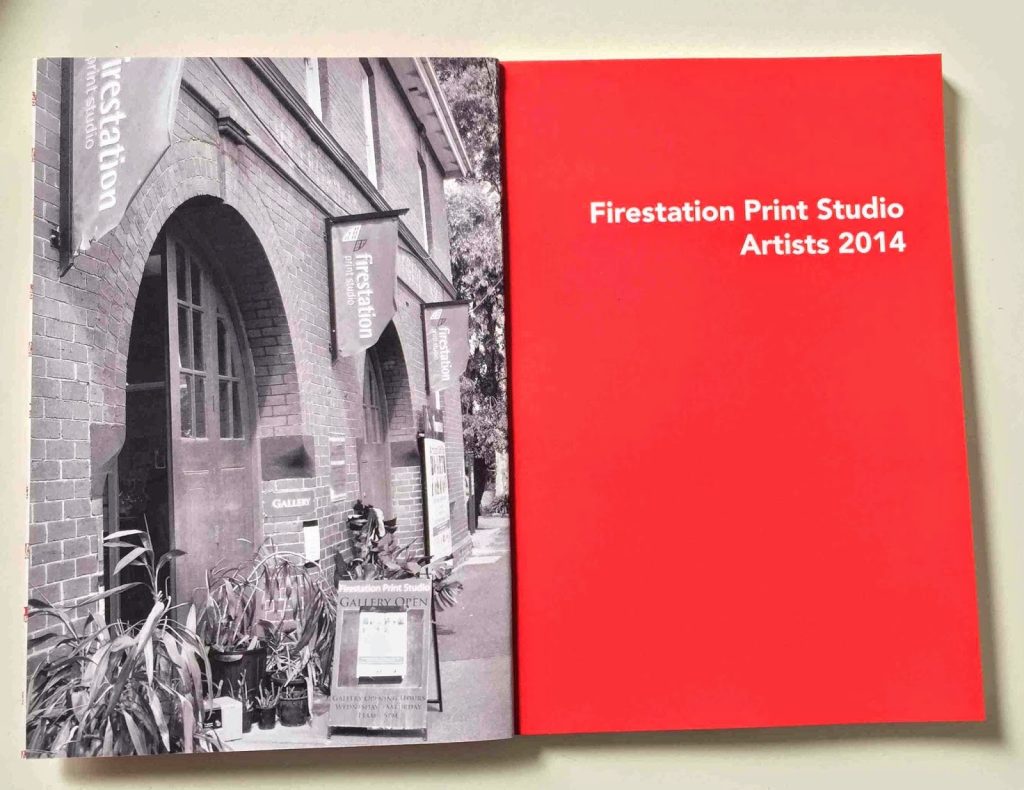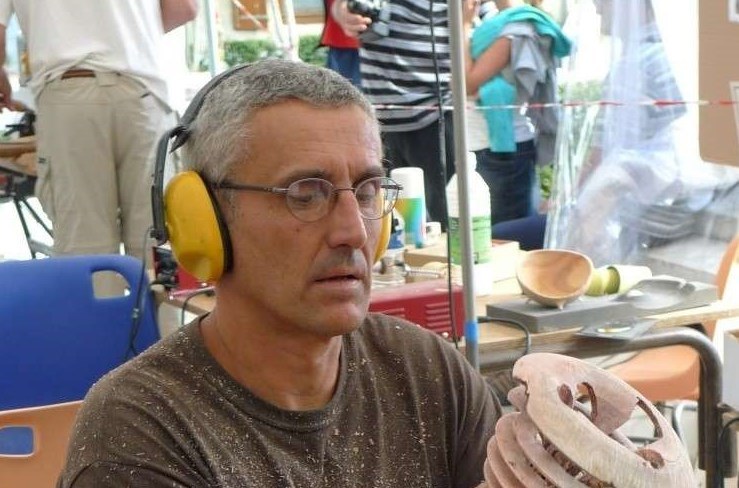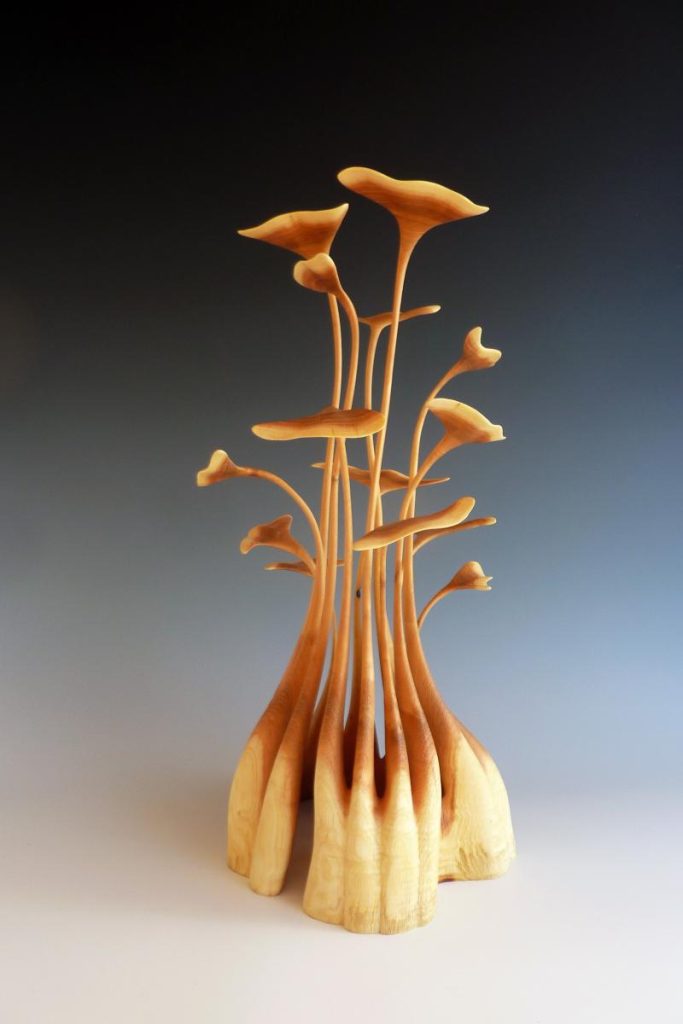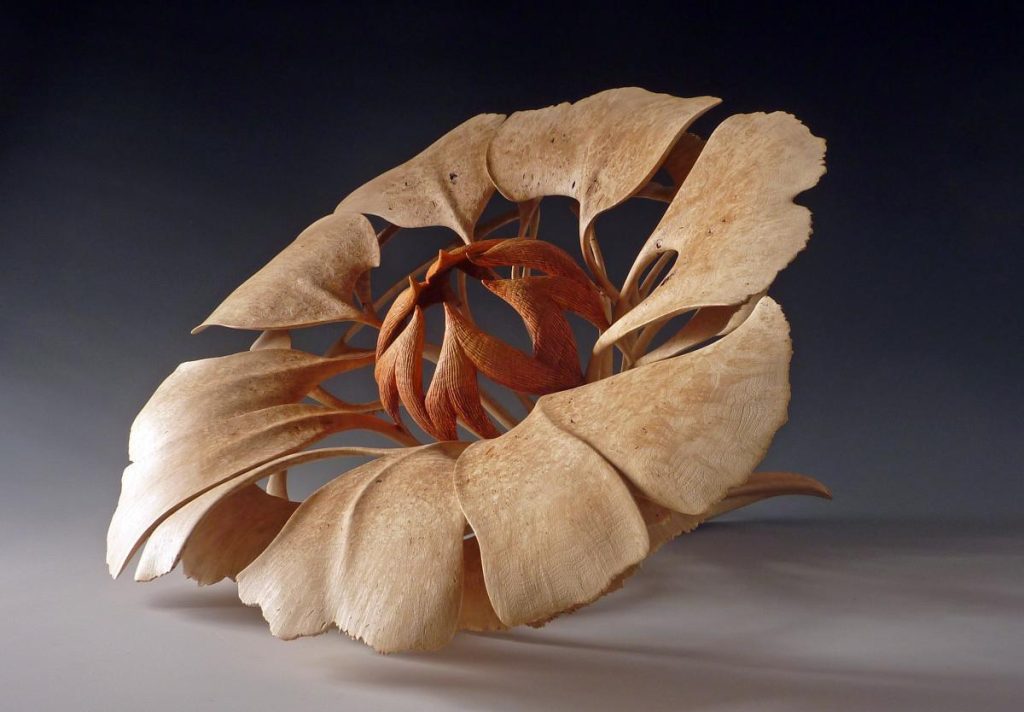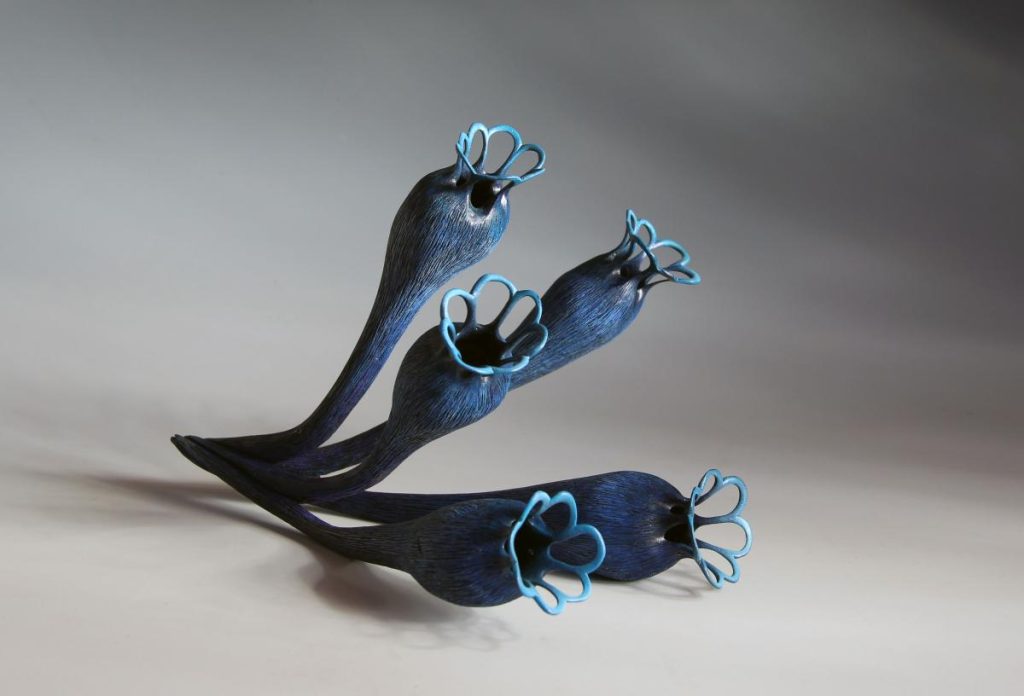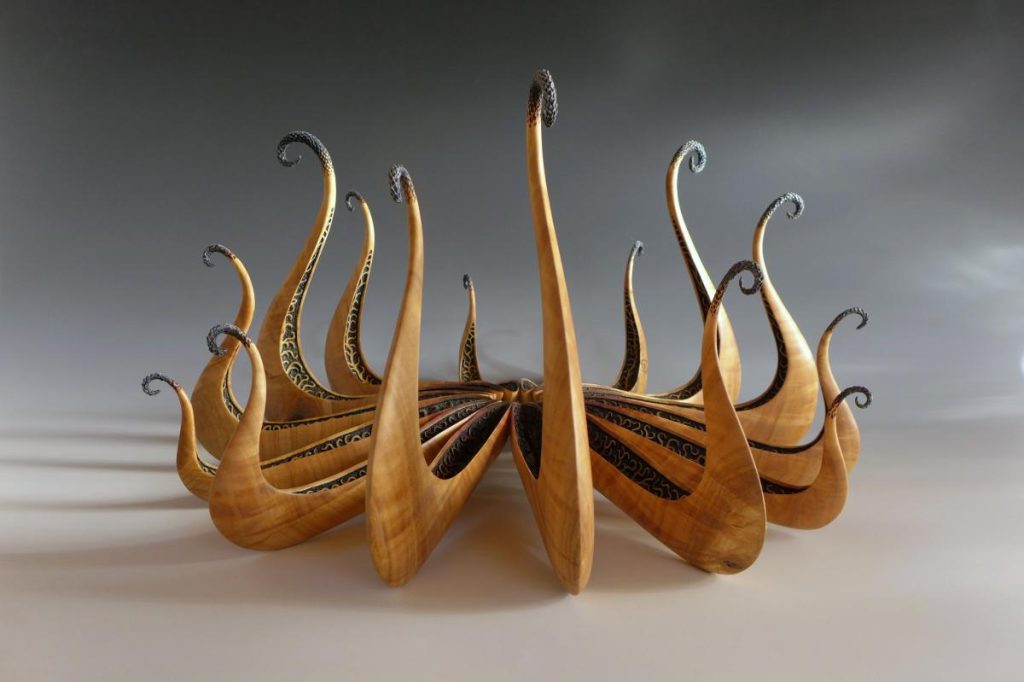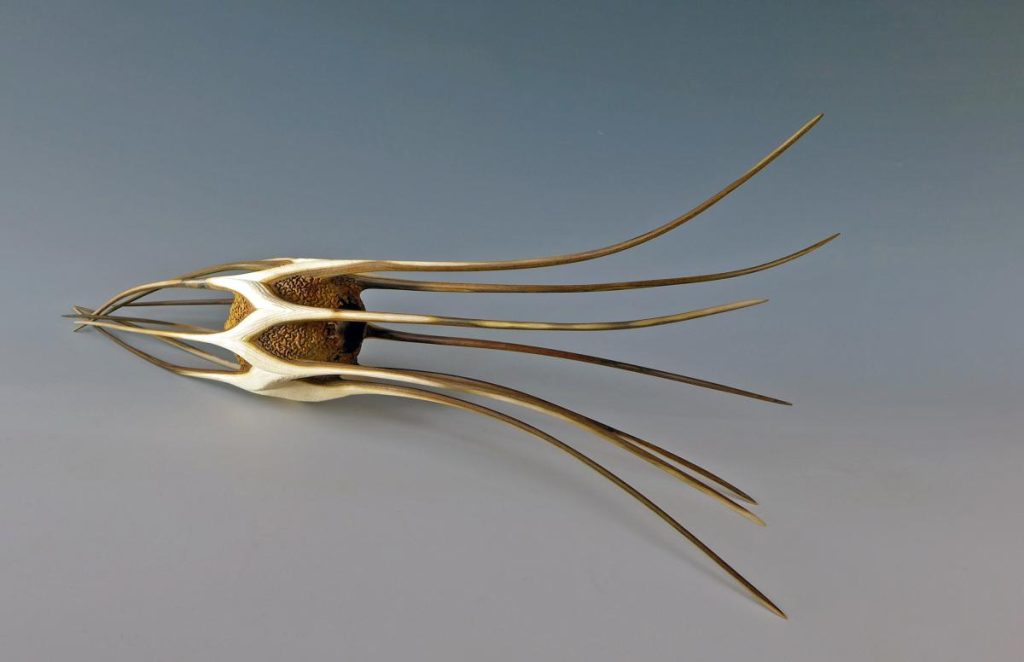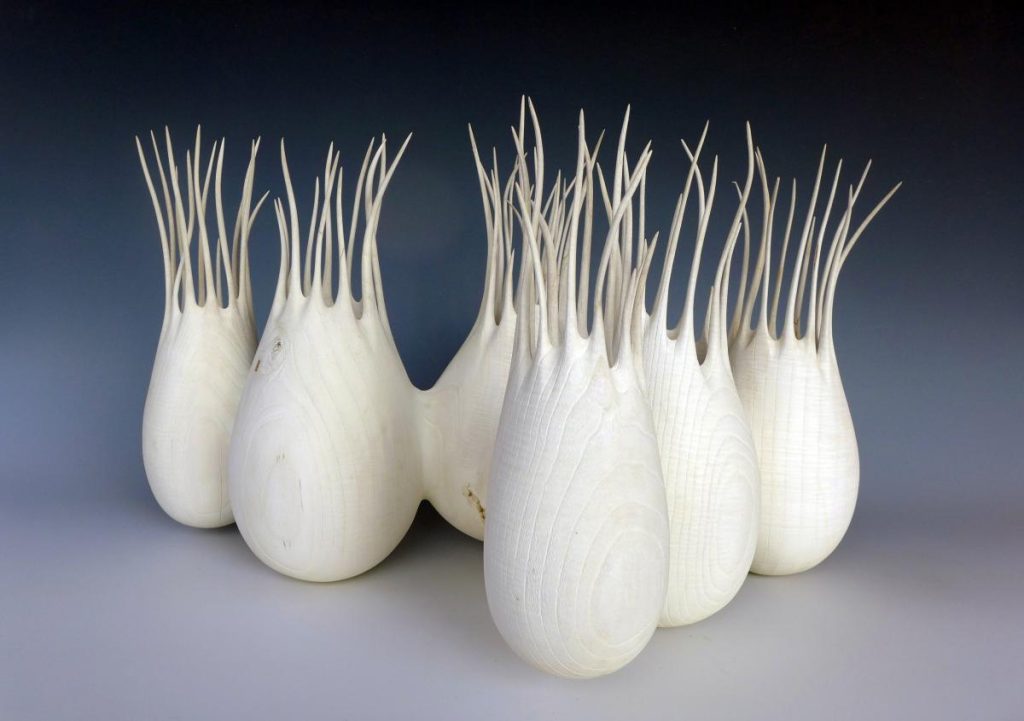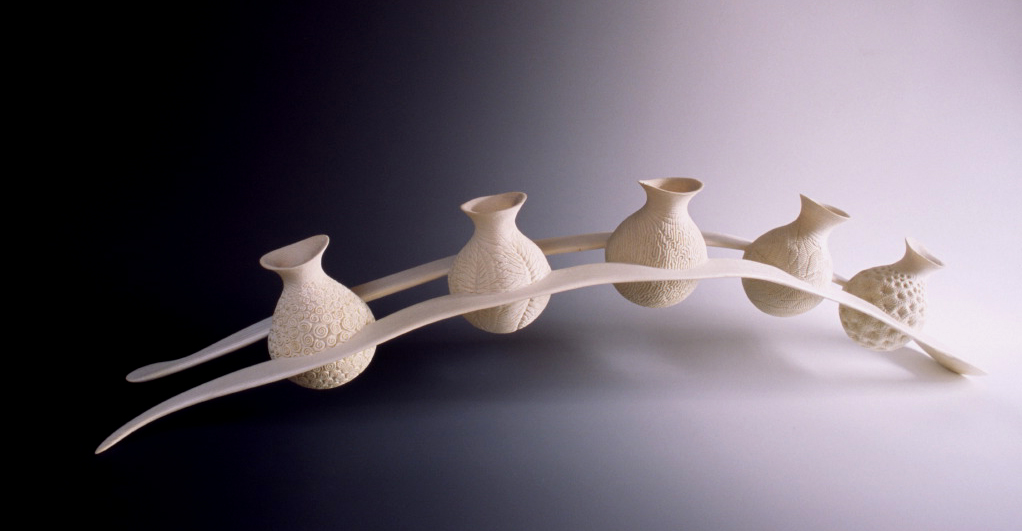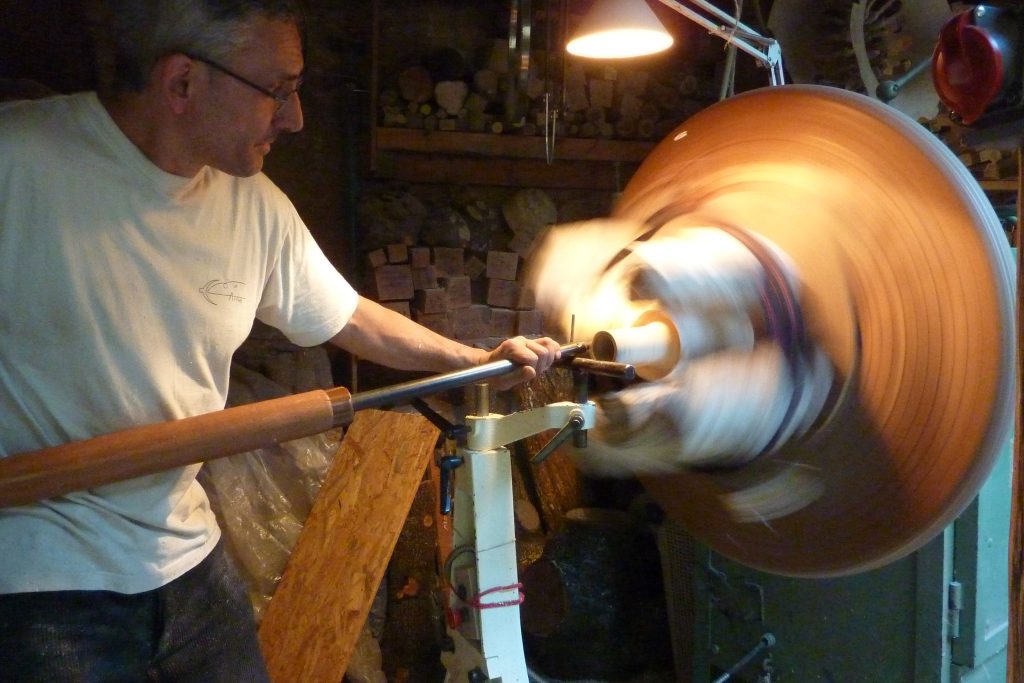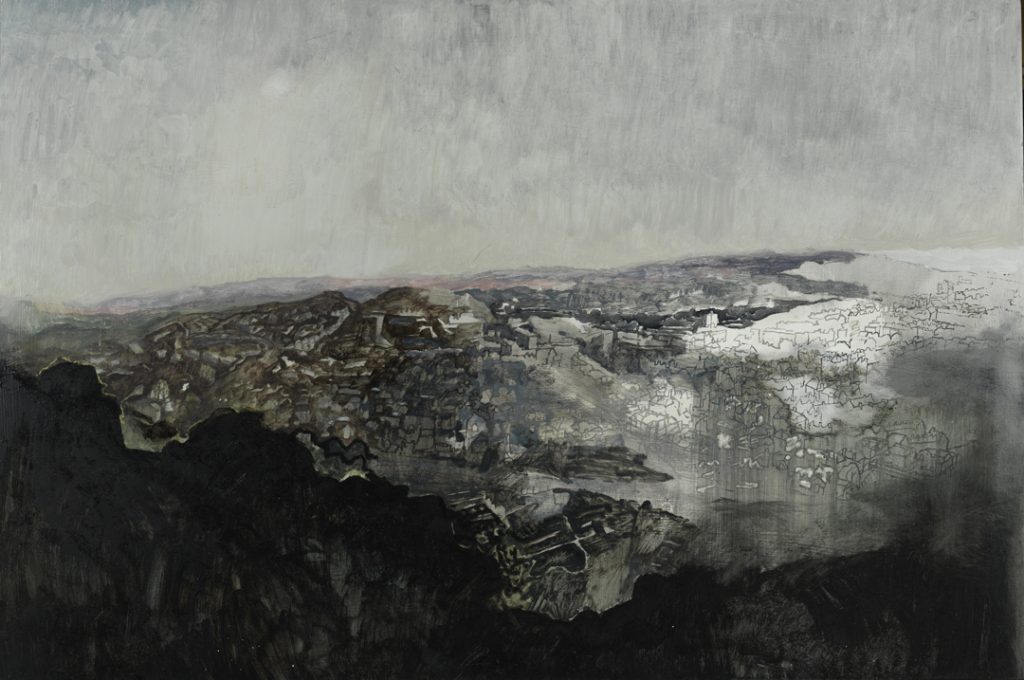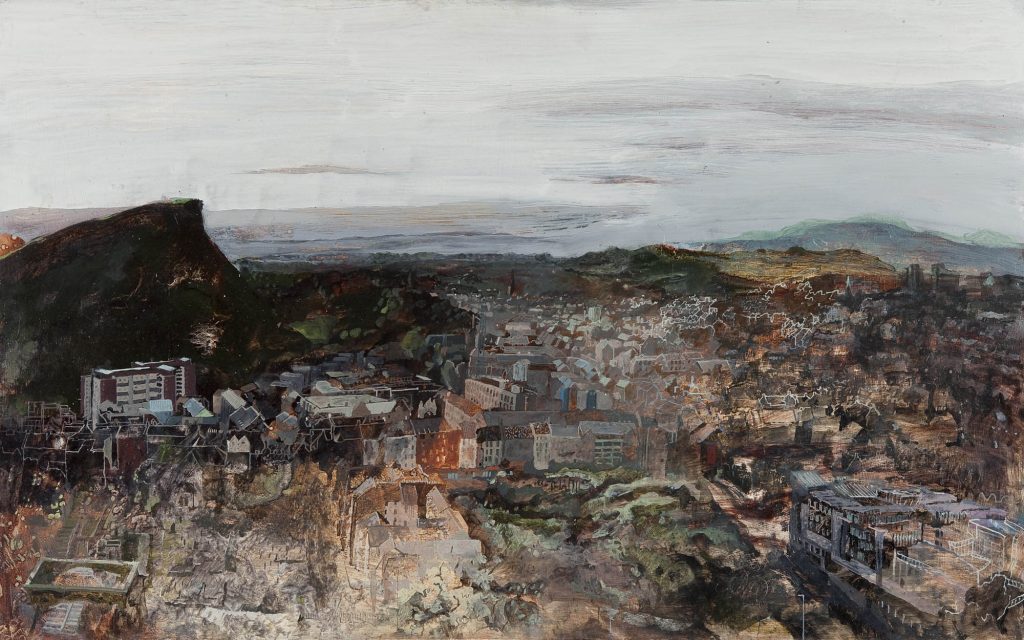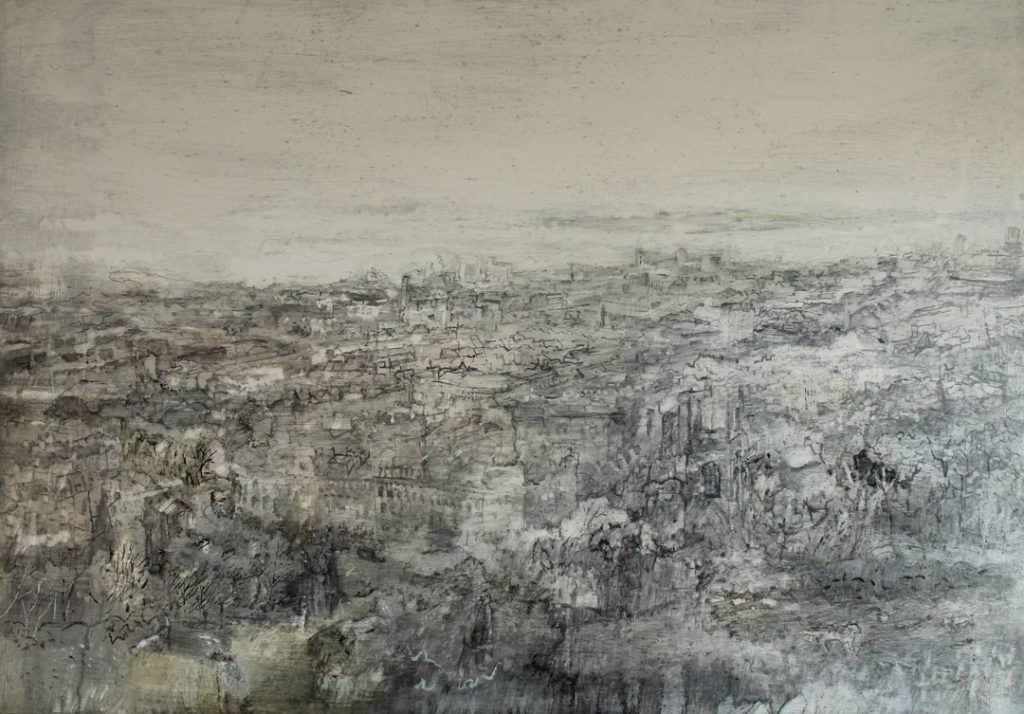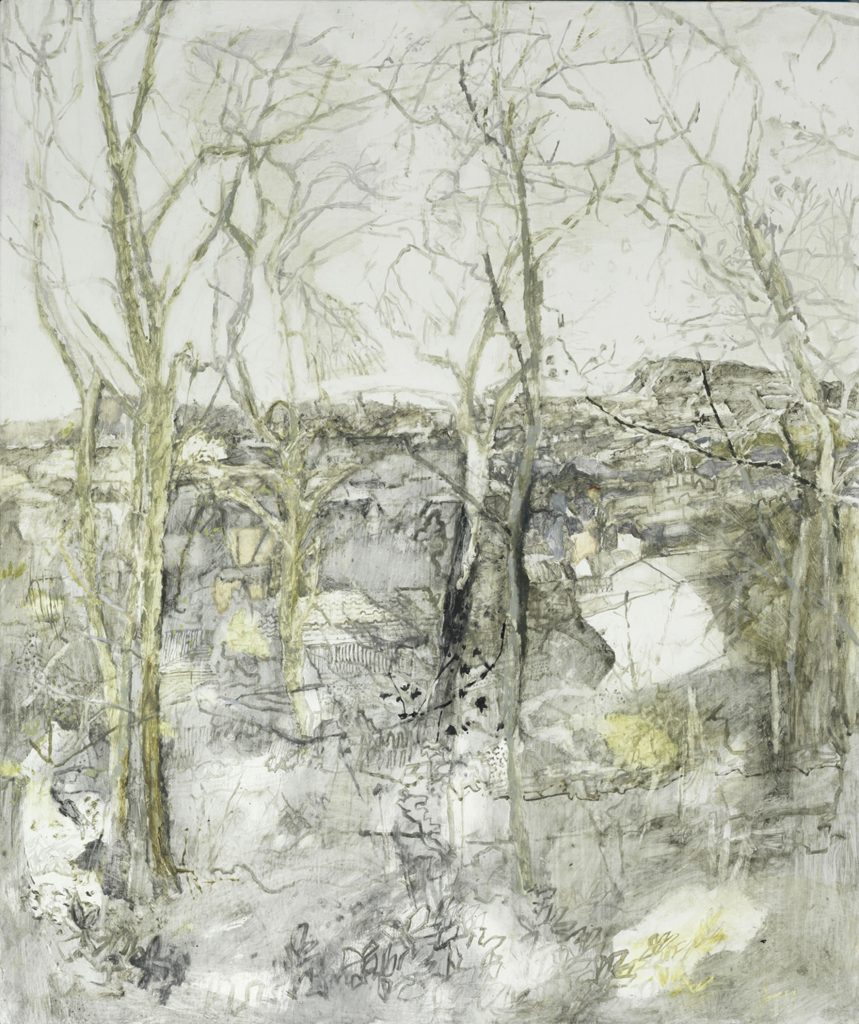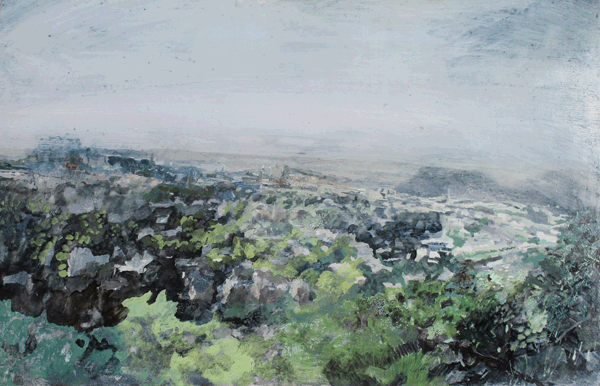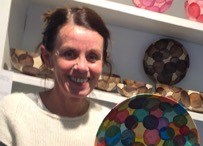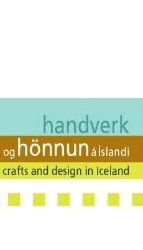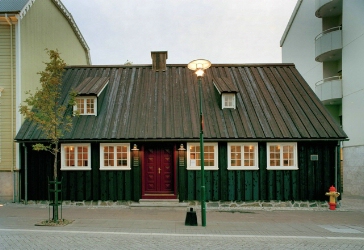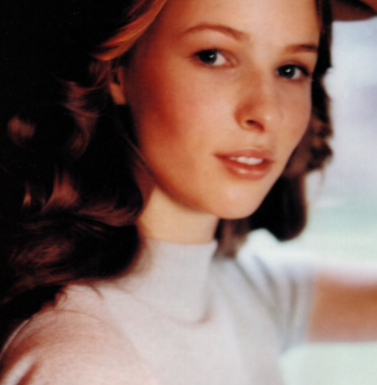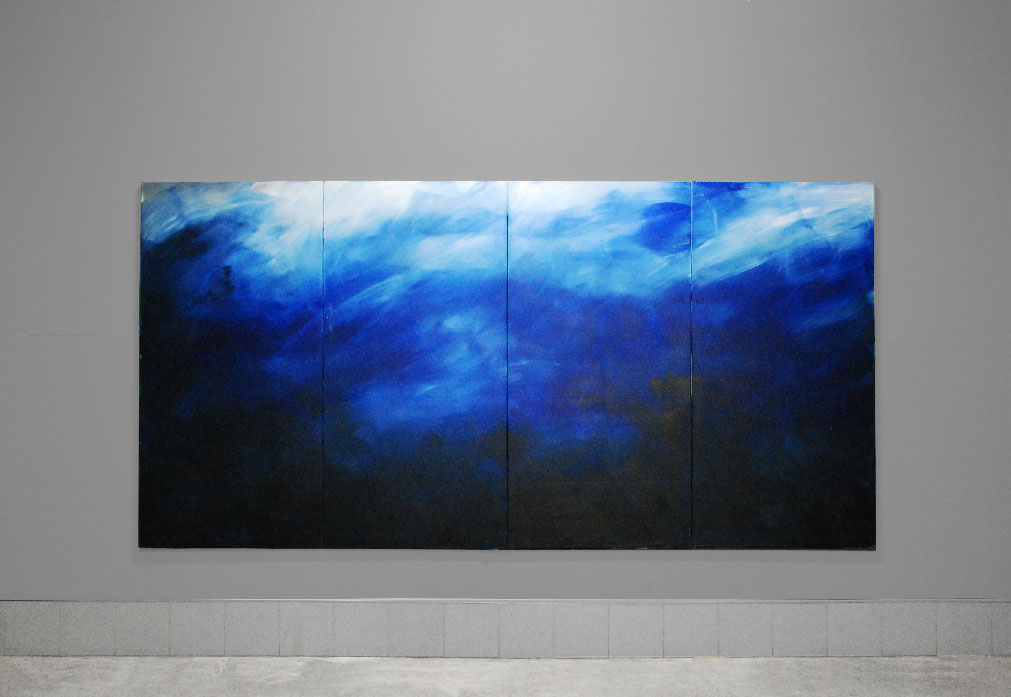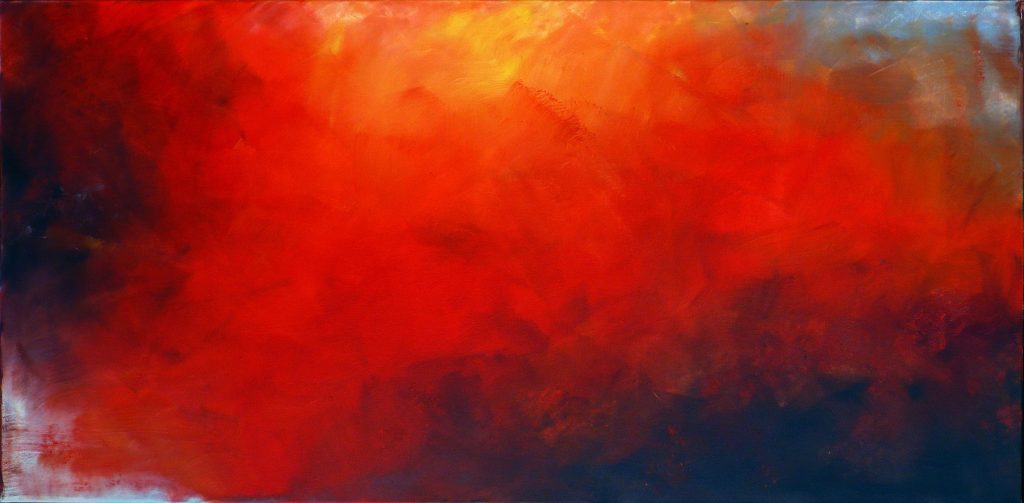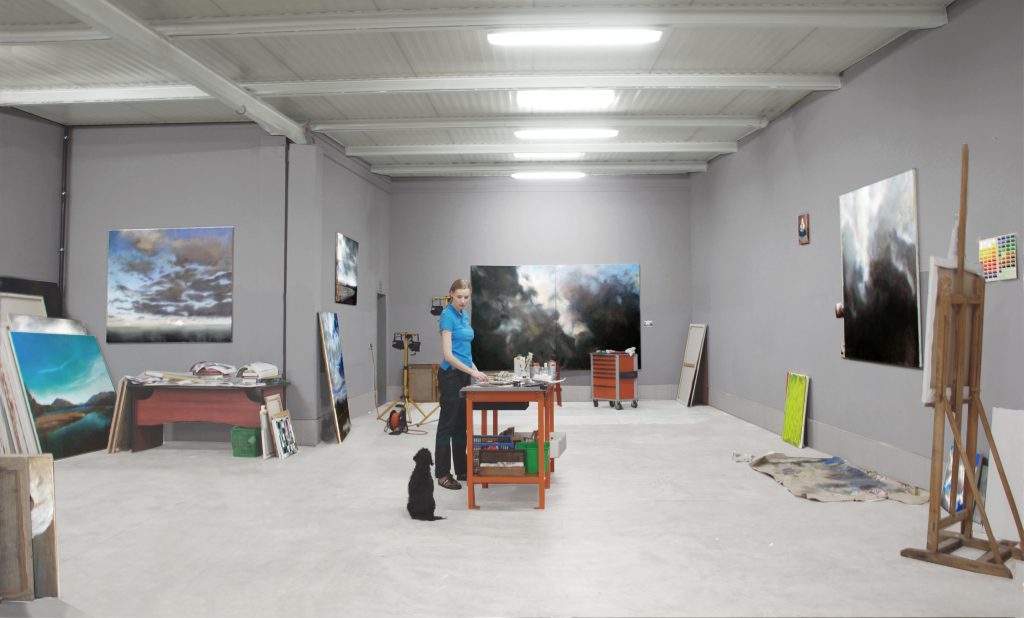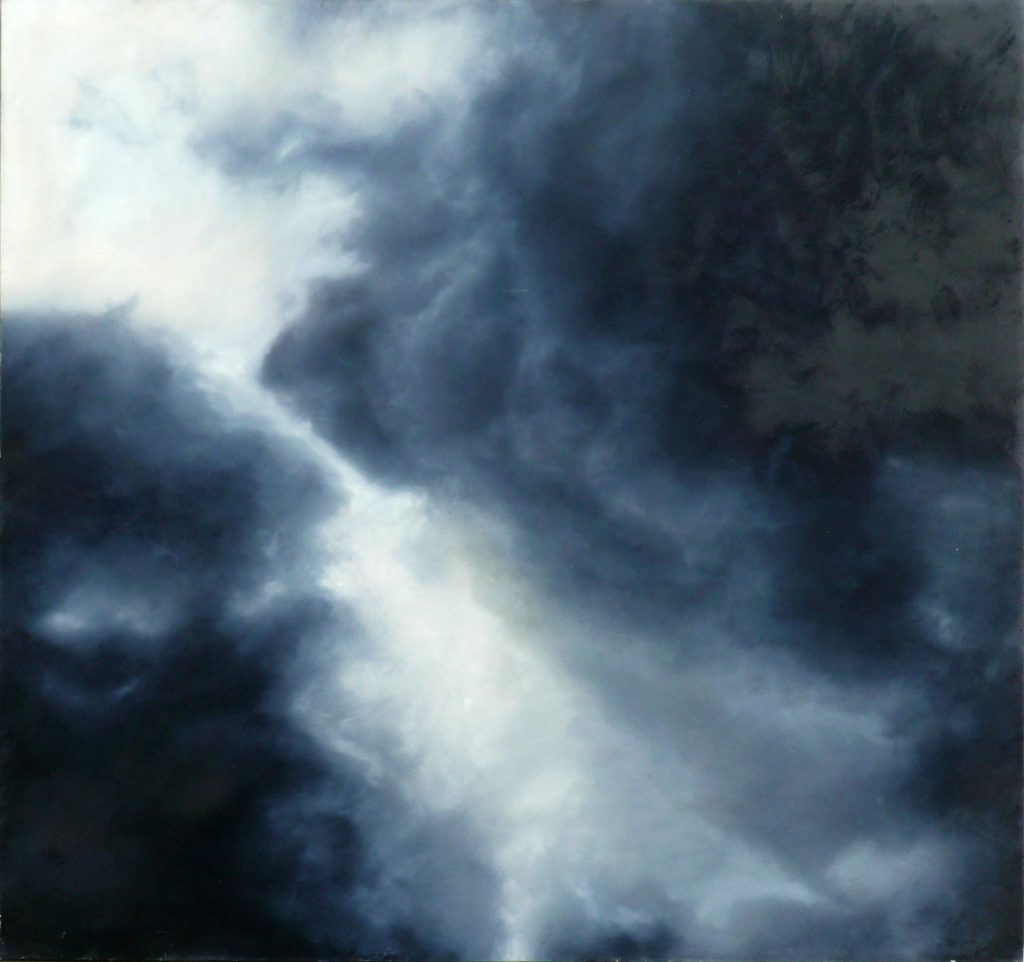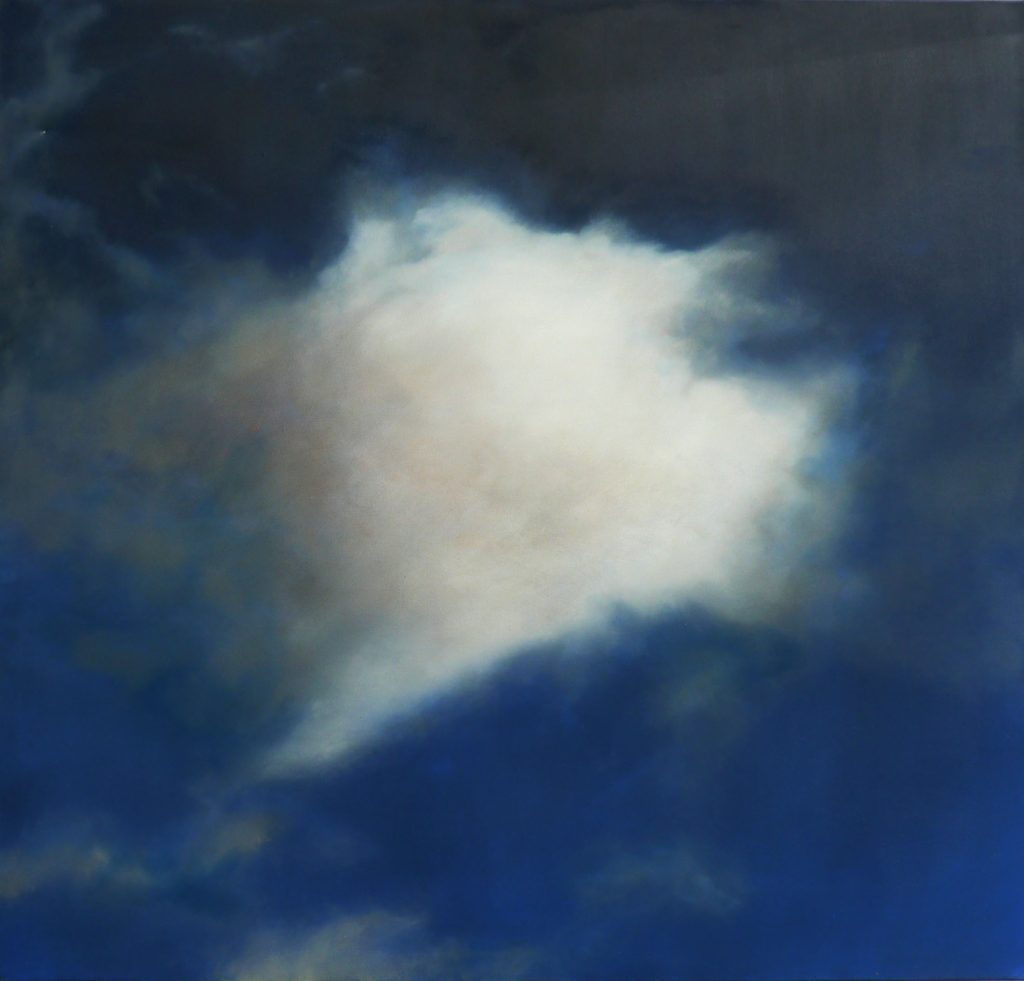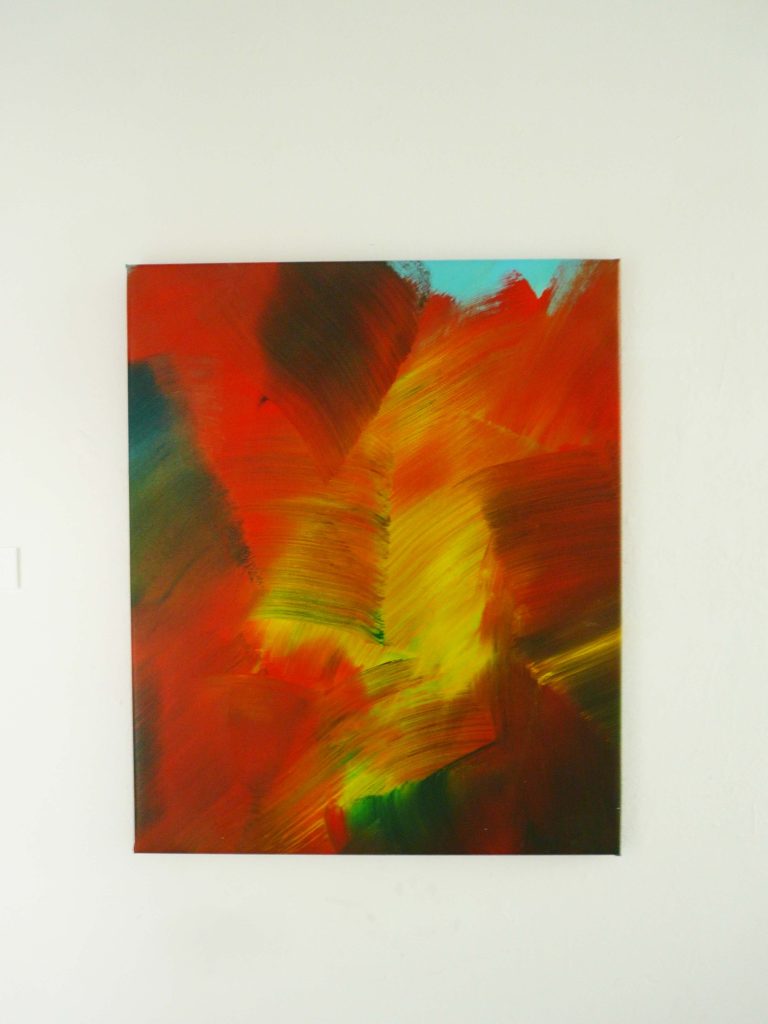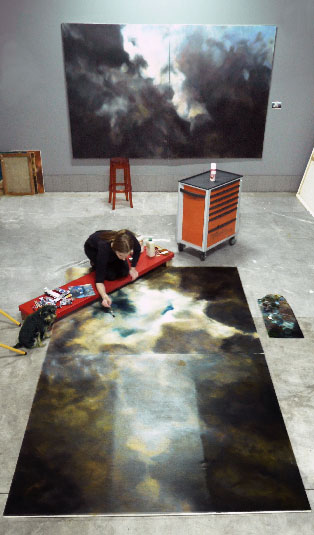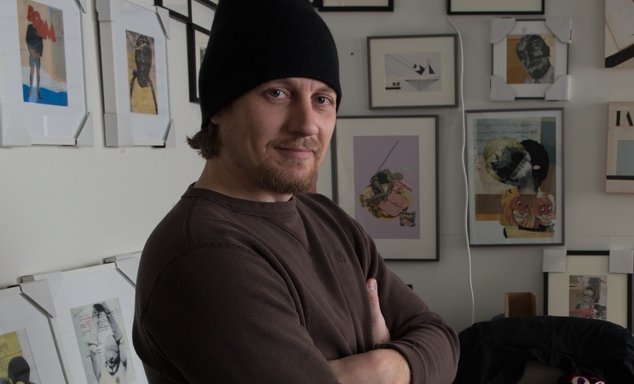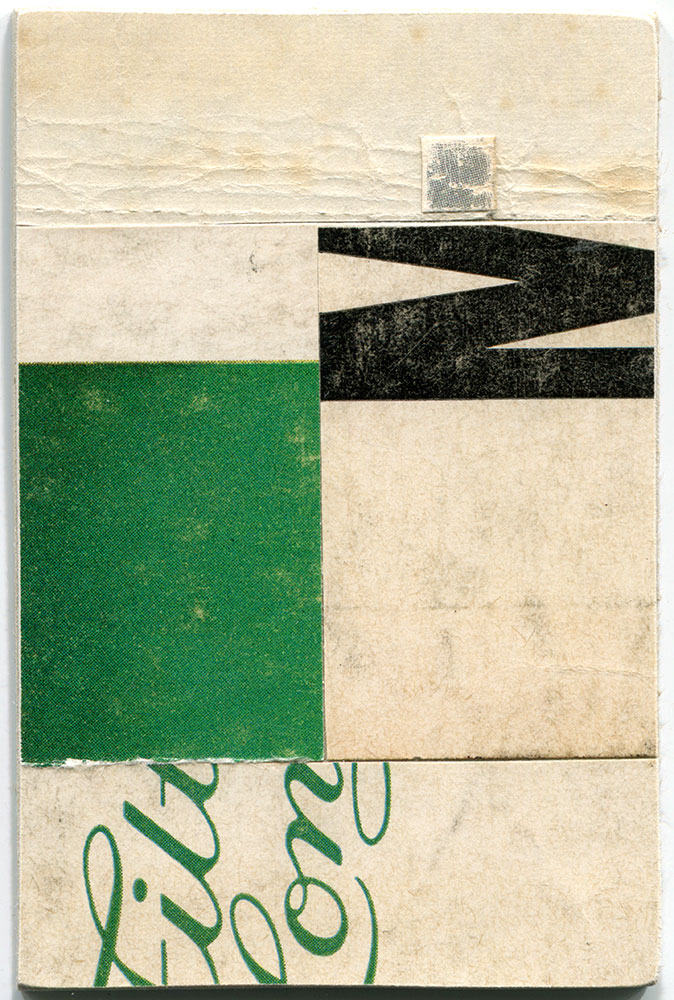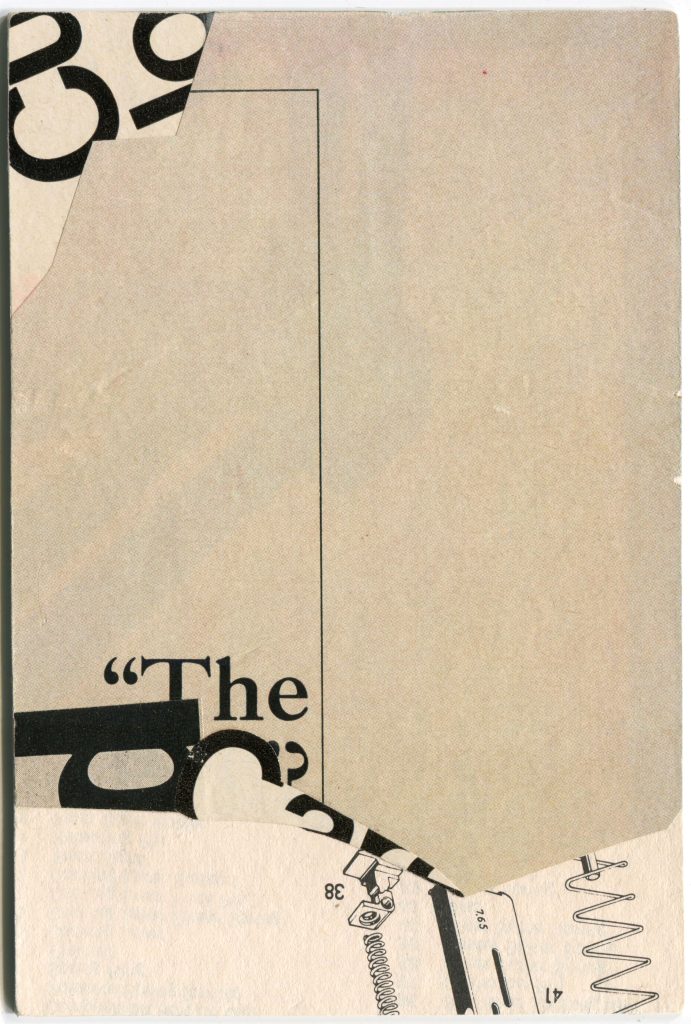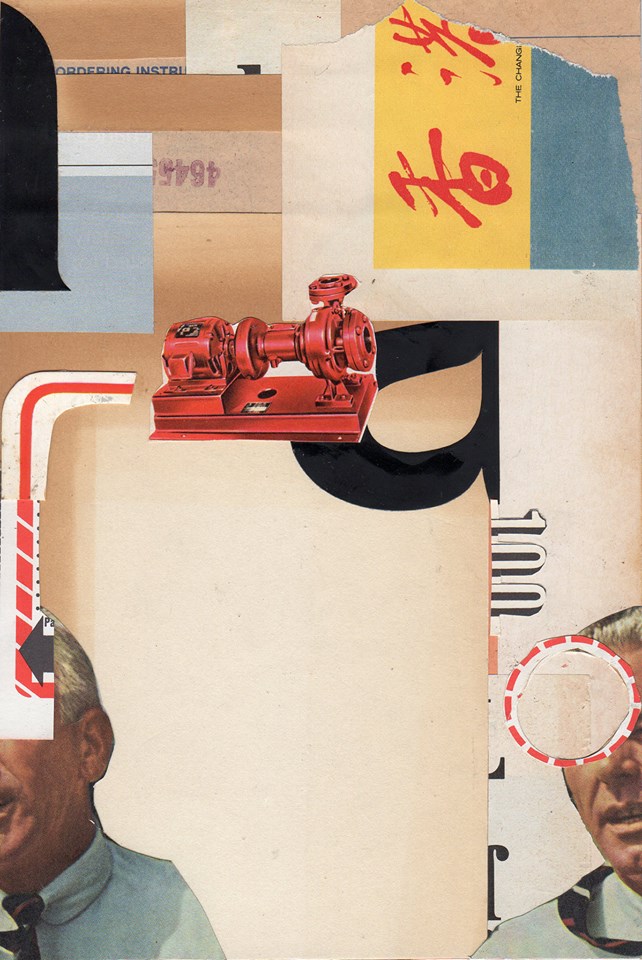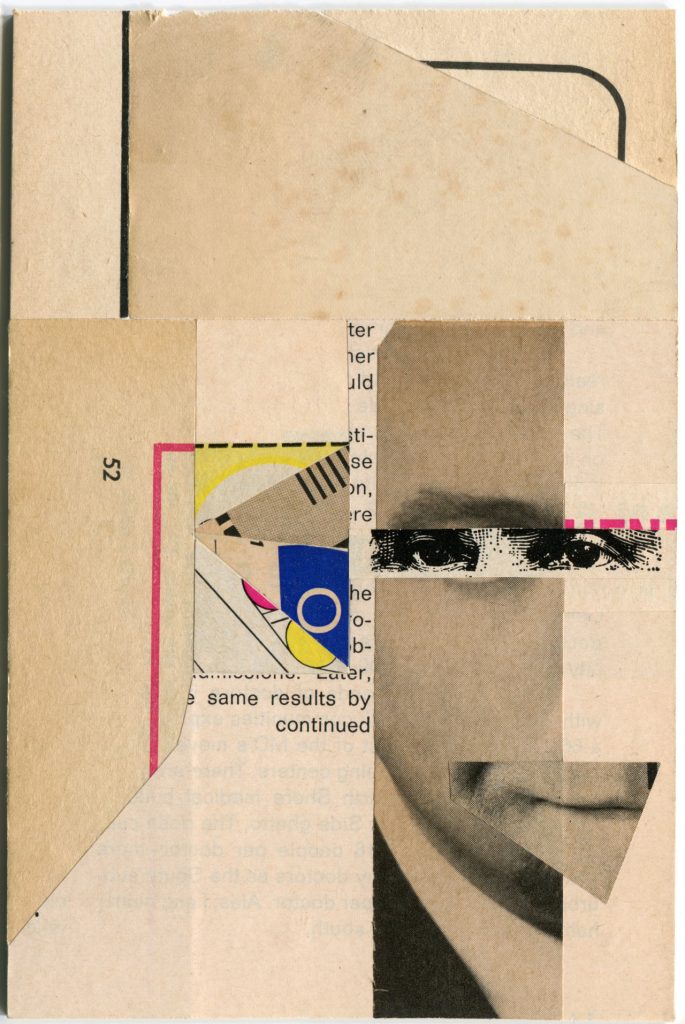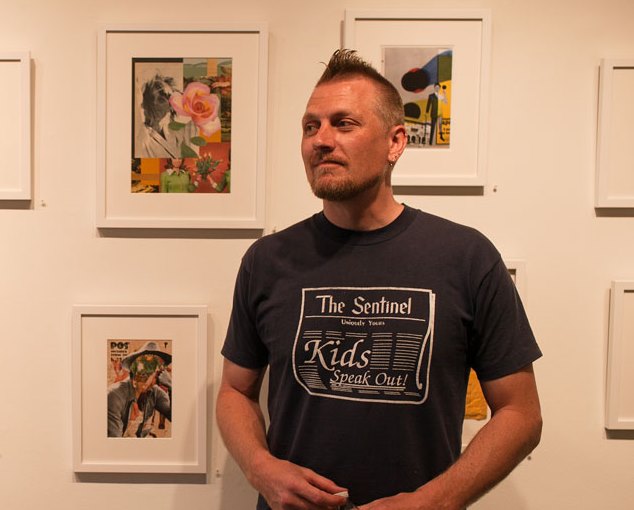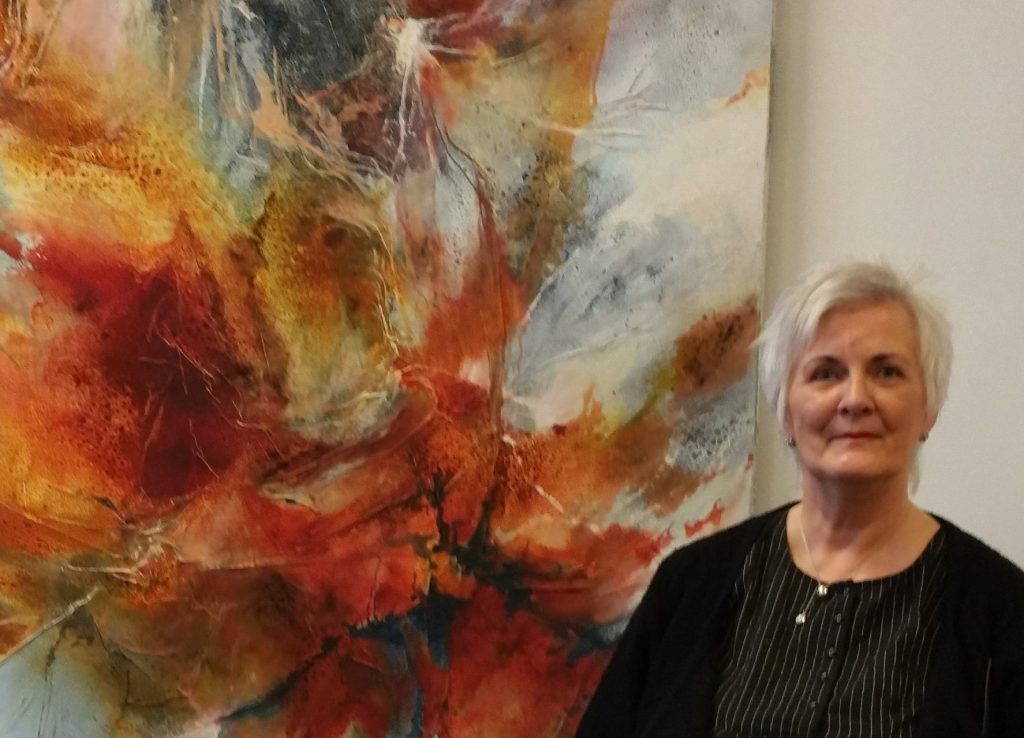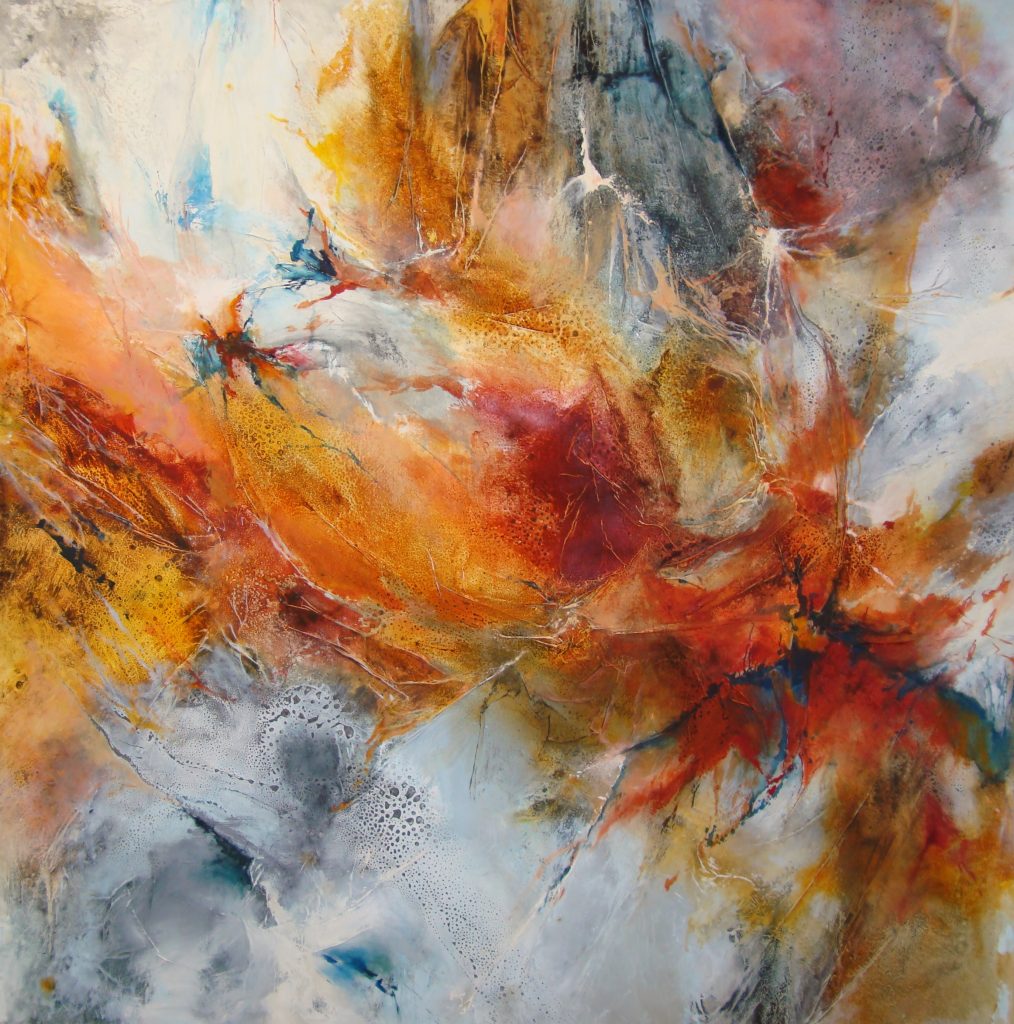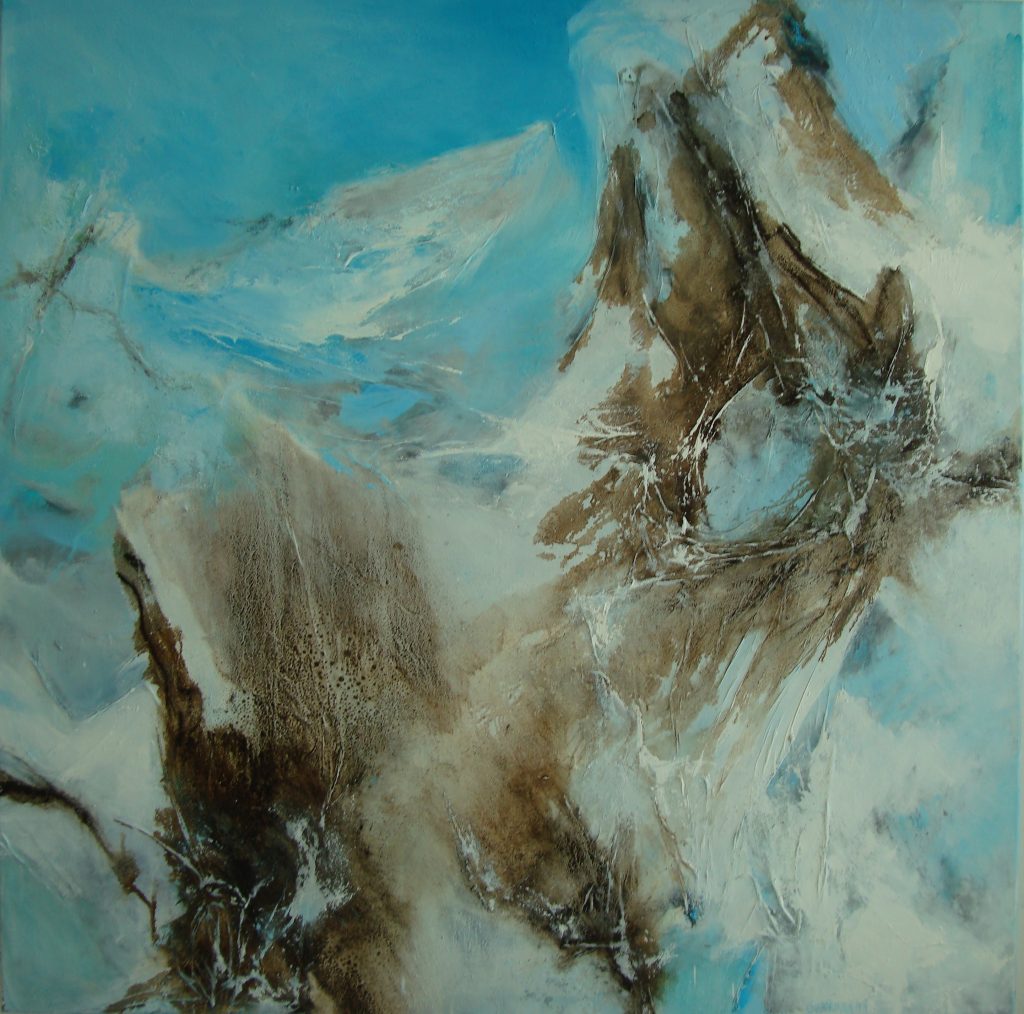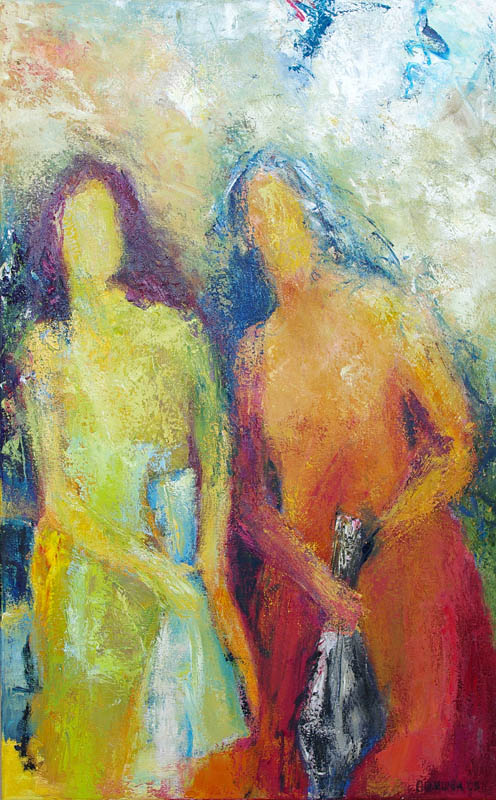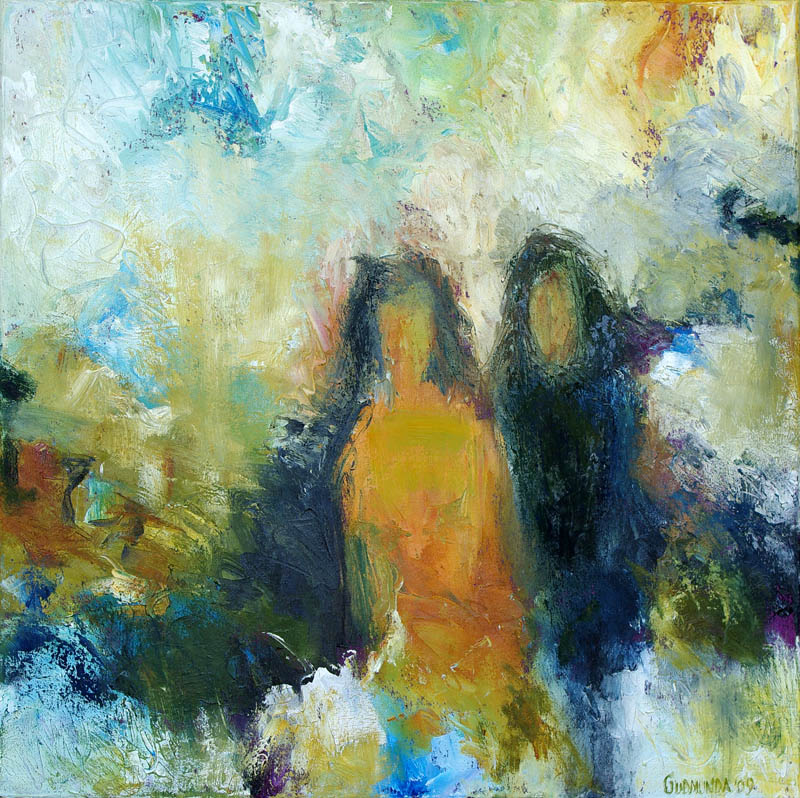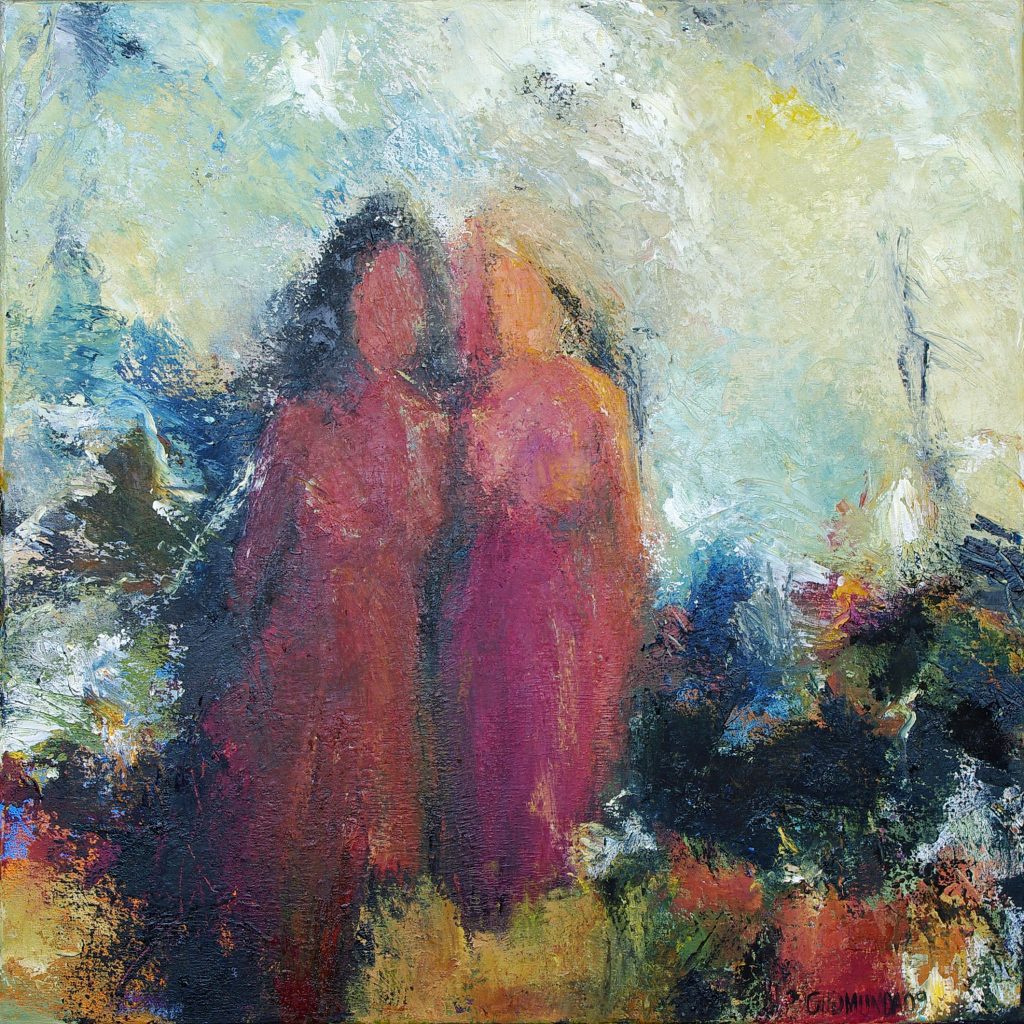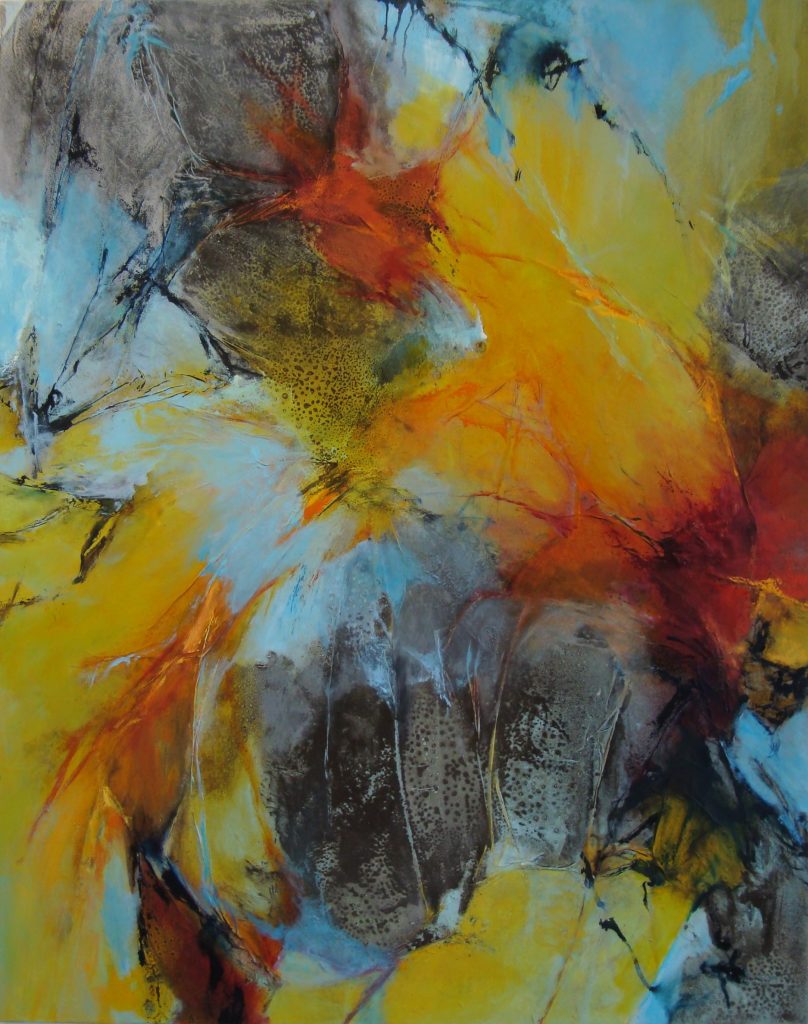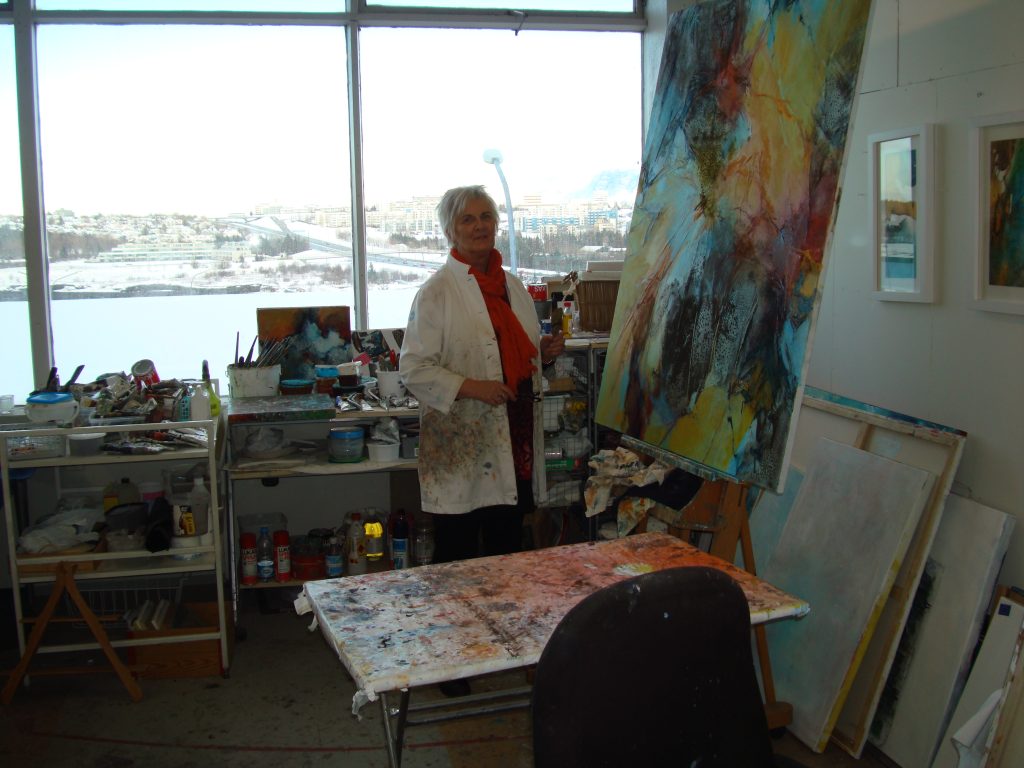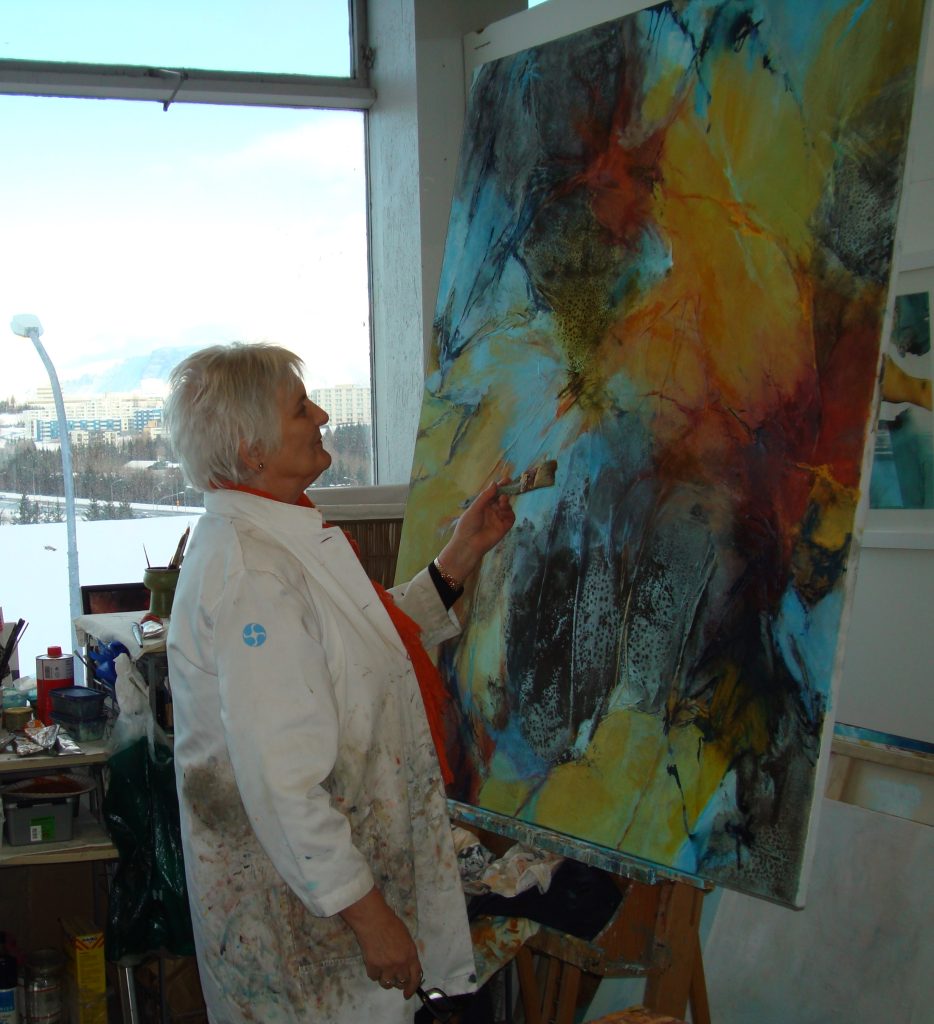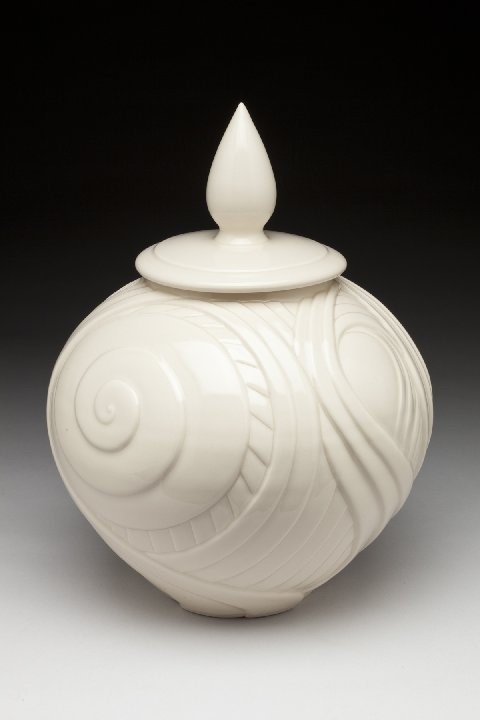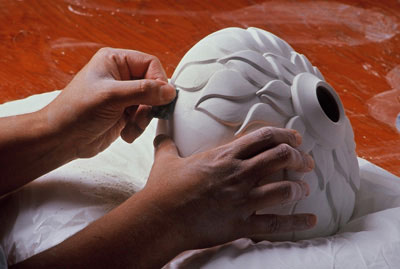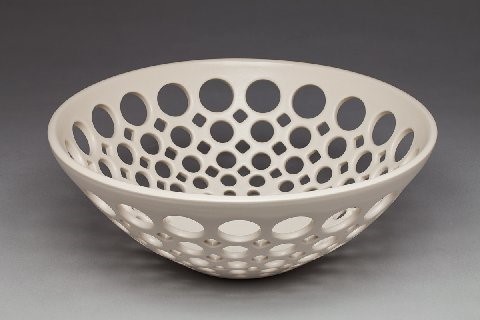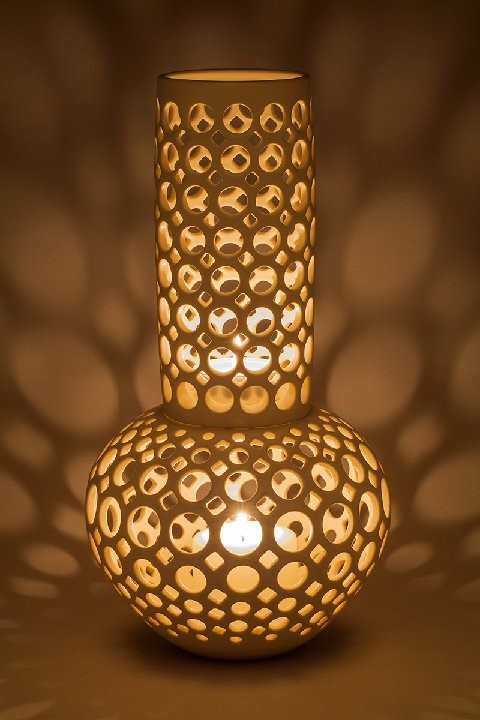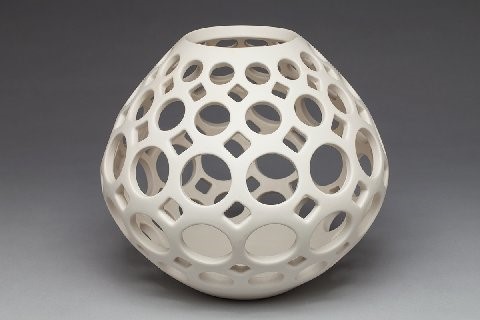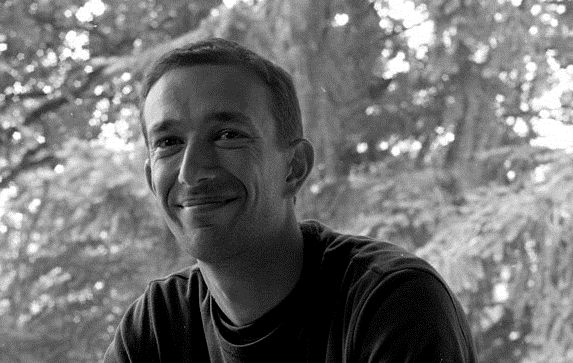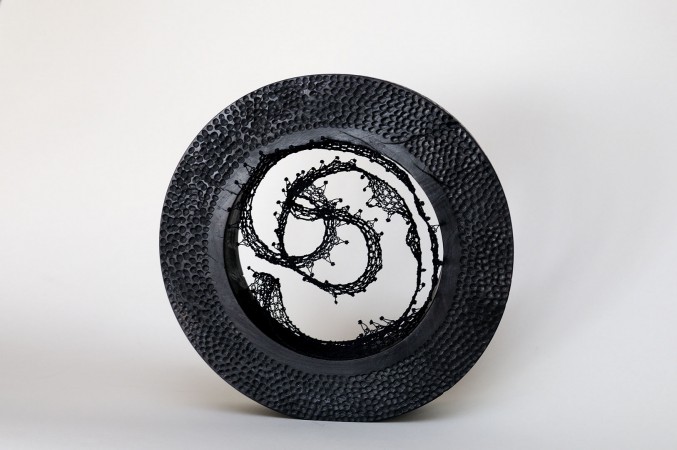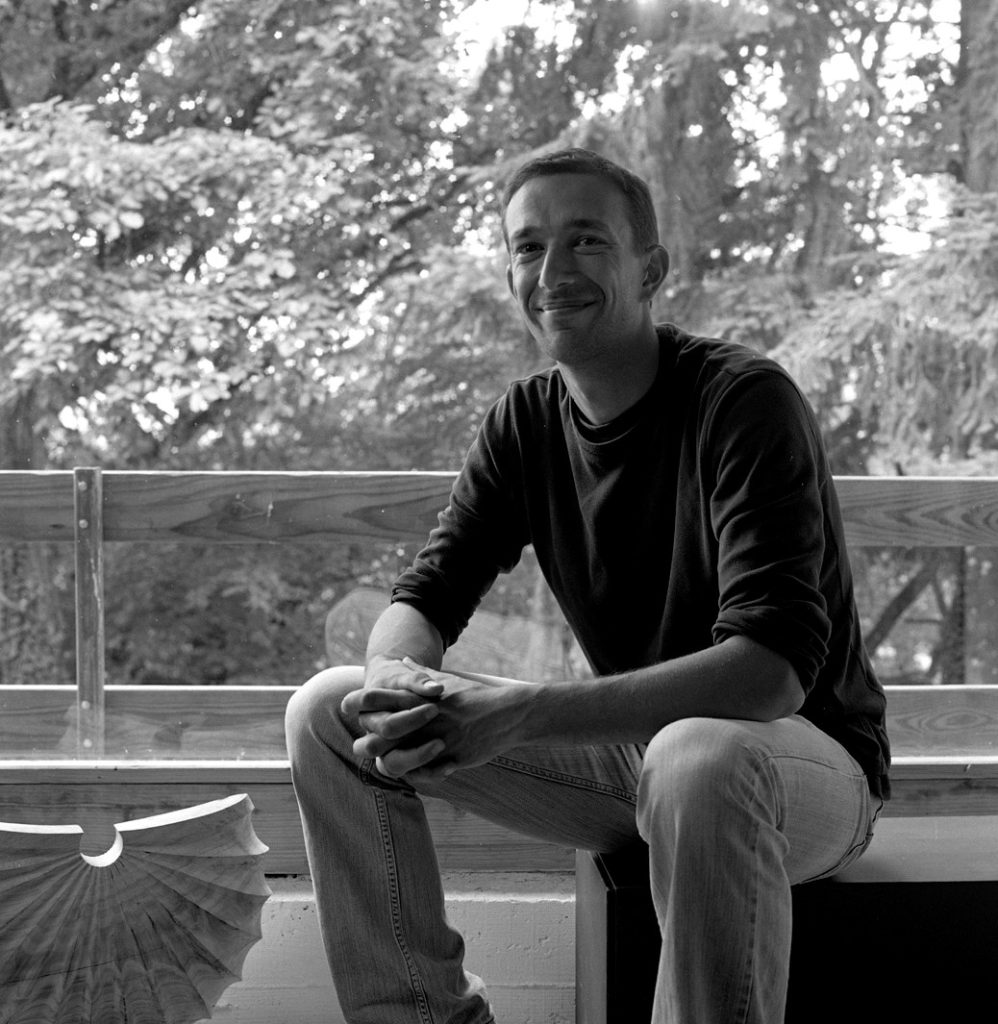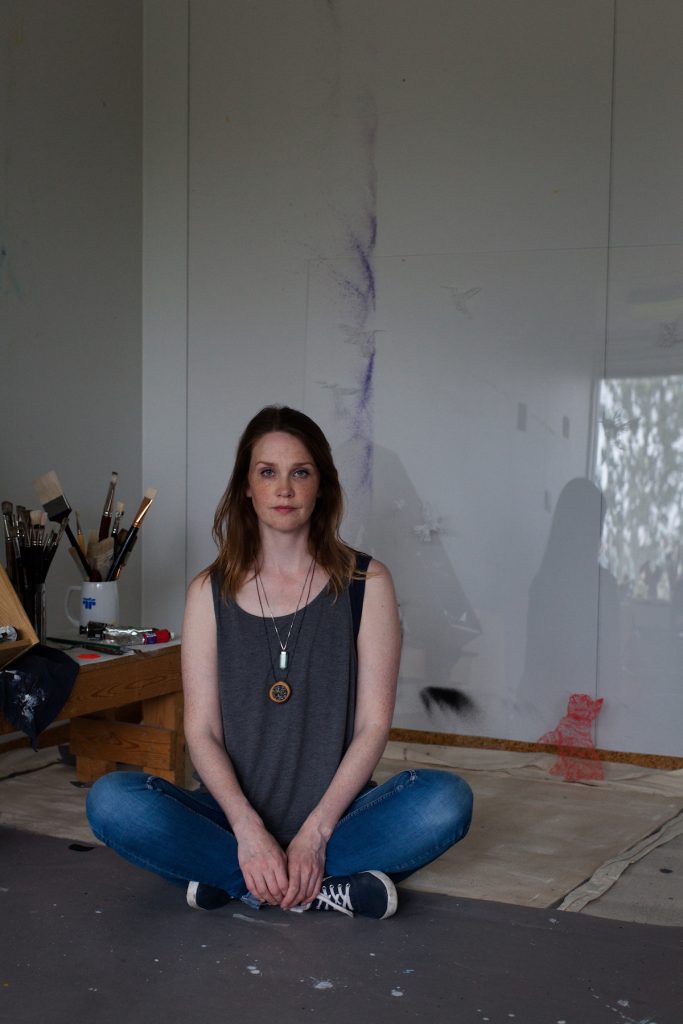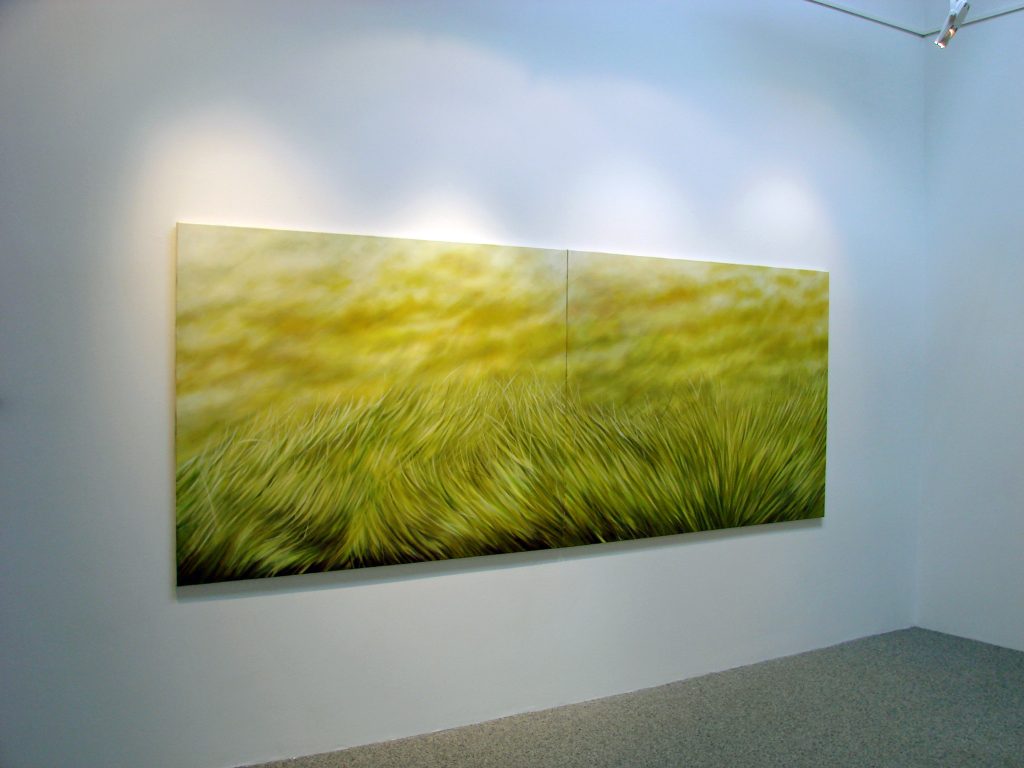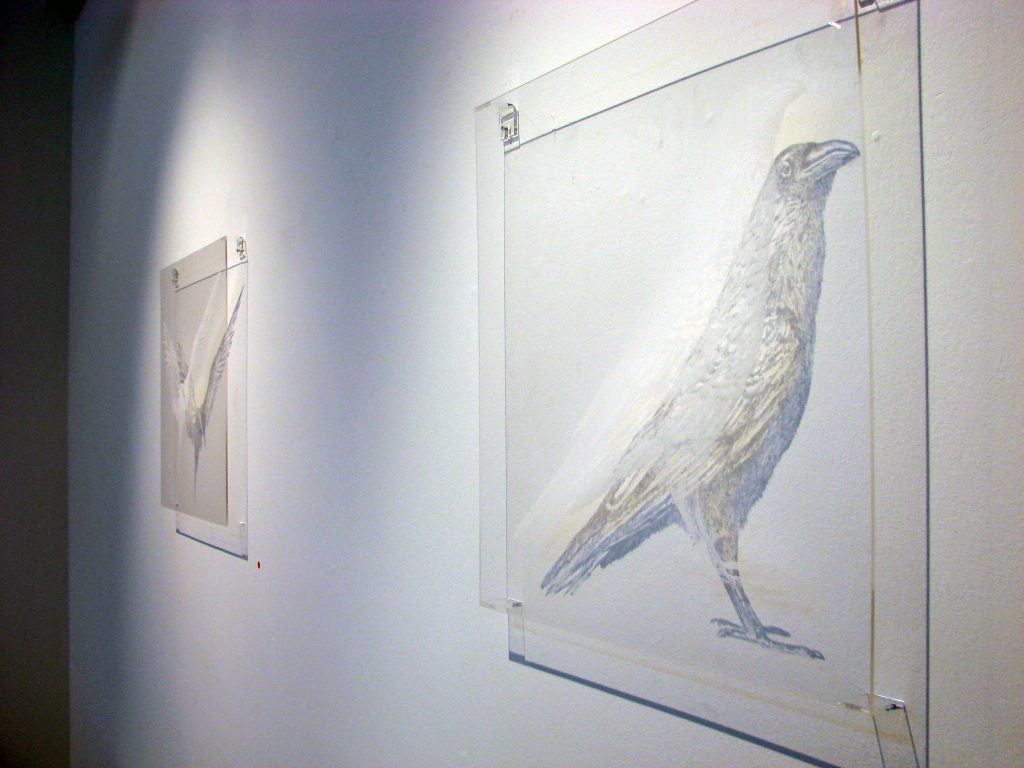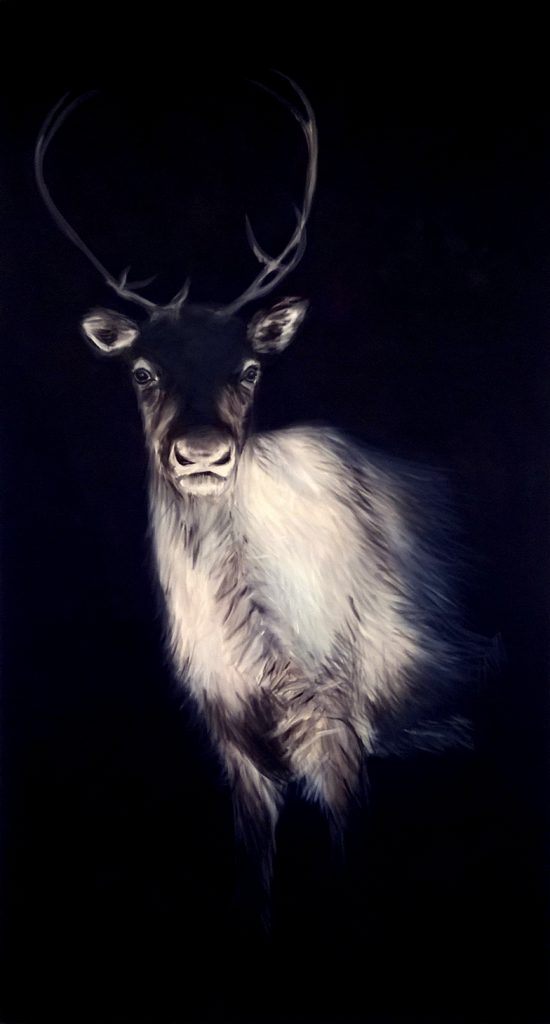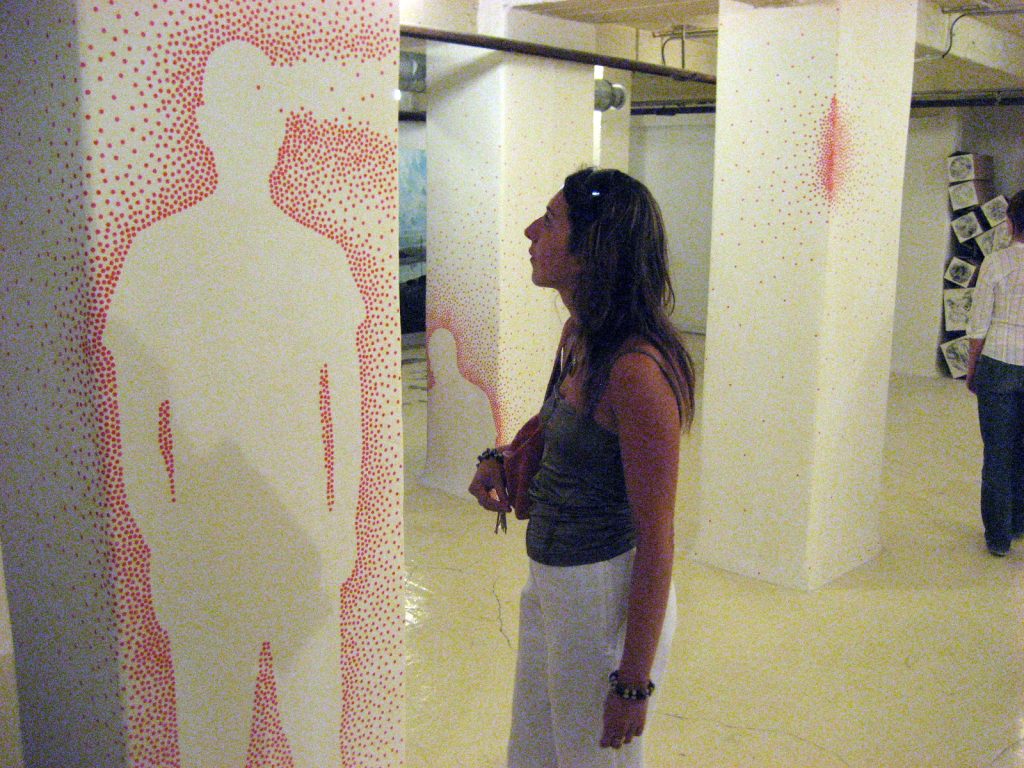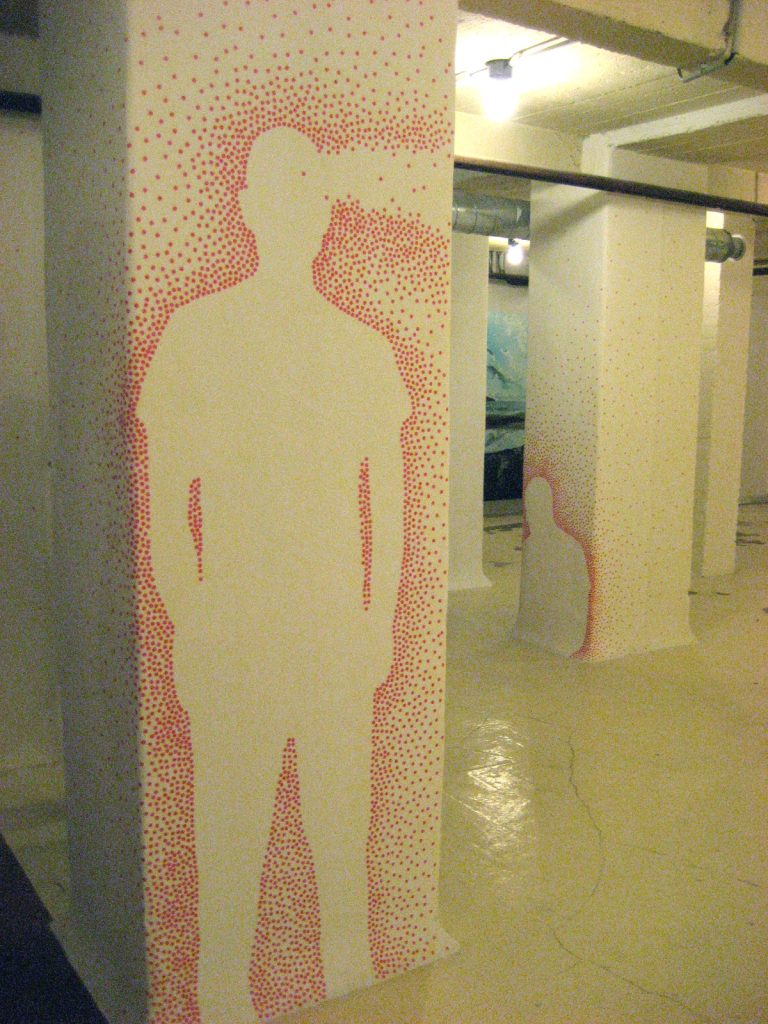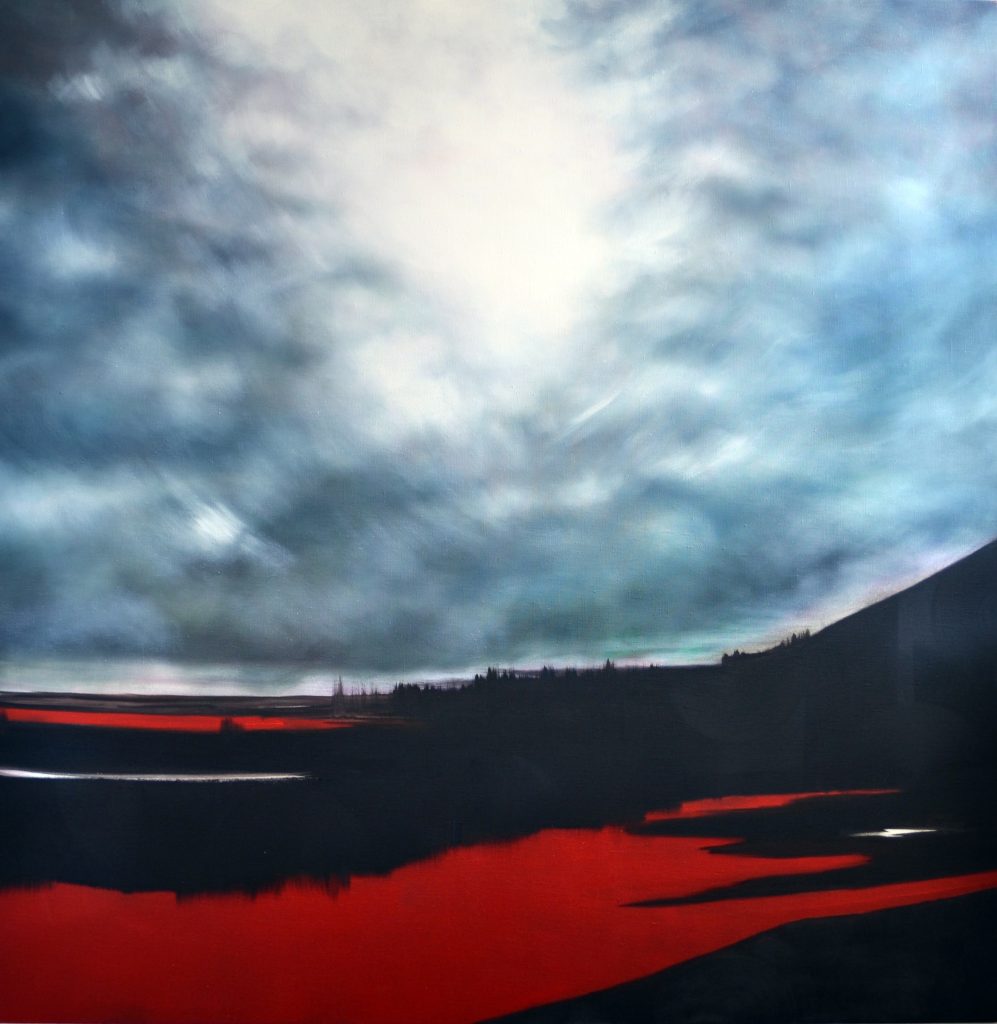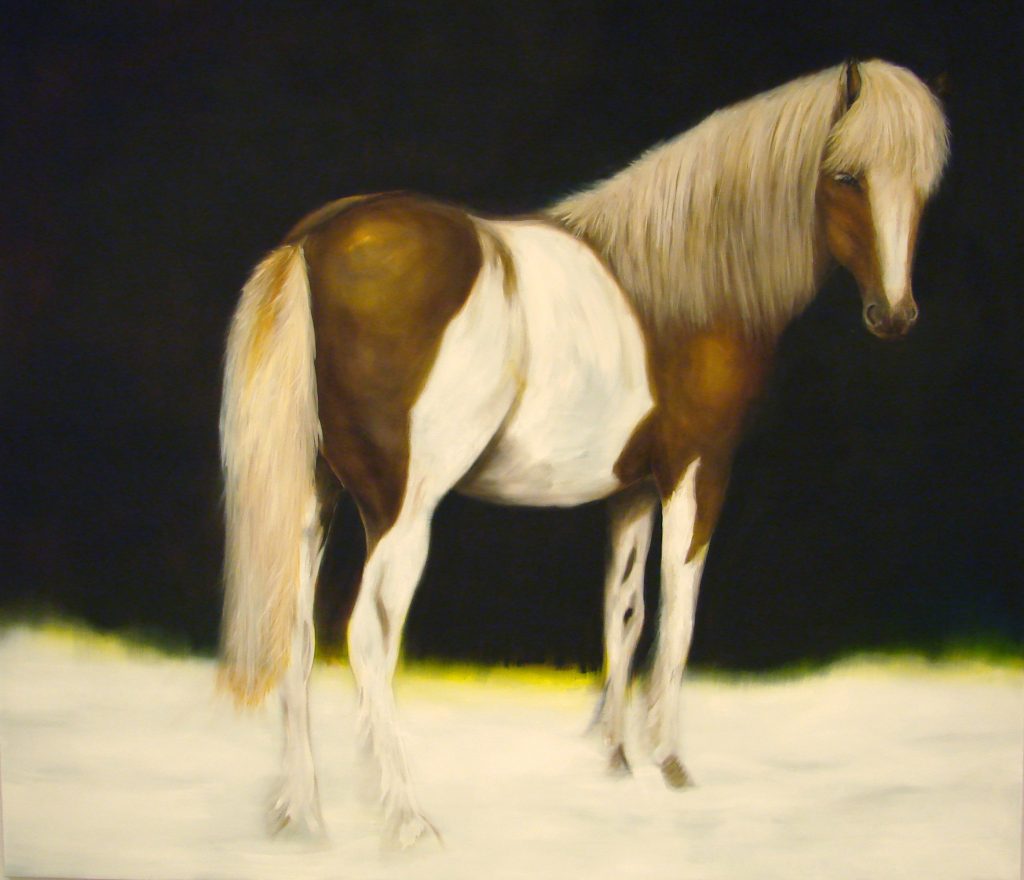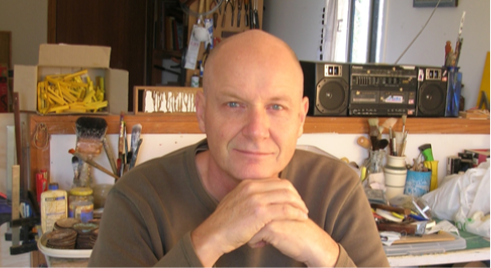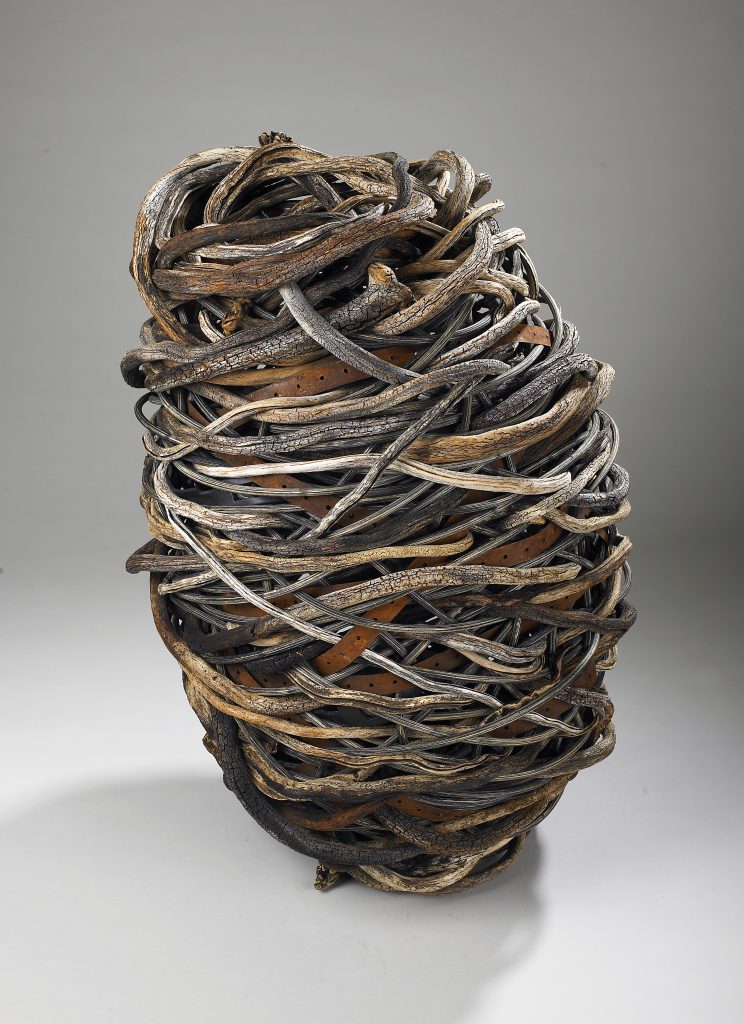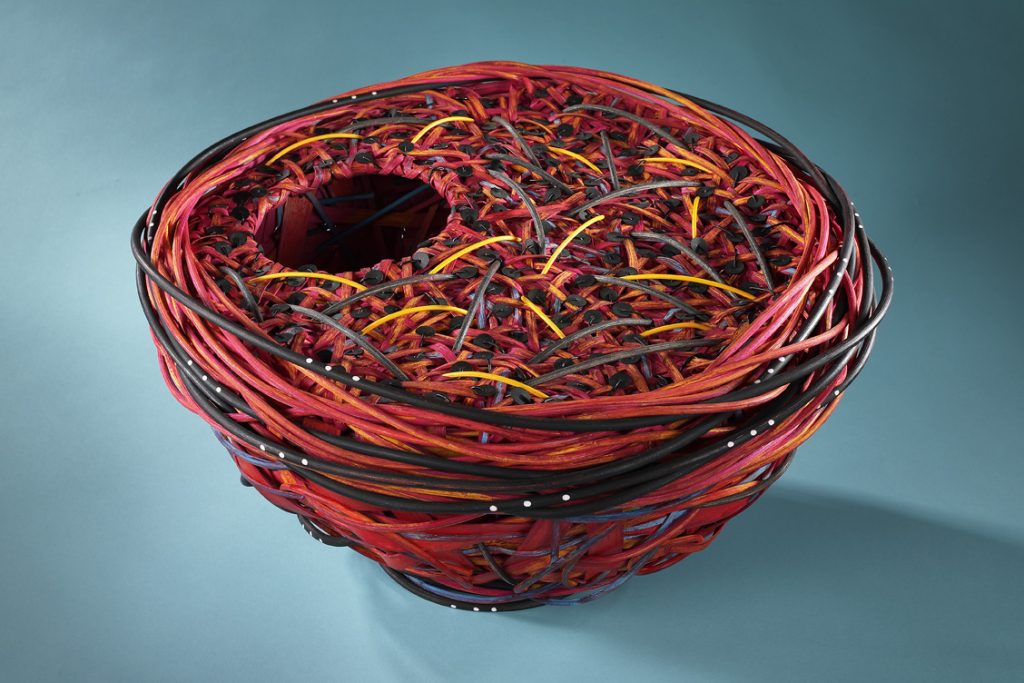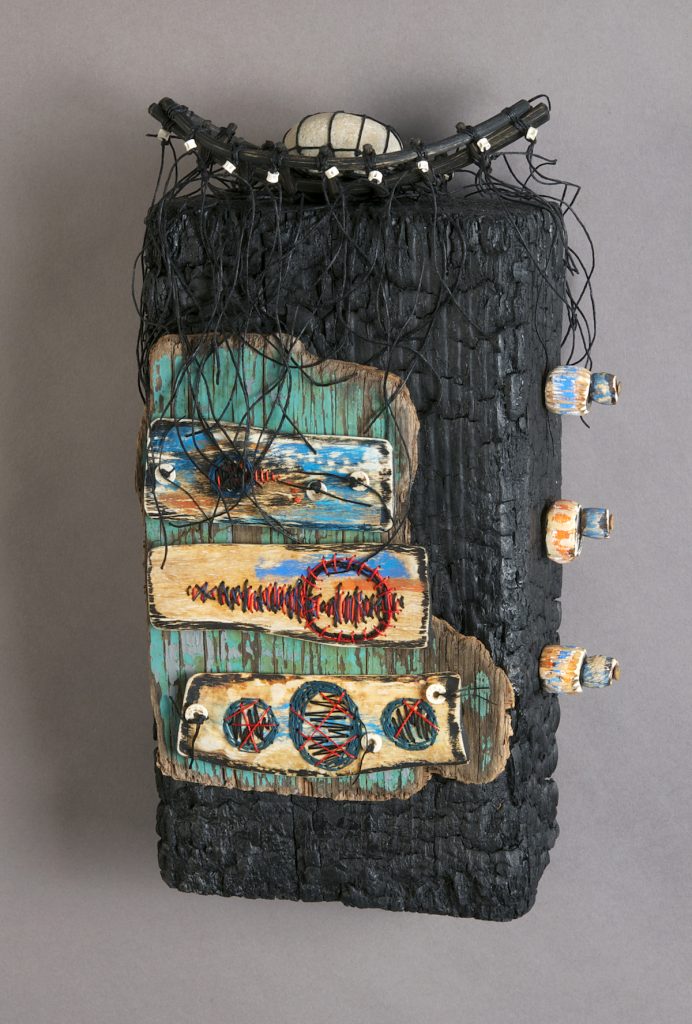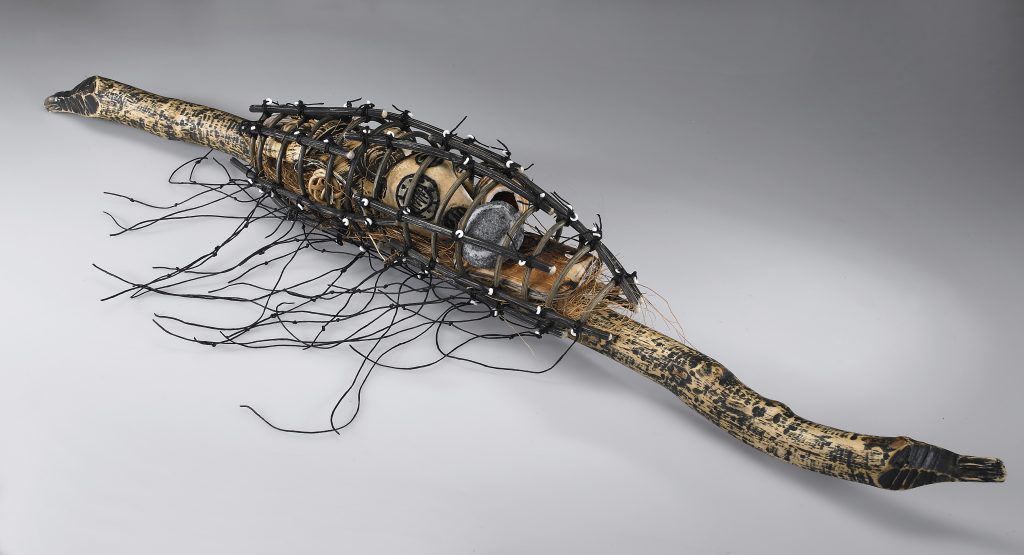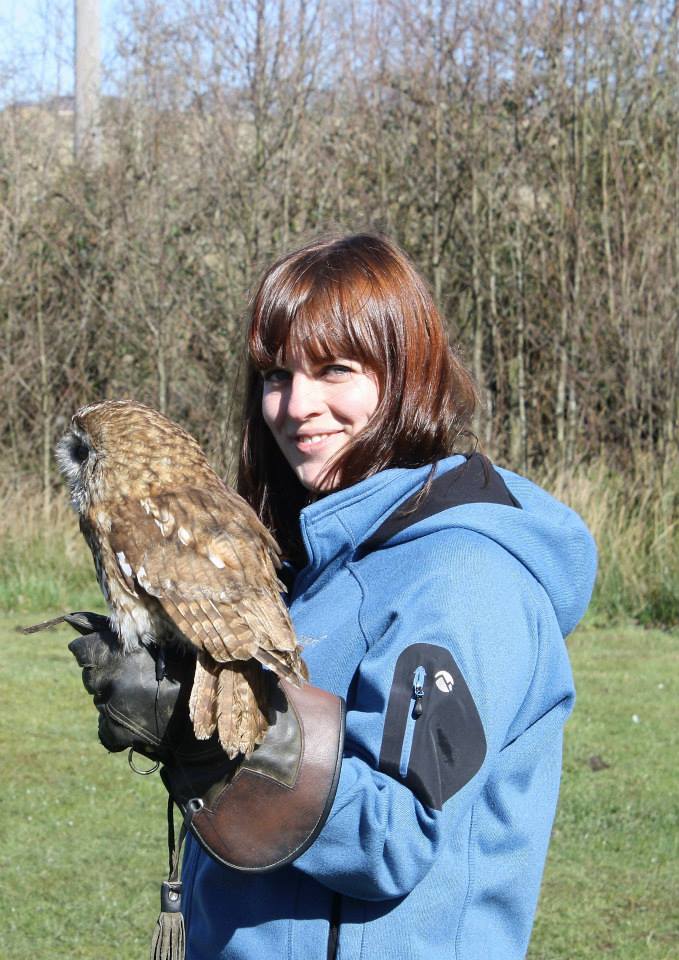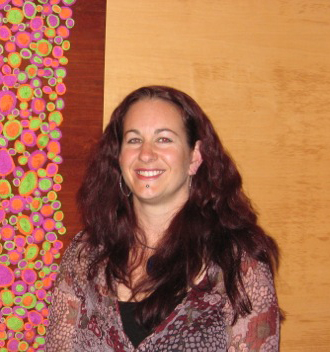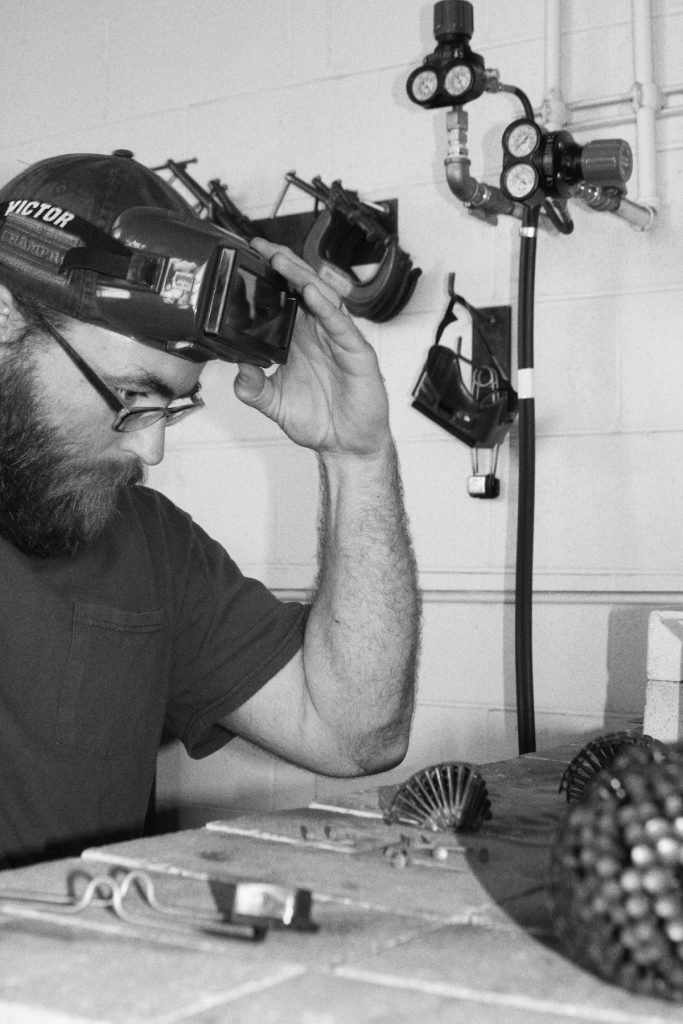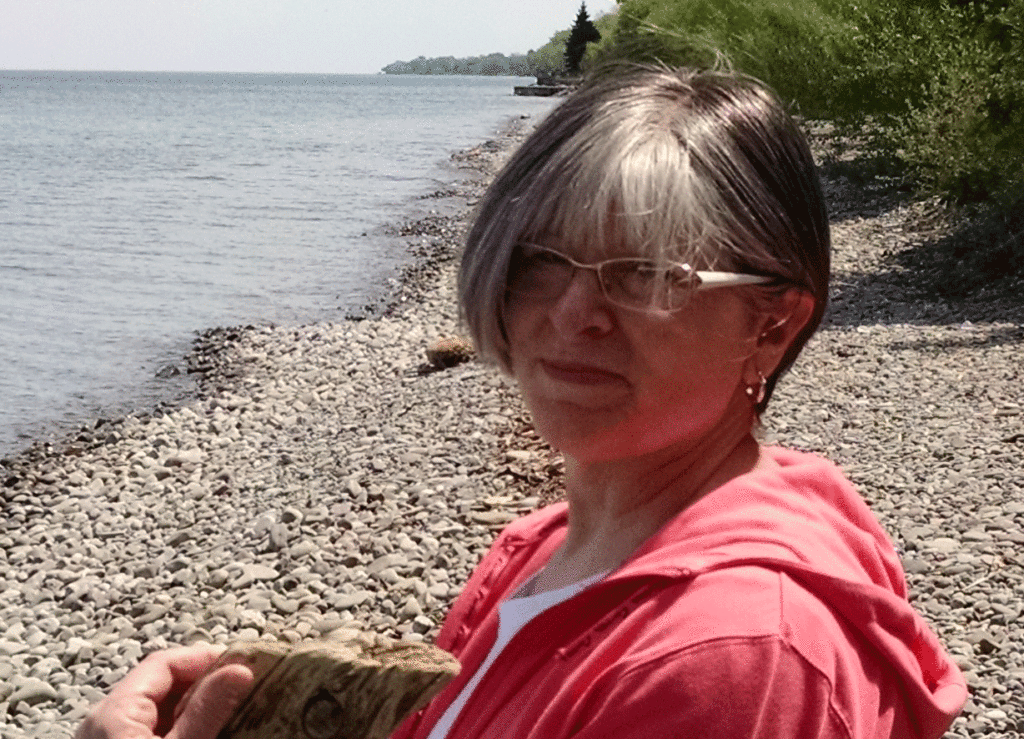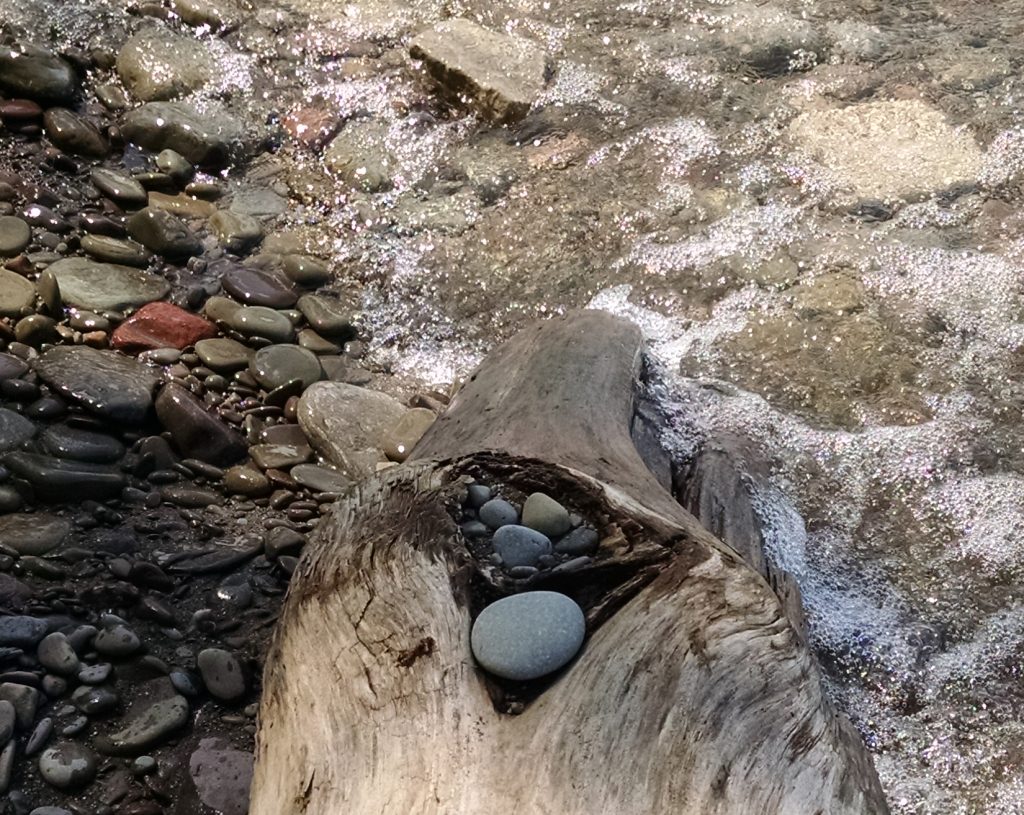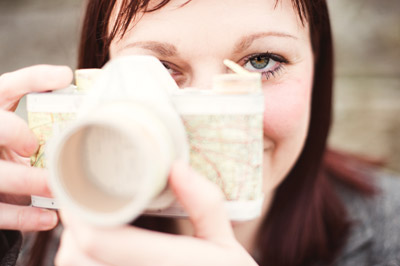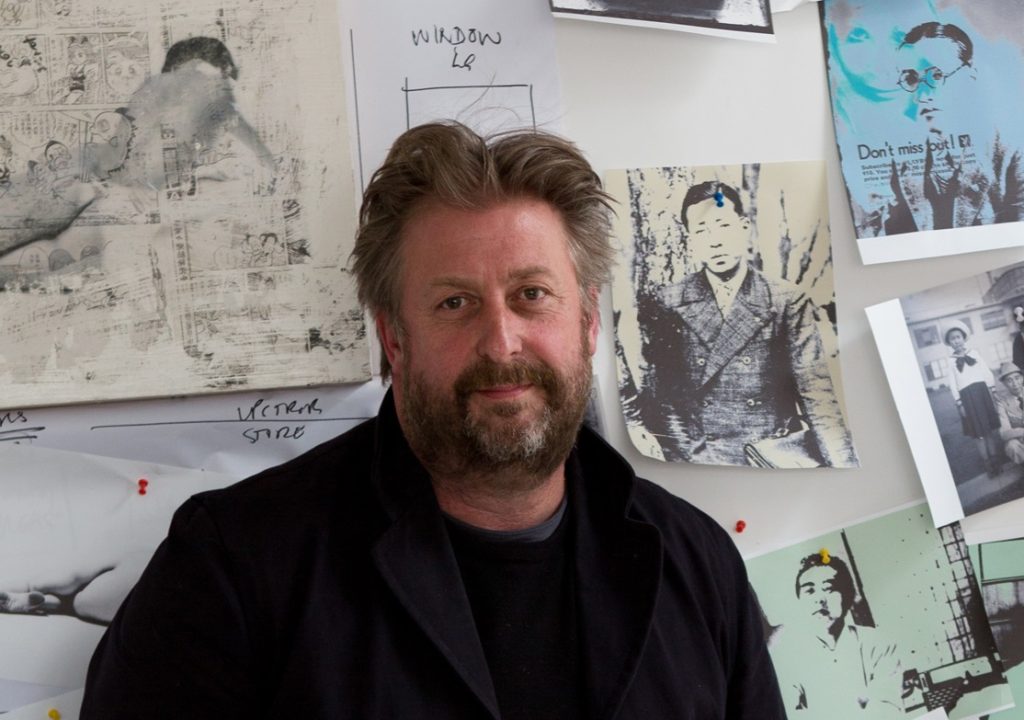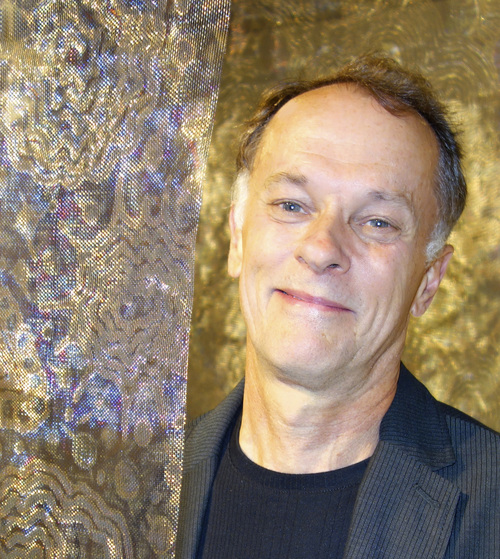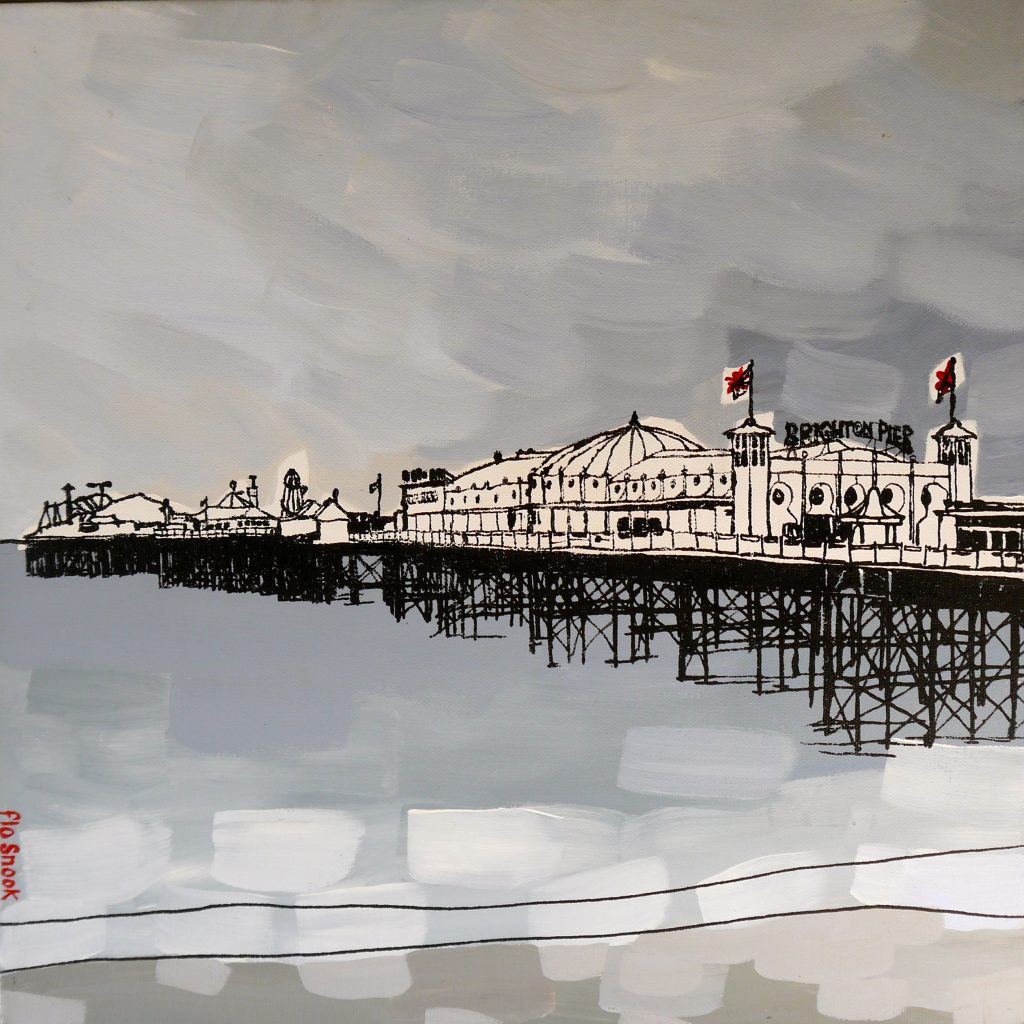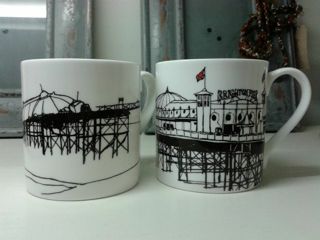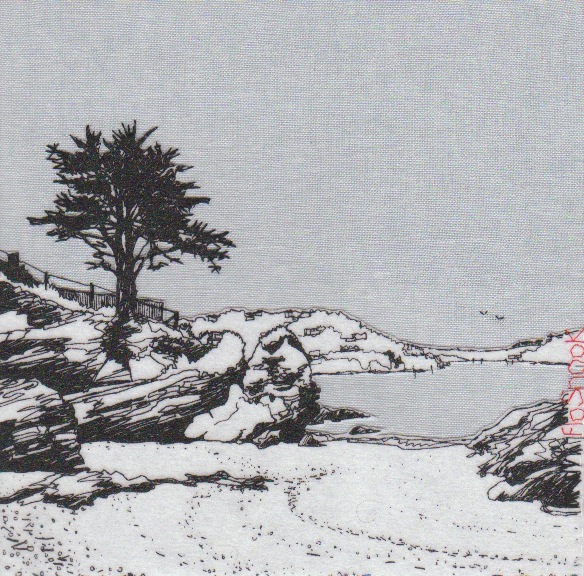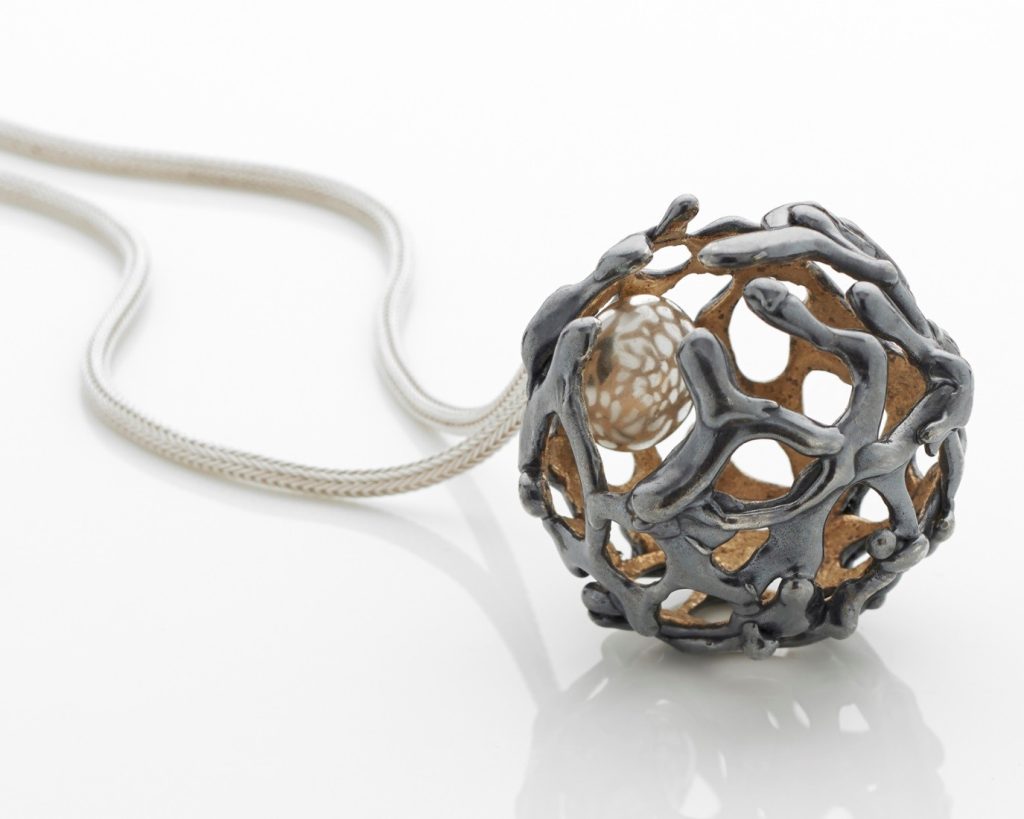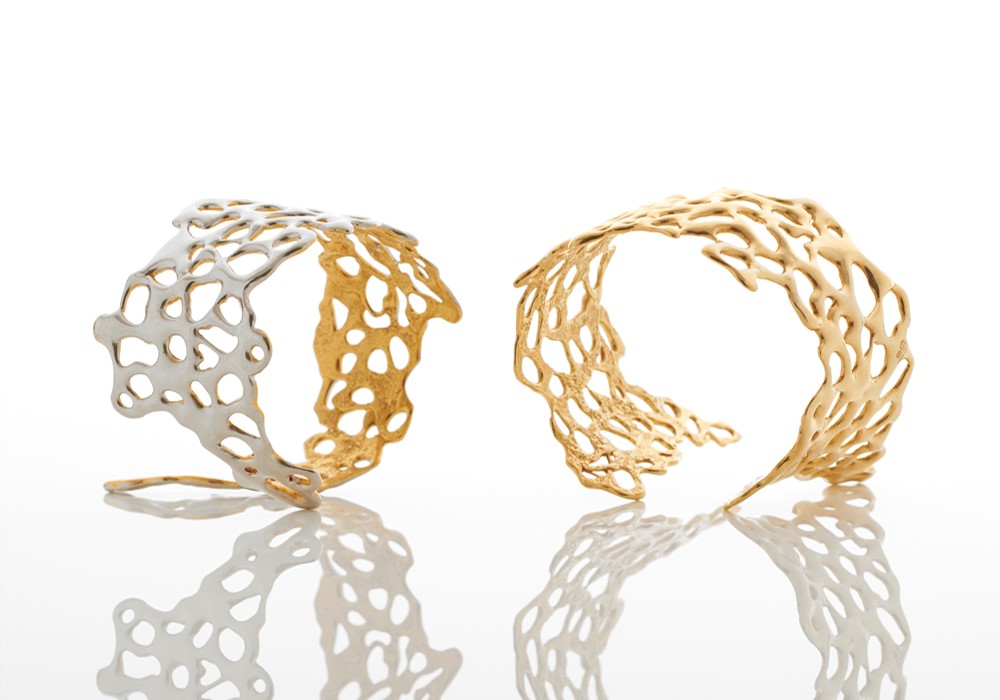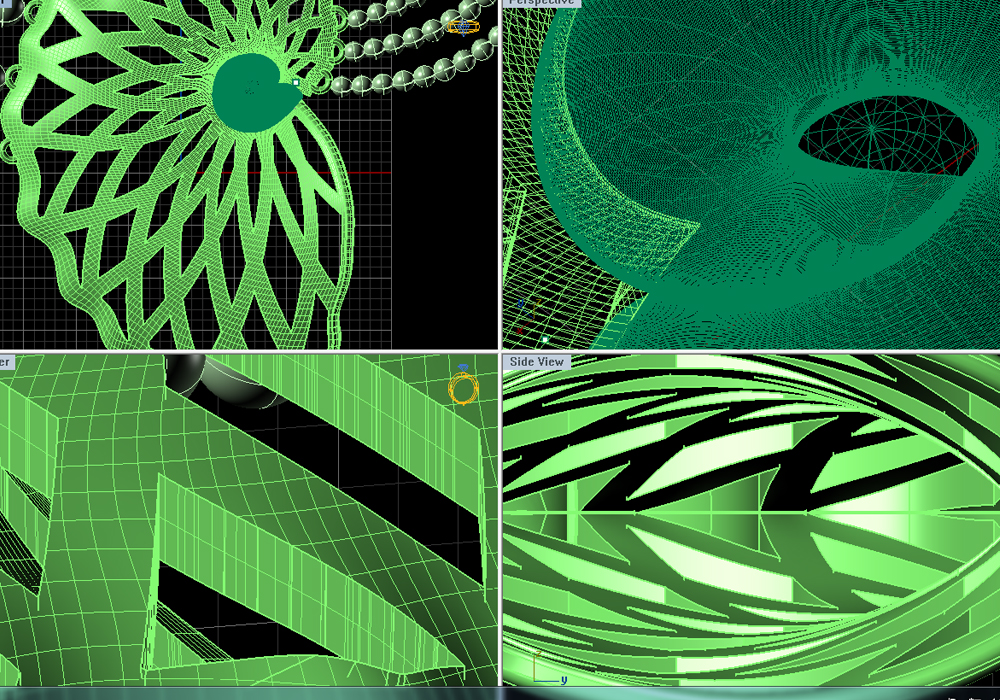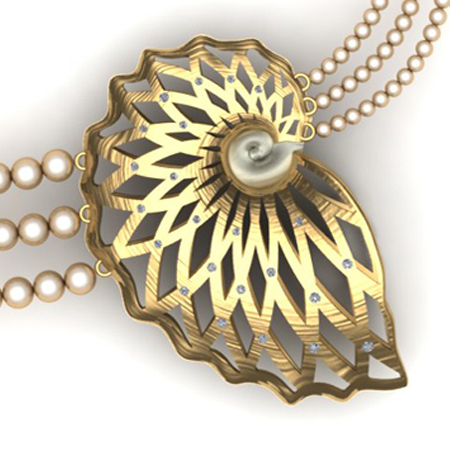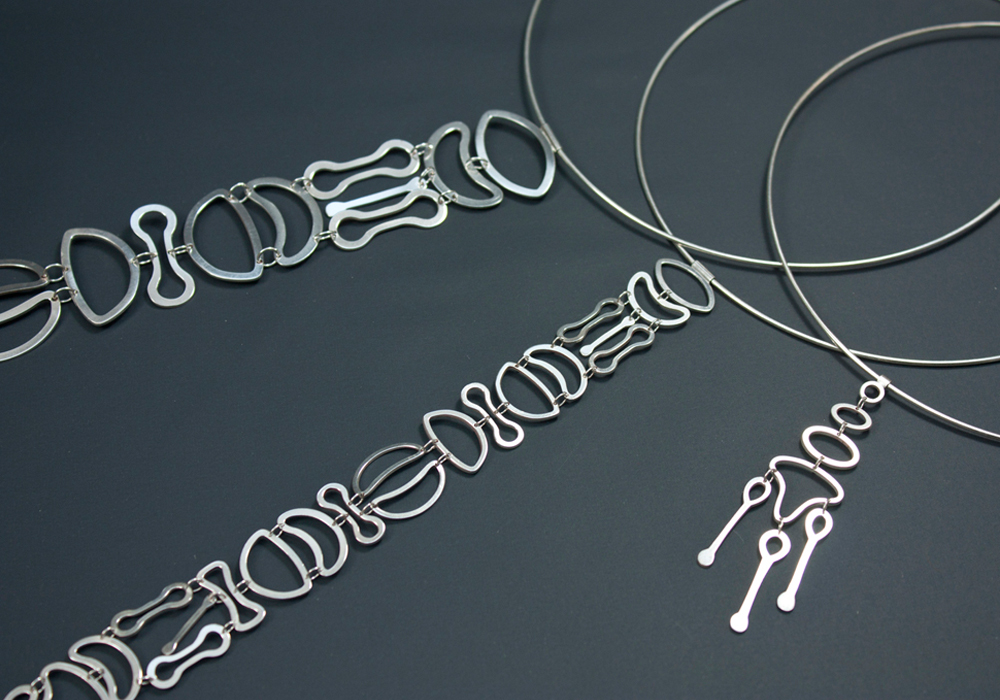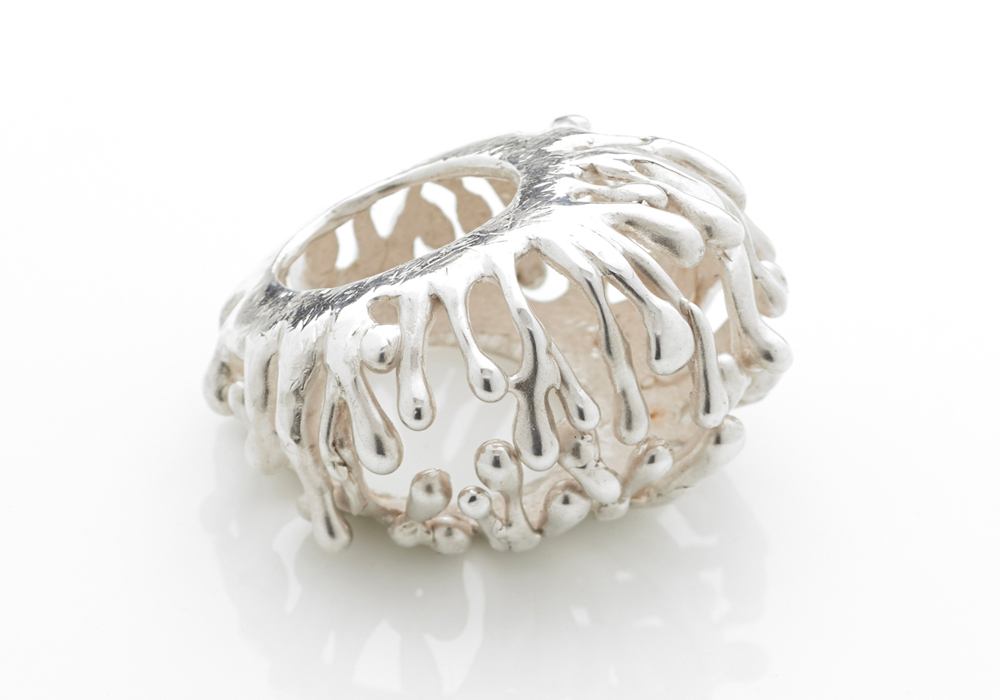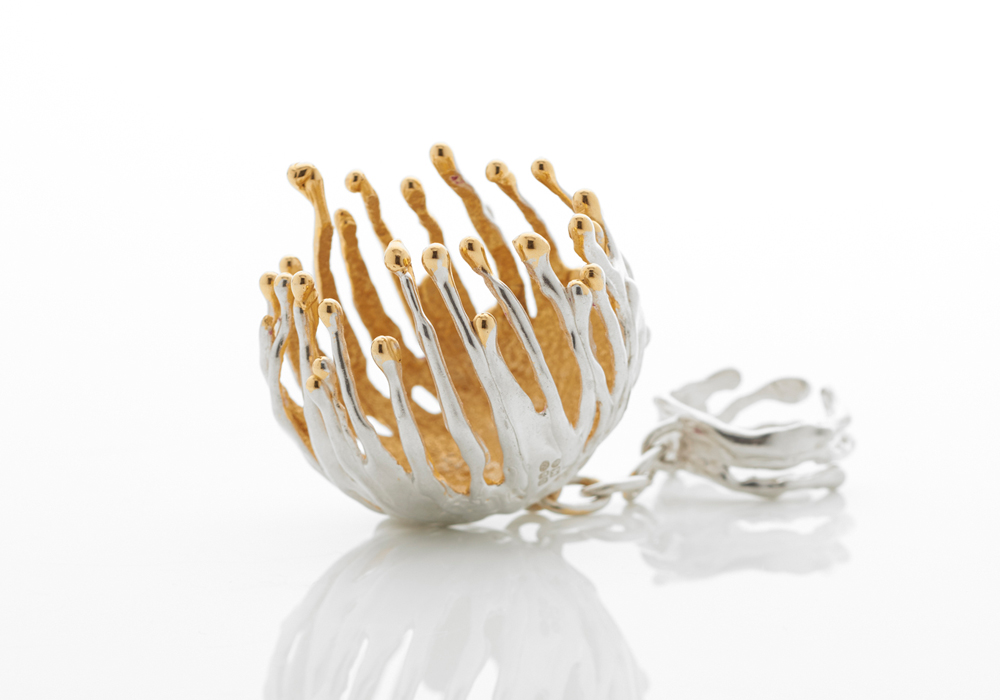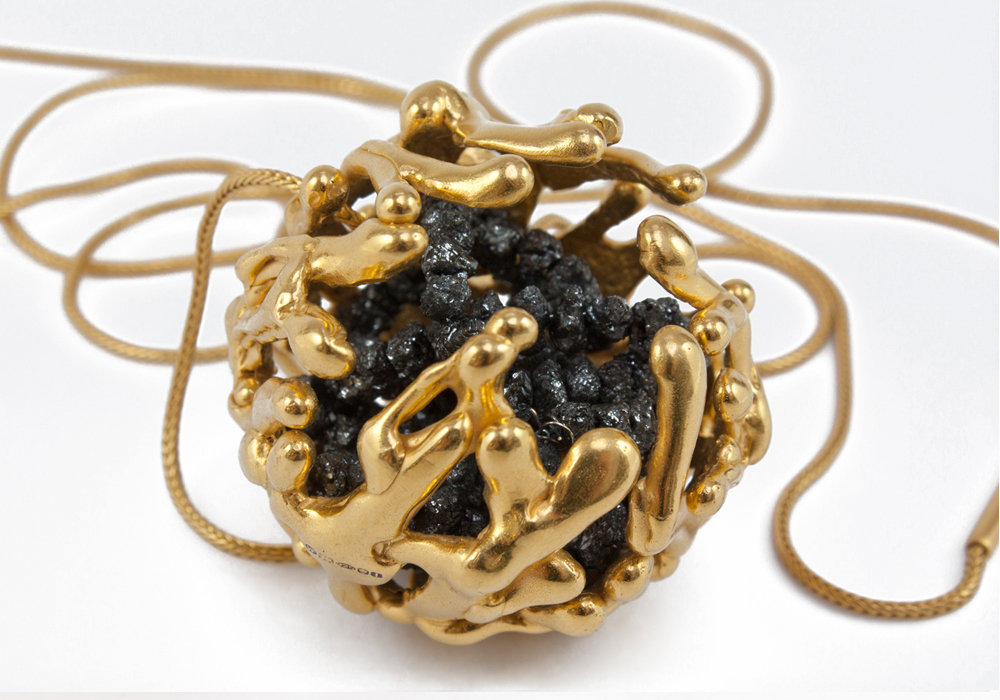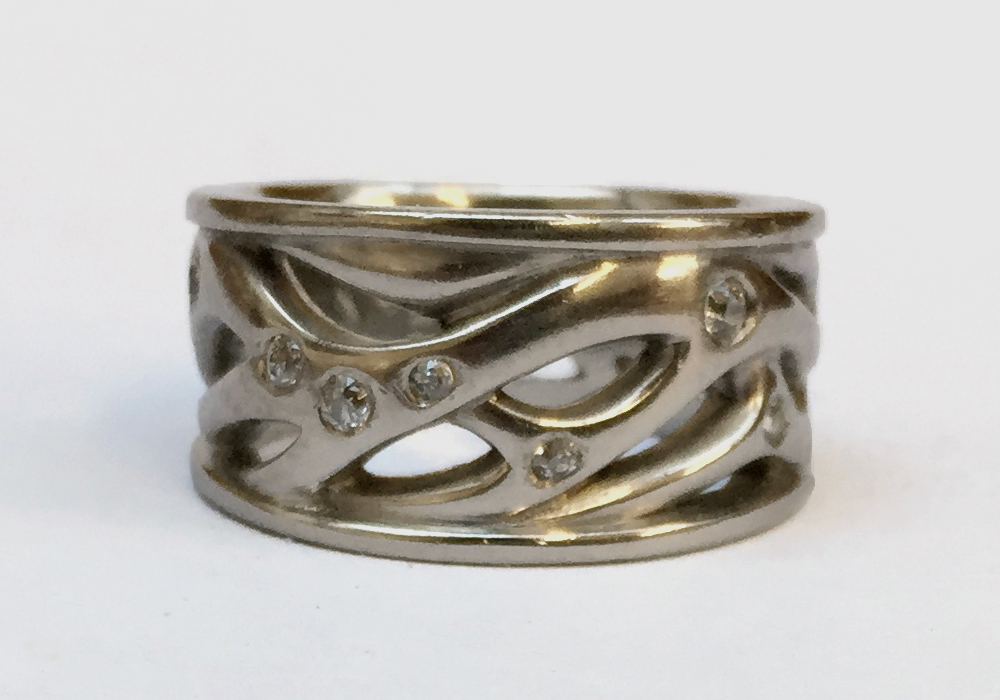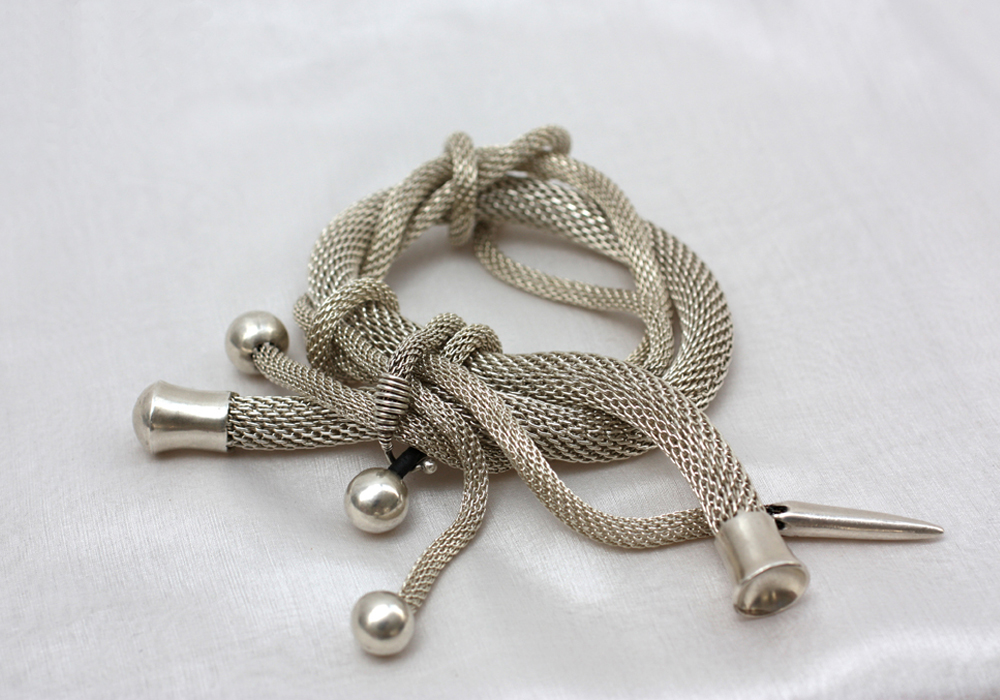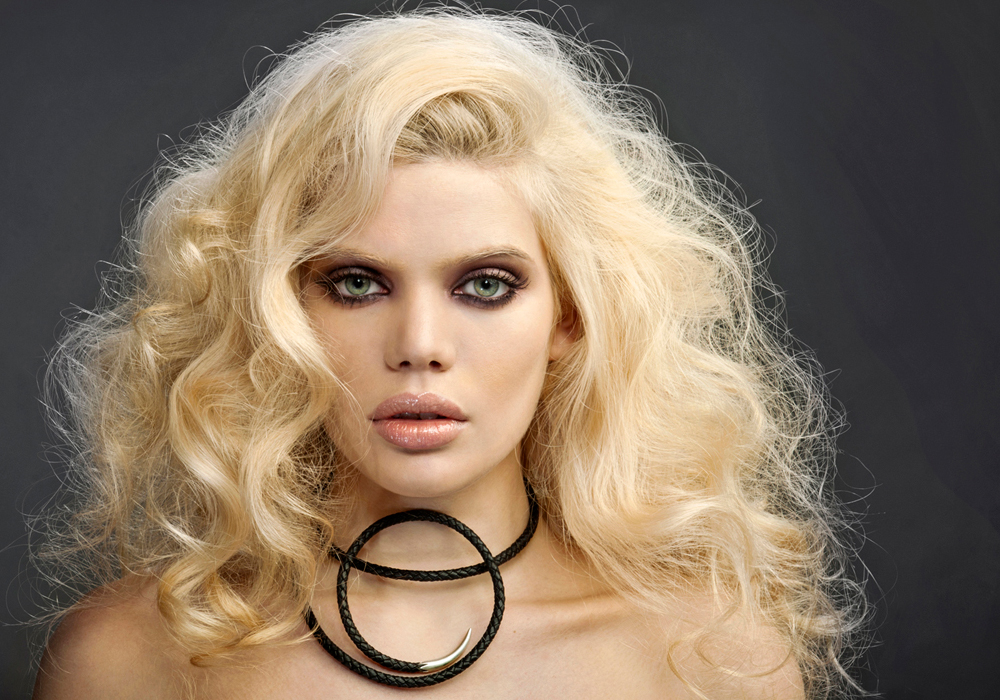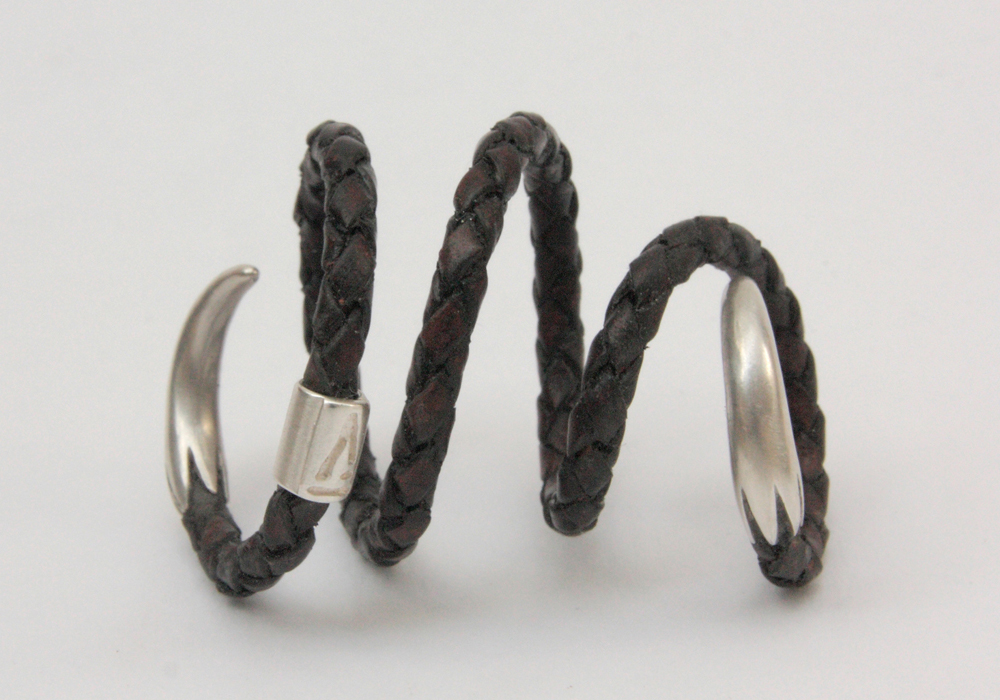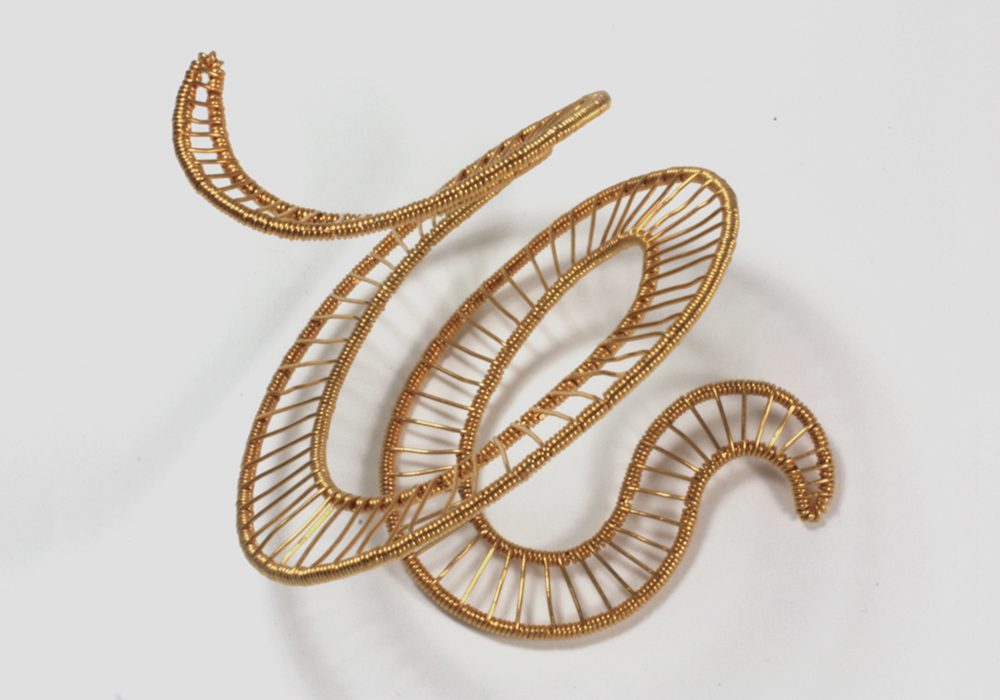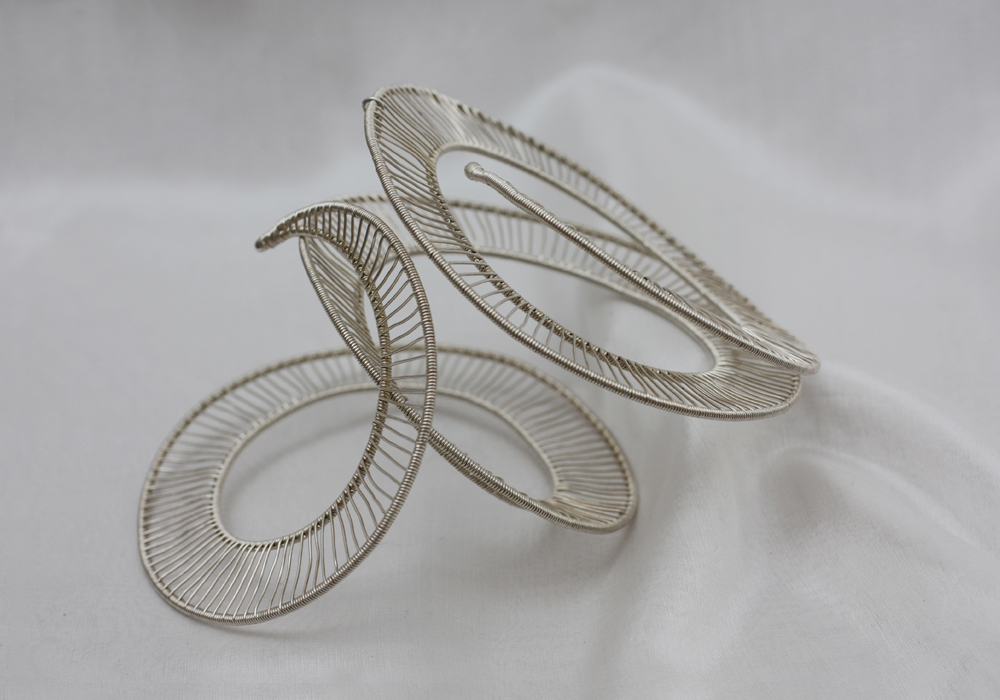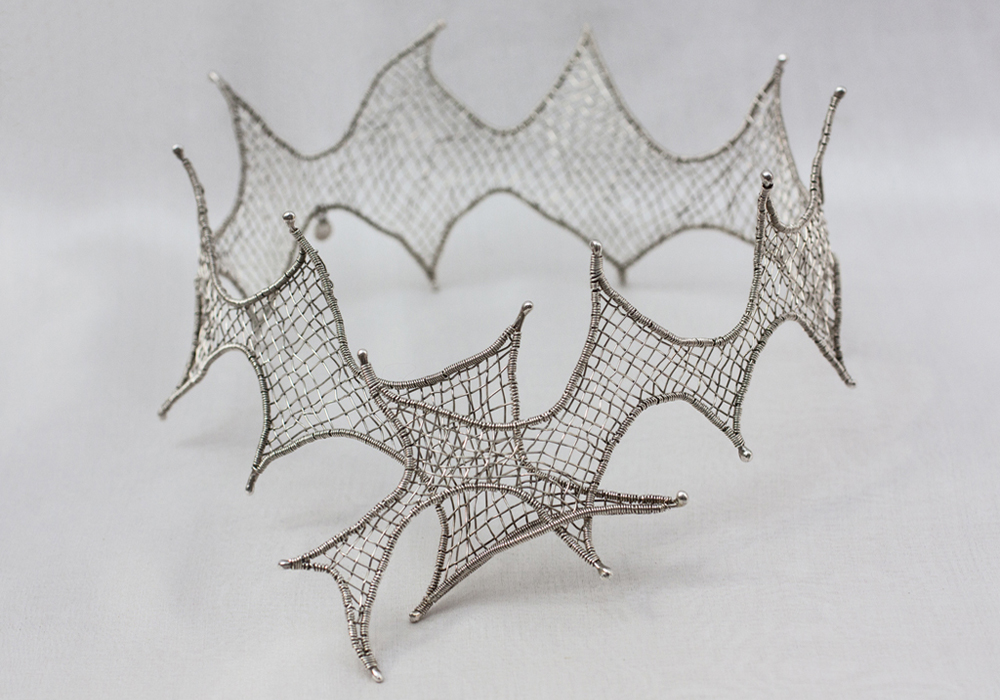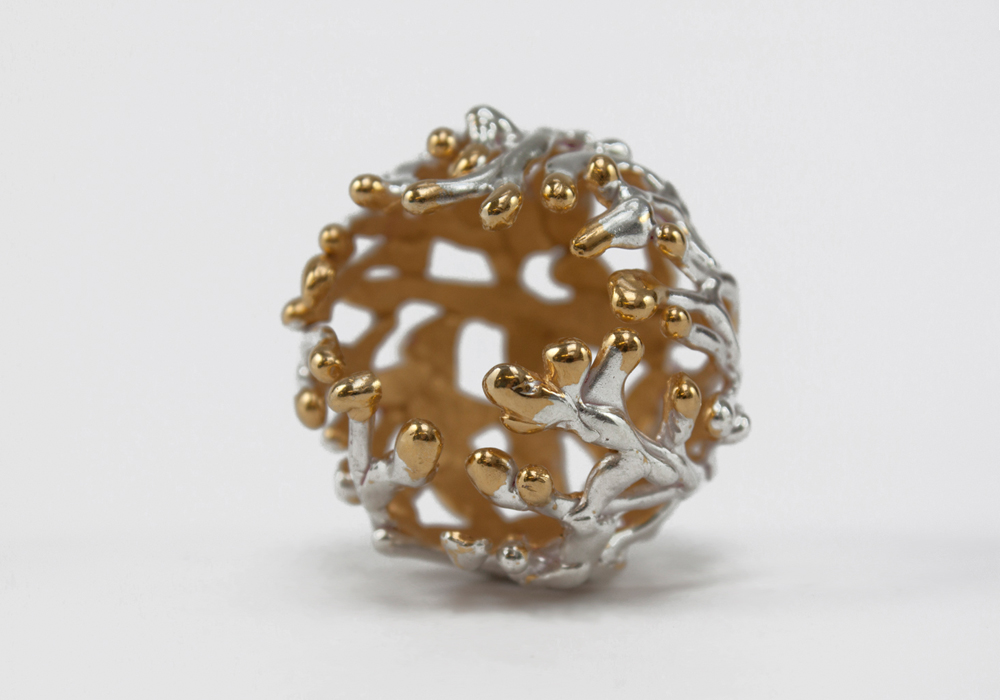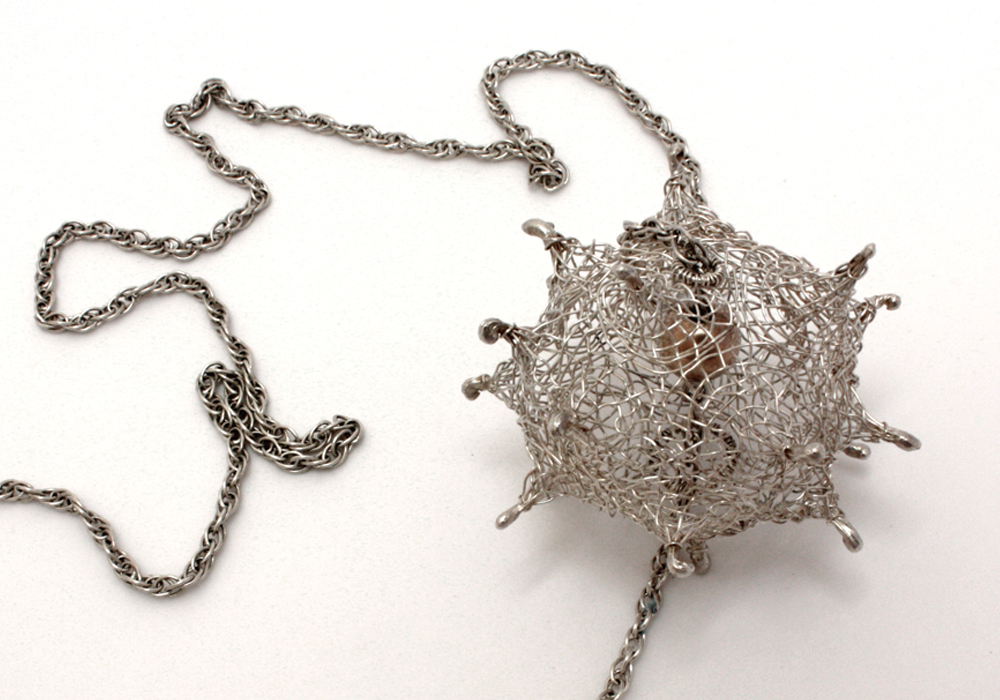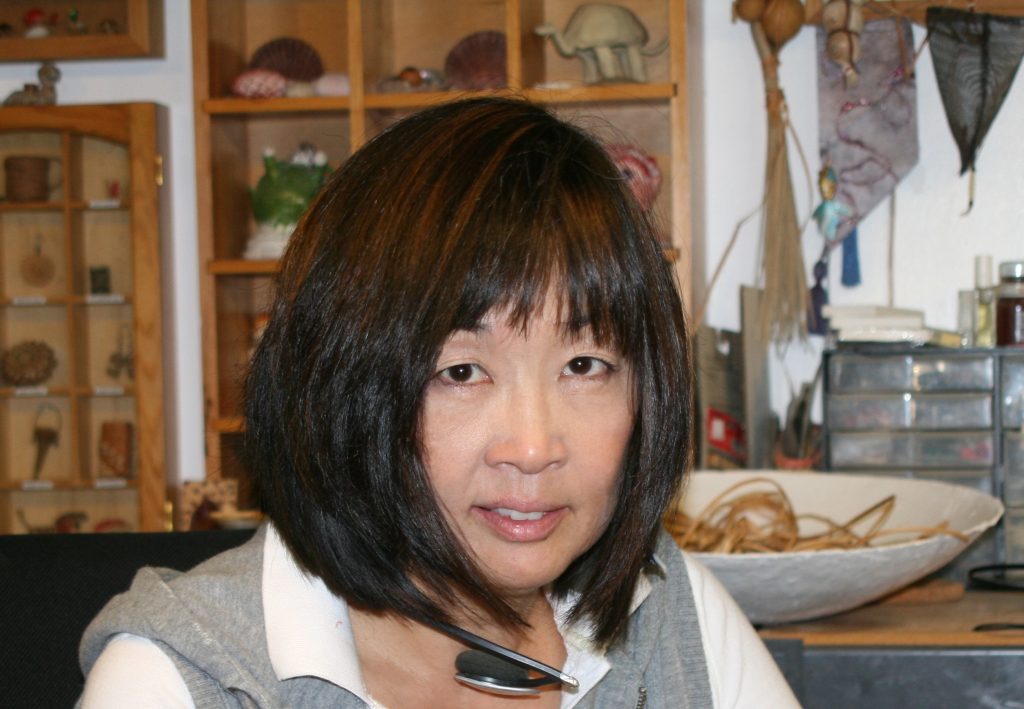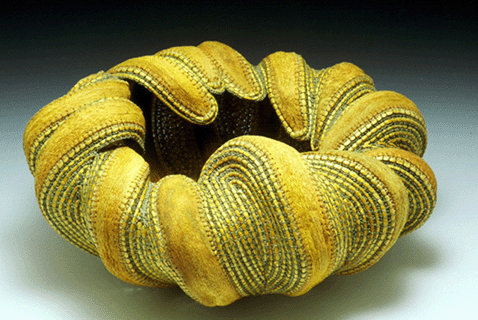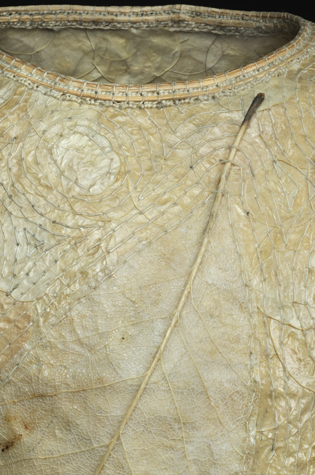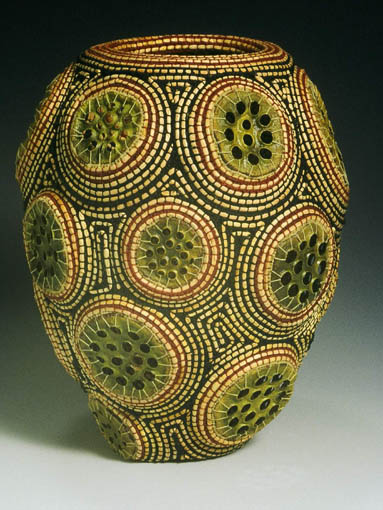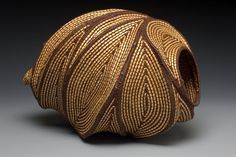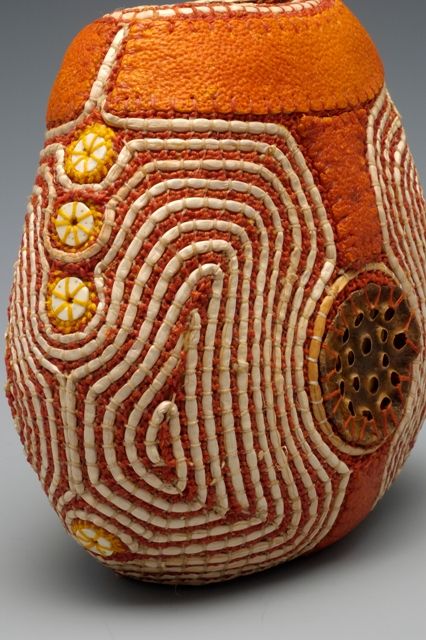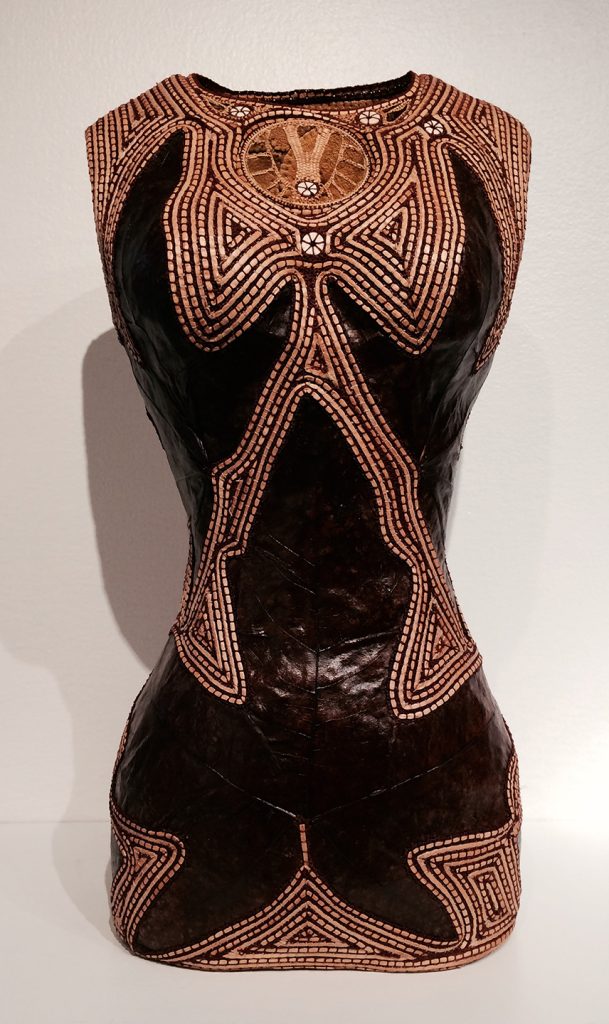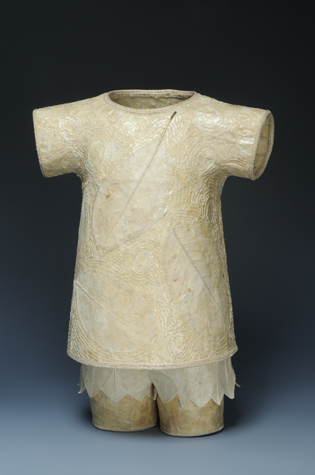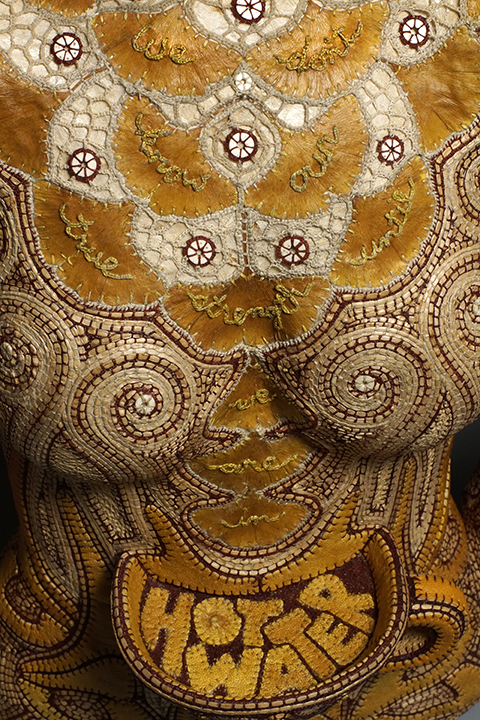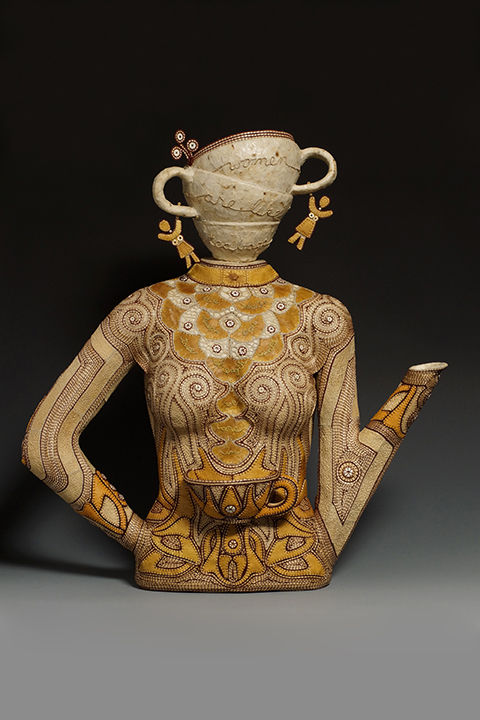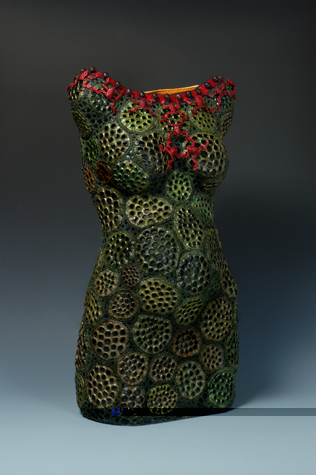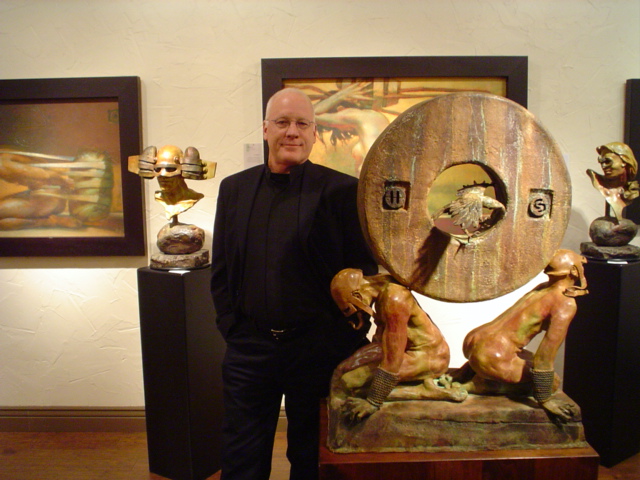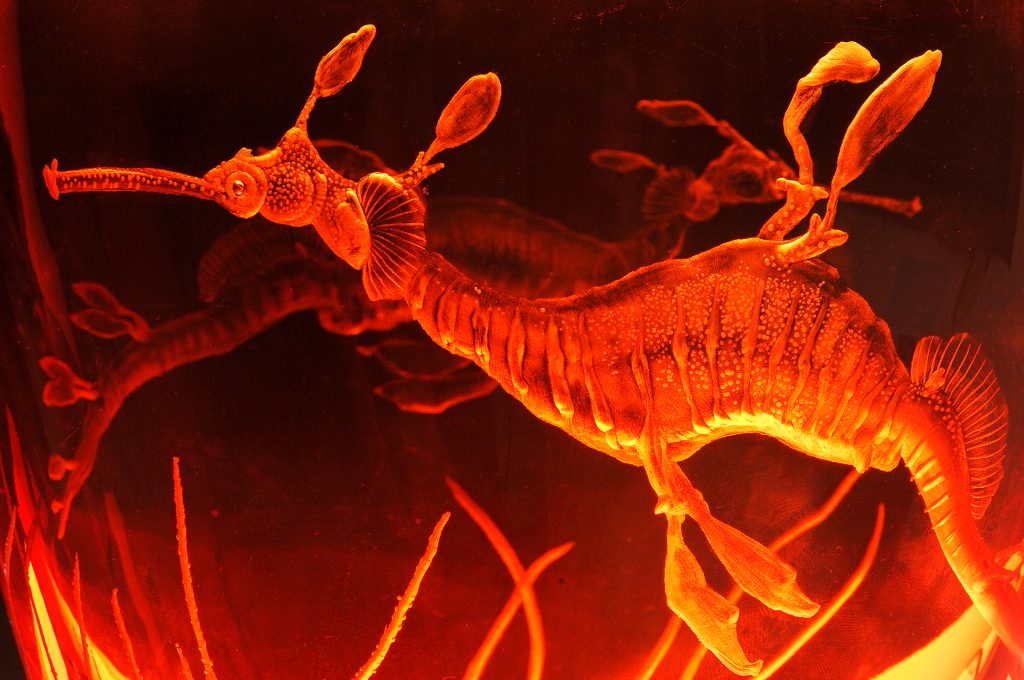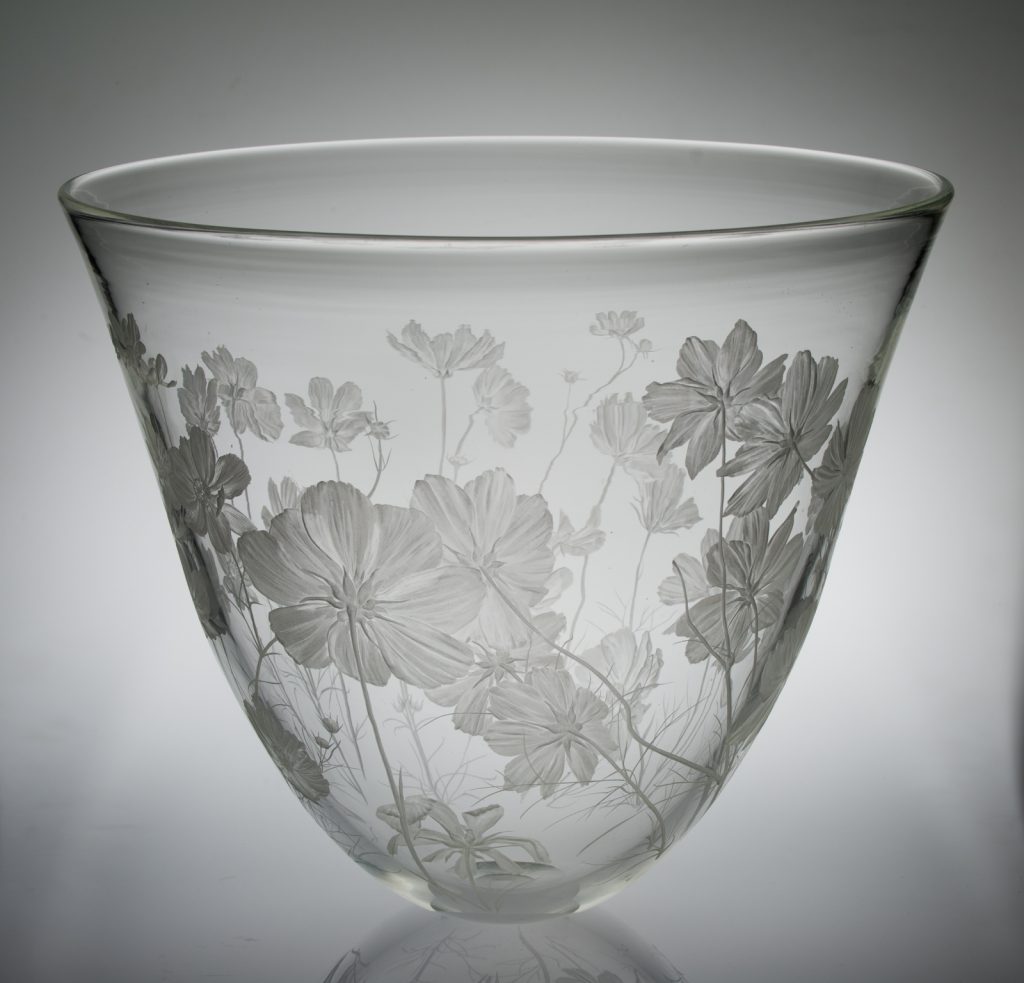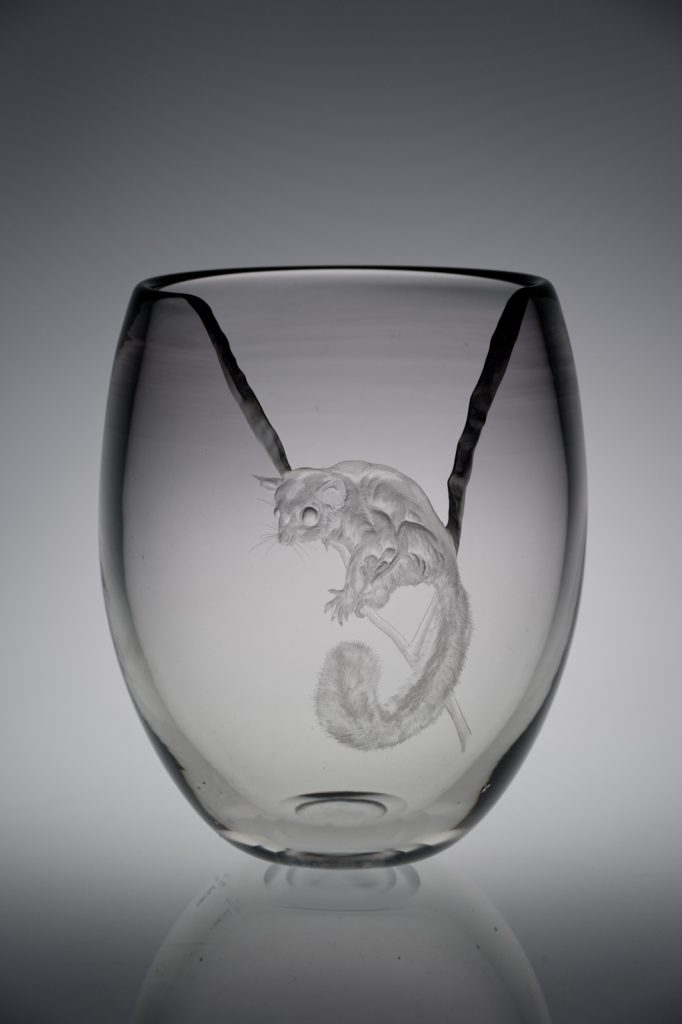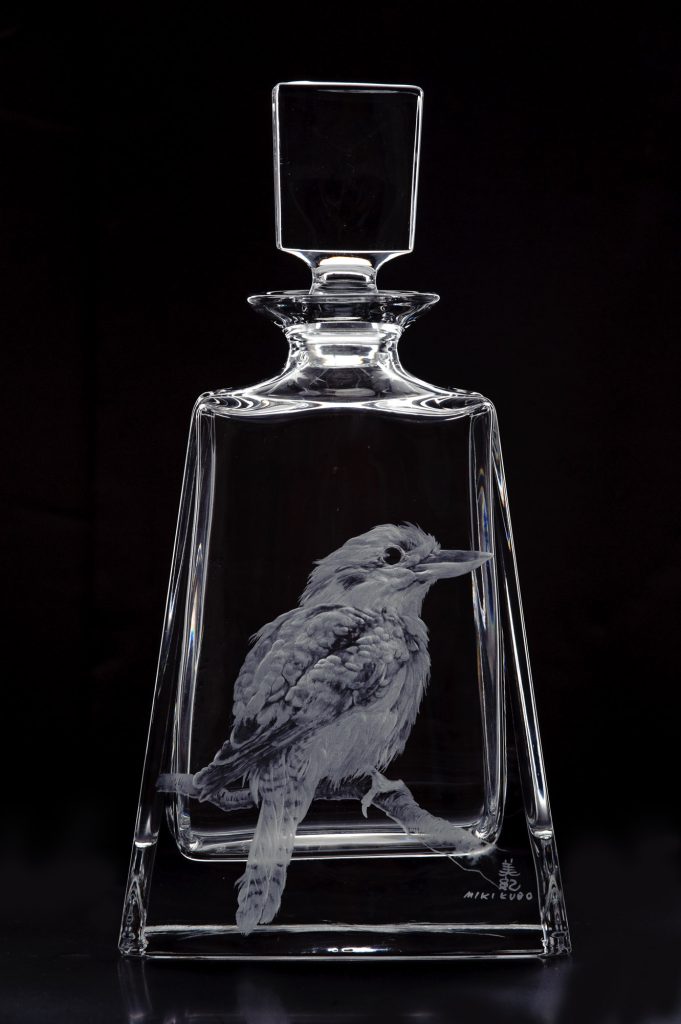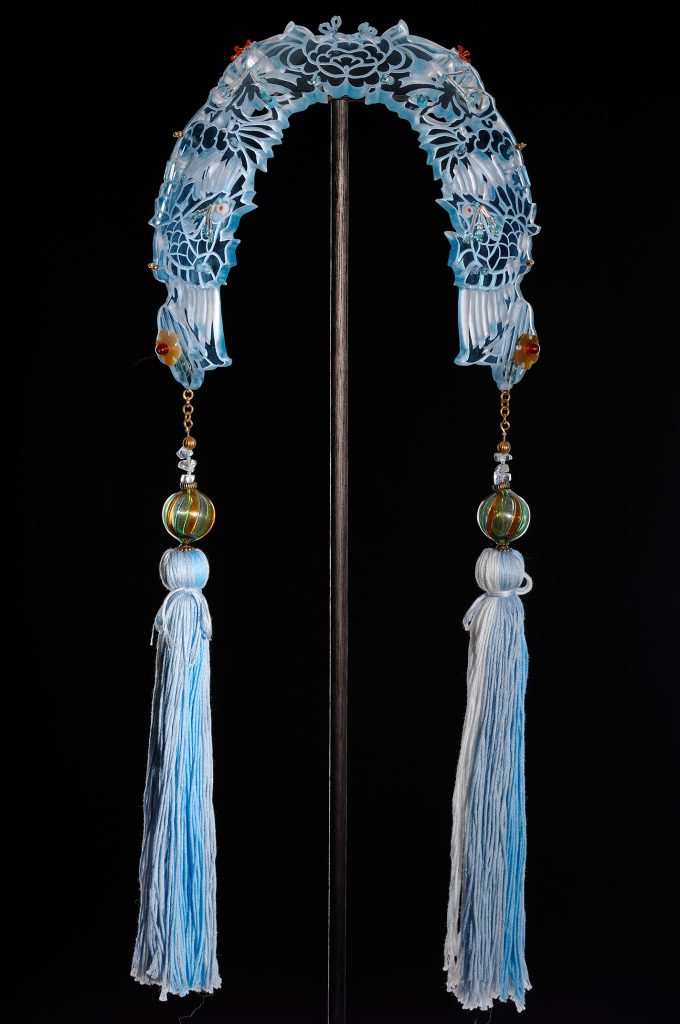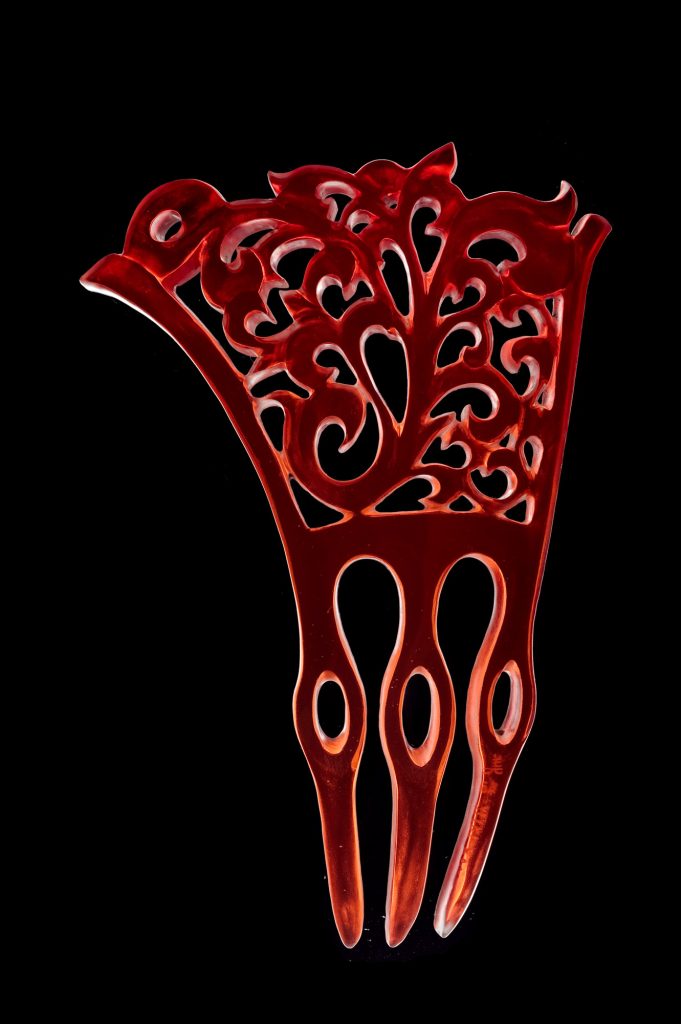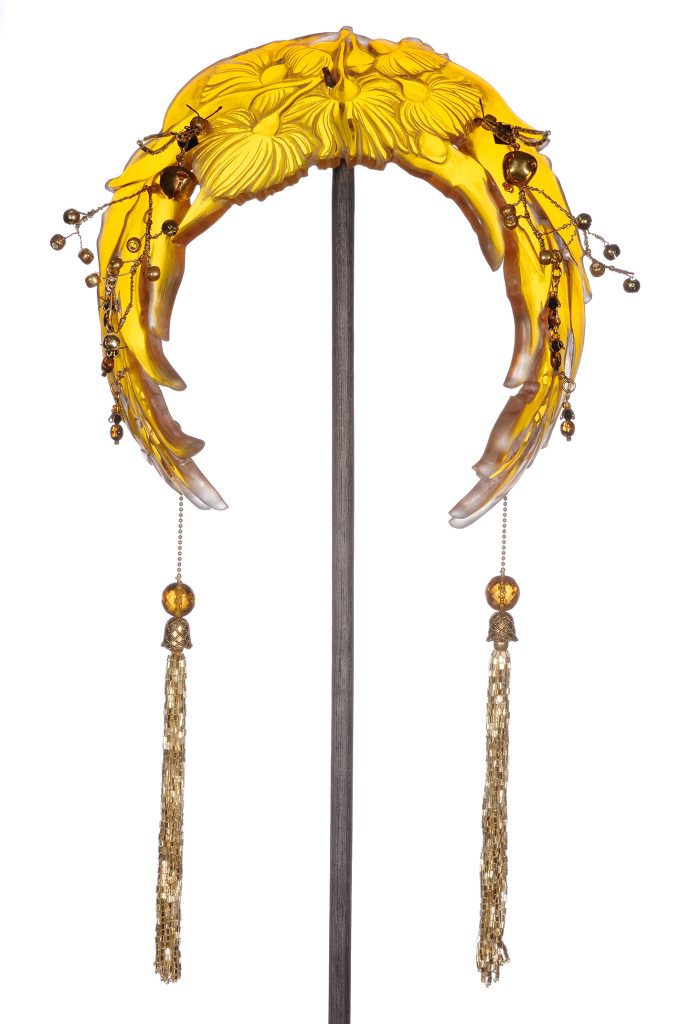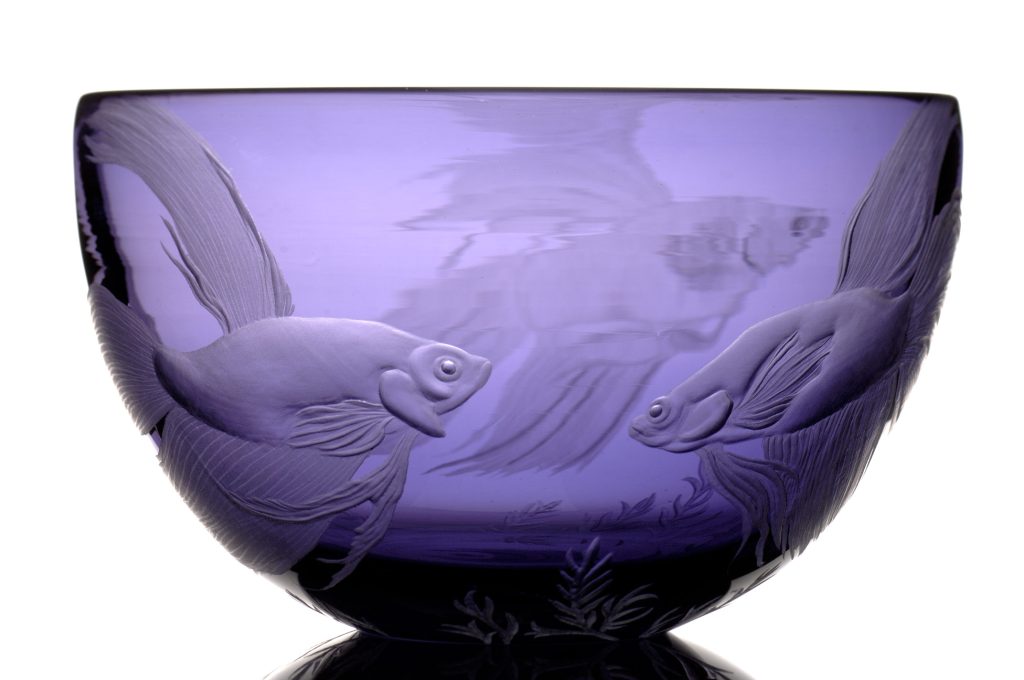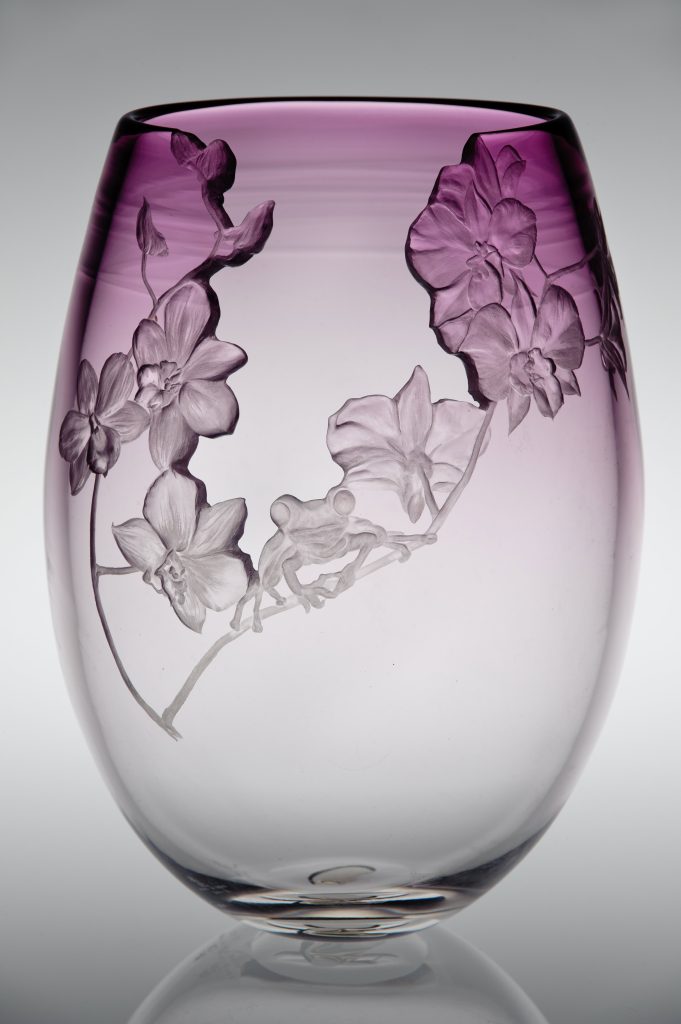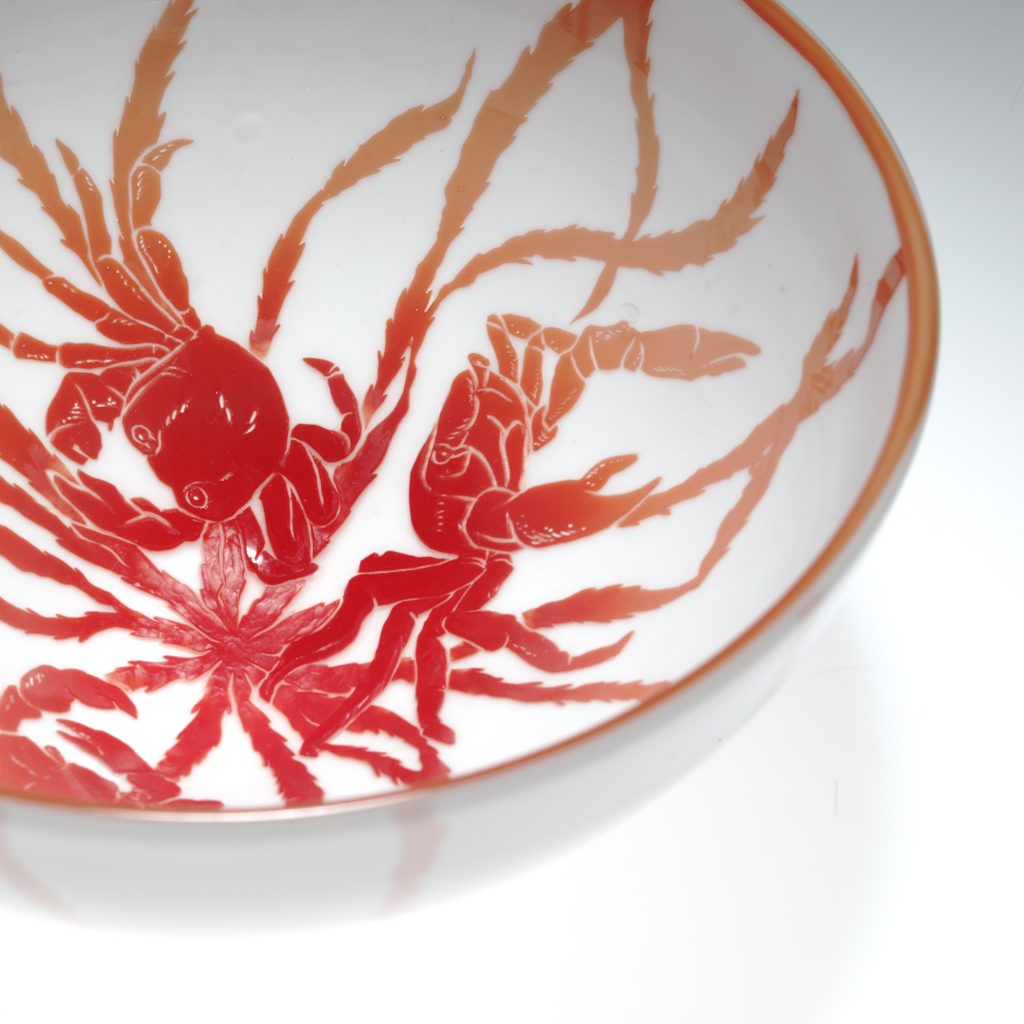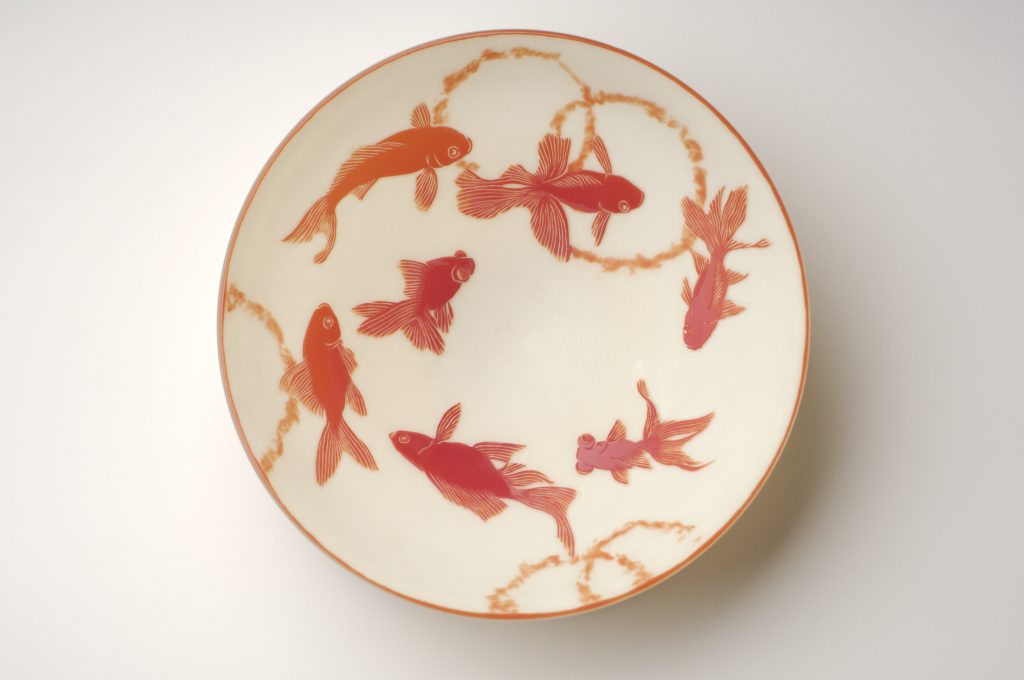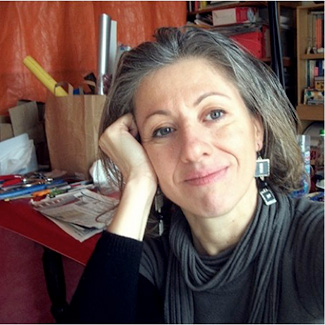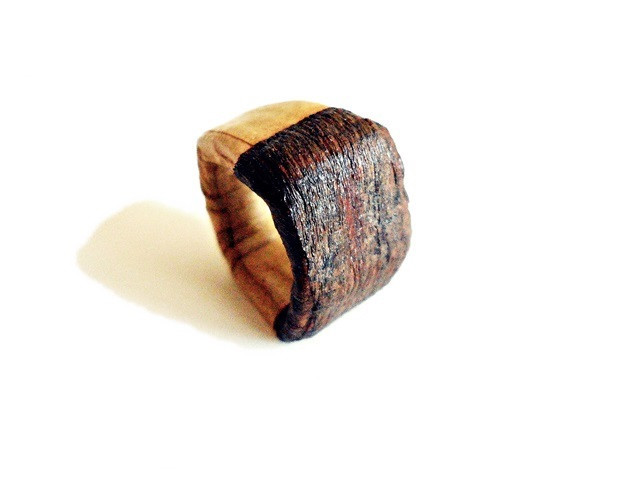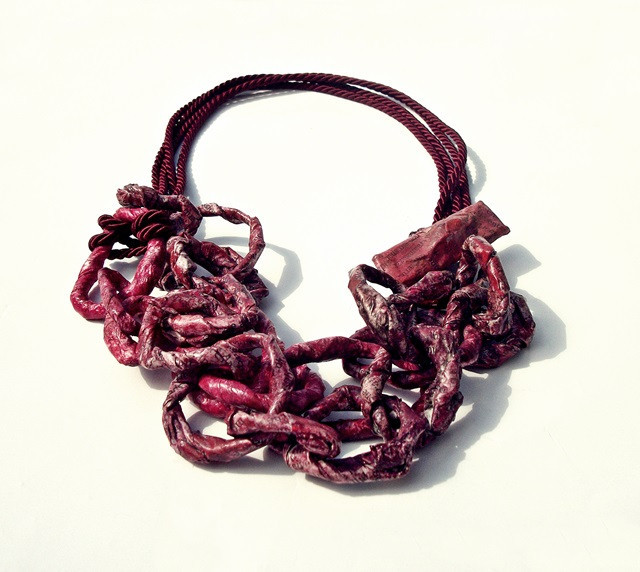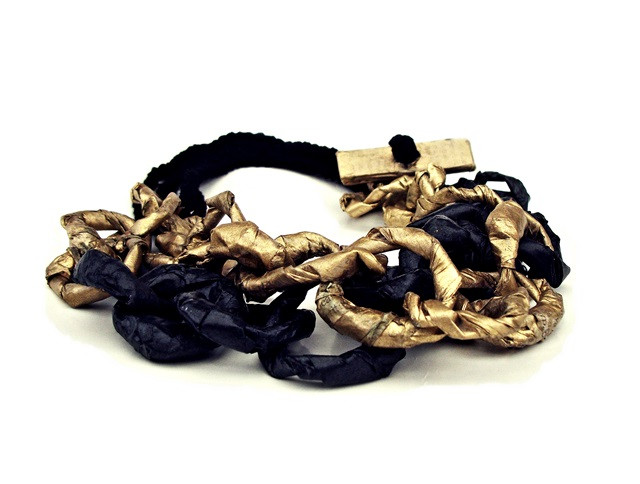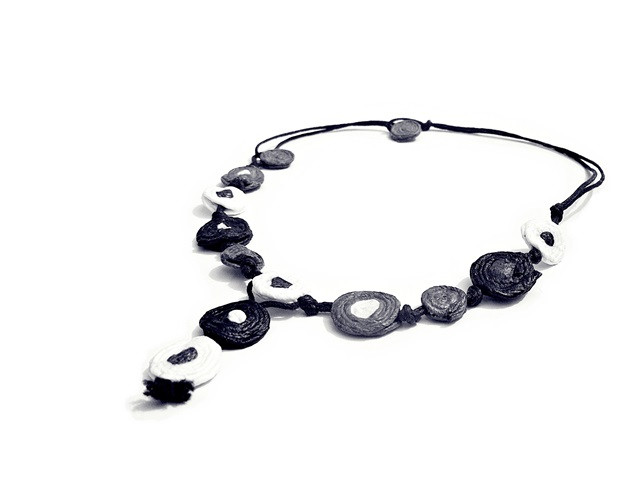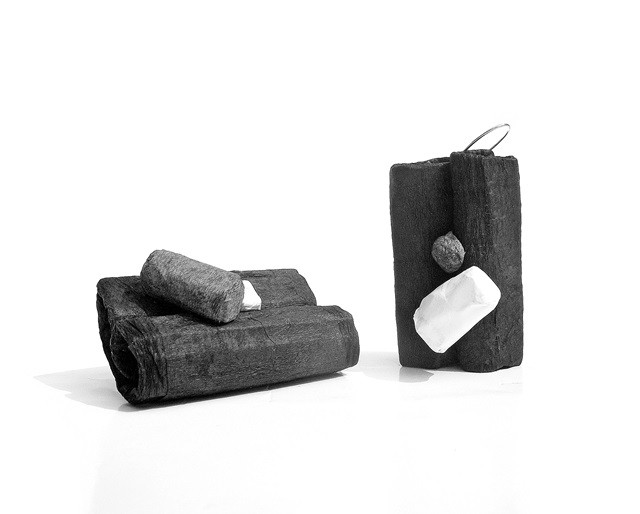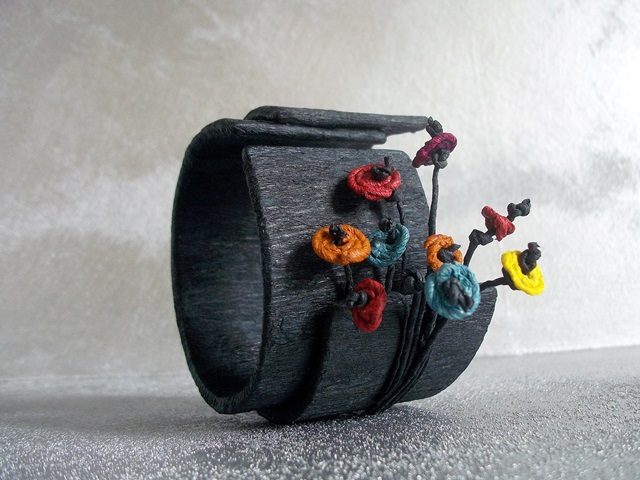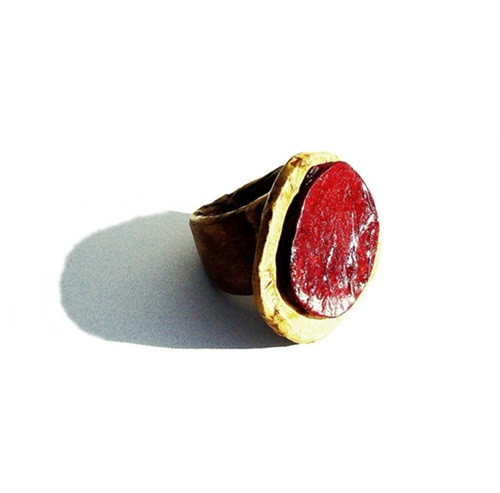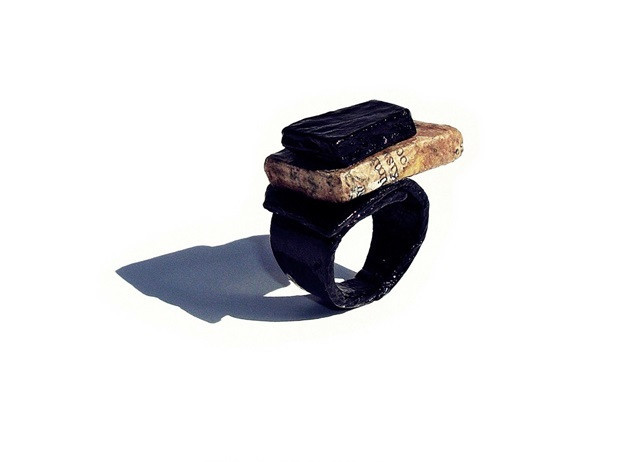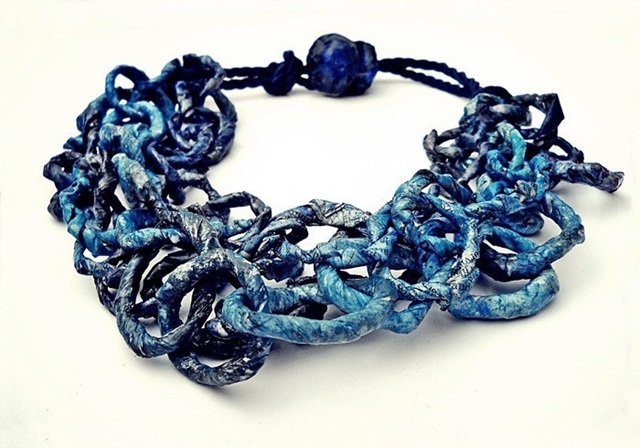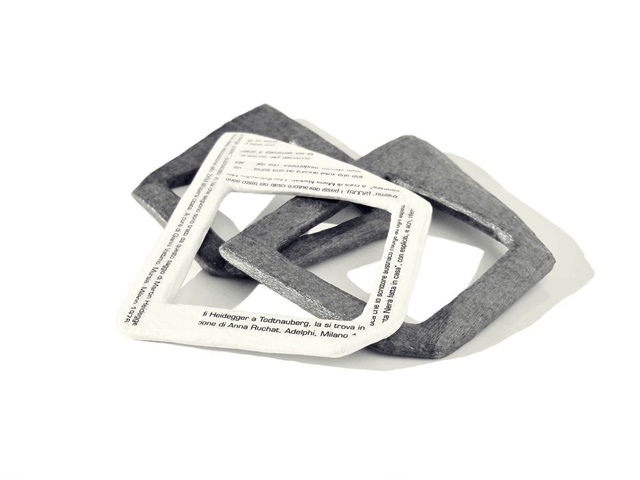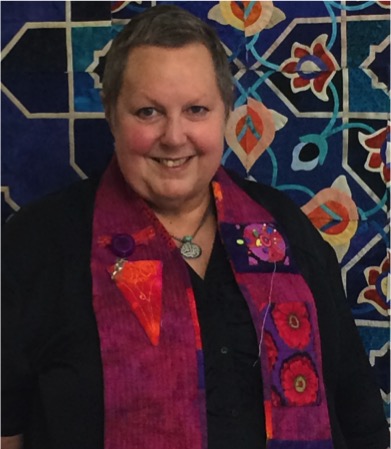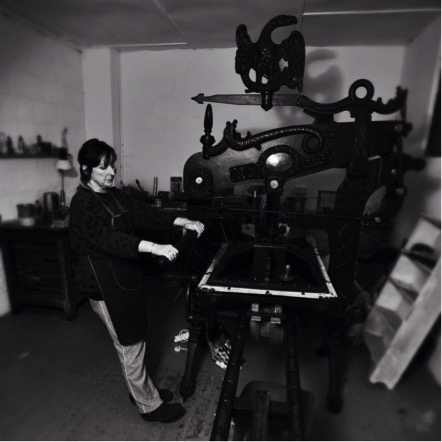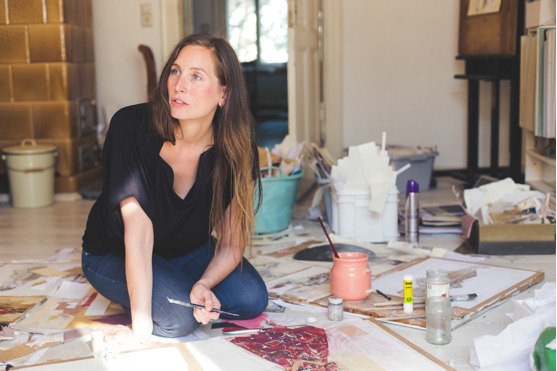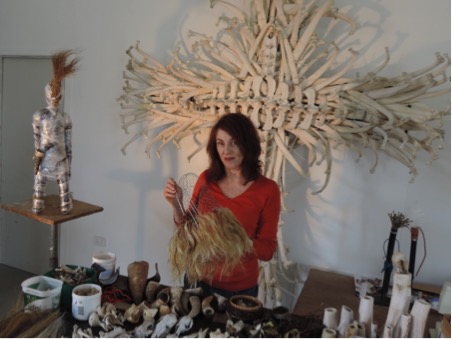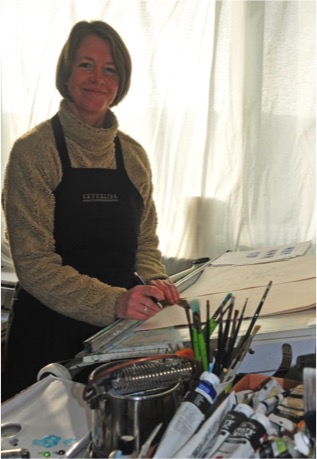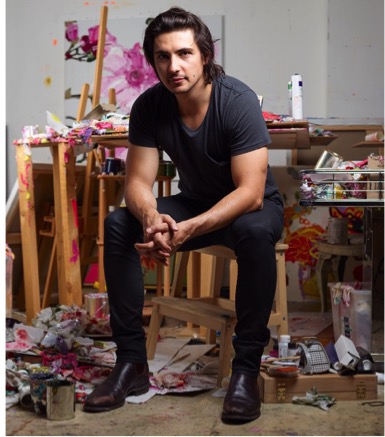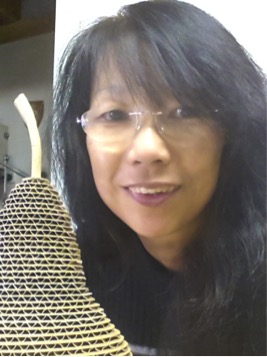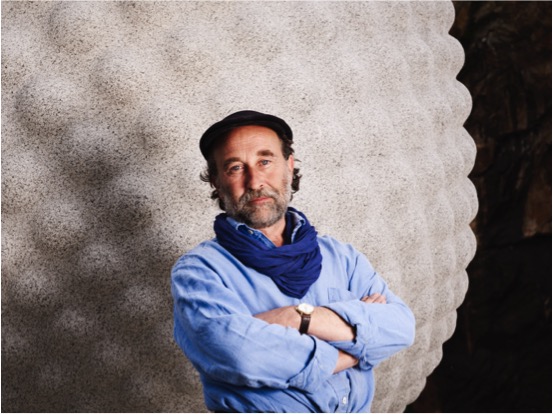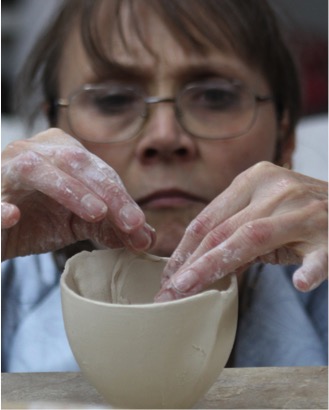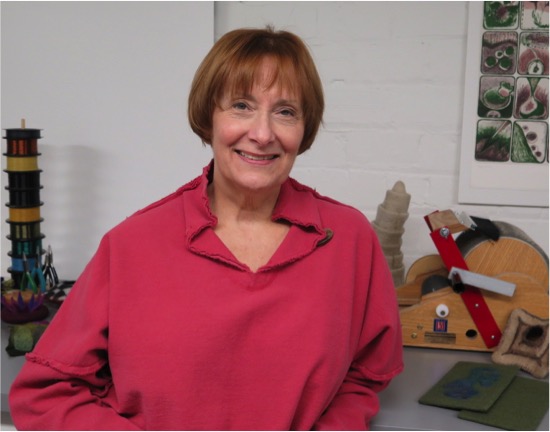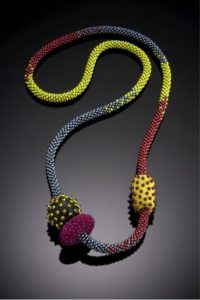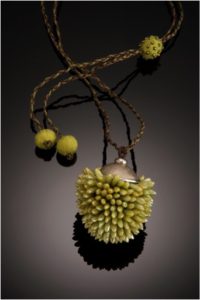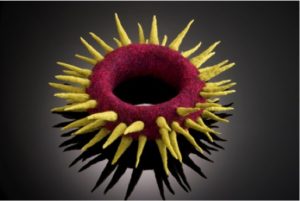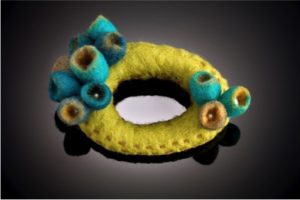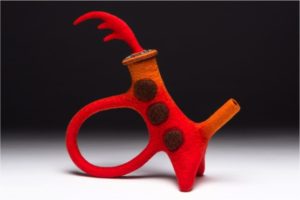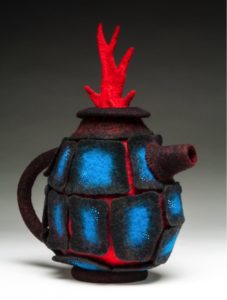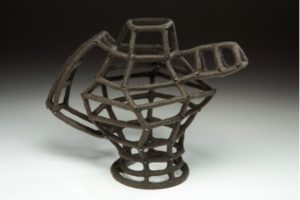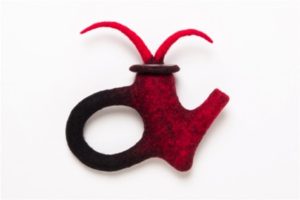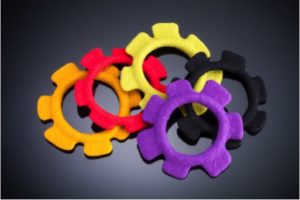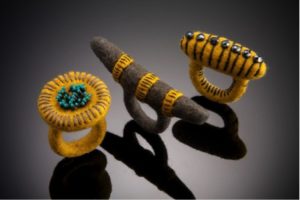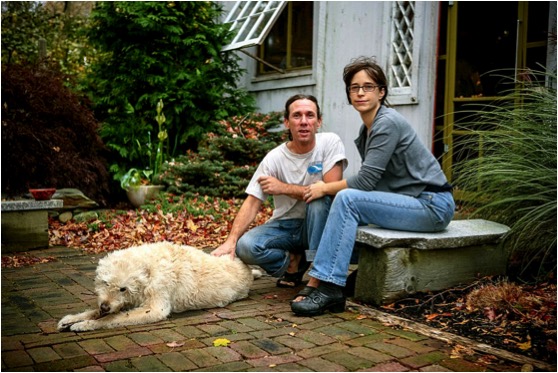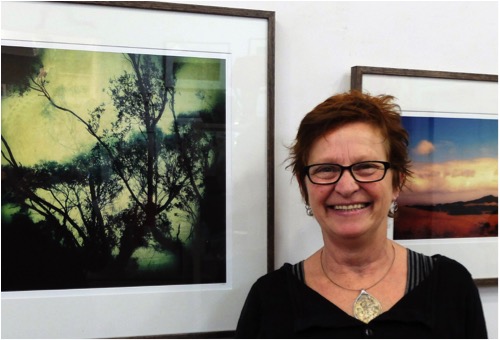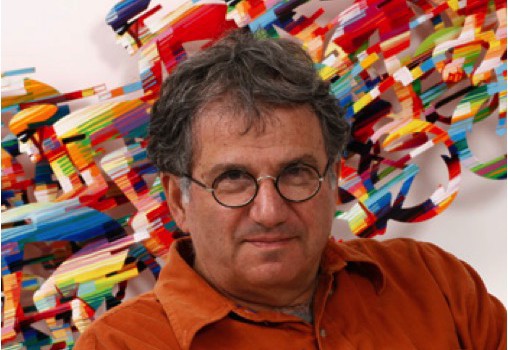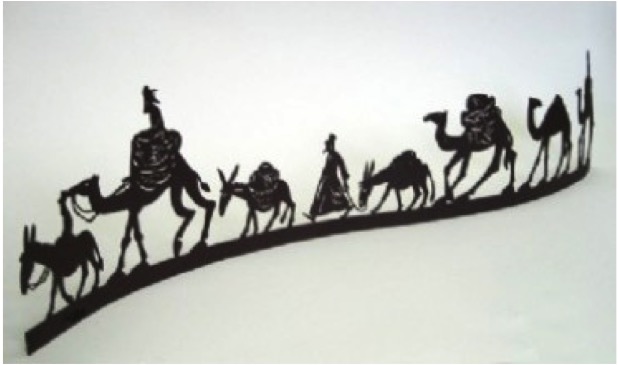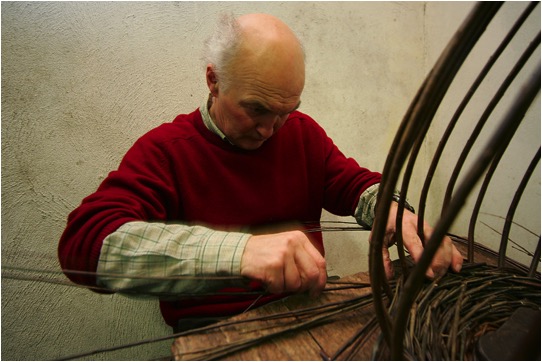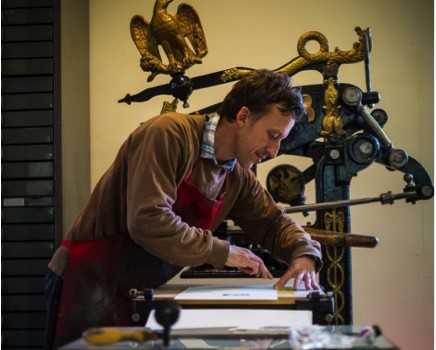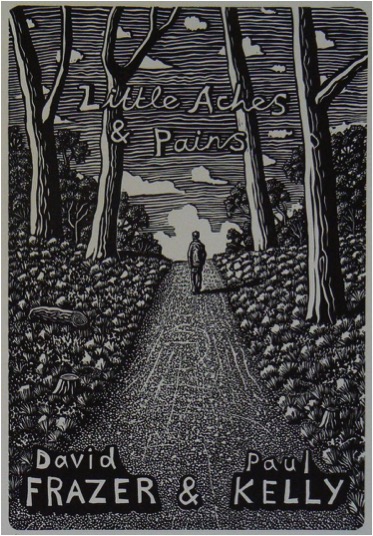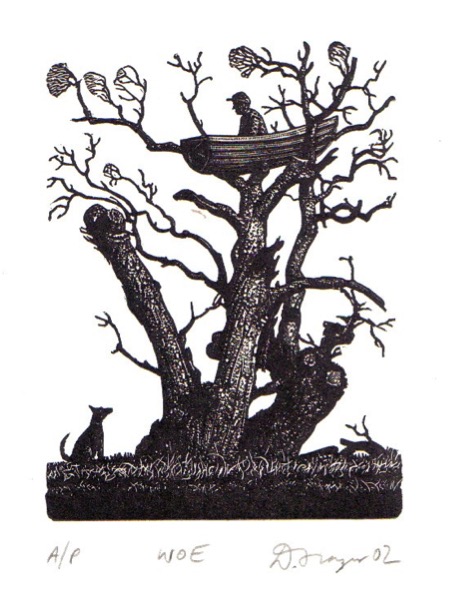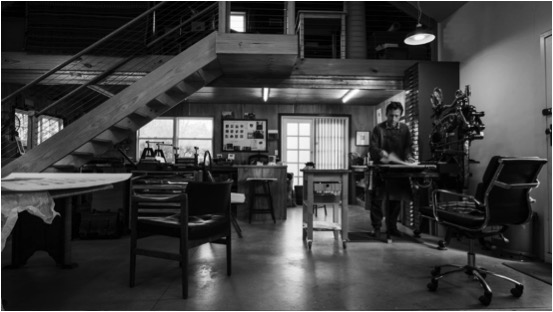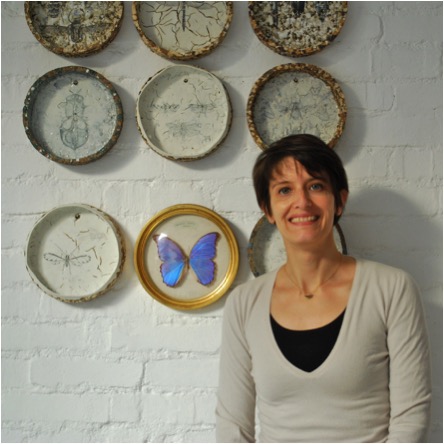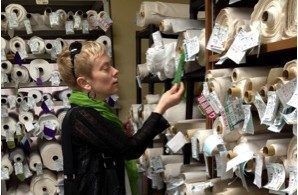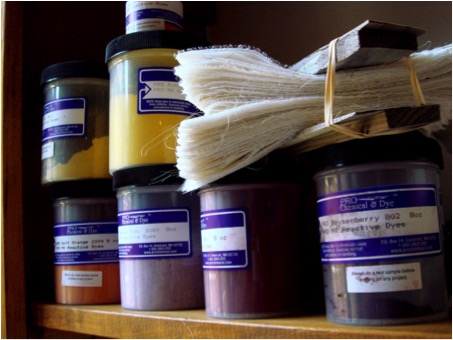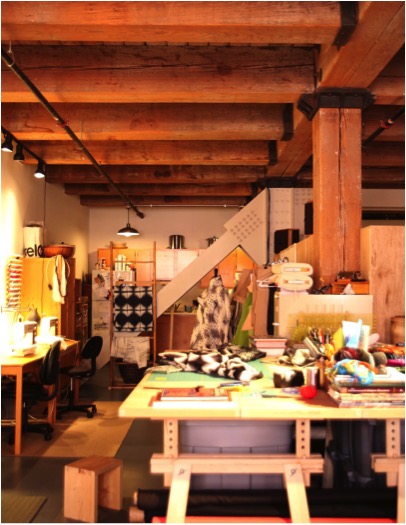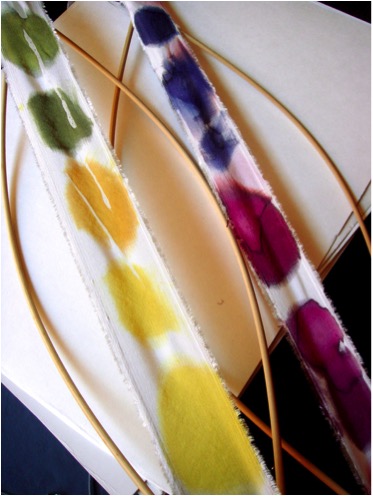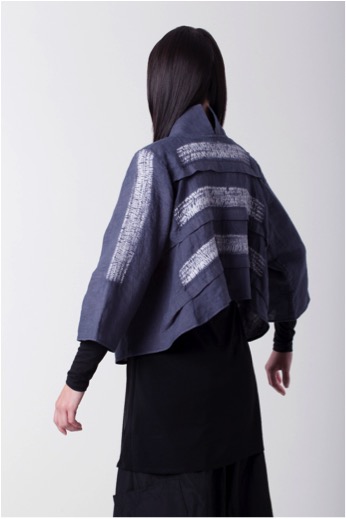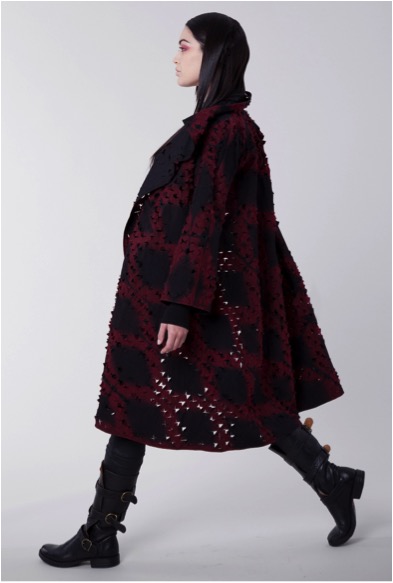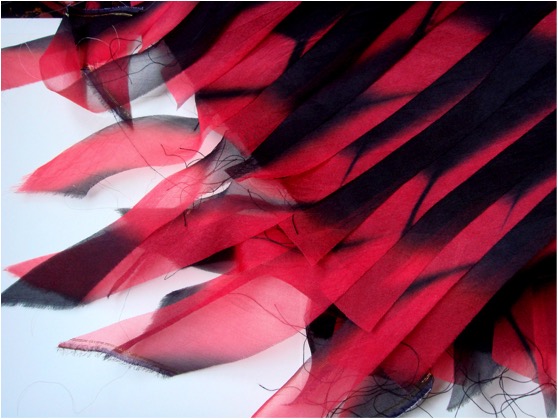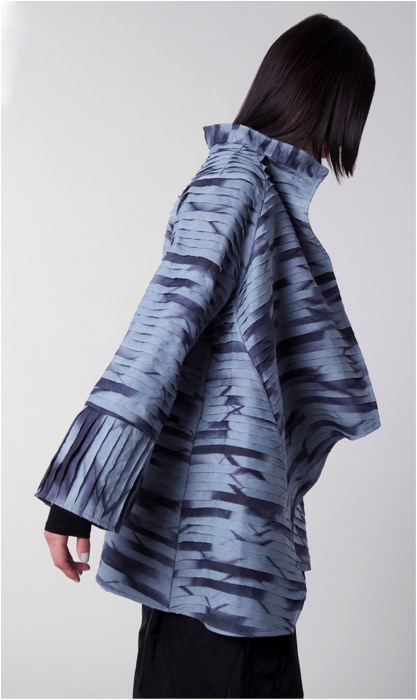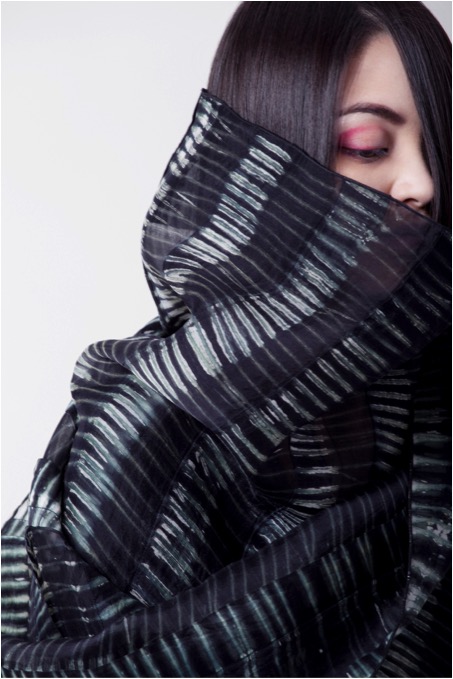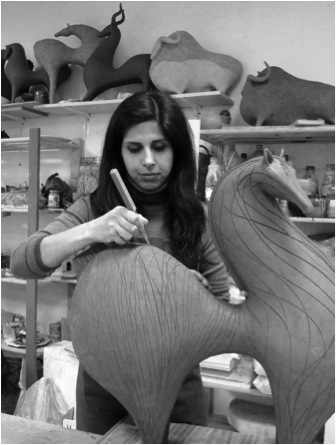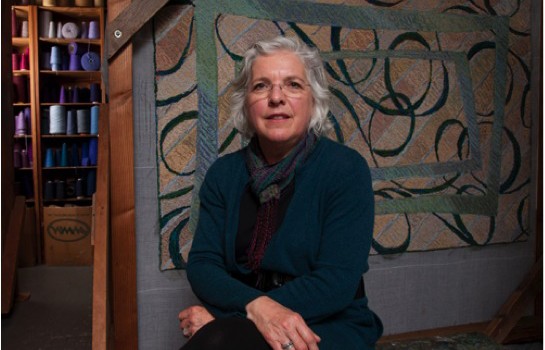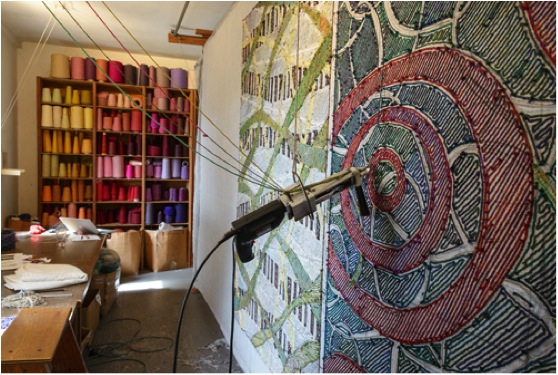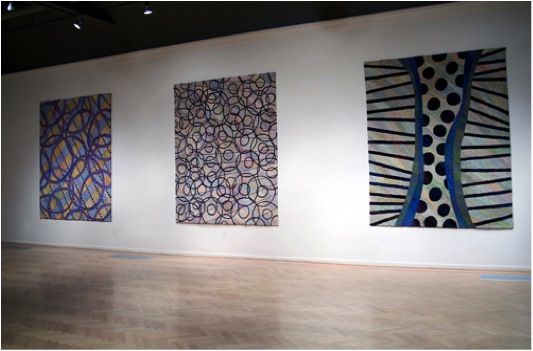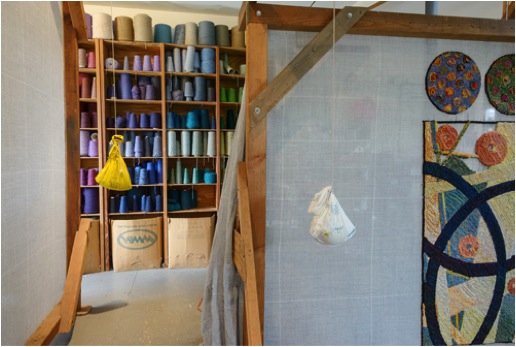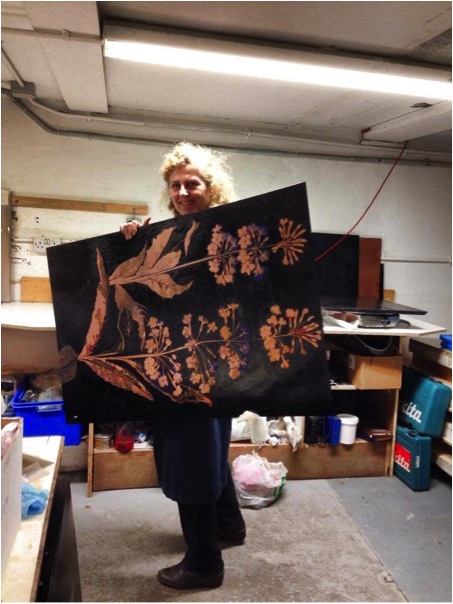Emilie Patteson
Can you discuss how you use the life cycle in your current work?
Growth / Decay
Life / Death
My work always starts with collection of natural objects. I have always collected, even from a very young age. I am forever picking up leaves, feathers, seeds, pebbles, bones, shells. I collect them because they are beautiful and delicate, and they seem precious to me. I have a desire to preserve them. The process of collecting, and then of preserving offer me time to reflect. I use these natural objects as a metaphor for life, and explore the cycles of growth and decay, and life and death, as well as the ephemeral qualities of life. While life is fleeting, death provides sustenance for new life, and so the cycle continues.
My methods of preservation involved me working directly with my collected object, and it ultimately leads to the object being destroyed. The temperatures of the glass are so fierce that they burn the object, yet trap the remnants permanently. When I work with paper, I dye the paper first with a natural dye made from plants. They object is preserved for eternity, though it is also lost in the process.
You make the comment, “It provides a chance to pause and really look” can you expand on this in relationship to your work?
My artwork tends to have a particular focus on tiny detail, on the things that we often take for granted or even miss – things like budding leaves, or the pattern on an insect wing. I feel like we are so busy rushing around all the time, that we forget to slow down and appreciate the little things that surround us. I hope that my work creates that quite time of reflection, where one can reconnect with the things they are missing.
Your work Preserved Impermanence discuss?
This series speaks strongly of life cycles. It is made in components: the top section is a blown glass dome, underneath it is a piece of wattle. The wattle is sitting on a base of solid glass that contains remnants of burnt wattle trapped in golden bubbles.
 Preserved Impermanence II, 2014, 41cm x 12cm x 12cm (largest piece) Blown and hot sculpted glass with wattle inclusion and dried wattlePhotography by David Paterson
Preserved Impermanence II, 2014, 41cm x 12cm x 12cm (largest piece) Blown and hot sculpted glass with wattle inclusion and dried wattlePhotography by David Paterson
I’m inspired by scientific glass, as well as natural history collections. They are definitely big influences for this series. I’ve kept them fairly small, no more than 20cm tall, and produced a number of them, each one unique, to have the same feel of a specimen collection in a museum.
After I made this series, I made a pair preserved impermanence II, which are much larger in size. The taller of the two is 41cm. The pair sit in conversation, with the wattle pieces curved to face each other. The size of these pieces loses some of the intimacy of the smaller series, but they further draw attention to the tiny details.
Preserved impermanence, 2012-2014, Dimensions variable, Blown and hot sculpted glass with wattle inclusion and dried wattle, Photography by Stuart Hay
Compare the evolution of your own works.
The Instill series is new, and I feel that is flowed directly on from preserved impermanence. In this series I have added a third component to the composition: the top and bottom pieces are solid and contain the burnt plant remnants, and in between the two is a blown tube, that encases the dried specimen.
While preserved impermanence had the “live” specimen feeding into the “dead” specimen, the instill pieces are more like an hourglass, with the “growth” in the middle being sustained either side by the “decay”.
Discuss both the importance of collecting and storage for your work?
Collecting is what drives the work. My work changes depending on what I am collecting at a time. Sometimes I go out with a purpose of what I hope to collect, but more often than not, I tend to find things that influence me unintentionally.
When I was a little girl I had a box that I filled with my collected treasures. I kept it under my bed. I see my artwork now as my grown up collection I suppose. This is how I store my collection now.
Having said that, my studio is filled with jars of seeds, pollen, dead butterflies, and shelves are full of bones, sea urchins, seed pods. Not all my collections end up my work, but they definitely influence it one way or another!
Comment on the importance of Australian Flora in you work?
I use Australian native plants more than anything else in my work, wattle in particular. I am drawn to our flora as it is striking, delicate yet bold and unique. It’s so varied and interesting. The native plants tend to work particularly well with the glass as well. I think it has a lot of do with how oily they are. But there is also something really beautiful about burning them when so many native species rely on bushfire to burst open their seeds.
Instill Series, 2015, Dimensions variable, Photography by David Paterson. Blown, hot sculpted and assembled glass with organic inclusions and dried plants.
(L-R) Rose (Rosa species), English Lavender(Lavandula angustifolia), Persimmon (Diospyros species), Apricot (Prunus armeniaca), Chinese pistachio (Pistacia chinensis), Raspberry (Rubus species), Kangaroo Paw (Anigozanthos species)
Take one of your kiln formed brooches and expand on this aspect of your work?
My brooches are a way for me to combine both my glass and my drawing. Each brooch is made with glass, and then I engrave a little illustration of a gum leaf, feather, blossom and the like. After the engraving I rub enamel into it.
I like that they are a little piece of my artwork that you can carry around with you. Glass is a very expensive medium, and I enjoy being able to create small items that you can enjoy every day.
Selection of brooches, kiln formed, engraved and enamelled glass, photography by Stuart Hay
You also have use flora in your paper weights discuss?
My essence paperweights contain either wattle, bottle brush or lavender. They are made in the same way as I make the components for my sculptural work, which involves stuffing a piece of the plant into the molten glass, and then shaping it into the desired from.
The spherical form of the paperweight magnifies the bubbles the plant creates. You can often spot little wattle flowers, or bits of twig still whole inside. They are like little galaxies.
Essence paperweight (wattle), hot sculpted glass with wattle inclusion, hot sculpted glass with wattle inclusion
Can you discuss your work on paper?
Drawing was something that I used to only do for myself. It has only been recently that I have started to exhibit them as much as my glass.
Infused Series: Rose (Rosa species), 2015, 24.5cm x 30cm, Pencil on paper dyed with rose petals, Photography by David Paterson
I use quite thick paper, often used by print artists. The paper has to be able to withstand sometimes long periods in a dye bath. I create the dye using water and a plant, sometimes just the leaves or flowers, sometimes I throw in a hole branch! Sometimes I immerse the paper fully, other times I stand it in a bucket, and let the dye creep upwards. I’m never sure how long to leave the paper in. Sometimes they only take a few days until I’m happy with the result, other times it can be weeks. When the paper is standing in the dye, as the water evaporates it creates beautiful reticulation marks. The paper fully immersed often ends up with patterns from the leaves, and sometimes even ends up with parts of the plant embedded in the surface. Once I am happy with the dye result, I draw the plant onto the paper. It is preserved as a record, and the real plant is lost.
Infused Series: Chinese Pistachio (Pistacia chinensis), 2015, 29cm x 21.5cm, Pencil on paper dyed with Chinese pistachio leaves, Photography by David Paterson
Expand on scientific glass that you use?
Most of my work is only inspired by scientific glass. I blow my own glass to replicate some scientific forms, particularly domes, bottles and jars. Sometimes I use found glass in my work, but I prefer to create the forms myself.
Discuss your work “What You Miss”
What you miss, 2012, 30cm x 55cm, Flameworked glass with found organics, Photography by Stuart Hay
This piece is something that I hope to go back to. It’s made up of many fine tubes of glass that I have filled with deconstructed plants: pollen, stamens, crushed leaves, seeds. I also used deconstructed feathers. Sometimes form and overall mass can be distracting and take away from the tiny details. I really wanted to pull the view in to notice the tiniest of details, like the textures of wattle buds, or the colours of crushed leaves. I have arranged them in a colour gradation, so that at first you just notice the colours, but when you slide the magnifying glass across you see that there is so much more to them than colour.
What you miss (detail), 2012, 30cm x 55cm, Flameworked glass with found organics
You were awarded Highly Commended in the Youth category of the Waterhouse Natural Science Art Prize can you explain about this prize?
The Waterhouse Natural Science Art Prize is an exhibition held every year at the Museum of South Australia. The prize encourages artists to make work inspired by the natural environment, and consider environmental concerns. It is always filled with the most impressive and varied artworks! It was such an honour to have been awarded a prize! This is definitely one of my proudest moments!
Recently you exhibited in your home town Orange in rural New South Wales, Australia. How did it feel to return home in this way?
It was really special to have a solo show in my hometown. For the exhibition I collected plants from my parent’s garden. The show was titled Home Harvest. Both of my parents are big gardeners, and my mother is a trained horticulturist, so I think that was a big influence on my growing up. This exhibition was about my continuing themes of life/death and growth/decay, but it was also about how you feel connected to a place, and how easily something small and seemingly insignificant can trigger your memory and transport you there.
Emilie Patteson at work photograph by Madi Young
You trained in Canberra and have stayed on in Canberra at the Canberra Glassworks can you expand on the vibrant arts community in our Nation’s Capital, the flip side to the political life of Canberra?
I studied at the Australian National University School of Art. It’s a fantastic art school and I met so many amazing people in my time there. The ANU glass workshop is the best in Australia, and I am so privileged to have studied there.
Canberra Glassworks is the only place in Australia that is focused on contemporary glass art. When I graduated from ANU I got a studio at the glassworks and have been making work there ever since. Canberra has a thriving arts community, and there are many amazing glass artists living here. I get to work with some of the best!
There are so many great arts organisations in the ACT, as well as our national art collections. There is a lot of support for artists here, and I think that is pretty special.
Contact details.
Emilie Patteson, Canberra, Australia
Interview by Deborah Blakeley, October, 2015
Trina Bohan
Can you discuss your use of colour?
I usually paint with an earth palette, ochre’s, umbers and greys. And add touches of pure crimsons and oranges. Ultramarine blue is a favourite. A highland location in a wet summer of crimson flowering heathers can produce the faintest of pale pink sky scapes on the near horizon. The Flow country of North Scotland known for its black bogs and marshes, and unrelenting rain can surprisingly make for the most dramatic skies of pewter, soft greys and earth reflected colours.
What draws you to the combination of sky and water?
I find myself thinking about where the dominant light is, or its origins. The big dramatic skys of Scotland meeting the water along the Western Isles and Hebrides are one of my subjects this year in my exhibition Time lines. I wanted to continue exploring those transient moments.
The water is drama here also. The light source not always in the painting but outside it, light moving back through the clouds as reflected from the sea. Endless movement
Your work is large discuss the issues that size presents and gives?
Painting large works emotively for me, l love the feeling of being lost with big brushes pushing shapes around. Sometimes my sketch book ideas are blown away and the painting takes on a life of its own, experimenting a little here and there, the satisfaction of seeing it eventually work. I have a variety of very large easels and have on my wish list an artist crank easel.
My really big canvases are made for me in London, we have carefully worked out what size fits in my building’s industrial size lift, think millimetres here, and the alternative larger size that can be walked up and down the stairs. Any larger and l would be movingto a ground floor studio. Edinburgh is busy turning its large, old, unloved buildings into art spaces. St Margaret’s House was an early start up, two hundred studios with a floor of gallery space makes for a humming creative environment. l am on the 5th floor overlooking the Firth of Forth, and am always on the lookout for volunteers on the stairs.
How does man’s intervention in the landscape affect your work?
Just soaking up the skies and landscapes can be one of the most rewarding aspects of being a painter. As l make rough sketches small details become evidence of civilisation in the landscape. A sodden black wooden post in a bright orange burn, dark shapes in the distance become stands of planted trees. The truly awe inspiring sight of a bent frail telegraph pole lost and dwarfed under a desolate landscape and huge brooding and foreboding skies. Small crofts tucked into the side of the hill talk of fierce weathers. Within the painting they help give a sense of perspective, sometimes it will be just a splash of colour rather than an all out depiction.
You are originally from New Zealand has your background affected how you view your current landscapes?
In retrospect I had to leave new Zealand to understand the difference in landscapes.
How would it be otherwise. New Zealand’s dramatic volcanic landscape with its clear cold light is in dramatic contrast to Scotland’s old rounded mountains and hills.
New Zealand would have a sharper image, than perhaps Scotland in its gloaming, mist and half light.
Explain how your figurative workshops at St Margaret’s are run?
Figurative drawing and painting Drop In workshop are held every Thursday morning, I set it up six years ago and now the group employs male and female models and is attended by professionals and aspiring alike.
Most artists would agree that change is good for the soul, working on something completely different is essential part of being an artist. There is a freedom to working fast a deadline looms. Three absorbing hours, mixed media on card, experimenting with a different palette, line work, working through different ideas. I would like to think that some of my ideas get played out in my paintings.
You have travelled extensively in Asia take two locations and discuss a particular work that has come from that location.
Living in Asia for a lengthy time took me to JakartaIndonesia, combining a love of cooking and discovering a flabbergasting array of kitchen utensils kept me also painting in the kitchens. A fledgling figurative drawing group probably fostered the Drop In group of today . Chinese red and Balinese orange – vibrant and intense follow me around and end up in Scottish skyscapes.
Dhaka, Bangladesh I painted traders off the streets. These paintings were mixed media on heavy paper. My models were small business people. Model fees were set and a percentage of painting sales was agreed; the results formed the Street Traders of Bangladesh exhibition. Fees went back into their businesses. Street Traders of Bangladesh exhibition went on to be published as a book.
On a more specific location Papua New Guinea, can you explain your relationship to place and the work you have done because of your visit?
Papua New Guinea was a different experience, once again mixed media, and more portrait work. A more intense experience talking with the women who sat. I felt my technique was changing for the better and wondered when l would take the leap into oils. Model Lily sat many times and if l could post one painting of my PNG experience it would be this portrait. The buyer of this portrait, a long time expatriate resident, said of this painting, ‘You have just made me understand how I can never be part of this PNG woman’s discussion. It can never be my discussion.’
You have sold work around the world. How do you record the work you have done and where it has gone to?
Recording and photographing work is an endless discussion and fodder for magazine articles.
Media advances come – floppy discs...and go and not all l thought preserved for eternity has made it.
My studio history yields up quite well kept huge photograph albums of old, with slide or film inserts, also buyer records with scribbled addresses. Early digital not quite the same success. Today, its cloudland and l have my work professionally photographed. Arusha Gallery , Edinburgh represent me and document all sales. My advice is learn to photograph to the best of your ability. Truly a valuable and cost effective skill.
Contact details.
Trina Bohan, Edinburgh, Scotland
Interview by Deborah Blakeley, October, 2015
Trudy Rice
Discuss how your work has moved in direction via three solo exhibitions Fragility, Dragons and Banksias and Oceanus?
My work has always been about nature. From animals and flowers to the bush and the sea. I see that even a stick on the ground has the potential to be captured creatively in some way.
I started as a painter, then taking myself back to arts school I discovered printmaking. With solar plate etching, now my preferred medium, I start with an ink drawing which brings me back to my roots of painting.
The fragility of our environment was the beginning... hence the title for my first solo exhibition …
Illuminating the subtle depths, 28 x 27 cms, 2012, Collagraph, pen, ink and watercolour.
FRAGILITY a cross between the land and the sea, then with DRAGONS & BANKSIAS, my second solo exhibition, I delved deeper into the bush in and around the Otway Ranges in Victoria and felt that my drawings became more intricate.
Banksias Dragon Blue Skeleton Leaf, 50 x 50cms
With my latest exhibition OCEANUS in July 2015 at Port Jackson Press Print Gallery, I shared my empathy and passion for the sea, taking the viewer on an underwater journey.
This latest series of work has, I believe, brought my solar plate collaged printing and use of pigments and colour to a new level of sophistication and complexity
Fast Swimmer, Edition 1/8, 38 x 28 cms
Give us your thoughts on the importance of exhibitions for an artists.
Timelines
I believe 2 years is a reasonable time span for an artist to create a new body of work. OCEANUS came quickly after DRAGONS & BANKSIAS and this was due to represented by a new gallery; Port Jackson Press Print Gallery.
I must say that I tend to work better on a deadline, it gives me true focus and pushes me to extend my process. I have a fairly busy life (with 4 children) so my time is precious, but when I get into the zone of creating, I really just go for it.
Nest detail, 2012, Collagraph, ink, and drawing
Themes
I have tried other genres like the figure, city-scapes and the like, however I keep coming back to the thing that creates a fire in my belly... the bush and sea. I think it’s great to be challenged and try new genres and techniques, they can inform the things you love and the way you work even more. I like to capture a moment, often fleeting, so some images are an impression and some are more detailed which in turn informs the way I work and the results I produce.
Red and Orange Weedy Sea Dragon, 2015
Pushing Boundaries
Trying new techniques, taking a class, seeing exhibitions all help to push the bounds of my work. I run a critique group. ”The Artists Salon" which has really helped my work to grow and increase in complexity. Conversations with other artists bring a richness and insight to the way I create work.
You have curated many exhibitions discuss this aspect of your art life?
Curating exhibitions is an extension of my fashion & event management days. A love of art and creativity and seeing things differently, is a real passion. I currently convene & curate the Albert Park College Art Show, now in its 5th year, with over 300 artworks on display from professional, amateur and student work, it is a great mix and such fun to curate in terms of making the space feel intuitively like a collection rather than an eclectic mix, it is certainly challenging but exciting and enjoyable.
Discuss your work and how you use solar plate etching?
Solar plate etching is non-toxic and therefore appropriately compliments my passion and sensitivity for the environment… using the sun and water to etch a plate rather than the acid that traditional copper and zinc etching use.
Discuss the layering technique to your work?
What you will see in one of my prints is many plates individually inked up and run through the press. I will often work on over 20 pieces of paper at any one time. Intuitively working with each image to see which will suit which piece of paper.
The Magnificent Dragon and Pods
When and how do you decide to use colour in your work?
Colour is a huge part of my work... I feel an emotional connection to colour. I generally mix my colour and not one of them is directly out of the tube, which is exciting and akin to being an alchemist. I'm certain many artists feel that the process of mixing paint alone has a creative feel about it.
Pink Spotty Crab, Blue Starfish. 2015, 38 x28 cms
You collect and use materials for your prints expand on this technique?
Collection and observation is at the core of my practice. I'm forever finding a bit of seaweed from the beach or a Banksia stem from the bush (I even found a Banksia seed in a Bunnings car park once) I call them 'specimens' and have many boxes filled with treasures so at any given moment I can place myself in nature.
Red Weedy Sea Dragon, 2015
Comment on Print editions in relationship to your work?
I don't mind printing editions, however my favourite way to work is intuitively which means that each print is a unique state, it also means that not one print will ever be exactly the same as another, especially as I mix the pigments for each colour and the plates are placed intuitively on the paper.
You have work at the Olivia Newton John Cancer and Wellbeing Centre at the Austin Hospital in Melbourne. Discuss your thoughts on the value of art in healing and wellbeing?
I believe viewing art, appreciating art and art making can extensively heal the body and soul. When you see an artwork that really resonates with you, it touches your inner core. Creating quite a flow of emotion. I remember seeing a Monet for the first time in the flesh and being brought to tears. It completely struck a cord very deep within. So the value of art in places such as hospitals and medical centres can evoke a feeling of relaxation as well as being uplifting.
Discuss why you and many other printmakers join print studios?
I joined the Firestation Print Studio in Armadale when I was almost finished arts school. It is a great community space, a place where I could continue to be supported as a beginning artist. I didn't have my own press back then and as a member I could go and print at a reasonable price. This particular facility is open 24 hours a day; so great for managing your time.
The advantages of this sort of facility are a community of like-minded artists, information, mentoring and collaboration. The Firestation always has a group exhibition to enter giving members an opportunity to make work and show it in the public arena.
Discuss the camaraderie of being a member of the Firestation and also why you played such an active Committee role?
After joining FPS I could see the facility had many great opportunities to offer artists and the local community. I joined the Committee of Management to assist in giving the facility support. I have been a curator in the gallery, graphic designer (rolling out their new identity) the Secretary & President on the committee. I have recently resigned from the committee after 5 years to allow myself the time and space to focus more on my own arts practice.
Expand on the book that you were so involved in for the Firestation?
The FPS Artist book was a wonderful way to showcase the amazing printmaking talent we have in Australia. Members of FPS from all over Australia were invited to provide up to 6 images and text, which I then designed into the book. We printed 100 copies and also produced a limited edition hand-bound version. The Manager, Edith May procured many wonderful places for the book to reside such as the State Library of Victoria, Melbourne University Ballieu Library, Latrobe University Library and the State Library of Queensland. A really satisfying project to be involved in.
Contact details.
Trudy Rice, Melbourne, Australia
Interview by Deborah Blakeley, September, 2015
Alain Mailland
You are an active member of the French Association of Artistic Woodturning, discuss how this membership has assisted in your career and development?
I created the association in 1995 with a group of friends woodturners, all professional. We met during a class and decided to meet again. It created a big movement of sharing and partnership between us. Then we organized classes every year with famous artists, and set up international symposiums and events.
Vent dAutomne
Can you discuss your technique of green wood hollowing?
Green wood hollowing is the best way to turn big forms both usual and artistic. You can cut a tree and turn it right away. The only point is to deal with the twist that occurs after the woodturning process, but this is what I look for when I make sculptural work. The secret is to turn fine, even very fine, like paper.
What lead you to move from functional domestic items to vegetable and marine forms – sculpture?
I used to produce usual items like salad bowls, bowls, vases, etc.. But my background was also artistic, and I came up with the idea of making wooden flowers, I had to invent new tools for that, and then I used these tools to make vegetable and marine shapes to be carved. I also use multi centers and off center techniques to produce coral nests and special organic forms. I made a residency in USA, opening me the market to american collectors, and came progressively from usual items to sculptural work.
Sola Rosa
Expand on a piece that you have worked from a root burl?
We have very nice root burls in the South of France, like heather, juniper, madrone, boxwood. I turn these roots fresh so they move after the turning and tha carving. Wonderful colours, fine grains, they are amazing.
Corail Bleu
Discuss the inspiration nature gives you?
I find all the forms and structures in nature, from microscopic world to the cosmos, the sea, the trees, the insects, the textures, etc…Everything on earth is a wonder, just have to look at it, and it will inspire you !
Explain in detail your piece, “The Birth of the Viking Ship”
The Birth of the Viking Ship, Size 44 cm ; h : 23 cm
I started this piece after visiting the Viking Ships Museum of Oslo in Norway, where you can see four incredible ships from the 10 th century. I was much that impressed by the amazing shapes of these boats, along with the carving on the prew, representing a snake from one side to the other. I realized again that human are inspired by nature and natural shapes, so I wanted to make an organic piece like many ships growing together. The techniques for that pieces were : woodturning from a cherry graft, then cutting and carving green. Then carving fine, sanding, texturing the inside of the boats, colouring, then texturing the “heads” of the prews with the burner and colouring. I spent two months on that piece
Discuss how your wood turning has taken you around the world?
As I said, through American collectors, the woodturning center of Philadelphia which is named now “Center for Art in Wood”, and through the American association of woodturners, and all the organizations of woodturners in GB, Australia, NZ, Ireland, Germany and Spain.
Floating
Can you discuss “Children of Gaia”?
Children of Gaia
Children of Gaïa is the biggest piece off-centered that I ever made, with seven vases attached together, carved, and steam bent.
In “Rainbowls” can you expand on the outside details / patterns on each bowl?
I just wanted to search new textures and decorate each bowl differently with very organic patterns like worms galleries, coral shapes, etc…
Contact details.
Alain Mailland
www.mailland.fr
Alain Mailland, Chamborigaud, France
Interview by Deborah Blakeley, September, 2015
Catharine Davison
Can you discuss how place influences your work? (Take two pieces to show this.)
I remember being visually aware as a child, growing up in Kilkeel in Northern Ireland, a market town with an impressive fishing port and the Mountains of Mourne as backdrop. As a family we enjoyed the outdoors and so from an early age began connecting with the ‘landscape’. The process of seeing, editing and then recording has always been my way of connecting with the world around me. I moved to Edinburgh, from the South of England in 2007 and feel very at home in this city built around seven hills.
My relationship with Edinburgh could be described as being identifiable through my work from Blackford Hill, Calton Hill and from Holyrood Park. Morning Dusk, (from Blackford Hill), 80 x 120 cm was painted during the winter months in 2015. The title refers to the eclipse and although this was a moment in passing it gave me a way in to connect with this particularly challenging view. I have drawn and painted this aspect of the city many times, this is part of my process
Morning Dusk (from Backford), 80 x 120 cm
I began this work by drawing, using oil thinned with turpentine, the architectural arrangement of the domestic homes as they sit on the hill. Working as usual on location, returning over 5 days I slowly pieced together the lines, like a jigsaw that would form the structure of the work.
The appearance of the city is never fixed- changing under different light and weather conditions and so there is a sense of transience. This quality is well reflected in another painting from Blackford Hill, ‘The City’, 80 x 100. Undoubtedly Edinburgh with the Salisbury Craggs brooding on the horizon, the black glaze continues across engulfing the heart of the City. While I am processing the immediate visual references directly in front of me I am also thinking about other conversations. This state of flux interests me.
Expand on the landscape and human intervention (architecture) in your work.
For me the urban landscape is subject through which I can explore ideas about time, both time passing and the times we are living in, economies, and through the architecture and development there is a sense of permanence but fragility.
Discuss the importance of winning the Lynn Painter-Stainers Prize was to your career?
About the award generally.
For me to have been awarded the Lynn Painter- Stainers Prize for creative representational painting in 2014 for my painting ‘The Craggs at Dawn, (from Calton Hill) 80 x 120 cm, was a wonderful affirmation of my work. Looking back it was definitely a milestone. I was able to make decisions about how I would use the time ahead of me effectively. It is amazing how much emotional energy is attached with financial concerns. As well I have always been involved with art education and although this is incredibly rewarding, I am not the sort of person who takes responsibility lightly and so with the award I was able to make the decision to do less teaching. The exposure was enjoyable and I have been invited to be more involved in projects. However in the months leading up to my second solo exhibition at The Open Eye Gallery. I felt a weight of expectation and this was a feeling I had never experienced before. The art industry is so competitive. Fortunately as I immersed myself in the body of work I became so involved and committed to producing work with integrity and this gave me the confidence in the exhibition.
The work that won you this prize
‘The Craggs at Dawn, (from Calton Hill) 80 x 120 cm
The Craggs at Dawn, (from Calton Hill) is a painting depicting the city of Edinburgh as it occupies the space between Salisbury Craggs and The Castle. It is an iconic view- one that visitors will admire in awe of the spectacle. The ‘Old Town’ is very visible with the contrasting modern domestic architecture on the fringes. I knew the location would be busy with tourists and so if I wanted to make this work I had to commit to getting up early before the bus tours got there. There was an under painting of warm tones on the board and so on my first sitting I painted the broad sweep of the blue/grey sky- identifying the horizon and The Craggs. It took several sittings building layers of glazes and sections of finely drawn architecture. The City Art Gallery in Edinburgh now owns the painting.
Discuss two of the works you had exhibited at the Open Eye Gallery in 2015?
Beyond Land, (from Calton Hill), 78 x 110 cm
This is one of my favourite locations and views over the city. I have made many drawings and several smaller paintings. I wanted to reflect the feeling of being immersed and consumed by the landscape.
I began this work in the studio by projecting a very detailed line drawing so that I had the framework for the painting in place. Then working from Calton Hill I used thin layers of monochromatic paint, pushing and pulling the architectural mesh- both together then apart. Limited tonal palette was used to emphasise the surface quality rather than topographical detail.
Chasing Shadows, (Blackford Hill View) 76 x 63 cm
Reflecting on how the domestic home and urban landscape is represented for dramatic purposes on screen and for tv. I enjoy Michael Raedeckers’ stitched works on canvas- they are both minimal but intriguing. His use of line and composition are very deliberate and was thinking about his work at this time.
I worked immediately on the white surface of the primed board using very little medium to thin the oil paint. I wanted to explore how paint can be pushed and moved around to form lines and marks.
This is a portrait format, lending itself to the height of the trees. I wanted to use the trees to enhance the feeling of mystery and also as a compositional device to add space. There are parts where I have wiped back to suggest a momentary distraction…interrupted focus.
Limited tonal palette was used to emphasise the surface quality rather than topographical detail. I will often introduce a new colour or series of colours into my palette and during this period of work I was using Davy’s grey, Olive green and Lamp Black.
In your quote above, “Working from direct observation on location is at the heart of my practice” Catharine Davison. Can you explain how you work from location, do you use photography, sketch books or plein air?
Carving out time to think is my first action, then I go walking. I take a sketchbook for note making and drawing. The notes will be a record of things I see and hear. I might be listening to the radio, reading or pick up on conversation and find words forming connections to images. Together giving me ideas of how to approach a subject or titles for my work. The initial phase in any new project can be quite fragile, I like to be able to immerse myself in a contemplative space. The making is quite a different energy. I think I relax more when the actual making is underway.
Discuss your use of lime and soft glazes to capture that misty Scottish environment.
I remember when I was studying for my degree at Liverpool John Moores’ University that I became aware of an instinctive approach to recording the world around me. Working with dip pen and ink I was inspired by the mark making in works by artists Anthony Gross, John Piper and Van Gogh. Since I have always made drawings with a keen and playful exploration of line and mark, developing and growing a personal vocabulary. The soft glazes are not a conscientious response to misty weather. I developed this approach to working with thin layers of paint, oil or watercolour in response to practical need, wanting to work at pace on location and with layers, and also to suggest transience and a sense of flux- thinking about the ideas of focus that I have mentioned.
You use colour very minimally discuss?
I have learned not adhere to local colour- instead bringing colour references to the painting. I collect colour sources from magazines, TV drama stills – in particular from the new wave of Nordic Noir, or naturally occurring colour combinations such as a delicate pastel green lichen on powder grey stone. Colour for me is about suggesting a mood rather than describing topographically what is there.
Many of your paintings are taken from the vantage point of looking down, discuss?
From the hill top vantage points you get a real sense of the city. This connects with my on going exploration of ideas- using the city as a platform for my work. That aside, Its amazing what you can hear – football crowds singing or cheering in the distance or people working in the allotments below or a siren.
Heat of the Land (from Blackford Hill) 60 x 90 cms
Discuss how you are able to show climate in your work.
I am not conscientiously interested in depicting climate. However, the light, weather conditions and time of year undoubtedly affect the appearance of the landscape. The painting has to work as a whole- so I am controlling the painting rather than letting the light control govern my responses. I do watch the weather forecast avidly and plan my week ahead accordingly.
It was 2006 and 2007 you worked in Cyprus, can you say something about the experience and the work you made while you were there.
In 2006 I made a series of watercolour paintings in response to the rural landscape. The richly patterned organisation of hills gave me the opportunity to develop a corresponding tapestry of marks in watercolour. In 2007, I was artist in residence for three months at Cyprus College of Art (which had just opened a new centre in Larnaca) overseeing the summer programme. I quickly established good relationships between the local residential community and the student artists at the college, enabling an exhibition of student work at the local ‘Gallery Kypriaki Gonia’ - with the Mayor as guest of honour. This mutual respect aided my own practice towards a visual investigation of the lives and homes of the people I met. Learning just enough Greek to communicate with my new neighbours to share food and stories about their lives; many the product of political displacement. I drew and painted their homes, gardens and backyards - bringing valuable insight and life to a series of urban garden works.
Your paintings are showing Edinburgh from so many different vantage points are you ever asked to paint a specific aspect?
I am not interested in taking commissions and although I have been approached by individuals asking if I will- we never get as far as discussing where they have in mind.
Discuss your thoughts on the importance of capturing the City of Edinburgh or is it you as an artist wanting to share the city you love?
I don’t really think about ‘Edinburgh’ as a specific place in my work. I set out to make searching drawings and paintings that go beyond the topography. However when I show my work then it no longer belongs to just me- I can’t tell people what they need to see or feel when they look at one of my works.
I see you have been running courses at Edinburgh University, both in the Department of Life Long Learning and also at the College of Art where you have run some courses in the Department of Illustration. Can you tell us a bit about your teaching?
Over the past year I have been running the Portfolio Preparation Course for Art and Design Studies. This course is designed to give students a platform to explore their own ideas through individual development. Each week the 2 and ¾ hour session would provide students with a prompt- conceptually or through materials and processes. Drawing and painting from observation as a set task was integrated into the initial sessions, for instance for the first week all students made a painting working from crumpled paper, a project inspired by artist Louise Hopkins, and there was also a session drawing from a life model. Exhibitions at the Royal Scottish Academy gave students the opportunity to interrogate and respond to a wide range of other contemporary artists work. In the studio the students explore materials and processes, using everyday materials such as cardboard to make a sculpture and mono printing was used to method to develop ideas. I encouraged students to make a record of their work each week by taking photographs and making a presentation in a sketchbook format. Every session was followed with suggestions for independent study at home.
What advice to you give your students to keep them encouraged about their work?
I approach teaching from the point of view that there should be a connection with the human and the artist. I suppose I set about to identify the characteristics and the personality behind the work and this will help find inspiration and help me communicate to the individual. The art has got to come from the student- they need to want to make the work. I see myself as a facilitator. I think you need to be patient and resilient to make work on location. It can be very rewarding, exciting but demoralising and challenging.
How important were Tutors to you during your time at Art School and what advice were you given that still helps you today?
It was my Drawing tutor at Liverpool John Moores University, Julia Midgely who encouraged me to develop my drawing skills working on location. I remember finding the projects difficult- I studied Illustration, and when I found a way in through drawing, the tutors were supportive and encouraged me to keep doing the work I needed to do. On my Masters Degree at Buckinghamshire Chilterns University the tutors were fantastic. John Richardson was the Head of Faculty and it was through his contacts and hard work that I received funding from Allied Domecq Wines and Spirits. For my major project I travelled to the Laphroaig Whisky Distillery on Islay in Scotland where I made a visual record of the working life. The Etching Tutor Elizabeth Butterworth had a great work ethic and pushed to make use of every moment of contact we had and I remember artist and tutor Tom Hammick- advice to ‘use best materials you can afford’. I hear myself passing on the wisdom and learning to students. Being an artist is a way of living.
How important is contact with other tutors to you and your work?
It is an essential support mechanism. A lot of the professional artists I know work in art education in some way or other. In the same way my tutors at college would share nuggets of wisdom, I might pick up some good advice that will guide or inspire me; for example at the recent opening event to celebrate the Edinburgh Arts Festival I was talking to an artist friend, Jenny Smith who suggested I look up John Cage and sister Corita Kent list of advise for students, teachers and life and from this I read ‘Don’t try to create and analyze at the same time. They’re different processes’.
One of the most frequented conversations is the balance of work- work we need to do to live and work we want to do. My partner, Robbie Bushe is also an artist and I like that that we able to give each other the space and time to do the work we need to do – when we need to do it.
Contact details.
Catharine Davison, Edinburgh, Scotland
Interview by Deborah Blakeley, September, 2015
Valdis Harrysdotter
Please discuss your vegetable paper bowls?
Inspiration design
My inspiration is the material in itself. Handling the vegetable paper and thinking of the possible ways of using it. In my art I have through the years attended to use material in my enviroment instead of importing it and my vegetable paper I can make from material which is available here.
Working with paper has been a passion for me and designing a thing like the bowl by using a paper was a challange. A bowl for me can be a beutiful form because as long as I remember I love the circle.
Usability
The usability was not the main issue for me. The bowl can stand by itself and like a dear cust
omer said, “These bowls are giving not receving or demanding something to be put into them.
But they are also usable for any kind of dry food or things.“
Development of technique
The vegetable paper made from radish do have a special property, which machine made paper does not have. From holding a slice of radish paper sheet to making the bowl took a long time and many test to find the right solutions.
Before I found out that the radish was the vegetable that suited best to my process I tried a many kinds of fiber rich vegetables.
There was lot of details to figure out for exemple the cooking time of the vegetable, drying method, material for the base of the bowl, binding materials and suitable colours.
Colour
I use a synthetic colours for colouring the vegetable because I found that the natural colour for exemple of the carrots fades away quiet quickly. I also love using the hole colour spectrum and the colours I put together I base on the feeling I have for the colours
Explain about your time in Spain and Japan and how this has affected your work?
I joined a artist in residency program, but I learned the technique of making paper from carrots in Denmark by my teacher a Danish paper artist Anne Vilsbol.
In the village Mino in Japan, there is a long tradition of making a paper. The paper from there is very highly respected. For me staying in Japan and having this love for the material was just a wonderful experience and give me the confidence and knowledge that the possibilities with paper are endless.
I cannot say that staying in Japan or Spain brought a direct influence on my work. It is more like a vitamin for the sole and sin to leave this island and see the culture in other country. I like to travel and any kind of fiber arts is my main interest. The last artist in residence I joind was in Loombok in Indonesia and I was very touched by the traditions and for the craftmanship there. In April 2015 I was in Australia and was very found of it J
Can you discuss the importance of the Craft and Design foundation in Iceland?
It is based in Reykjavík
There is a group of professionals that check the application when people are seeking for membership, everybody can apply.
The financial support from the ministry covers the basic cost of the art and craft office. There are two people working full time and they get paid by the ministry which also pays for the house.
The art and craft foundation has this website and there they say: http://www.handverkoghonnun.is
The objectives of CRAFTS AND DESIGN / HANDVERK OG HÖNNUN are:
- To support the development, further enhance the preservation of Icelandic crafts, applied art and design.
- To provide consulting information and service regarding product development, presentation and marketing
- To promote enhanced quality awareness in the field.
- To be a common forum for people working in applied art, crafts and design.
- To maintain an informative web page and to build a database of people working in applied art, crafts and design.
The Craft and Design foundation has put out three booklets of Icelandic artists in 2006, 2008, and 2010. Your work is in the 2008 issue have these publications been influential in promoting art and craft work around and beyond Iceland?
The three booklets they issued I am sure have given people better idea of what is going on in these field. They were send to every Icelandic embassy around the world and in Iceland as well to schools and institutions.
Art education what is happening in Iceland in relationship to yourself?
I work at the art and craft shop Kirsuberjatréð
also I teach in collage. My students are between 16-20 years and are people with different kinds of disabilities. Everybody get some teaching in drawing and many of them in some kind of craft .
I have to say I do not know how the art teching is in the school for children at the age 7-16.
1999 was the Art and craft shool in Iceland turned into the Iceland Academy of the arts and became more theoretical and the word design more used than craft. We do not have a long history in design like Denmark for exemple. In the Art and craft school there was more focus on craftmanship.
We also have a school, The Reykjavik School of Visual Art which I think offers more craft and is quite often where they train students before they apply for the Iceland Academy or go to some other country.
Take other pieces and discuss them?
I form the bowls using a plaster, that is the base. Then I cut in thin slices a bunch of radish, cook them in coloured water, press them and dry betwen bricks until they are totaly dry.(It reminds of drying flowers betwen the sheets in a book ) When I have got the slices ready so each one is thin and in a circle form.
I then glue them on the plaster base. I just have lot of colours on the table and I use my senses to put them so the bowl feels balanced and in good colour combination. I make them in many different sizes.
Contact details.
valdish@centrum.is
Valdis Harrysdotter, Reykjavik, Iceland
Interview by Deborah Blakeley, September, 2015
Eva Mitera
How did the collaboration between Scotland and Poland come about?
I first came to Edinburgh in 2005 or 2006 and loved it, the architecture mix of medieval with my beloved palladianism and the breath taking Scottish landscapes and nature. I knew I had to stay there, so I applied to study at the University of Edinburgh, at the Design and Digital Media course and graduated in 2009. Ever since I ve been coming to Scotland for shorter or longer visits.
Scotlands constantly changing weather: misty, moody, rainy, sunny and landscapes, seascapes are a great inspiration and theme to my paintings. I observed these famously Scottish daily dramatic weather changes almost everyday while living in an apartment with the view of the Firth of Forth at the Western Harbour.
200 x 400 cms, Oil on Canvas
Do you notice a difference in the response to your work in Scotland versus Poland?
The perception of my works is very positive and alike in both Scotland and Poland, maybe because both nations have similar characters, both are proud but modest, honest, brave and indefinable.
Spectators do find what I am trying to depict in my paintings, capture the subtle changes of weather and the elemental forces of nature, the dramatic, the cataclysmic factor, the tension and vibration of landscape.
However, I tend to shun away from the audiences more personal views on my artworks firstly because I don’t want to be influenced by it or create artworks to please the audience. Secondly, I believe that particularly the abstract art is a mirror reflecting the viewers souls and emotions and it would be inquisitive to listen.
Discuss your use of Primary Colours in your abstract work?
Primary colours give freedom, are exciting, I paint my abstracts alla prima in a very spontaneous manner. Four primary colours are the most I use on one painting, the other colours on canvas are a result of controlled chance. Through this limitation or 3 or 4 colours paintings have strong vibrant colours are airy and refer to nature more. I try to capture the elemental forces of nature, the dramatic, the cataclysmic factor, the tension and vibration of nature.
Untitled – Red 100 x 200cms Oil on Canvas
Comment on the importance of size in your work?
Large format of the oil images plays an important role in creating a desired dramatic sense of nature. Spectators standing in front of monumental canvas is surrounded by it, the experience is greater.
The opposite view, you give, is one full of cool colours and movement through clouds. Discuss two of your recent cloud paintings?
Technique used?
In the two recent cloud paintings I have used the traditional technique of the Old Dutch masters, which I learned from a professional conservator. While studying it, I have made many copies, works by Rembrandt van Rijin from books as well as originals.
Painting in this technique is a long process mostly due to slow drying of oil paint, painting in this procedure consists of primary sketch, imprimitura, mid-toned imprimitura, painting, blending and glazing.
Colours that your subject demands?
Cloud paintings demand the highest quality handmade oil paints, I mostly use Old Holland, Talens and Schminke. I start with a basic colours Ultramarine, Cobalt or Prussian Blue and end with transparent layers colours. I mix my own colours from old recipes which I found during my Art History studies at the University of Warsaw as well as experiments.
Your ability to show movement?
I achieve movement through composition, contrast, colour and glazing. It’s still a bit of magic to me, sometimes it happens, sometimes it needs a year to finally turn up.
Storm, 2012, 152.5 x 159 cms, oil on canvas
Are your cloud paintings done in your studio or outside?
I create almost all of my oil works in the studio, they take very long to dry, especially clouds paintings through layering need to dry in clean and dust free environment.
Cloud 2012, 152.5 x 235 cms, oil on canvas
How do you record, by photography or sketchbooks?
My paintings of clouds and abstracts are based on the memory of the observation taken from nature and transformed onto canvas. In both Poland and Scotland I am constantly surrounded by nature, through in Poland I live in a house located in a large garden neighboring a forest, and in Scotland I travel a lot to highlands and islands in particular I love the Isle of Sky, Fort William and St Andrews and Edinburgh with Firth of Forth and Arthurs Seat.
I use photos as a starting point only to landscapes and sometimes clouds, but the final painting is far away from photorealism.
You also work in multi panelled canvasses can you expand on this and why and when it is used?
I use panelled canvas because they remind me of window views of nature, as well as Renaissance and baroque altars, I apply it to emphasize this dual aspect. Polytypic paintings allow me to create on an even bigger format.
Moon
Reflection also plays a large part in your work expand on this aspect?
Reflections give a sense of double reality, particularly in reflections on windows, shiny metal elements even car paint. Reflections are interesting in investigating light, exploring colour, spectrum rays of light.
Untitled, 2015, 198 x 235 cms, oil on canvas
Later in the year ’15 you will be take in part in both the Florence and Beijing Biennales, expand on…
I will only take part in Florence Biennale, Beijing was too far for me at this moment.
How these commissions came about?
Through application to the Florence Biennale and the invitation to take part.
Which countries will you be representing?
I will be representing Poland.
Untitled, 2015, 75 x 62 cms, oil on canvas
What will you be working on?
From the beginning of the year I am working on my painting for the Biennale, it is a large round canvas storm painting. It refers to the Andrea Mantegnas sealing fresco in Camera degil Sposi from the Palazzo Ducale di Mantova, Tuscany, Italy. I have seen this fresco back in 2003 while having art history classes there with the University of Warsaw, ever since it was in my memory. I am sure that Mantegnas tondo with the effect of trompe loeil was an astonishment to the citizens of Mantua, I hope to remind the citizens of any polis to not forget about nature, to appreciate it and care for it.
Some of the complexities that come into play in planning for Biennials against other exhibitions?
There not too many differences in preparations to Biennials and exhibitions. Maybe there is more pressure since Biennale happens every 2 years and the audience is international.
Contact details.
Eva Mitera
info@evamitera.com
Eva Mitera, Scotland & Poland
Interview by Deborah Blakeley, August, 2015
Zach Collins
Can you explain what you understand as Analog Collage?
Analog Collage is term used to contrast “Digital Collage”. For me, this includes manually working with our hands: cutting, ripping, and gluing.
What is it about the technique that you find so obsessive?
It may seem to be obsessive to some but I like to think of it as a more of a constant awareness. I am now more aware of my immediate environment, always scanning and searching for materials to use in my collages. I am aware that this is a mobile medium and is perfect size to bring along with me when traveling. I am able to continue to work, create, collect while away from my studio. I look at it as a great way to be productive finding materials on the ground while on a jog, visiting my parents, or in waiting room at the doctor’s office. My studio is everywhere I go.
You say “I enjoy the hunt for materials” what have been several very interesting finds?
I have found some great items at 2nd hand stores and estate sales, but to me there is nothing better than getting the materials for free. A few years ago, I saved a box that had several artist books in it from the dumpster. The artist books included a couple of Mimmo Rotella books, as well as some of his hand written, personal letters and postcards.
How do you store the material and catalogue it for find later?
I am not the most organized, but have several bookshelves that I keep my magazines and books on. I have a large pile of cut out images, some materials separated by color, text and one box full with patina of age.
Do you look for a particular series or does this happen after the initial find?
I am continually making and usually without the intent of doing a series. During this process of recombination chance is very important and I welcome it to shape or create the outcome. I am ultimately in control of every decision. In most cases I base these decisions completely on the elements of composition, color, shape, process and surface.
Can you explain the process involved in ‘Recycled Trophies ‘explain the production and collaborations?
I met Aaron Beebe online and we both liked each others work. We decided to collaborate with the idea in mind for each of us to do an equal number of starter collages to send to the other to finish. The procedure was a simple two step process of a “start” and “finish”. We could add as little or as much to the starters. Once we received the starters in the mail we could add to, cover up, or tear off elements as we saw fit to finish the collages. No rules applied other than an agreed upon size and equal number of starts and finishes.
What did you personally learn from this project?
From the beginning the outcome was to produce a book. I think with that in mind trust became a large issue. Aaron and I both had to trust each other and let go of our creations (starter collages) and accept the outcome. With our work headed for publication in a book, questions of art ownership came up. Did we need to mention who started and who finished? Ultimately we liked the idea on not mentioning that in the book. Each of us did the same amount of starts and finishes. It was important that we both were equally responsible for the book as a whole. Not listing who did what on each collage, I feel, drew attention away from our individual names and focused it more fully on the artwork produced.
How large and small are your collages and why the particular size?
I have mostly worked between 1x1.5 inches to 9x12 inches but have done works on panels up to 2x4 feet. Since I do not use digital means for my material search, nor do I scan in materials to enlarge and print out materials for my convenience, the size of my work usually relies on the size of materials that I have to work with. These tend to be books and magazines.
What restrictions if any does your collage work have?
I am restricted only by the materials I have available to me.
You have both a BA in Fine Arts and a MFA what has this background in the Fine Arts given you in your current work?
While working toward my undergraduate degree, my instructors instilled in me the basic design rules which have become the foundation on which all my art is built. At graduate school, I learned to look inward to understand my motives for creating art, and developed an intense focus on collage including its methods, history, symbiotics/visual language and the impact the collaborative affect has on them.
Take us through the technical process of a piece of your work?
For my personal work I usually don’t have an idea planned out. My process starts by selecting a couple pieces that intrigue me. This could be an image, text or a discolored, stained, and marked up piece. Then I start sifting through the scraps covering my desk. Slowly building up the collage until I feel it is complete.
How often does damage on a piece of material give you inspiration?
In almost every case! It is thrilling for me to find resources with the patina of age as well as evidence of the past with handwriting, stains and scuffs. I feel it is more rewarding to find my materials this way rather than artificially altering them.
How important can text be to your work?
Text can be a very powerful element in collage. I generally avoid legible text in my work because I don’t intend for the viewer to derive any meaning from it. My work is animated by the steady and inevitable deterioration of signification. When I do incorporate text into my pieces, it is often text in the form of a single letter/number or I might cut off the ascenders and descenders.
Besides the Title you have numbers and letters can you explain this? Eg.148ZC14
It is hard to keep track of the many collages I have made. I created this system to simply catalogue and number them. For Example “148zc14” stands for the 148th collage by ZC (my initials) I made in 2014.
How important has it been for you to find Galleries such as Nisa Touchon Fine Art to promote you work?
I feel incredibly honored be represented by Cecil and Nisa Touchon Fine Art Gallery at their new location in Santa Fe, New Mexico. A few years ago I had the pleasure of meeting with Cecil Touchon in Pagosa Springs, Colorado. He showed me around The International Museum of Collage Assemblage and Construction and graciously invited me to visit his studio. He was very helpful sharing some tips and tricks of the trade with a relative newcomer to the medium.
http://collagemuseum.com/index.html
Discuss the importance of the contemporary art scene to the development of your work?
It is very essential to me as my personal work has been shaped through the collaborative process. Now, as in the past, collaboration continues to draw artists together in ways that allow us to trigger each other’s creativity and artistic energy as well as to grasp opportunities to learn from each other’s diverse cultures and backgrounds. Every starter collage presents a new opportunity, and I found myself adapting and working in ways that I felt complimented the original artist, expanding my knowledge and skill set along the way. Fragmentation in collage lays the foundation for new forms to develop, and collaboration amplifies this.
More Literally, the recent trends in contemporary art that are embracing very mixed media and inter/multidisciplinary work are important and exciting. I try not to restrict my collaborative partners to other collage artists. I enjoy working with illustrators animators graphic designers and even sculptors. As a result my work often embodies this multidisciplinary style.I feel this keeps me fresh and engaged with the contemporary art scene at large.
How have relationships via electronic media been an inspiration or influence in your work?
In 2011 I forced myself to get on and use social media to start sharing my work. It really changed my life! I have met so many great people from all over the world and literally wouldn't have accomplished what I have or been in the position I am today without them.
Zach Collins, Saint Paul, Minnesota USA
Interview by Deborah Blakeley, August, 2015
Gudmunda Kristinsdóttir
Can you discuss the importance of colour in your current work?
The colours are essential in my work that is inspired by the nature of my country, Iceland.
I just open my mind to the wilderness and let the colours and light of nature flows.
In your series ‘Life is a Saltfish’ can you discuss?
The importance Saltfish in Iceland?
Why women play a major role in each painting?
In Iceland the sea and the fishing industry has always been our most important livelihood. The most valuable export goods used to be salted cod- saltfish. I was born and partly raised in a small fishing village. In the village and all around the country the women worked at preparing the fish, cutting and salting. So they played a major role in the fishing industry. It is customary to praise the brave fishermen for their extremely hard and dangerous work at sea; and we must remember that without the hard labour of the women everything would have been futile.
Life-is-saltfish-1 75-x-120 cms Oil on canvas
The women are faceless explain?
Without faces they are simply women in themselves, not some special persons.
In your work ‘In the Power of Women’ can you discuss how the actual women take control of the work?
I was painting abstract paintings when the women suddenly appeared on the canvas and demanded to be painted. While I was painting one of them others waited behind my shoulder. They came in a long row for a long while.
Why are so many of your women ‘Red’?
At first the women were in red colours. Maybe it is because of the warmth and intense energy of the red colour. It is a powerful colour and we sometimes need the red energy in our lives. At least I welcomed this energy.
Expand on your thoughts on the importance women play in society and why your need to paint them?
The importance of women is of course extremely high. I am happy to say that in my country men and women have relatively equal rights and I hope that in the future this will be so in all parts of the world.
United, women could be a very powerful force and I would like this force to be towards peace.
Can you take ‘Honesty’ and discuss.
Honesty is inspired by friendship and love between women, sisters, friends and family.
It is painted with oil colours on canvas using palette knife and brush.
Honesty, 80 x 80cms, Oil on canvas
The women appear to float in and around your paintings, expand on this?
They don’t stand still, coming into or out of the painting all the time.
Maybe they need more space than the canvas.
In the “Earth” series you have used Iceland as your base explain this series?
Even though my paintings are abstract the nature always comes through. I love the nature of my country, the colours of the vegetation and the harsh beauty of the wilderness. The geyser and glaciers. Mountains and deserts. Our very shifty weather and the sea all around our Island. My aim is to capture the dramatic contrasts on the canvas.
‘Moss’ expand on the use of colour in this painting?
Moss can be found widely spread in Iceland. It’s in beautiful green, yellow and grey colours that light up against the more harsh colours of the lava. Among the moss you can find tiny flowers.
Moss, 2015, 50x50 cms, Oil on canvas
Discuss how your passion for Conservation is found in your art?
Simply painting the nature is a statement of my passion for conservation. Iceland’s nature is extremely tender, due to our position so far north on the planet. So we have to be gentle and treat it with utmost care.
North trail 120 x 150cms Oil on Canvas
Is all your work done in your studio?
Most of my work are done in my studio, at least the physical part of it.
Do you take photographs or do you use a sketch book for recording?
I take a lot of photographs and do some sketches also. But the use of them is largely for inspiration. The way I paint is like an unplanned journey.
You have recently added volcanic ash to your paint medium. How does this work and what has it added to your work?
The ash is from the volcanic eruption 2010 when Eyjafjallajokull erupted.
Large parts of the country was covered with ash.
Overwhelmed by the awesome power of the eruption
I was inspired to harness the destructive force of the ash and turn it into artistic creativity.
The rough texture of the paintings surface is created with actual ash from the volcano.
Contact details.
Gudmunda Kristinsdótti, Reykjavik, Iceland
Interview by Deborah Blakeley, August, 2015
Lynne Meade
Before we discuss all the changes in your work can we take a quick look at the past?
You did your art training majoring in ceramics, when did you first realize that you had a love affair with clay?
I started working as a as an unpaid intern for a potter in my home town the summer before I went to college. I cleaned the studio and gallery in exchange for sitting in on the classes that he taught. When I went off to college, I took a class and knew it was going to be my major and my life’s work and passion.
Can you take one of your older pieces and discuss why it gave you and still gives you such pleasure?
Yes, there is a round form that I titled Perpetual Motion.
‘Perpetual Motion’ 14’’
The lines swirl and flow in such a way that it just seems like a whirlwind of endless movement. I All my pieces have stories or emotions behind them that I generally don’t share with customers. My patterns for the carved pieces usually came from some emotional issue that I was processing. At the time I developed that pattern there was a lot of turmoil in my life. I have said in the past that it was a time when I probably should have been sedated. My mind was always going 90 mph and often around in circles. I love the pattern for its balance and motion, and for its pure visual beauty. I also can look at it now and be reminded that life doesn’t always have to be like that. That if you put your mind to it, you can resolve the turmoil. It also reminds me to be grateful for everyday that is peaceful and happy.
What lead you to make the decision to make a transition in your style?
I got really bored after 17 years of carving. I felt that at least for the moment I had taken that body of work as far as I could take it. At some point I may go back to it, but would want to come back to it refreshed and with a new inspiration or perspective. It would be interesting to combine the carving and the pierced work someday.
How difficult has it been to leave behind styles that you know sell?
Very easy. I make pots because I love to make pots. But what I was doing had become tedious and I no longer loved it.
What new techniques materials have helped you to make your current transition?
I saw a concrete lantern in a neighbor’s yard and thought it would be fun to try to make one in clay. I brought the idea to an advanced ceramics class that I was teaching. The students were enthusiastic so I started collecting images of all kinds of lanterns and sending them to the students and we spent a semester exploring and experimenting. I was really inspired and intruigued to see how far I could take the technique. At first it was about light and porcelain but since then it has spread to tableware and purely decorative pieces. Now for me it is about interior and exterior space and how those spaces are defined and broken.
Bowl 12’’
What new techniques have you had to develop?
The piercing has been a real technical challenge. I have been trying to see just how little clay I can leave before the form self-destructs. I have always worked with symmetry and pattern. It just seems to be how my brain functions. So creating symmetrical patterns has not been challenging, but testing the limitations of the porcelain has been both gratifying and frustrating at times. But that is the fun.
Cylindrical Bowl 8’’
You have several upcoming exhibitions how have you coped with the new work and the production needed also the expectations of the Galleries?
My carved work, with the exception of the tiles, has never sold well in galleries. So for the carved vessels, I have mostly sold them myself. I suspect that this new work , because it includes tableware will be easier to sell in galleries.
Did you discuss the transition of styles with others, if so was it helpful?
Most people were surprised that I would give up the work that had established me as an artist, the work that I had become known for. I knew it was a risk but I also knew I just had to do it. Last weekend was the first time I showed it publicly and I had a feeling that it would be fine. It turns out it was. I thought that steady customers might be put off by the change, but they came and made purchases and were very encouraging. I think people understand that artists need to move forward. In some ways non artists are very excited by an artist changing and evolving. Many said they were impressed at the courage that it took to let go of something that was no longer working for me and jump off a cliff into the unknown. I hope it inspires others to do the same.
Round 10’’
Your former work was one of a kind, am I correct that this will continue to be your approach?
Not really. My old work felt a bit precious to me. I want to make more affordable work. When I was younger I think I was chasing prestige. I’m not necessarily proud of that, but I needed to feel like people were willing to pay a lot for my work in order to make me feel valued as an artist. That wasn’t the whole motivation, it’s more complicated than that, but it was definitely part of the appeal. It was an insecurity. As I have gotten older and more confident in my career now I just want to make things that make me happy or challenge me and I want to send them out into the world to make other people happy.
Pendant Lamp 9’’
How long did you need to make the transition?
I think for me it takes at least a year to develop a whole new body of work. To develop the technique and the aesthetic. I have been at this one for less than a year and I think it will keep evolving for quite a while, but it is at least at the point where I can put it out publicly and be proud of where it is right now. I don’t know where it will be in a year, but I am looking forward to finding out.
Take a new pieces and discuss how it has excited you and why?
My Double Gourd lantern is a favorite.
Double Gourd Lantern
It references a traditional shape that is found in many cultures around the world, but adds something very new and different. It is two stacked pieces. You can put a candle in the bottom and the top, with some precautions, it was also important to me that it was good enough just as a piece of art that it could be shown without candles and still stand up. I also like that it can be used as two separate lanterns or two “vessels” to make a nice composition unstacked. I love its versatility and ability to change according to the owner’s needs or wishes.
How tempting has it been not to fall back to your former style?
Not at all. In fact I have a couple of orders for carved pieces and the thought is not appealing. I will do them because the customers really want them, but my heart is not in it right now.
From the process what valuable lessons have you learnt?
It has been amazing. When you spend 17 years doing one thing you wonder if you can do something else. I wondered if I was only successful because of this one thing. This process has taught me that I am what makes the work. The work is not what makes me. It has given me a confidence that I couldn’t have imagined before this transition. It let me know that when something isn’t working anymore, you can leave it behind. If the first attempt at reinvention doesn’t work, try another. It also gave me very tangible proof that my instincts are good and I should follow them. For me, this journey has been about listening to my own voice and staying true to my own vision. People who expressed doubt and worry were, for the most part, expressing their own fears about their own lives and choices. I have learned not to let those voices over ride what I know to be true in my heart. That is an incredibly valuable lesson that I really needed to learn.
Teardrop 14''
Contact details.
www.lynnemeadeporcelain.com
Lynne Meade, California, USA
Interview by Deborah Blakeley, August, 2015
Benoît Averly
xplain how meeting and speaking to Gilbert Buffard changed everything for you?
I met Gilbert Buffard in 2002. A friend of mine had taken a class with him and when I saw what she had made I immediately liked it. Since he was not very far from my place I called Gilbert and asked him, “What was the longest course it was possible to take with him.” He said “Eight weeks”, I said “I’ll do eight weeks.” And I did.
The idea was to discover something new and have fun. Not at all, to make it into a living.
Bees Nest Half Moon, 40cms, Ash
What lead you to take the momentous decision to become a professional woodturner?
I enjoyed my class so much that I bought a lathe and tools right away and started to turn little objects, mostly functional. People wanted to buy them, I knew I had to be registered as a professional to be able to sell. This is how I became a professional woodturner.
Discuss the importance of “happiness” in a career means to you?
Happiness is both a result and cause. I need happiness to be well and creative and creating a sculpture makes me happy.
How has winning major prizes helped your career?
Winning different prizes helped me in many ways. The first one I won was a national prize given by the main craft organization in France, Ateliers d’Art de France. The prize was a great recognition of my work and also a free booth on one of the larger trade show on the planet: Maison et Objet in Paris. It gave me the opportunity to meet customers from around the world.
The purchase award I received in the USA in 2008 gave me recognition from the other professionals, and gave me great exposure.
Expand on why you dye many of the pieces of wood you use and why?
Wood by tradition is very rustic. At first I learned how to enhance grain patterns and natural colours of the wood. After a few years I was tired of this “traditionally” look of the wood that we call round and brown. The idea was to give it a more modern feel. Playing with colours that are not usual in wood make it look different. Very often people ask, what the material is.
Roue Cannelee : Grooved Wheel, 45cm, Oak & Rust
How have modern electric tools help your work?
I use only power tools. I can’t say it has helped my work since I have never worked with gouges, power tools are the base of my work.
Discuss how the environment of Burgundy, France influences your work?
I work where I live, I live where I was born, surrounded by nature. Burgundy gives me the quietness and rhythm I need.
Caterpillar, 80cm, Ash
You describe your work as ‘a minimalist style’ expand on this?
I try to make pieces that to don’t take space in a room but rather create, or give space. I like simple shapes and repetitive patterns that are easy to look at. In this way it tends to be minimalist.
You have added metal in your piece ‘Screwballs’ discuss the difficulties of…
Keeping the work round?
The sphere was round, wood generally keeps its shape… So not hard to keep it round.
The technical and mathematical process in this piece?
Technique has never been what I have wanted to put forward in my work. What I make is simple. The most technical part would probably be turning the sphere, but anyone who has turned wood for a little while can more or less turn a sphere. For the metal part, everyone knows how to drive a screw ;)
Scewball, 14cm, Oak
Discuss ‘Half Moon Ash’ and the marriage between man and nature in this piece?
Not much to say about that. Creating is by essence the conjunction of man and nature…
Demie-Lune Frene ; Half Moon Ash, 103cm
How many pieces do you have in the ‘Half Moon’ Series?
I don’t know, maybe ten!
Discuss what leads and what ends a series?
A new shape doesn’t come up one day out of the blue. Usually the shape evolves slowly, from one piece to another. Drawing is also an important part of the work.
White Shell 53cm, Ash and Wax
You also work with poles and columns, discuss?
Just another kind of shapes, people often call them totems which they are not.
Ferns, 125 and 65cm, Oak
Explain your collaboration with Aude Tahon?
Aude is a friend, We received the same prize in 2006. We have done several exhibition together. One day we received a call entry for an exhibition in a gallery in Paris called Duet. The idea was to have two persons working different medias create together pieces for that exhibition. We made three rings that we showed only once in 2010. They sold last month !
Anneau, 30cm, Ring, 30 cm, collaboration with Aude Tahon.
Your murals range from 50cm to 300cm discuss how you cope with the restrictions wood has on your work?
Wood is a live media and large surfaces have a tendency to wrap, distort and split. Using top quality woods, and cutting it well minimizes that. For practical reasons, large pieces are made in several panels that make them possible to transport. Be the join visible or not.
I have been lately working with a new technique that consists on using small pieces of wood and assemble them without gluing them. The joins are then intentionally visible. This will allow me to work on infinite surfaces.
White Feather, 125 x 125cm, Ash
Many of your panels have a very oriental feel due to the shapes, discuss?
Some will say Aboriginal, Nordic, or African… I just try to keep it simple, people link it to whatever they have already seen…
Plumb ; Black Feather, 248 x 155cm, Oak
The photographs of your work is exceptional discuss the importance good images to your career?
Before people see my work in real they see pictures of it most of the times. If the pictures are not good they won’t want to buy it and see it in real. Most of what I sell my clients choose it from photographs
3 Roues Cannelées, 60, 50, 25cm, Ash
As well as doing these amazing sculptures, and murals from 2003 to 2015 you still find time to give; through demonstrations. Why is this such an important aspect of your time?
It is not such part of my time, maybe once or twice a year I travel to demonstrate. It is nice to pass on the knowledge and give the techniques to others. Didn’t I learn from others? It makes me travel in countries I would never have been to otherwise which is always nice.
I just pay attention not to spend too much time teaching and demonstrating as I want to concentrate on my work. It would be easy to teach all year round and earn enough.
I live of my sculptures, demonstrating and teaching is only 2 or 3 weeks a year maximum.
Contact details
benoitaverly@orange.fr
www.benoitaverly.com
Benoît Averly, Burgundy, France
Interview by Deborah Blakeley, August, 2015
Gudlaug Gunnarsdottir
You did your formal art training in Demark, can you explain how this came about?
I was always certain about my future belonging to the practice of making art. I moved to Copenhagen a couple of weeks after I turned 18. I thought of Denmark as a stepping stone on my way to studying art in Europe; which it became. In Iceland it takes you 4 years to finish the equivalence of A levels or university prep. By that time most people are 20 years old. I did not feel I had that time to wait to get to studying arts in a serious way. In Denmark I studied couture and finished my A levels in 2 years, while doing preparation studies in Fine Arts.
Flæði, oil on canvas, 130x340 cm, 2014
How has your time in France added to your style?
My art education happened in France. I spent 5 years at Villa Arson, École Nationale Supérieure des Beaux Arts in Nice. I did a Bachelors and a Masters degree there and finished in 2007. I did many workshops and masterclasses there with wonderful artists. I had good teachers and my fellow students also played part in my evolution as well as I in theirs. It was a very communicative and challenging training. The French like to dissect everything. And I mean everything. There was a huge demand to be very precise and efficient in one’s art making and concept. It was a big challenge for me to learn this as I come from a culture where personal space and tolerance for the unsaid is much greater – believing in elves and magic is not really considered weird in Iceland. But it taught me patience and discipline as well as distancing myself from my practice from time to time, to see the greater image of things and where I fit into all of it – or not.
While I was in Iceland I was fortunate to be able to see your birds on acrylic, discuss?
Thank you.
Acryl on plexiglass, 50x50 cm, 2014
Inspiration
My inspiration comes from my work in painting. I use the light a lot. My large landscapes are most of the time composed of contrasts of light and darkness and most of my other works also talk about light in some way or another.
Material used
Plexiglass I have custom cut and shaped so the painted surface is about 4 cm from the wall. Acrylic paint.
Technique
I draw birds with white acrylic paint on the plexiglass.
The effect of light on the works
When light of a natural or artificial source is cast on the transparent plexiglass, with the white drawing, its shadow is projected onto the wall. The white drawing gets “activated” on the wall by the light.
The use of shadows
In a way the white drawing comes to life when projected to the wall as a shadow. All the small nuances in the drawing that are difficult to perceive when seeing the drawing on a white wall, pop out and make everything vibrate when they are cast on the wall.
Size of the work
The sizes of my plexi-birds vary depending on the birds and the movement they are making. Usually they are between 20 cm and 50 cm in width and length.
On a much larger scale you had a work ‘Rangifer’ explain your use of lighting in this work?
It is a painting, oil on canvas, I made in spring 2015. The size is 120 cm x 220 cm. It portrays a young reindeer calf. The reindeer is stepping out of the dark towards you while looking you straight in the eye. There is no judgement nor demands in its gaze - only contact and observation. I often paint the light and the dark and I appreciate their contrast and how well they work together. I usually work on the darkness first, leaving the light as a reserve. I often use quite vivid and strong colours underneath and then gradually “darken” them up. Several layers of colours superposed on each other work together to bring life and vibration to the subject, light or darkness. A good friend and teacher of mine once told me a simple truth that has made a red line in my work: Colour is light.
Rangifer, oil on canvas, 120x220, 2015
Animals and birds take a huge part of your portfolio discuss this aspect of your work?
Having been born and raised on a farm in Iceland I have always been connected to nature and animals. Their innocence and purity of spirit give promise of an essence that cannot be erased from the world, despite of atrocities happening as a cause of human cultures and religions. Animals don’t care about money, god or ego. They just are. Like children.
You have also use beads in your work, discuss?
I use beads in paintings as a medium to reflect light and give movement in a different way than paint does. Sometimes it’s like a surprise chocolate chip in a fancy sponge cake. I apply the beads directly into the wet paint. Depending on the painting and the desired movement I either throw them with quite some force or drop them in the paint. My mixing of mediums can be purely with different kinds of paint that have different nature like oil/acrylic/varnish etc. It can also be with found objects, like beads or wool threads and such.
You also use dots…. Discuss the installation ‘Reds’?
“Reds” was an installation I did the year I finished my studies in France. It consists of human silhouettes made of red stickers or dots, the same kind used for markings of sold art objects in galleries and exhibitions.
Detail from Reds, stickers on walls, installation, 2007
The figures were all having their brains blown out by unidentified weapons. I guess it was among other things a reaction to the milieu I was in, hence the art milieu. This pressure of making something meaningful and intellectual and on the other hand making money out of it without losing integrity. To me it was a strange pressure and limiting to one’s personal evolution. I probably did this piece as a sort of finger to this side of the art scene which I find endlessly arrogant and boring.
Detail from Reds, stickers on walls, installation, 2007
The amazing light in Iceland can be seen in your landscapes. Discuss this in relationship to ‘Sletta’?
After spending 10 years abroad, away from Iceland and it’s singular light, I managed to see the light a bit with the eyes of an outsider while still feeling my origins. This combination allows me to take in the scenery and still analyse what’s happening.
“Slétta”, meaning prairie, is a painting of the light in Hellisheiði which is a mountainous road leading east of Reykjavik. The light there can often be so amazing. Like all my other landscapes, Slétta is not a painting of an exact place. It’s a combination of places I’ve drawn or photographed. They then come together in my head and then on the canvas. I sketch the composition directly on the canvas with a big brush and ink and start my painting from there. The deep carmine red is a reoccurring colour in my landscapes as it talks so well with the black I also favour in my landscapes.
Expand in the importance of light and sky in your work?
For a long time I needed to make these big paintings of light, the sky and human free nature. I want the spectator to see what I see and feel this essence of beauty that can be felt simply by taking in the light. I’ve felt the world needs more beauty, by that I don’t mean superficial beauty that is defined by an elite, I mean beauty in its simplest way. Beauty that anyone can understand and relate to. Beauty that is not judgmental nor defining. Just an essence of beauty. Lately I have been working more with the contrast between light and the darkness, like in my painting “Rangifer”. Animal portraits are my thing at the moment and they are in direct continuation with my intentions in my landscapes.
Shelter from the storm, oil on canvas,190x220 cm, 2014
Discuss the importance of exhibiting overseas both for you as an artist and promoting your country.
For me it’s important to exhibit overseas to meet other artists and practices. It’s very interesting to get feedback on my work from people who are not familiar with my environment and opening up new horizons, both for them and myself.
Contact details.
www.gulla.is
https://www.facebook.com/gullagunnarsdottir
gulla@gulla.is
Gudlaug Gunnarsdóttir, Reykjavik, Iceland
Interview by Deborah Blakeley, July, 2015
Ryder Richards
Texas provides a contradictory set of values, which promotes a flexible mind. I guess, what I mean is that duelling dichotomies are abundant: Texas believes in religion and guns, proudly valuing rugged, violent individualism equally with Jesus and good manners. ~ In a more practical sense Texas affirms a “go-getter” attitude, in which you are praised for boot-strap endeavours. So when a couple friends and I started the RJP Nomadic Gallery driving and exhibiting across the state we were welcomed and applauded. There is a tendency to make your own scene here, to become what you want to see. And, it is relatively cheap to live and have a studio here.
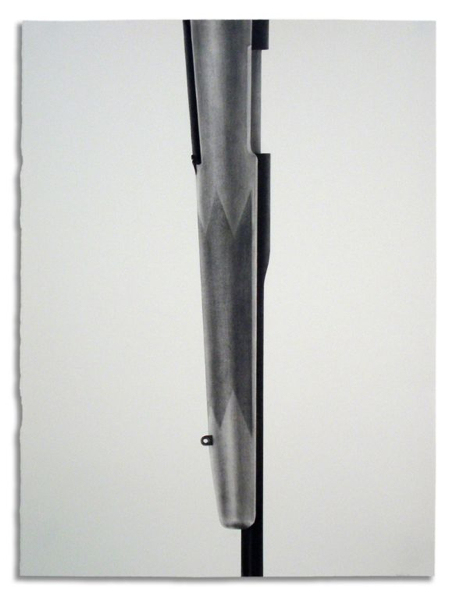 270 Winchester, 2011, 30’’x22’’ Graphite on paper
270 Winchester, 2011, 30’’x22’’ Graphite on paper
How were you able to add your artistic interpretations, through your time at Richland College in Dallas?
While at Richland I ran the art galleries, which allowed me to curate thought provoking work into an institutional space, treating it more as an alternative, experimental venue. The benefit of working with so many artists is that I made many friends, I had a way to help artists, and I expanded my own ideas of what art can be and how it can function. If you can put yourself in a position to help others you find that you are inadvertently helping yourself and you stay tuned-in to the scene.
Expand on your thoughts on the importance of collaboration with other artists?
If you hole up in your studio you might make some great work, but I had to ask myself: what would be the end result? I have thought, on-and-off, that an art life would be an exciting life exploring new ideas. But, I often find myself stuck, thinking it is about making objects. To break this tendency to fetishize the object or get stuck in one set of ideas, one way of making I challenge myself to work with others, which is often much more fun. I find myself engaging, flexing, and constructing more exciting ideas. Part of this is the power of dynamic conversations with peers, cajoling my process into alignment or to buttress other, foreign practices.
Discuss how you constantly use new and unusual materials in your art work?
Ha! Well, I think it started when I was making drawings about guns and decided to use a material more meaningful than graphite, so I started using gunpowder and lighting it on fire. During this time I joined Culture Laboratory Collective and I made a rule for myself that I would explore new ideas and materials with every exhibit, and not use gunpowder. By implementing these rules it forced me to be more creatively open until it has eventually become a facet of my practice to explore different methods of making.
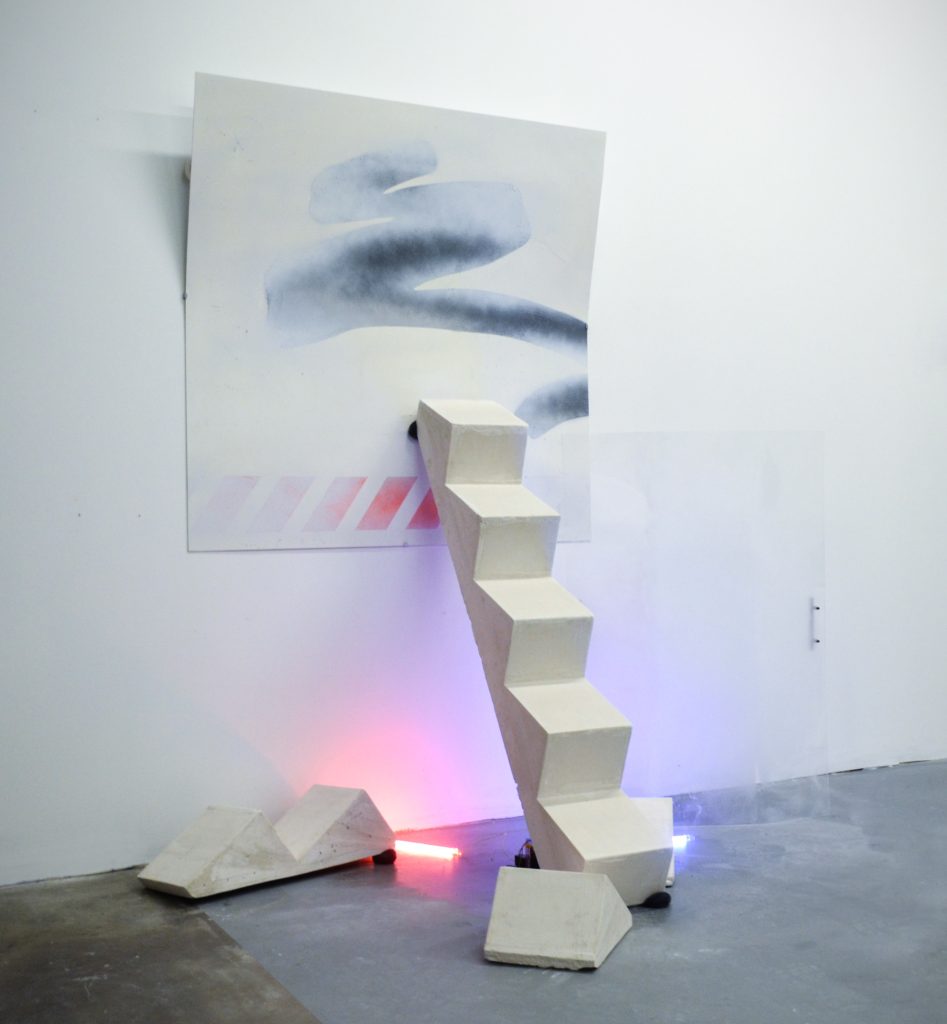
‘Pinned’ 2015, 82’’x52’’x52’’ Lights, battery, blaster, baseballs, balloons,acrylic shields,plastic, acrylic paint.
You use a very unusual material, Gunpowder expand how this came about and the way you use it?
I am often asked if I got the idea from Chinese artist Cai Guo-Qiang, who also uses gunpowder, but I first came across the idea through Ed Ruscha drawings where he was rubbing gunpowder, not igniting it. ~ At the time I was interested in Southern symbols of masculine culture, both through cinema and my own experiences. I decided that, conceptually, I wanted the work to be richer, more complex and powerful.
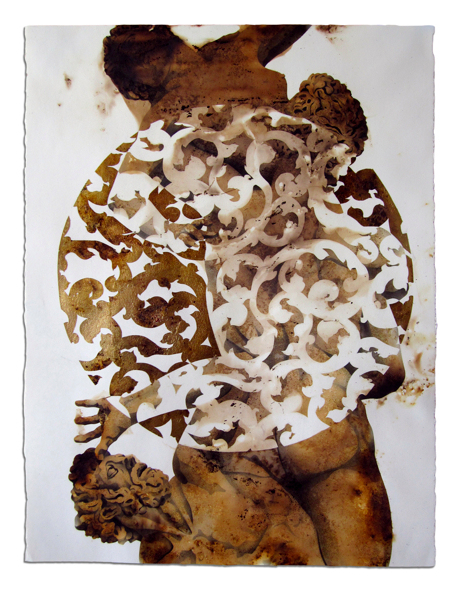 Pleasure Principle 11, 2011, 30’’ x 22’’ Gunpowder, graphite on paper
Pleasure Principle 11, 2011, 30’’ x 22’’ Gunpowder, graphite on paper
I essentially make a black and white drawing, spreading gunpowder over certain areas, compress it, and ignite it. The resultant mini-explosion singes the paper with heat and chemicals. By igniting the gunpowder on paper there is a moment of extreme risk where the act of creation is also an act of destruction that can easily destroy drawing. The process is about precise control of powerful elements, similar in concept to how gunpowder in guns is used.
Do you feel that it is a controversial material to use?
Not really. I can see that other people may find it controversial, but in my culture it is simply innovative. More subversive is my imagery of double rifles with a negative space phallus, and the use of rifle etchings to echo interior design floral patterns, as if all of this violence is so subliminally ingrained that we cease to see it and are instead seduced by it. Another piece looks like a mandala, but shows a shell casing surrounded by sperm. The fact that it is made with gunpowder adds a level of technical, conceptual innovation, but really I am questioning the conflated acceptance of beauty and embedded replication of violence in our culture. That is the controversy that I want considered.
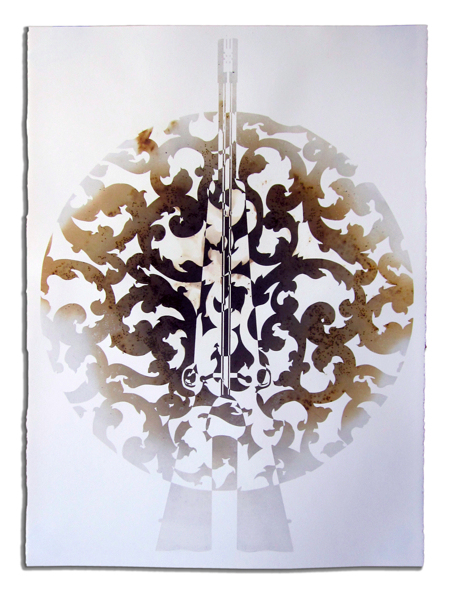
‘Disruption 11:Void’ 2011, 30’’ x 22’’ gunpowder and graphite on paper
How do you describe your art – Installations, sculptures expand on this?
Well… I make installations, paintings, drawings, and sculpture with the occasional video/sound piece or computer programming thrown in. I would say I am a bit of a conceptual artist, where the idea drives the creation of the object, and thus the materials.
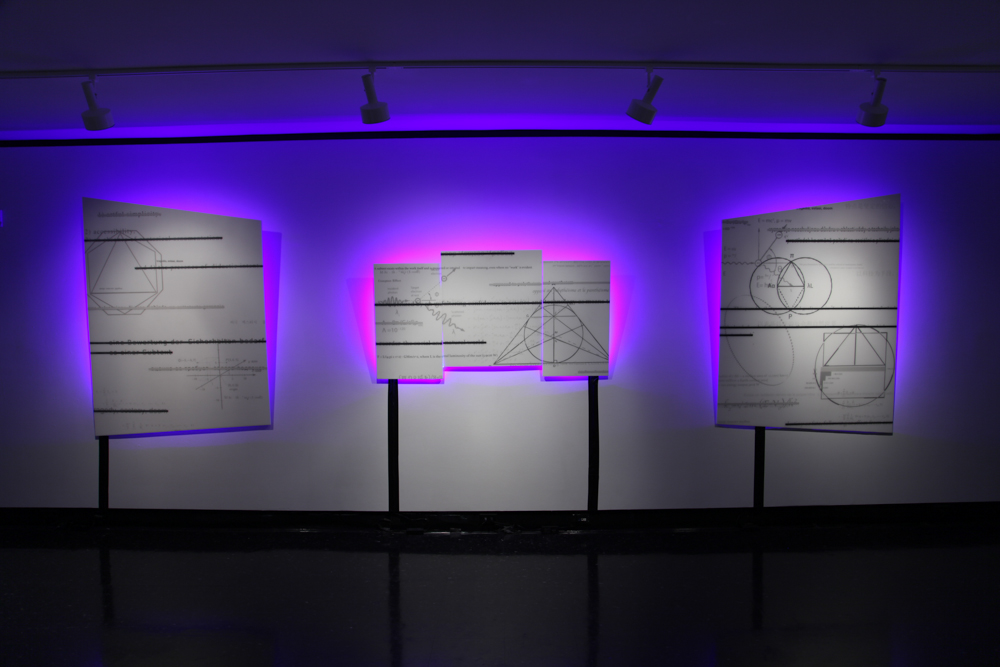
“The Idyll’ 2015, Lawndale Art Centre, Houston
In my last solo show, The Idyll, I built out the walls of the gallery to echo the shape of the Rothko chapel, and built an interactive pulpit/sound machine surrounded by small, cast platonic solids. There were several drawings on the walls, several painted panels either on the wall or acting as free-standing sculpture to mimic the monumentality of high-modernism. I tend to build out a space, which I consider sculpture and installation, allowing it to alter the viewers experience and provide its own context within the space. During the Dallas Biennial 2014 I created a temporary gallery inside a warehouse called I Could Love You Less.
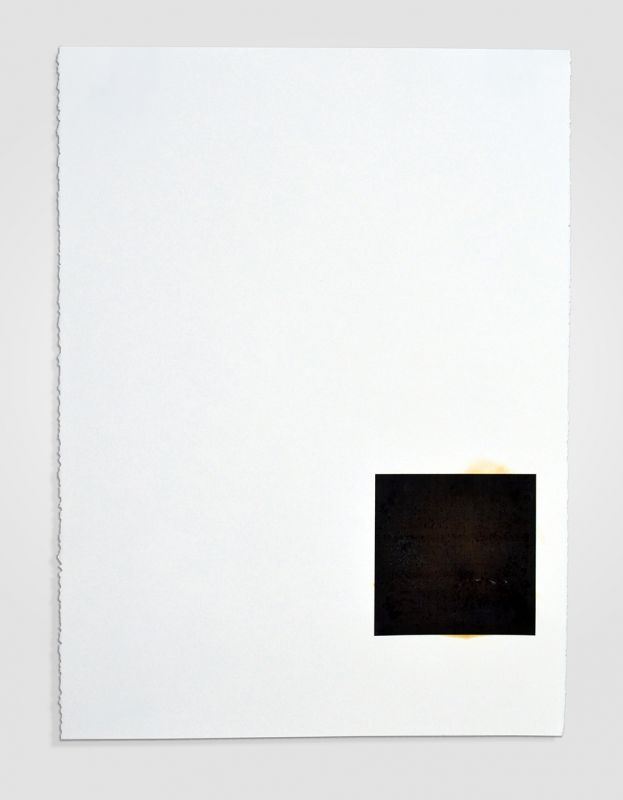
‘I Could Love You Less’ 2014, 30’’ x 22’’ Pigment, gunpowder on paper
I only put one minimal drawing in it and cut a hole in the wall that was glowing blue, sort of a poor-man’s James Turrell. Behind the temporary gallery I had several works wrapped up in plastic on palettes. The wrapped art served as sculptural props referencing my history and the invisible labour of high-modernist gallery aesthetics.
I also made a piece, Obligation, from a mirror-ball circling a paint can on astro-turf. This type of piece is kinetic and sculptural, but takes on an installation quality when the light is reflected across the space. It is a rather simple, but dynamic piece, that hovers between ready-made, sculpture, and installation.
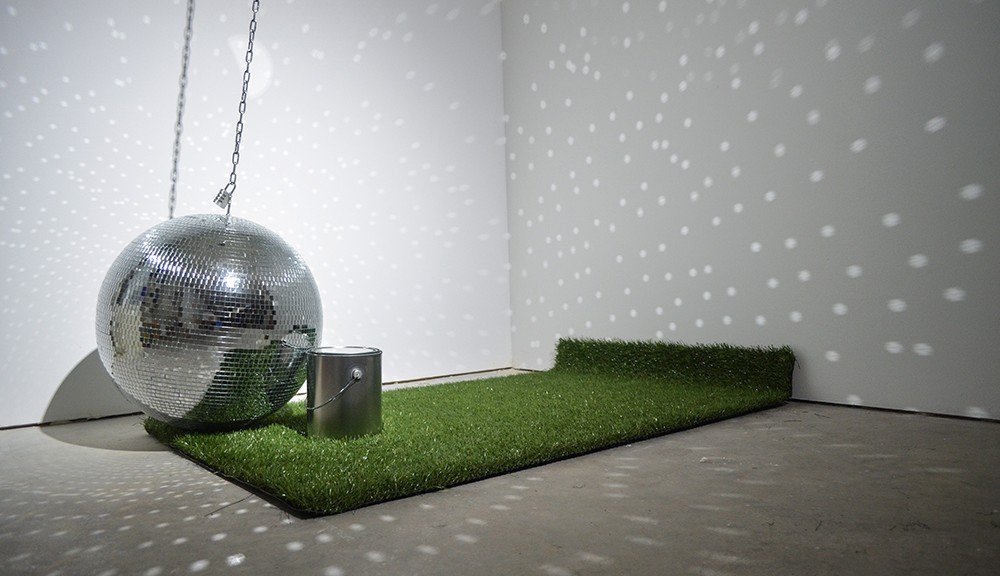
‘Obligation’ 2014
What are your thoughts on the need to have a label for the type of art, artists do?
It kind of cracks me up. Seriously. I have two degrees in painting, so I should be a painter, but I only occasionally make paintings. My recent “painting,” Pinned, features cast plaster stairs, plastic, lights, and baseballs.
When my wife is asked what kind of art she makes or what kind of material she uses she says “Yes.” We simply don’t think about labels anymore and all materials are fair game. Recently I have even done performance art that is actually drawing at Blue Star Museum in San Antonio, Texas: Stance of Contemplation.
You have had a residency every year since 2008 what has come from two of these that has given you particular improvements in your work?
My residency in Germany was great. It reaffirmed my love for drawing, which was originally rekindled with my 2008 Vermont Studio Center residency. Occasionally, we become accustomed to tools and specific work environments, and I love that a residency can strip away that complacency, leaving us with a shortage of comfort which causes us to reconsider our practice, or in this case, my identity linked to a gun-culture state.
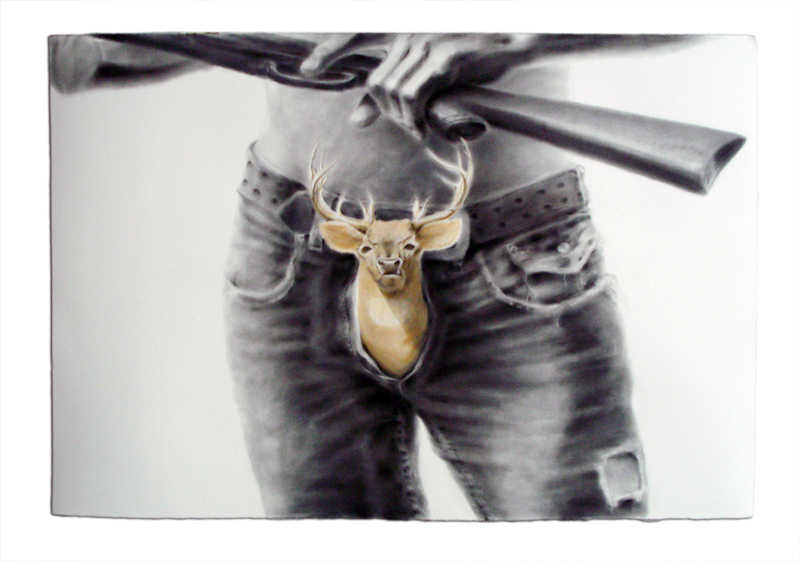
‘Impossibility of defeat; Buckshot’ 2009 30’’x 40’’, Graphite and acrylic on paper
The second residency that really changed my practice was Roswell Artist-in-Residence Program in 2012-13.
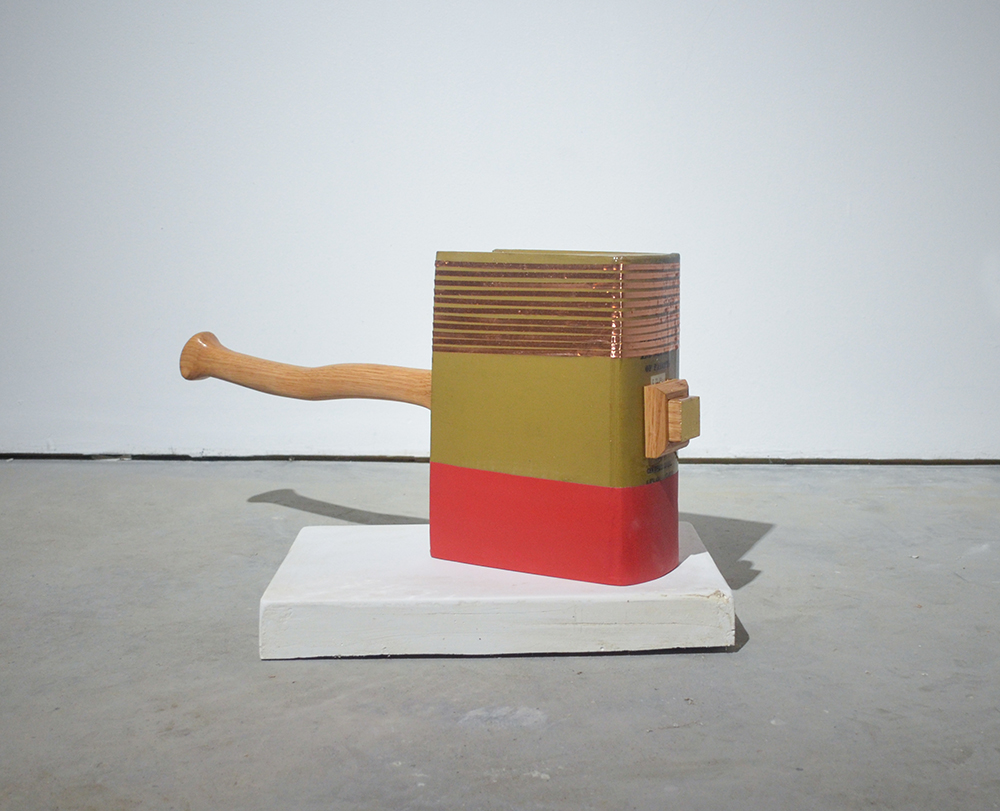
‘The Cube:Wood, 2013, 10’x10’x10’ Acrylic, wood, pedestal
I had a full year with a house and studio. During that time I started by referencing classical Italian sculpture, making flattened wood sculptures with scroll-work and gunpowder: sort of reconsidering America’s billboard signage versus the beautiful, violent three-dimensional propaganda art of the renaissance. By the time I was leaving the residency I was making minimal installations, drawings, and art actions. It was a time to grow and stretch as an artist, and I tried to make the most of it.
How do you decide which residencies to apply for?
It is often word-of-mouth. If I have a friend who enjoyed it, or if it is highly regarded and at least partially funded, I consider it. I think a lot of it has to do with scheduling. Not everyone can leave a job for a year, or even a month. I wish I had some really sage advice for you, but in the end every residency is what you make of it. Some may have better resources or reputation, but if you make great work and meet cool people during any residency then it did its job.
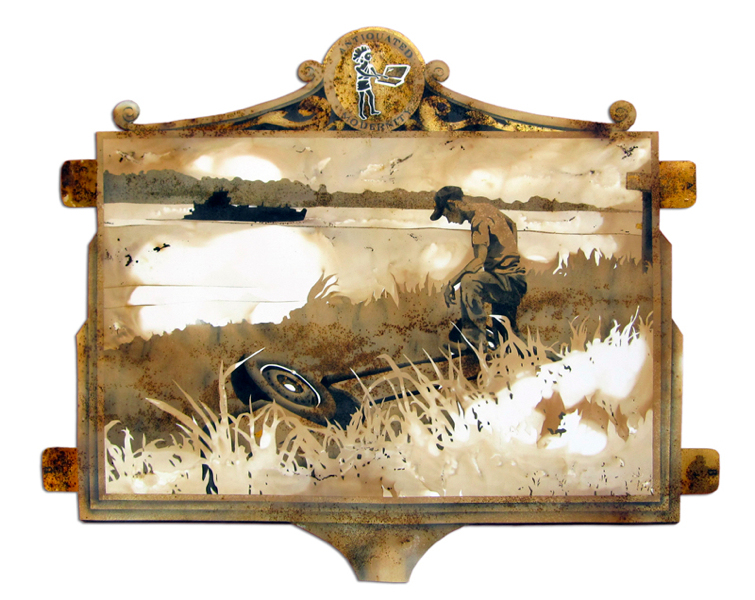
‘Antiquated Modernity:Besmirched. 2012, 30’’ x 40’’Gold leaf, graphite, gunpowder on cut paper.
As you have been so successful in acceptancy for residency can you give some advice for other artists who would like to be accepted?
I usually target my projects to the location. For instance, in Roswell I made work about the South West and I opened and ran an art gallery inside the studio to bolster social interaction with the residency. In Germany I made work about Texas stereotypes, which was exotic for them. In Kentucky I made work about the relationship between the river and city. ~ Why go to a distant location if you are not willing to let it influence you and your work? A residency, for me, is about engaging the place I am going, generating new thoughts related to the area and people.
Expand on your 2015 Solo exhibition ‘a thing of this world’
The development
I have studied gun culture in the South, Utopias, and how governmental redaction related to UFOs helps spawn conspiracy theory. Most of my work seems to be about revealing or playing with hidden, subliminal, or institutional bias. Recently I have been looking at police, riots, and other forms of civil disobedience. Initially shocked by the news I began to read and study, going from theories on “power” to a manual for “How to deal with Intractable Conflict.” Then, I think I read some sci-fi, a book on the Freikorps, and texts on object-oriented-ontology, occasionally talking to former police officers and military people.
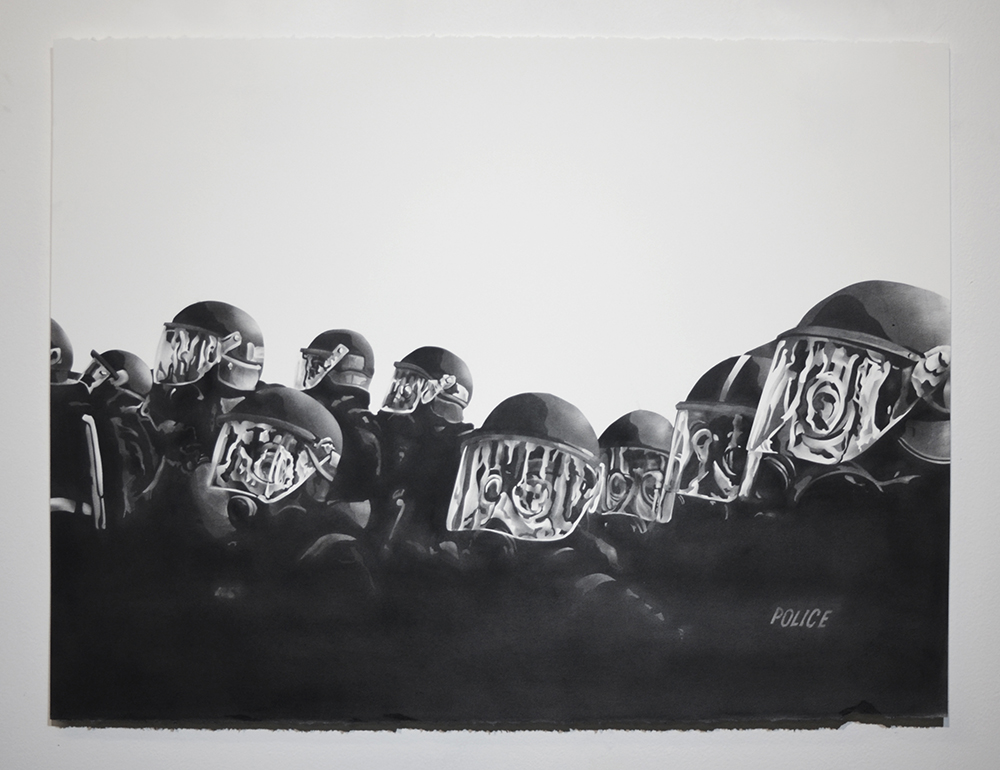
Shield:Intractable Conflict 111, 22’’ x 30’’ 2015, Graphite, pigment on paper
I am attempting to come to grips with the dynamic of citizens who ‘police’ other citizens and the increasing mistrust between the two groups. Looking at the tools and visual symbols police embody the “predatory silhouette” aesthetics, dehumanizing their appearance and often aggressively over-reacting. The populace will no longer comply willingly to an institution they do not trust or respect, people they do not believe honestly wish to ‘serve and protect’, causing an escalation as situations are more often handled with force as police demand compliance.
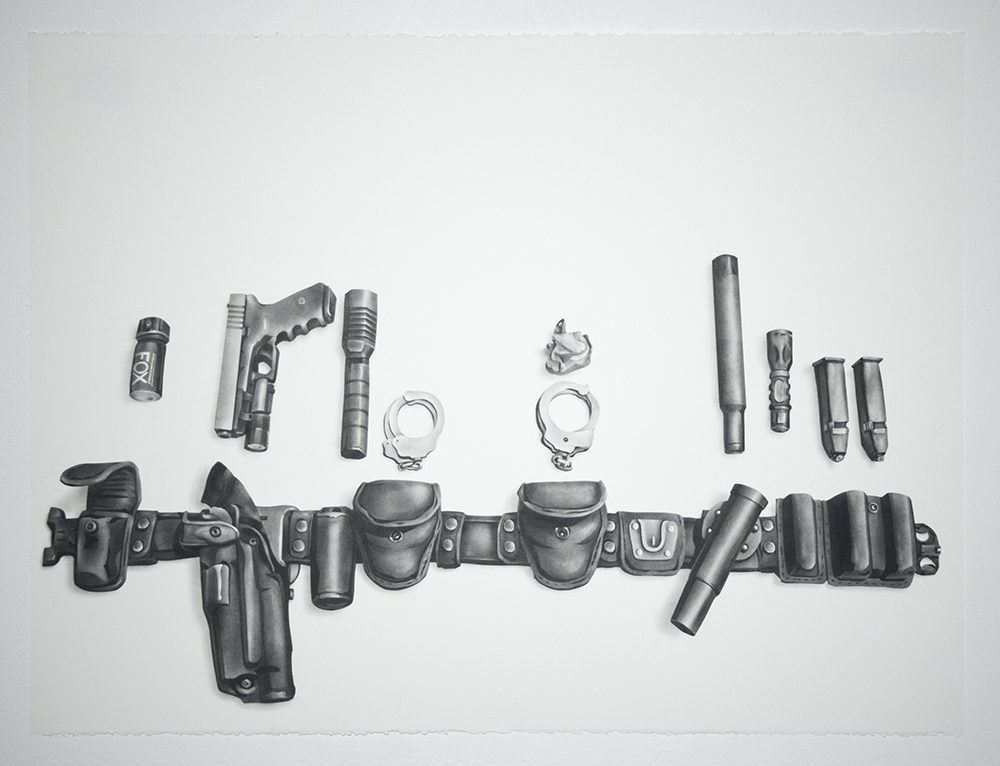
‘Shield: Utility’ 2015, 22’’ x 30’’ Graphite, pigment on paper
For the exhibit I have pieces dealing with various methods for coping with this reality: the tools used (police utility belts and home-made riot shields), academic knowledge (texts), to the aftermath of a riot (burning tires).
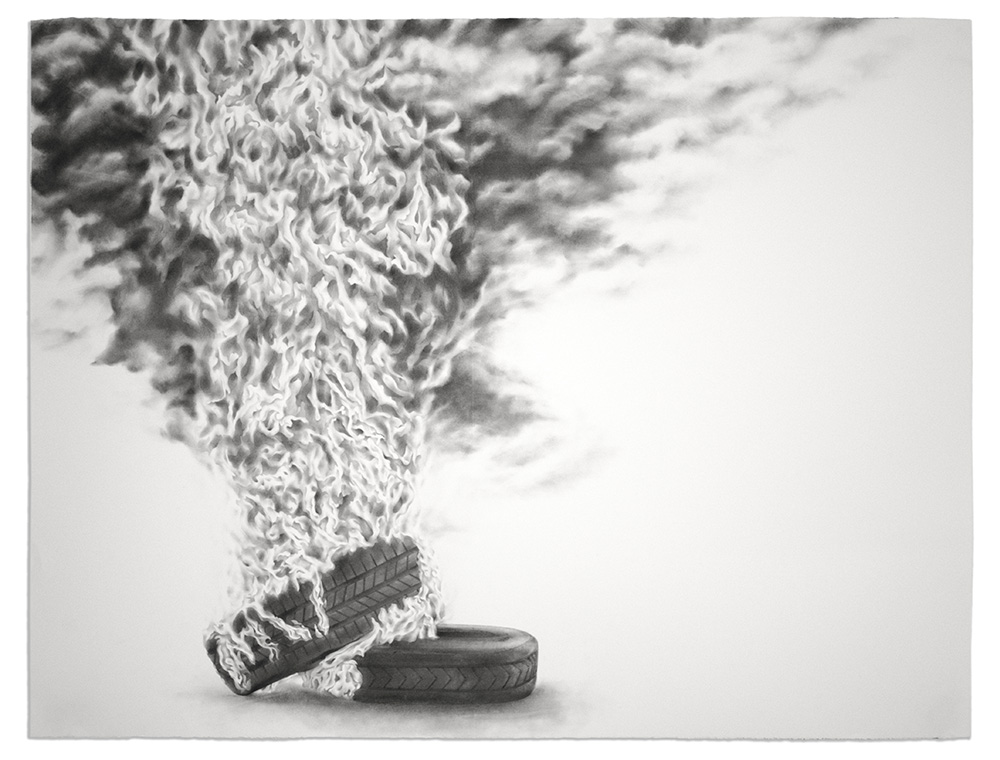
Shield: Burn, 2015, 40"x60" graphite and lamp black on paper
I am currently making a Kevlar hoodie for the exhibit and a tower of car batteries and lights.
The size of the exhibition and the amount of work needed
The exhibit will be relatively small as PA Gallery is a fairly small, alternative space, roughly 12’x16’. They are interested in experimental research-based work and really encouraged me to think about an installation, so I will probably build a few sculptural elements on site, such as cast plaster stairs, make a mural, and install 4 or 5 wall pieces. At least that is the plan now, but I may need to edit pieces out of the show down once I am on site.
The importance of it being in Brooklyn rather that in Texas
I would love to say that the work will be better received in Brooklyn, leading me to great success and fame. But primarily I developed the work considering some issues related to New York, such as the ‘stop-and-frisk’ policy, Eric Garner and the revenge shootings. However, I think the work is universal in many ways, considering such large social dynamics.
Tell us about The Art Foundation that was established in 2012 and the role you take and what the Foundation has given back to you?
The Art Foundation is a group of Dallas-based artists who got together to curate a show, wanting Dallas to host exhibitions that could be considered internationally compelling rather than merely regionally relevant. The interesting thing is that we received a lot of regional attention with the Nasher Sculpture Center accepting one of our projects into their permanent collection, and the Dallas Museum of Art asked us to curate an exhibition of local artists. We also held a discussion on public art, worked with an artist from San Diego on a Dallas project, and created an exhibit at The Reading Room based on Jonathan Lethem’s “Chronic City.”
I think my role in the group alters according to the project. Sometimes it is idea generation, sometimes I take on tasks of building and doing, and often I end up talking too much. The benefit of the collaboration is the collaborators, who are much more sophisticated, tasteful, and smarter than I.
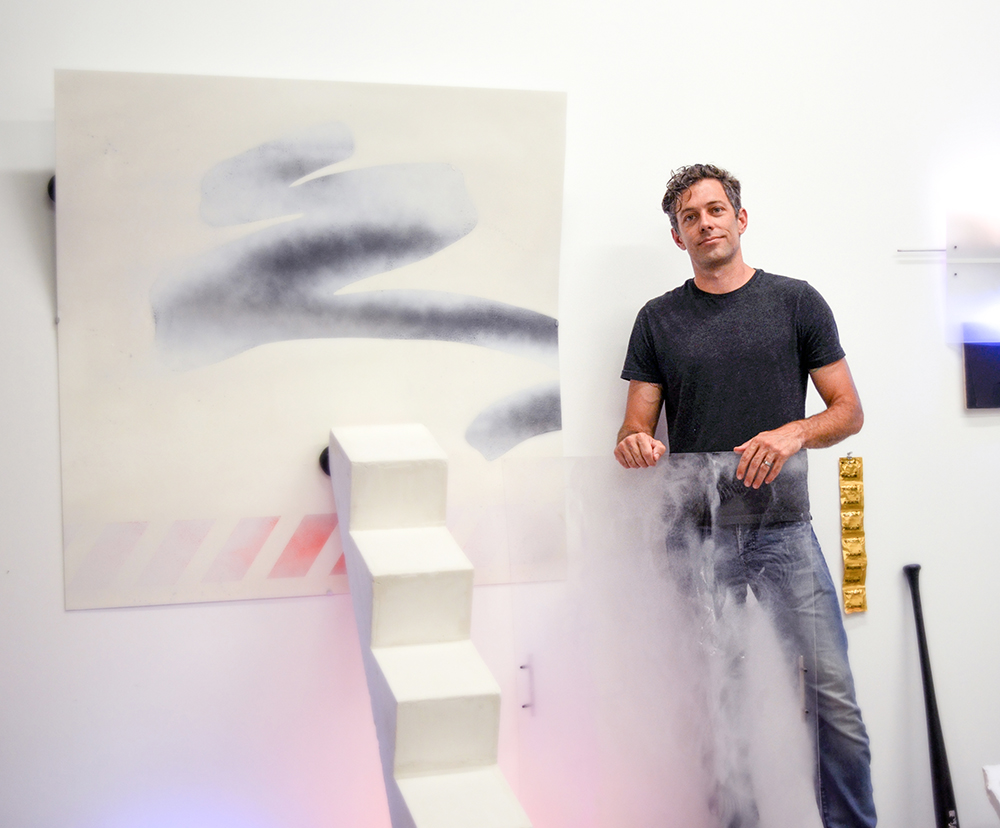
Contact details.
Interview by Deborah Blakeley, July, 2015
Miles Allen
Apart from the occasional landscape or portrait my art has always been geometric and abstract. It is hard to imagine doing anything else. I love creating order and rearranging shapes to get some uniformity.
I have two drawings from when I was about 10 years old. One is of coloured squares in the shape of a pyramid the other is a face with coloured squares all over it. It seems as though my passion for neatness, structure, logic and straight lines goes back a long time!
My work doesn’t often use curved lines. It may sound strange but I find them difficult to do. I like the certainty, the crispness of a straight line, a hard edge, a right angle and the repetition of shapes.
Have you always used recycled materials?
No, but I had always been conscious of just how much we throw away and had tried to minimise waste. I painted for the first ten years mostly acrylic on canvas.
In 2008 I found some old keyboards and worked with those for a while. I found some disused road signs and experimented with those and other signage items, then rulers and other measuring devices. More recently weathered and worn tin and metal.
About seven years ago whilst visiting France, I saw fruit and vegetable boxes at the market and was instantly drawn to them. They were decorated with simple stylised shapes and a variety of fonts, logos and descriptors and I had to get some! They have been my main source of art since then. Painting allows me the freedom to put anything on the canvas but with these boxes I only use what the material provides, with its printed logos and descriptors, its textures and evidence of prior usage. I have to incorporate what is already present.
Does your technique allow you to work on large scale 2D pieces or does it become too heavy?
I love creating large works, I find them challenging and I feel I can sometimes say a lot more in large works. There is something beautiful about one rusty tin or one cut-out apple, but put 100 of them together and you have something far more beautiful and completely different with the possibility of recurring patterns and motifs. With large works there seems to be greater need to balance the work, to step back from it and gauge its overall harmony.
Transporting large works is harder and yes, they are heavier so I normally construct them in two or three pieces.
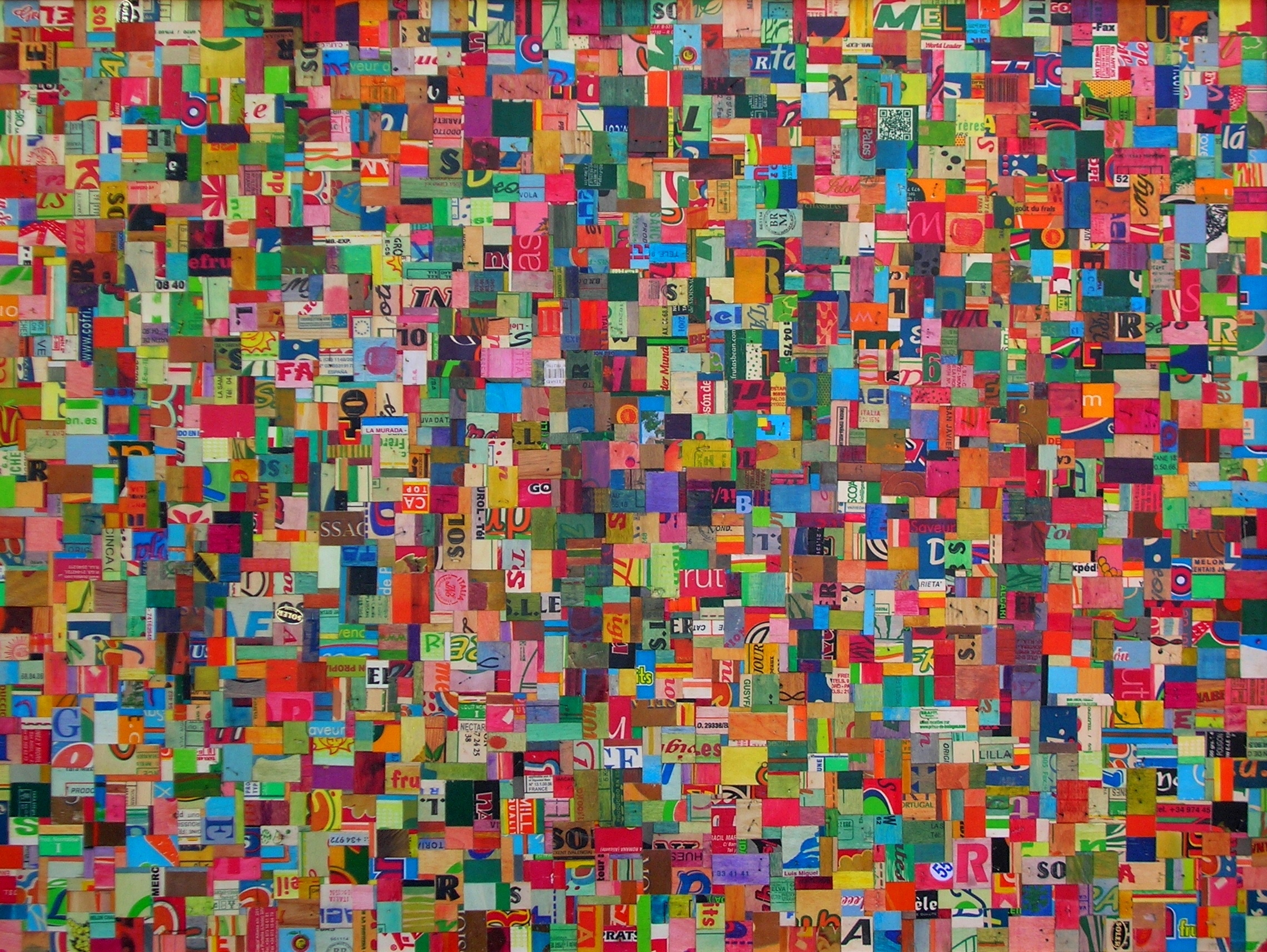
Why (2013) Plywood, ink, acrylic and wax. 90 x 120 cms
Discuss the importance of aboriginal art and Rosalie Gascoigne in the way your own art has developed?
In 2008, I saw an exhibition of Emily Kame Kngwarreye’s work at the Queensland Art Gallery and for me it was a seminal event, something that changed my creative life for ever. Her work was so varied, so colourful, so majestic and it all worked together – to my naïve view it looked so simple and I thought ‘I could create something like that’.
I wanted to do something that impacted on me, that I could look at and enjoy, knowing it had come from me. So I explored Australian indigenous art, finding out as much as I could about the different styles and the people who made it. And I played around with paint on canvas initially using the colours I saw in many indigenous works and just experimenting with lines, patterns, shapes and structures. There is a narrative within these works with an inherent structure and logic and an organic quality – there is something in a lot of indigenous art that touches my sense of symmetry and structure in an inexplicable sort of a way.
My first view of Rosalie Gascoigne’s work was of her deconstructed road signs I remember thinking what a brilliant idea it was to cut up things that were everywhere, yellow road signs with black paint and other items with letters and figures on them. I read more about her and discovered the variety of works she did and how she linked them to the landscape around her and it all resonated within. When I discovered the fruit and vegetable boxes I made an immediate association with Gascoigne’s work which deepened and activated the inspirational aspect of her work.
In 2010 you gained the commission to design a huge mural. Can you expand on this and discuss the planning and process?
I was approached by a construction company in Bella Vista, a suburb of Sydney and they were building a large office block. They wanted me to quote for the design of a mural covering a wall measuring 110 x 8.5 metres. I thought about this for long time – I had done commissions before but on a much smaller scale with clients who were happy for me to create what I wanted within loose parameters. How much say would I have in that, how would I actually do that, was I capable of meeting their needs, how could I envisage a wall of that gigantic scale and reduce it to a workable size? The wall, the project and the task were all huge so breaking it down into small steps with approval by the client along the way was for me very important. Here’s that need for structure again!!!
The quote was accepted and so the task began of meeting the brief of a mural with ’Mondrian-like qualities in blues and greens’. I collaborated on this commission with my son Tom Allen, an industrial designer who was living in Barcelona. We worked through many mock-ups before submitting seven options to the client. He chose one and then our task was to refine and develop this design. We eventually submitted the exact measurements so it could be transferred to the wall.
After two years, 400 emails and numerous Skype conversations the client was happy and after eight weeks a team of painters had completed the task of painting the wall.
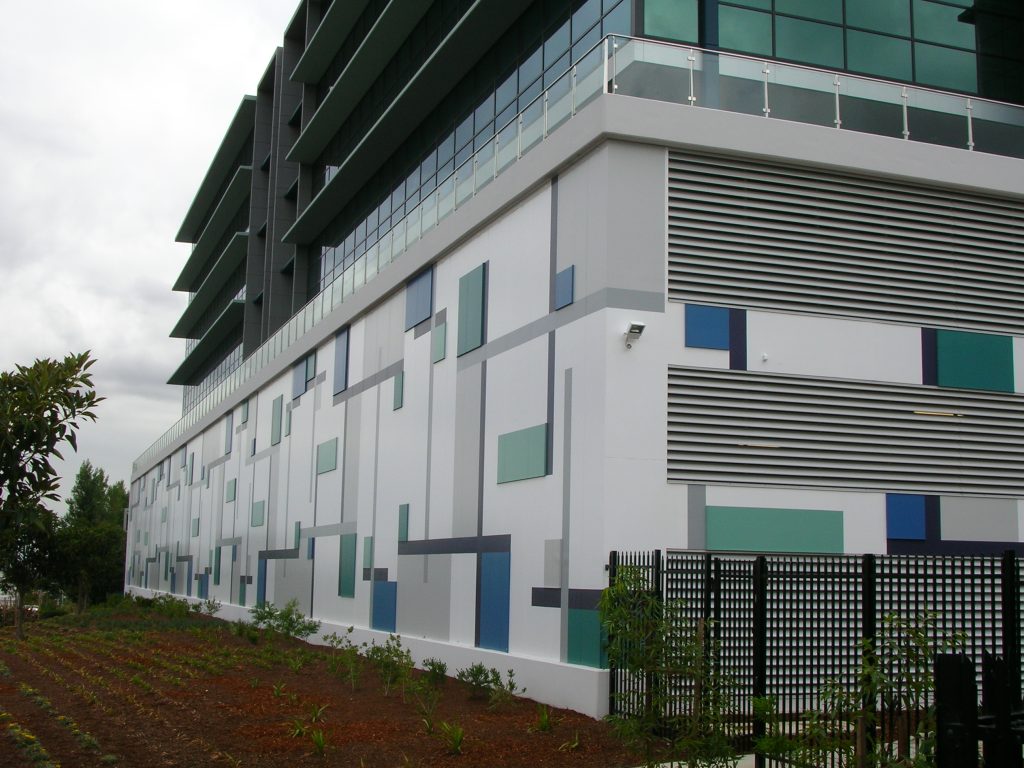
I went to Sydney for the opening of the building and my first face-to-face sighting of the building, the client and the mural. It was a fantastic experience to see the work – I was amazed at the imposing height of the wall. The work towered eight metres above me and I had to stand back a long way to see it all in one go. There was a huge adjustment in the mental picture I had constructed for myself and the actual physical experience of being in the presence of this wall.
The building is on a major road and 70 000 vehicles pass this mural every day and so it gets plenty of exposure.

Miles Allen-Mural 2, Bella Vista NSW (2012-4) 8.5 x 110 Metres
What are your thoughts on art in such public places?
I think art in such public places compensates for the coldness and rigidity of materials existing in our urban environments such as concrete, steel, metal rods, asphalt, pavements. All of which can have very uninteresting colours, forms and shapes being built from practical and cost-effective perspectives often at the detriment of aesthetics.
I think generally we are witnessing a welcome shift which is more integrative of visual beauty and which attempts to balance practicality with a visually pleasant and attractive urban environment. There is a well-documented link between lived-in environments and our mental well-being.
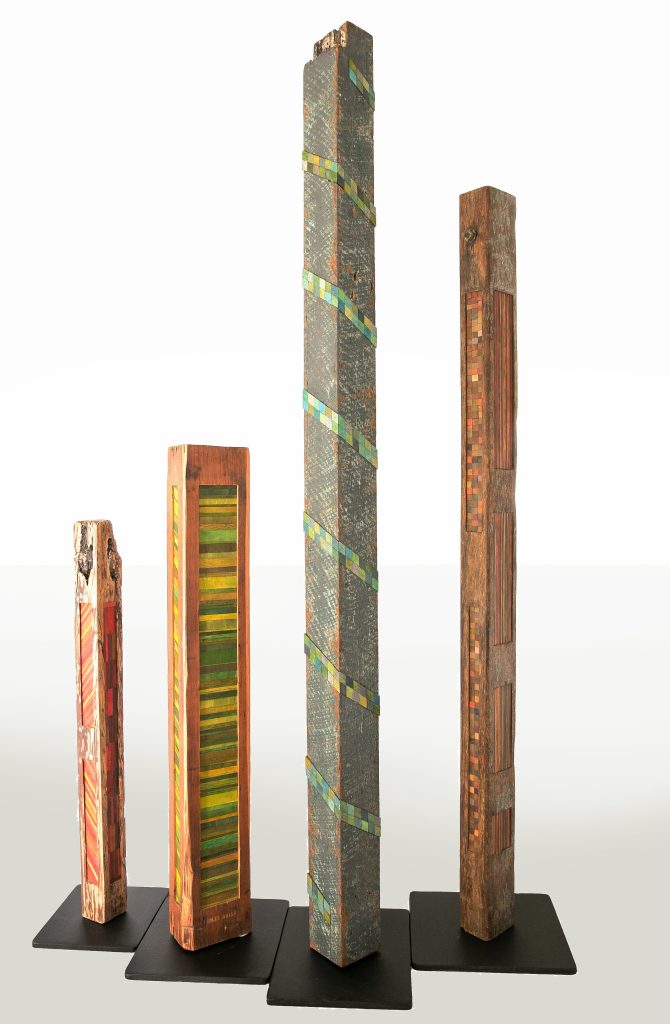
Posts of recycled timber inlaid with plywood (2014) Various sizes maximum 185 cms High
What comes first, the finding of materials or the idea/inspiration that then leads you on the search?
It is a bit of an interplay between the two though more often than not it is the materials that tend to lead the way to an art work. I think it is important to be attentive to the inner dialogue I have with these found objects and let them guide my creative process. Yet at times I have an idea at the back of my mind which drives my search through markets, garage sales, rubbish tips and recycling depots. It’s really about being openly curious and receptive to both materials and ideas and flow with the possibility of being surprised by unconventional ways of utilising objects and exploring ideas.
Can you expand on your use of rulers and other measuring devices?
My art practice has consistently relied on accurate measurement to create clean lines, close fitting shapes and patterns, so the act of measuring is a central part of facilitating accuracy in my creative process. I have always been drawn to rulers and other measuring devices and one day I bought an old wooden carpenter’s ruler. And then I bought another one and so on. I kept buying different types of rulers for a few years knowing that one day I would modify them for my art.
Cutting up these rulers to create something new challenged me and my attachment to these objects. They hold much beauty, marks of usage, wear and tear, and history. I aim to preserve and enhance their aesthetic aspect whilst changing them forever and giving them a new life.
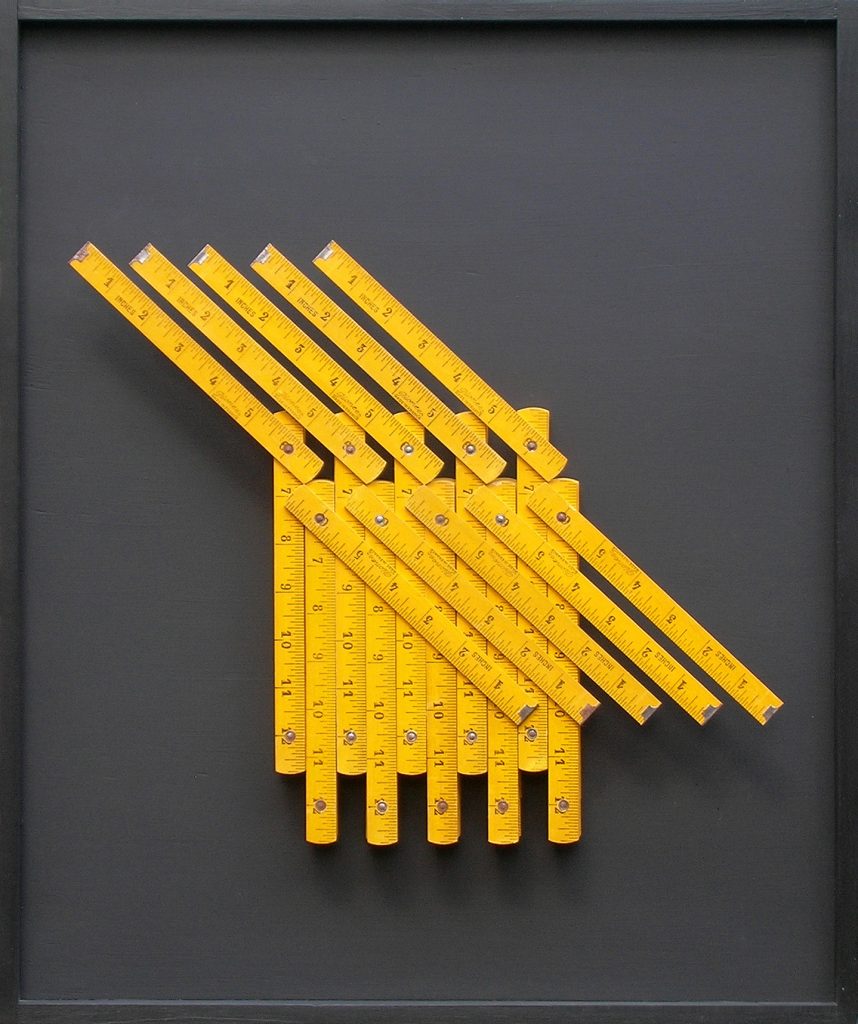
Pioneer (2012) Rulers on board. 53x44cm
The work Pioneer was created from a box of new unused rulers I found at a flea market in France. I instantly saw beauty in their colours, newness and regularity. I traded their functionality for a use which gave them a new purpose. Throughout the process of creating art using found objects I aim at preserving and enhancing the beauty I see in them whilst inviting viewers to explore their notions of art.
Discuss the similarity between your work and patchwork and quilts?
I constantly look for patterns in nature and in our built environment and am particularly drawn to the patterns found in some Amish quilts. Much of my work with recurring patterns allows people to make a connection with patchwork and quilting. I have rarely purposely made work to be similar to patchwork though The Spanish Quilt series of works was deliberately created to provide a resemblance to quilts.
I collected the materials used to create these works in Barcelona where my son was living and from markets around my partner’s home town in southern France and I brought them back to Australia. My mother used to do a lot of sewing and work with fabrics thus making these works re-created and enlivened the relationships and connections with those closest to me and memories were rekindled and enhanced. In these works each piece of timber connects to another in a rhythmic visual interaction. Thus a metaphor exists linked to my mother, son and partner – their connection with one another and with me is greatly enhanced.
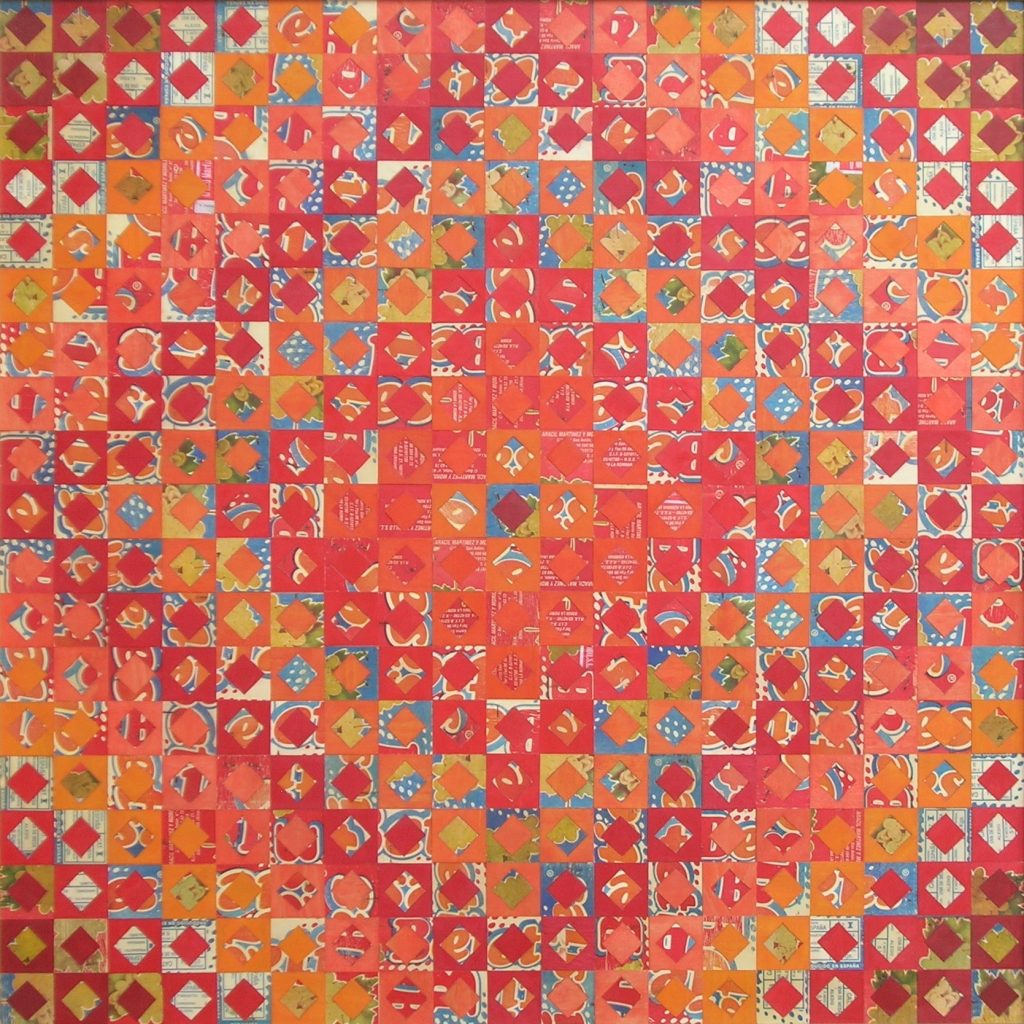
The Spanish quilt (2014) Plywood, ink and wax. 112x112 cms
Colour is a major aspect of your work. Expand on this and also the techniques you use to colour your materials.
I think of colour as the energy of my work. Colour is what binds it together and brings it to life. It is what defines a work in terms of its warmth/coolness, softness or sharpness. I sometimes work with extreme contrast and other times with semi-tones that subtly blend together.
I use a range of inks and diluted acrylics to tint the wood in my fruit and vegetable box compositions. I need to adapt the colouring pigments to the absorbent capacity of the woodgrain. I also need to take into account the existing colours present in logos and images printed on the wooden panels and the variation they bring. Again, it is about being open to various explorations in colour combination and the various density of tones how they either attenuate or bring out the underlying composition.
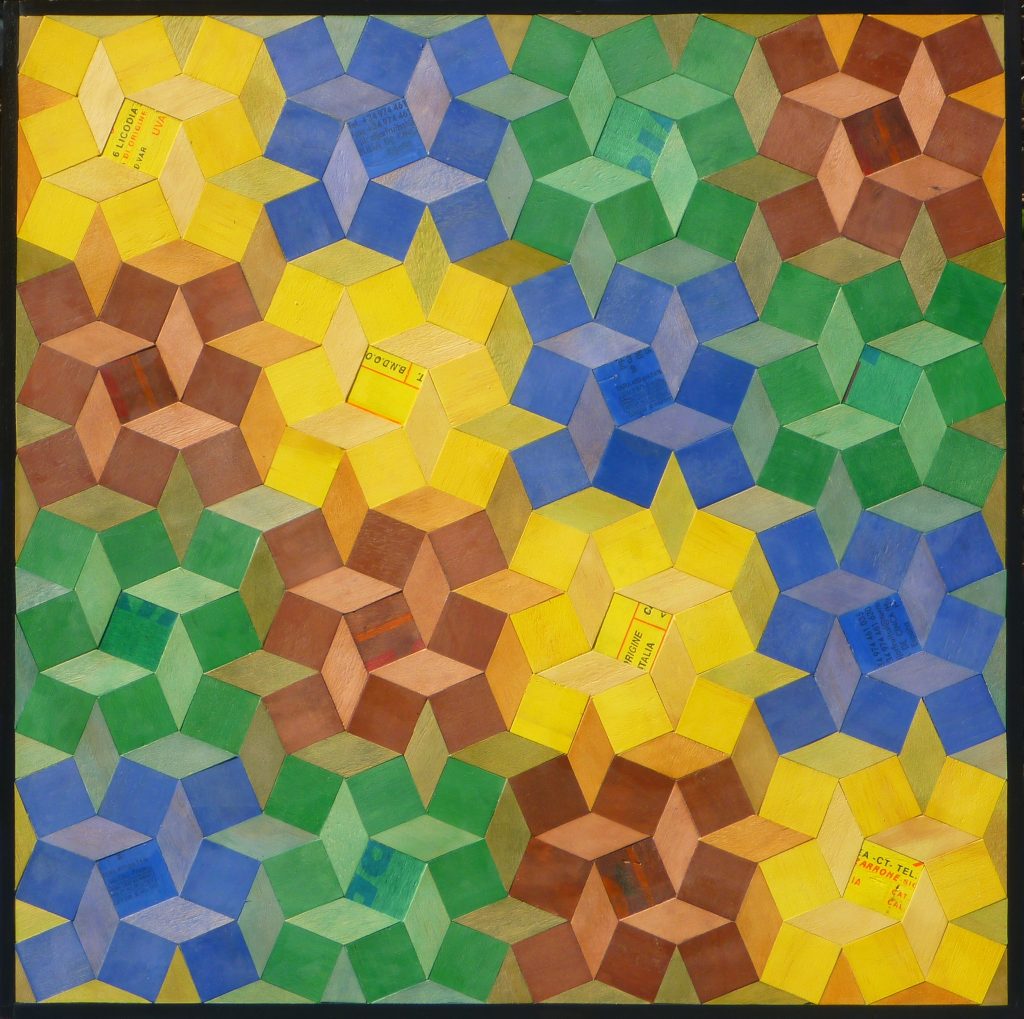
Four days in Marrakech. Plywood, ink and wax. 67 x 67 cms
Is your work related to the areas where you live?
I have lived in a variety of places since I left school and I have travelled widely. Like many people my environment and the people around me affects who I am. The studios I have worked in have always had views of trees and rural landscapes.
I am uncertain if my work with fruit and vegetable boxes would change greatly if I was living elsewhere. However, when I undertook residencies at Broken Hill and Hill End (both small, rural places founded on their rich, natural resources) I went with the specific intention of creating work directly related to those places; the materials I used were sourced from those places and gathering and working with them was an integral part of getting to know these places and creating work directly related to my surroundings.
Fruit plays a large part in your 2D work. Discuss.
Using fruit in my own compositions is an expansion of the little fruit printed on the boxes’ panels. I felt like bringing them out in larger scales and in isolation and I wanted to explore the diversity of their colours and the flowing lines of their shapes. Yet, because of my deep affinity with straight lines I have sometimes pixelated my representation of fruits so that the overall curves become apparent from a distance. It is also a way of celebrating the wide diversity of fruits that we have in Australia throughout all seasons as opposed to the scarcity of freshly picked fruit in the colder European climates.
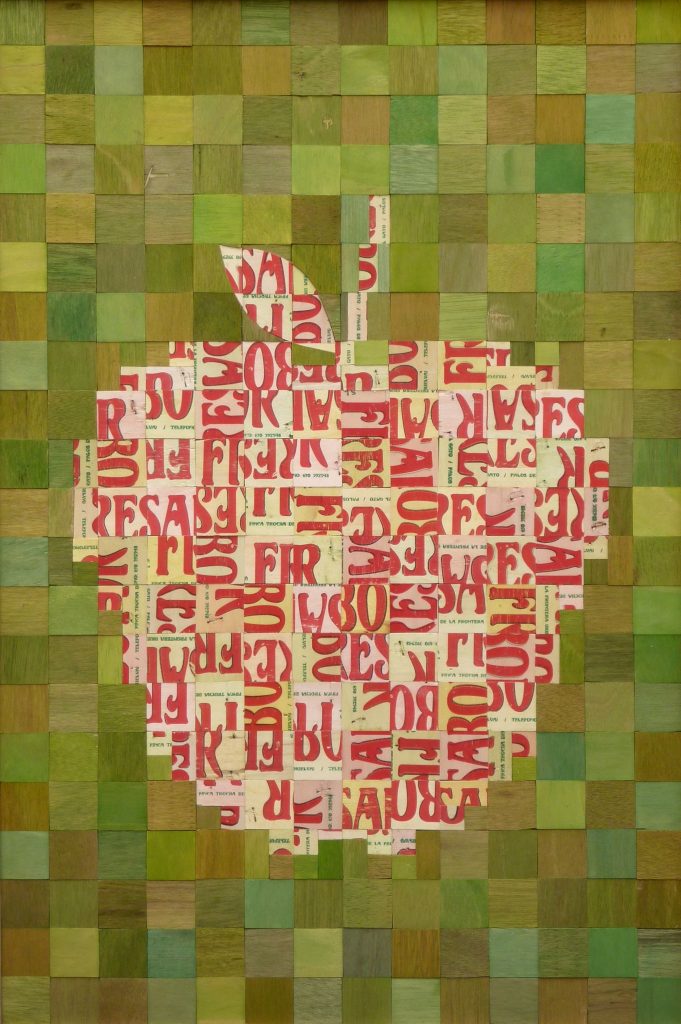
La Pomme (2012) Plywood, ink and wax. 90 x 60 cms
While you were working in Broken Hill (outback Australia) your work took on a very different look, discuss?
Broken Hill is a town on the edge of the outback with a hot desert climate. It was settled by Europeans because of its immense mineral wealth and since then it has remained a mining town. Much of the surrounding landscape has been ravaged and is devoid of trees and the town itself is dominated by the vestiges of mining though it has some beautiful heritage buildings.
I went there with the idea of recreating the landscape using plywood in a style similar to marquetry but shortly after getting there I soon realised that there was a whole world of other posibilities! When I go to a place I like to find out as much as I can by driving around it, walking, researching and reading about it, observing the inhabitants and looking at it through other people’s eyes. And by walking around randomly I get a closer connection to the land, I explore what seems like empty, sometimes deserted places and I observe nature.
On my walks I kept coming across abandoned bits and pieces, rusty metal, detritus from everyday living, remnants of mining and other thrown-away items. I kept picking up the bits which particularly interested me until before I knew it, a ‘pattern’ was emerging. My walks then became more purposeful, seeking items similar to what I had already collected and looking for materials and ways in which these items could be shown in an exhibition at the end of my residency.
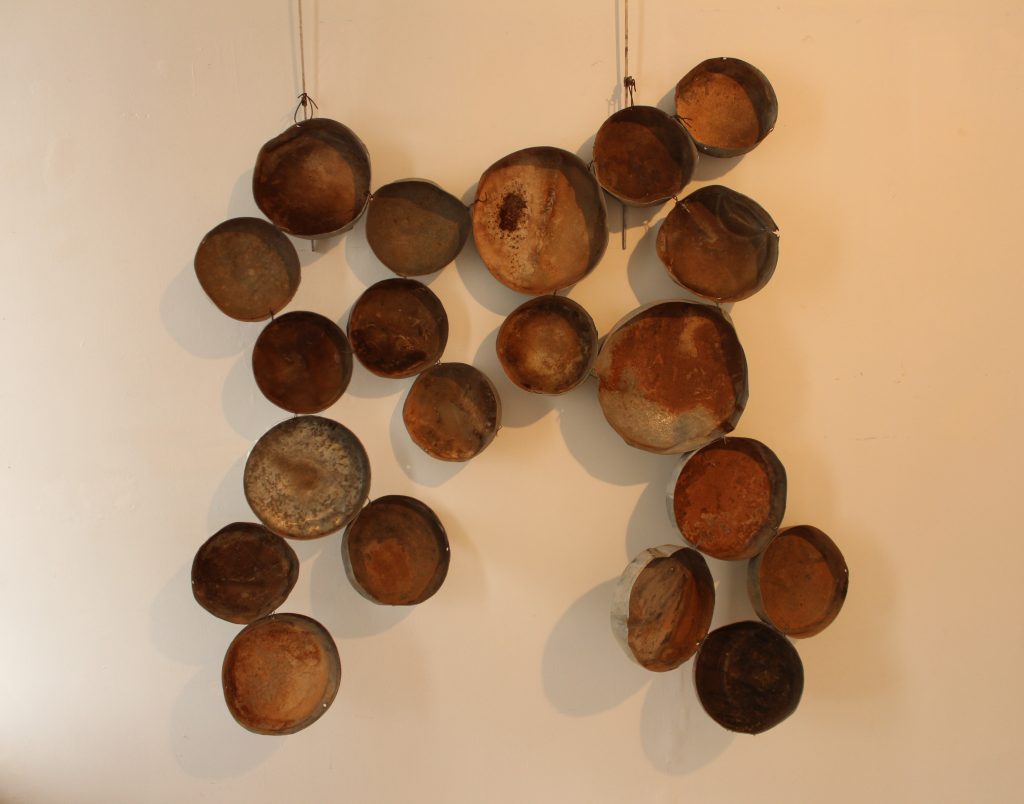
Poles apart (2104) Metal caps. 160 x 150 cms
The materials I used in the exhibition were discarded a long time ago as they had served their purpose, thrown on the scrap heap (literally) and forgotten. I had rediscovered and adapted them for another context and another purpose. Working in Broken Hill gave me the opportunity to expand my capacity for inventive variation and extend my visual vocabulary. For many years my art has been about seeing beauty in ordinary things, creating order, crossing cultures, joy, humour and repurposing. The exhibition, like my other ones, stuck to those principles.

United we stand, divide we fall (2014) Railway pegs. 15 x 100 cms
Contact details:
miles@milescallen
www.milesallen.com
Interview by Deborah Blakeley, July, 2015
Shannon Weber
Discuss how your work, had to be self-taught?
When I first started making objects while living in a remote area along the Rogue River in Oregon, I had a back ground in floral design with a knowledge of a variety plants in the trades. Working with hot house stem material is much different than working with wild tree barks and hand dug roots, so with that, the trials and errors began on what I could and couldn’t do with certain types of plants. Floral skills came in handy as I made use of the different wraps used in binding materials in my construction methods of making objects, however crude at first. I also found myself watching a fair amount of birds building nests and what materials they seemed to favour, which was very inspiring and allowed me to think on improvising and being even freer with my thoughts on how things should go together. I also started sewing or tying in rusted metals from a forgotten vintage mill site and all kind of fishing line debris caught up in the trees along the riverbanks. The advantage for me was that I had time and no fear of the results or materials and I taught myself skills every day. I found that random weaving anything I could get my hands on was an excellent method to start, I could focus on other techniques such as coiling and very crude twining.
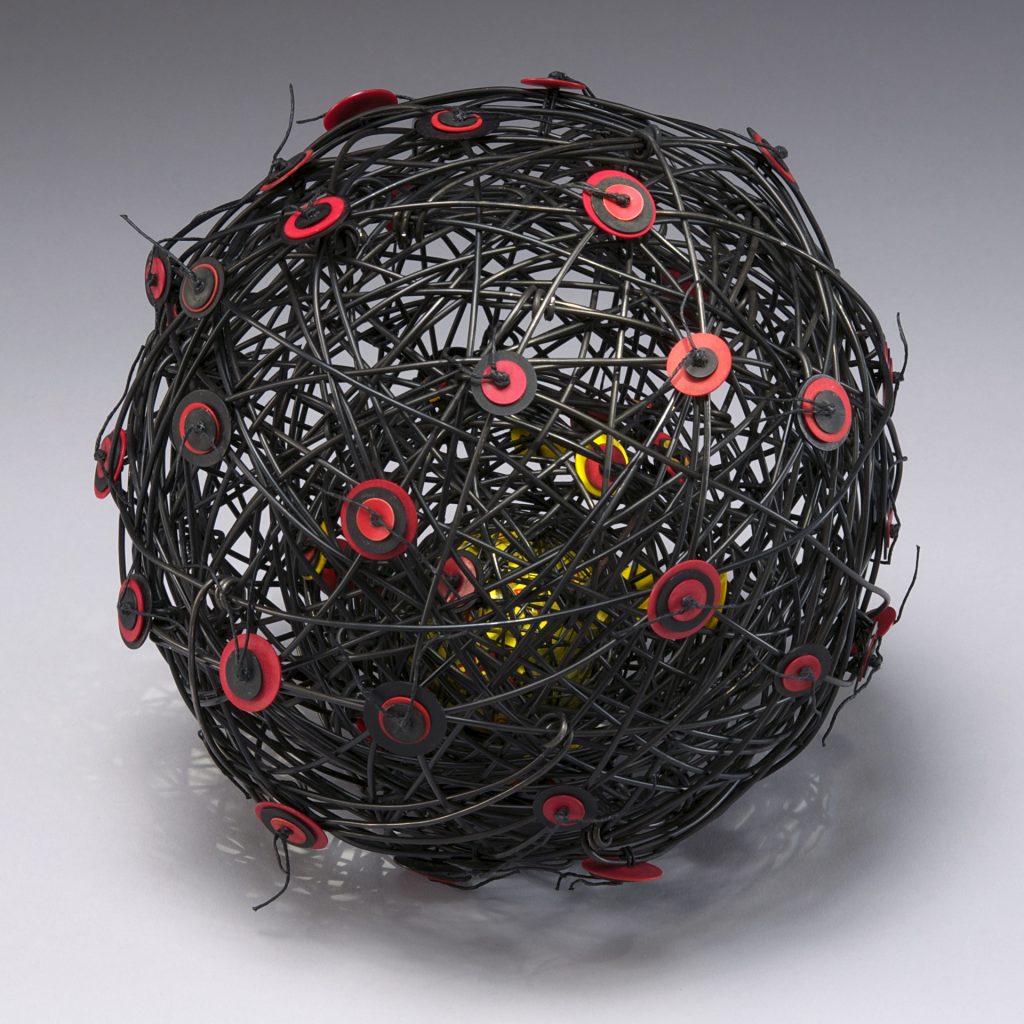
‘Roll Your Own’ 1920 x 1920 inches
Explain how you interpret ‘organic textile art’?
Organic textile art has a large range. It can be organic in shape and form, an item such as a wearable, or pertain to the subject of how the material was used and from where. But it doesn’t necessarily mean that it has to be from the earth, a natural fibre, an object or primitive technique. For me most of my work is in fact “organic” hand collected material and objects from nature with a small percentage of it being manmade debris of other kinds, mostly reclaimed construction wires and beach plastics. They could still be seen as organic in the raw materials they once started out as when made. I really have no judgments on organic thoughts since most things will return to earth at one time or another, some sooner than later. While 80% of my materials are plant based I just use what’s around me since most of the areas where I live are wooded or Pacific Ocean locations and there is an abundant supply. Today I live in a small town where I do have other options if I wanted them, but I love the thrill of the hunt somehow buying things to make things is just not me. It is always material collected from nature or odd places forgotten that inspires my drive in design, it is that limited option of only using what I have that pushes the element during the creative process
Discuss the way you collect to create.
Every day is a collection day. I can simply be inspired by how the watering hose coiled outside my front door looks and that can lead to noticing how many other things are coiled that same day, I can even narrow the scope of focus to the complexity of textures and colours of things coiled in my paths and travels. This can go on for weeks and sometimes into the months ahead, it can be both inspiring and maddening at the same time, but that is how it works for me. Something will just start screaming look at me, look at me and then my world will fill with that thought. I will then begin looking for materials to make that coil form. The same thing will happen with different materials, some will just start calling out, “You should pick me up and take me with you”, and before I know it I have 50 of that kind of object to design with. Whenever I think I have all the things I need to work with, then the process of what method of techniques I am going to approach those materials with first takes over. Setting materials on fire, to pounding with stones to transfer marks, ripping or cutting to assemble pieces by stitching or weaving, there are always so many options to explore.
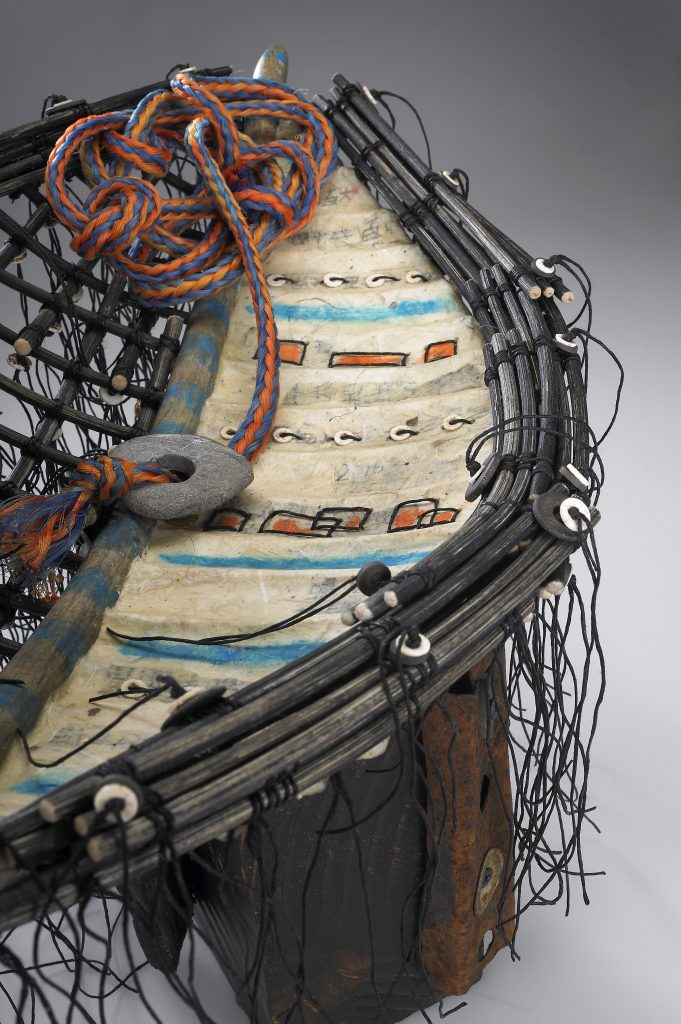
‘Dolly Dock’ 3172 x 4772 inches
3D is your preferred medium explain this in relationship to your current work.
I’ve never dabbled in 2D work as all of the materials I gather lend themselves to the 3D weather it is free standing or on the wall.
‘Carry Your Weight’ 2960 x 4074 inches
Can you explain the techniques of weaving you use in your work?
I mix various repetitive techniques in weaving, stitching and cold connections in multiple layers one over another anywhere from 3 to 9+ deep. In weaving I focus on random, twining, coiling and checker board designs. In stitching I can do some of the same techniques or just keep it to a very simple whip stitch by changing colour to move patterns one way or another. With cold connections it allows for opening the door to interesting surface embellishment by using wrapping techniques with plastics, wire, or rubber to name a few.
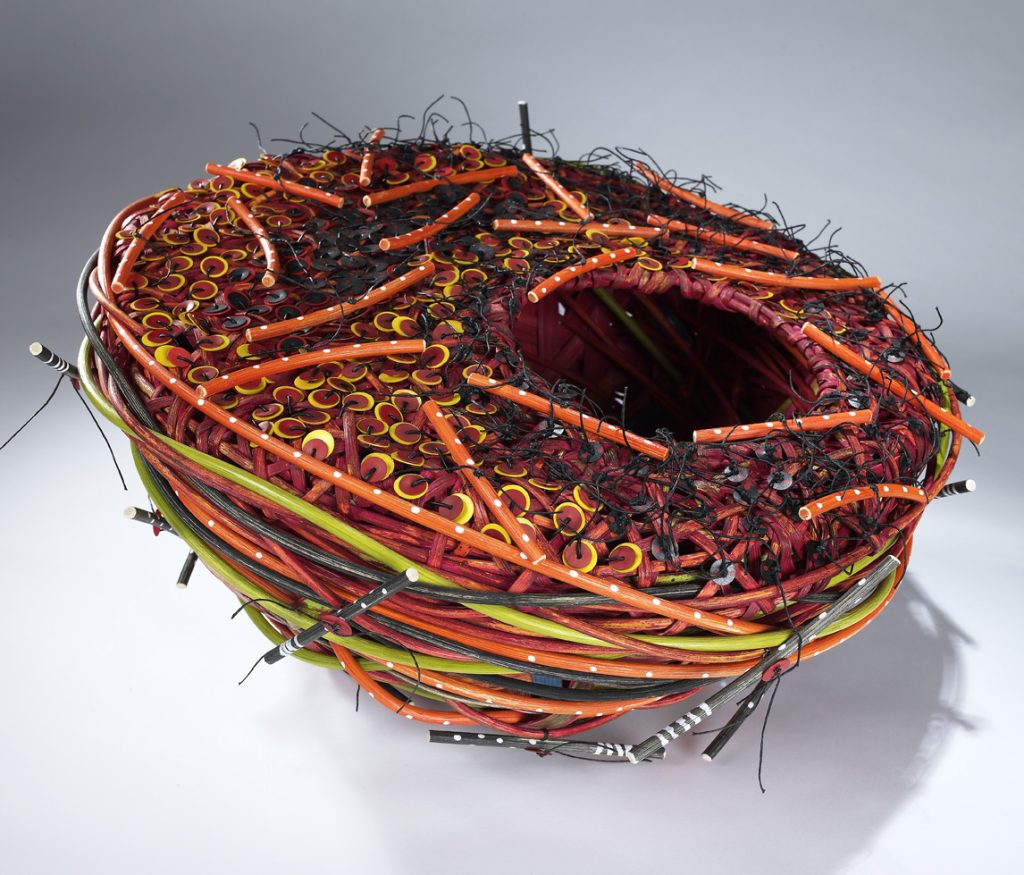
‘Circle Crop’ 1146 x 979 inches
Expand on the importance of layering and the minimum and maximum of layers you use?
I like a lot of levels of movement in my work and I can change in the play of the pattern or layers by switching direction, mixing the methods in techniques, or materials to reach my desired effects. There is always a minimum of 3 layers in each work and it’s been known to be as many as 12, however, 6-9 layers seem to be the norm in my designs with a range in size from something that can sit in the palm of your hand to work that can be 62”or more, free standing or hung on a wall. I love to pull viewers in, the more they look, the more that can be discovered in all the patterns or materials that others might not use or never thought of.
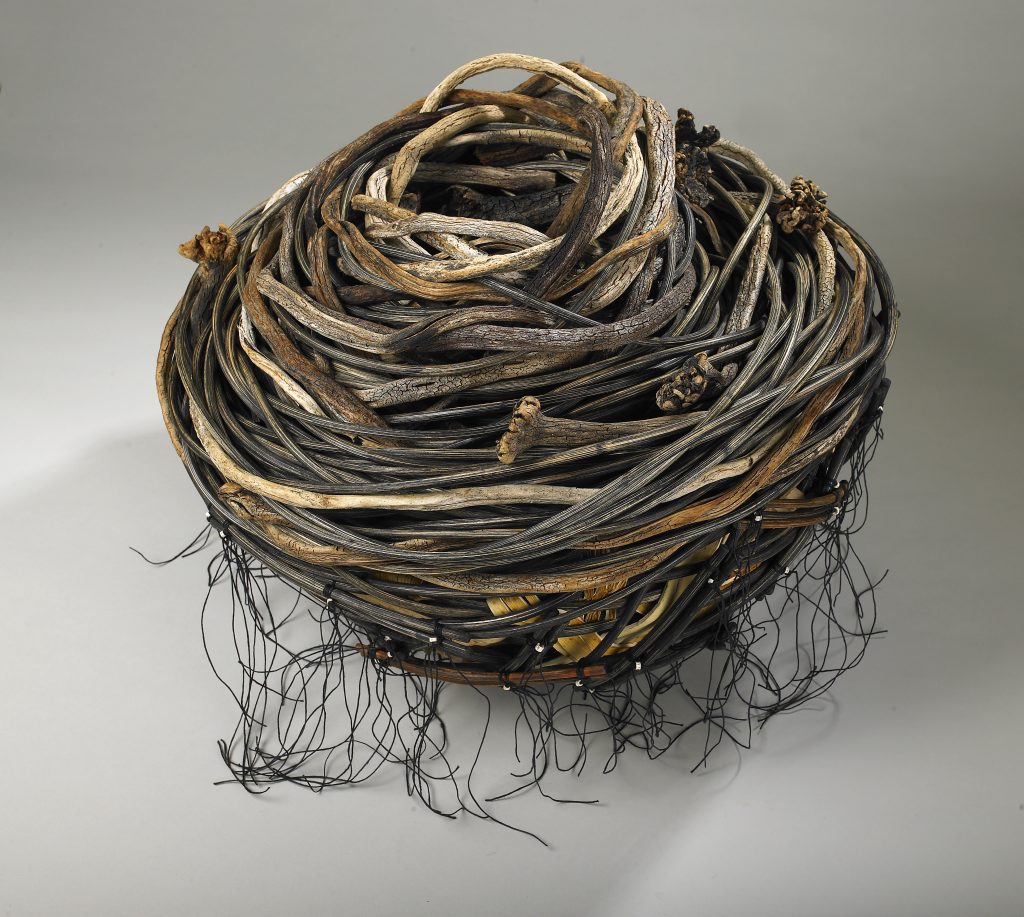
‘Whirlpool’ 4336 x 3882 inches
Take two pieces and discuss…
Crop Circle was my inspired view for the exhibit at Fiber National at The Lancaster Museum of Art in Lancaster, PA USA in which it won an award of excellence. It is still one of my all time favourite works. Crop Circle was my take on global occurrences of land hieroglyphs of unknown origin found in various fields around the planet and I still currently visit this line of thought in my work because I find it very interesting and wonderful. Woven in random layers of various reeds and willows with each layer being handed painted with acrylic paint and embellished with vintage vinyl disk beads and wax linen thread.
‘Crop Circle Series #2 1128 x 757 inches
Drift is in a long line of boat and water stories of where I am from on the South Coast of Oregon, it is currently held in the Permanent Collection of the Encaustic Art Institute in Santa Fe, NM USA. It is a woven boat frame, coved in handmade papers, waxed linen thread, and wax filled with stitched beach stones, random kelp and found beach metal, standing on a drift wood block.
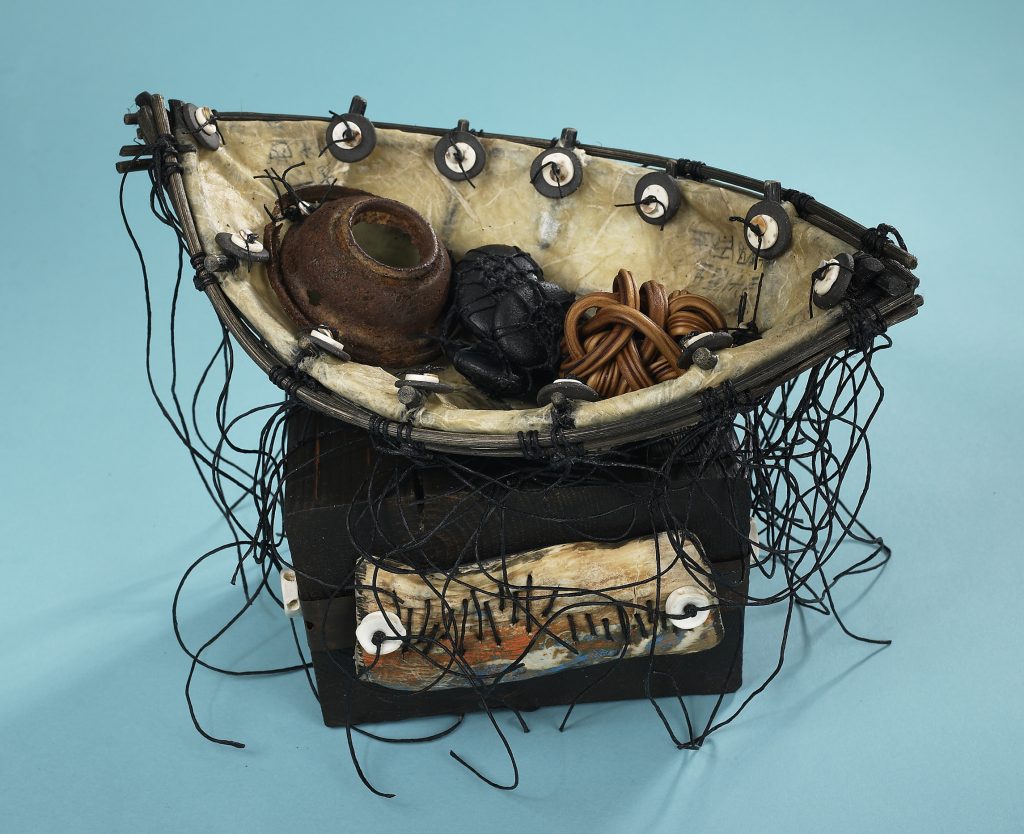
‘Drift’ 2290 x 1865 inches
Discuss the class you do using Pacific Ocean Sea Kelps?
I offer one to five day options on either using kelp I collected for the class, or living with me and going out harvesting coastal kelps of your own, along with other finds in coastal materials, then returning to the work space to focus on exploring how to mix the various combinations of techniques to create forms and vessels. We learn the correct methods of how to clean and store kelp along with addressing what should be kept and what should be returned to nature. Sometimes on multiple day options, finding kelp at one location, or at all, is not always guaranteed since we are working with nature. However, I always have a stash of enough kelp on hand to carry on with the many design options for those days if Kelp is carried away with the tide or limited amounts are found on the beaches.
‘Sailing by Star Charts’ 2535 x 3725 inches
A one day class is focused on cutting and laying out a basic design for a wall or free standing form using stitching, coiling and applique techniques while finishing off with different kinds of coastal grass, roots and a variety of embellishment options from tide pool collections and other kinds of smaller variety kelps.
Your work is in many museums and institutions. Can you take one piece and explain how this purchase propelled your art career?
Solo Exhibit at the Mulvane Museum of Art Topeka , KS USA. I was offered this exhibit by Cindi Morrison director at the time of the Mulvane and the former director of the Lancaster Art Museum who took a liking to my work at Fiber National, and when she moved to take the director job at the Mulvane Art Museum she called me up and offered me the exhibit.
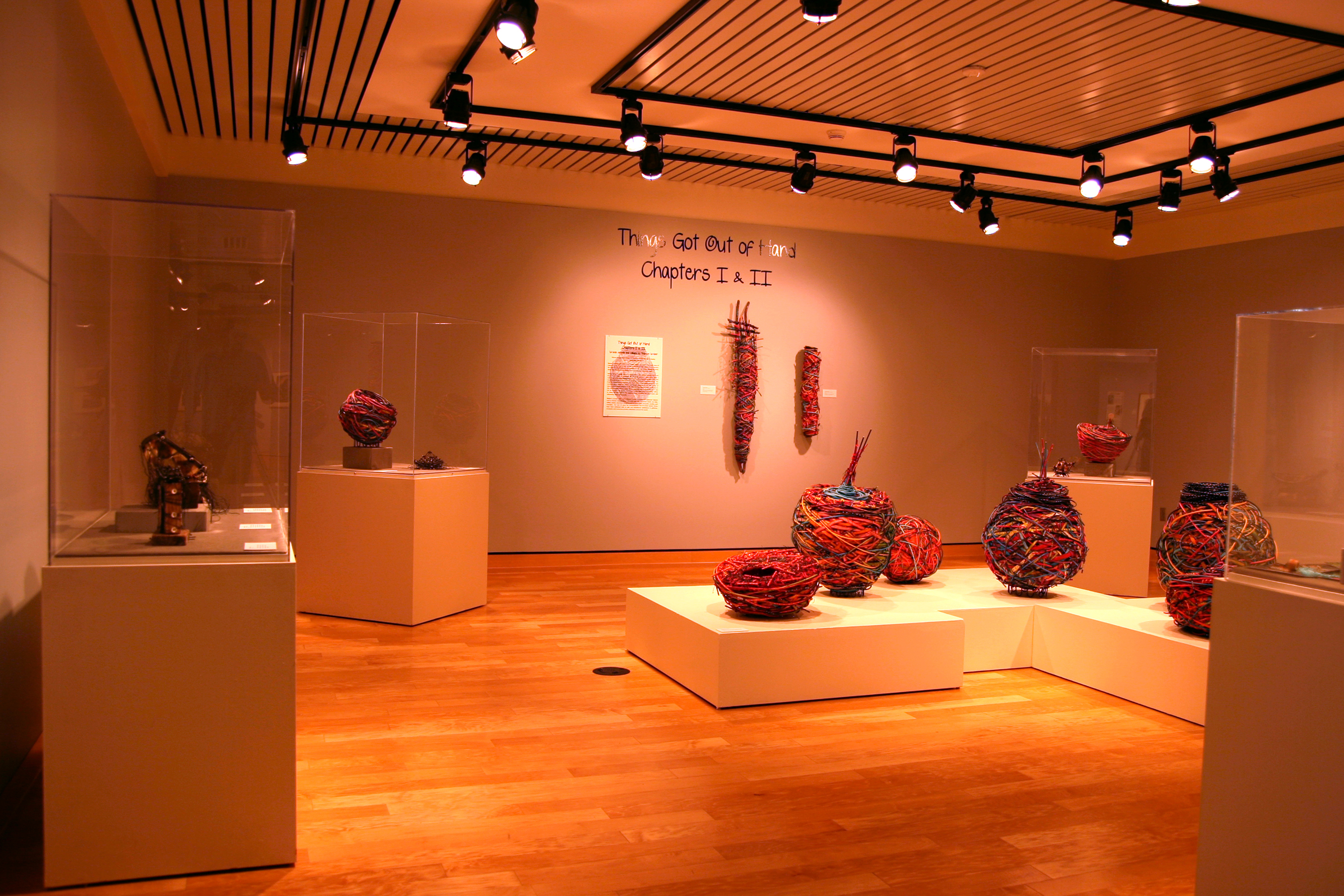
Mulvane Art Museum did in fact buy a work for their permanent collection but it was Cindi Morrison who thought of my work and put me in her loop. My thought and experience on this question is that purchases by museums and institutions is really wonderful, but what propels any working artist, no matter what the medium, is the work. If you’re a working studio artist you keep pushing to make the best “original” art you can come up with. You never consider ripping off others designs. It’s very easy to see the masters of their craft and who is a knock off. Well executed original work is always being sought out. You want to share the happiness of your creations and apply to every noted exhibit in your field of.
Comment on your work and the importance it can give to the understanding of local ecology?
While my work is viewed as contemporary in its current frame in time, I have been able to explore and express my designs by using the very basic of primitive skills in stitching and weaving that have been passed from one human to another for thousands of years. The same basic skills that are still current in value to many cultures even today without any known advantages of comforts or convenience.
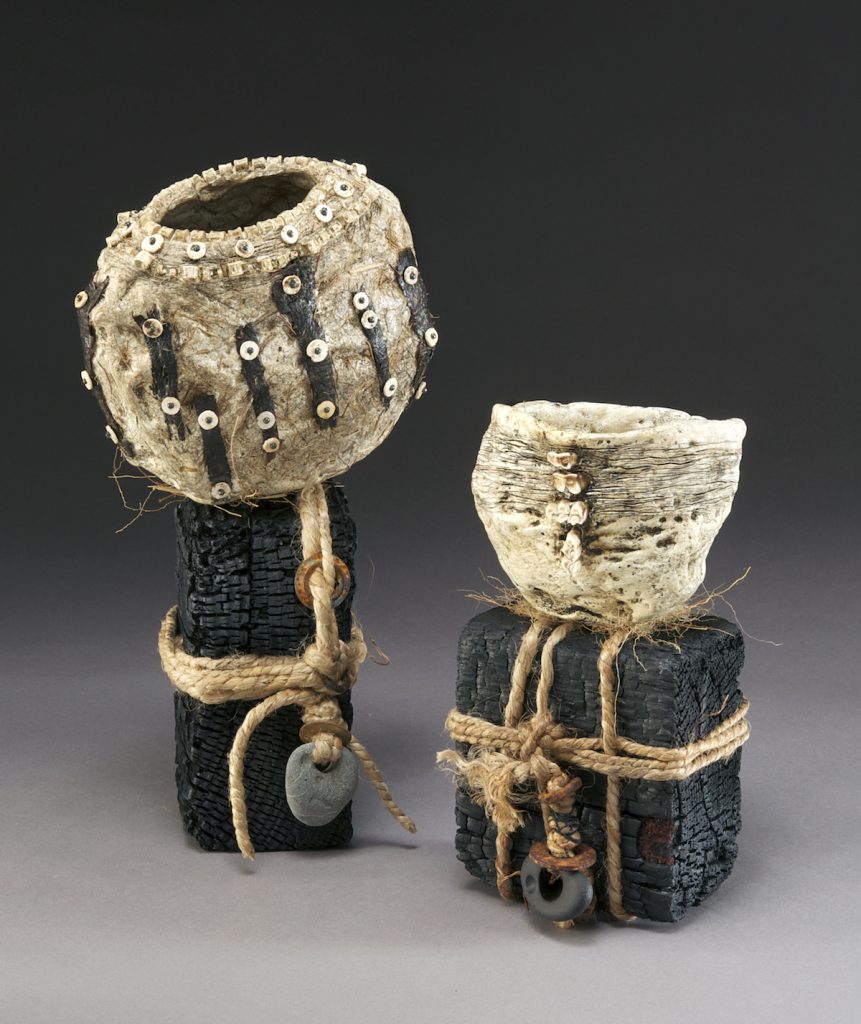
‘Burnt Offerings Series’ 2659 x 3164 inches
With that in mind I work with what is around me by going out and collecting in nature, helping myself to my neighbourhood compost piles of garden debris, salvaging castoff materials from construction sites and all kinds of coastal debris I have a close connection of the environment in which I live and the stories I am translating with the materials I choose to use.
Discuss your work in relationship to the word ‘eclectic’
I seem to own the world on this one since I work mostly outside in all kinds of weather, that’s how I first started working, just me sitting on a stool under a tree somewhere along the river or out sitting in the grass and blackberry vines up on the bank above the beach with the boats in view and the wind blowing all around. I am known to have my car full of odd and interesting collections of rocks, bones and maybe a pile of fresh chewed beaver sticks I just hauled out of the river, or kelp wrapped around my neck and dragging it behind me like some kind of wild circus act. I have, in fact, had people wait by my car in parking lots asking me about “that stuff you have in your car”, and having luckily gotten out of a speeding ticket because the officer was taken aback by the vessels loaded into the back of the car that were off to be set up for an exhibit. He did leave me with a very welcome warning and asked if he and his wife could come up and visit me on the river sometime!
‘Trapped’ 4716 x 2554 inches
Contact details.
http://www.shannonweber.com
Interview by Deborah Blakeley, July 2015
Hannah Longmuir
Expand on the technique you use to bring both delicacy and calm to your images?
At the moment I work almost exclusively in pencil. I find it a very satisfying medium to work in – it is accessible and flexible, and allows you to make both precise and expressive marks. When I work on a drawing, I try to make marks which reflect the feeling I want the drawing to have. I’m drawn to work and places and images that are quiet and calm and subtle, and I try to create a sense of that in my drawings.
Drawing in pencil is a slow practice, and I love to watch the work emerge gradually from the page. Each mark I chose to make builds up the drawing and tells a piece of the story.
From the tiniest field mouse you add character, expand on this aspect of your work?
I would say that I look for and record character, rather than add it. I usually find that my subject – mouse or fence post or sky – is quite beautiful and interesting enough without me adding a lot to it. What I try to do is to draw attention to a thing, especially if it is something that isn’t often paused to be looked at.
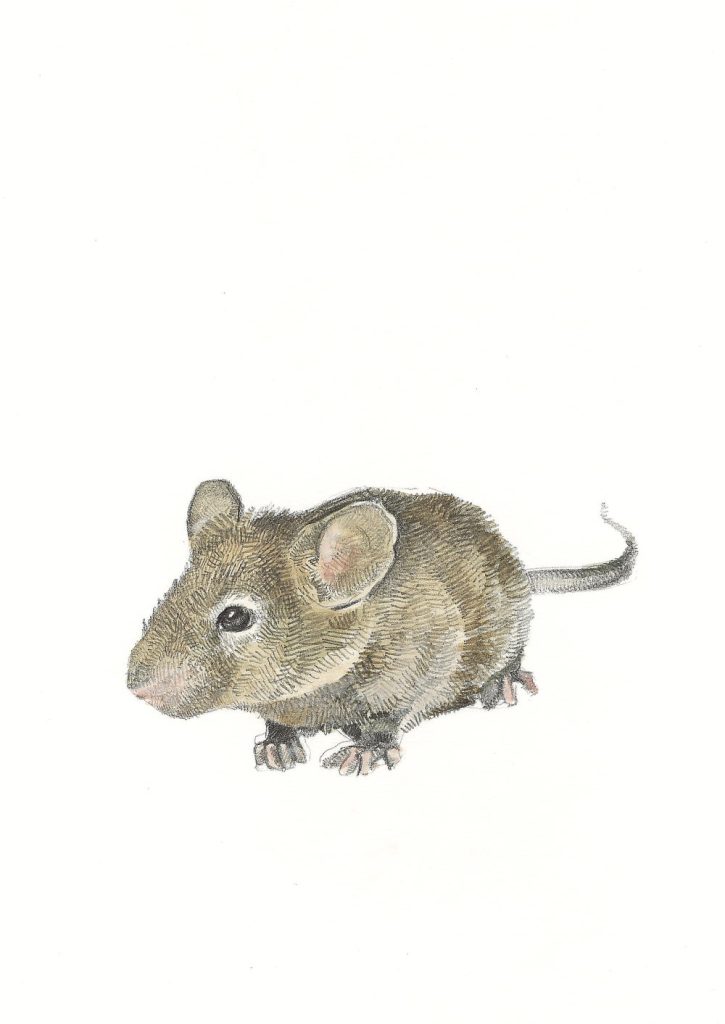
‘Field Mouse’
Discuss your butterflies both 2D and 3D and when and why you chose the dimension?
My little 3D pop up butterflies are my newest project and I am really enjoying working on them. I had been looking for a reason to draw butterflies for a while – because inside I am still a 5 year old girl – but had been reluctant to take the subject on because they have been very well recorded in art! I returned to the idea, though, because I wanted to make little 3D butterflies in the style of collector’s samples in box frames.
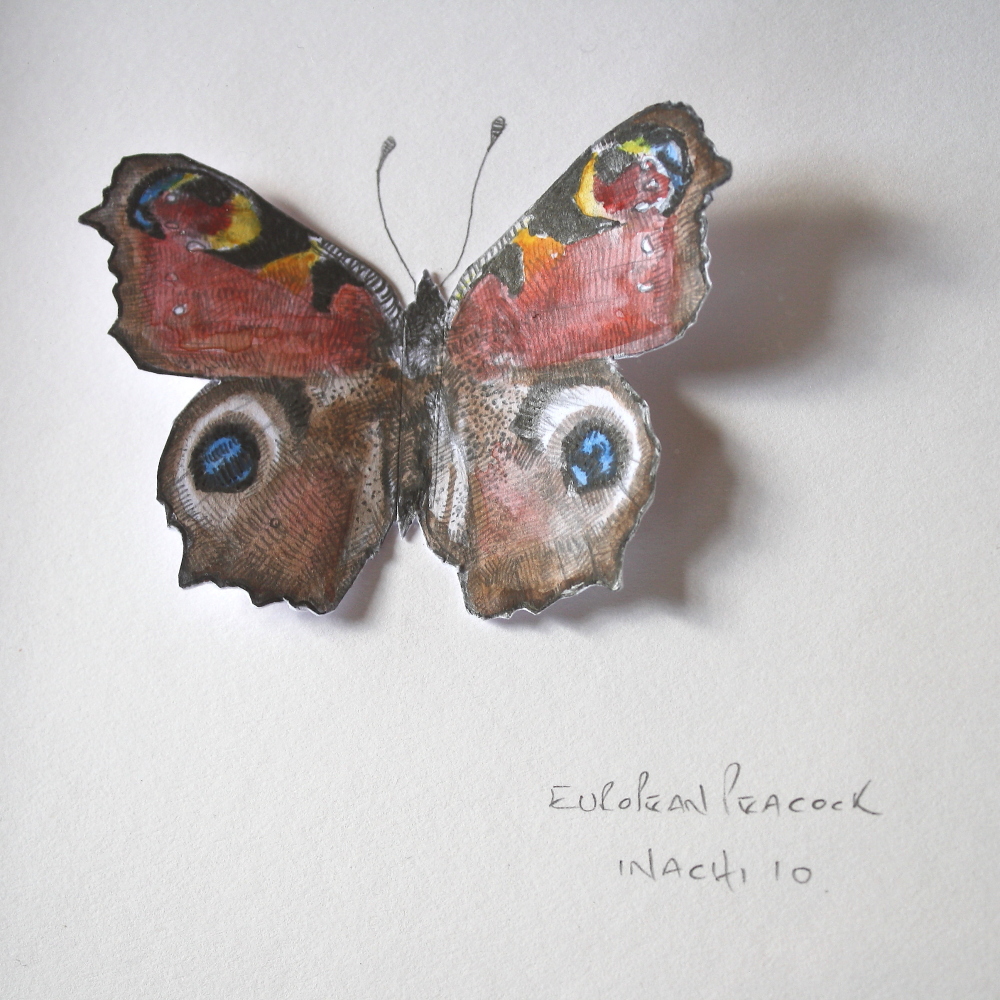
‘European Peacock’
Drawing something is the best way to learn about it. I drew the wing spans of the butterflies the size they would be in reality, so my pencil had to make tiny marks to represent the wonders of the butterfly’s wing.
Discuss your own card collection and how it helps you with your art work?
I’ve always loved stationery and letter writing – everything paper: cards, notebooks, envelopes, stickers… - and I really enjoying developing my drawings into paper goods which I then sell online, through shops, and at markets. It’s a two-way street, sometimes I draw specifically for a product, other times a drawing just works well when it is transferred onto a card or a sheet of writing paper. Printing the products, packaging them and marketing them satisfies a different part of my brain. I like the variety it brings my working week.
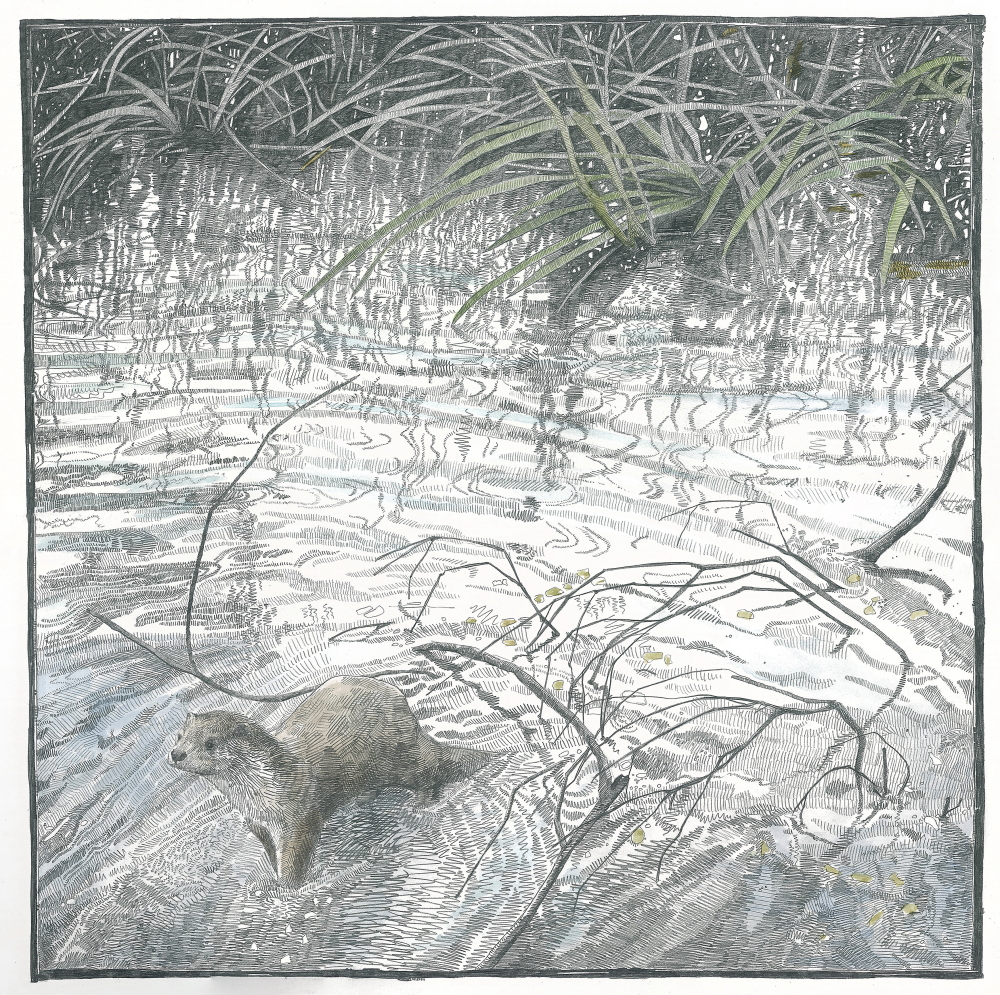
‘Texture in the Water’
Less is so important in your work expand on this?
Less is so important! I like to keep things simple – I only use three basic materials – paper, pencil and watercolours. I like simple, honest images. A few marks can describe a lot: light and darkness, planes of form, texture. By varying the qualities of the lines that I make – the length of the lines, their closeness to each other, the quantity, the spacing, whether they cross over each other and if so at which angle, the direction of the lines, whether the lines are rigid or flowing – I can describe something in detail.
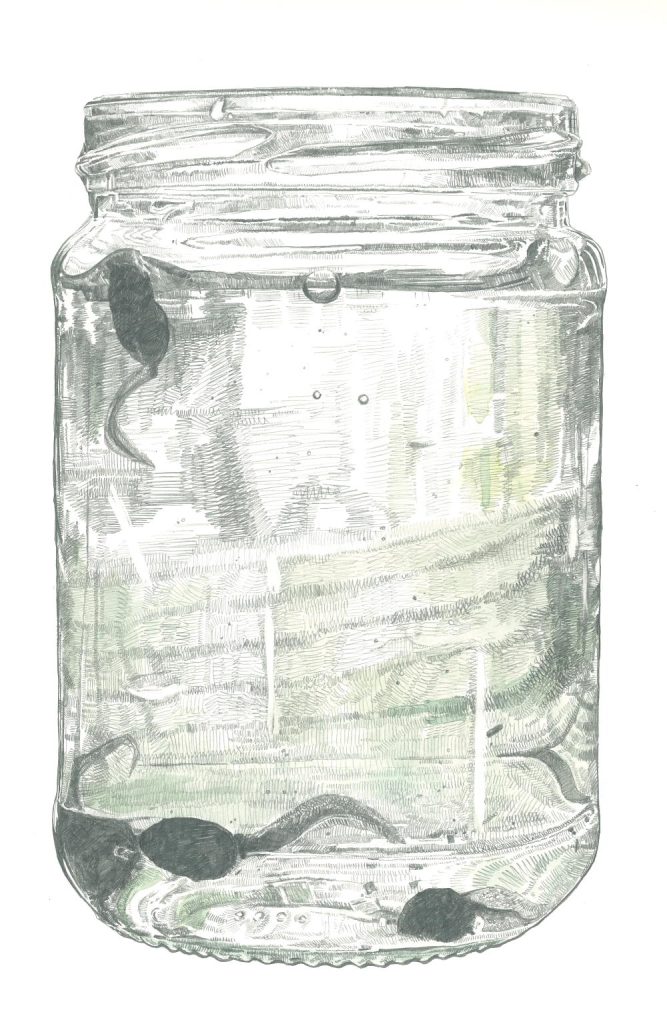
‘Tadpoles in a Jar’
In 2015 you produced a calendar with this be an annual project?
Yes. I’m currently designing my 2016 model, and this will be the third year I’ve made a calendar. They have been really popular.
Each month reflects the wildlife which is active in that month – the arrival of the swallows in April, the prolific goldfinch in May, vivid autumnal colours on the sycamore leaf in November. I use hand-stencilled lettering for the month titles, and handwritten dates, to give the calendars quite a personal feel.
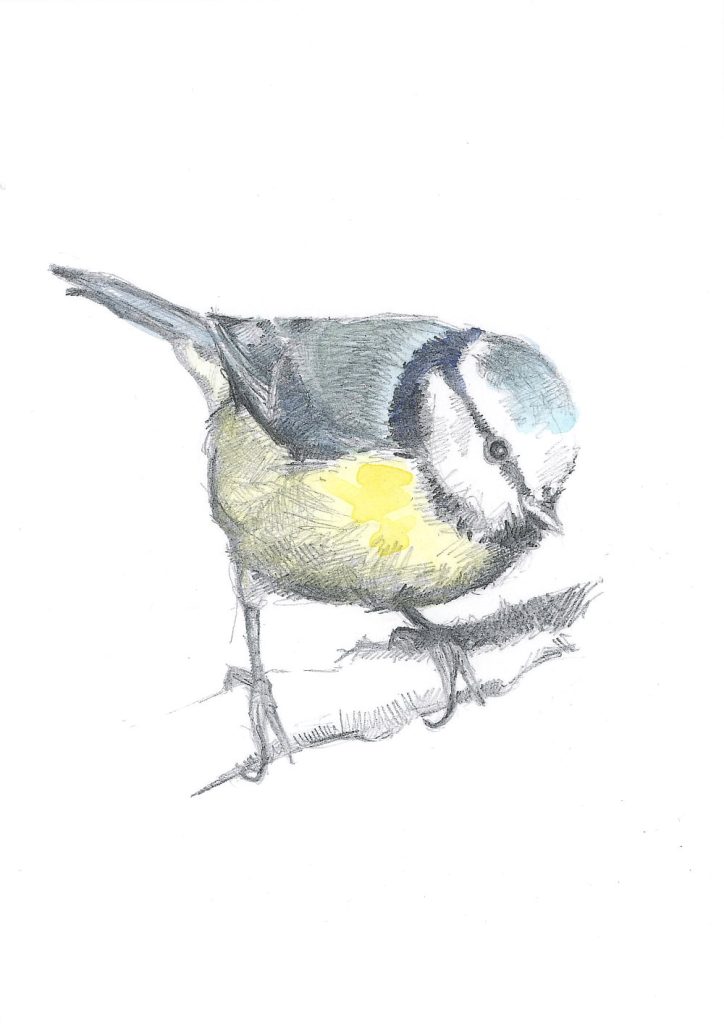
‘Bluetit’
In you wildlife work you make a point of ‘capturing the moment’ discuss?
I try to use marks which will tell of the vitality of the animal or bird, its quickness or gentleness. For example, my Roe Deer. She is gentle, but alert, muscles tense and ready to move at any moment, listening and watching. Her eyes are bright. This tells a little of the feeling you get when you disturb a deer when you are out walking. Before you’ve even spotted her she is bounding across the field, agile over fences, white rump bobbing away. It’s that moment; that encounter, which I try to describe just a little.
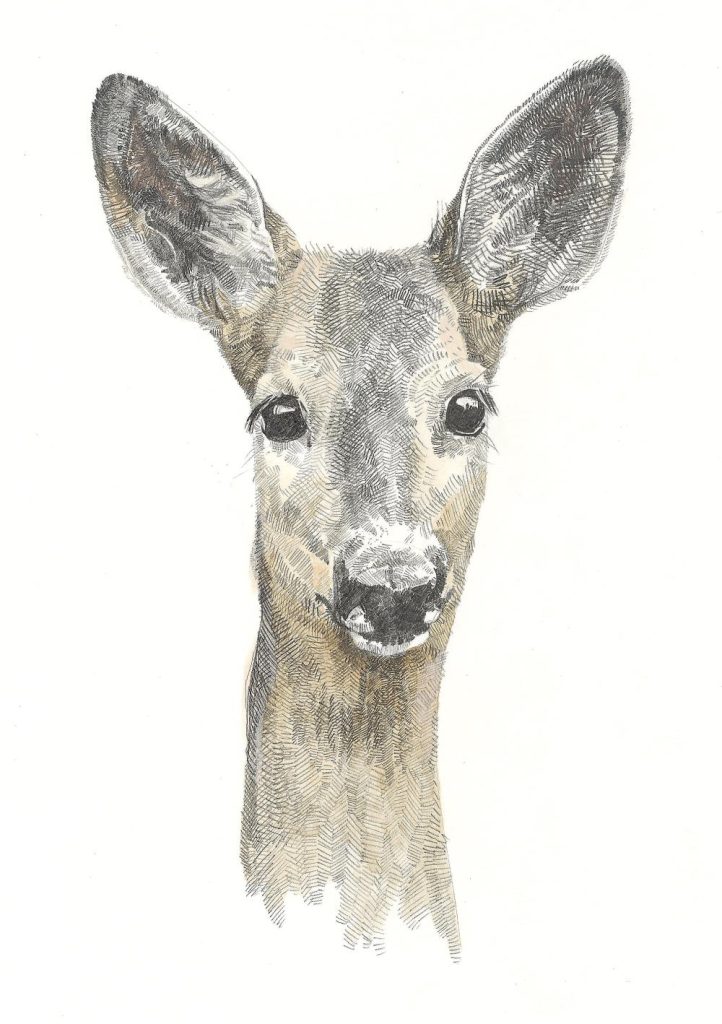
‘Roe Deer’
On the flipside, your work with trees you have ‘captured the elements’ discuss?
It’s the ancientness and the stillness of woodland and of trees that fascinate me. One of my most recent pieces is ‘Ancient Wood III’ which depicts a beech tree under a dense canopy, with dappled light breaking through. The tree is still, almost timeless, but under its leaves and on the forest floor are thriving, vital ecosystems.

‘Ancient Wood III’
Your work from a very unusual place a small log cabin. Can you tell us about it?
I love my cabin! It’s in the garden of my cottage, and it was built for me by my very clever boyfriend. It is just little, but it allows me a separate space to work in, which has been transformative! The starlings sound as heavy as elephants when they run across the ceiling. My dog, Buddy Bear, sleeps on the rug while I work.
How important is place to you as an artist?
Place is incredibly important to me. I find most of my inspiration while on dog walks around the lanes, hedgerows, fields and woodlands near the village.
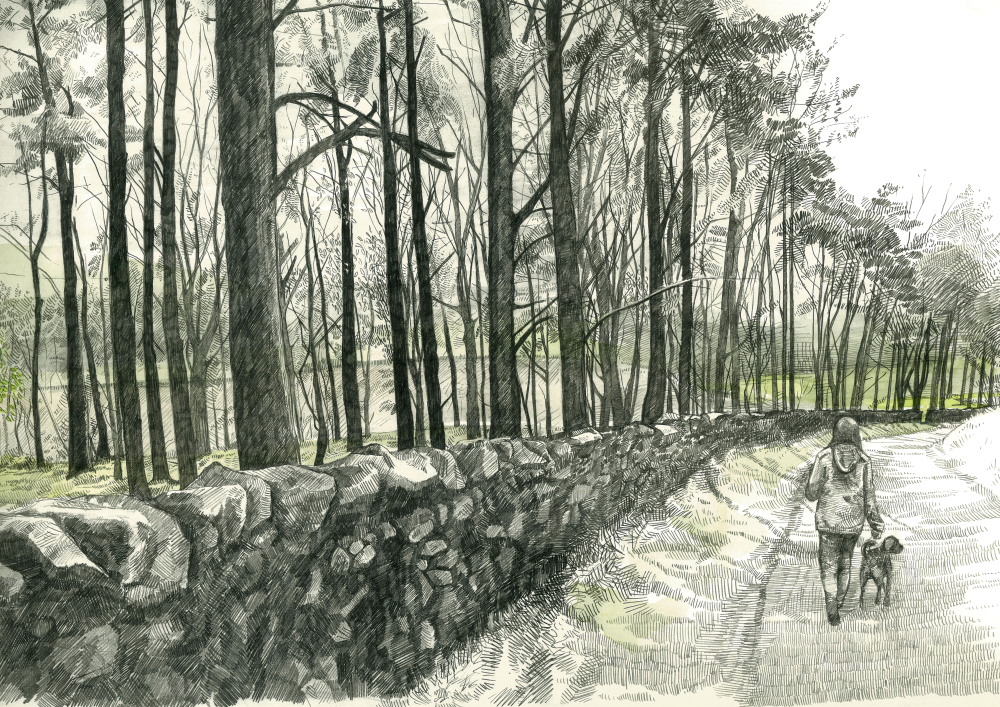
‘The Hownam Road’
I’ve been exploring this countryside since I was a little girl, bringing feathers and toads and pebbles home to draw.
Do you always carry a sketch book?
Yes I do, and I take a lot of photographs as well. I’m always adding to my library of images and sketches so that they are there when I need reference material.
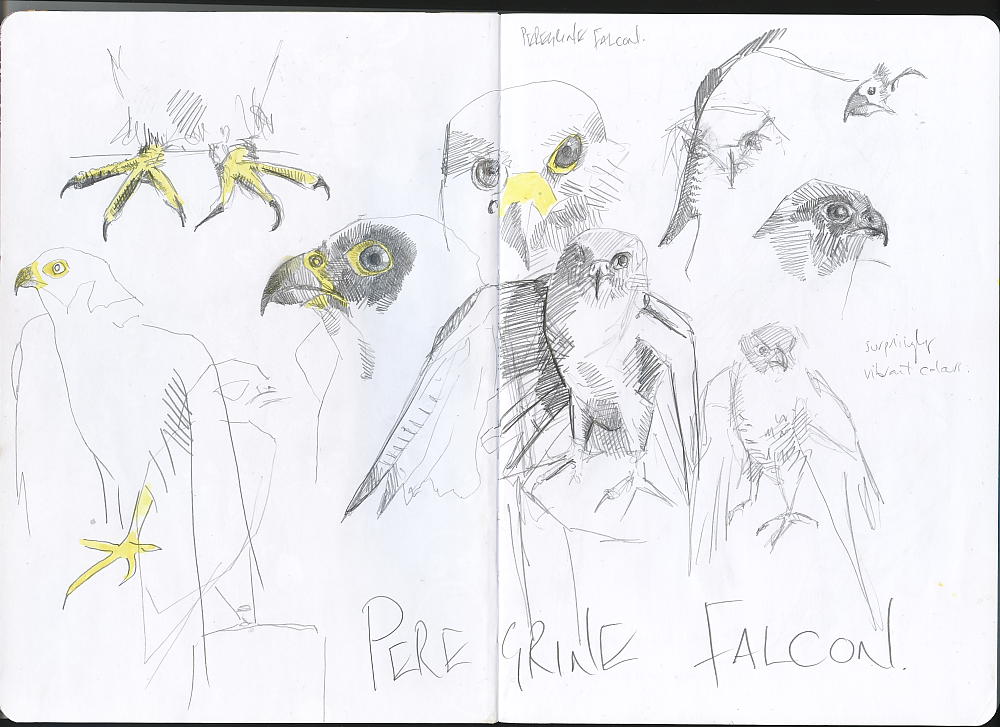
Sketchbook – Peregine Falcon
One of my New Year’s Resolutions for this year was to draw in my sketchbook more regularly as I do believe it is a good discipline to have. It is going quite well but there is room for improvement!
Contact details.
hannah_longmuir@hotmail.com
www.hannahlongmuir-artist.co.uk
Hannah Longmuir, Scottish Borders
Interview by Deborah Blakeley, June 2015
Christine Atkins
You work in three mediums, textiles, sculpture and jewellery can you discuss the integration you have between them?
Early in my career there was very little integration between the mediums, but with the techniques between one form with be adapted to use with a different mediums. For example stitch and cold jewellery connections are used in my found objects work to join components.
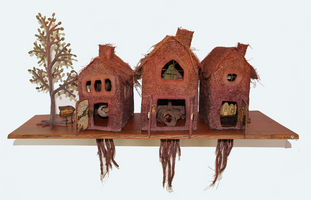
Discuss the techniques you use in your textile work?
My textile works are predominately made by thread on a dissolvable fabric which is stitch on using a domestic sewing machine then removed leaving only the thread. In some pieces I add dried grasses in to the “thread fabric” which can be seen on my ‘Shelf Life’ works.
Discuss the importance of found objects in your work?
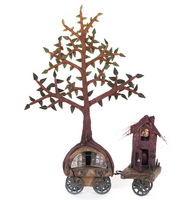
I have always been a gatherer and collector since childhood, so working with found objects fills this part of myself. However besides the thrill of the hunt there is a deeper intention for the use of these objects. Found objects while treasures to some of us to the majority they are throw away rubbish. We take so much for granted in our everyday lives that we don’t take or even have the time to stop and notice the things that we use each day. They can be considered boring, common thus have no beauty rather, only a practical application. I use a lot of natural objects in my work to also draw attention to the natural environment, to encourage people to slow down or stop and take a moment to explore a single leaf, with wonder rather than just seeing the whole tree. In many instances is also “unseen” as we walk past that tree everyday on the way to work. Found objects always bring with them a history, a story, where it has already been, who used it, what did it see.
Can you expand on your Series, ‘Stories on Wheels’?
The inspiration
New experience, internal or external are important to me which is seen in my series, “Convoy”. Inspiration for this work came from both my internal processes and observations of my external world. I am drawn to bird’s nest and houses so the continually appear in my work, as do trees and boats. These works represent, movement, adventure and the search for new experiences.
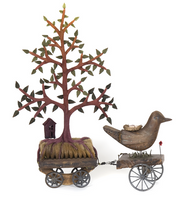
Materials you have used
A variety of materials and techniques are used in these works. The brush and the hollow under the tree is half an old wooden bowl, with more found objects tucked away inside each house. The odd brush reminded me of wheat field paddocks, most of the time the objects hint to me how they do or don’t want to be used.
Use of techniques and Use of found objects…
The bird is hand carved and I have used a wood burning tool to add the details. The bases on the series come from a scrap pile in an old heritage sawmill. If not collected for fire wood the pile of Western Australian hardwoods is burnt, due to being a fire hazards in summer. The textile components are constructed on soluble fabric which is rinsed away leaving only stitching. This fabric is then stitched around wire armatures to create 3D pieces. The two houses have grass sewn into the thread fabric as well.
Your jewellery is based in white and gold bronze why do you use this material?
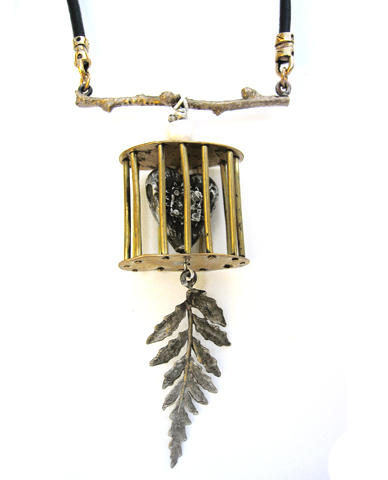
I use bronze in my jewellery pieces. Many of my pieces are heavy, making them in either silver or gold would place them out of reach of many people. There is more freedom to experiment in bronze rather that precious metals. The second reason is more personal; I like the connection of my jewellery to history. I am drawn to both antique and bronze jewellery and objects. The detail and perfection always leaves me with a sence of awe. These pieces were created without the tools or machinery we have today. They are so beautiful and well made. By using the same materials I feel a connections, and honouring of these past artisans.
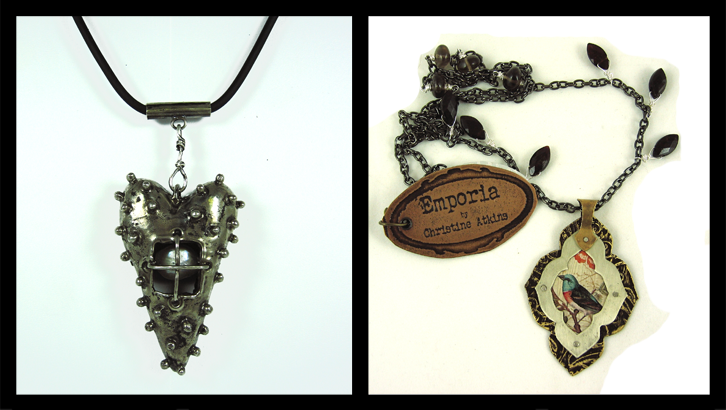
You have taught at New Norcia, in Western Australia your class called ‘Requilaries and Shrines’ explain how suitable this venue was to the content this work?
New Norcia was an interesting venue with a rich and varied history. It went through several uses and is now preserved sharing its history. The contents was found objects, they had either a known or unknown history. Working in such a historic venue may have helped the participants to have a connections to their objects, and appreciation of their history or prior use. The space already drew people into a place of contemplation opening up a sence of inquiry or intrigue.
Discuss your collection of vintage components.

Where you have collected them from?
My object collection is very eclectic ranging from leaves to found rusty metal. My natural objects are mainly small rusty pieces of metal found during my morning walks or in car parks. Other pieces such as brushes and wooden spoons are found in Op Shops, Sunday markets or gifts from friends.
How you store them?
I have not found an ideal storage solution for them all yet and they tend to spread throughout each room and across the garden to the shed, stored in plastic boxes vaguely grouped into similar items.
How do you record what you have?
I do not keep a record of what I have as it would take too much time to be worthwhile. Many of the pieces are small, such as 3dd golf tees, 2dd thimbles, and a fork!
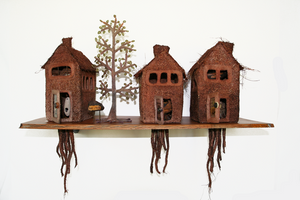
Can you discuss your work ‘Assemblage’?
My “Assemblage” wall pieces are a way for me to highlight small components by weaving a story or narrative through each piece. Attention is given to each component rather than the whole. The pieces, constructed or found can be thought of as talismans, symbolic images to half hid the meaning behind the work, thus no completely exposing the inner world of the creator.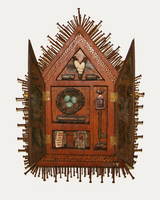
How did you acquire the necessary woodwork skills?
I am self-taught in many of the processes I use including wood carving.
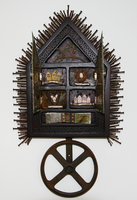
Trial and error is how I developed my skills and google. Google has opened up so many possibilities for different techniques. That I have needed. I am sure there is most likely easier and other ways to achieve what I do, however I am yet to find a local to teach me these skills.
Can you explain the Waterhouse Natural History Prize and how it has effected your current work?
The Waterhouse Natural History Prize is an annual event run by the South Australian Museum. Works submitted are on a natural history theme. The prize includes categories, painting, works on paper, sculpture and a youth section. I was honoured to be awarded 1st place in the sculpture category in 2009 this provided my with a sence of it all being worthwhile. Validation that my work was ok, it had reached a professional standard. I began to feel more confident in my works and myself as an artist. I felt encouraged to expand on the techniques used in the winning piece as this way of working was still very new to me.
Your former education was in Psychology and Art Therapy discuss your thoughts of the importance of Art to the wellbeing of and healing process?
Arts and creativity have long been associated with the power of healing. Traditional societies have used art to heal people and influence the world around them. Music and dance were central to daily rituals and used to influence hunting, fertility and cropping. Art and music were also used by healers to connect to inner healing spirits and an important souce for traditional medicine.
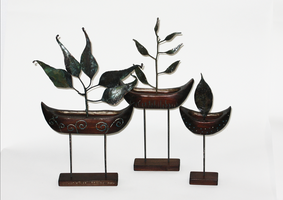
Modern medicine calls for treatments that are scientifically proven, while art and healing found it place in the field of psychology and psychiatry. Art Theory is a form of psychotherapy that uses images to explore and express emotions, thoughts, memories and ideas. It is a well-established treatment to address and heal psychological problems and promote wellbeing.
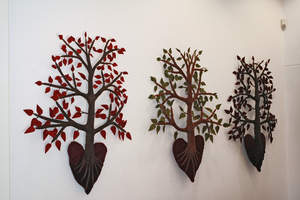
Contact details.
Christine Atkins, WA, Australia
Interview by Deborah Blakeley, June 2015
Jonathan Whitfill
Media
Expand on the inspiration of the work?
Almost all of the work that I make comes from language based concepts of individual units combining to make larger groupings that give some overall meaning. The completed visual piece then echoes either a formal element or a conceptual meaning with regards to its individual components.
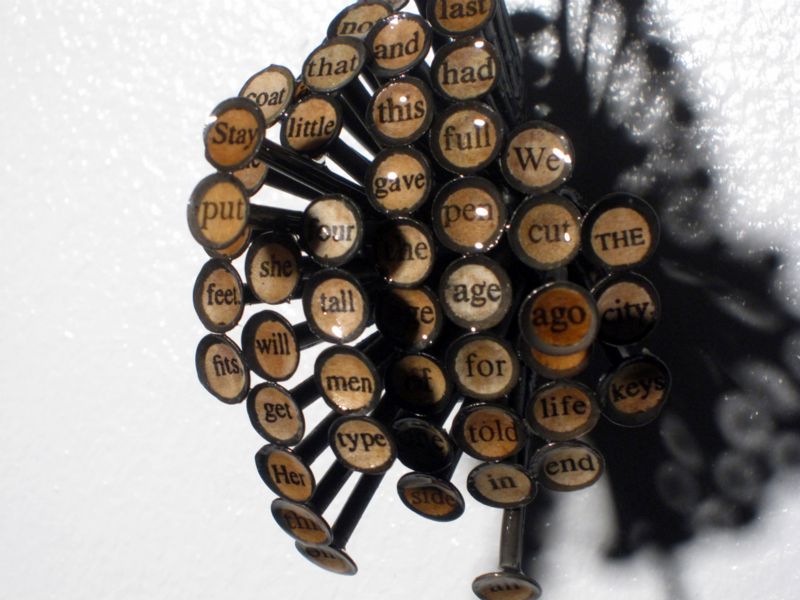
Can you discuss the size of this work?
The pieces that are from this body of work are typically intimate in scale. This is mostly due to the media limitations, however I have made some of these pieces with as many as 1150 individual pieces welded together.
When I sit down to make this type of work I am usually drawn to constructing smaller groupings. This is in some part due to the conceptual framework that supports my studio practice. Individual units brought together into sets of 5-8, then those rows are brought together in groups of 4-5, etc. It’s like speaking a language.
Am I meant to be able to read a message within the groupings?
When I first started making these pieces, the text was random on purpose. Many years before, I preformed a work where I numbered around 3000 words as they came randomly out of a satchel. I then went back and complied a list showing what order the words were removed - essentially, reading what had been said by the random draw. I was astonished to find segments of words that still gave meaning to a reader. I have later come to realize that this is what human beings have a tendency to do without provocation. We want to make sense of randomness, or maybe even this is an innate need leftover from some involuntary survival trait within our evolutionary development - either way, we try to make sense of random words.
Since the conception of these pieces I have changed my process regarding readability. This is in large part due to my brother, Patrick Whitfill, a poet. I had the opportunity to have a residency in which he was able to stay with me for a couple of weeks, and during that time we collaborated on a few of these pieces. Now I try to emulate some of the tricks of working with a limited resource of prose, and still exact meaning - things my brother taught me.
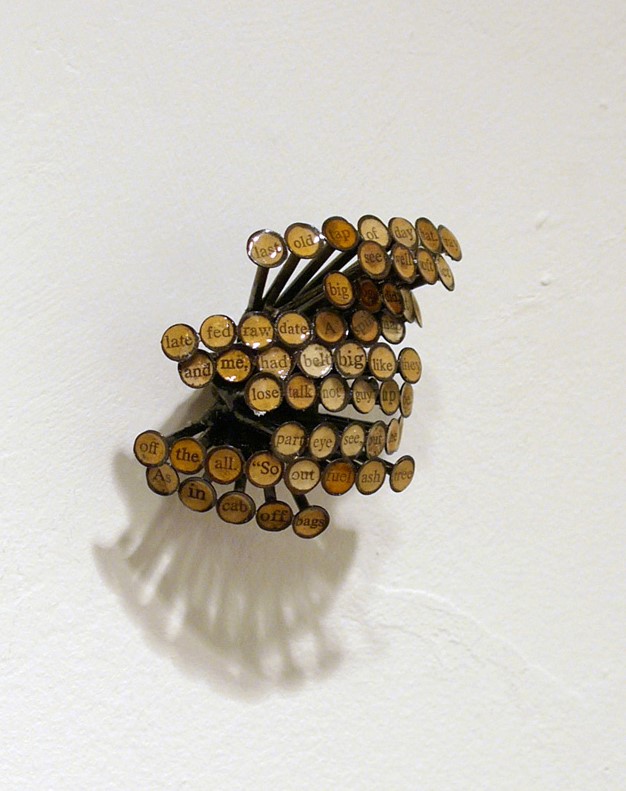
Will you reveal where the type comes from?
It is a common misconception that these pieces originate from old type, or typewriter keys. They are actually nails. I set up and weld individual nails into small rows, then weld the rows together to make the form I desire. After I have welded the nails together I take many different pages from discarded books and using a hole punch, I remove small words that fit inside the punch diameter. After I have removed enough words for a piece, they are arranged and glued upon each of the nail heads. The last step in the process is giving the entire piece a few coats of clear plastic resin to seal the piece from oxidation. So, yes - I get the media to make these pieces from the local hardware store.
Within each group are there the same number of nails?
No, the number of nails varies with the piece, and the formal decisions that I make while I’m welding.
Is the pattern mathematical?
Ideas of efficiency and Geometry always are present in the process, and are revealed through the final object. Sometimes the pattern I’m using as a model is very mathematical, but most times I let the forms that are being produced influence my formal decisions. On occasion, I like to make rules for my production that I think I should follow, it makes my process feel controlled and usually that methodical action becomes a kind-of studio meditation.
Shredder
Discuss the inspiration behind this series?
I have destroyed the original purpose of more books than anyone I have ever met. I have not read every book that I have brought to this altered state. Many of the items I have destroyed were well made, beautifully crafted functional objects of knowledge and potential enjoyment. Constructed from discarded encyclopedias, dictionaries, and paper-back novels these formal found object sculptures pay homage to a rapidly diminishing delivery item of knowledge while stimulating concepts of longevity and beauty albeit in an altered state. Yet doing what I do comes with some guilt.
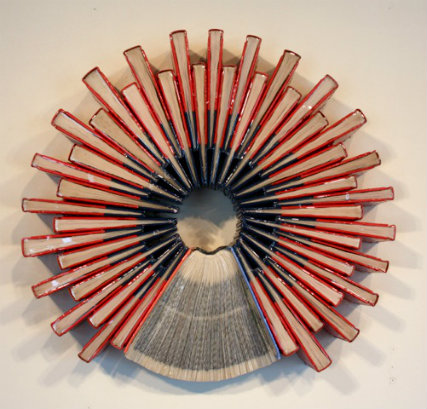
I use rationalization to continue working and lighten the weight I have placed on my shoulders. A series of small rational thoughts about preservation, homage, and ensuring the aesthetic value of the book for future generations usually births the force needed to rip through another page. The thought that publishers, printers, and authors are using digital media avenues with increasing fervor concerns me, but assuaging my conscience is the knowledge that the plastic based resin seeping into these old tomes is a fitting tomb, a glass casket if you will. Seeing boxes of books left on my front porch by un-named donors gives the feeling that when books are to die, they can go to a different place with a new more permanent form. Knowing that Libraries are gifting me their old treasures, saving them from a warehouse waiting to be burned, helps guide me through the process of taking away the most important aspect of these books, readability. Only leaving the glistened husks and the surface appearance is regrettable, but even a facade is sometimes better than nothing…
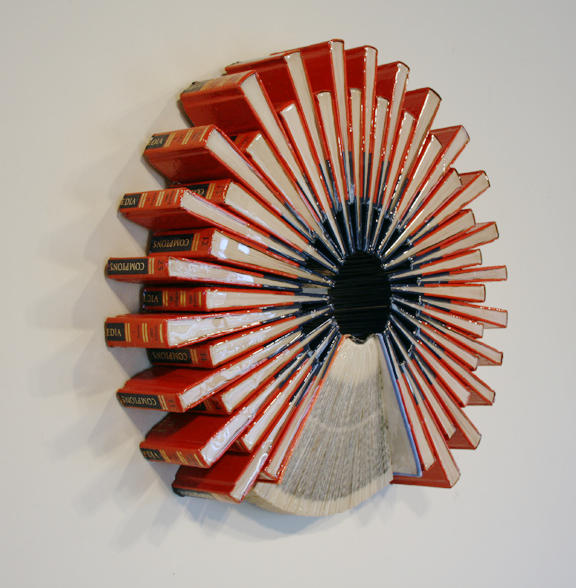
Discuss the importance of the circle in your work?
The book wheel series are an investigation of the circular nature of a typically rectilinear form. Recently I have found that my process can become refined to a point that I waste very little, if any, of the remnants from the media that is produced when I construct these pieces. All the extra detritus is utilized to make more pieces from the initial book form. Making a wedge form in order to make more circular objects can be done many different ways. I typically employ tearing or cutting out pages in sequential decreasing thickness until I reach the middle of the book, and then flip the book over and repeat. Another method to make a wedge shape is the repeated folding of each page until the desired shape is acquired. The most important development of process in the last two years in my estimation, is using the angles removed from one project to come back together into a new circular form. This increased efficiency of materials and some applied geometry has made my valuable studio time more productive - increasing quality along with quantity.
The simple and perfect form of a circle, what an elemental delight.
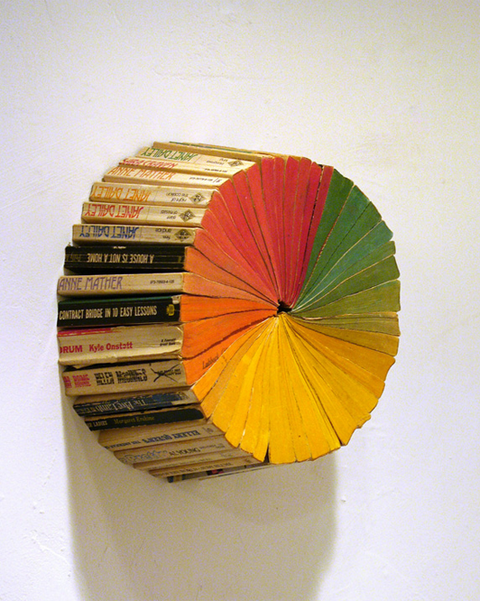
I find that I collect all manner of lids, pipe, and anything else that can be cut to a circle or possibly be manipulated into a circle. My most recent sculptural forms are spheres that are constructed from circles. I have made a few with bottle caps and cut pipe. The importance of the circle in my work is increasingly paramount - however, I can only say that I’m innately drawn to the form, I don’t really know why.
Edges play a large part in this series expand on this?
Some of the best pieces in this series have a tessellated edge, either random or rigidly planned as in the work - USA Yesterday. During the process of making a book-wheel, I enjoy the clean edge, and it even gives me an opportunity to write a small word with the letters identified on the spine. It all really depends on the books being used, and ultimately how they behave - and in doing so, call into being their own design.
Participation
Can you explain in relation to ‘A Turtle Live a Long Time’
The meaning of the title - The idea behind this piece comes from the title. This is one of the rare occasions that I saw this wonderful title while working, and a feeling of the pace of time slipping forward coinciding with the removal of these pages became this title. The topography of text, image, and color being created from the steady habitual erosion of the book is the opposite of continuous growth, tree rings, tortoise shells - it just works.
The technique - Obvious, upon inspection.
Materials used - This is one set of discarded Encyclopedias.
Size - The dimensions are variable. This piece has been hung to fit many different spaces, both vertically and horizontal.
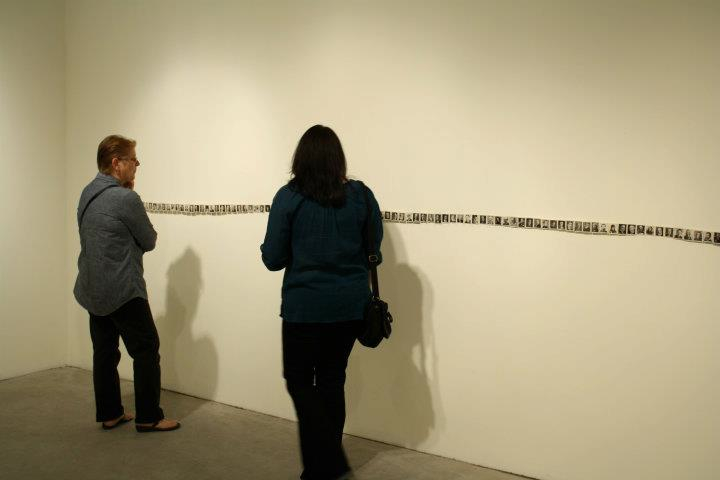
The small portraits can you expand on…
Who they are? - These are almost all of the small portraits from the 1963 World Book Encyclopedia. This was a piece for a Culture Laboratory exhibition named Land Portrait. I took the theme quite literally and made a horizon line from portraits.
Why you have chosen them? - I just couldn’t keep from cutting them out. All of these portraits were in the pages that were removed from my first book-wheel sculpture, SLICE. I wanted to use any media, and waste nothing. The buffalo hunter of the modern book - no waste, use everything, praise the gods for the offer.
What is written on the bottom of each image? - The text at the bottom of each image is the photo-credit.
Discuss your involvement in the ‘Button Project’
The Button Project was an offshoot of having good friends and available media together in the studio during the evening, and my mostly random decision to purchase a button maker. Chad Plunket, Matt Weaver, and I begun by gathering two types of media, encyclopedias and magazines. Being seemingly opposites, the abrupt combination in a brief, yet repeated gesture of these materials has been constantly amusing to us as they come together. Whole pictures are chopped, spliced, and mounted into new compositions forcing the viewer to consider the imagery and iconography in different ways. These new images were then turned into buttons that can be advertised by anyone. By limiting the presentation to three inch buttons, the combinations come into greater focus and can be spread to a large audience, although not quite as large as in their initial debut.
Over the years we have created around 800 original and unique 3” collages mounted to wearable pin-backed button. We have also made a few larger and more ambitious collages as a collaborative team. Honestly, we need to get together more often this summer to finish a work we have been discussing for a while now.
http://thebuttonprojectblog.blogspot.com

Can you explain the importance of mixed media in both your work and your teaching?
I have an affinity towards using re-purposed, or found objects in my work. It seems that since the very infancy of my creative manifestations, I have leaned towards using objects of mass consumption. My first pieces, the ones that lead me to questioning attendance at an Art school, were made from twisty ties at the Grocery store behind my Lab. Since those objects, and my decision to learn techniques and theory supporting Fine Art creation, I have utilized various media including: nails, steel pipe, bottle caps, brass lamps, trophies, automobile wheels, PVC, casted type, and obviously books. The best studio days are ones in which small pieces collected over the years, some manipulated, some just the way they were found, speak to each other as I look for connections, then BAM - they go together. Solving the problem of how they fit is my greatest joy.
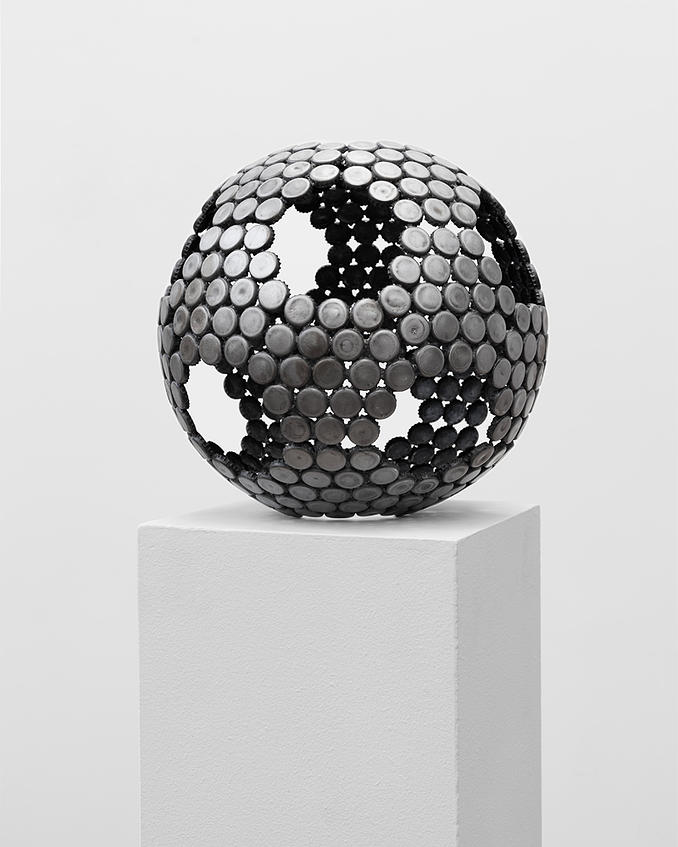
Image by Brett Herron
There is less crossover of using found objects in my teaching, but there is some. When I am organizing laboratory experiments in Physics I at times bring in many seemingly disparate items to challenge my students to solve problems concerning simple machines, or in creating Rube Goldberg devices - a fantastic lab for Physics students studying mechanics.
Expand on the importance of connecting science and art?
I am a very process-oriented artist. My artwork comes from a particular practice that I have refined in the studio over the years, and my ideas have been developing even longer from my personal observations. So in that regard, my artistic practice is much like the scientific method. Each experiment has specific variables that are changed while others are controlled. As the world changes, so do the observations and the experimental process. This leads to a new type of work or product.
I have been observant of the world around me, made educated guesses as to what type of work I want to create, and then I experiment.
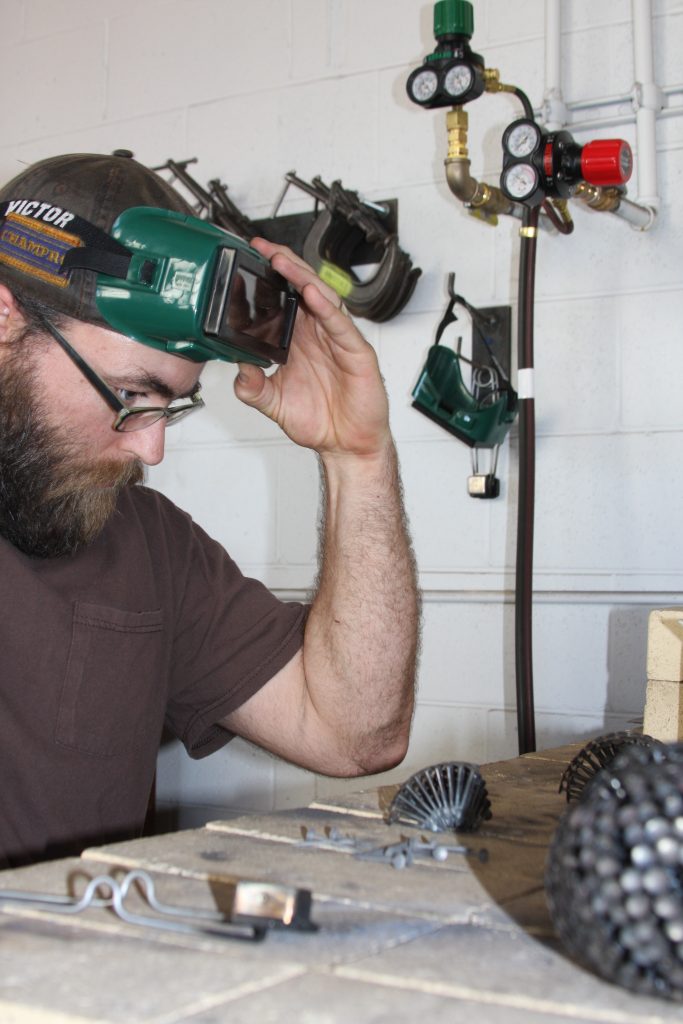
On the other side, Eureka moments usually don’t come from rote analysis or repetition. Nor, does it come from lackadaisical or random leaps of logic. What spurs on intuitive advances in Science is a creative spirit of exploration in variations and flux - which is one of the tenants of artistic practice. Science and Art are not disparate, the shared qualities between disciplines greatly outweigh the differences.
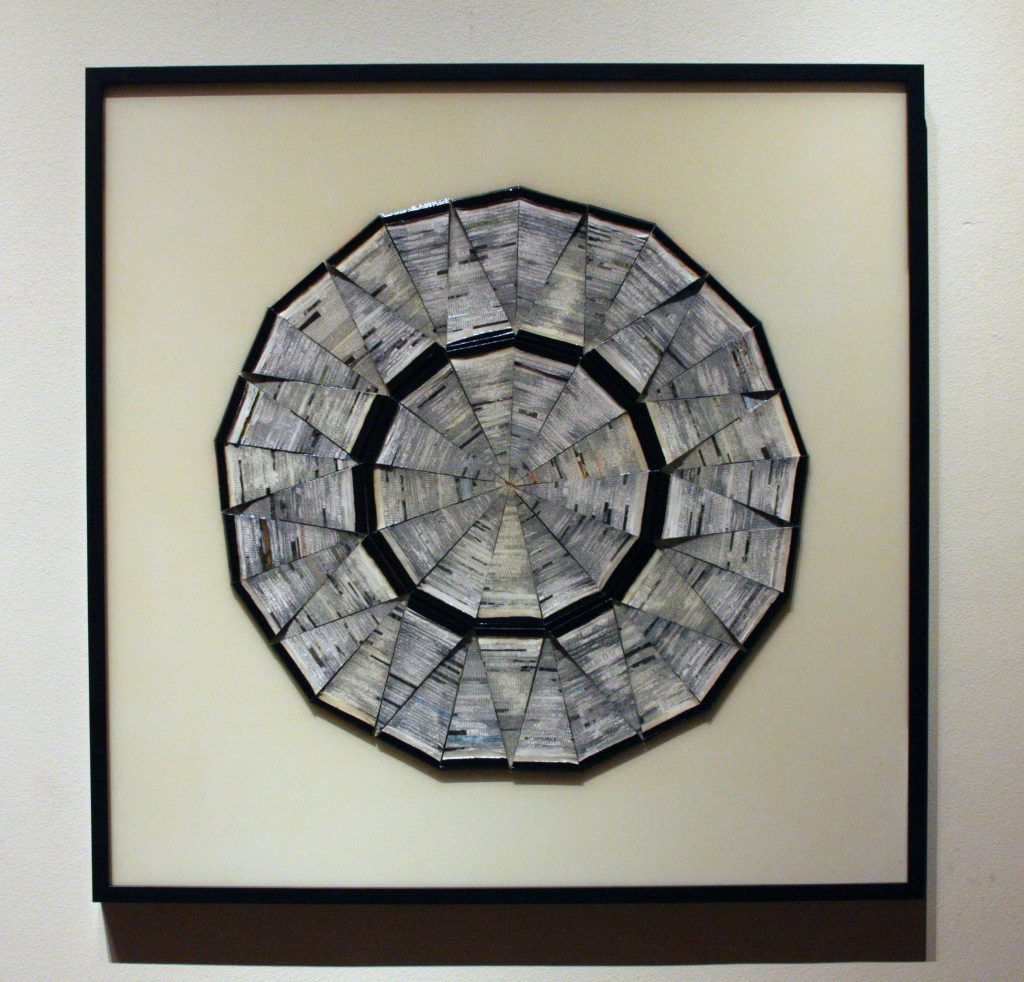
Why do you feel so often that students in science faculties have been screened away from the arts and how should educators be connecting rather than dividing?
I think that if students are being ushered from an arts education to being prepared for a scientific career, the reason is probably purely economic. Our society is being constantly inundated with new technology, chemistry, and biological manipulation - which means there is demand for a trained work force to accommodate that trend, and that work force needs to be educated in the sciences. The financial gain of someone in the field of the Arts is much less probable: other than within the administration of the arts. At least that is true in the Unites States. If you are getting a degree in the arts for education, you will never be well-off. Maybe paying educators considerably less than professionals in the field is some ass-backwards way of getting teachers truly committed to students, yet I digress…
There should be more interdisciplinary bridges in all forms of education from grade school to college. These bridges should be built with the ability for a student to express themselves through any manner of artistic expression. Younger students do this more often in schools, but as we specialize in our studies as older academics the concept of well-roundedness gives way to being an expert in your field. Sadly, the Renaissance Man is seeing a continually diminishing salary.
What lead you to branch out from your science background to a MFA in the Arts?
I teach AP Physics, Regular Physics, Astronomy, and Chess. My undergraduate degree was in the sciences, specifically Biology and Chemistry, but as I was in college I started taking an Art class every semester to blow off some academic steam, so to speak. Directly after college I worked in a Laboratory with Gas Chromatograph machines – how to troubleshoot, repair, and operate these machines in order to run BTEX air, water, and soil samples. The job was incredibly taxing in many regards with an immense learning curve and long hours without additional pay. While there I started making small art creations in my limited spare time in order to blow off some work steam, so to speak. Finally I decided that going back to school for Art was a good idea, and my wife foolishly agreed. The next 5 years were dedicated to my Art education which cumulated into a Masters of Fine Arts from Texas Tech University.
What really lead me to art making was a desire to put things together. What has been a bit of surprise to me in recent years, is that I’m still so enthralled by learning new things in the Sciences that I have found a position that allows me to learn and teach Science during the day - and then evenings, weekends, and of the course the summers are times when I can quench the need to make.
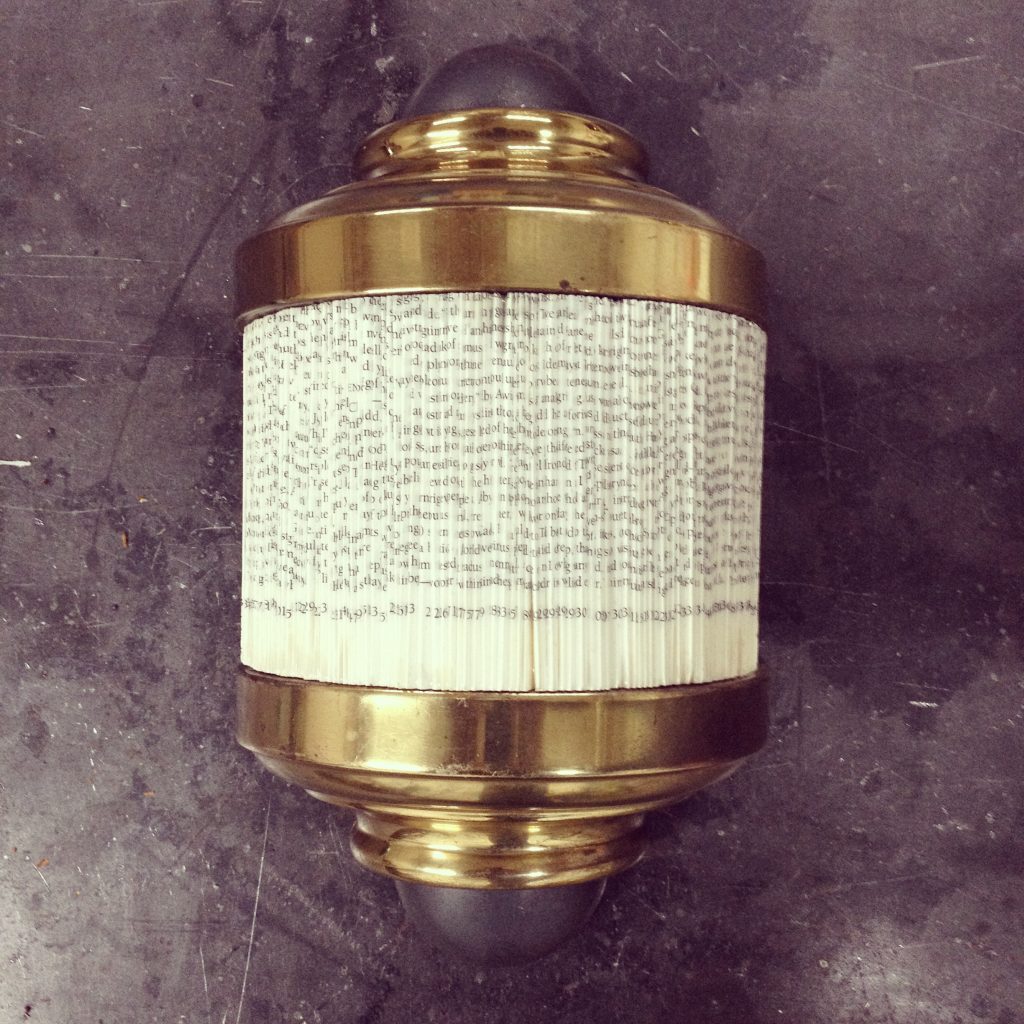
Contact details.
Jonathan Whitfill, Texas, USA
Interview by Deborah Blakeley, June 2015
Deborah Smith
Can you discuss the importance of movement in your work?
When I collect a piece driftwood that I’ll use for my work, I find myself imagining the journey that brought that piece to that shoreline or riverbank. I see it cascading down falls and through rushing currents, crashing against the shoreline if brought in by a storm, or bobbing gently along in quiet waters and settling into the sand as it came to rest on a calm day. I also look for the bends and turns in the piece that developed as the tree grew, twisting and reaching for the sun.
These reflections inspire me to attempt to translate the journey, define and illustrate the movement I see.
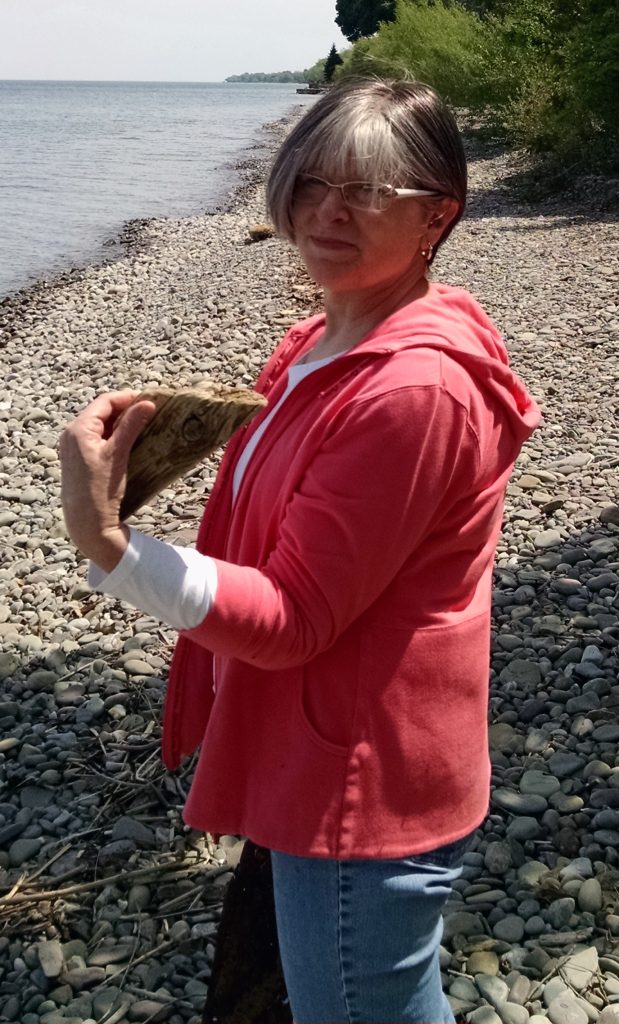
Please explain two techniques you use?
Round Reed
Round reed is the material I most often use in my sculptural pieces. It is the inner core of rattan, a fast growing vine, harvested in Indonesia and South East Asia, then sized and sold by the pound. I work with the smallest sizes appropriate for a piece, often size 0 or 00 mm, because of the flexibility it allows.
Ribbed Weaving
Ribbed weaving is a technique that is used to make the ‘egg’ or ‘buttocks’ baskets. In earlier days, these baskets were placed on a horse’s withers, in front of a rider, and used to transport eggs and other items.
Consisting of two hoops that form the handle and rim, ribs are added to construct a frame. A basic over/under weave is used to fill out the body of the basket.
I first started weaving plaited baskets, but soon became fascinated with these ribbed baskets, admiring their lines and the many variations that could be created when making the frame. Although I work with round reed for weavers, rather than the traditional flat material, it is this basic technique that I use in my sculptural work today.
When do you go beyond natural fibres and into dyed (Coloured) fibres?
For many years, I mixed colours and dyed reed to use in my sculptural baskets. To keep the reed as flexible as possible, I found it best to dye the material in small batches and use it while still wet, rather than dying large lots and re-soaking. Even in airtight containers, the reed could not be stored for long before moulding or drying. It was also difficult to achieve the same color with each dye lot, no matter how precisely I measured.
Last year, I began experimenting with acrylic paints and have been very pleased with the results. Although it is time consuming to ‘paint’ a piece because of the texture and position of the weaving against the wood, it allows me to work without rushing, offers a greater range of colour, and produces a more even tone.

‘Waiting’
Discuss this in relation to Reproduction Grain Harvesting Basket
The original use
I modelled the Reproduction Grain Harvesting Basket after an old field basket owned by an antiques dealer friend. Her understanding was that these large, four-handled baskets were used in New England for winnowing grain. Since the basket was large but light in weight, and the grain would not have been very heavy, I believe that these were probably handled by two people, one on each corner of the basket.
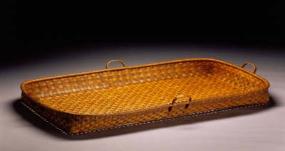
Their use today
I haven’t seen any other antique baskets of this type since, but whenever I am commissioned to make a reproduction, it is to be hung on a wall as a decorative item.
Discuss the importance of looking back at traditional basket making and how this has allowed you to move forward into contemporary basket making?
By looking back at traditional basket making, I was able to learn about technique and function. This helped me form a foundation that I was able to work from and enabled me to experiment with new ideas. I would not be able to make my sculptural baskets today if I hadn’t studied the traditional methods and forms of ribbed basketry.
Expand on how you gravitate to the disorder of nature for your inspiration?
Disorder in nature can appear as order, in the form of patterns, and it is this impression of order that inspires me. I am often out walking the shoreline of Lake Ontario in good weather, and sometimes in bad. There, the lapping waves against the beach, the pebble mosaics left in the sand by retreating waves, a fossil imprint of plant material in a stone, and the curve in a piece of driftwood are all evidence of order arising from disorder. These examples of pattern and rhythm, two elements fundamental to weaving, intrigue and motivate me.
How has your location of the Hudson River, the Niagara River, and Lake Ontario become so influential in your work?
Growing up in the Hudson Valley, the River was a focal point. I was always aware of my orientation to it, always unconsciously searching for a glimpse of it as I travelled locally.
Its tides are dramatic and I could watch long sections of shoreline reappear in an afternoon, after having been covered by high tide that morning. I’d watch the nun cans slowly shift their directions, pointing from north to south, then back again.
I remember standing at the back end of the ferry that carried my family from Newburgh to Beacon, when I was very young, mesmerised by the churning waters in its wake.
I also remember being sorely disappointed at my first siting of another river thinking, that perhaps it had been mislabelled, as it couldn’t possibly be a ‘river’. I’d believed all rivers were as wide and majestic as the Hudson.
This beautiful and vibrant waterway was alive for me, imprinting images, sights, sounds and sensations that are fundamental to my work.
Today, I am very fortunate to have the great Lake Ontario in my back yard. The driftwood I find here has likely travelled down the Niagara River and tumbled through the falls. Walking the ‘beach’ is always interesting, as often huge, ocean-like waves change the shoreline from one day to the next. For me, this means new treasures arriving often.
The brighter colours and increasing curves of my recent pieces are a result of the influence of this impressive body of water with its vast size, frequent changes and deep aqua hue.
Discuss the materials use in ‘Lunar Lift’?
Lunar Lift was made using driftwood found along the Hudson River, and dyed round reed. This piece is a little different from most of my pieces as the driftwood was used as a component in a more geometric composition, rather than an attempt to portray a sense of movement.
Can you explain the best way to care for baskets?
My traditional baskets have a linseed oil finish and can be taken outside, or put in the tub, and gently sprayed with lukewarm water once a year or so. A light dusting with a cloth or feather duster can be done whenever necessary. My sculptural baskets can also be dusted using a feather duster.
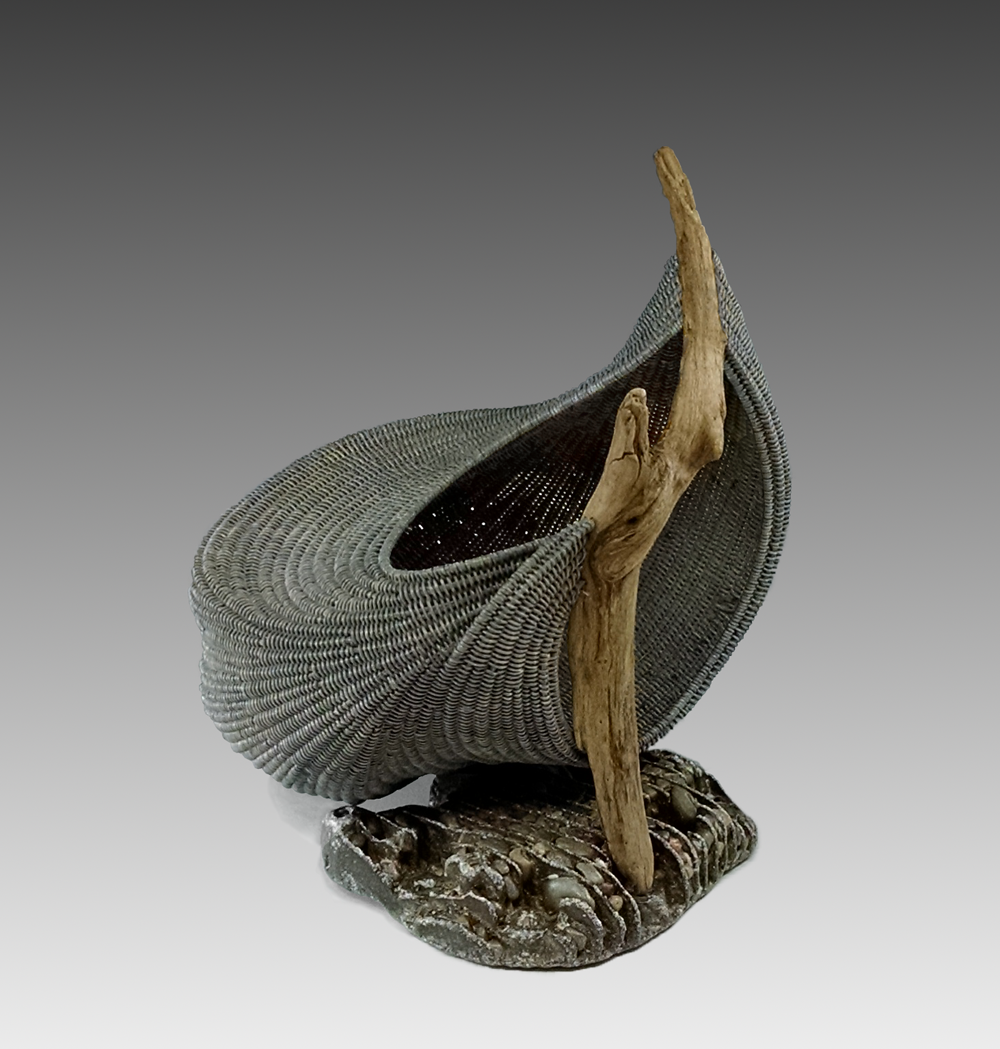
‘Grey Woven Sculpture’
Your baskets are beautifully photographs can you expand on this?
Thank you. I always try to find experienced product photographers in the areas I live in to photograph my work. While I determine the position of each piece, the photographer is responsible for the difficult job of lighting them.
How did your Driftwood jewellery evolve?
The driftwood jewelry is something that I started making just this past year. I’ve always collected driftwood and, having moved to this location along Lake Ontario, I find many breathtaking pieces of wood, rusted metal and beach stone that are not large enough to use for woven sculpture.
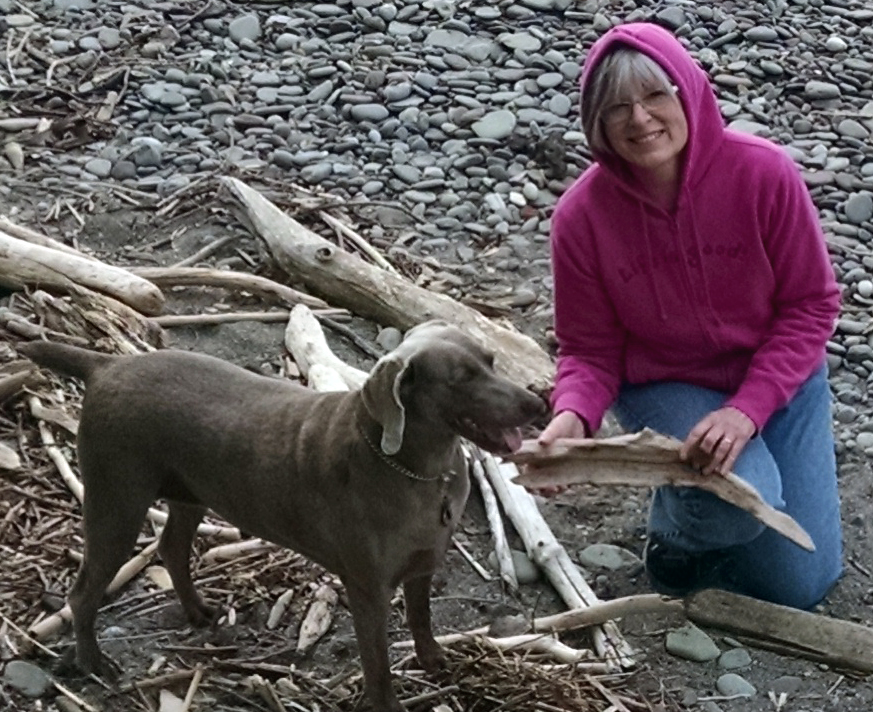
I began making tiny compositions using these finds and realized they could be worn as jewelry. I have a lot of fun creating these small sculptures and I enjoy bringing part of the natural world indoors with me when I wear one.
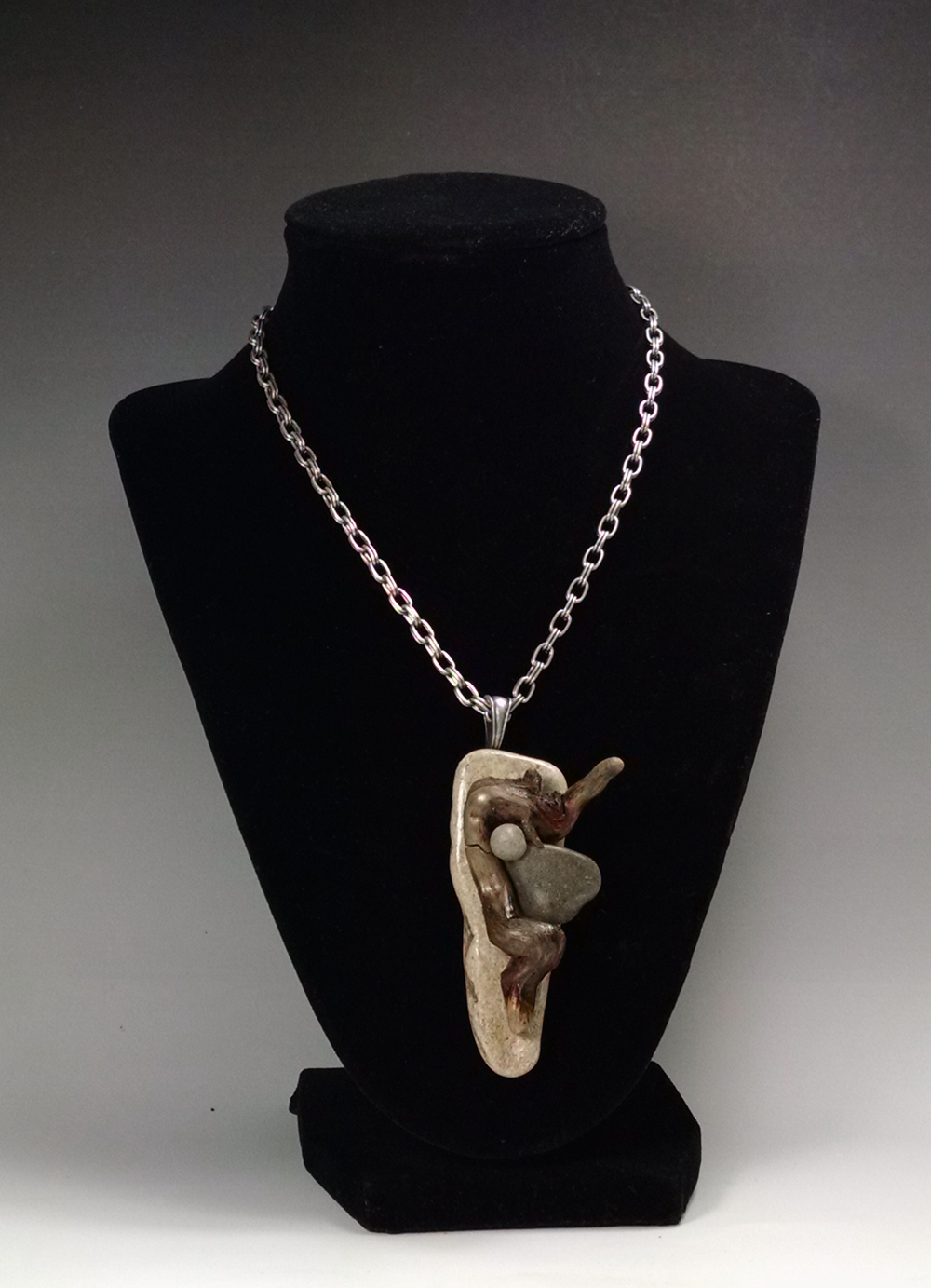
‘Driftwood necklace with Beach Stone #25’ discuss the Eco Art aspect of this piece.
For me, the Eco Art aspect of this piece, and most of my work, is my attempt to describe the natural world and our engagement with it. This piece represents the essence of a walk along the shoreline, as it would not be unusual to find these small pieces of driftwood and beach stone nestled together in the sand, just as I have arranged them in this pendant, the combined force of wind and water having been the artist.
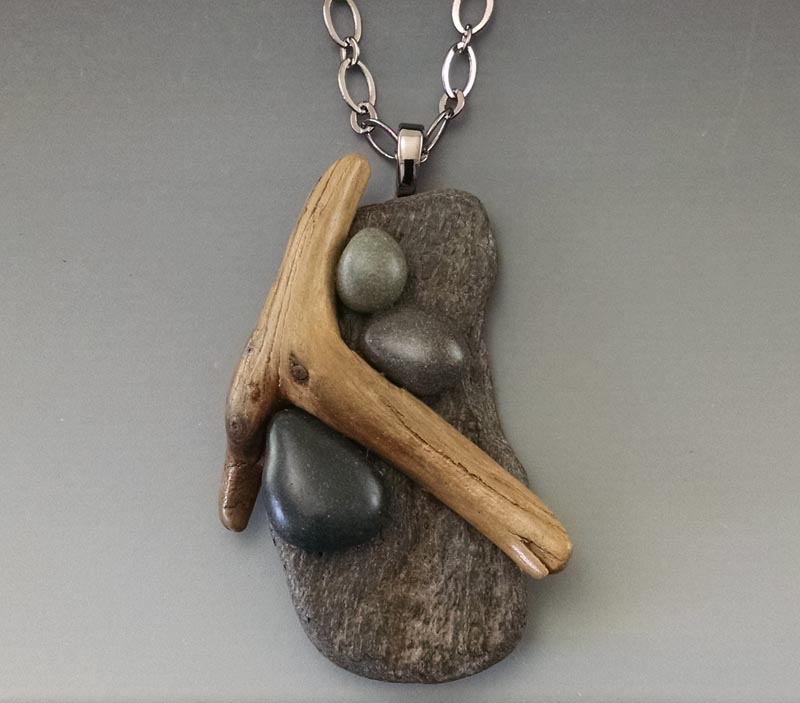
How and when did you find your own style?
I found my style of combining driftwood and free form sculptural weaving years ago, when I first applied the ribbed weaving technique to a small piece of driftwood I had sitting on a shelf in my home. I’d been making Appalachian Egg baskets for about a year and had seen some ribbed baskets using antlers as handles. I thought it would be interesting to see what I could do with the driftwood that I loved. At that time, I used small pieces and designed them to hang on a wall. The larger, free standing pieces developed as I continued to experiment.
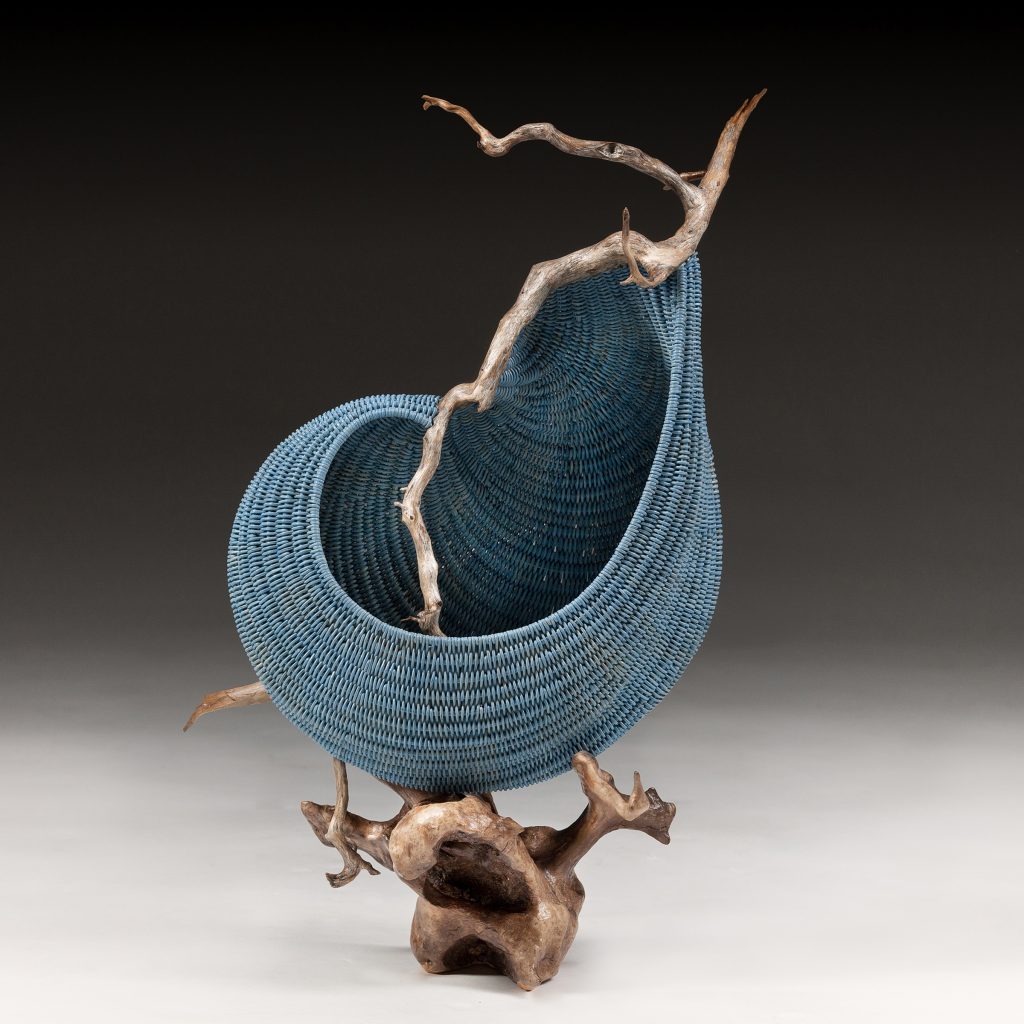
‘Beach Music’
Discuss your sculptured basket ‘In Flight’ and how you have developed the stands for many of your sculptured baskets?
‘In Flight’ is one of my favorite pieces. Its orientation and the simple, straightforward lines of both the weaving and the driftwood piece suggest, to me, a feeling of free-spirited soaring.
The stand for it was made by a talented welder. While I can describe how I’d like a piece positioned, it is a difficult job to properly balance it and manufacture a metal stand. I’m not always able to find welders to do this and I’ve recently started constructing stands myself, using found metal pieces, stone and driftwood. These new stands have become extensions of the sculptures themselves. I’m truly enjoying the challenge of creating not only a balanced support for a piece, but also one that will showcase it in a way that is reminiscent of the shoreline and my original vision for the sculpture.
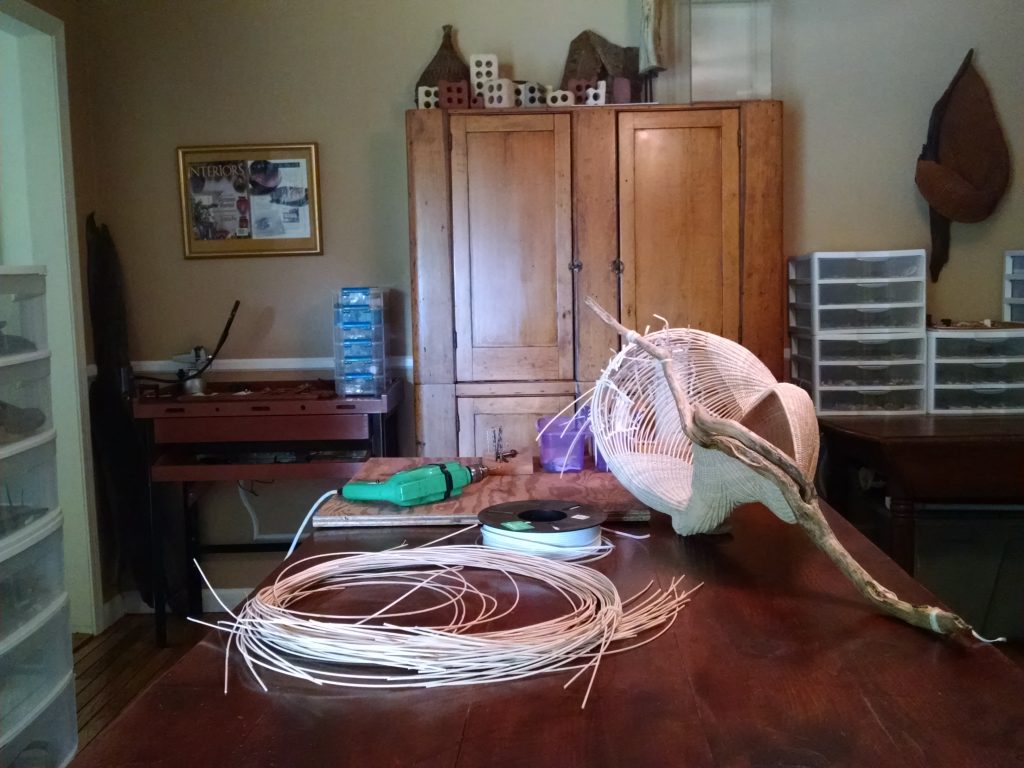
How important is it for you to focus on a single body of work?
As the weaving material I use in my sculptures is small, each piece is very time consuming, most taking months to complete. Because of this constraint, I believe it is important to concentrate on and continue to develop this body of work.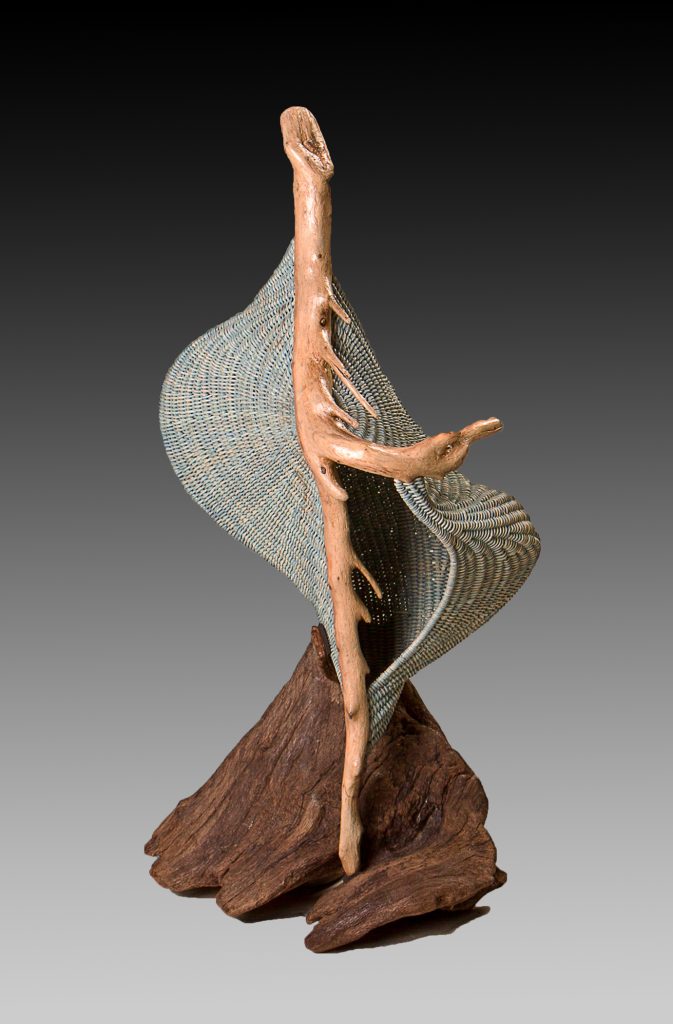
‘Tidal Arabesque’
Contact details.
Deborah Smith
Smithcraft Baskets
Interview by Deborah Blakeley, June 2015
Pamela MacGregor
Explain how you were introduced to felt and the possibilities it presents to you artistically?
I was an art teacher for 28 years in a public school. I took classes or workshops to keep my teaching certificate current. My first felting workshop was in 2004 and I was immediately in love with it. Felt is the only medium I have found that allows me to make clothing, shoes, jewelry, sculpture and much more. The possibilities with felt are endless with lots of challenges.
Much of your current work is 3D discuss this aspect of felting?
I majored in jewelry design and ceramics at university so it was natural for me to lean towards the 3D in felting. I find the engineering possibiities while working with a flat pattern and developing that flat pattern into a 3-D sculptural form very exciting. Each new work is another challenge to explore and figure out. I find it energizes my creative spirit.
Can you share your studio with us and discuss?
I converted a part of my horse barn into a very workable studio. It is small but full of all my collections such as bird nests, bones, dried pods, feathers and other wonderful found objects. My interest in nature is obvious as soon as you enter.

The studio has a washer, dryer, 2 microwaves, one for dying and one for food and a 3/4 size refrigerator. It has all the amenities of a small studio apartment with a full bathroom. Quite often I have students stay in the studio while taking a private workshop with me.
The sliding glass door opens out to a covered porch and over looks our pond and wooded area.
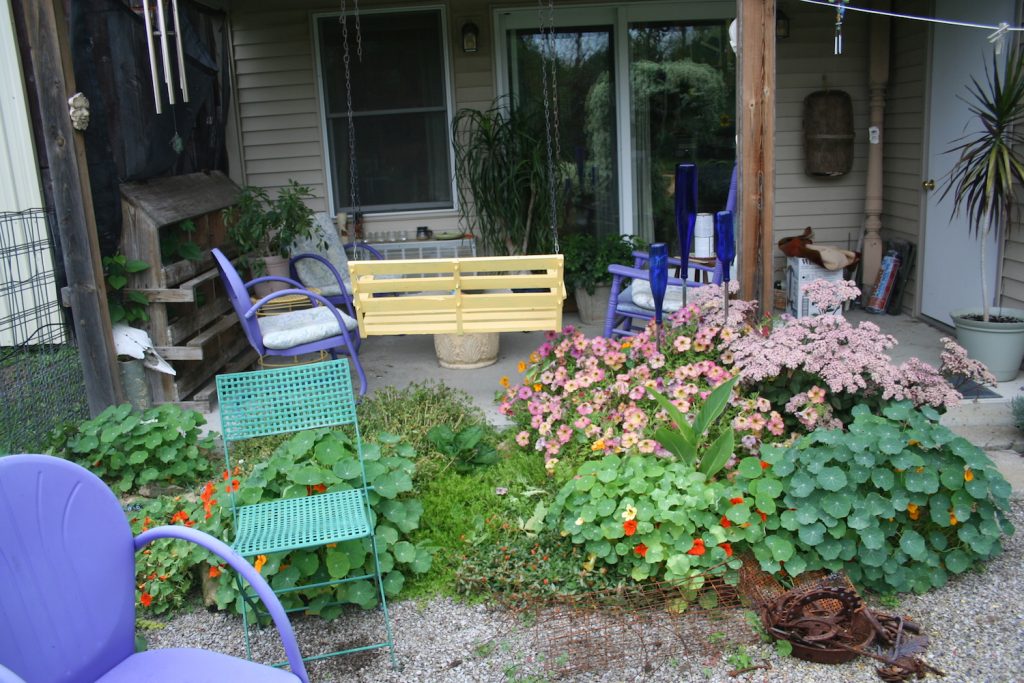
Behind the Studio in Summer
Lighting
I have large windows with inset ceiling lights as well as hanging fluorescent lights.
Storage
Storage is always a problem in a small space. I try to keep everything at my fingertips using floor to ceiling free hanging shelves. The materials I use the most are at eye level. I keep my wool in clear plastic tubs. I find that if I can see it I will use it. If the wool is out of site it is often out of mind. For added storage I use old chest type freezers with their plugs clipped off. These freezers are in the aisle of barn not in the studio. They are a great way for me to store the extra, seldom used wool and raw fleeces and they totally protect the wool from bugs, moisture while giving me added counter space if needed. This system works like a dream.
Two essentials that make you studio so great
My studio is loaded with all my special “things” that just make me happy.”
It is a bright, quiet place and has a great view of our pond, the barn swallows, the woods and lovely sunsets. I often look out and see my old horse and pot bellied pig grazing contentedly as a dear walks delicately along the edge of the woods. It encourages me to breath, relax and create.
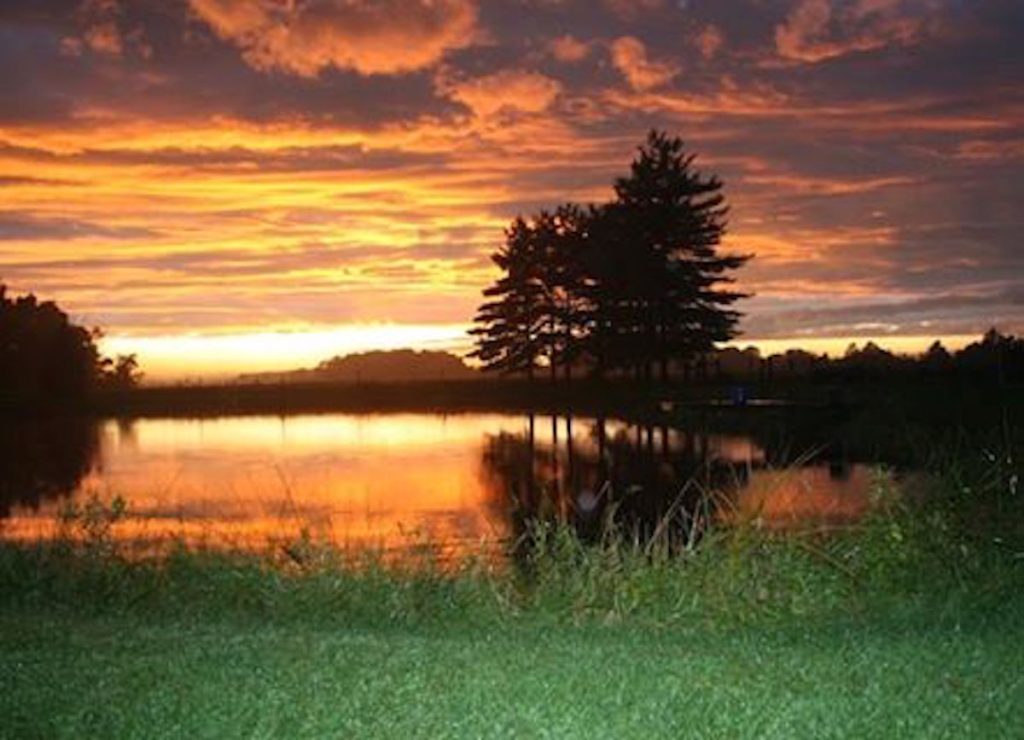
Sunset on the farm photo by Nathan
Retirement from full time work often opens up many artistic doors explain how this has influenced your life?
I honestly don’t think of myself as retired. I went to university and received an art degree and proceeded to teach children art for 28 years. Now, in instead of going to teach children, I go into my studio daily and go to work on my own projects. I now have more personal studio time for exhibitions work as well as teaching adults.
Discuss how important form is in your work?
I believe that my earlier studies in ceramics have had a great influence on my felt forms. I like my work to be precise, well crafted and almost give you the feeling of a ceramic form. I take a great deal of time thinking about the final form and how I will get to that form using a flat pattern. I spend hours shaping, correcting balance and cleanliness of line and form.
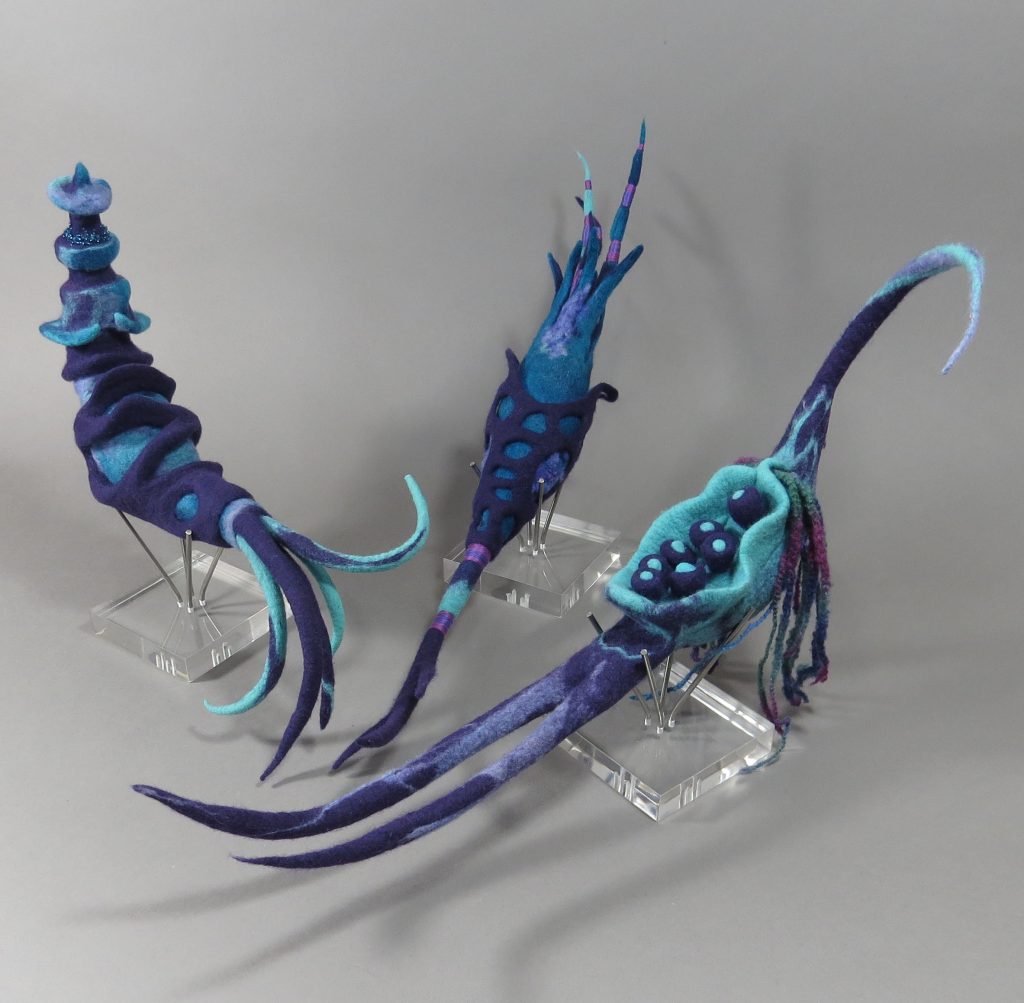
Why teapots; especially in felt?
Oddly enough, I have had my own teapot collection for years but it never even entered my mind to make one in felt. I was making felt vessels with well-fitted stoppers for several years and Amy Morgan, owner of The Morgan Contemporary Glass Gallery sent me an invitation to join her annual teapot show. Since that showing I have been totally enamoured with felt teapots. Who would have guessed teapots made out of wool would be loved worldwide. Each one is different and each one is a new challenge to me.
Can you take 2 teapots and discuss.
The inspiration, form and design
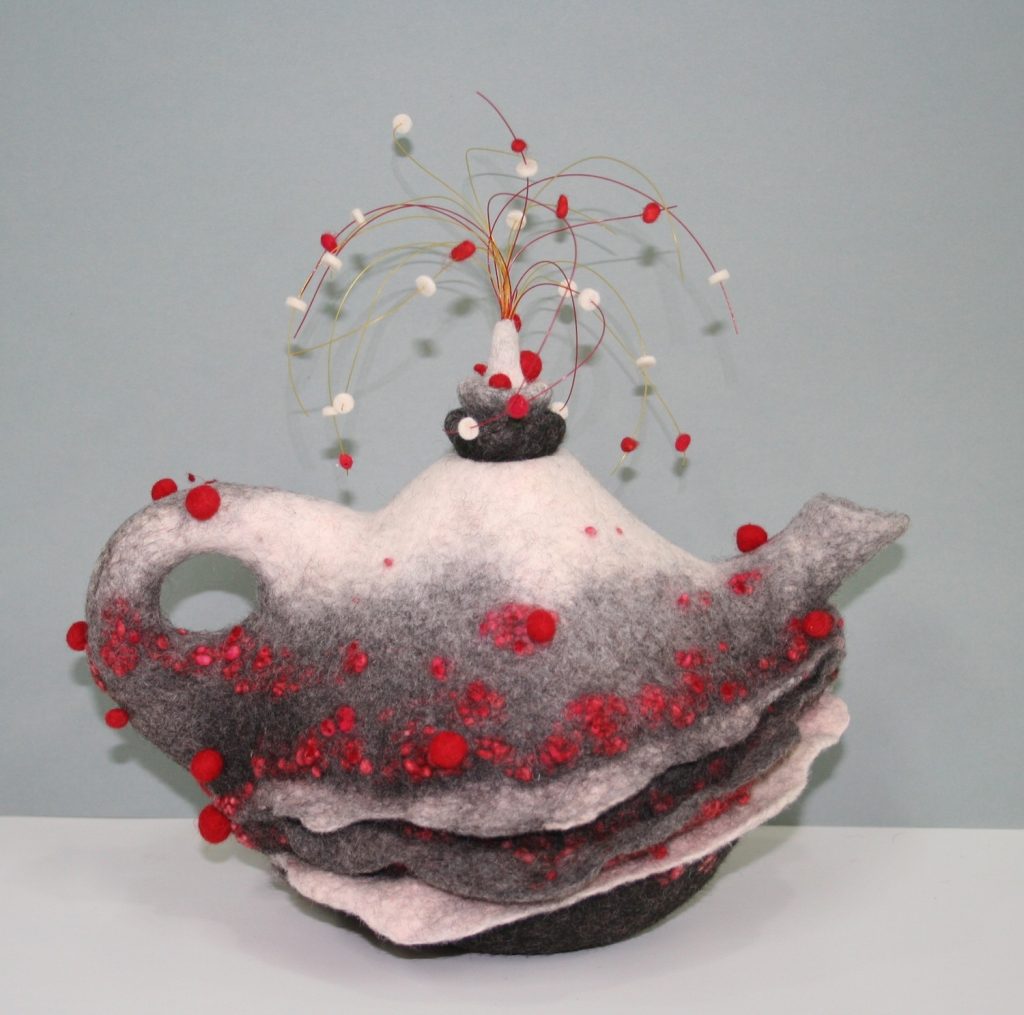
The first teapot is called Carnival. It is made out of natural colored Finnish wool. I used red merino accents and hand dyed monofilament for an explosion coming out of the stopper. I cannot remember the inspiration and I am not sure I even made a sketch for this one. It just flew out of my head and my hands went to work.
I take pride in getting my stoppers to fit tightly like wine corks. When the body of the teapot is finished I design the stopper. Each stopper is like a mini vessel and must fit the character of the teapot.
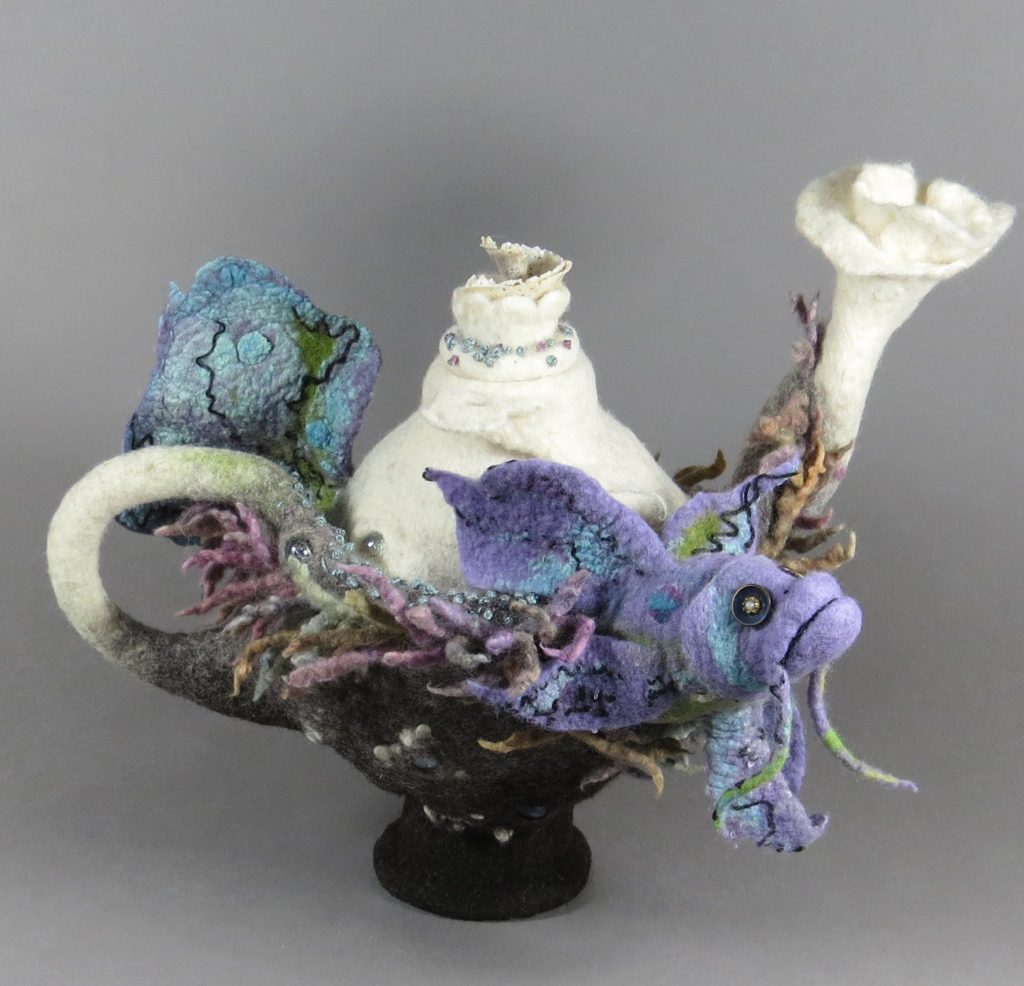
The second teapot is one of the newest teapots and on display at The Morgan Contemporary Glass Gallery 9th annual Teapot Show in Pittsburgh Pennsylvania, USA. It is titled On the Reef. I was inspired by the beautiful fish and reefs in Hawaii.
This teapot was made using multiple resists taped onto the main resist. The wool is Finnish wool with merino. I use merino and silk for the fish and added interesting texture with yarns, embroidery, glass beads, larger glass pebbles, antique button eyes and a shell in the stopper. The base is quite narrow and I had quite a time balancing the rest of the teapot. It was very top heavy but the handle and spout designs pulled it together. It stands very nicely now.
Discuss an aspect that was initially a new learning part within the work.
In each teapot or sculpture I begin, I always try to make it unique and add new techniques. This is the fun part for me. I never really know it will come out but I go with the flow and let the wool and work take me on its special journey. I firmly think there are no rights or wrong and no rules to be followed. You have to give up at some time during the making and be content with where the wool takes you.

Balearica Tea Pot
Can you discuss how you keep the form solid?
I use a flat resist to begin my felt teapot. When the wool has felted enough to remove the resist it is carefully removed and I begin to shape the hollow form into a 3 dimensional teapot. If my teapots were ceramic, they would be totally functional. Occasionally I will stiffen the inside with an acrylic liquid. I will do this only in the areas that might get damaged in shipment.
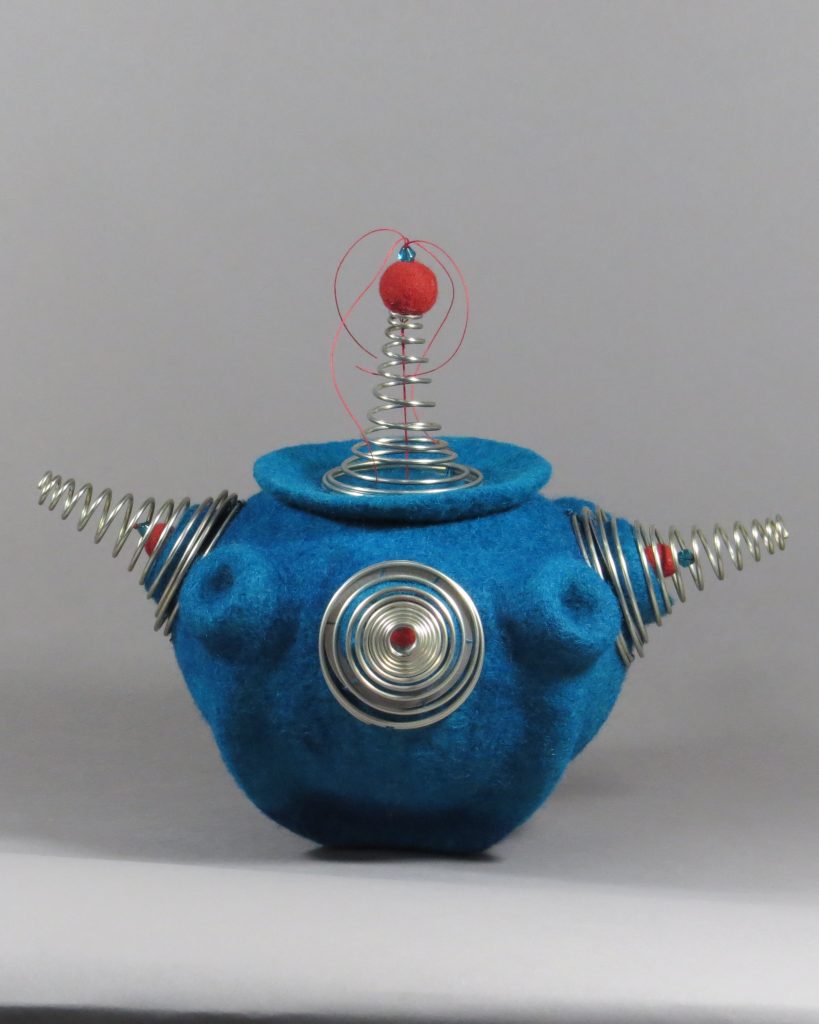
When did you decide to specialize in sculptural felt?
My first felt making workshop was actually in hat making. It seemed to me that a hat is simply a vessel turned upside down. I got more excited thinking about the challenges in making stoppers, handles, and spouts then in hat making.
How important is it to be able to work with natural materials?
I will repeat what I tell my students. There are no rules. It is all-good. Whatever works for you, do it! I like to mix it up and use found objects; man made materials, whatever seems right at the time for a specific work. My goal is not to be a felt purest, but to be an artist that happens to use felt in her work along with whatever else fits in.
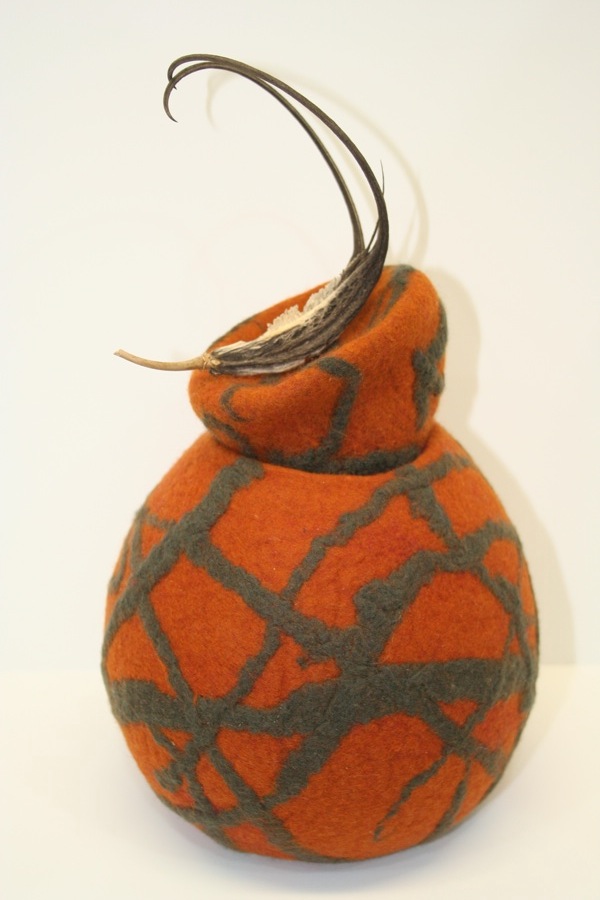
Devil’s Claw
Monochrome colour is very important in your work, discuss?
In my newer work I am finding I am most comfortable with the natural colours of the wool using just a pop of colour. On the Reef was a jump out of my comfort zone with its use of colour and busy texture. Most of my work has been very monochromatic using gentle gradation.
You also do 2D work, discuss one in particular, “Self Portrait”?
My self-portrait with chicken inspiration came from my fiber group, Fiber Forum. It is a group of 12 amazing fibre artists. We all decided to make a self-portrait in our medium of choice. I am a felter and a farm gal. I loved my flock of chickens and it seemed natural to combine the two subjects into a self portrait. It is both needle felt and wet felted along with beads and stitching on denium. My interest in 2-D is on the rise and I see more wet felted wall art coming.
Your felt workshops have taken you around the world expand on both the workshops and the travel they have given you?
I love teaching and travel but would not be able to do any of this without the help from my husband. He graciously takes over my farm chores while I am gone.
In 2014 I had the privilege to teach 18 workshops with in a 9-month period in the USA, Australia, Ireland, and England. I feel traveling by myself has empowered me as a woman and given me experiences that are far beyond what I had ever imagined I’d experience at age 65. I have lost the fear of “What if I get lost?” This same fear of getting lost has also merged into my artwork and I have learned to just go with the flow and enjoy the ride.
Discuss your thoughts on the current contemporary Felt Associations and how they are working to promote the art of Felting?
How and where do you see Felting is going in the future?
I love the new contemporary work being created all over the world. Felters are a relatively small group of makers but so global and willing to share. The interest in workshops and the growth in felt making is enormous. I think the newest trend is towards wall hangings and more and more mixed media. I see wonderful growth for felt artist and makers.
pammacg@roadrunner.com
www.tarveycottagestudio.com
Interview by Deborah Blakeley, June, 2015
Ed Miliano
Can you explain about your time at the Pratt Institute in NY and why when it is mentioned in the art world we all sit up?
I suppose it might be because Pratt Institute has been around for a long time and many famous and talented people have been associated with it. Many important artists and designers have taught at Pratt. When you are at Pratt your world is opened up to many different disciplines associated with the arts — architecture, sculpture, painting and dance, for example, are all under the same roof. The most important thing I learned at Pratt was to think conceptually.
After the Pratt you worked as a designer and illustrator in the USA and Ireland can you discuss how this aspect of your work has allowed you to develop your current style?
Working as a designer and illustrator taught me to be disciplined about my work. At Pratt, I studied painting, drawing and printmaking which are all skills I still use. When I paint, I think a lot about the design of the picture.

Ed Miliano with his art
Your work ‘Fartha Wood Mural’: How did this project come about?
Joseph Walsh, the furniture designer, lovingly restored a traditional Irish cottage that his grandfather lived in using traditional techniques. Joseph wanted to put his own stamp on the cottage. That included inviting me to paint a mural that wraps around the entire interior of the parlour room.
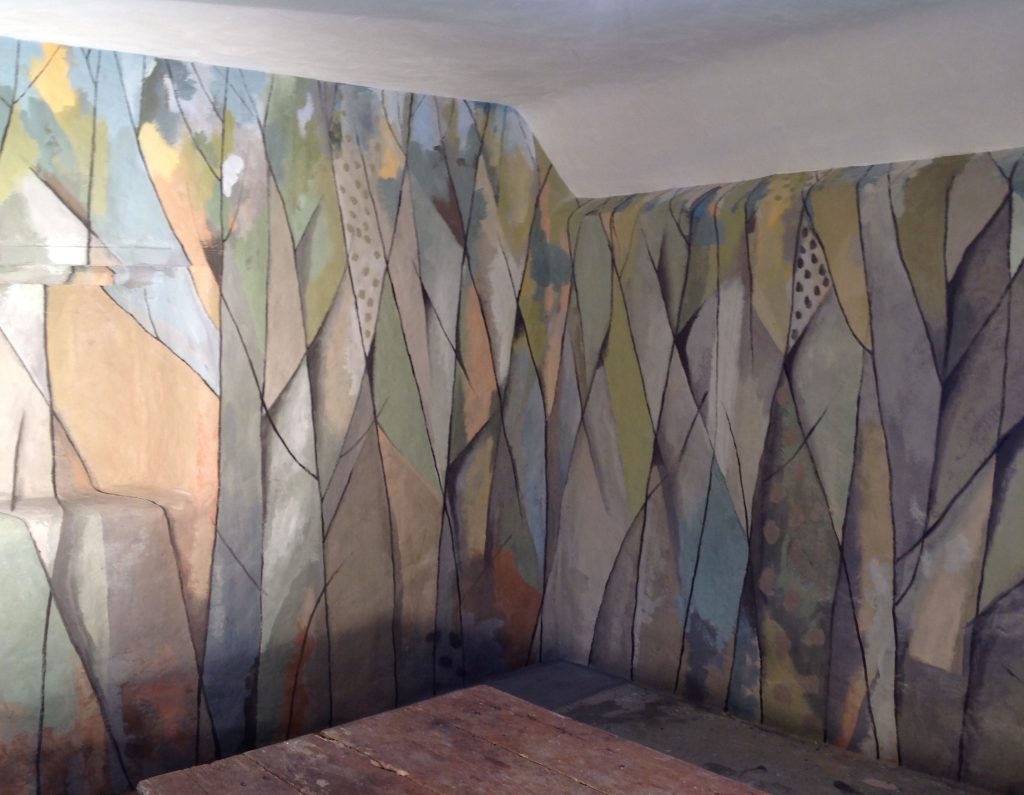
Fartha Wood Mural - Detail
The materials, mud, lime, timber, and thatch how have they influenced the work?
The building is made from lime plaster over mud and straw. I therefore had to use paint that was breathable. The surface of the lime plaster over mud is very uneven which affected the way I drew on the walls.
How and where does the mural relate to the building and its use?
The mural wraps around four walls and the walls are undulating. It is a little like the cave paintings at Lascaux in that the texture and indentations really add to the work. The location of the cottage is in the countryside, surrounded by woods. The material they use at the studio is mostly wood. The mural fits into both the surrounding environment and has references to what is produced at the studio.
Discuss the technical process the work took?
I made sample panels using lime plaster and did trials with a few different types of paint. The best were lime pigments from a paint supplier in Carlow that I could either mix with water or a bonding agent. I preferred the latter because it dried a little faster and it was easier to achieve certain effects. It is very similar to dry fresco.
What aspect of this project was to give you the greatest pleasure?
Joseph Walsh Studios is in rural Ireland and I really enjoyed working there because I was surrounded by nature. It’s also nice to work with people when you work alone most of the time. Joseph Walsh is a very inspirational designer and there is really good energy in his workshop. I loved the reactions I got from local people and those who visited the studio as the mural developed.
‘The Nature of Time’…
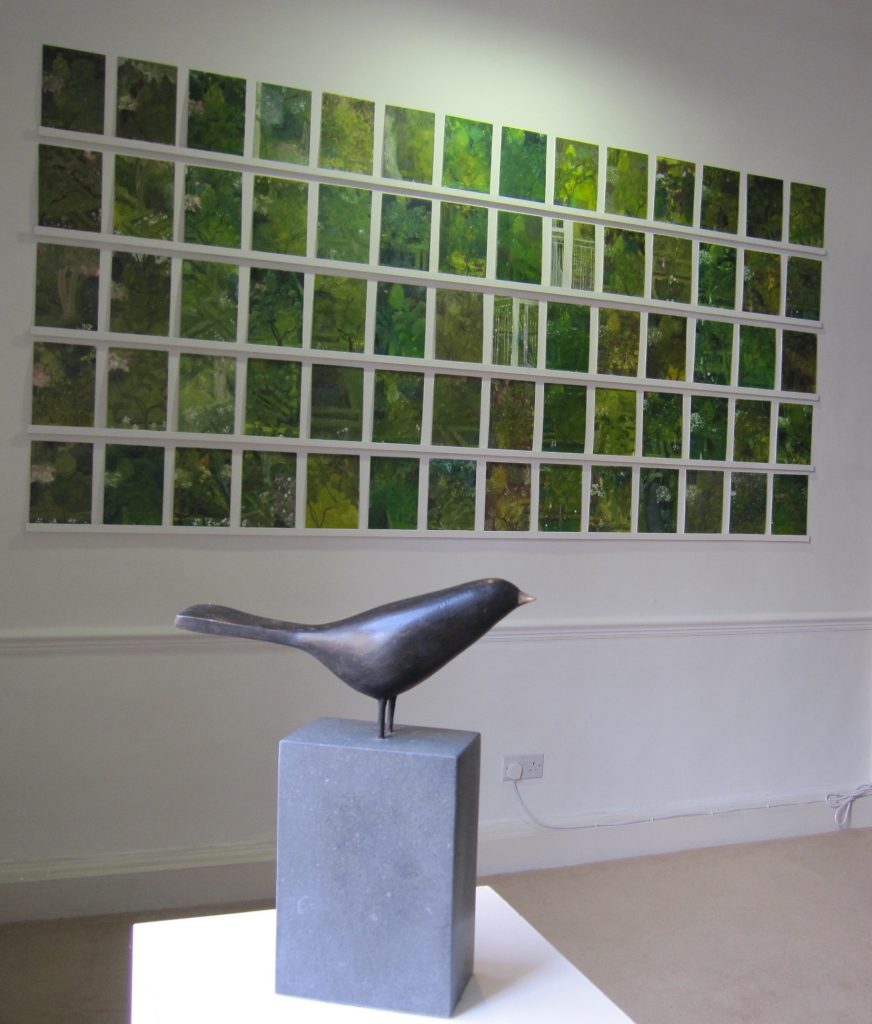
How do you describe this work, as an installation or a collection?
‘The Nature of Time’ was an exhibition at the Oliver Sears Gallery in Dublin, Ireland. Part of that exhibition was ‘Diary’, a very large piece I made in 2011-12. I painted the garden outside my studio every day for over a year. ‘Diary’ is both an installation and a collection. It is an installation because I change it to fit within the space it is being shown in. ‘Diary’ was first shown in the Royal Hibernian Academy (RHA) which is a modern museum-type space. There it was installed in one long wall, while at the Oliver Sears Gallery it was shown on six separate walls. The way it is installed changes the way it is viewed and makes the viewer notice different things. ‘Diary’ is also a collection of paintings. The individual paintings are part of a whole. This is a concept I am very interested in and am continuing to explore.
How did the inspiration come about?
I have studied Horticulture and am a very keen gardener. I have been developing the garden at our home in South County Dublin for over twenty years. In ‘Diary’, I wanted to create something that would collectively describe the garden in a way that one painting could not.
How important was the scale to this work?
The scale of the work was very important. When I started ‘Diary’ I made larger paintings but quickly realised I would have to reduce the size. Multiplying one painting by 366 yields very large results.
Before commencing did you have the Galleries space?
I did not have a gallery space secured before I started working on ‘Diary’. I wrote to institutions that I thought were suitable. The Royal Hibernian Academy (RHA) was one institution and Patrick Murphy, the director, made several studio visits to view the progression of the work.
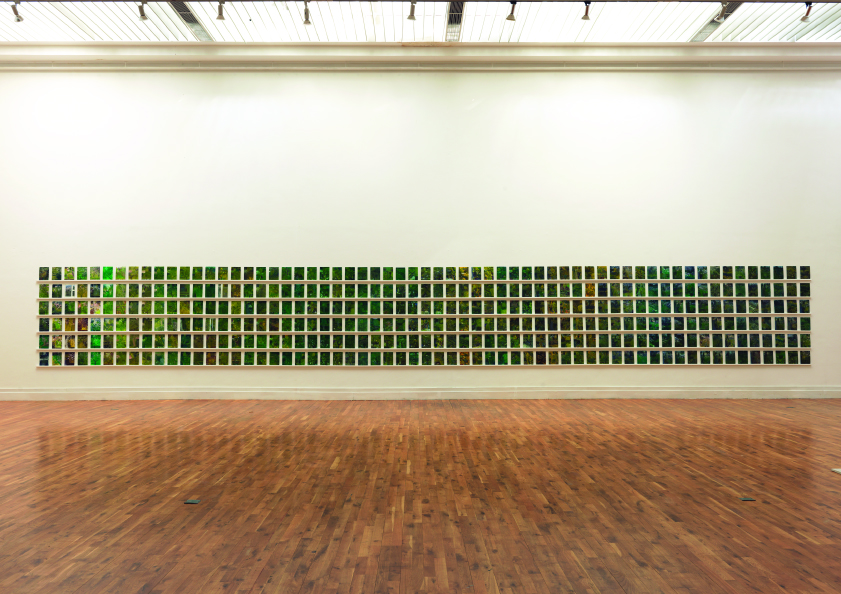
Diary at RHA
How important was it for you to look and re-look at the same space?
Looking over and over at the same space is a big part of what ‘Diary’ is about so that became very important to me. The same view would seem different from day to day depending on the light, the time of day, my mood, the weather and so on.
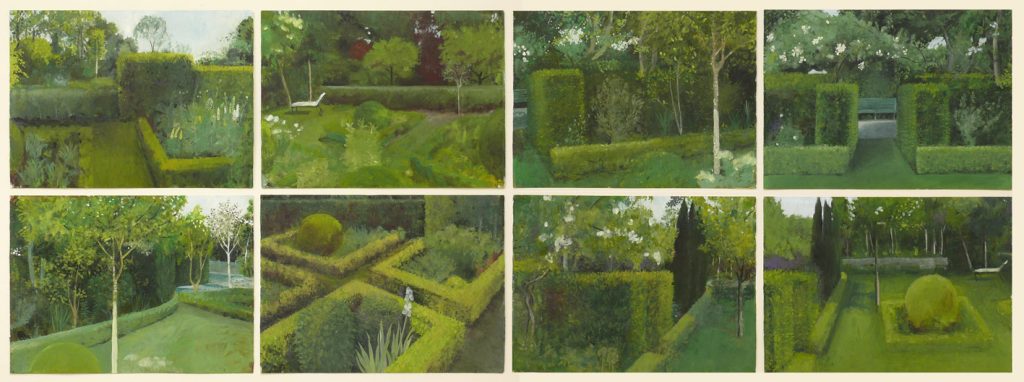
May Landscape
Expand on your feeling of connection between nature and man in this work?
Gardens are totally man-made and nature is wild. I love the idea of man trying to wrestle with nature in order to tame it. Nature doesn’t want to be controlled, but we persist. Birds fly into our garden — wild creatures that enter the garden freely. Even though we may want birds in our gardens, we don’t really have any control over them. They come and go as they please. For me, birds are a reminder of the wildness of nature. This thinking led me to make some bronze sculptures of blackbirds that I included in my exhibition.
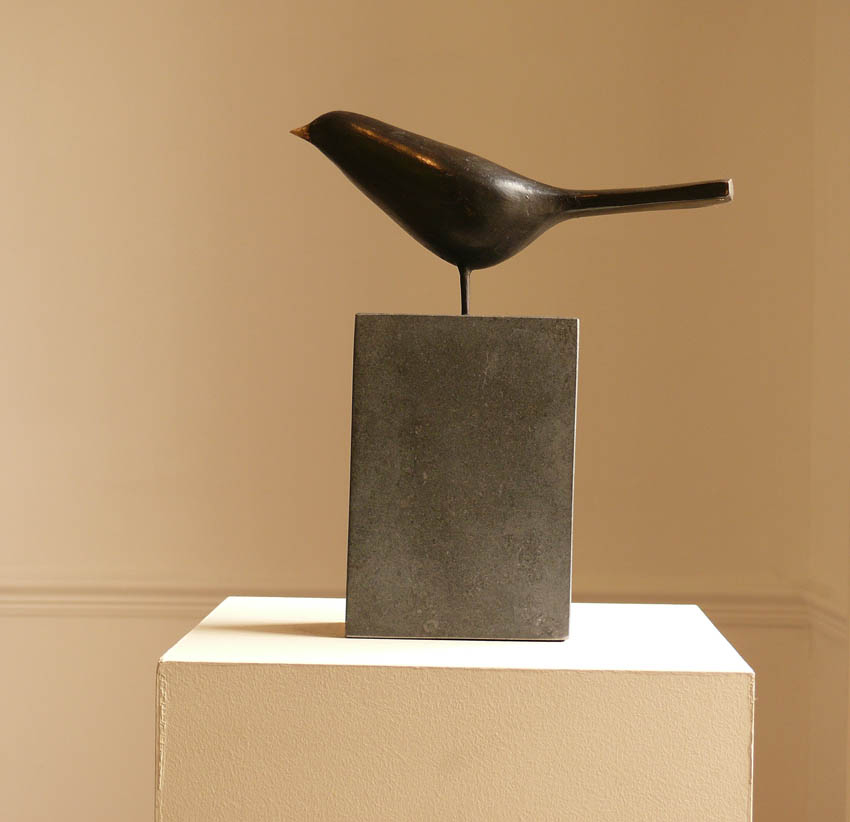
Ground Floor Bird
What aspect of colour and light did you need to work through?
In terms of colour and light, I basically reacted to and painted what I saw when I saw it. I liked to start a painting in the early morning but there were some days when I had to start later. A late start meant that the light was very different. I never worried too much about that though because I was creating a diary and if I had a late start it was for a reason. This all became part of the story.
Did you always paint the squares or did you have to rely on photographs at times due to other personal commitments?
I painted in my studio every day for 14 months in total. There was one time when I left after I finished a painting but returned before dark the next day so that I had time to complete the next one. At one point I was sick with a chest infection for a couple of weeks but I still went into the studio to make my picture and then crawled back into bed afterwards.
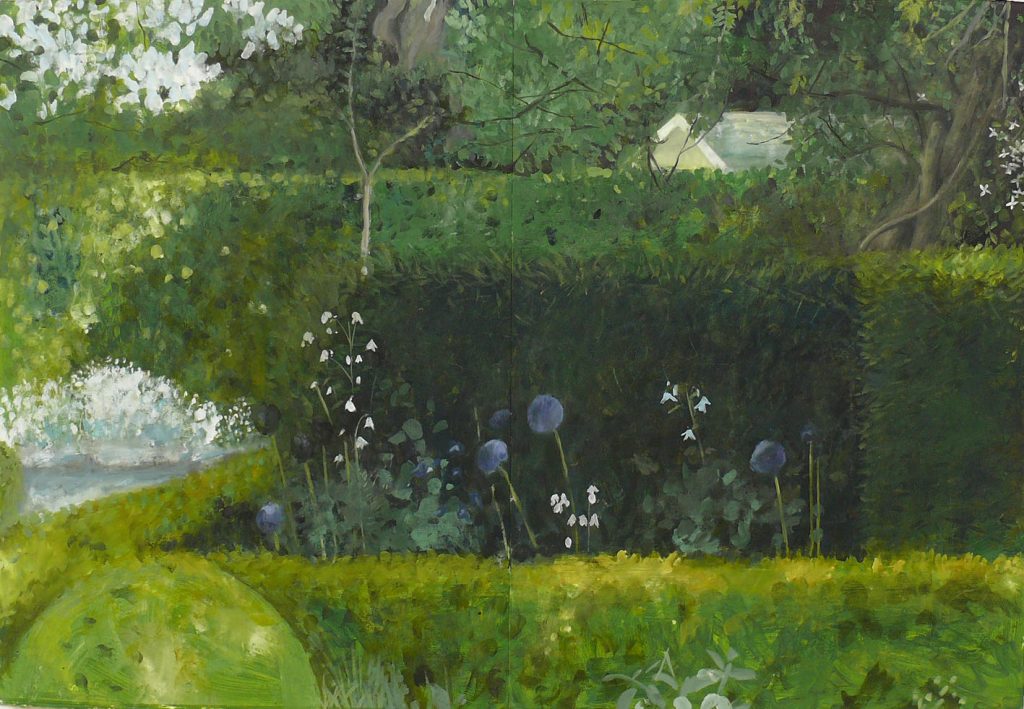
Spring Landscape 11
How did the amount of time needed for this project impact on your year?
Making ‘Diary’ became my whole life for the year. I loved making it and I loved the discipline. I like to set out rules for myself as a kind of matrix to work within.
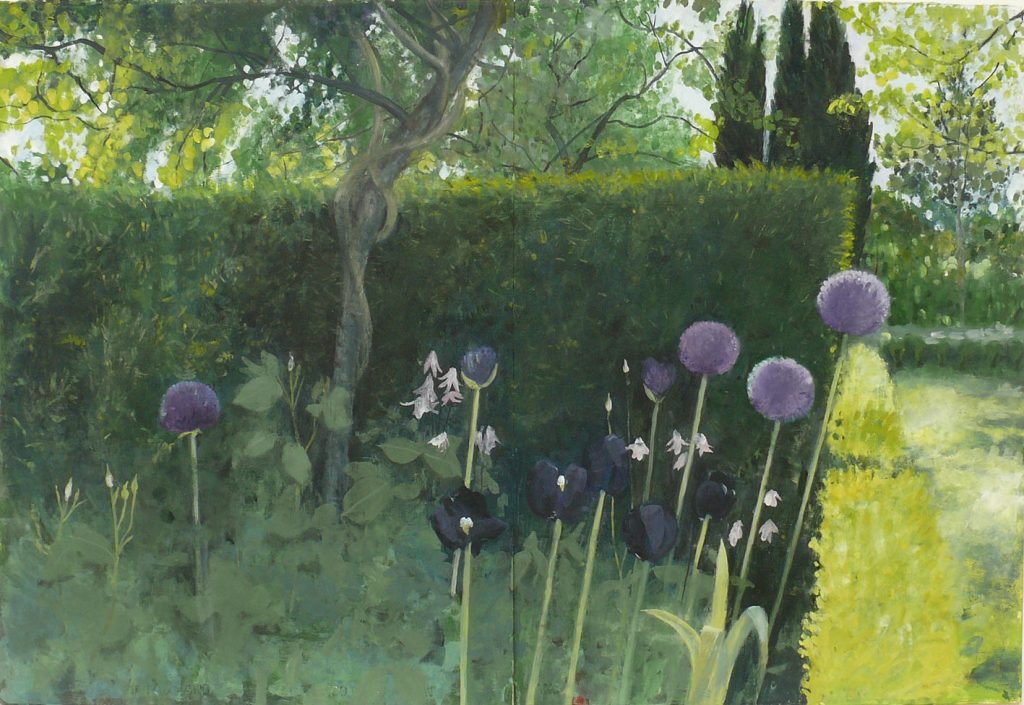
Spring Landscape 1
Would you suggest that others follow a similar project and what would they gain from the experience?
I don’t like suggesting ideas to other artists. The ideas and inspiration have to come from within.
What and where is the work now?
The work is with me in Tokyo. I am hoping to show it in Japan while I am here. I am convinced that it will really appeal to the Japanese aesthetic. I would also love for a museum or public institution to buy it and show it permanently. It has great impact and I want to keep it intact as one piece of work.
Did your work ‘Diary’ influence ‘Nature of Time’ project?
Yes of course, ‘Diary’ influenced my ‘Nature of Time’ exhibition. The new pictures expanded on some of the themes of ‘Diary’. I was also able to develop some of the ideas on a much larger scale.
Is it currently influencing you work today?
‘Diary’ still continues to influence me. It was an important stage in my development as an artist and, I see it as significant in my development as an artist.
What lead to Four Days to becoming prints?
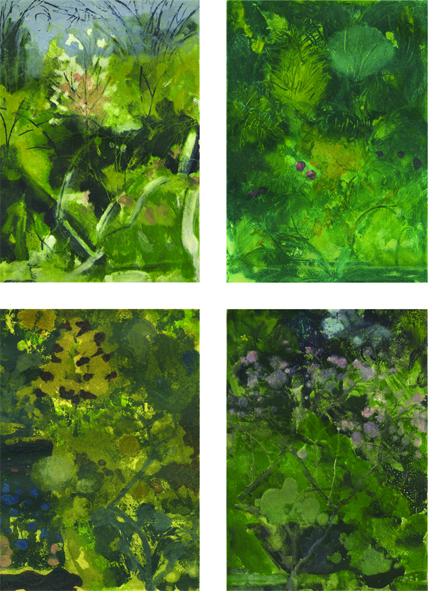
Four Days
Since I planned to keep ‘Diary’ intact I thought a series of prints based on four of the paintings would be interesting as a smaller work. I also did some monoprints as part of ‘Diary’ so it wasn’t a huge stretch to make prints.
You have traveled extensively discuss the way you have to rethink colour in different environments and light?
Colour and light are different in different places and no matter where I am my environment affects me.
You are currently in Japan how is this country influencing your work?
I am looking at a lot of Japanese art and culture from all periods. Japan has a deep history and there is a lot to learn. I am reading about Japan and reading Japanese literature so naturally, it all has an influence on me. I want to take my time so I can understand the culture better but there are already some things I know I want to use in my work — for example, I love Japanese screens and the way Japanese artists use gold in paintings.
As an artist who has amazing travel locations discuss what you take and what you give to each country you live in?
I try to remain open-minded and receptive to new ideas and different ways of doing things. For example, in Japan I am studying Mokuhanga printmaking. This is a traditional technique using water-based inks that can be adapted to contemporary work.
Can you discuss your technique of using oil on paper?
I like painting on unprimed rag paper because it absorbs the paint quickly and dries fast. When the painting is finished, I apply three coats of gesso to the back of the paper to preserve it. I realise this is unorthodox but I have some work that is over ten years old and it is still in good condition.
Discuss the importance of exhibiting your art work and perhaps one or two aspects you have gain from an exhibition?
I love showing my work and I love ‘making’ a show. It is what I work towards. Exhibitions force me to look at my work and, in some way, they are like completing a chapter of my life.
Expand in the importance of composition in your art and art in general?
Composition is important but I don’t really think about it anymore. I think it is totally intuitive now.
Contact details.
Represented in Ireland by Oliver Sears Gallery
Email info@oliversearsgallery.com
Interview by Deborah Blakeley, May, 2015
Jennifer Collier
Do the materials you source speak to you?
The papers themselves serve as both the inspiration and the media for my work, with the narrative of the books and papers suggesting the forms, for example a sewing machine made from dress making patterns, or a camera out of vintage photographs. I tend to find papers, by scouring charity shops and flea markets, then investigate a way in which they can be reused and transformed; giving new life to things that would otherwise go unloved or be thrown away.
How important are the actual words on the print to your work?
Whenever I am really stuck for an idea I seek inspiration from literature or poetry. The original concept for the dresses and shoes came from the novel 'Oranges Are Not The Only Fruit' by Jeanette Winterson, which I used as the basis for my degree show at university.
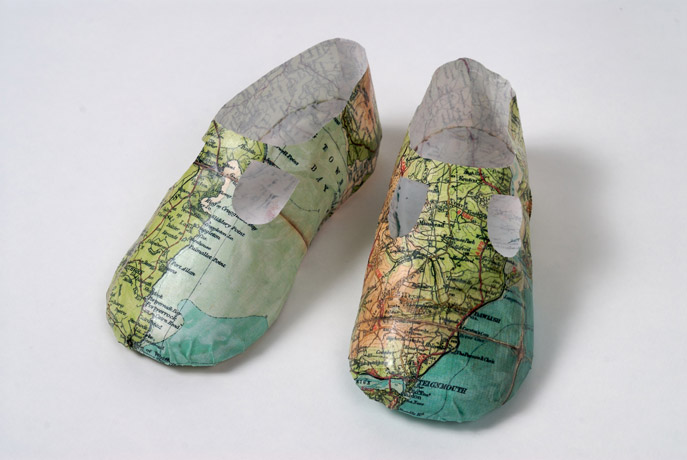
Explain how your University degrees have influence your work?
I did a BA (hons) Textiles, at Manchester Metropolitan University, which was a traditional textiles course specialising in print, knit and weave. Toward the end of the course I started experimenting with different materials, weaving with orange peel, melting fruit bags etc. Most of the techniques I use in my work now are things I have taught myself since graduating by experimenting with different media and techniques.
Can you explain the technique you use?
By bonding, waxing, trapping and stitching I produce unusual paper ‘fabrics’, which are used to explore the ‘remaking’ of household objects. The papers are treated as if cloth, with the main technique employed being stitch; a contemporary twist on traditional textiles.
I use both hand and machine stich in my work, and where possible try to use traditional embroidery techniques. I use resin to embed objects to make my coat hangers. the papers are rarely ‘treated’ in any way, as most people think, it is just the paper itself that I use, but through years of practice you get a feel for how far you can push it, and when it is going to tear, and which papers work best for what job. Some of the shoes are formed over a mould, using a moulding medium, but the Stilettos and Brogues are made from a flat template I have designed, then constructed into a three-dimensional shoe shape and the Ballet Slippers are hand stitched to form the shape.
We often wonder where commissions end up, discuss this aspect of your work?
A piece ‘Typewriter’ was commissiond in 2013 by the Library of Birmingham.
It is made using vintage typewriter manuals and encyclopaedias, the finished piece is housed in the Reference section of the new library.
Discuss the progress you take for a commission?
Commissioning a piece of work is really exciting – it is a chance to have something make especially for you. Below is a resent commission I have make.
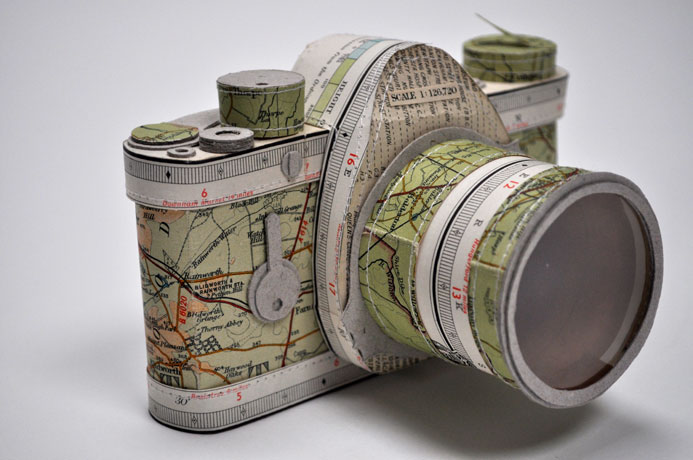
You can see the detail of both the use of appropieate maps and text in the making of this SLR camera.
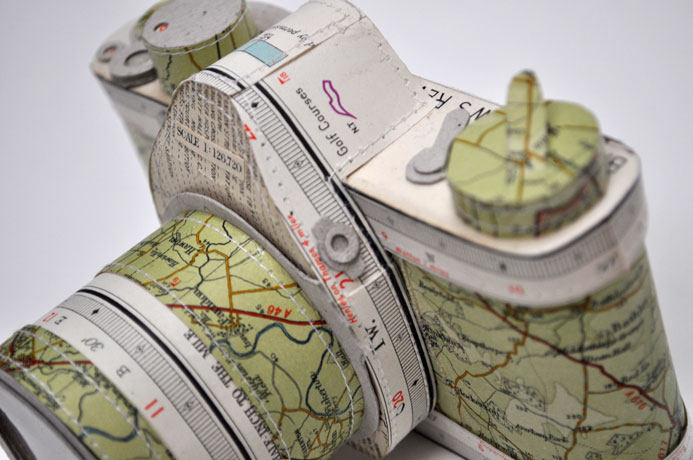
Workshops play a huge part in your calender discuss?
I have been running workshops in both schools and tertiary levels as well as with community groups. I am not currently running outside workshops due to my commitment to a very young family, people who are interested can come to my gallery Unit Twelve to participate in art workshops there rather than me going out. There are also five other artists who work from the studio who are available.
Explain about your studio?
I work from a studio in Stafford that allows me to be self employed through three avenues, sales, exhibitions and commissions running my own gallery Unit Twelve.
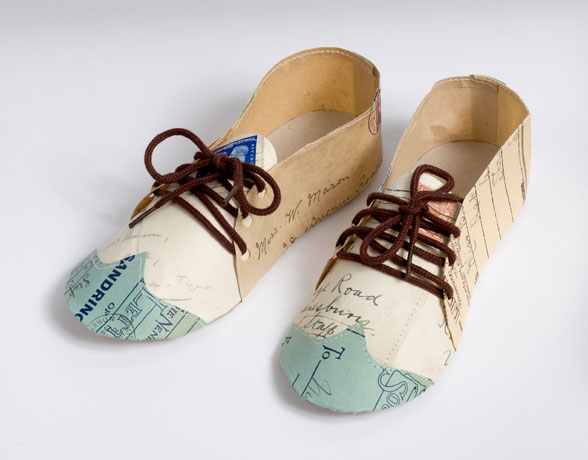
You have run workshops in some of Britains most influential Galleries, explain?
Yes, I have run works at many galleries including The V&A, Tate Liverpool, and Manchester Art Gallery.
How long have you been practicing recycling or eco art?
I have been investigating the re-used and recycled since 1999. Giving new life to things that would otherwise go unloved or be thrown away.
Contact details.
jcolliertextiles@yahoo.co.uk
Jennifer Collier, Stafford, UK
Interview by Deborah Blakeley, May, 2015
Gavin Mitchell
Can you explain why you work within a series or theme?
The foundation to all of my work is based on vintage found material. The kind of material I am usually drawn to is print, magazine, postcard, film, negative or slides. A feature of print and film is that it is often produced as part of a genre or trend with a distinctive visual identity and provides a rich seam of material from which to work from. Sometimes I will find an album or box containing dozens of photographs or 35mm transparencies that will be sufficient to generate an entire series of work. Sometimes I find a single magazine cover or postcard that will inspire me to start looking for similar material and begin a new series of work.
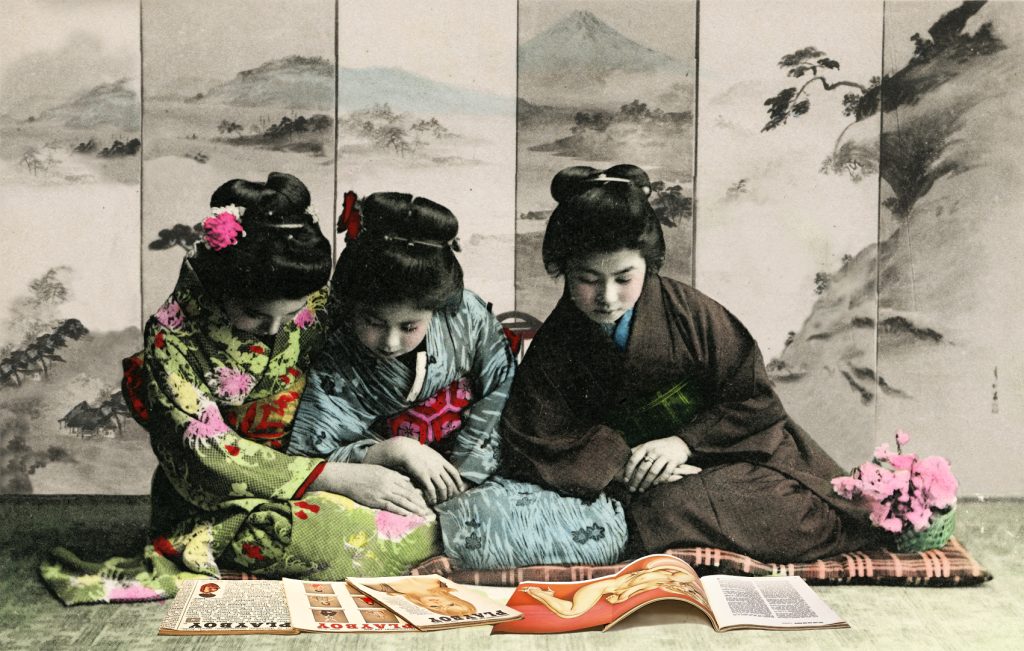
‘Shared Pleasures’
Where does the next theme come from?
Serendipity!
I have collected a lot of obscure material; I call my studio a repository for abandoned ‘stuff.’ Sometimes in an idle moment I will rifle through my drawers and re-acquaint myself with everything I have amassed and perhaps initiate a new project.
Alternatively I will hit the antiques markets, car boot sales and check out the sellers on eBay that I know deal in the type of material I am looking for. Anything I find and buy either ends up waiting patiently in the repository for abandoned stuff or jumps right to the front of the queue and becomes a new body of work.
The themes I use involve different layers and mediums usually exploring cultural personalities and relationships. I am drawn to personal and material lives and cultures that have gone before and the way they have been recorded and documented through film & print. I guess I am a voyeur, vicariously living the lives of others and re-interpreting though juxtapositions and abstract notions
How many themes do you have in your to do box and what allows them out?
Creatively I am a pretty restless person. I sometimes wish I was able to concentrate on one idea at a time but in all honesty I have four or five serious propositions in mind at any one moment.
My East Meets West series is an ongoing project that has been well received both here in Europe and recently in Hong Kong through The Cat Street Gallery. This is exciting for me as I was unsure how people would react in the East to my perception of their culture. The success of East Meets West has also allowed me a bit of financial security to research & develop more conceptual and experimental projects.
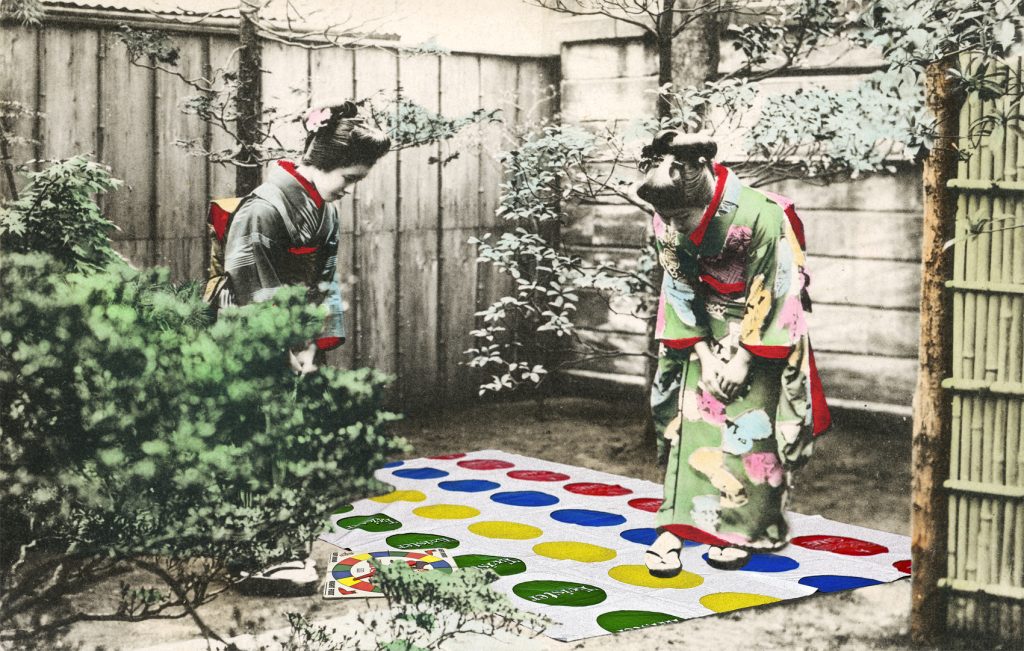
‘Twister’
Projects I manage simultaneously tend to involve different themes and utilise different mediums. I find it very useful to have back-burner projects that I can revert to if I am struggling with an ongoing project. It can clear the mind and allow you to return with a fresh perspective.
I am working on a new project that is an extension of my interest in historical and contemporary Japan, exploring the contradictions of the culture, outwardly inscrutable and deferential and yet inwardly enigmatic and hedonistic. For this series I will be combining photography, projection, vintage negatives, liquid emulsion, collage and paint.

Another project I am currently working on is an audio visual collaboration with an established electronic music duo. We are planning a one-off charity event in London that will combine a unique sound set from them and me producing a multiple slide projection installation using analogue Kodak carousels and montage slides that I have created by cutting up 35mm film found in the projector room of an abandoned cinema.
The title of my dissertation for my Fine Art degree was ‘ The attitudes and concepts in American Underground film from the late 1950’s onwards’ I remember looking back years later and thinking how pretentious I must have been as a student! Now the work of the conceptual film-makers, Andy Warhol and Stan Brakhage, featured in the dissertation, have returned to influence my ideas behind this new project. I want to continue explore and develop other audio-visual installations.

‘Picture’
You work in limited Editions can you discuss the numbers you print and why?
I like to produce large artwork. I prefer images that are big and bold. Pop-artists that have had an impact on me such as Richard Hamilton, Robert Rauschenberg and Sigmar Polke rarely produced small work.
I work in limited editions when the artwork I produce is created as digital collage and then produced as giclée prints on fine art paper. The original East Meets West images, Hear No See No Speak No and The Gods Must be Crazy remain as one-offs but I’m pleased to say the response has been really good so in consultation with my London gallery, The Northcote Gallery, the next images in the series were produced as very limited editions. I release three large prints at 1300mm x 835 and five smaller prints at 960mm x 600mm. I also hold two Artists Proofs of each size.
However since I have been represented by and selling through established galleries I have been advised about sizes and editions based on the demands of their clients. Believe it or not one key consideration is based on size of peoples properties especially in a city like London where customers live in either modern developments or older Victorian and Georgian properties. New means bigger, Old often means smaller. I still get to produce large prints but have produced limited editions in a smaller size to respond to demand. Interestingly this has not affected the value of the edition
What do you do with the original?
The final drafts of digital prints are backed up on several hard drives and somewhere up in the cloud! The original material, postcards, magazines, photographs from which the image is created are carefully repatriated in my repository for abandoned stuff. I only ever work from original vintage material, which I own, and my personal photography. I never source and use anything from reproduced images or files
You use the term ‘Mixed Up’ can you expand on your meaning of this term?
Very simply this refers to the multiple types of source material I use and the mixed media I work with.
I originally concentrated on Photography and Printmaking for my Fine Art BA many years ago I always felt that I wanted to break through the two dimensionality of traditional print and create new layers. I am still passionate about print and photographic medium and with the advent of digital technology have been able to really embrace both analogue and digital procedures. It is exciting to have so many different methods and processes to experiment with.
Mixed Up may also in some part refer occasionally to my creative mood!
Discuss the combination of your own photographs and ‘found’ photographs and how you layer the two?
I assume you are referring particularly to the East Meets West series? This work is the first time I have combined my own photography, found ephemera and postcards
The whole series began from the original Japanese Geisha hand-tinted postcards that were produced in the early part of the 20 century. I wanted to ‘gatecrash’ the idyllic scenes of Geisha life by juxtaposing the ethereality with the brash and self-confident iconic images from the West.
I imagine myself in the studio of the photographer who originally shot the Geisha postcard scene. I then arrange the found items that I want to infiltrate the original image with i.e. Vintage Playboys, Coca Cola Bottle in my own studio and photograph them as if in the original scene
The original postcard is digitally scanned at hi resolution and then edited to size. The photograph is then dropped onto the image and then digitally edited into the scene.

‘Madam Butterfly’
How many layers will be within one image?
When you work with thematic and material layers you choose and assemble an image using relevant or contradictory themes. There are no hard and fast rules.
I think you instinctively know when the concept, imagery and materials will work together. I was once commissioned to do photographic landscape of the London skyline. I ended up using over 70 different images.
What techniques do you use to achieve the layering (Photoshop).
I am really not a very technically minded person but much to my amazement I seem to have mastered a few key elements in Photoshop. I prefer to live under the illusion that I have some kind of magic wand and a conjuror should never reveal his secrets!
You want the viewer to go on an adventure when looking at your work, discuss.
I like my work to have a narrative, to create compelling and original imagery that makes you pause a while. It’s as simple as that.
You have done to series of East Meets West in both 2014 and 2015 explain why this was to extend over two years?
After the success of my first solo East Meets West show in London in 2014 I continued to look for find original hand-tinted Geisha postcards.
Once I had gathered enough new material from both East and West I put together an entirely new show this year along the same theme.
I love working with this particular theme and the techniques involved and therefore imagine that once I have enough material a new show will evolve.
Can you take ‘Between You and Me Montage on Panel’ and discuss.
Like all of the vintage postcards of this period and probably since the scenes are intended to depict the daily routine of the Geisha and their role as highly accomplished hostesses serving the hierarchy of the male dominated Japanese society. What I wanted to do was disrupt this innate air of respectability by juxtaposing Western iconic imagery and try to expose the underlying seductiveness behind these cultural portrayals.
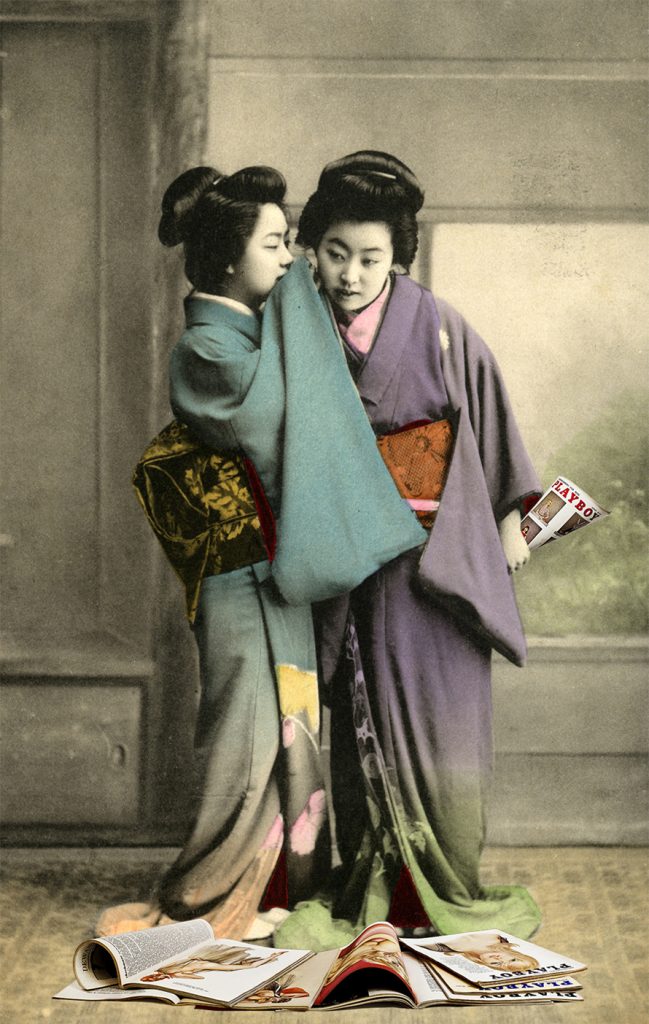
‘Between You and Me’
When you say on Panel can you explain this?
I mount my prints and images onto MDF panels that are fixed to a 50mm deep Tulip Wood frame.
Discuss the colour and when it was added if this is correct?
I do not usually play with colour too much on the East Meets West images. When you scan in the hand-tinted post cards at hi-resolution it picks out the ink colouring beautifully and when you enlarge a postcard to the size I do you can see how basic and inexact the touching up was. The hand tinting inadvertently adds another layer to the image and feel like the person doing it was my accomplice around 100 years ago?!
Why “Playboy” magazine?
The Playboy Magazine is key to the East Meets West series as it was the catalyst to the creative process
I had come across some vintage Playboy magazines at a car boot sale that were from the 50’s & 60’s. I was struck by the different tone and style to that of the modern day perception of Playboy culture. Whilst women and nudity played a role in the content of the magazine (albeit radically toned down compared to now), the first 10-15 years offered a far more cerebral and analytical approach to censorship, popular culture and the individual in society.
Hugh Hefner's regular editorial was made as a statement ‘The Playboy Philosophy’ in which he ‘spells out for friends and critics alike’ the guiding principles of the magazine. The opening paragraph in one editorial piece began.
“. we have discussed the importance of the individual in free society, the over emphasis on conformity and security and the need for revitalization of both our democracy and the free-enterprise system through greater stress on the uncommon man and uncommon endeavour and accomplishment.. considered Americas own puritanical heritage, the current sexual revolution and our societies search for a new sexual morality.. “
I felt the self-confident approach of Hefner and Playboy and it’s fairly uncensored and liberal attitude to sex and eroticsm was in direct contrast to the disciplined, restrained and serene nature portrayed in the Geisha postcards.
In fact although outwardly bold and liberal, inwardly the American culture is inherently conservative and orthodox, again a direct contrast to Japanese characteristics.
The montages I create in the East Meets West series are there to challenge and highlight these contradictions.
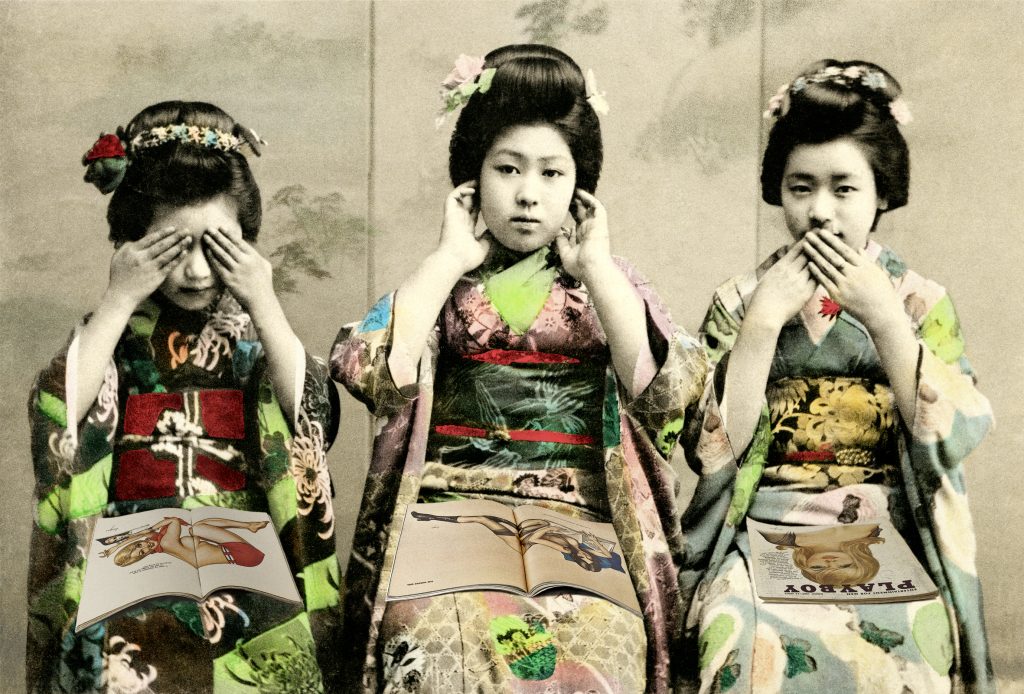
‘See, Hear, Speak’ in progress
Can you discuss your series ‘Bodymap’ and the similarities you have drawn between the human body and maps?
I had already begun collecting old maps printed on linen. I find maps fascinating and can spend hours getting transported into foreign locations that although real remain hypothetical in my imagination. I am a big fan of the artist Richard Long and his use of maps and nature to create a physical and mental response & dialogue.
I came across some 19th century anatomical prints or ‘plates’ that were from medical reference books of the time. They are a really compelling insight into the early days of anatomical research by physicians of the period but also beautifully drafted drawings.
I combined the maps and plates and created a montage that morphs into a ‘geographical anatomy’ showing how we use our physical anatomy as a template for our environmental existence. Arterial Road, River of Life, Heart of a City…

‘Body Map’
What is next from your ‘To Do List’?
I am very excited about the prospect of using Silver Liquid Emulsion and exposing some of the images I shot with a Japanese model onto previously applied layers of gesso, paint and collage. The whole process will take a few months as there are a number of layers all involving different processes. I am also looking forward to taking a break from my computer. It’s good to mix it up!

I also want to look at opportunities to collaborate or work in a new environment for a limited period of time. I am keen to visit Japan as I have yet to go there. I have always loved the work of film-maker Akira Kurosawa and how he influenced Western film-making and more recently the animation of Hayao Miyazaki. The writer Haruki Murakami has been a huge inspiration and the magic realism thread running through his work have directly influenced my ‘Fourth Wall’ and East Meets West series.
 ‘If Anyone Asks’
‘If Anyone Asks’
I have recently been involved in a project started by a collage artist, Zach Collins from Minneapolis, USA. He started collaborating with fellow collage artists from around the world by sending a ‘starter’ collage that you could choose to complete using either an analogue or digital finish. Two different artists finished the same original image sent by Zach. The result of him collaborating with over 100 hundred artists was the recent publication of a book ‘We Said Hello and Shook Hands’. The book records all the finished collages and compares two artists approach to the same starter collage. I would like to continue collaborating with Zach and other artists from around the world. It is both refreshing and insightful.

‘Gymnastics’
twitter@gavinmitchell16
Gavin Mitchell, London, UK
Interview by Deborah Blakeley, May, 2015
Lanny Bergner
When do you decide which of your work will be large pieces or installation pieces?
This varies depending on the exhibition venue. Sometimes I will do site-specific installations that are made for a particular space. At times I will do a series of small individual works, but given the opportunity I will turn them into an installation. This began long ago when I first started making suspended mesh works. I found that they could have a singular presence and they could also visually interact with one another. The Perelman installation is a good example of that.
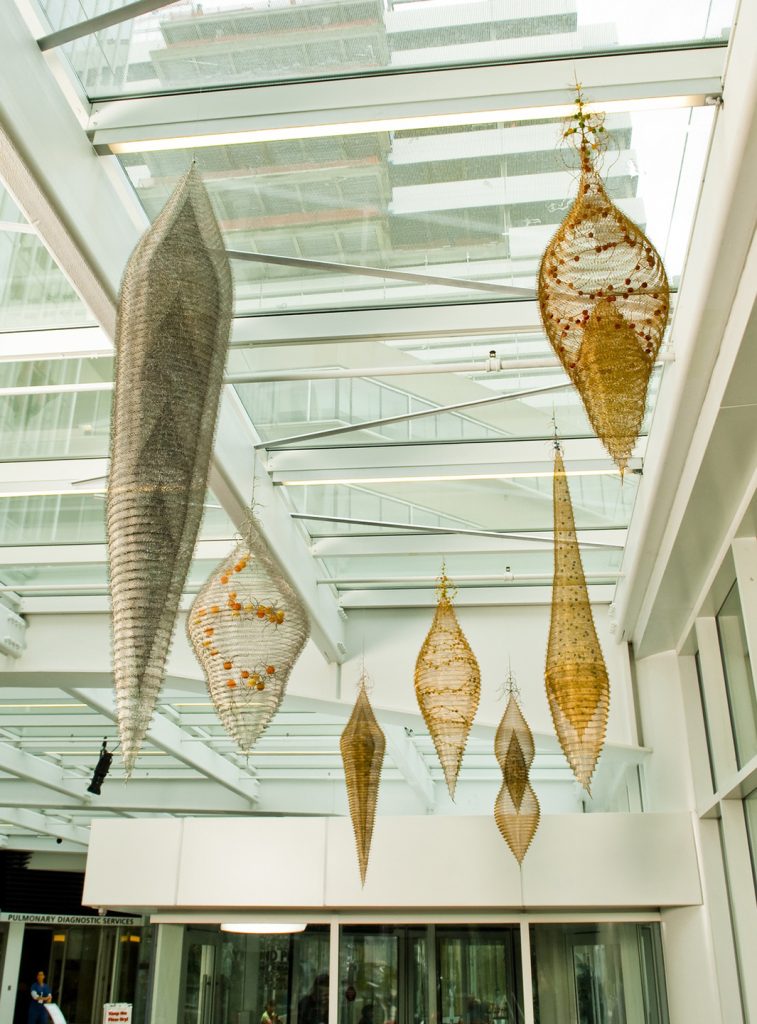
‘Perelman’ –Installation
Can you discuss the work and technique you used in your installation of suspended mesh at the Perelman Centre for advanced medicine?
The seven suspended pieces at the Perelman Centre were made as individual sculptures, but installed as an installation. The Perelman is a healthcare facility so the feeling I wanted the installation to invoke was one of healing and peacefulness.
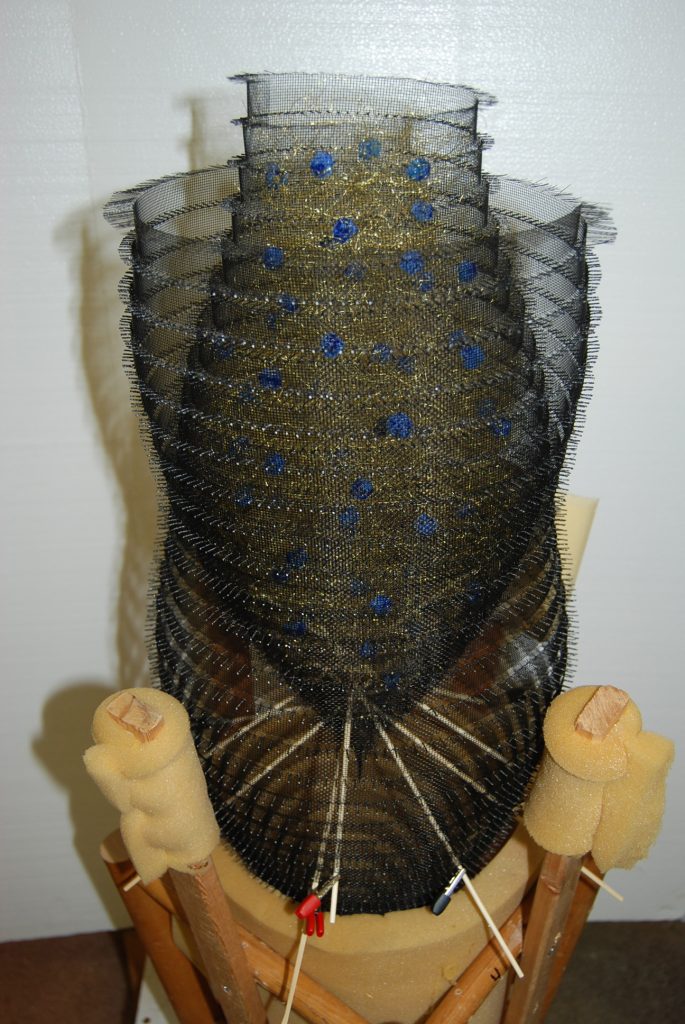
Twisting the frayed edges of long strips of aluminium, stainless steel and bronze mesh together with flat-nose pliers is how the pieces are made. They are all done in a spiral formation. Some of the pieces have loose frayed brass wire inside and/or vine-like stands of wire and tiny balls of glass frit and silicone. I exhibited some of the Perelman pieces before in an installation I did at SOFA Chicago (Sculptural Objects and Functional Art).
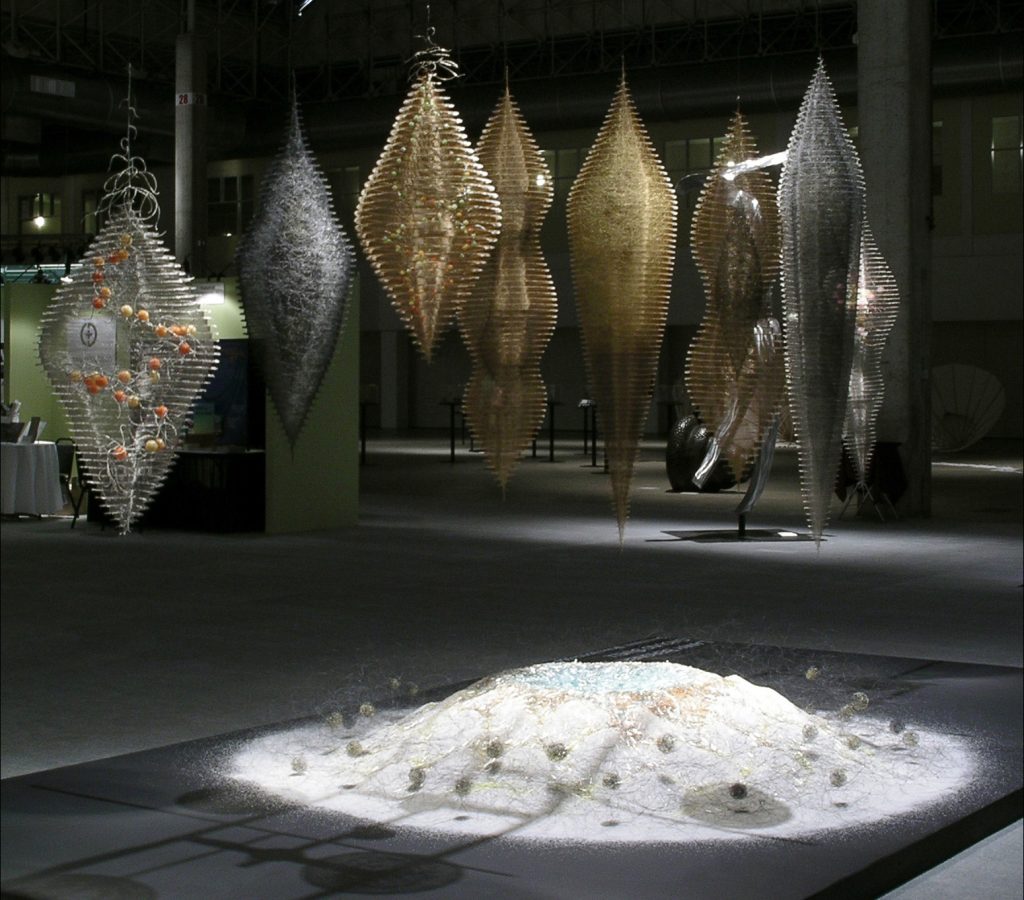
SOFA Chicago Installation: ‘Ground Swell’
You have work represented in Art in Embassies Program discuss the work and where it is?
“Primordial Vessel” is the piece being exhibited in the Art in Embassies Program. The painting/drawing on the mesh is created by flame-treating stainless steel mesh with a propane torch. It is being exhibited as part of a basketry exhibition at the US Ambassador’s residence in Tirana, Albania and will remain on view for the three-year term of the Ambassador’s appointment.
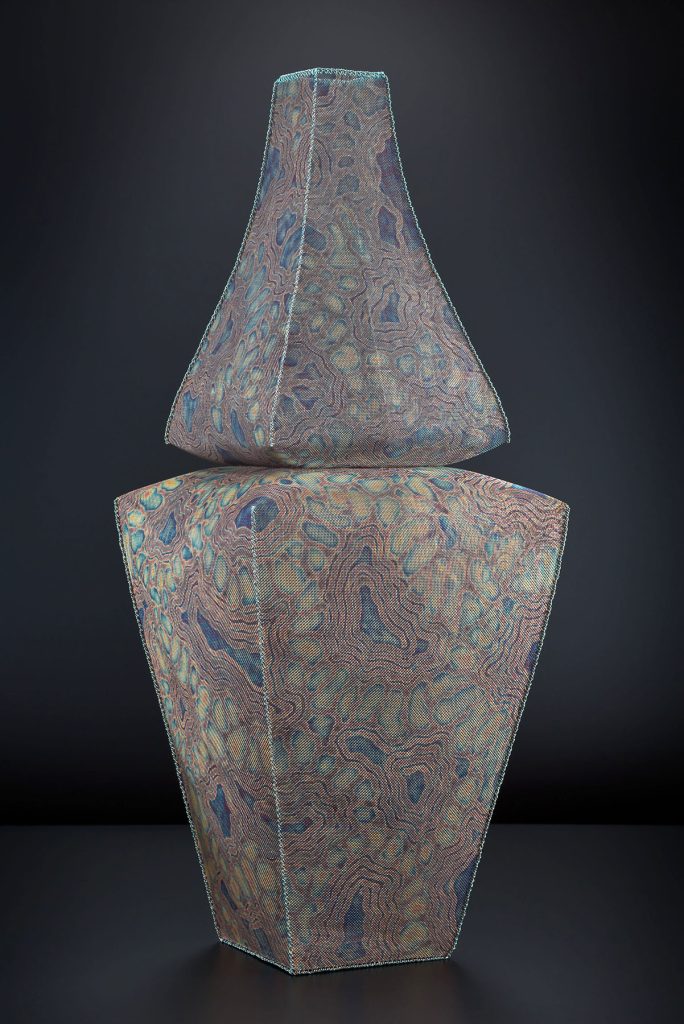
‘Primordial’
Can you expand on contemporary basketry and how it is being accepted in the current art world?
It is well accepted in the fibre art and craft world, but to a lesser extent by the “fine art” world. Basketry is pretty much a subgroup in the fibre arts, but it does have its own group of collectors and exhibition venues. There are overlaps of course and many times basketry is shown in broader fibre venues. Basketry has a long ancient tradition behind it and now artists and basket makers are using contemporary materials to create works. I came to the basketry arts by serendipity through sculpture (that is my formal university education) having received a BFA and MFA in sculpture. I believe this has given me a degree of freedom in my approach to basketry and art making. The basketry world has been embracing of artists who push out the boundaries of the medium and explore new approaches. There is much more cross fertilization going on in the art world today with contemporary artist using techniques and materials once confined to the fibre and basketry arts. This intermingling is healthy for all the arts.
Can you discuss the use of one district colour or colour group in your work?
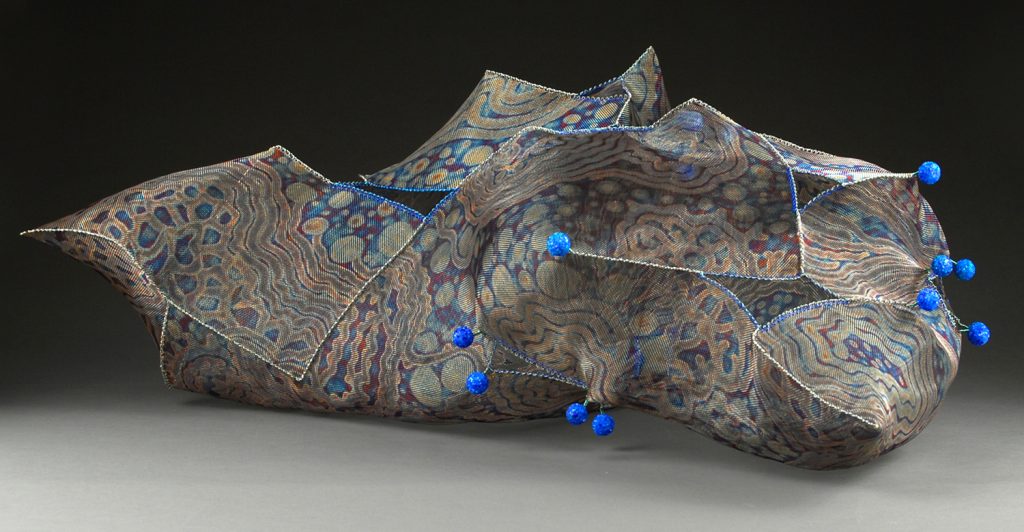
‘Ocean Deep’
Lets take “blue.” This happens to be one of my favourite colours and as it turns out, blue is one of the two main colours I can create while torch treating stainless steel mesh. The other is light to dark amber with the dark end almost a burgundy. So, these colours by default have become the main palette for the “flame painted” imagery on the mesh.
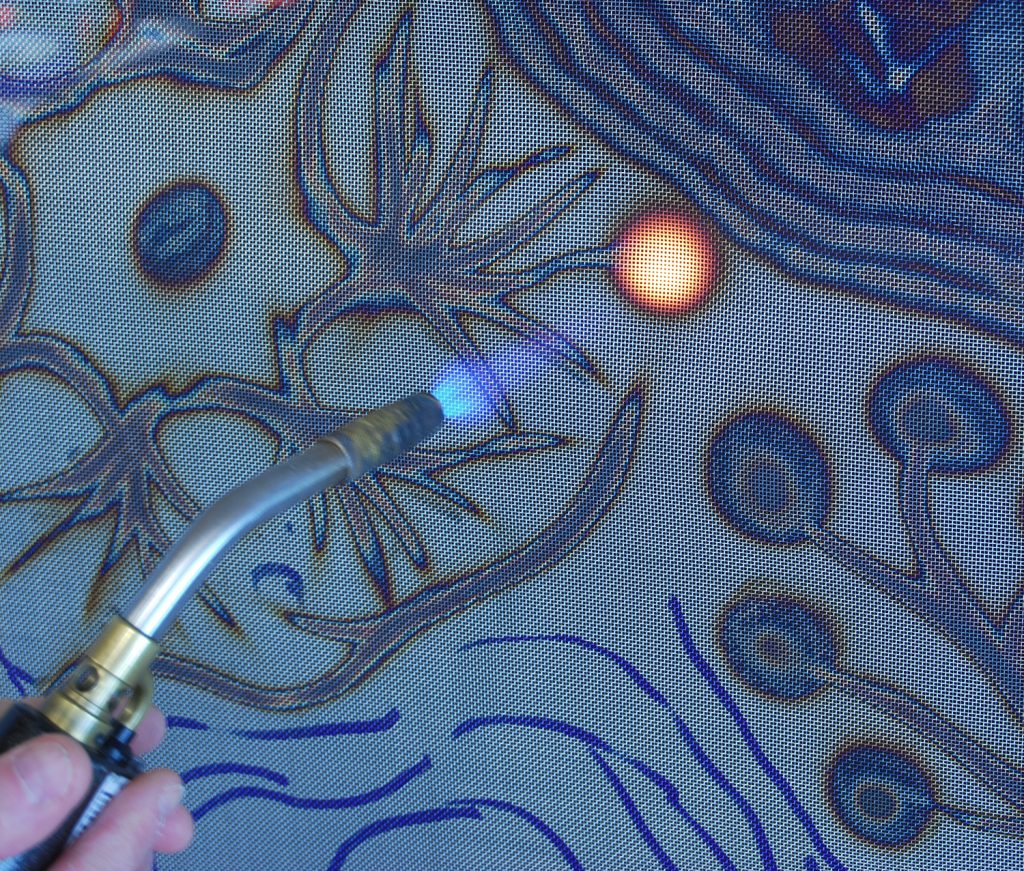
Flame painting
Explain the materials you use and how modern materials continue to fascinate and become part of your current work?
My primary material is metal mesh. I started out using common aluminium insect screening that I could buy at a hardware store. Now, I primarily work with stainless steel mesh. Stainless steel mesh is much more versatile for me because it comes in so many different gage and grid spacing types. This means I can work on a larger scale and create different types of forms depending on the mesh I selected.
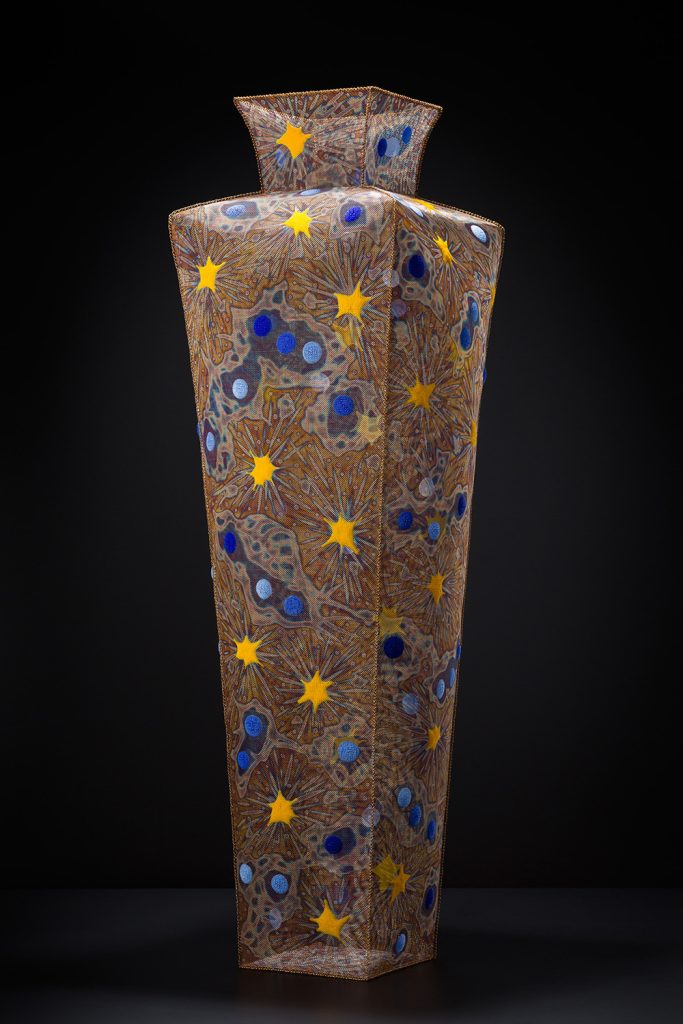
‘Celestial Vessel #8
I sort of accidentally come upon a material and then it gradually works its way into my artwork. That is what happened with silicone. I first used it as glue and then I began using it for visual effects. The most recent evolution of my use of silicone is mixing it with powdered pigment and then pressing it through the mesh and letting it dry. This has allowed me to add more colour to my work.
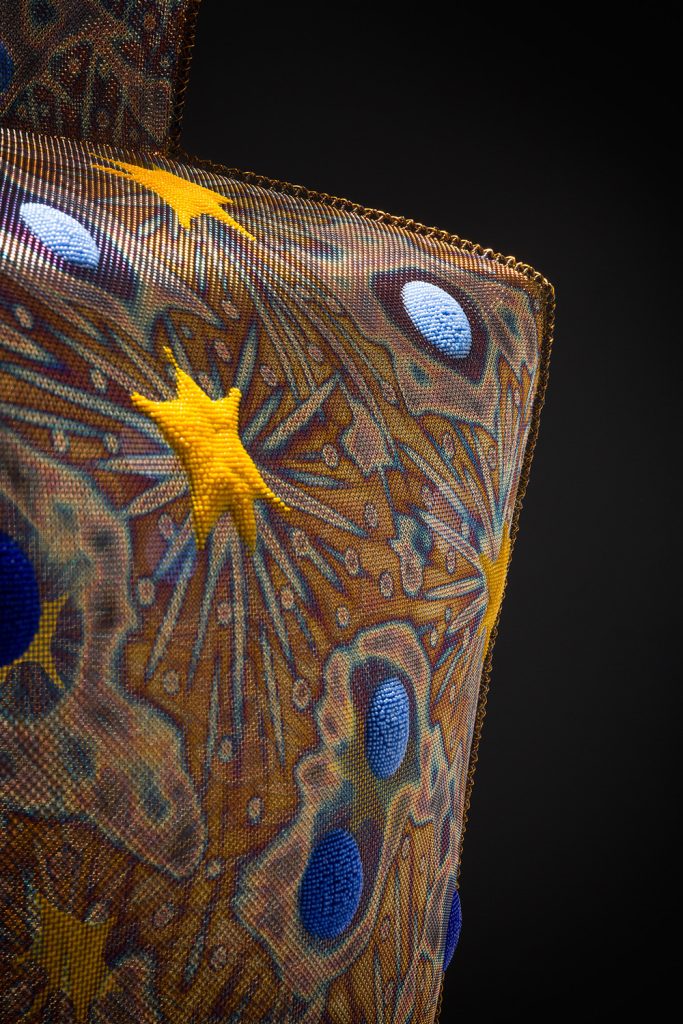
Detail of ‘Celestial Vessel #8
Explain how you work, where one piece is within another?
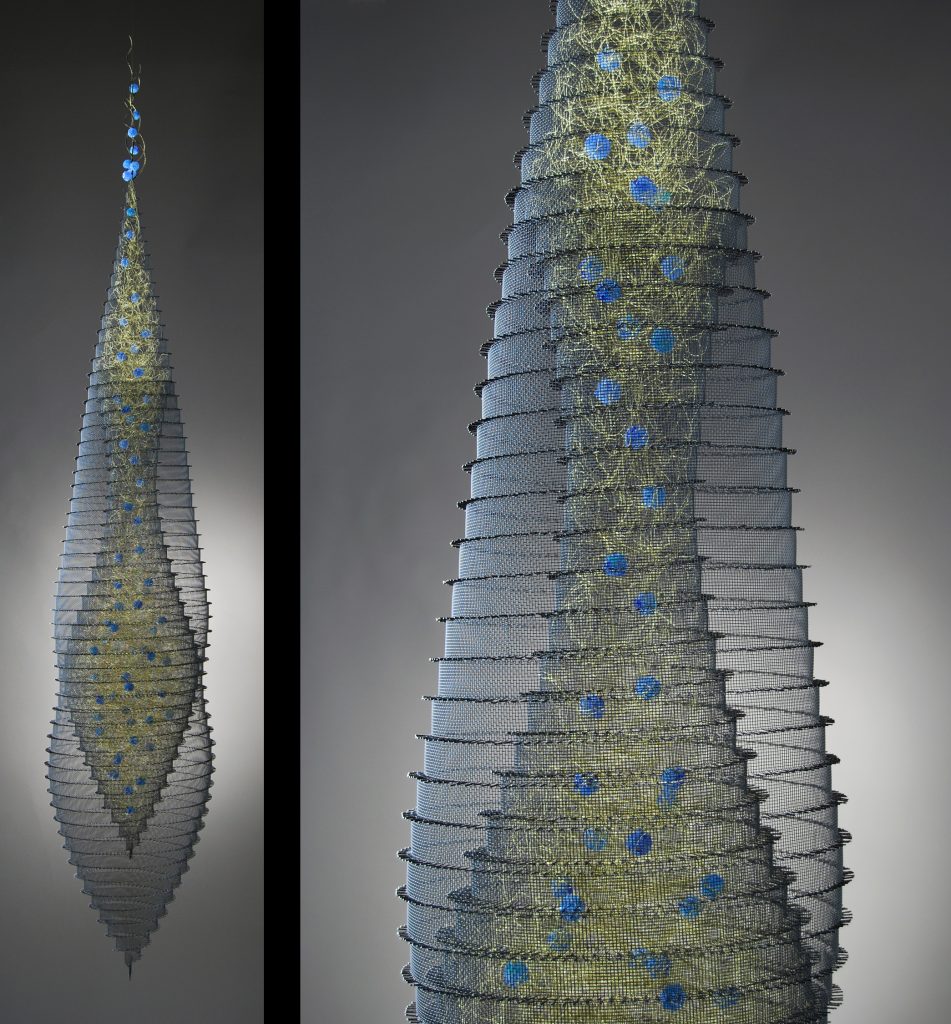
‘Blue Eliexer’
Several of my suspended “Pods” have interior elements. I first make the bottom half of the exterior casing. Then I make the lower portion of the interior form. When that form is high enough I attach it to the exterior casing. Then I bring the two forms up together and finally attach the two near the top of the piece. This is how “Blue Elixir” was made.
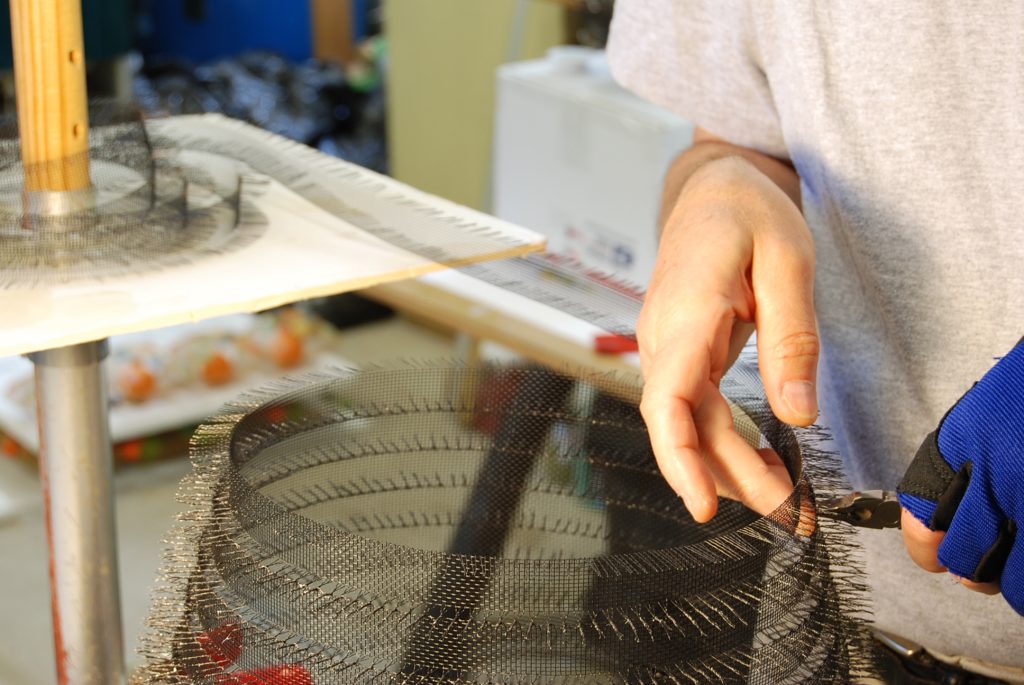
How important is lighting to the display of your work?
In some cases lighting can be very important. For installations I use lighting for dramatic effect and to bring out certain qualities of the mesh. In my “Primordial Muse” installation at the Whatcom Museum in Bellingham, Washington I worked with the exhibition designer to create a mysterious dimly lit display. We were able to highlight the shimmering blue light reflective quality of the mesh, making them appear almost like sheets of ice.
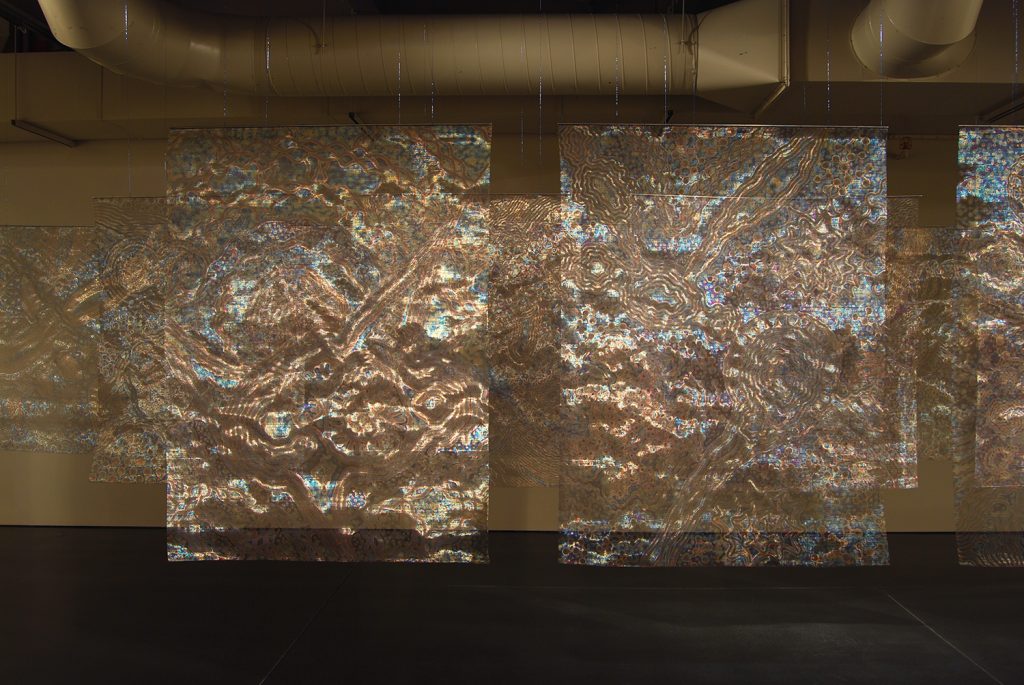
‘Primordial Muse’ –Whatcom Installation
Discuss your work ‘Life in the Universe’…
Inspiration?
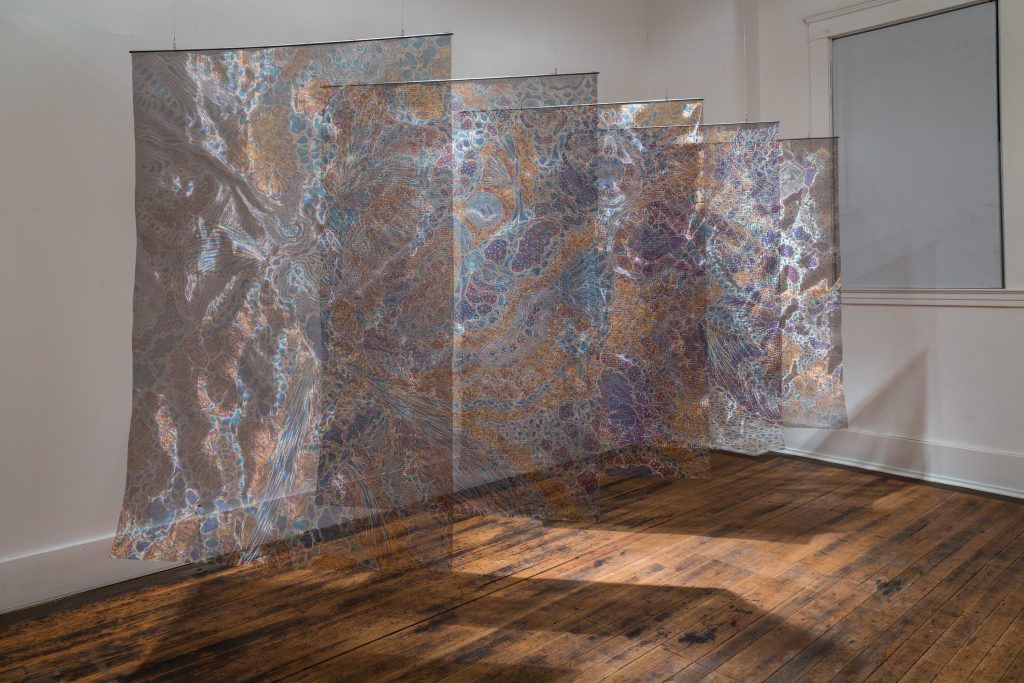
‘Life in the Universe’
The initial inspiration came from a book documenting the monographs of radiolarians by 19th century naturalist, Ernst Haeckel. The book “Art Forms from the Ocean” was a jumping off point for the imagery. The first body of work inspired by the book was the “Primordial Muse” screens. Further development of the imagery resulted in the larger “Life in the Universe” screens. These represent my musings on the infinite variety of life forms that must make up the universe. When I exhibit “Life in the Universe” or “Primordial Muse” I like to present them so the viewer can traverse the screens, as if they are being enveloped in the imagery. Colour? The colours range between grey, amber and blue. This is the range of colour I can achieve with direct torch burning on the mesh. How fast and close I run the flame over the mesh determine the colour and tone.
Technique?
The screens are torch treated using a propane torch. So, the flame is what creates the painting/drawing on the mesh. I did not do any preliminary drawing or use any templates to produce the imagery.
Size?
Each screen is 183 cm in height x 122 cm in width. I exhibited them with about a 50 cm space between the screens parallel to one another and set at a diagonal orientation to the wall. That way the screens partially overlap one another. Location? I exhibited them at the Anchor Art Space in Anacortes, WA and at Snyderman-Works Galleries in Philadelphia, PA. A single companion screen from the series is permanently installed at Emory Healthcare, St. Joseph’s Cardiology Clinic in Atlanta, GA.
How do you organize the hanging?
I let the room and lighting arrangement determine some of the parameters of the hanging. I’m not particularly interested in what particular order the screens are hung in.
Take three pieces of very different sizes and expand on them in relationship to size.
“Terra Un-firma” is a small piece made out of frayed charcoal aluminium mesh, various pins with coloured heads and some recycled ground plastic used for sandblasting. It fits in the palm of your hand and has a miniature asteroid-like appearance. The piece evokes a sense of intimacy, but at the same time gives the impression that you are gazing at a larger world through a distant lens.
“Celestial Vessel #7” is 154 mm tall; I wanted the form and scale of the piece to relate to the figure, with the vessel suggesting a human receptacle.
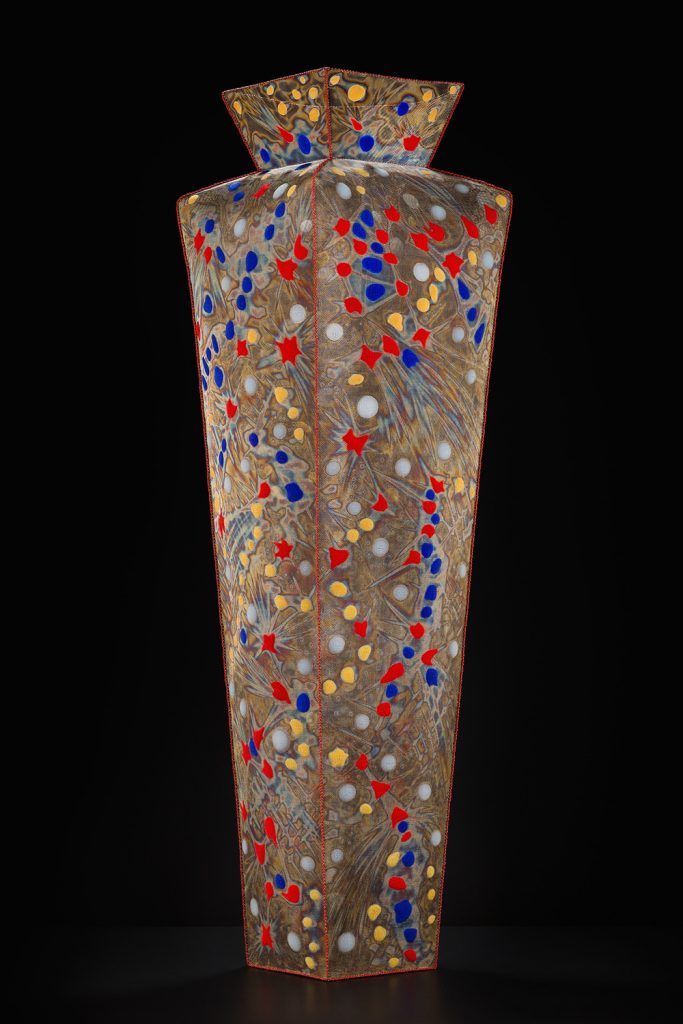
‘Celestial Vessel #7
“Above Earth Below Sky” is an installation I did for the 2007 Cheongju International Craft Biennale in Cheongju, Korea. The suspended black mesh piece is almost 2 ½ meters tall, so the scale is larger then human size. This too relates to the human form, but on a grander and more elevated scale.
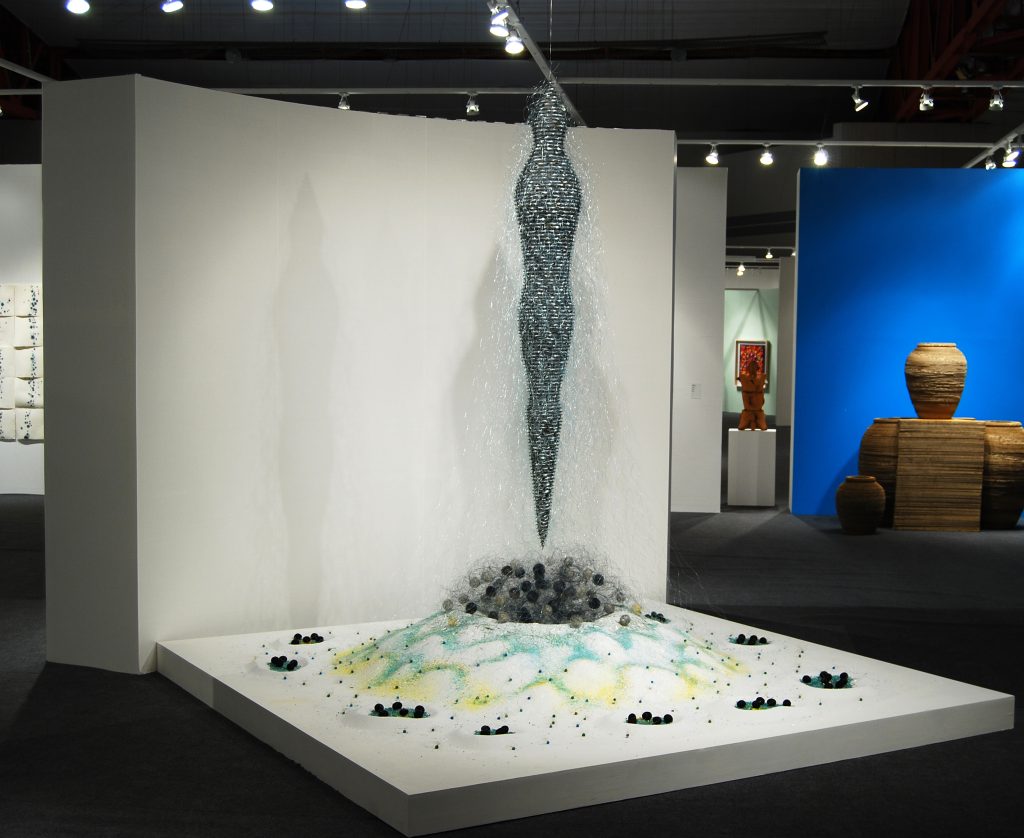
‘Above Earth Below Sky’
In 2016 you will be coming to Australia…
Explain how this invitation came about?
A workshop student of mine, Pamela MacGregor recommended me to Anne Kempton at Timeless Textiles in Newcastle. Pamela had recently come back from Australia giving her own workshop at Timeless Textiles and thought I would make a good fit for the program. Several months later Anne contacted me asking if I would like to have a show and conduct a workshop there.
Where and what will you be doing while ‘Down Under’?
The planning is still in the early stages, but I do know I will be spending time in Newcastle and hope to visit some other places in Australia, perhaps New Zealand as well. I wouldn’t mind finding an additional workshop venue “Down Under’, so something like that could help shape travel plans. There is a possibility my wife/artist, Eve Deisher, will also be exhibiting in Newcastle at the same time. If all goes well we both plan to make the journey and we hope to turn it into a business trip/vacation.
Where will people be able to see your work?
My exhibition at Timeless Textiles is scheduled for July 20 – August 14, 2016 and the workshop “The Art of Metal Mesh Working: Techniques and Process” will be held July 23-24. www.timelesstextiles.com.au
On a broader scale your work is in many public places can you discuss two pieces that are accessible to the public and why being there has given you such pleasure?
“Forest Sky” was a commission I did at the library in my hometown of Anacortes, WA. The library was built on the site where the old hospital used to be, which is where I was born. It’s even possible that “Forest Sky” is right above the location of my birth. I moved back to Anacortes in 1994 and I frequently visit the library and it is always a pleasure to see “Forest Sky” in the library’s entry lobby.
“Pattern Play” was a Washington State Arts Commission project I did at an elementary school in Snohomish, WA. The site is also a library. This is one of my favourite installations because of the enthusiasm of the school’s advisory committee and how they embraced the project. They even scheduled a daylong program where I met with each class to demonstrate how I made the installation and to answer their questions. I was exhausted by the end of the day, but it was a rewarding experience.
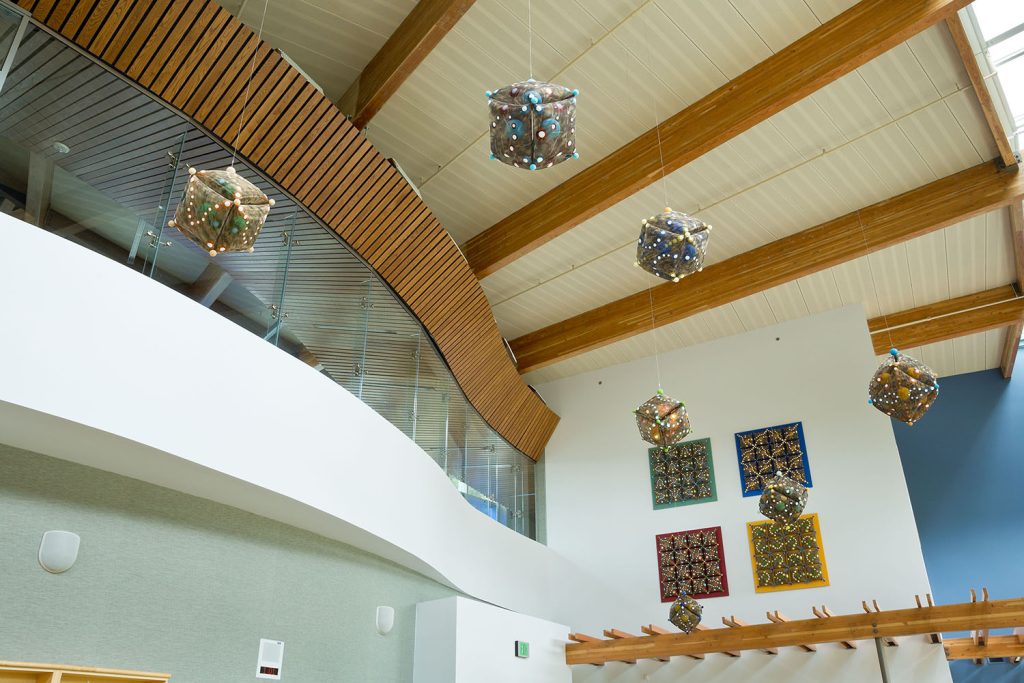
‘Pattern Play’
Can you give your thoughts on why Installations are becoming so well received by public galleries?
Installations are an exciting addition to a progressive exhibition program and they can transform a space into something wondrous. I believe this generates more interest in the gallery.
Contact details.
Lanny Bergner http://www.lannybergner.com/
email: lbergner@wavecable.com
Lanny Bergner, Washington, USA
Interview by Deborah Blakeley, April, 2015
Flo Snook
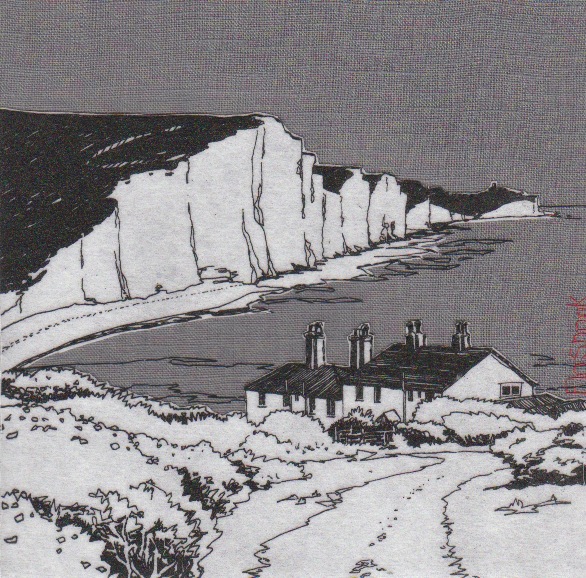
It is not just the sea but the influences made by man to the coastline e.g. piers, fishing cottages that are represented in you work, discuss.
I am fascinated by people's relationship to the sea. I love to observe how we live and work with it, how we try to impose our will on such a powerful force of nature, with the building of piers and sea defences, harbours and fishing ports, but ultimately it is Nature who will outlast us all. I often stay in a cottage by the sea in South Devon which is perched on the headland above the crashing waves, which I can hear as I fall asleep. This gives me a strong sense of the relentless power of water and weather acting on the rocks and headlands around me, and how temporal we are in the face of it.
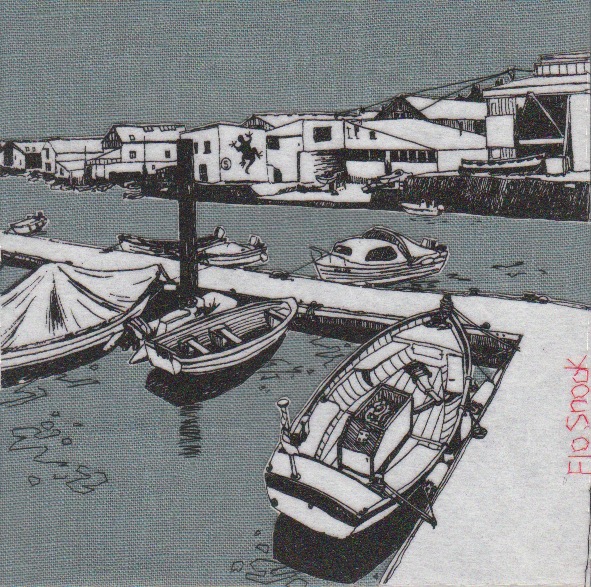
Can you expand on the ‘textile canvases’ and the technique you have developed?
It was while I was completing my Textile Degree in 1994 that I created my first textile canvas. I was also creating vibrant landscape paintings at the time, and I wanted to create a canvas with hand dyed fabrics that would stand up in it's own right as a piece of art, and not be dismissed as a 'wall panel' with little of the same value as a painted canvas. This piece was exhibited alongside my paintings in my degree show in the Mall Gallery in London. 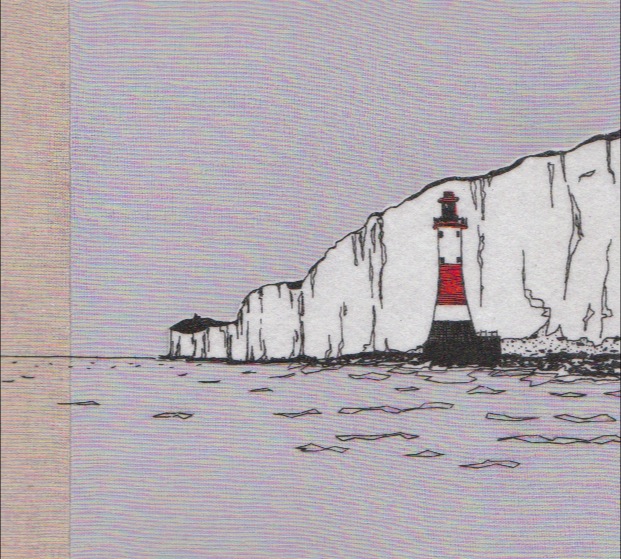 As my career progressed, I refined my style to a more restricted colour palette, using natural linens to express the colours I observed in the coastal landscapes. My starting point for each canvas is my sketchbook, where I create pencil sketches using the 'partial peek' method; I love the way it gives the drawings a fluidity of line as my eye travels around the landscape. I also take photos, and from these together with the sketches I create pen drawings to work from. At first I hand stitched and appliquéd all my images from these drawings, but this was far too labour intensive and I developed joint pain. So I began transferring the drawings onto silk screen so that the image can be printed onto white vilene, which I then appliqué onto the background fabrics, adding hand stitched details. This makes each canvas unique despite the printing process. More recently I've been framing my canvases in tray frames. This had added another layer of value to them and I've found that this has meant that they have fully broken into the fine art market. I am now selling in a London gallery on the Kings Road, Kensington.
As my career progressed, I refined my style to a more restricted colour palette, using natural linens to express the colours I observed in the coastal landscapes. My starting point for each canvas is my sketchbook, where I create pencil sketches using the 'partial peek' method; I love the way it gives the drawings a fluidity of line as my eye travels around the landscape. I also take photos, and from these together with the sketches I create pen drawings to work from. At first I hand stitched and appliquéd all my images from these drawings, but this was far too labour intensive and I developed joint pain. So I began transferring the drawings onto silk screen so that the image can be printed onto white vilene, which I then appliqué onto the background fabrics, adding hand stitched details. This makes each canvas unique despite the printing process. More recently I've been framing my canvases in tray frames. This had added another layer of value to them and I've found that this has meant that they have fully broken into the fine art market. I am now selling in a London gallery on the Kings Road, Kensington.
Explain your embroidered signature, both style and colour?
I've always been inspired by Japanese prints, with their simplicity of line and muted colours, but always with bright accents of colour here and there. They often sign their prints with a red stamp, positioned on the side of the image. It's for this reason that I always hand stitch my signature in red thread on the side of my canvas. Flo Snook is my maiden name which I decided to keep for my artwork, particularly because it is such a feature of my work, and it has to be said that Flo Scott just doesn't have the same ring to it and isn't so memorable! 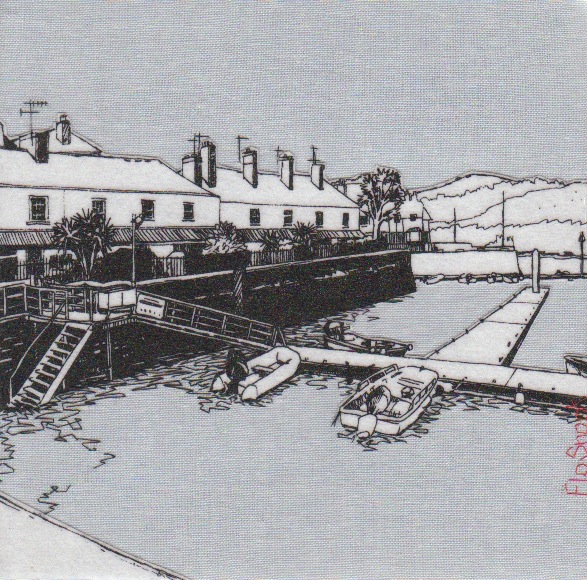
Is all your embroidery done by hand?
Yes. I embroider and hand-stitch once the canvas has been stretched on the frame. I've never liked machine embroidery - for me it takes all of the joy out of stitching.
Many of your textile pieces have two or more coloured backgrounds, explain why you use combinations and how you deal with the seam?
When you look out to sea, the colours are always changing. As clouds cross the sky, their shadows create varying shades and tones which I like to capture in my work, by sewing together strips of background fabrics.The more strips of colour I use, the more challenging it is to machine sew them together perfectly parallel and then stretch them on the wooden frame so that they remain parallel. I like this challenge. As I stretch the fabric, I make sure the seams are open and pressed flat against the frame.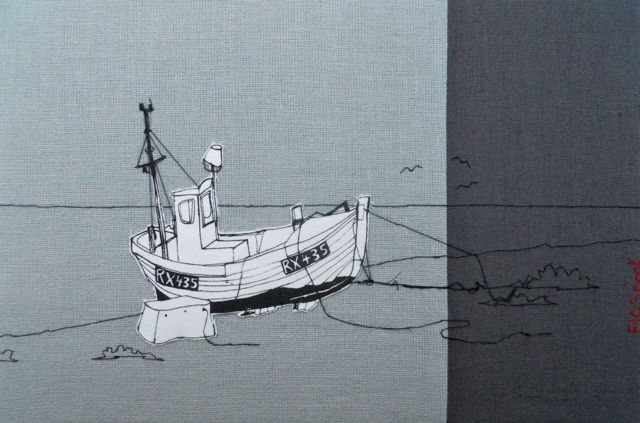
Your textile work, how is it mounted?
My canvases are stretched over a wooden frame (44mm deep) and then framed within a deep tray frame, giving each one depth and weight. I also create smaller textiles fixed to board, which are window-mounted and framed behind glass.
‘RNLI Salcombe’ discuss the use of red and gold in this piece?
I often like to pick out colours in the piece I'm working on to either draw the eye to the focal point or to let the eye travel around the composition. The RNLI piece was commissioned by the RNLI and I wanted to pick out some of the colours of the boat to draw the eye there, and make it come alive.
Your work is 'less is more'– discuss
I've realised that I am a very sensitive person and I find loud colours, busy places and clutter overwhelming. I often retreat to my studio when I find the world stressful and overpowering, in order to escape into the landscapes I create. I find it soothing to re-interpret the world I see into it's calm basic components. Perhaps I'm trying to re-educate the world into seeing the way I do? Perhaps I'm attempting to scrape away the layer of bling and overstimulation to reveal a way of honest simplicity underneath? I find our current capitalist society to be a delusional lie we tell ourselves; the belief that economic growth can continue at the expense of the environment indefinitely, is absurd. Nature will always win, and ultimately we'll need to curb our unrealistic consumer lifestyles and learn to live more simply. So I like to tell the story that 'less can be more'.
Your combination of printing and acrylic paint in ‘Brighton Pier’ discuss this aspect of your work and other pieces?
This was an exciting development of my work: I realised that I could paint with acrylic onto canvas to create a background on which I could silk screen my drawings. Although I've only created a small collection of these paintings so far, featuring Brighton and Dungeness coastal views, it's something which I'd like to expand on in future with my Devon and Cornwall work.
When and how did you introduce your accessary range?
It was through creating cushion covers initially that I found my style, so in a sense it was the accessories that came first. Over time however, I found it was important to me to be recognised as an artist, with the focus on my canvases. But occasionally I enjoy creating a useful 'product' that is more affordable than a canvas and makes a good gift for weddings and other events.
Tell us about your coastline linen cushions?
I created a range of cushions which depict the coastline (literally) of the UK in 2012, the year of the Queen's diamond Jubilee. I wanted to express something very British in this cushion design, so each one has a panel of patchwork with suggestions of the red white and blue flag. The coastline itself is silk screen and I hand embroider my name on the side of each one. These cushions have been popular with expats and look at their best with a feather filler.
On your mugs, again you have used your signature to bring a smile, expand on this, especially the placement?
The mugs were a collaboration with interior designer Terri Prior who owns the shop 'One In The House' in Brighton. She wanted to create a couple of mug designs that would be popular with tourists and with people with a strong connection to Brighton. In Brighton we have two piers; Brighton Pier (formerly called 'Palace Pier') and the West Pier, now sadly collapsed and burned down, a mere skeleton of it's former self, but which is still a very strong local landmark. So I created a pair of mug designs from drawings of both piers, with red accents on the flags. Terri decided to put my red stitched name motif on the inside of the mug to add character to the drawings and to catch your eye as you drink your tea!
Sketch books play a huge part in your art practice discuss….
The size of the sketch books you use?
I use a range of sizes. For carrying around with me when I'm out sketching, I have a small hardback book. For a majority of my pen drawings I have a 20x20cm sketchbook that I keep safe in my studio, these can be scaled up for canvases up to 40x40cm. For commissions I often use an A4 sized book or A3 depending on how big the drawings need to be. When I created a textile canvas of the West Pier for Zoe Ball and Norman Cook (aka Fat Boy Slim) I used a large sketchbook for a large more detailed drawing. 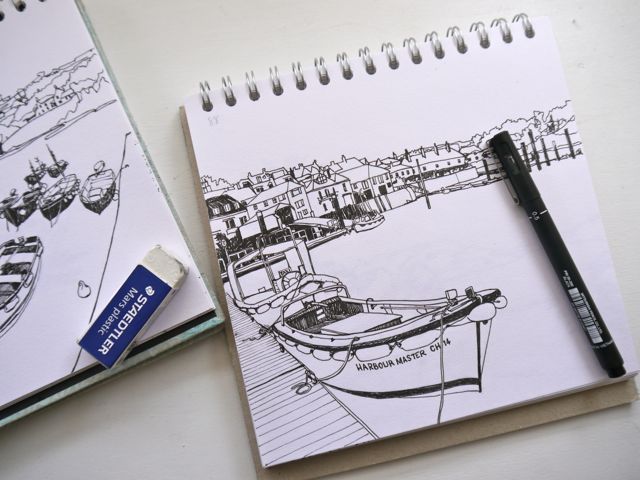
Do you take a new sketch book for each location?
That's probably a good idea! No I usually carry on with the same book.
What materials do you draw with in them?
I'm not fancy. All I need for sketching is a good 2B pencil, a rubber and scalpel for sharpening my pencil. For my pen drawings I have a range of 1-8mm pen nibs.
On the top left hand side you have a numbering system, can you explain this?
Ha ha! You noticed my code system for referring to the photos I took of the same view which I refer to when drawing in pen.
Discuss the importance of the environment in both your work and the materials you use?
I am a big campaigner for protection of the environment and for raising awareness of better ways of stewarding the land and sea. I am also a Permaculture Designer (see my other website www.permaculturedesigner.co.uk) and I like to apply permaculture to all areas of my life. It is a design system that attempts to mimic nature so that we can live in harmony with our biosphere. For this reason I prefer to choose natural fabrics that have less damage to the environment in their production as compared to some cottons and artificial fabrics, and where possible I use up-cycled fabrics too. For a time I found an organic white cotton with a very close weave that I could use as my appliqué fabric, but unfortunately they stopped producing it, so I'm back to using Vilene for the time being. Felt would have been a good replacement with less of a 'footprint' but I found that it didn't give me the crispness of line that I wanted. I use FSC rated wood for my frames and have used water based inks for my prints. In my work the environment is everything. By continually drawing the land and sea, I am falling into a deeper and deeper relationship with my beloved island, and I hope that I can draw the viewer into a deeper relationship with it too. The more we develop a connection to the land and coastal areas, the more we care for them and protect them.
You are very generous with your art work to charities can you expand on one of these?
I am currently holding a silent auction to raise money for Parkinson's UK with three of my paintings. I'm conducting the auction by email and through Twitter and Facebook. Sadly my father passed away last year after 8 years of living with the disease and Parkinson's UK were such a supportive charity to us during that time that I wanted to say thank you and give something back.
Can you explain the importance and recognition of textiles in today’s art market?
I feel it's really important for textile artists to be accepted as artists in their own right and not pigeonholed into the crafts market. It has taken me years to build up recognition as an artist just because textiles has been my main choice of medium. Last year I applied for the Brighton Art Fair, and I was accepted (as an artist) and I exhibited in September. I had applied for this art fair in the past, only to be told to re-apply for the craft fair, much to my dismay! I noticed that there were many other textile artists now exhibiting at the art fair also, so I am hoping that this is part of a trend of welcoming textile artists into the art market. This is great because textiles has so often been undervalued in the past, but now it is holding it's own.
Contact details.
www.flosnook.co.uk
studio@flosnook.co.uk
Flo Snook, Brighton, UK
Interview by Deborah Blakeley, April, 2015
Vicky Forrester
Can you briefly explain the techniques you use to create an original piece from sketch book to completion?
I’m quite playful in my approach to developing new pieces. Sometimes I’m inspired by the behaviour of a particular material, and I look for ways to exploit it. Other times ideas can evolve through extended experimentation with a particular technique.
'Mystery'
In either case, beneath this process-led practice there is always a conceptual undercurrent that informs the outcome. This undercurrent is a distillation of all my experiences - thoughts, desires, feelings, perception – but especially strong for me is a connection with the elements, and my jewellery always alludes to natural form.
Cuffs
The development of the Siren Neckpiece is a good illustration of my working practice.
It’s a project that came about through taking the challenge to experiment with new technology - Computer Aided Design.
I was curious to explore how CAD might deal with my essentially organic aesthetic. I joined a course to get to grips with the technology, and while I had anticipated I would end up producing a model ready for rapid prototyping – thus the fear of putting the maker’s hands into early retirement - actually I was surprised to realise that my resulting design would be far better made in the workshop using traditional means.
The process itself – designing in Matrix - resulted in my creating a piece of fine jewellery that I wouldn’t otherwise have envisaged and I’m impressed to be able to view and show the piece accurately from every angle through 360˚- before it ever gets made.
I was interested to find that when designing jewellery with CAD you must already have a good knowledge of subject-specific materials and making processes to be able to factor in the quirks of materials and processes eg understanding construction techniques, the impact of scale, and all the tolerances required.
The Siren Neckpiece began with a family day out to Margate. The daytrip provided great inspiration for my CAD Project.
I was interested that the Shell Grotto in Margate has no known beginning though many stories abound. Discovered accidentally in the 1800’s, it became a popular Victorian attraction and the lamps they used to light the underground passageways produced soot that has inhibited the carbon dating process. It has been suggested that the Phoenicians built the grotto 3000 years ago, to worship the Goddess Tanit – hence also the locally named ‘Isle of Thanet’. But perhaps it was a Victorian Folly, or a Pirate’s treasure store – or maybe even a Siren’s haunt!
Using these thoughts, experiences and images as source materials I looked to develop some designs that I could explore using CAD….
I’m pleased with the final outcome; the Siren Neckpiece still maintains some fluidity of the organic approaches I would normally use – it can sit comfortably amongst my existing pieces - and I’m interested to find that through the choice of materials it has tipped me towards a fine-jewellery quality that I have not previously explored.
Expand on the importance of ‘one off’ pieces in your work?
When I explore a technique or material I’m particularly interested to understand how the protocols of that medium can be best exploited to make something that cannot be easily made in another way. So for example, with my growing understanding of CAD, now I see that it is less interesting if used to design an object that might be equally well carved in wax; it’s pretty cool as a rendering tool for showing a 3D experience of your intended design, but it gets really exciting when you develop very complex 3D designs to output using the ‘sintering’ process, where a laser passes through gold dust to make solid your dreams!
So, in relation to my preference for making one-off pieces of jewellery (and small batch production runs), my mind is always working in this way, seeking out new and better ways to exploit the chosen medium and technique, to more precisely express my intentions. Thus each piece I work on is an evolution of the last. For me this interaction is important. It runs counter to the tide of popular jewellery/craft/design culture that now encourages ‘production’ with a more/cheaper/faster approach. I think my clients enjoy that the pieces I make for them are unique.
It also requires an element of trust from my clients. If you see a coral ring that you like on my website, I can make one for you. It can be similar, but not the same, because I must sculpt it in your size in wax before casting it in your chosen metal. I will need to interact with you; you can guide me towards a preferred characteristic and I can put love into the making of it because its materialisation is not some hands-off series of standardised processes that get us from A to Z. It will inherently carry with it the accumulated knowledge and experience of every coral ring I have made before it. It will also be an expression of the maker thinking about you. It will be uniquely yours.
‘Totem’
I find an interesting challenge in the use of technology where it’s inherent nature leads to multiple production. I’m not averse to exploiting this character to further explore a theme – as with my Totem collection.
In this instance, the concept evolved from thoughts of the body, our bone structure and movement. Early pieces were an expression of this articulation; a long column of links became an external vision of the spine; conversely pulled straight by gravity the column causes an exaggerated view of the body’s movements. Each of these links was made by hand and so it was a slow process to develop the concept. Laser cutting provided a means to create multiple units that I could then use to explore new assemblages, hence ideas were able to evolve faster, and in new ways.
You gained your BA Hons. In silver smithing in 1990 what stands out now, 14 years later that you wish you had either learnt or appreciated earlier?
My years at college gave me the freedom to lose and find myself; In discovering that there are no rules to the creative process my ideas became free and flowing, but I think perhaps I was prone to taking life a little too seriously. I hadn’t yet understood that I was allowed to play, and I could have spent more time just doing rather than thinking about it. I came across a quote the other day (courtesy of my favourite Yogi tea) that would have served me well at that time: ‘Stop playing serious and seriously play.’
‘Embrace’
You describe your work as Powerful, Precious, Playful can you expand on each in relation to your work?
Jewellery is magic! When worn it becomes a powerful entity that can instantly transform your mood and your energy levels. It’s also a powerful communicator and so much can be expressed through (and read into) in the kind of jewellery you choose to wear.
‘Spirit Ring’
The notion of preciousness goes beyond material; it describes the relationship we have with our jewellery. Jewellery becomes precious only when we choose to engage with it and for me it’s about it’s history intertwined with your own story. It’s such a personal experience.
I love that it has this ability to transform the wearer and in my jewellery designs I like to exploit this element of play. I seek ways to create versatility in my pieces so that my audience will find numerous ways to wear and enjoy them.
Explain about your ‘Mark’ on your jewellery?
Design
Seeded in nature – the world that engaged me through childhood - my curiosity has always found creative expression through physical form. The tactile and physical elements hold equal importance to the visual. My ‘mark’ is an articulation of the ‘now’ – my current perspective formed as consequence of all accumulated thoughts and feelings – in relation to those ‘natural’, “tactile’ and ‘physical’ undercurrents. Because the creative process is a narrative of my experience (thoughts and feelings, fantasies, realities, my joyous moments in life) this affords me freedom to explore simple and complex ideas, to make drama, all-show pieces, and quiet, powerful pieces too. Over 30 years this has lead to the emergence of 6 distinct collections, each one answering to a particular intention, mood or desire. Distinct and yet distinctly related, I continue to develop new work for the collections as I am drawn to explore these same themes from ever evolving perspectives.
Importance and the meaning of the Mark on jewellery?
A walk through any museum will show you the importance of jewellery in deciphering our history, back to the most ancient of times. Materials, techniques, concepts – all record the evolution of our species, since the beginning of our time. Humankind has always held it precious, hence it survives as a record keeper of our stories, our values, our relationships, how we lived, where we died. It’s an unparalleled communicator. This most ancient of art forms continues to fullfil our primitive urge to express, empower, protect.
‘Joy’
With this perspective then, as makers of jewellery we have the capacity to engage with humanity on many profound levels. Through our personal mark we are in a position to add our unique voice to this conversation. Fired with the maker’s intentions, our jewellery becomes invested with palpable energy, meaning and value that can carry information far into the future.
Where do you go for your inspiration?
Actually I think all my daily experiences, even the most mundane, seem to find ways to influence my ideas; I’m not sure it’s possible (or desirable) to turn off the creative or curious mind, once engaged?
But my ultimate battery-charging, spirit-lifting, soul-feeding place to go is the seaside. I have strong family connections with the south west coast of Ireland and west coast of Scotland and most of my formative years were spent in one place or the other. The tides, like a breath, wash the city grit from between my ears. In, out, to the end of time. Scrambling across incredible rock formations to find rock pools teaming with jewel-like life-forms; palm trees and gorse beside golden sandy beaches, crystal clear waters, wind in my face, pockets full of stones…. Up from the shore, the damp-sweet smell of bog myrtle and bracken, raspberry picking along the hedgerows…home to family. Happy days!
My camera is an all-the-time essential tool that I use to capture, record and document the interesting moments in life. Before the camera, experiences were committed to memory, and I visit them frequently when my eyes close. Now they’re all on my phone-camera. I hope it’s not making me lazy.
Tell us one or two special story / stories of a piece you have made on commission?
I love the collaborative challenges of working to commission; It begins with a jumble of fragments, and between us the client and the maker must conjure them into dazzling solid form.
Usually the client brings an ephemeral element - a wish, a passion, a story. Often there is a physical element – a precious stone, an unwearable inheritance, a preference for material. The third element is the maker’s aesthetic. All of these ingredients must be drawn together, mindfully working with the material, it’s behaviours and the processes required to transform it. Metal is an endlessly forgiving material to work with; it yields sonorously to the hammer, can be pushed, scraped, filed and polished into form, or entirely transmuted through fire to a new vision of beauty. I like that the process often begins with recycling. A broken chain, an heirloom ring, all are given a chance to become something new, to live with relevance!
Here is a constant reminder of the transient nature of all things. I hope that my creations will be enjoyed and treasured, that they will be lovingly passed from one person to another with an endlessly expanding story. However I must accept that one day a new owner may give more value to the metal than to the form I have given it. The narrative of its changing form may be carried on through generations, and perhaps also at a molecular level there remains an ionically- bonded memory between the metal and it’s long history!
‘Flowing Ring’
Flowing Ring, recycled from the client’s unwanted 18ct white gold jewellery. The old rose-cut diamonds, also inherited, came from a beautiful and dazzling tiara that had no place to shine in these modern times.
Discuss your Medusa Range?
Inspiration
The first pieces I made in this collection were inspired by ‘material’ – I loved how this fabulous chain coiled and twisted, and I looked for ways to exploit this behaviour.
'Rattlesnake’
Subsequently I came across this woven leather cord and it provided a means to create more structured forms that could defy gravity or wrap the body. By adding sterling silver elements to my structures this gives sharp contrast to the soft appearance of the leather, meanwhile also suggesting latent power, perhaps a little dangerousness to the resulting pieces.
The name ‘Medusa’ derives from ‘metis’, or sovereign female wisdom. I chose this name for the collection because I found these pieces seductive, and hypnotic. As the collection grew I sought to understand this primal connection. Unlike the image portrayed of Medusa, I felt empowered by my snake-like forms, and so I sought out her deeper secrets… The story of Medusa as told in Greek Mythology is a neat exercise in the subjugation of female power, and her story, pertinent as ever, echoes through the centuries and through every culture. A woman is ravished because she is too beautiful to resist; on discovery, she is blamed for her beauty. She is cast out as temptress who must be punished and she is eventually slayed. In naming this body of work ‘Medusa” I look beyond the traditional mythology of the snake-haired, petrifying gorgon to reclaim her roots as Snake Goddess, who’s beauty is her soul. Powerful she, who holds in her hands the timeless cycle of life.
On photography
Photo by Rowan Papier
When I photograph my work I tend to take quite neutral shots that try to show the sculptural element of the pieces. Sometimes, as with this collection, this isn’t enough. These works needed to be seen in context, and I gave the photographer free reign to portray the Medusa collection as he felt inspired. I love this raw, charged imagery that he produced. The model, his muse, has an intense energy that draws parallels with Barbarella and the feminist view of Medusa (female rage) all at once.
Dressing up or Dressing down
Of course, not everyone who wears the Medusa Neck wrap chooses to make this, along with well-drawn smoky eyes, their only item of attire!
The playful element is an important aspect of this collection, and each piece can be worn in as many ways as you want to try them. The medusa ring can be worn as one coil on the thumb, or twisted to coil across 2 fingers for a more dramatic look. Or perhaps you need a little something to hold your scarf in place. I twist these Medusa pieces into my loose-knit jumpers too.
Discuss in more detail ‘Medusa Arm Wrap’
The Medusa Arm wrap has a similar versatility; Stretched out the piece of leather is almost a meter in length, so the multiple coils can be used to give three-dimensional structure, or to coil around any part of the body.
Discuss Helix and the inspiration of this work?
The Athene collection also explores how coils can be used to create structure. In this instance the collection was seeded from exploring ‘process’. Using binding techniques I wanted to create forms in silver that would be light and structured, that would also respond well to the body’s movement. Spirals and tendrils seemed to be a natural outcome to the slow process of binding, (hence Helix) and through experimentation I began to understand how the desired three dimensionality of form could be dictated by working around a shaped, internal framework.
I chose the name for this collection because Athena was known as both warrior and weaver. The pieces evolve through a similar repetitive process, creating structure and dimension from threads, and the final outcomes seem to me fierce and proud.
‘Athena’
Your piece the ‘Venus Rose’ has been designed to be worn in different ways. Discuss the importance of the versatility of piece.
It’s actually quite some challenge we jewellers face to make an item of jewellery that absolutely anyone can wear. Before we even touch on style and preference for a ring, necklace or cuff we must pay attention to the dimensions of wearer. ‘Average’ measurements, as with fashion, are never accurate enough for a well fitting neckpiece, and so in the Venus Rose I wanted to explore ways to make it so that could fit anyone.
‘Venes Rose’ (desire)
The solution I found was to weave the thorny form in one long length, thus creating a wrap that can interlock at any chosen point. In the process the piece becomes ever more versatile so it can be worn high as a choker or loose, more like a collar, depending on the clothes you want to wear with it. And of course being a single length of woven material, it can be used to wrap around any part of the body!
How do you think jewellery should be documented by the owner?
Jewellery should be purchased for wear, should be worn and enjoyed, and passed on with love. I like that jewellery is held most precious for the story it carries; certainly it grows richer, gathering a new kind of energy as it lives through the experiences of the wearer(s).
My Great Aunt left little notes in the boxes of the jewels she felt to be precious; other items held their value in Chinese whispers, though time (and the internet) often revealed another story, certainly in the case of the treasured Lake Como pearls that in years proved flaky and faux. Perhaps she had meant: ‘from the pearl of Lake Como’ and not ‘pearls from Lake Como’ as we had understood it!
What details should be recorded for future generations or owners?
Of course, the hallmark tells a small part of your jewellery’s story – the maker, the date, the place of making, the type and quality of metal it’s made from. The living history – myth and fact interwoven – holds the greatest room for mystery, intrigue, delight. Where does your mind go at the mention of Kohinoor? Passing on the stories behind a piece of jewellery will always have the greatest relevance. Queen Victoria had the Kohinoor’s original rugged beauty cut and polished into her vision of beauty. Only the ‘now’ owner knows the true value of their jewellery regardless of the perceived material or historical value. Ultimately if they don’t like it, if the story feels irrelevant, they may have it melted, just as so many of my clients’ commissions have begun, to be re-fashioned into something with greater personal resonance. This leads me to embrace the ephemeral nature of all things; everything worldly is a constantly shifting arrangement of the same atoms and molecules. As a jeweller, I am pleased if somebody can enjoy my various atomic arrangements. But it’s only ‘now’ matter. Tomorrow it could be transformed into someone else’s dream.
What lead you to opening Flux Studios?
My own journey into becoming (and surviving as) a jeweller gave me insights into the challenges and pitfalls that you must face when first setting out as a maker. It’s not an easy commitment to make, and I applaud anyone who makes that tough decision to follow their creative path.
I’m a big advocate for adult and community education, especially in the creative field; it provided me with a route into finding my passion for jewellery, and I know first hand the many benefits that result, on a personal, social and communitywide basis. For this reason I have always held the teaching element of my working practice as a vitally important link in my creative activities. In 2008 I decided to take a leap, to leave a part time teaching post and to use the redundancy money to set up a studio where I could marry these two major influences together. My aim was to produce my own work, and to provide a fully equipped working environment where other jewellers could develop their practice in a supported, mentored, community environment, and where I could continue to offer classes and courses in jewellery for the local community.
‘Peace’
Flux has proven to be a very successful model, and there’s a real sense of community here that has taken on it’s own inspirational dynamic; although the business is fundamentally mine I describe the activities and achievements here in terms of ‘We’ and ‘Our’ because without the willing participation and generous contributions of the people who use Flux Studios, it could not exist.
How does Flux operate?
Flux Studios is a specialist jewellery studio and jewellery school combined. Our remit is a simple one – to provide a platform where expertise, enthusiasm and the open exchange of ideas combine to inspire creative genius! In practical terms this means:- We provide opportunities for people to explore and expand their creative potential using jewellery as a medium, through jewellery classes, courses and workshops. We provide a dynamic studio base for aspiring jewellers to explore their business potential and achieve success, offering a fully equipped jewellery workshop, extensive library, mentoring and support network, learning and teaching opportunities as well as exhibitions and promotion – all through our membership scheme. We achieve a unique dynamism in the Studios by integrating classes and workshops in jewellery-making alongside professional jewellers who are carrying out their activities to develop their business. In this way students are inspired to develop better skills, and the professionals develop their communication skills and gain feedback on their work as it evolves. Audiences are developed and skills and knowledge shared.
Combining a teaching environment with a professional working studio Flux has a skills pool that makes the whole far greater than the sum of its parts. Because we are small we can focus on the unique individual need, inspiring people to achieve excellence. In providing a home to both aspiring professionals and the interested public we have evolved a holistic creative studio environment where the individual skill sets of all our users are valued and shared to enrich this community as a whole.
Discuss, membership to Flux?
Anyone with a passion for making jewellery, and the skills and training to work autonomously and safely in the workshop, can apply to join. Flux membership acts as a proving ground for future jewellers; in sharing expertise the group has the potential to be greater than the sum of its parts and ultimately this improves the probability for each member to create successful businesses and enriching careers in jewellery.
Flux members have access to our exceptional facilities, mentoring, exhibition opportunities, skills development, teaching opportunities, community interaction and audience building, and our network of Flux Alumni that now spans the globe, all for a nominal monthly fee. When a new member joins at Flux I encourage them to feel a sense of equality and ownership within the studio, right from the start; this gives members autonomy in (and respect for) the space and this instils real confidence to grow, share and learn.
This also makes it a great place to work!
Have you thought of E coursed for those of us who don’t live in London?
Ah, if only there were more hours in the day, more days in the week! But in the meantime I can recommend a great book…
Elemental Jewellery by Vicky Forrester
ISBN 9780956438270
£18.99, from all the best book stores.
Or order your signed copy direct fro the Author
Contact details.
Vicky Forrester, London, UK
Interview by Deborah Blakeley, April, 2015
Jan Hopkins
Can you discuss the way you continue to use organic materials such as, plant pods, flowers, and peel?
I love the challenge of finding new materials that I can use in my work. I continue to find better ways to use and preserve materials that I work with now. When you find your own materials that haven’t been used before, there are no rules that inhibit exploration.
‘Agave Within’
How does symbolism play a large part in the use of special materials in your work?
Symbolism played a larger part in my earlier work. “Young at Heart” that is described in a paragraph below is a good example. “With Child” is piece that I used Egyptian symbolism by using colour and emblems significant to life, regeneration and fertility. I used lotus seeds and lotus pod tops symbolic of rebirth, the frog symbolic of fertility and regeneration. My choice of colours are also symbolic, green to new life, red of life and victory and black of fertility and life.
‘Young at Heart’ Detail
Discuss the difference of being an urban collector is?
I think I understand your question to be; what is the difference between traditional foraging and gathering alternative materials that have been undiscovered. In many ways, they are very similar. The difference is historically, hunter/gatherers searched for the best materials to use to make clothing, utilitarian tools, vessels, etc. The materials were experimented with and processed to make articles that were needed in everyday life. I work with materials that are not ordinarily used, but that I can find in abundance.
I find ways to use them to create artwork. The materials I use do not have to stand up to utilitarian use, but I have to experiment, process and preserve my materials to be strong enough to withstand time.
‘Old – Soul’
How valuable was your reading disability to your artistic career?
With any type of disability or adversity in life, it makes you stronger. It challenges you to overcome and think differently.
What was the initial magic you saw in basket making?
Native American Baskets at the Heard Museum in Arizona caught my eye. I was fascinated by the fact that the baskets were made of grasses, roots and bark that were processed and refined to make beautiful utilitarian vessels. The moment I saw them, I felt that I needed to find out how to make them. It was an immediate passion.
You have visited museums extensively to view baskets – discuss the importance of these visits to your knowledge?
When I go to museums, I look at all types of art, but I am drawn to fibre and three-dimensional objects, not necessarily strictly basketry. Going to museums and galleries are always important source of inspiration.
Do you have a favourite museum that you know will always have a great display awaiting you?
I enjoy all types of museums, but, my favourite museums are fine craft museums that display work that I relate to.
Do you feel that this is an area that is under rated in museums collections?
Not at all, I believe that contemporary basketry has a solid place in permanent museum collections and private collections. I have been fortunate enough to be included in several museums in the U.S.
‘Vibrant’
How important is touch to your work?
As the artists?
My work is very tactile, so I would say that touch is a very important part of my work.
‘Oh Canada’
Can you discuss 4 of your works that will allow others to understand the depth of your work?
All of my work is narrative in one way or the other. In the beginning the narrative was identified by the title of the piece. As discussed previously, I delved in symbology. But my newer work includes words and quotes.
‘Tolerance’ by Jan Hopkins, photo by Ken Rowe
For instance, the pair of shoes titled “Tolerance” has the word “judge her when you’ve walked in her shoes”. The story behind this piece was about a soccer mom of three. After an unexpected divorced she had to find a way to make a living. She became an exotic dancer in the evenings so that she could care for her children during the day.
A piece from the Child torso series “Young at Heart” The piece is about aging and time. I used silver dollar pods and skeleton leaves and the time consuming quilting technique all relating to life, time and aging. The quote inside this piece is by William Butler Yeats, “The innocent and the beautiful have no enemy but time”.
‘Young at Heart’
“Oh Eleanor” is from the “Women Icon Series” and it is a homage to Eleanor Roosevelt, one of the most outspoken women in the White House, known for her intelligence and concerns for women’s issues and human rights achievements. She was an excellent speaker with a quick wit. I chose the quote: “Women are like teabags. We don’t know our true strength until we are put in hot water” to portray her personality and her ability to speak clearly to get her message across. "Oh Eleanor" is more whimsical than my previous pieces that I have created for this series and intentionally a bit sassy.
It is made part human, part teapot. The complex design is made to look like art nouveau flames moving up from the base of the piece (made of grapefruit peels) and steam coming off the flames (made of thinly stripped and stitched cedar bark). Ginkgo leaves were used to symbolize teabags dropping into the teacup. I used these on the top part of the bodice along with lopped lacy waxed linen to also visually create a period style dress form. The spout and handle (arms) design is asymmetrical to visually create the feeling of a teapot rather than arms.
‘Oh Eleanor’, photo by Ken Rowe
I worked on collaboration with my husband on a series called “Reflections”. The piece entitled “Reflections: The Dance” gave a new dimension to how I work which was more illustrative and did not include quotes or words. Chris created the paintings included in the pieces and the concept, design and organic materials was my contribution to the collaboration. The statement that I wrote for this piece is as follows: I hear the phrase “an act of nature” to describe the devastation caused by floods, tornados, hurricanes and other “natural disasters”. But, are the changes in our weather our interaction with nature. We view nature a force apart from us and struggle against it rather than being a part of it. This piece reflects a hope that we learn to become part of nature rather than be in conflict with it.
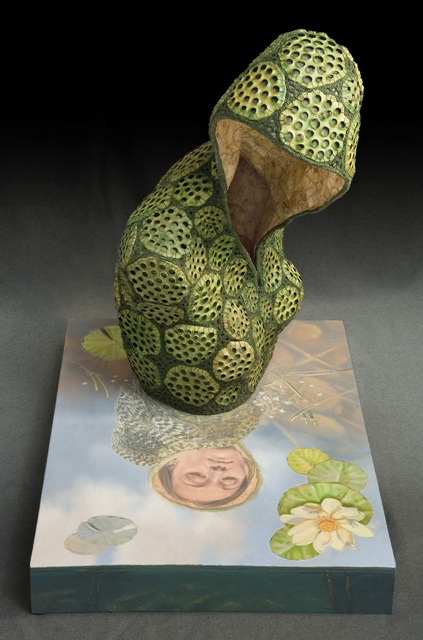
Much of your work requires hand sewing can you expand on this?
All of my work is hand sewn. My tools are paring knives, scissors, sewing needles and waxed linen thread. I have used a sewing machine on bull kelp, but I ruined my machine. Hand sewing and using the looping technique is a “signature” style that I have used over the years.
You have exhibited at SOFA (Sculptural Object Functional Art and Design Fair) in Chicago and SOFA, NYC, since 1999 expand on the importance of being able to exhibit there?
It is an International Exposition that over 30,000 art lovers and collectors attend within a 4 day period of time. It is highly competitive between the galleries and the artists that are chosen by the gallery to feature.
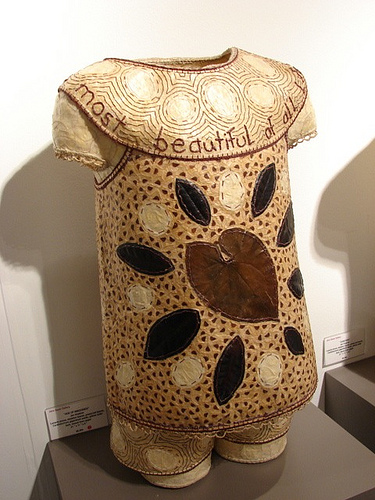
Tell us how tickets to The Lion King changed your art practice?
A friend gave my husband and me tickets to the Lion King in New York. As a child, I wanted to be a fashion designer. When I saw the costumes, I thought that costume design was my true calling in life. The next day, we went to the Metropolitan Museum of Art and viewed the Papua New Guinea basket masks. It was an epiphany for me to combine both basketmaking and fashion and that is when I decided to make figurative vessels.
How important have you found the need to balance your other life – and your art life?
Both are very important to me. It was more of a struggle when we had a houseful of children. My husband is also an artist so it was about trading off and making equal time for both artist and personal life. It is easier now that we are empty nesters. We schedule time to be together. When you do art, you get wrapped up in it. If we didn’t schedule in personal time, we would probably never see each other.
‘With Child’
Thomas Jefferson has also helped your career; with this paraphrased quote, “the harder I work, the luckier I get” expand on this?
People have often said that I am so lucky to be an artist. I have to agree, but luck really has nothing to do with it. It is many hours and hard work. Nothing glamorous, no luck involved…just passion and hard work.
Contact details.
www.janhopkinsart.blogspot.com
Jan Hopkins, Washington, USA
Interview by Deborah Blakeley, April, 2015
Larry Renzo Lewis
Symbols/Pictographs:
Expand on your use of Symbols/Pictographs/Icons in your work?
I use symbols/pictographs as a secondary means to convey message. Symbols have been around since the beginning. Now after hundreds of years after the introduction of the alphabet, we still depend on symbols for rapid recognition in everyday life – restroom icons, warning signs, on and off function, identification. A form of communication that spans time, culture and language. It seems to fit with the message of my work.

Is there a symbol you use in your work you find more important than others?
Yes, a circle divided into four equal parts or a square separated in the same manner. This was a marking I was using in my work even before I was made aware of its meaning. During the time I was residing in Yelapa, Mexico I was informed by a western person that studied shamanism and by a Huichol shaman. The symbol was used by a group of people in the Amazon in similar fashion as the Ying Yang symbol is used in Asian culture. Instead of being separated in two parts for good/bad or right/wrong, it was separated into four parts referencing good/bad or right/wrong adding time and dimension. I was amazed at this concept. To think a primitive group of folks would consider “dimension and time” in their belief structure.

Closer to our cultural times you have used modern mathematical and physical symbols. Expand on this in relations to your work?
I believe the language of mathematics and physics to be universal. It seems appropriate to include them in my offerings.
Stone:
Closer to our cultural times you have used modern mathematical and physical symbols. Expand on this in relations to your work?
I believe the language of mathematics and physics to be universal. It seems appropriate to include them in my offerings.
Discuss the way you use stones in your art both sculpture and painting?
I chose stones/rocks because I perceived them to be a most basic element – unpretentious, solid, hard, heavy, of the earth, foundational. I use them as metaphors for thought, memory and emotion. In doing so, I can offer a physical presence to that which is intangible.
.
Discuss your comment “Everything is connected”
Wrapped around stones, stones bound together, wrapped around the wrists and ankles of my figures, and figures bound together. I do this as a representation of my belief – “Everything is connected.” All things in our known universe share fundamental common bonds. In my work I bring this to light by the representation of physical binding.

‘An Emotional Partially Obscured’
Nudity:
Clothing gives a historical point, therefore why is Nudity so critical to your work?
Clothing / adornment makes a statement of not only historical but social, cultural and even religious status. I wish to make statement void of these elements, poignant only to humankind as one.

‘Balancing Nature’
Masks:
Explain the importance of masks in your work?
In my life experience, I’ve found that everyone I have come into contact with at some point in time has put forth a facade. Whether camouflage or deception, I find this to be a practiced human trait. Just one of the many things that separates us from being mistaken for lawn chairs.

Your late wife studied archaeology and anthropology how has this effected your work?
I perceive the effect slightly. Accompanying her on a few digs. It simply added support to my thoughts, seeing artifacts unearthed which held meaning of a prior time while offering importance of a time in the future.

‘Adrift with my Memories’
There are many similarities in very different cultures. You have lived with indigenous people; discuss how this has influenced your work?
I agree with your previous statement and believe that when one experiences a different culture it enhances their ability to better perceive their own culture. I would hope the influence is apparent when viewing my work.

How do you decide on making a work into a painting or sculpture?
In my youth I was privy to a quote from Ansel Adams – “there is nothing worse than a brilliant image of a fuzzy concept.” I approach all my work in the same manner. Conceive the concept, develop and complete.
Do you use the same subject in both mediums?
If you are referring to subject matter “Yes.” Subject in regard to models “No,” with painting I use models. Regarding sculpting, I rely on sketches and or composites.

‘Neo – vision’
Your own strict religious upbringing, how has it influenced your life and work?
Wow, big question! To this day, I am still attempting to sort that issue out. I have come to view organized religion with ill repute. I live and work in accordance with the content of my character and the faith that there exists something greater than I, and greater than my understanding, that fuels the cosmos.

‘Emotional Temptation’
Contact details.
Renzo aka Larry Lewis
rockbound666@gmail.com
Represented by – Masterpiece Publishing Inc.
www.masterpiecepublishing.com www.winnslavin.com
Larry Renzo Lewis, Nevada, USA
Interview by Deborah Blakeley, March, 2015
Miki Kubo
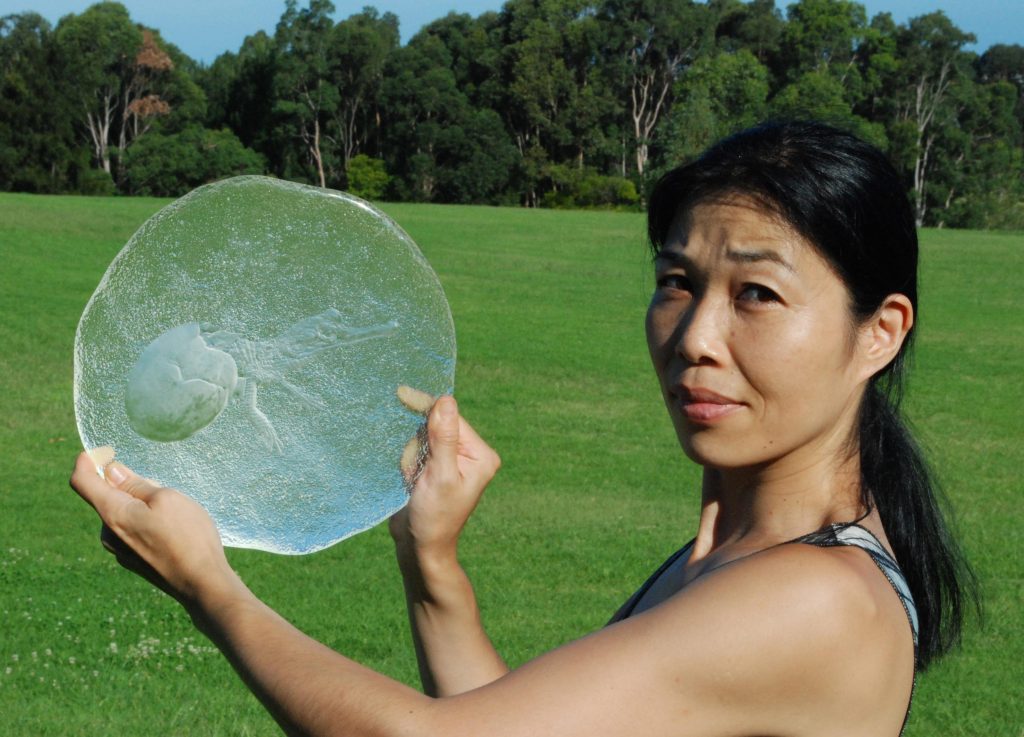 Miki Kubo, Japanese Artist in Australia photograph by Henry Rust
Miki Kubo, Japanese Artist in Australia photograph by Henry Rust
Zoneone Arts is delighted to bring Miki Kubo to you…
You take great inspiration form nature please discuss this?
When I look at Nature, at Life, I see a purity and connectedness that I long to be part of again. I feel that I am out of it, and I yearn to with my true self, my song. I want to feel the harmony with life that I see there. I want to cut through the noise to have a direct experience of the music of life.
‘Cosmos’ photograph by Henry Rust
Does your Japanese background give you a different connection with nature and animals to the one you have developed since arriving in Australia?
This is a question I am asked all the time as a Japanese artist living in Australia. I feel that my attitude as an artist and the fundamental approach to my subjects were formed and cultivated in my early teenage years in Japan. It might sound strange to Westerners, but we are encourage to be Westernized in so many ways especially after WWII. Many famous Western literatures are translated in Japanese and have been published repeatedly for children and adults, and J.D.Salinger was one of them. His book “Franny and Zooey” - it has guided me to be an artist who practice “see the subject for exactly what it is” and focus on “An artist’s only concern is to shoot for some kind of perfection, and on his own terms, not anyone else’s.” in my work. After school, I devoted all my time doing pencil drawings on white Canson paper…not much homework was done.
Animals you meet in Sydney tend to be more impudent and brave than the ones you come across in Japan. Australian sunlight is much brighter, which produces plenty of flowers in all seasons and trees seems to be much happier, but short lived. There are much more opportunities for me to study Animals in Australia and people’s passion for nature appears to be much stronger and direct. Being in the unfamiliar, forces me to focus in more strongly and recognise the subject.
Discuss your use of Australian flora and fauna in your work?
‘Sugar Glider’ photograph by Henry Rust
Australian flora and fauna designs were my engraving teacher Anne Dybka’s forte. When she closed her studio business due to her age and eye illness, she had introduced me to her distributers. During my engraving training with Anne, she made sure that I was able to engrave Australian flora and fauna in my interpretation so that I could carry out her legacy.
How important is the engraving (or carving) aspect of your glass art in your current work?
Engraving requires great focus and is extremely important in my artwork. Mistakes can’t be erased. The spinning bit demands deep concentration. Ear-muffs reduce outside distractions. Constantly running water means that I can’t see the surface where marks are being made.I trust in my connection with the subject and in the engraving process and focus goes deeper and deeper, allowing the work to come into existence.
Engraving on glass brings three dimensions, and the play of light and shadow, to the work. This is what makes it so appropriate as a medium for representing life. Each motif is its own self. I can’t own, or possess it, or take it away from what it is meant to be. All I can do is honour and wonder at its perfection. I do this through glass engraving.
‘Kookaburra’ photograph by Henry Rust
How you would like to see the pieces used?
My work is done in homage to the Life Force. In making a piece I touch the core of me – I reveal what I worship, who I am and what I aspire to be. I hope that through my work, others can find some of the peace, truth and joy that I find there.
Pieces that are culturally very different are your Hair Decoration Series can you expand on this series?
‘Small tiara with Phoenixes’ photograph by Henry Rust
This series is inspired by the “Chinese Kingfisher Hair Dress” from the Qing dynasty. I wanted to speak about the ’Power of Object’ through this series. I believe the original Kingfisher Hair Dress crowns were rented to decorate many young Chinese brides who were about to meet their unknown husbands under their arranged marriages. There was a time that tradition and family ties had so much power over people’s lives, so much in fact that there was no space for an individual’s feelings. Although we might have more freedoms now, compare to their past, we can still relate to those people who had to perform their act as what they were expected to. Otherwise we wouldn’t say “the show must go on” and drink from a cup that says, “Keep calm and carry on”.
‘Three teeth comb’ photograph by Henry Rust
On slightly larger piece in this series is ‘Bees and Flowers’ head dress discuss this piece?
‘Bees and Flowers, Head dress photography by Henry Rust
This particular headdress was dedicated to an Australian woman I saw in Queensland, we were at her late partner’s funeral ceremony. She was stood straight during the entire ceremony, wearing a golden eucalyptus flower branch on her hair.
Colour is so important to glass artist work tell us about your passion for colour?
I started my glass practice in a small glass-blowing company in Japan, in which we manufactured our own glass colours. Mixing glass colour from sand involves serious calculation based on chemistry and heat expansion technology. We had to sync the expansion rate and shrinkage in every colour so that the glass was compatible. It was time consuming, temperamental and an expensive process, and usually the recipes were kept in secret by the colour engineer in the same company. Therefore we had a very limited colour palette - red, orange and yellow were extremely rare to us. In Australia, usually the colours (for glass-blowing) come from New Zealand. Their colour ranges are - as many as nail polish, transparent and opaque in both! Now all the subtle colours in glass are accessible to me in Sydney.
‘Siamese Fighting Fish’ photograph by Henry Rust
However, as much as I love coloured glass, I enjoy working with non-colour and plain clear glass. It has its own attraction in that the engraved surface displays a much fine grade in shadow.
‘Frog and Orchards ‘photograph by Henry Rust
Shapes is predominate in your work, discuss shape in relationship to the piece, ‘Goldfish’?
The composition of glass is in its liquid form not solid - in the state of not hot enough to move, or it is moving but too slow to see. In this reason I like watery motives to go with glass and goldfish are on of them. Goldfish are man modified creature from many generations of mutated Crucian Carp which cannot exist in wild. It needs special, human controlled environment to survive. I’d like to keep them in safe bubble shape so that we can study their tranquility.
‘Goldfish’, aqua photograph by Henry Rust
Your piece ‘sea Dragons’ can you explain where you study the shapes and details of the animals you use?
I had a plastic Sea Dragon toy that I was hoping to use as a reference for a particular engraving, however it didn’t do justice to live Sea Dragons. I am very fortunate to be able to visit wild parks or aquariums as part of my job, to observe animals. At the Sydney Aquarium in particular - there were only ‘Weedy Sea Dragons’ exhibited at that time, but now you can meet ‘Weedy Sea Dragons’ and ‘Leafy Sea Dragons’ both at the Aquarium. When I engrave an animal, it is a portrait of that animal. It is not ‘a Sea Dragon’, it is that specific, personal Sea Dragon. Every individual animal is its own spirit. Each piece I make is an individual portrait of that animal, of that spirit.
‘Weedy Sea Dragons’ detail, photograph by Henry Rust
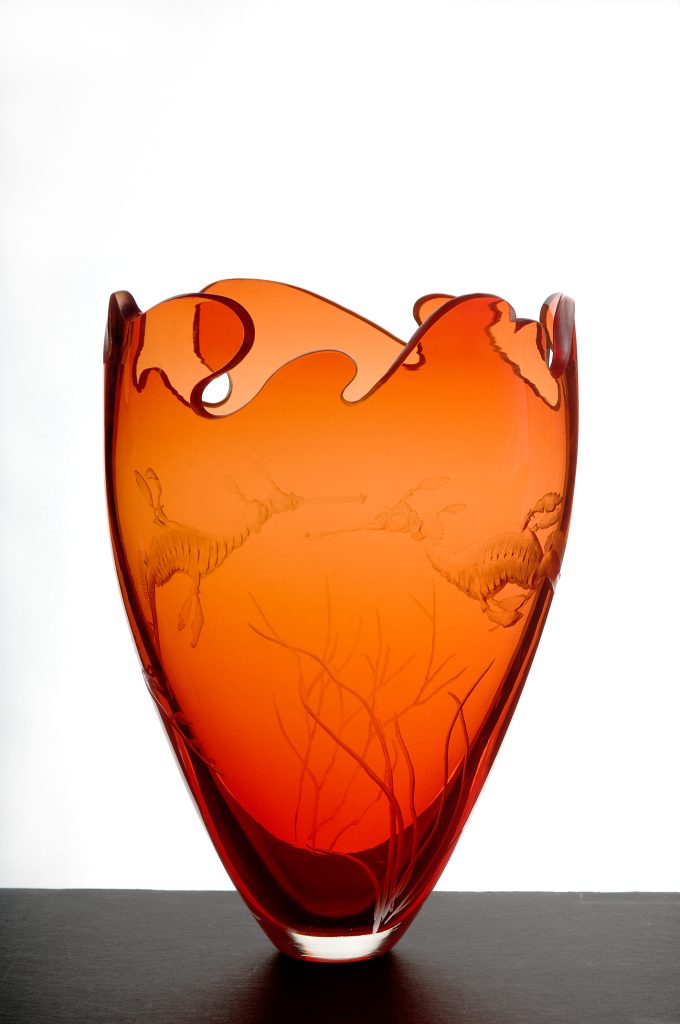
‘Weedy Sea Dragons’ detail, photograph by Henry Rust
Fragility is part of your work explain how important the openings are and how what is missing is such an important part of the whole?
Nature does not like to be disturbed. Pretty much everything we touch, we destroy.We break the perfect balance of nature and call them fragile.
In terms of my Glass bubble openings and why I like to design the edges into the motif’s - it is purely for the form of the Artwork - the carved glass edge adds light to the engraving and pushes the engraving out at the viewer. Also I get toapply two different kinds of engraving technique in one subject - intaglio engraving to carve in the motif and relief engraving to carve out. It is not about what is missing - it is more about emphasizing what is there.
Can you expand on the time you spent with Anne Dybka and how this time to influence your work today?
Between the year 2003 and 2005, every Saturday morning I was at Anne’s studio on Argyle Street in The Rocks. The lesson went usually two hours, it start off with me explaining to Anne what motif I will engrave and how I will approach it. The rest of the class we just talked about animals we both related to. There weren’t many things in common between us, but the strong feeling toward animals that really connected to us, was solid. She was an animal activist, born Greenie. Once she expressed me how she felt about Japanese whaling.
As her field of vision got smaller and darker, she shared many stories of her life to me.The job she had during the War in England, the big farm house she had lived, her passion about horses, her children’s toy stories, the egg fight her children and neighbour’s kids caused, her boarding school time in Switzerland, about the after-life,and about her mother. I was extremely fortunate to be able to spend time in her studio, she had shown me her affection to nature, her joyful and rich world through her work. When I engrave glass, I constantly imagine what Anne would do and what she would say.
Cameo work is very time consuming explain this method and how you use it?
Imagine an apple, a gorgeous red skin apple. When you peel the red skin, you find white fruit under it. To make a cameo piece, you will need a glass just like an apple. One colour on top of another, and sometimes triple layered glass. Usually, the skin- the first layer colour will be the motif you leave out. You carve the background area in order to make the motif lift up. This carving technique for cameo is called relief engraving. My Cameo bowls are interpretation of traditional hand-painted Porcelain in Asia.
‘Crab’ Cameo detail photograph by Greg Piper
You are a member of the Guild of Glass Engravers UK, what has been the value of a worldwide membership to you?
My initial reason for joining the GOGE was to follow the footstep of Anne - she was delighted when she heard the news I have been excepted to be a member. The GOGE offers vast information in engraving to all the public, promote artists and hold annual guild exhibitions. By being a member, it will gives you a great opportunity to connect with glass engravers worldwide. They hold assessment once a year by request and help you with developing your engrave practice. I found them very supportive, encouraging and full of warmth.
You have your work documented and photographed, discuss why and how this is done and why you would recommend this to other artists?
For many practical reasons, documentation of each piece is necessary for the artists who work with galleries under a consignment basis. Not just the detail of your work, the information such as, which gallery is selling it, for how much and how long. If I know who has bought it, I will record that too. Also when I take commission, having the list of previous pieces I worked on helps to come up with a fair quote for the future piece. Personally, engraving is a very intimate process. I spend at least few days extending my awareness towards the subject as best I can, so it feels like my mind is fused into the subject within the glass. Sending a finished work to the photographer is an important ritual, give a proper cleaning to the piece and pack in a box. It is the time that telling myself I am finished with this work, the piece is now ready for everyone’s interpretations and experiences.
Can you tell us about your work studio?
Being a Japanese Artist in Australia and travelling a lot has given me the privilege of working with many fine Sydney Glass Artists and sharing their work Studios. I have also worked in Sunshine Coast, Adelaide, Perth and Canberra Studios often as well. As I travel a lot, I usually take my portable Glass engraving table set up that I constructed, so I am able to do my engraving anywhere.
‘Goldfish’ cameo photograph by Henry Rust
What is your advice to Collectors of glass?
When I was in a glass company in Japan, our retail manager who sold our glass use to say “I don’t need to know the difficulty of glass technique, what I need, is the eyes that can tell what appeals to customers and the experience to know how much people will pay for it”. she was in charge of pricing all our work. I can only half agree to that! I do not wish my work to be defined and evaluated only by its technicality although I admit it is fascinating to know how the work was made. I imagine everyone has their own motivation and passion to collect objects. To collect something you will usually do some investigation in the field. What I do is a hand-made artwork, not machine made mass-production. Handmade art reflects the heart and soul of the artist. This is my best advice to a collector.
Contact details
www.mikikubo.com
Miki Kubo, Japanese Artist in Australia
Interview by Deborah Blakeley, March, 2015
Mariolina Mascarino
Can you discuss your thoughts on the overlapping of design and fashion in your work?
In my mind design and fashion are true art forms which are worth taking into consideration especially when it comes to jewellery and body adornment. Also, I think of my jewellery as something which is always evolving and changing together with the new trends.
When I start working on a piece I always need to have clear in my mind that what I’m going to make is not only art but also, and above all, a jewel. Here is where the need of making something that fits into the fashion trends overlaps the need of expressing myself as an artist. What I want to do is to make something unique but comfortable and wearable as well.
Colour is very important to your work. Can you discuss this?
The use of colour plays an important role in my work. I believe that colour gives personality to a piece or, better yet, it “makes” the piece. I am happy to work with paper because I have so many shades and colours to choose from, also I never run out of newspaper pages with words and pictures on them which help me to achieve even more unique results. Often, when I can’t find the color I have in mind, I paint the pieces myself, using water based paints and mixing colors together. In those cases, I’ll always end up with a special shade, which I will not be able to create again and this also contributes to the uniqueness of the piece.
Compare two pieces of your jewellery showing both glamour and simplicity, and the need for both in your collections?
I’d like to compare a glamorous necklace like the “charcoal and gold chain” with a more simple one called “corolla”. They are two completely different pieces: the first one designed to be worn at night or on special occasions, while the second one, with its minimal, fresh style, is perfect for everyday wear.
'charcoal and gold chain’
charcoal and gold chain: kraft paper, painted newspaper scraps, crocheted cotton yarn, cardstock. Water based paints and glues. Colors: charcoal, gold. Total length: 130 cm – 51.2 in.
corolla: crepe paper, waxed cotton cord, water based protective varnish and glues. Approx dimensions: around neck 46 cm – 18.1 in, total length: 51 cm – 20.1 in.
Corolla
Having both simplicity and glamour in my collections is not only a need but a choice. I like to offer a woman the opportunity to always be herself, following her personal style. I want her to feel, free to wear accessories the way she prefers, choosing simplicity or glamour according to the mood or the occasions. In other words, I want her to be unique in every moment and with every outfit.
Why have you chosen to use paper as your main medium?
Paper is interesting in many ways and it allows me to express myself at my best. Not only is it an environmentally friendly medium, which can be easily recycled, but it is also extremely versatile and shapeable according to my needs. Working with paper of all types (crepe and tissue paper, cardboard, cardstock, kraft paper…)
I have the possibility to continuously explore new textures and combinations, while creating original, one of a kind jewels. Also paper looks very fragile, but it actually hides a great strength and flexibility, two qualities that make it ever-challenging.
‘folds’ Black and White Earrings
Can you expand on how two women can change your jewellery by the way they wear it?
When a woman wears jewellery she wears it in her own peculiar way, adding something unique to it. I’m not talking about the color of her hair and eyes or how she looks, but rather about her inner essence, something special and inexplicable which belongs to her only. It is this “added value”, this “inexplicable something” that, in my opinion, makes all the difference.
Discuss your paper bangle ‘chances’?
‘chances’
Inspiration
I saw a tiny flower growing through the asphalt and I went closer. It looked as if it was happy to be there and totally careless to the surroundings. It was given the chance to bloom on the road and it simply took it. This little flower made me think about the many opportunities we miss every day, just because we don’t want to take risks or we think we don’t have a chance, but in doing so, we sometimes lose the juicy part of life. My asphalt color bangle, with nine flowers “growing” out of it, aims to be a reminder of the endless opportunities afforded us every day. Opportunities that can appear everywhere, like a flower blooming on the road.
Size
Adjustable - Inner diameter 6 cm – 2.4 in.
Weight
50 g – 1.7637 oz.
Colour
Black, dark orange, dark red, teal, yellow, purple.
Many of your bangles are designed to be worn in groups, can you discuss this?
Whenever I start working on a design, I already have the final result in mind. I like to anticipate how the piece, be it a necklace, a bangle or a ring, will look like when finished. The sets of bangles are generally created to be worn in groups simply because together they work better. This may be due to the color mix or the shape, but every time, one way or another, they “cooperate” and complete each other.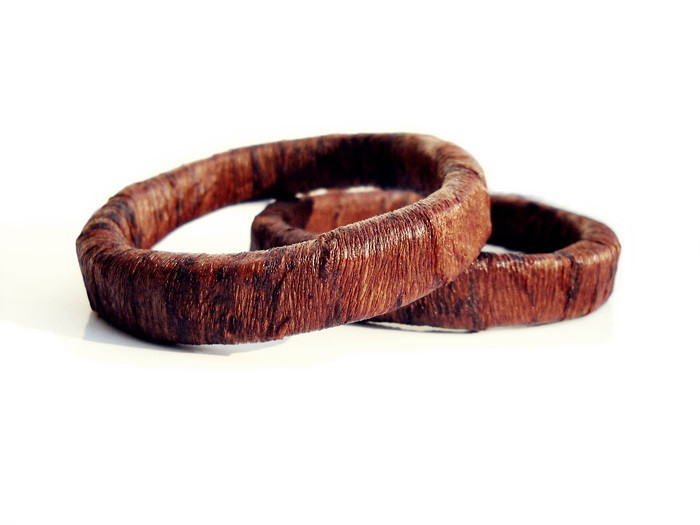
‘round brown bangles’
Expand on how you combine your paper jewellery with semi-precious stones and eco friendly supplies?
When I started the “quasi caramelle” project I was looking for an environmentally friendly material. My choice went to paper because it can be easily recycled and reprocessed, offering an excellent result. The decision of using semi precious stones and other eco-friendly supplies, such as natural fibers and post industrial waste, came as a natural consequence. Eco-consciousness is as important to me as a unique style and that’s the reason why I’m always looking for a balance between the two.
‘stones burgundy’ Ring
Discuss the use of paper with text in your work?
Sometimes I can’t help being tempted by paper with text. Using words on my pieces gives me the illusion to communicate better than just with colors or shapes. Newspaper scraps always convey a message, and sometimes even a single word may be enough. It may be something that, if you pay attention to, can make you look at the piece from a different perspective, and through your interpretation, it even enables you to become part of the piece.
'pebbles' ring
Your chain necklaces are solid to look at but have the advantage of lightness due to the material : paper. Please discuss this?
One of the reasons why I like to work with paper so much, it allows me to make statement and solid pieces while being very light and comfortable to wear. A good example is the “blue chain” necklace. I made it using newspaper pages and tissue paper which I painted, glued and coated with a finish to make it solid to the touch. I added a silk cord and a clasp which is made of cardstock and paper as well. The design is simple: there are three chains which count respectively 19, 16 and 18 rings and every ring has a diameter that measures between 3,5 cm - 1.4 in - and 1,5 cm - 0.6 in - for a total length of 67 cm - 26.4 in. Despite that, it only weighs 60 g – 2.1164 oz. This is one of the advantages of working with paper.
'blue chain’ Necklace
The use of geometric shapes in your work is so simple while at the same time being so elegant. Can you discuss?
The American designer John Maeda states: “Simplicity it’s about subtracting the obvious and adding the meaningful”. I totally agree with him. I think that simplicity always adds something instead of taking something away. Being simple it’s not being easy, but it’s having clear where you want to go, it’s reaching to the heart of things, understanding what’s essential, and then letting it shine in a new light. I like to consider simplicity an “added value” and I like to think that this is what makes my simple geometric shapes look so elegant.
‘square grey and white’ Bangles
Do you design jewellery for men?
All “quasi caramelle” pieces are meant to be worn by women, but sometimes men appreciate them as well. It generally happens with the square/round bangles or with some rings. A good example is “plain”: a brown and light brown ring. It is made of cardstock, kraft paper and crepe paper, with a very simple and solid design.
Your comment “Let your uniqueness be inspired”... can you explain this?
Women are all unique and special in their own way. By creating one of a kind jewellery I’d like to inspire all of them, guiding their true essence and singularity towards fulfillment. I want them to feel free to choose the piece which most harmonizes with their soul, with the guarantee that it will always be as unique as they are.
'Tria’ Bangles
Tell us one story about a piece you have made that has given you and your career a huge boost?
The bangle “chances”, which I have described above, has been much appreciated especially in the artistic field. It is featured in the 2014-2015 edition of the “Contemporary Jewellery Year Book” by Grupo Duplex - Spain - and was exhibited in “Madrid Joya” and “Espaijoia Barcelona” - two events which were part of the Spanish project. However, I cannot say that this particular piece has influenced my career more than others. I’d rather look at my career as a work in progress, a sequence of moments, some good, others bad, but all very important to my growth and creativity.
You work out of Italy – discuss the importance of fashion and statement pieces to Italian Women and how they wear jewellery?
What’s important, though, is that they not only look for something original and unique, but they also want it to be comfortable and easy to wear. That’s why all my designs, whatever the inspiration, are translated into tactile, and durable pieces with subtle textures or more complex and layered finishes.
Contact details.
Web: www.quasicaramelle.weebly.com
Email: quasicaramelle@gmail.com
Mariolina Mascarino, Asti, Italy
Interview by Deborah Blakeley, March 2015
Jenny Bowker
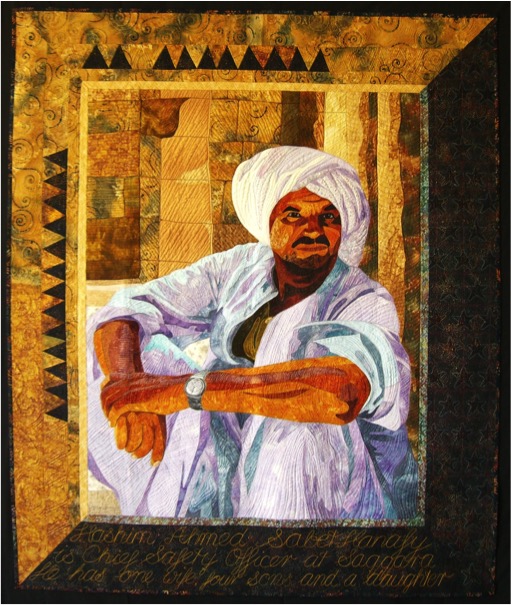
‘Hashim’ - image by Patricia Bolto
Can you discuss your former training in science and the direct advantages this has played in relation to patchwork?
I worked for thirteen years in the field of Electron Microscopy, first in research on bees’ eyes and how they work, then as part of a service unit doing a range of varied and interesting work.
I think the incredibly fine work we did with electron microscopy preparation works well with patchwork. We used to use a cleaned eyelash fixed to a slim glass capillary tube with dental wax to handle the slices of prepared tissue as they floated on a water bath – they were so small. Getting corners to match after this was a piece of cake! Not that I do much traditional work really – and I have relaxed a lot on how perfect work has to be.
Discuss specifically ‘Radiolarian Drift’ in relation to science?
Radiolaria are tiny protozoans that drift in the ocean, and we know them really from their skeletons. I had been working on a project identifying and photographing the skeletons and was fascinated to realise that the tiny line of foam that a wave leaves on the sand is packed with tiny lacy skeletons – constantly redrawing our coastline.
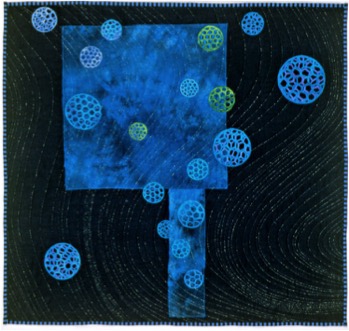
‘Radiolarian Drift’ - image Andrew Sikorski
I wanted the work to reference science but not to be too specific so it is a generic radiolarian that no-one would recognise, drifting up from the deep crevasses of the ocean. The quilting added movement and I quilted in silver. The background was a rough heavy indigo blue silk.
This piece was the first I made that melded my life in science to what I had thought of as a nice hobby.
You have spent over 15 years in Arab and Islamic countries. How has this influenced your art?
I think it has influenced my subject matter more than technique. I have made a series of quilts based on Egyptian men. They were a response to a moment of sheer frustration when a friend – no – not a friend but an acquaintance - commented on the fact that you could not trust Arabs – they were all terrorists.
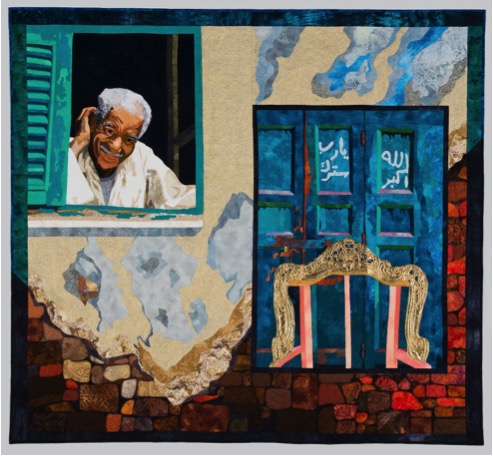
‘Abu Ali and the Gilded Chairs’
I realised that I could talk my head off. I told people how gentle and kind most Arabs were, how they were generous beyond reason even when they had nothing, how they would drop all walls when they decided that you were a friend, and that friendship would last for life, and how in Egypt particularly, they struggled to make the best of the level of income they had because they truly believed that it was their task to make the best life they could within their means. The talking had little effect.
David Shipler, in Arab and Jew, Wounded Spirits in a Promised Land, wrote “They will not find peace in treaties or in victories. They will find it, if they find it at all, by looking into each other's eyes.”
I decided to work in ways that showed men with their work, and men who were straight and honest and kind, and who were proud of what they did. I have always loved watching people work when they are truly competent. They had to be photo-real so you could see their expressions and look into their eyes.
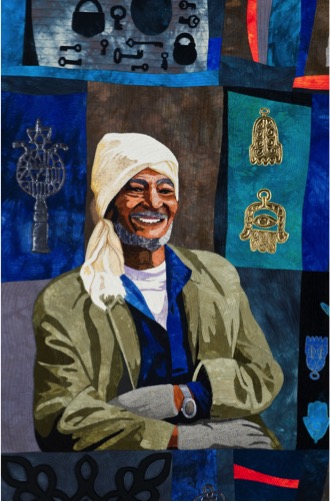
‘Hashim, Ittayer and the Friday Market’
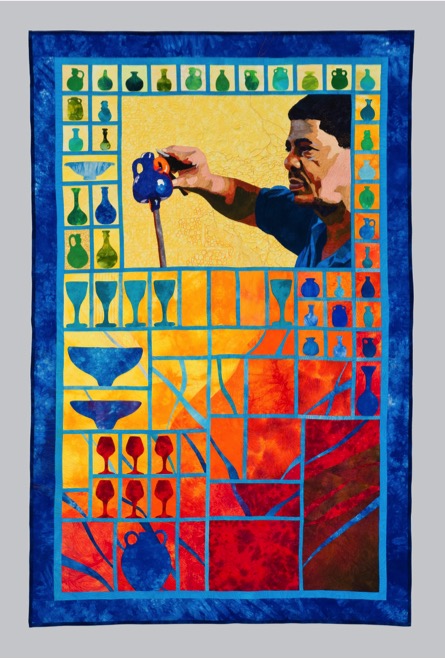
‘Hassan and the Glass’
You have taught in over 22 countries. Can you discuss some of the similarities?
Usually I am working with women and women’s issues are the same worldwide. Family and children usually come first, then work if they have it, then a hobby like patchwork. In some countries where I work life is a struggle and the patchwork is actually a source of income – sometimes the only source of income. That changes the pattern radically and I have to teach in ways that are fast to make, and target things that are quick and saleable. We do not make any queen size quilts in these countries.
Otherwise classes are similar. I leaven the instruction with humour and stories, and vary instruction techniques as some learn by seeing diagrams, others by seeing it - in Iran women were fast with mathematical ideas, they saw patterns that would occur at block corners before I pointed them out – and they were completely new to patchwork.
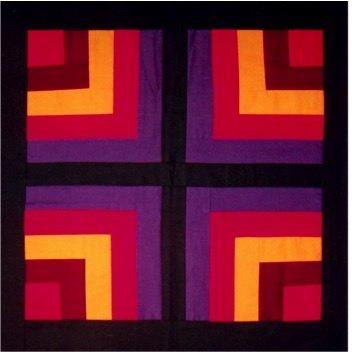
Detail of ‘Al Amish’
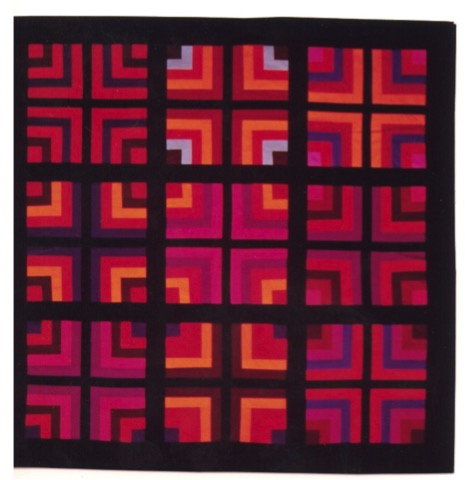
‘Al Amish’
In Ramallah the women worked incredibly hard – they were all to graduate as patchwork teachers after our one-month course, and it was important to them. They also worked brilliantly in teams with no concerns about who owned the piece that six women were making together. I cannot imagine that happening in the west. We only had two sewing machines in each class of twelve – so it was by far the quickest way to work. The teams were finishing tops in an hour and a half.
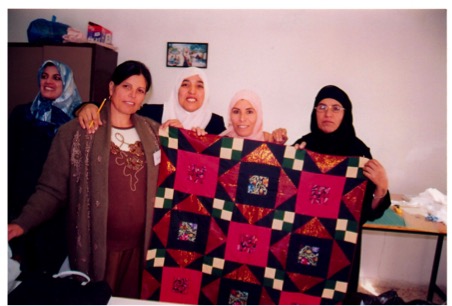
A small group with a finished top in Ramallah
How do you cope with language and interpretation when in other countries?
Even when I have a bit of a language I work with an interpreter. It can be challenging and I try to make sure they can also sew. One of these occasions turned into something wonderful. In Australia my husband had been working with the Centre for Defence and Strategic Studies. It was made clear that Australian wives were expected to do something for the wives of foreign generals on the course.
I announced a patchwork class and most of the twenty attended on the first week. By week five we were down to four. Three lasted a long time and one – a Thai friend who became one of my ‘sisters’ stayed all year. Vanida Navakul fell into patchwork as if she had been born to do it. Each week we met at her house. I taught patchwork and she showed me a new dish for a Thai lunch. I told her she had to go back to Thailand and teach – she was really gifted and hated the seamstress work she had been doing.
When I needed an interpreter in Thailand I asked for Vanida. I knew she had not started work in any way and was too shy to promote herself in patchwork. After a week of my classes I could see shop owners looking at her in amazement.
She was not just interpreting – she was moving around the classes helping students in Thai while I demonstrated in English. She had bookings for weeks at the end of it and now has a very successful business in Bangkok – with two long arm machines operating from her shops. It is a marvelous feeling knowing that for one of my dearest friends I really did teach her something that changed her life.
Expand on one of your many textile tours ‘Postcards from Cairo; Do you want to come to Syria and Egypt with me?
I LOVED doing these tours. They have stopped at the moment. Syria is out – for my lifetime at least. Egypt is struggling a little still and it is hard to entice people to go there even though it is probably fine. We limited numbers so we could all fit in a small bus and so I did not lose people in long walks through tiny alleys in suqs.
I ran three tours. The final one was two weeks before Egypt had its first revolution and the mobs were in Tahrir calling for Mubarak to resign – and he still had not when I decided to switch it into Jordan.
One of the best highlights was a night in the house of Widad Kawar, who is known as Umm l'ibas al-falastini—the mother of Palestinian dress. She wrote the following wonderful books and I particularly recommend Threads of Identity.
- Kawar, Widad: Threads of Identity: Preserving Palestinian Costume and Heritage ISBN 978-9963-610-41-9 Rimal Publications. 2011
- Kawar, Widad: Pracht Und Geheimnis - Kleidung Und Schmuck Aus Palästina Und Jordanien ISBN 3-923158-15-7 Rautenstrauch-Joest Museum Munich. 1987
- Kawar, Widad and Tania Nasir: Palestinian Embroidery : Traditional "Fallahi" Cross-Stitch ISBN 3-927270-04-0. Munich, State Museum of Ethnography. 1992.
- Widad Kawar and Shelagh Weir: Costumes and Wedding Customs in Bayt Dajan. "biography". Kawar Arab Heritage Collection.
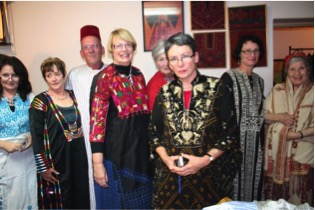
Widad Kawar and tour group
Widad dressed us all up in the costumes of different areas of Palestine. It was a really wonderful night – and she had seen us at incredibly short notice.
On another part of the trip in Syria between Palmyra and Damascus I had rung ahead and asked a tiny desert coffee truckstop to hold milking their sheep until we arrived so my travellers could see it.
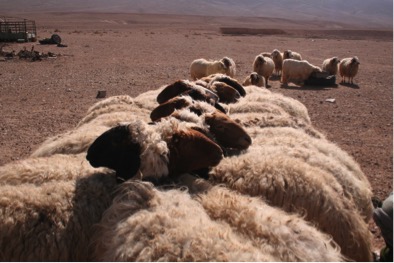
Although it had nothing to do with textiles it was mentioned by many as one of the great experiences of the trip.
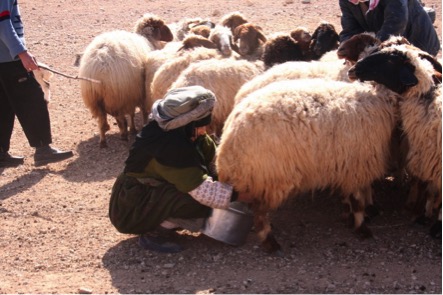
On earlier trips that were able to go to Egypt visits to Wissa Wassef Tapestry Project and the stitchers employed by the Anat Foundation in Syria who live in the tiny village area of were highlights.
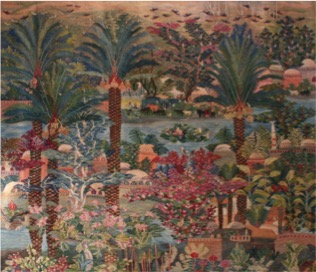
A Large Tapestry at Wissa Wassef
Wissa Wassef treats its weavers as artists. There is no pressure on them, they choose their own designs and subjects, and they are not pushed to work. Their work is spectacular.
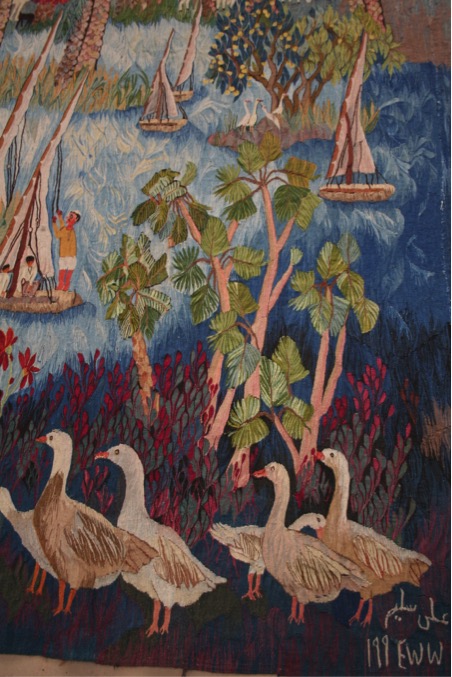
Detail of the tapestry
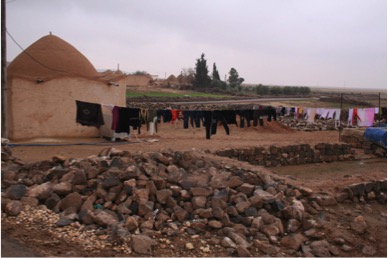
Jebel al Hoss
In Jebel al Hoss the women live with their families in mudbrick beehives. It is bleak country – freezing and windswept in Winter, and scorching and windswept in Summer. It is in the area we used to call a ‘plant and pray’ area. They do exquisite embroideries which are marketed as bags and clothing to the rich and privileged in Damascus – and worldwide.
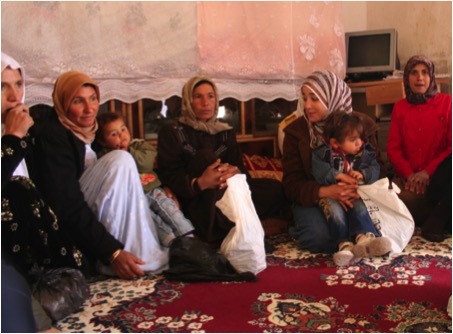
Can you explain ‘Sandstorm over White Dessert’?
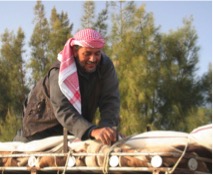
This quilt uses a combination of raw edged applique and simple piecing. Many of the fabrics are hand dyed or painted. Sandstorm over the White Desert is the sixth quilt in the series. Magdy Badrmany became a friend of ours while we lived in Egypt. He is a Bedouin guide in the White Desert and we were impressed by his professionalism, his driving skill, his sense of humour and the way he simply and quickly set up our camps and cooked wonderful food for us.
On one camping trip a sandstorm blew up on the horizon. We watched it approaching in some trepidation. I did not want sand in my SLR camera so I memorised the changes. I was fascinated as we watched the ominous approach, and saw the way the shadow of the storm changed the colours of the white desert. As we watched, creams and warm golds became silver and mauve.
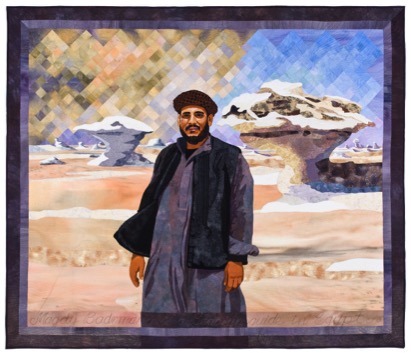
‘Sandstorm over the White Desert’
Magdy was calm and unworried – as always. I added a brief text in my own hand writing at the quilting stage, explaining very simply who Magdy was.
I made the quilt and sent Magdy a text to tell him to check his email. In Bahariya Oasis, where he lives, there was only one possible internet connection for him – the local coffee shop. In Egypt women do not go to coffee shops. I had sent two tiny picture files – one of the quilt with me in front of him so you could see that it was life sized and one of just the quilt.
Magdy took his wife. She wore full Nekeb to go there – a face cover with just slits for her eyes. As the images started to download – very slowly on the dial up modem – Magdy went to get coffee. Next thing she was hitting his shoulder.
When he asked why she pointed to the screen where it looked as if Magdy had his hand on my bottom – real me, quilted Magdy. Luckily the other image cleared things up. I realised why she did not realise it was a quilt – in the tiny file the pieced sky just looked pixelated.
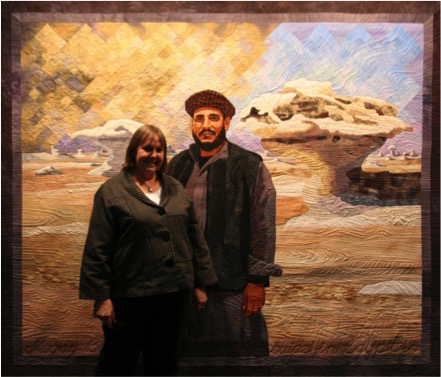
The offending image
Discuss your photographic technique to quilt making. Perhaps you can use ‘Mohamed Sa’ad – Caretaker of the Mosque’ to explain this technique?
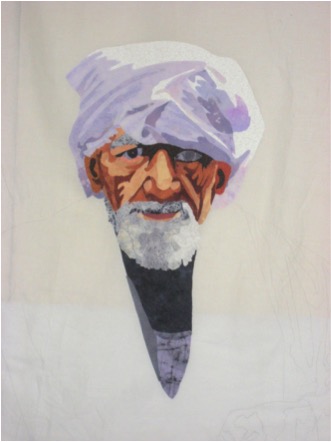
Detail, ‘Mohamaed Sa’ad.
I used composites of several photographs for this piece. The face had to be accurate, but I wanted to use him in front of the magnificent silver and bronze medallion on the mosque door.
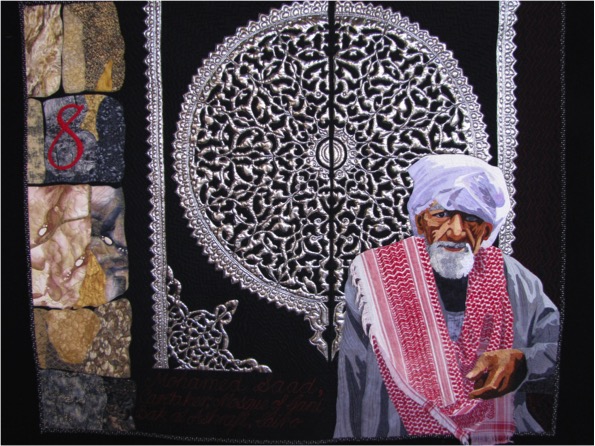
‘Mohamaed Sa’ad.
I traced different elements separately and put them together. I then make the drawings bigger, scaling some up more than others. I outline every different colour, not just every different value. These become pattern pieces for the raw edged applique. Each piece is matched to a piece of fabric, cut out and ironed down with a fusible webbing. Stitching holds it securely and adds a lot more linework. Then quilting adds another level. I do not want a quilted groove on each change of colours on his face – the quilting is contouring and often ignores the colour changes.
For the mosque door I pinned foiled jersey over the almost-finished quilted quilt. I stitched the lines of the intricate design, then cut it away with a soldering iron and restitched it.
Explain your project 'The Tentmakers of Old Cairo'?
Our move to Egypt was the time I moved me into an orbit I already knew. In 1981 I had visited Egypt during the Gulf War. One of my strongest memories was a visit to the Street of the Tentmakers. The Street of the Tentmakers is colourful and vivid but the work is slowly dying as an art. It had lost its Egyptian audience as wealthy Egyptians wanted French tapestries, and poorer ones were just not interested.
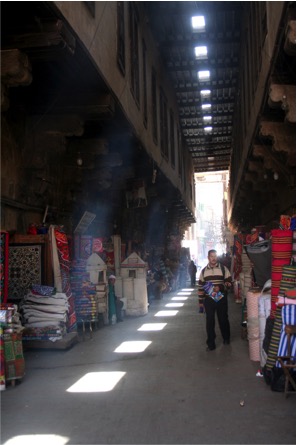
Street of the Tentmakers
The tentmakers are men who used to – and still do - make tents. However they are best known for the exquisite applique they use – and originally it formed the inside of every wall of a tent. They now use printed fake cloth for the tents as people are usually unwilling to pay for the full handmade applique. They make panels for people to hang in their homes, or to use as quilts. The work is made with solid coloured cottons, and it is ornate and beautiful.
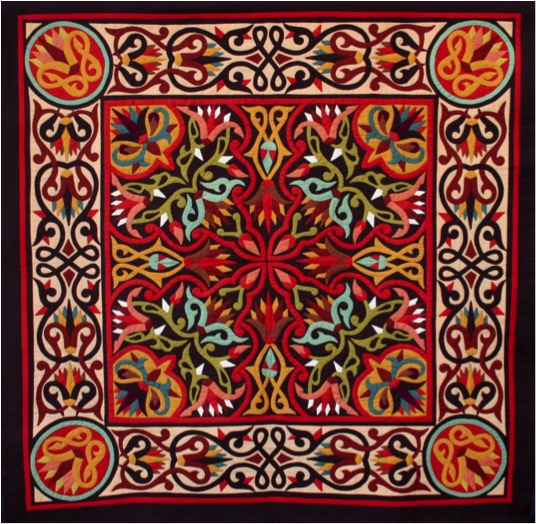
Textile by Wael
Subjects range from the purely decorative to calligraphy and storytelling.
Tarek Abouelenin explained to me that he and his company had invested fifteen years of savings to go to a Furniture Expo in Holland. They had completely failed to increase the business and companies who ordered wanted 3,000 piece in two weeks, and they just did not have the stitchers to do that.
As he was talking I was thinking – it is the wrong audience! You need to be seen by quilters or textile workers who understand exactly how wonderful you are and the difficulties of your work.
An invitation from Expertise Events to teach and speak at the AQC in Melbourne was the trigger. Judy Newman selected a talk about the Tentmakers, and Beutron offered to sponsor an exhibition space. I took two men – a translator to help to sell, and a master stitcher, Ahmed Naguib.
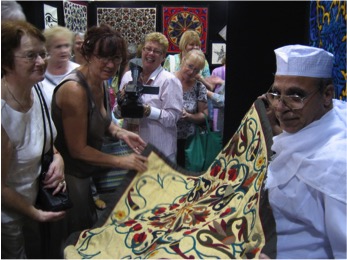
Ahmed Naguib at AQC in Melbourne
I knew Australians would be blown away by the work and it would sell like hot cakes. I had not expected the changes it brought back to the street in Cairo. Ahmed Naguib talked about how he was received, how people used video, how he was in the newspapers, how women clapped when he finished a flower – and I watched the street start to realise that what they did really mattered in a larger context.
They have now been to seven countries with exhibitions, and sometimes several times to each country.
Hany Abd el Khader, one of my friends in the Tentmakers’ Street made an applique piece to remember the first Egyptian Revolution. That was sold to the Museum of Oriental Art in Durham when we took it there for an exhibition at the University. It has a double historic importance – both far greater than anything I could make. It is work by an Egyptian about an Egyptian event of huge importance, and using a craft which has never been used by its workers for political commentary.
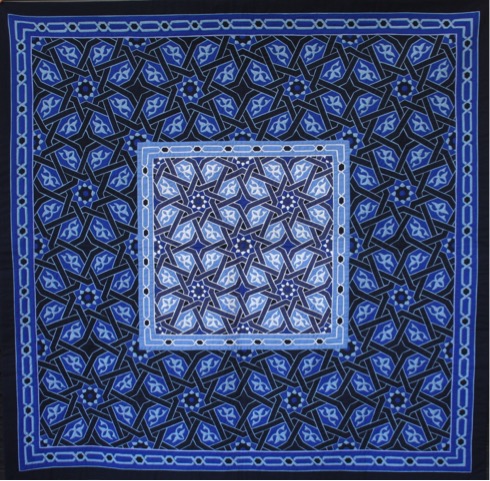
By Hosam
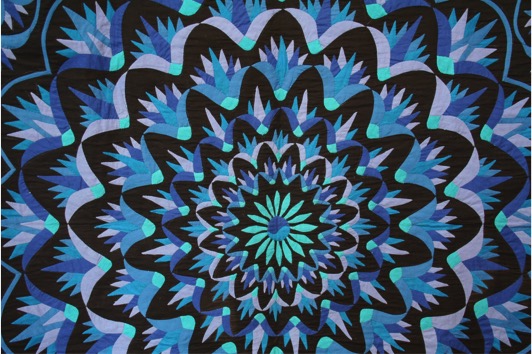
By Mohamed Dendon : Detail
Discuss colour and how you use hand painted fabrics and other techniques to achieve the colour you need in your quilts?
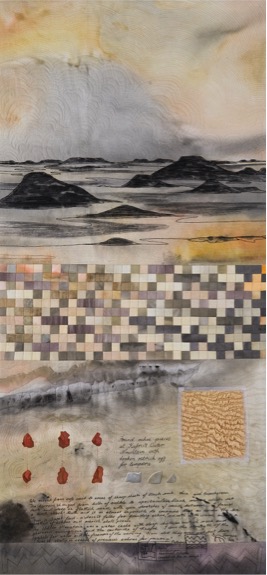
‘Water Mountail’
I tend to freshen and brighten colours for many pieces – that is just a matter of personal taste. It also has the effect of drawing attention from the softer greyed quilts around mine in a quilt show – so there is an element of deliberation to my colour choices.
I did a lot of the work when living in Egypt dyeing and painting of fabrics became a necessity. I could get large bolts of cheap white cotton, but never colours that I wanted. It was easier to buy whites and work from that, augmenting with other fabrics from my stash. I mix everything. Working in Ramallah and Iran told me that you use what you can get. Patchwork came from making do with what you had and we have almost forgotten this.
You are a member of tACTile, discuss the importance being a member of this group has been to you personally and professionally?
Working with tACTile has been very important to me. The group are good friends. The others are all so incredibly talented that I often wonder if I really belong there. We have had exhibitions every two years for the last twelve years. In each exhibition we have basically made our own work, but within a broad and elastic theme. There are times when I race towards deadlines swearing I will never do it again, but it has opened doors that would have stayed closed for me as a single quilter.
Discuss the importance that a quilt maker can be in capturing time and place?
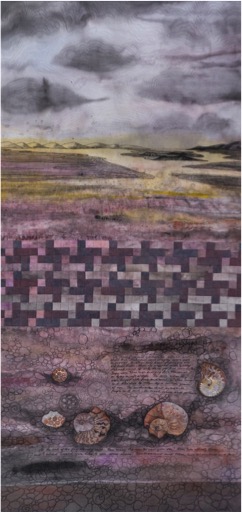
‘Ammoni’
I think that a Quiltmaker can be considered an artist in the way of other artists – it is only the medium that is different. Our work has significant advantages as I can fold twenty large quilts into a suitcase and carry them on a plane to an exhibition.
I think pictorial work of the kind I make can freeze a moment. However, decisions like choices of colour and patterning are subject to fashion and can lock the work into an era and that might not be such a good thing. I was looking the other day at advertising with men in bell bottoms and crocheted vests. We were laughing because they truly looked funny. It made wonder if my work will date in the same way.
Your husband’s Diplomatic placements; how have these helped you as a quilt maker?
I would not be a quilt maker if it were not for my husband’s career. When I married Bob I knew that I could not keep on working in electron microscopy. I drifted in the first postings – I taught kindergarten at the American School in Damascus, Syria, had two extra children in Kuala Lumpur, Malaysia, then started to study with a Palestinian painter in Amman, Jordan - and loved it.
finished a degree in Visual Arts just as my husband left to work with the UN in Gaza. I had done the degree with the intention of taking discreet groups of diplomatic wives into the landscape to learn to paint. I made a couple of quilts – for fun – and followed him to Jerusalem. Then there was a moment of realisation that quilting was simply a medium, that I could do anything with it that I could do with paint.
Textiles feel extraordinary to work with. People reach out to touch textiles and never do that to paint or photography. From the moment we are born we are wrapped in cloth. We step naked from the shower into cloth, we sleep between sheets, and blankets are used for warmth and comfort. There is an immediacy to textiles never found in paint. Colours are richer too as reflections do not usually affect fabric.
Our postings have also supplied me with incredible – sometimes unbelievable life experiences. Some find their way into my work, some I just hug to myself. The travel has supplied subject matter, though I only use places that mean a lot to me, not places I trip through briefly. I think the best art has to come from feelings – not just the idea that something looks pretty.
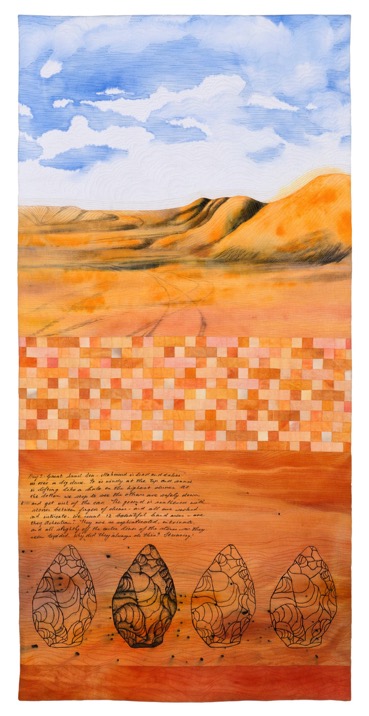
How has patchwork and quilting helped you when you have had to move to a new posting?
Yes – though there is always a period before the luggage arrives where I use the time to explore and get to know a new country. Moving to a new place can actually be devastating, regardless of how exciting it sounds.
I think we all have so many facets. We show a different side of ourselves to different people. My parents see me in one way, my children are shown another. I am a professional in the workplace with peers, somewhat subservient to my boss, a partner to my husband, and different again with female friends.
When you move – you are suddenly only a mother and wife. I have even been introduced as “The new Brenda Dodsworth” – naming the wife of the officer Bob had just replaced. It is a frightening loss of identity and I think you have to slowly replace each facet, finding people who see you in different ways. With my work I keep another facet throughout, and it gives me a sense of purpose in a brand new country where I am isolated by language, by the fact that I do not know anyone, and to a certain extent by my husband’s high status. He was the Australian Ambassador in the last few posts and an ambassador’s wife loses freedoms just because she is there with the representative of our country. You are never out of that role, regardless of where you go or who you are with. In our first posting with that title – day one – I turned at the checkout in a Jordanian supermarket and picked up my plastic bags of shopping. “No, said the owner. He said, “I have to talk to you.” He lead me to the restaurant part of the supermarket and ordered two coffees.
“In this country you are the wife of an ambassador. If you carry your groceries you are saying your country is rubbish. You can never, never do that here. When you shop you turn and walk out. You will know that your groceries will follow you.”
That was one of the hardest adjustments for an independent Australian to make – but during the next few years I heard enough gossip from Arab friends to know that I had been given great advice.
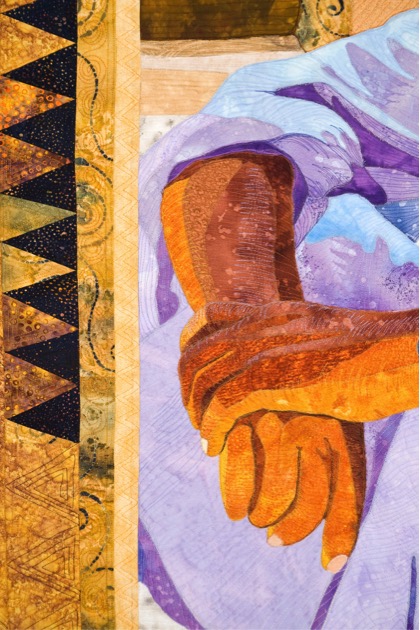
Hashim ; Detail - image by Patricia Boulton
Recently you have had issues with copyright, please explain what you have learnt about this aspect of artistic ownership?
Recently you have had issues with copyright, please explain what you have learnt about this aspect of artistic ownership?
I did so little. One of the quilts I had made back in 2002 was a traditional style of quilt. I had been in Singapore and a friend and I had shared a pile of sarongs which we cut up and divided. The front panel – or my half – of each sarong was so lovely that I did not want to cut it smaller. I designed a way to use triangles to make the pieces shimmer – and it helped quite unrelated prints to sit comfortably together.

A few years later I repeated the quilt in another lot of fabrics and it was so popular that I started to teach it as a class. Then I made two more. By this stage people were starting to copy it.
I was a bit miffed, as it looked traditional but it was not a known traditional block. People started to ask for patterns and I started – slowly and through chemo, to put a pattern together. A friend, Cassandra Philpot, spent several days with me taking process photographs to use in the pattern.
I never make patterns. Everything I teach is aimed at moving away from dependence on others’ designs, and making original work, so this was a very different path.
I negotiated with an Australian company to print it and do the distribution. And waited. Five months.
Then someone on a Facebook list posted the quilt they had made in a Shimmering Triangles class! I contacted the teacher and pointed out that she could not teach my design and my class without permission. She was nice – used the excuse that there was no pattern so she ‘had to write her own,’ but happily agreed to have her students buy mine in future.
Within two weeks I had withdrawn the pattern from the slow publisher, given copies to a group going on a quilting retreat who promised to test it, and after a few tweaks that they suggested I slammed it up on an internet selling site for crafts as a downloadable pdf file.
Then the real drama started.
A shop announced its BOM. This is a Block of the Month. Sales of these are almost infinite. Each month everyone who signs up gets a pack of fabric and instructions for that one section. By the end of eight months – or five or how long it takes – they have the whole quilt made. The shop can make a huge amount of money from this. They did not use my pattern – they cited my name and the fact that the first one was made in 2002 but said they had designed their own pattern from a Pinterest board.
I wrote a polite letter pointing out that this was a breach of copyright. No answer. I waited a month. Then the second advertising letter came out and they had removed my name and credit.
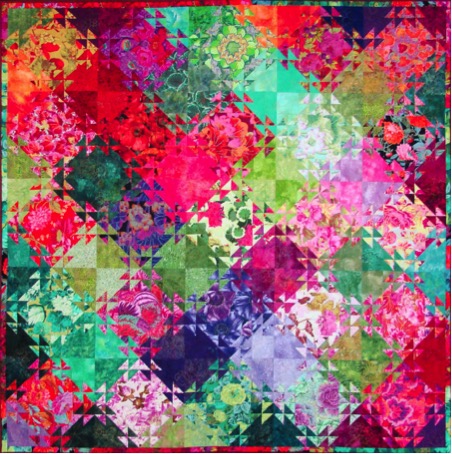
At this point I write a letter saying I was organising a Cease and Desist letter form a lawyer. I located a lawyer in the lady’s hometown and wrote to them.
I told two marvelous internet groups what was happening and they pulled in hard behind me. QuiltArt and SAQA are both offshoot chat lists for professional organisations – one from Quilts Inc in America, the other an international organisation centred in America called Studio Art Quilt Associates.
I named and shamed, but somewhat reluctantly as I was afraid of possible repercussions. Because they offered, I asked my friends to write a note or put a comment on the shop’s blog or Facebook page. Interestingly – Australia was blocked from the shop’s Facebook page. I asked people to stay cool, professional and accurate, and not to risk exaggeration or name-calling.
At the end of twenty four hours I stopped them as I was feeling sorry for the shop. I know they had hundreds of emails and comments and the owner had spent most of the day taking them off her blog as they appeared. Within half an hour of my stopping the emails the BOM was withdrawn with an apologetic note saying the maker did not realise that she could not draw her own pattern for an original quilt.
The internet really has incredible power. I was able to stop the lawyer letter before they had taken the top of the pen, and this did not cost me anything.
As a nice bonus – the pattern has been surprisingly successful – but that is another story!
Contact details.
Jenny Bowker
Email jenny.bowker@gmail.com
Website www.jennybowker.com
tACTile website http://www.tactilequilts.net/
Blurb book, Pack and Follow http://au.blurb.com/b/2578726-pack-and-follow
Pattern for Shimmering Triangles:
http://www.craftsy.com/pattern/quilting/home-decor/shimmering-triangles/122321
Jenny Bowker, Canberra, Australia
Interview by Deborah Blakeley, March, 2015
Gail Kelly
You studied print making in both Ireland and America. Can you discuss the differences and similarities?
I studied print making in Belfast at what was then the Ulster College of Art and Design. There was less emphasis on the academic side of things then and although we did attend lectures and had to write essays I remember most of our time being spent in the print workshop throughout the three year course. We had tutors who were passionate about their own work and great visiting lecturers. We learnt what I consider to be ‘proper’ traditional print making techniques and focused on developing the content of our own work throughout our time there. I mostly concentrated on etching and screen printing but did get an introduction to stone lithography at another print workshop in my last year.
While I was in America studying for my M.F.A I worked for Louisiana State University teaching undergrad classes and as a technician in the print workshop. I also worked editioning prints for established artists, all of which was good experience and helped me build up my CV. I mostly worked in stone lithography and etching there.
The print making department at L.S.U. had a great litho area and was altogether a much bigger set up than we had in Belfast. As grad students at L.S.U. we all had our own little studios which was a big difference from the shared desk I had in Belfast.
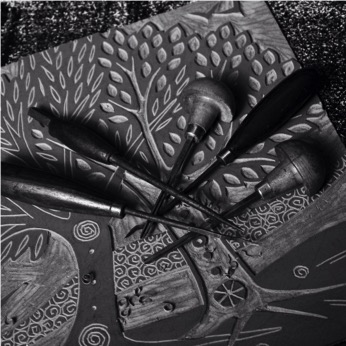
After returning to Ireland from America, did you find the landscape sharper to your eye?
I lived in America for seven years but I came home to visit every year so I never lost touch with the landscape here.
Please expand on ‘Fairy Bridge’ both the content and your use of colour?
The ‘Fairy Bridge’ depicts a little bridge my father often took me to see when I was a child. It was along a path, through a clearing in the woods. We loved going along that way. The whole area seemed secret and undisturbed. I don’t think many people knew the little bridge was there. The colours I used in this lithograph are the colours I remember from those woods – the autumn leaves lying untouched for years on the forest floor, the bright green of the new leaves on the beech trees above our heads and the misty mountains in the distance.
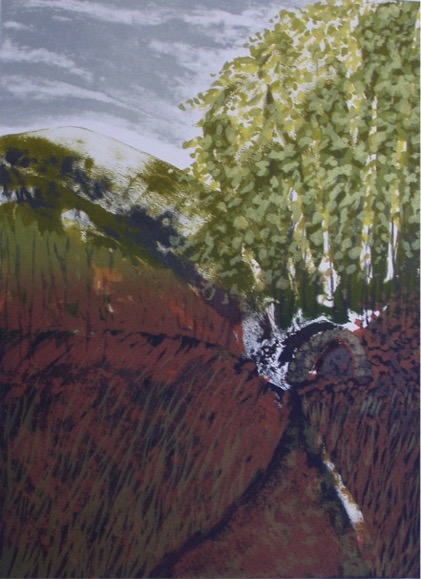
‘Fairy Bridge'
How do you decide whether to use monochrome or colour in your prints?
I chose whichever I feel will suit the image.
Can you discuss ‘The Immigrants Bridge’ and the historical content?
Also known as ‘The Bridge of Sorrows’ or ‘The Bridge of Tears’, it is on a small road in Gaoth Dobhair (Gweedore), County Donegal which led to the port in Derry. The population of this Gaeltacht (Irish speaking) area was badly affected by the famine and evictions. Many people left Ireland at this time, heading for America. Their friends and relatives would walk with them as far as this little bridge where they would say their goodbyes. The folk staying walked back to their homes and those leaving walked on to get the ship, all knowing that they would probably never see each other again.
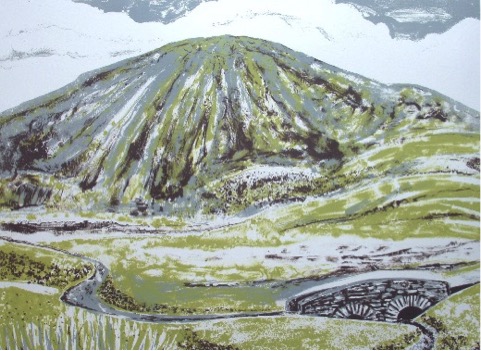
'The Immigrants Bridge’
Can you expand on your work in relation to trees and the seasons?
I live in the country now, in County Down and I am always very aware of the weather and the changing seasons. I have a big garden and I keep ducks and hens so I’m in and out all day long between one thing and another. The Tree series developed out of my interest in nature and the landscape where I live. Folk lore and traditions have always been an influence in my work. I like the idea of remembering and respecting the old ways of doing things, whether daily activities or annual events.
You made a calendar for 2013. Could you expand on this?
A few years ago I had a commission to do a calendar for one of the banks here in Ireland and I had been meaning to do one of my own ever since. I tend to work in series’, often in 12’s, so made sense to use some of these images for calendars. It has become an annual project now and I’ve produced my own calendar for the last three years. I used my Tree series for the first one, then my Gardens for 2014. For the 2015 I used a mixture of images, all my linocuts printed on linen.
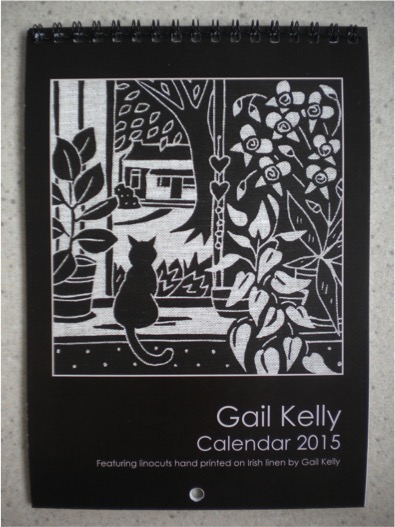
Can you discuss your Linen Prints and how and when you started to print on linen? Does it have any restrictions?
I started printing on linen about 15 years ago. It really suits my linocuts which I print in black on natural linen. I like this colour combination and I think it works well. Working with linen can be a bit tricky as it creases easily and has to be ironed and starched.
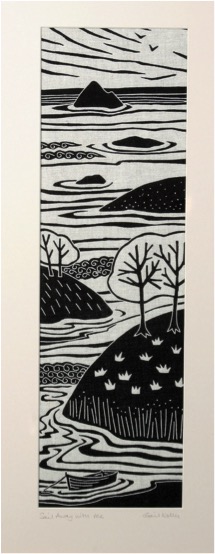
'Sail Away with Me’
Discuss your ‘Emigrant Series’?
This series refers to people who have left their native homes and long to return. Although I enjoyed my time in America I eventually became homesick and moved back to Ireland. I was lucky in that it was only a flight away and these days if you have the money for a ticket you can be back in no time at all. Years ago when people left it was often a one way journey and many never had the chance to return. When you are away you are more likely to think about home at certain times of year such as Christmas (‘Coming Home’) and I imagined in the past people wondering how the family would manage the farm without them (‘Harvest Time’). The title of ‘Promises to Keep’ comes from the Robert Frost poem where someone is travelling and has to keep going along their way. ‘Sail Away with Me’ refers to young couples moving away to start a new life together.
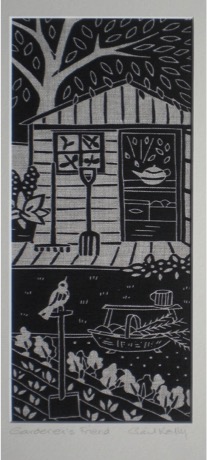
'Gardener's Friend'
You also have a ‘Bird Series’. Discuss: ‘Gardener’s Friend’ and ‘Garden Girls’ in relation to each other and as a part of a series?
I feed the wild birds in my garden and enjoy watching them every day. ‘Gardener’s Friend’ is about a robin which is always nearby when I’m working outside. I keep hens and ducks for eggs and ‘Garden Girls’ refers to some of my little banty hens and chicks. The images in this series are a combination of the patterns of garden trees and flowers along with an element of storytelling depicted by the birds.
You attend Craft Fairs - can you explain the importance of these to presenting your work.
I usually take part in 2-3 trade shows a year where I wholesale my linen prints and greetings cards to galleries and shops throughout Ireland and the UK. The retail craft fairs are quite different from the trade shows as they give me the opportunity to meet the public and sell directly. I enjoy the peace and quiet of rural County Down but it is also nice to have the buzz of excitement at a busy show. I have made some good friends among the other exhibitors over the years. It’s interesting to chat with customers too and build up a connection with them. I like travelling and taking part in the shows. It gives me the chance to see other parts of the country and I plan for a day or two off to go exploring whenever possible.

Discuss how important it is for you to represent your country through your art?
The landscape of Ireland is obviously very important in my work and has always been the main influence over the years, even when I was living abroad. I don’t feel I represent my country as such. I depict the elements of it which hold my attention and these could be anything from a scrap of ancient folklore to mountains and fields to the shape of a tiny leaf. My imagery is not intentionally ‘Irish’ but once people know where I’m from they see the strong connection I have with the land here.
Contact details
www.alganarts.com
www.gailkelly.co.uk
gail@alganarts.com
Gail Kelly, County Down, Northern Ireland
Interview by Deborah Blakeley, March, 2015
Ute Rathmann
Expand on the importance of looking at the work of past Masters in your work?
I am very inspired by the work of past Masters. I tend to arrange my work in series with scenes reminiscent of masters such as Gustav Klimt. A model is dressed up according to a particular theme. This is the visual basis. The end result, however, is not directly connected to the depicted subject but takes on a life of its own.
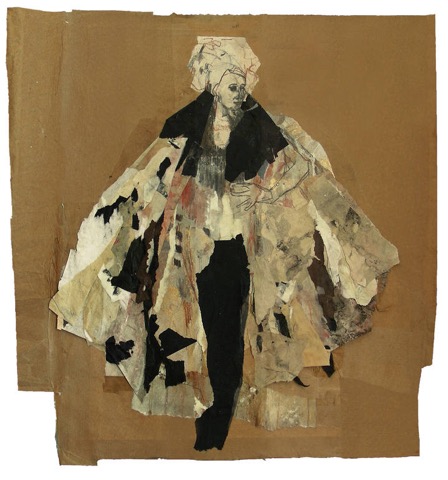
‘Hommage à Gustav Klimt X111’
How do you describe your art medium?
It is a vivid mix of all sorts of mediums. I use pencils, watercolours, pastel, pigments, crayons, etc. Important is their compatibility with paper – and I do not like to use colours that have a chemical smell.

‘Hommage à Degas XXI’
Can you explain how you use Collage in ‘Ewig’?
This special piece is a bit different then most of my other abstract collages. I work with this medium for many, many years and my whole studio is crowded with tons of pieces of paper that are glued together and then torn apart again. From time to time some of those pieces that emerge by accident happen to be so beautiful that I want to use them just the way they are. For “Ewig” I found this one single piece and I just glued it with wallpaper paste on a cardboard.
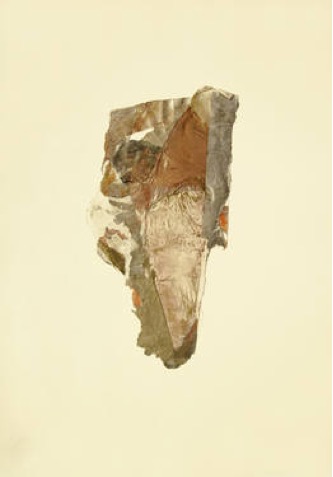
‘Ewig’
Can you take us through the before and after process of ‘Hommage à
Goya XV’?
First of all there was the figure – a draw over a collage. I thought a faint background would fit the best, so I started to use paper in different shades of white. My aim was to show a development from the colourful skirt to the subtle head. I used the paper for the background to create a sharp silhouette of the skirt and I made the skirt longer and more vivid. The upper body stayed the way it was from the beginning.
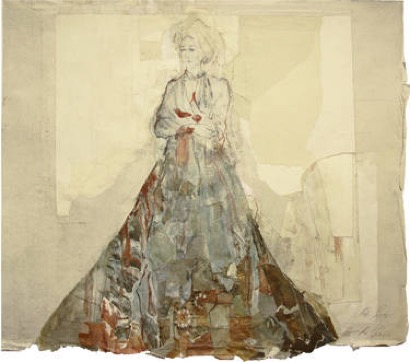
‘Hommage à Goya XV’
Discuss where less is best using Hommage à Degas XXVI.
To me, “Hommage à Degas XXVI” is a very light and soft picture. It always reminds me of “Sternentaler” (“The Star Money”), an old fairytale by the Scandinavian author Hans Christian Andersen, in which a poor girls gives everything she owns away until her gowns and then the stars fell from the sky turning into golden thaler.
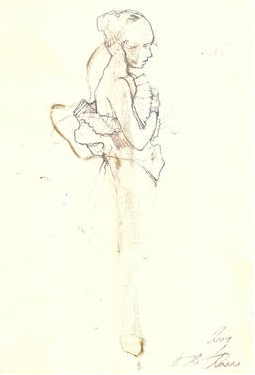
‘Hommage à Degas XXVI’
When do you decide to add colour?
Drawing is a very intuitive thing to me, therefore I do not really `decide` to add colour, it is always a result that just seems to happen.
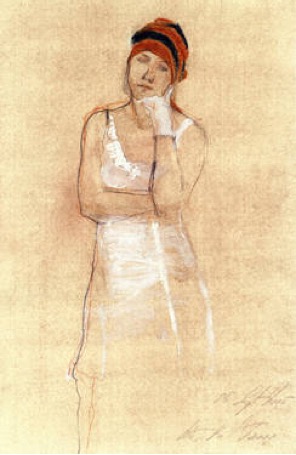
‘Hommage à Ingres XI’
Can you explain where and when you use gold pigment?
I discovered a box with gold pigment while cleaning the studio of my deceased professor Christine Perthen. Since the very beginning using this medium, I fell in love with it. I apply it with a dry brush to achieve a blurred surface area or draw lines with a wet brush. In any case it must be fixed with a very strong spray afterwards.

‘Hommage à Botticelli XIII’
Discuss ‘Tribute to James Goldstein VIII’ and the use of collage and shaped paper?
Usually, I tear the figure out of the drawing to creating a perfect surrounding that highlights the figure. With this piece it was a bit different I did not compose a background, I just used black paper and put some small pieces of silver paper around to combine the background with the figure.
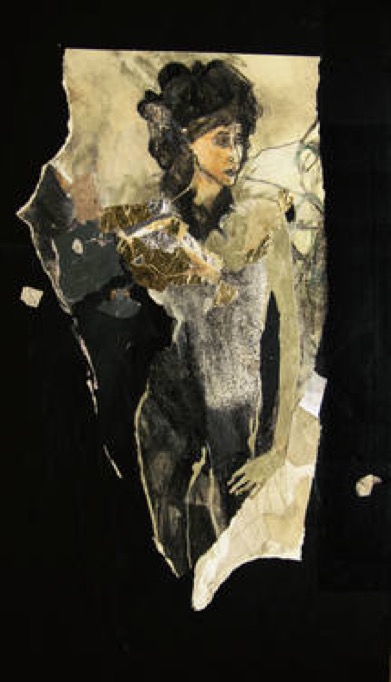
‘Tribute to James Goldstein VIII’
You teach Fashion Illustration. Can you explain the changes you have noticed in the area of art?
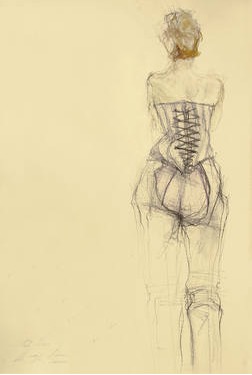
Some years ago, the perception for an artist who deals with fashion in his artistic work was considered as a bit frivolous. But now, there are more and more artists like me, whose work may be described as “fashion art”. It is not “fashion illustration” because it is not created for the purpose of promote and selling fashion. It is more an artistic involvement with fashion.
Fashion is iconic and timeless in your art, can you discuss this?
I have studied fashion-design at the Kunsthochschule Berlin-Weissensee because there has always been a very strong fascination for clothes, costumes, fabrics, patterns, etc. It took me quiet some time to realize that I did not want to design clothes. Instead my artistic aim is to create a special kind of setting I could use as a visual basis for my artworks by using clothes and costumes in combination with a human model.
You also draw nudes – discuss this in relations to being a woman and the depiction of other women?
I also draw male nudes, it makes no difference to me. At this moment I start drawing I am always turning into some kind of a neutral being excited only about the beauty of the composition.
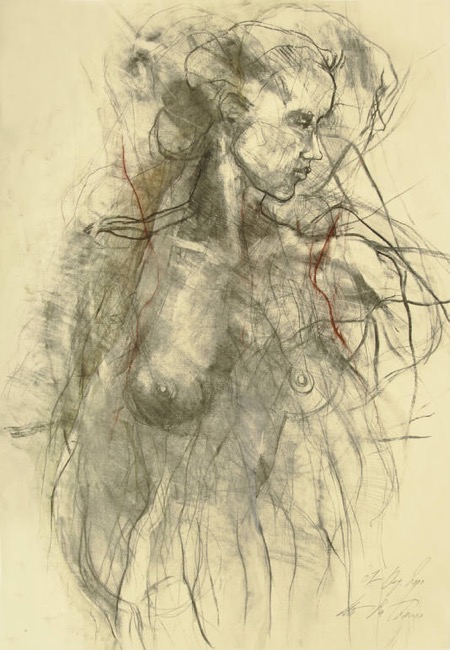
‘Nude IX’
Composition is very important in your work. Please expand on this?
The composition is like a perfectly fitting frame for an artwork. First, there is the figure and then I try to create a surrounding that presents the figure the best.
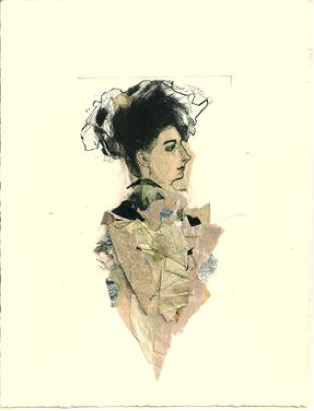
‘Hommage à Cranach III’
Explain about your titles and the numbering system you use?
I sort my works by the name of the Great Masters that inspired the setting. The numbering is not really chronologically because I work so much that somehow I lost the overview. I try to keep at least the series together which are made at the same time.
Do you sign and date your work?
Yes, I do. I sign and date the front or the back of my artworks.
Discuss the use of signed Certificates of Authenticity?
It is very important for my collectors to get a hand signed Certificate of Authenticity. An artwork is something you probably want to leave to your heirs and they might need the Certificate for the eventuality of selling the artwork.
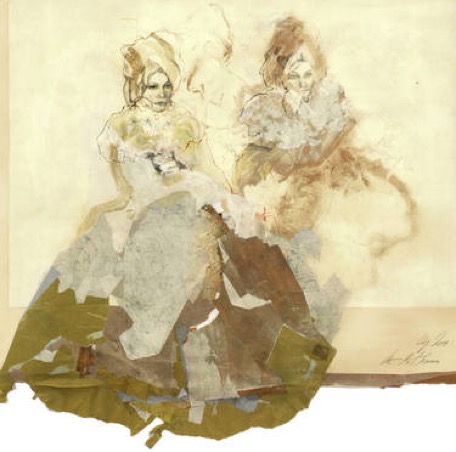
Hommage à Watteau XII’
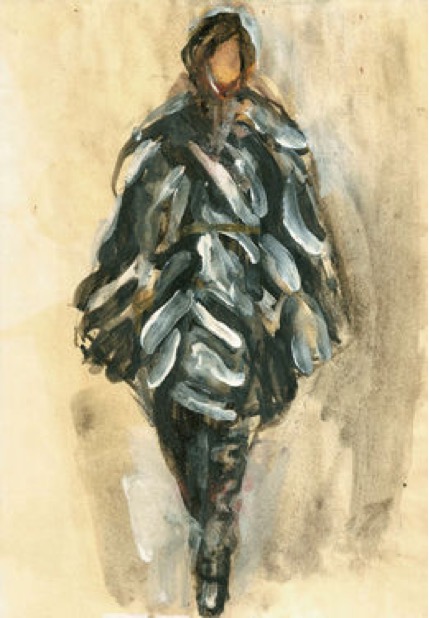
‘Fashion Illustration’
What is the magic of fashion and art – discuss?
I guess it is all about feeling and not about thinking. When I was younger, I felt quiet unsure about my work. I always wanted to capture poetic and magic in my work. A lot of people told me that my drawings are somehow not “serious” enough, too decorative, etc. but the older I became, the more I trust in my own feelings.
Contact details.
ute@uterathmann.com
Ute Rathmann, Berlin, Germany
Interview by Deborah Blakeley, February 2015
Sally Simpson
Can you discuss the ritual and ceremonial rites in your installation ‘Precipice’?
The background to all of my work is an interest in ‘power figures’ and ‘votive objects’ used in many cultures as mediators between humans and nature. In addition I refer to the tradition of using materials at hand to make such objects. However my sculptures embody personal questions about the contemporary relationship between humans and nature, in an era of many confusing and contradictory value systems.
Why was the exhibition called Precipice?
The anchor piece for the exhibition held at ANCA (2013) and Gallery Smith Project Space (2014) was ‘Precipice’, consisting of 9 figures poised along the edge of a bench. The figures kneel and extend empty hands, inviting interpretation by the viewer. Kneeling is associated with a position of last resort, whether in prayer, submission or despair. The exhibition held at Gallery Smith Project Space included 5 kneeling figures carrying empty cow horns. The idea underlying this body of work is that a precipice is a moment in time when an individual or group faces an unknown future.
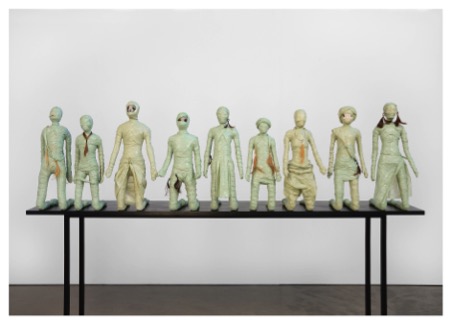
How many figures were exhibited together in this exhibition?
ANCA showed ‘Precipice’ plus 9 individual figures. Gallery Smith Project Space showed “Precipice’ plus 5 new individual figures.
Discuss the collaboration between the Gallery and yourself in putting this installation together?
The delight of working with a commercial gallery is that they are experienced with installation. Emma Benichou and Marita Smith spent a lot of time deciding on the best display, and although they consulted me often I was happy to trust their judgement. For example I agreed with their decision to remove all drawings planned for that show, which made it far more visually powerful.
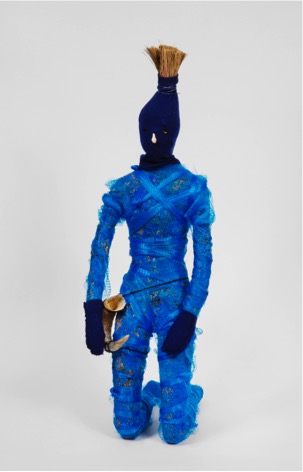
Discuss the use of found objects in your work?
In the past I’ve used objects found at particular sites and these materials have inspired the forms created. For Precipice the materials relate to my life on small farms over the last 25 years. I like to begin with the soil or vegetation of the area, as traditional sculptors began with clay or timber. For several years I worked only with clay so I still find modelling comes naturally. Now I include any found objects as I build and model, as these embody both the site and the issues I’m working with.
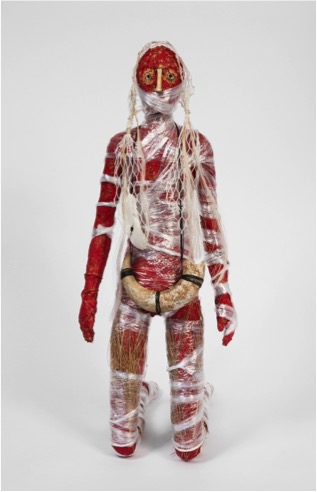
Within the found objects, do you always combine natural and man-made objects?
So far that has been the case because it is my way of merging the process with the ideas. However I can imagine an idea might lead to a decision to use either one or the other.
Do you think living in the country has brought a stronger Eco influence to your work?
Most definitely. Issues such as revegetation of rainforest, water and power sources, and the potentials and limitations for a local, organic and sustainable lifestyle are part of daily life. Which is not to say that I live according to ideals but rather see how complex the issues are.
Discuss the relationship between human and the land in your work?
I hope I raise questions rather than convey opinions. Land changes constantly, and so do our values about land. The issues today are complex so it’s important that people consider as much information as we can to form our own opinions and act on them as best we can.
The making of ‘faces’ from fish bones, lace and mud. Can you explain why you have used this particular combination?
The objects made for ‘Venerated Remains’ are examples of the materials dictating the form. After I had collected mud, irrigation pipe, fish bones and a lace curtain from the dried out bed of Lake Mokoan I tried putting them together in many ways.
The early works exposed the irrigation pipe and used other found objects. Over time the lace began to wrap the irrigation pipe, and the fish vertebrae happened to fit perfectly at the end of the pipe and acquired a different character when used in that way. When the final form suggested mummified fish it embodied layers of meaning regarding Lake Mokoan.
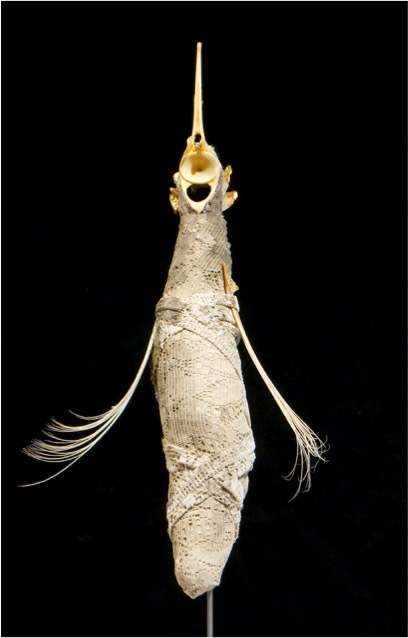
‘Veneraated Remains’ -detail
Can you explain the Meroogal Women’s Art Prize and how it affected your art practice?
This prize is named after a group of women who ran a property in the early settlement of Nowra. At the time I wanted to make a piece about the drought, and a watering can that could not possibly hold water, made from the dried out ribcage of a kangaroo, was decorated with chicken bones and stitching to reflect upon the harsh Australian rural lives of women settlers. Although I had been collecting bones for many years this was the first time I made a sculpture using them, and it was the beginning of a mode of practice that has continued since.
Can you expand on your ‘The Berry Series’?
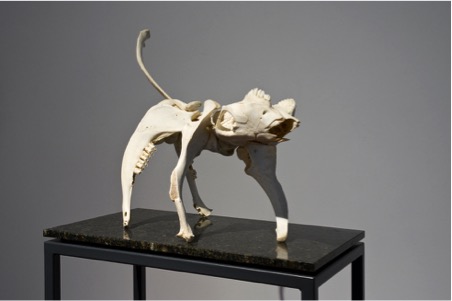
‘Cattle Dog 2’
It was appropriate to use cattle bones for this series as I lived on a former dairy and had observed Berry change from rainforest and cattle farming to retirement and holiday homes in the time I was there.
I intended to express a type of memorial to the former farming life, so used graveyard imagery of the cross and totems. The ‘Cattle Dogs’ were more affectionate and playful, made specifically for ‘The Dog Show’.
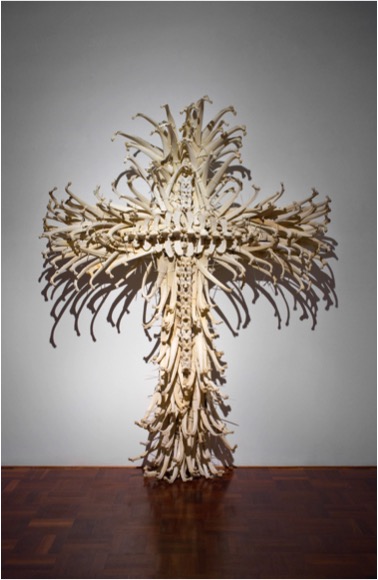
‘Cattle Cross’
How has your Master of Philosophy in Sculpture influenced your work since 2012?
The rigour of researching and writing about my ideas within the Australian National University sculpture department established a more professional approach to my work.
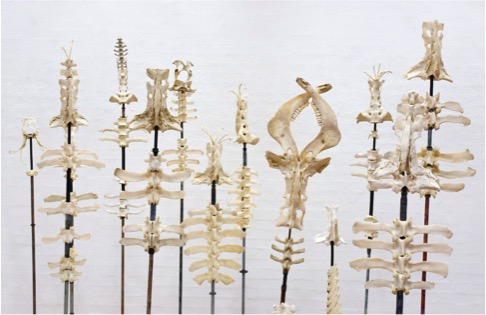
What are you currently working on?
I’ve just completed 2 more kneeling figures using quite different materials for ‘Imaginarium’ curated by Amanda Stuart at Belconnen Arts Centre. These are probably the last of the kneeling figures, but the materials, wax and thread ‘hybridising’ the bones of many different animals feel like the beginning of a new direction.
Contact Details:
Website:www.sallysimpson.com.au
Email: salsim6@bigpond.net.au
Sally Simpson, Canberra, Australia
Interview by Deborah Blakeley, February 2015
Ailsa Black
Recently you held a solo exhibition at The Stirling Smith Art Gallery and Museum. Your work was mounted on ‘RED’ walls? Can you talk a bit more about that? Did you know that the walls would be red before you began?
I had been to visit the gallery so I knew the walls were red. Because it was a Xmas exhibition I thought it would be very festive.
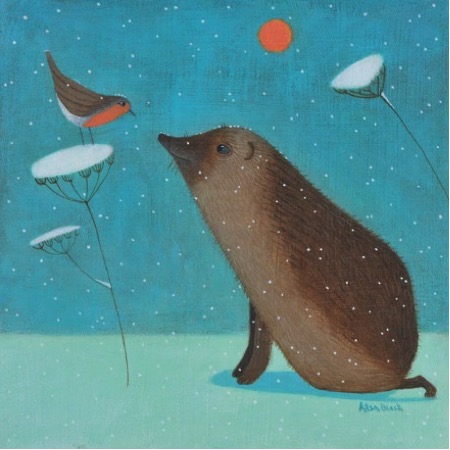
'Hedgehog Of Happiness"
How did the red effect the work you sent for the exhibition?
I just painted using the same palette I normally do. I have overheard people talking about buying a piece of work at my open studio event and trying to decide whether it would match the curtains. I’m not squeamish about these things but I wouldn’t paint anything to match a wall colour just like I wouldn’t choose a painting to match curtain colour. I just paint what feels right at the time!
Your work is small. Can you discuss this in relationship to the space?
Yes my work is generally quite small. I trained in Illustration so I’m not used to working on a huge scale. I just carried on working the way I normally do. I think it gave a good variety of work and a depth of subject which you wouldn’t be able to cover if you did fewer but larger pieces of work. Also it makes them more affordable. I think because I had over 70 pieces if filled the space quite well in the end.
Humour plays a huge part in your work. Please discuss this?
The humour is something that has just evolved. My paintings always include animals or birds and I think there is a lot of communication going on between them that we as humans are not aware of. I imagine they have conversations like I image I converse with my dog. The communication is there I think it’s just that we don’t always recognise it and animals understand a lot more than often we give them credit for.
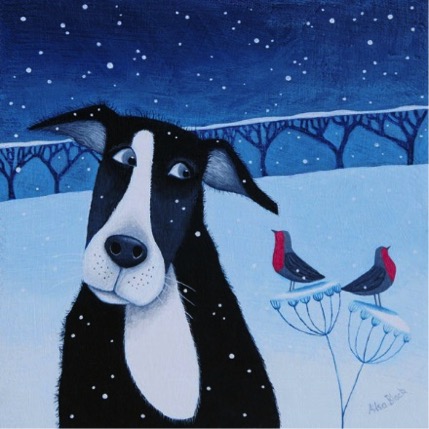
'Hoo Many Snowflakes’
Part of the humour in your art is held within the titles, ‘Broon Coo’, ‘The Offering’, ‘Biding Time’, ‘Pep Talk’. Please discuss the title and these works.
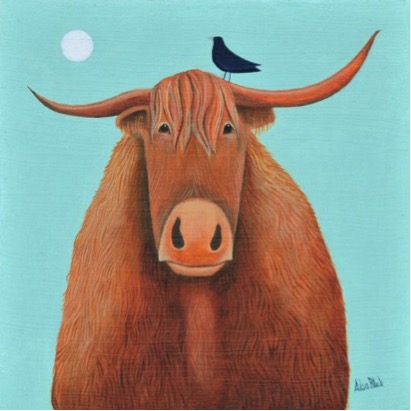
'Broon Coo'
I suppose the titles reflect the capture of a moment in time and an insight into the companionship of the creatures and people in the painting.
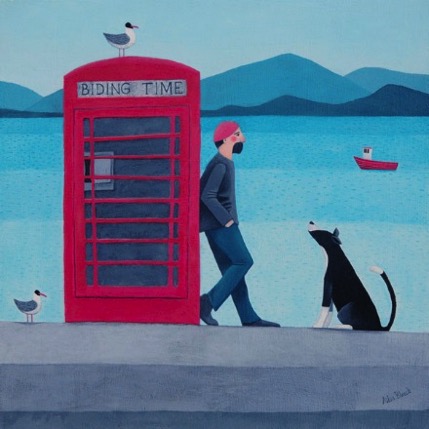
'Biding Time'
Your work is so light hearted.Can you expand on this?
I grew up in rural Scotland with chickens, ducks, doves, cats, mice, cats, rabbits and so on. Animals have always played a part in my life. The titles come from the conversations I image animals are having with their contemporaries or with us humans. Animals bring so much pleasure to our world...we couldn’t live without them.
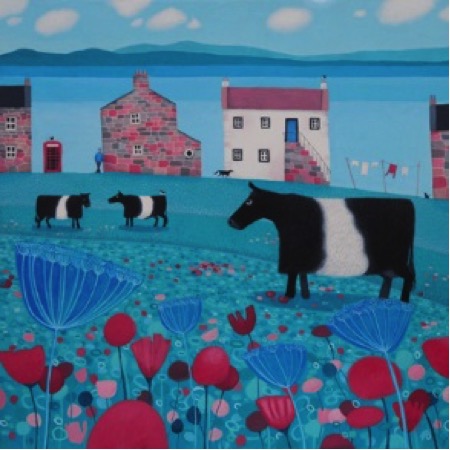
‘Mooching an’ Mooing’
Discuss ‘One More Wee One’
Inspiration: The lovely Belted Galloway Cow
Size: 20cm square
Use of Colour: Deep red, paynes grey, white and some brown for the robins
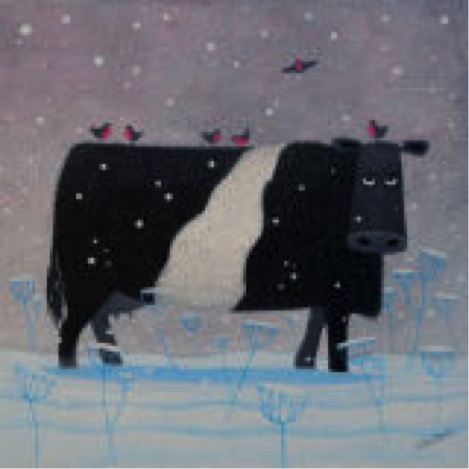
'One More Wee One'
You use a limited colour palette Can you explain why?
I think if you throw in too many colours to a painting it can look like a big dog's dinner! It gets messy and disjointed. I like my work to have a coherence which the colour helps bring together. I suppose I like to work compositionally to be well balanced and the colour is another facet of that.
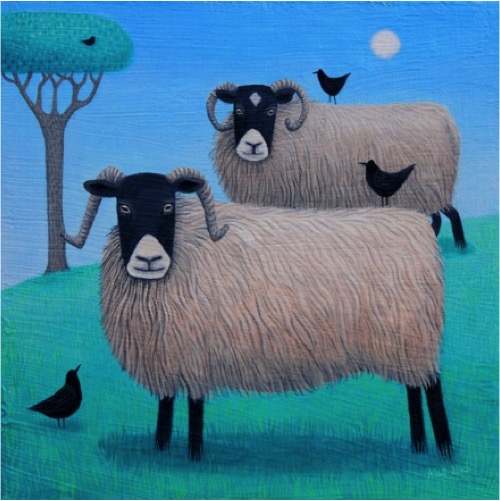
‘Woolit Beasties’
Can you discuss the process your work takes, from idea to completion.
I start with a sketch often just something done quickly and roughly. Then I work the sketch up on to a canvas board which has been painted with layers of modelling paste and primed. Then I start to layer the paint up. Often it will take 3 or 4 layers of paint to get the effect I like. Sometimes I put it on in fairly thin washes and quickly wipe it off again before it dries so you can see the lower layers of paint underneath. All my work is then photographed and some of it goes to be made in to greetings cards or prints which are either published by myself or licensed out to publishers.
Discuss your use of a sketchbook?
I don’t do a great deal of sketching from life but I do use sketchbooks for working out ideas and playing with new compositions. They are useful for information gathering but pressure of time means I don’t use them as much as I could.
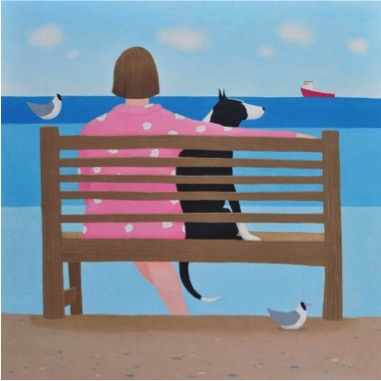
‘Maybe One Day’
Discuss the way you decide on what will be original and what will be made into prints and the edition numbers?
Oh it’s not very scientific…I just pick the ones I like most. Sometimes I can gauge whether something will be popular by the reaction I get on social media which is a useful tool for gathering public opinion!
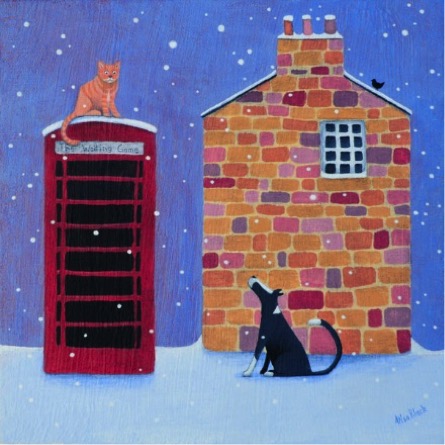
‘Waiting Game’
You participate in Open Studios, can you give us your thoughts on the pros and cons of being part of Open Studios?
I love our annula open studio event. I am very lucky because I live in a part of the country where there is a formal event which artist are selected for. It is very well organised and I always have a good footfall. I use my local village hall because my studio is really too small. The local community run a café over the weekend and serve soup and homemade cake so it becomes quite an event!
Can you take us into your studio?
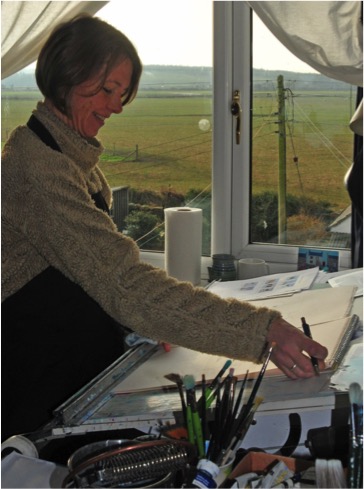
Where is it?
My studio is in the converted attic on the 2nd floor of our very old house. The house was built around 1800 and is a bit cold and draughty but has the most fantastic views facing the sea. I love living in a small coastal village. I know everyone who lives here and we all help each other out when the weather is bad. There is just a row a houses, a bus shelter, a phone box and a pub! The pub is an important hub to meet friends and socialise especially in the winter evenings when it is dark and cold. It’s a 26 mile round trip to the nearest supermarket and you can’t order a take-a-way. There is a mobile post bus which comes to a village about 6 miles away so even posting something becomes an outing.
How important is this space to your work?
Well I look down on to a stretch of beach and sea. From the studio I can see otters, porpoises, seals and lots of bird life. It is my inspiration even when the rain is battering off the window!
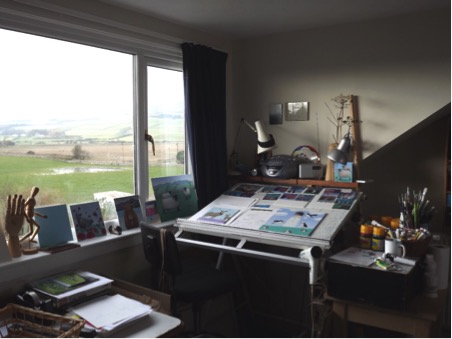
What you love about your studio?
I love the big windows, the light and the views.
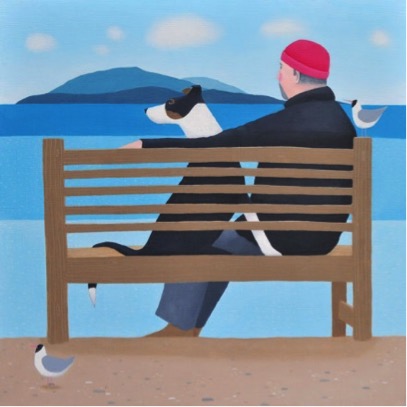
‘Maybe two Day’
Contact details.
E-mail: ailsa.black@btinternet.com
Website: www.ailsablack.com
Ailsa Black, Dumfries and Galloway, Scotland
Interview by Deborah Blakeley, February, 2015
Alesandro Ljubicic
Alesandro at his easel
Explain how your relationship with Sean Cook (Sydney florist) began?
Our working relationship began when Sean enquired about one of my paintings that was in the window of Art2Muse Gallery, which is directly opposite Sean’s florist. We then met and started discussing the idea of a collaboration.
Discuss how your large current floral paintings have developed since meeting Sean Cook?
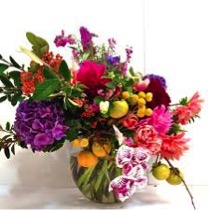
Since working with Sean, my way of viewing floral arrangements has changed dramatically. Sean has introduced me to flowers in such amazing colours, textures and shapes, and what makes them even more amazing is the way Sean skillfully puts them into beautiful arrangements that I could only dream of.
How did you and Sean work together for your latest exhibition at Art2Muse in Sydney?
Every month Sean and I discussed ideas for colour palettes and shapes for my next painting. From here Sean would take what we discussed and come back to present me with an amazing arrangement (which never ceased to blow me away!) I would then begin sketching and coming up with idea on how I would best represent my take on Sean’s marvelous creation.
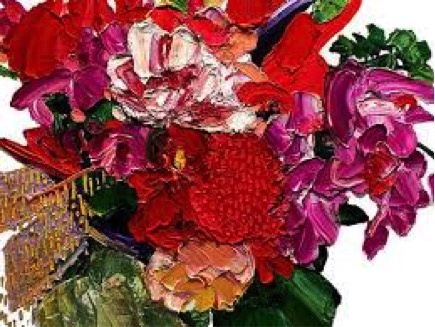
Inspiration comes from many places. Can you discuss the connection between the marriage of George Clooney & Amal Alamuddin and your flora painting?
This was actually just a simple coincidence! About a week after I finished painting that particular painting, the photos of George and Amal were shown around the world.
I couldn't believe my eyes when I saw how similar the composition and palette of Amal’s dress was to my painting so I had to share it!
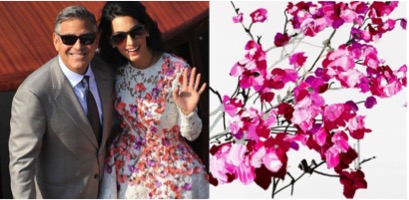
Your works ‘Jaune Violet’ and ‘Naples Italian’ are very different from your current floral paintings. Discuss how you have developed your work?
My new work is more exciting for me as it’s created with more emotion, which I express through large, bold, gestural marks.
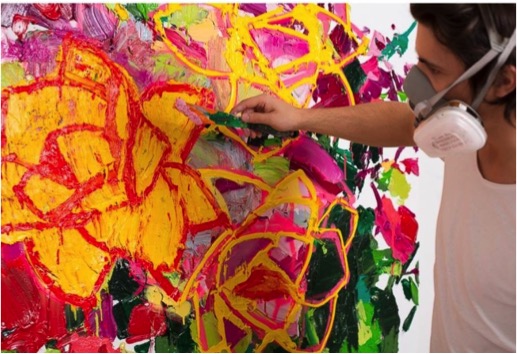
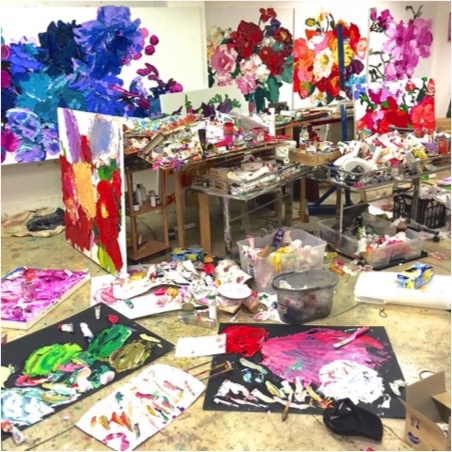
Expand in the technique you have developed by layering paint to create a 3D effect?
The key to the 3D effect is to keep adding more layers of pure oil straight out of the tube with minimal mixing to keep the colour vibrant and clean.
Discuss the importance of winning the ‘William Fletcher scholarship and an exhibition at Xavier Art Space propelled your art career?
Winning really gave me a confidence boost and made me realize that art in this country is so well received and respected by all, and it made me see that I wanted to be a part of it.
You have also started The Sydney Art Store, this must be similar to being a kid in a lolly shop! Can you discuss this?
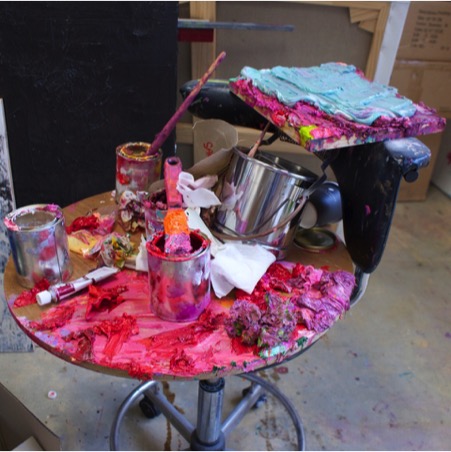
You have hit the nail on the head! It’s exactly like being a kid in a lolly shop, but don't be fooled, I still have to pay for the paint!
Your studio is above your business, how do you separate your time?
From 9am-6pm every day, I work with other artists at The Sydney Art store to help them solve the issues in their work while at the same time relating my work back to theirs. In the evenings I get away from this and move to my studio where I spend several hours on my own paintings.
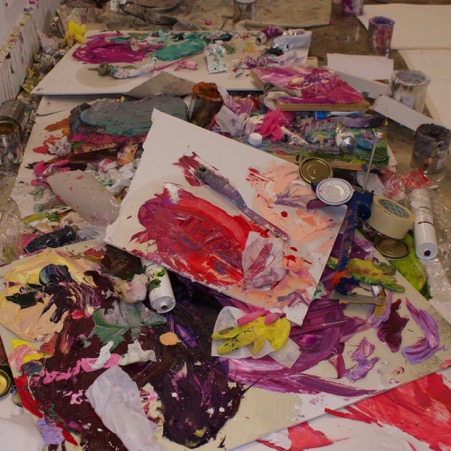
Discuss your colour studies and the relationship with a particular painting?
The colour studies for me are very important as they give me answers to how paint can be sculpted whilst at the same time gives me an understanding of how certain colours work together.
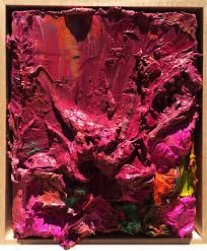
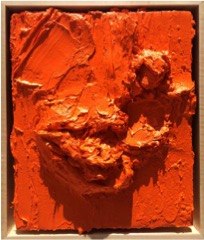
Alesandro using colour
Can you tell us about the Archibald Prize?
In 2013, I was lucky enough to be working with George Gittoes while he was in Australia.
For me this was so, inspiring as I wrote essays and studies about Georges Art whilst in High School and to have an opportunity to be working with him side by side in his studio was beyond anything I could ask for.
The Archibald Prize is regarded as the most important portraiture prize in Australia. It was first awarded in 1921 after the receipt of a bequest from J. F. Archibald, the editor of The Bulletin who died in 1919. It is administered by the trustees of the Art Gallery of New South Wales and awarded for "the best portrait, preferentially of some man or woman distinguished in Art, Letters, Science or Politics, painted by an artist resident in Australia during the twelve months preceding the date fixed by the trustees for sending in the pictures. Source: Wikipedia
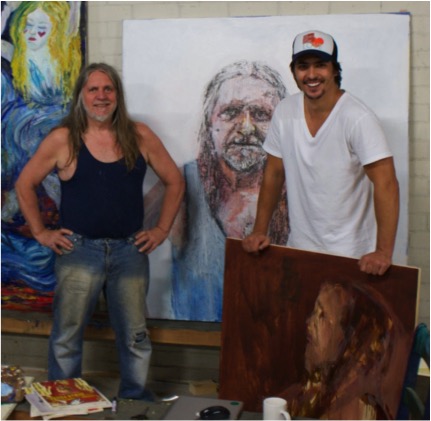
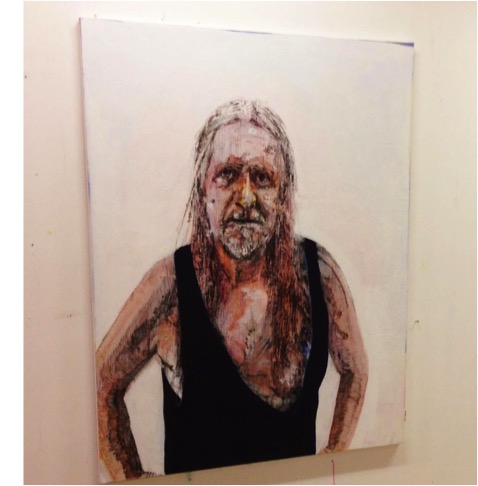
Contact details.
mail@alesandroljubicic.com
Alesandro Ljubicic
Studio
940 Bourke St
Waterloo, NSW 2017
For a full list of available works and price list, contact Zaria Forman at the email above.
Alesandro Ljubicic, Sydney, Australia
Interview by Deborah Blakeley, February 2015
Tracy Luff
What lead you to use cardboard?
It all started when I was studying art. We were given a task to create sculpture or artwork from recycled materials. I think I actually forgot to bring some materials so I simply took some old cardboard boxes from the industrial bin. That is where it started but there is more too it. Working with the fluted cardboard I soon discovered that beneath its surface was a dynamic and interesting medium. The variety of textures I discovered and the variations possible, simply by cutting it a various angles was amazing to me. I also loved the earthy and humble colours the cardboard came in. The more I worked with it, the more excited I became.
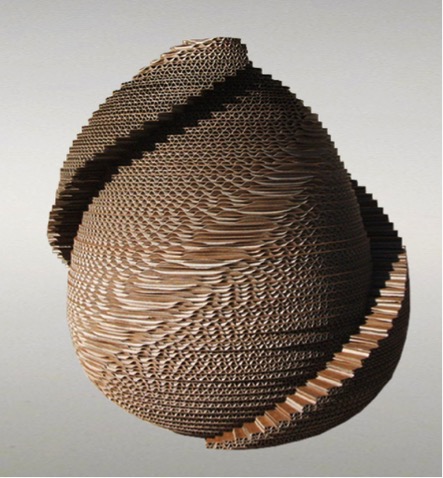
'Pivotal'
How do you store your collection of cardboard?
I have never thought of my stock pile of cardboard as a collection. Since I needed so much of it, I was always on the look out for the right kind of cardboard. They all vary so much in quality, from soft weak cardboard that is not durable enough for my work to really hard or even brittle cardboard which is also unsuitable. I quickly discovered the brand names associated with the best cardboard – that is the brands of whitegoods or car part manufacturers etc that use the cardboard for their packaging. So I soon had a store of the best cardboard that I simply store flat in a waterproof shed.
How important is the print on the outside of cardboard boxes to your work?
'Hill"
Generally speaking, the print on the cardboard is not important in my work as it is the exposed cut edges that are predominant in creating textures and visual effects. Occasionally the printed colours do show through in my work, usually in an accidental kind of way rather than by design
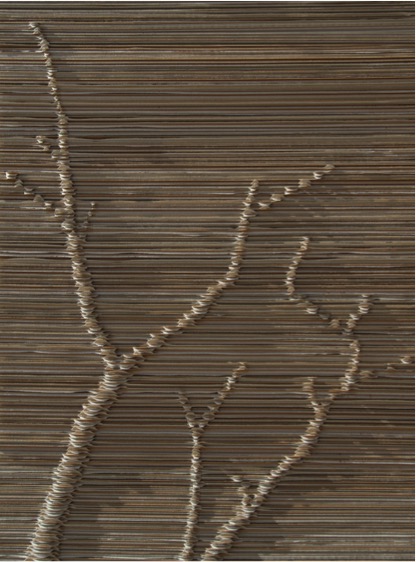
'Bare Land'
Discuss your feelings about the importance of using recycled materials in your art?
I don’t set out to voice an environmental message; although due to the nature of the medium that message or interpretation is always there. It is challenging to create work that surpasses that basic environmental message – I mean that I want my work to say more than speak simply of the medium it is constructed of. Having made that point, I still have strong feelings about re-using and recycling resources. I grew up in a culture that held those values more or less out of necessity. We never threw things away that could be re-used or recycled in some way
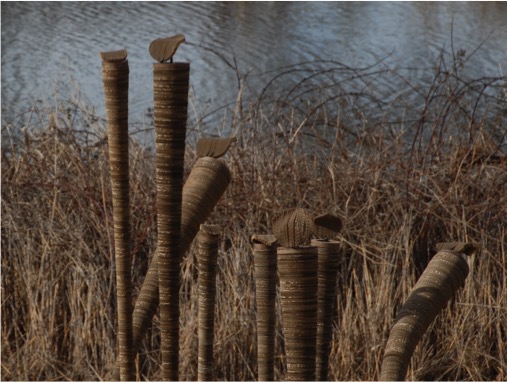
'TDO'
Explain how your artistic career has developed since your arrival in Australia in 1997?
I actually arrived in Australia in 1985 but didn’t formally study art until 1997. As a child I was always very creative, in fact I often recycle materials to create craft works. In 1997, I commenced formal studies in fine arts at the Newcastle TAFE. I studied everything from drawing, painting, print making, sculpture and photography at the Diploma level. When I enrolled for the Advanced Diploma course, I focussed on painting and sculpture. It was my work in fluted cardboard that attracted the most notoriety so as much as I loved to paint and sculpt in a variety of mediums, my work became dictated by this humble yet powerful medium. In my early years my focus was on gaining as much exposure as possible and I did this by entering as many competitions an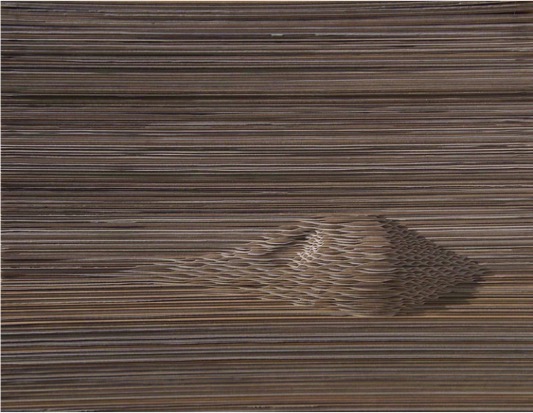 d group exhibitions as I could. …..
d group exhibitions as I could. …..
Discuss the process your work takes from inspiration to the finished piece.
Inspiration for my work can come from literally anywhere. Often I am creating work as a response to a theme presented to me by a curator, other times I am designing for a particular space where the work will be exhibited. Also the medium itself talks to me, i.e. I respond to the way the medium feels or looks as I manipulate or shape it. Often I get ideas for new works when I am working on current work. I always make notes for future reference. All my ideas pass through a visual diary where I sketch to develop ideas and inspiration can also be a product of this process. I have often woken at night and found myself madly sketching ideas that came to me during sleep.
Once I have developed my concept for a work I nut out the finer details like proportion and scale using mainly drawing, but often by manipulating images on my laptop. I nearly always produce a Marquette, especially for large scale work. A lot of my projects cannot be assembled in my studio so the Marquette is essential to get an overall 3D image of what the work will look like.
Planning the production of the work sometimes requires the use of a spread sheet program to calculate sizes and quantities of individual cut pieces. Depending on the work, steel frameworks, internal support structures, suspension methods, attachment or joining techniques need to be designed and made. There is rarely a project that doesn’t require some level of technical problem solving to accomplish.
Production of the artwork components is quite laborious and time consuming. I get lost in the repetitive processes of marking out, cutting and sorting the individual pieces before assembly. It really feels like factory work to me and transports me back to my younger years when I worked in factories during my school holidays to make extra pocket money.
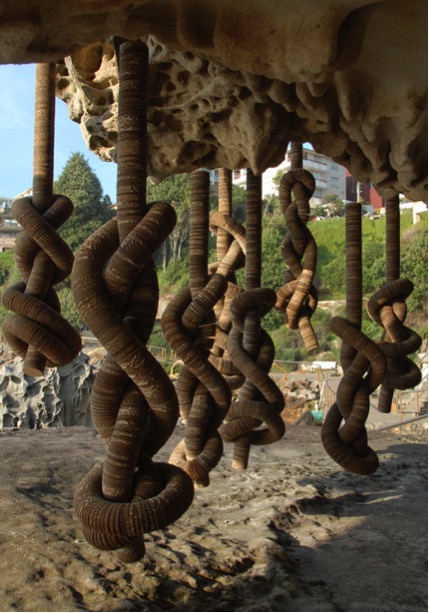
'Rising Tensions'
Assembly of large works requires a well-organised space and sometimes that means outside in my back yard. Most of the time I will also pack my work, transport and install it myself – with the aid of my Husband.
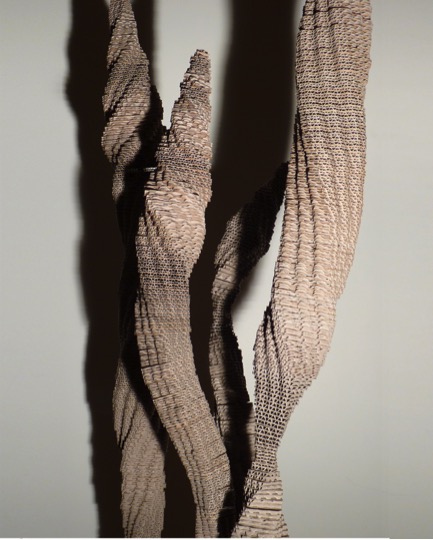
'Shoots'
How about durability, is this a question you are often asked?
Most of my work is designed to be in doors and the main question of durability related mainly to the archiveability of the work. Fluted packing cardboard is not archival and not designed to last forever. As I had not been using it for very long, I couldn’t be certain about its longevity either. I investigated it through industrial chemists and by looking at examples of cardboard used in art going back a long way. I concluded that it would last quite well under relatively stable conditions – the kind of conditions most artworks would be kept in. I was curious about how it would cope outside in the weather so I created an installation called “The Different Ones” and installed it by a lake where it endured wind, rain and the hot sun over a period of six weeks. It did survive admirably and to this day that work is still in my garden after five years weathering gracefully.
Discuss the importance of having a good gallery space for your work?
It is important to me that my work is exhibited at its best and this means the space needs to be good. In most cases, I will install the work personally so that I am happy with the way it is presented. I work hard to create the work so I want people to see it at its best. Often I will check out the gallery space before I create the work so that in essence I make the work for a particular space.
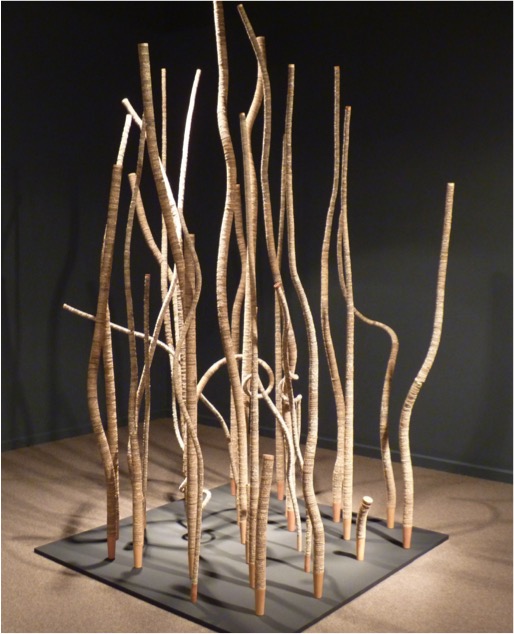
'THe Sticks'
Discuss the relationship between your medium cardboard and your organic shapes?
I have always been conscious of the origin of cardboard. It comes from trees and trees are organic living things. The cardboard still contains the DNA from the trees it came from. I have never seen cardboard as originating from a box – it has always meant more to me than a utilitarian packaging material. Initially, I wanted people to see the link between my work and the medium’s origin and also to be able to look beyond the flat surfaces and right angles of a cardboard box. I wanted people to look below the surface and beyond the obvious – towards the hidden beauty within.
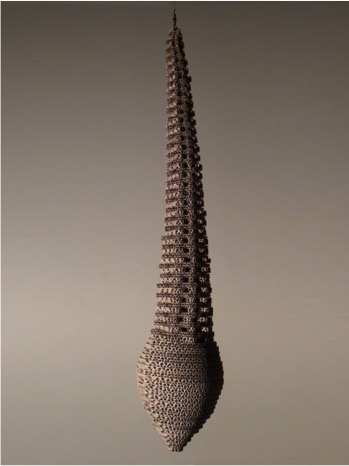
'Waiting'
Do you always work in series, e.g. Paddock?
I think series’ of work reflect the excitement I feel when working in this medium. I just can’t stop at one, and each new work develops a little further, or I discover a new nuance that I want to explore. Sometimes I create a series of works simply to fill a space – to create a bigger impact or prevent a small work being swallowed up by a large space.
What are you currently working on?
I am currently working on an installation for the CODA Museum at Apeldoorn, Netherlands. The exhibition, titled CODA Paper Art puts paper and cardboard centre stage as a material. It opens on 7th June, 2015.
Contact details.
art@tracyluff.com
Tracy Luff, Goulburn NSW, Australia
Interview by Deborah Blakeley, January, 2015
Peter Randall-Page
You grew up in the country. Do you think, if you had been a city boy, your work would have been different?
Very much so, I was quite a solitary child and spent my days exploring the countryside, collecting natural objects and being rather self-contained. This fascination at looking at the world around me and my place within it has informed my artistic practice ever since.
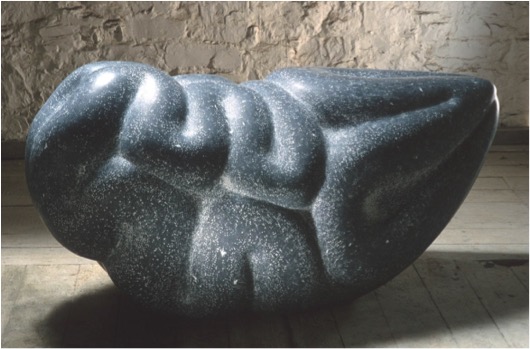
' Beneath the Skin, 1991, Kilkenny limestone '
photo credit: Chris Chapman
Can you expand on the way you have used continuous coils to create works?
When one looks at a coiled object it conveys the potential to become something more: what happens when it unravels, uncoils, unsprings? The idea of conveying that latent dynamic tension within a material as dense as stone appealed to me, what might be below the surface? What is being concealed? I hope to engage the viewer in a dialogue of what might be beneath.
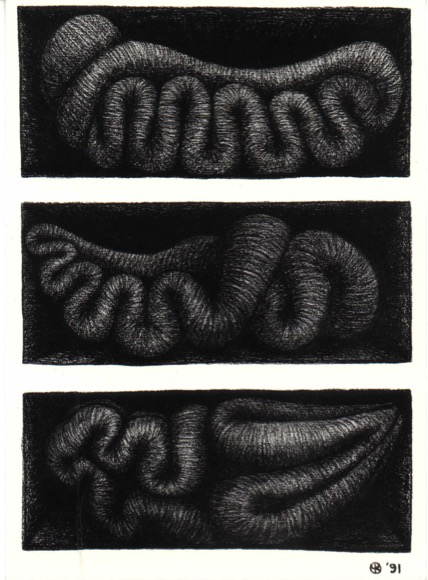
'Three Dormant Objects, 1991, charcoal on paper'
Can you discuss how you run a parallel between your drawings and your sculptures?
Drawing has always been an important part of my practice as a sculptor.
I always carry a sketchbook and use drawing in many different ways:- objective drawing as an aid to memory and analysis, drawings for sculpture, technical drawings to help explain my ideas to architects, engineers and clients, and other drawings which are not preparatory to anything but works in their own right.
Some ideas reappear over the years in countless sketchbooks before becoming sculptures and conversely, sometimes I have a frenzy of drawing activity for the pure delight of mark making, such as the recent ink flow series. Both approaches are vital to my work.
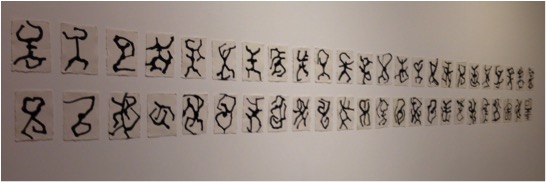
'Ink Flow series, ink on paper, 2013
photo credit: Steve White'
Can you expand on geometry and pattern in your work?
Initially, some of my sculptures were quite literal interpretations of natural objects but in recent years my work has been preoccupied with the underlying principals of growth and pattern formation in natural phenomena: exploring pattern and form, order and randomness, geometry and morphology.
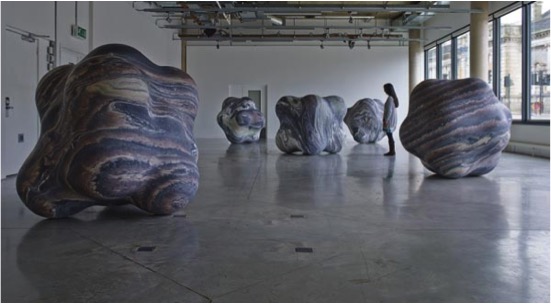
Shapes in the Clouds, 2014 Rosso Luana marble
photo credit: Steve White
You have had three had Individual exhibitions in 2014: London, Devon and Plymouth. We all have 24 hours in a day. How are you able to achieve SO much?
I did have a rather exciting 18 months! What was lovely for me was that each show had a very different feel and dictated a different focus. Due to floor loading restrictions, there aren’t many galleries which can show large heavy sculptures and so it was a fantastic opportunity for me to exhibit at Peninsula Arts, Plymouth, to be able to produce a new body of work without worry of constraint. The exhibition at the Thelma Hulbert Gallery, on the other hand, couldn’t have been more opposite, a domestic and intimate space, it was all about works on a small scale for which I produced a new body of prints. Then the Pangolin show was different again, working with Pangolin Editions.
I spent several days playing at the foundry and they converted these musings into the Inside Out series. Of course, it would be impossible to make all these works single-handed and as well as the technical brilliance of the foundry I also have the support of a very good team here at the studio.
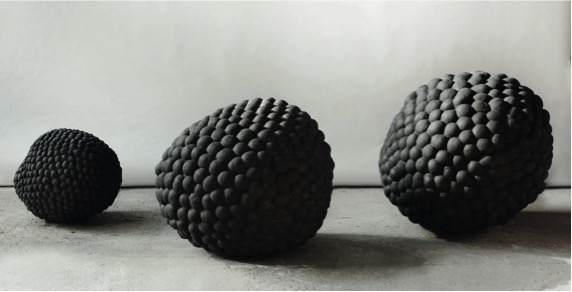
'Inside Out 2014 bronze'
photo credit: Steve Russell
'Natural Order' at Purdy Hicks Gallery in London was a group show with seven artists. How did you collaborate, or was this done by the gallery?
I have exhibited with Purdy Hicks Gallery both as a solo artist and in group shows for a number of years, they approached me with the idea of Natural Order and it appealed to me.
Did you know all of the other 6 artists before the exhibition?
Yes indeed, which is why I had no hesitation in agreeing to the exhibition.
What are your criteria for a Group exhibition?
I think there has to be some cohesive whole created that makes the exhibition more than the sum of the parts.
Can you discuss your thoughts on the value of working in group exhibitions?
I think when group shows work well there is a spark created which adds a frisson to the whole: allowing space for the unexpected to happen.
Your work is in many Public Collections, can you take one that you remember as giving you a huge boost to your career?
Honestly, I am still delighted every time a work of mine is entering a public collection but without question, the biggest boost was when the Tate bought Where the Bee Sucks.
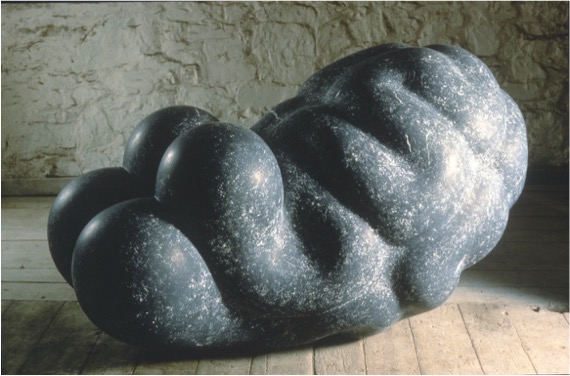
'Where the Bee Sucks', 1991 Kikenny limestone
Discuss the importance of Public Art:
- In relation to the surrounding it will be placed in?
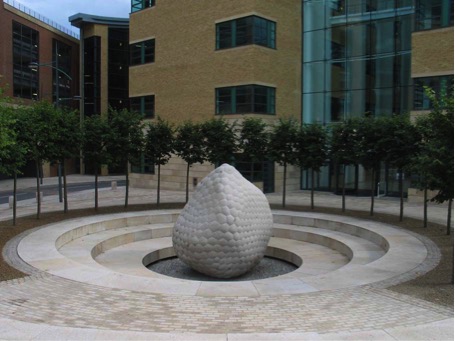
'Give and Take', 2006 granite and associated hard landscaping
For me, public art is at its most successful when it is integrated into its environment rather than being an ‘add on’: sometimes a development can be near completion before the public art element is addressed. With the commission I undertook for Silverlink Properties in Newcastle I was involved from the initial stages, working with Southern Green landscape designers, to problem solve the different ground heights, need for seating and creating a calm, intimate environment within a busy urban square. I feel we achieved something that wouldn’t have been possible if I’d been called in later in the day: this sculpture went on to win the Marsh Award for Public Sculpture.
- The visual impact it will add to the space?
Often, specifically with urban developments, so many considerations such as parking, transportation, access, utilities and emergency procedures have to be addressed that a sense of human scale and interaction can be lost. Public art can transform an environment, creating a focus and allowing the viewer to indulge in a moment of reflection.
How the sculpture will cope with the weather conditions?
This will naturally vary according to the artist and the artwork: with my granite works I can imagine an archaeologist of the future uncovering a destroyed city and my sculptures will be more or less exactly as they were when they were installed!
- How the sculpture will cope with the public?
My sculptures cope well with public handling: though ‘Seed’ at the Eden Project is beginning to be polished at around 1.5 meters high as the hands of visitors caress the bumps, adding an unexpected but rather lovely aspect to the work.
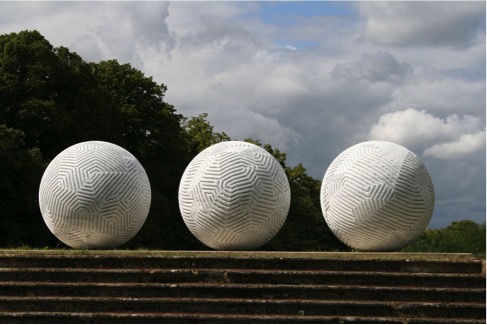
In Mind of Monk, 2008 marble
Can you give your thoughts on the importance of large Sculpture Parks, like the Yorkshire Sculpture Park, in the life of a sculpture?
Several of my sculptures are made to commission and go directly from the studio to their final home. Showing works such as In Mind of Monk at the Yorkshire Sculpture Park allows these pieces to be seen by thousands instead of a few.
Contact Details:
Website:www.peterrandall-page.com
Email: contact@peterrandall-page.com
Facebook: https://www.facebook.com/pages/Peter-Randall-Page/46843490580
Peter Randall-Page, London, England
Interview by Deborah Blakeley, January 2015
Antoinette Badenhorst
You did your training in South Africa. Was this very different from the training available in the USA?
I did a few workshops in the US, but taught mostly. I did a lot of research on the internet about the direction I was following and consulted with several potters that are more advanced than I am. They were always very generous with information.
Explain the “porcelain” in your work?
Porcelain clay is made up from pure raw materials found form different sources from across the world, thus manmade. The main ingredients of porcelain is silica ( the glass former), feldspar ( the melting agent) and kaolin (the actual clay, which in itself is not very plastic) These raw materials have a larger particle size than other clay bodies, due to the fact that it is mined at, or close to the place where it is formed. Clay manufacturers add different plasticisers to make the clay more workable these days, but often at the expense of one of the pure qualities of porcelain, which is translucency and/or whiteness.
I love the true qualities of the medium, because it reminds me of the unpolluted country in which I was raised.

Envelope
Discuss the importance of the translucent quality of your work?
I was raised in a country, where one could see mountains a 100 kilometres away on a clear day and where I learned at an early age what the differences between real water casting and mirages was.
As a child I often observed the translucency of the sky and clouds, lying on my back on the grass behind our house on the farm where I was raised.
Many days I would walk on the hillsides and this is where I became aware of rain approaching in a translucent curtain, until it poured all over me.
I dreamed my study hours away in front of the of the window of our study hall in the dorm where I lived during the week, observing how the clouds over the Khomas Hochland Mountains changed from oranges and red to purple and pink before the sun sinks behind the mountains. When the moon and stars finally appeared, it came so close and clear, that one could almost pick it from the sky.
These are qualities, among others, that I like to bring out in my work. Porcelain that is worked like clay, but are fired to a glasslike matter, allows me to do that.
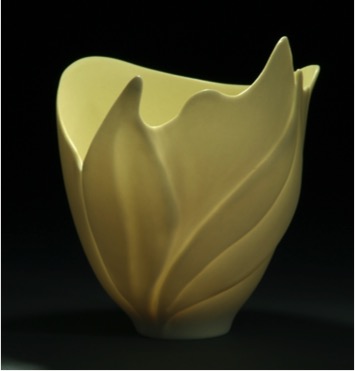
Your work is both hand-built and thrown. Explain the techniques in relation to a piece using each particular technique?
I love working on the potter’s wheel. The way that the clay moves always fascinated me, but it was years before I realized that the movement of clay, resonates with my whole philosophy about life, nature and the interaction between our physical and emotional lives and how everything goes around in circles, cycles and seasons.
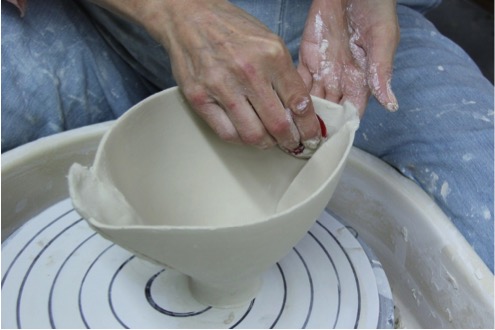
Just throwing on the wheel however, limited my vision. Not everything in life spins in a perfect circle. In fact, it spins out all the time. As humans we are affected by things that happen to us and our interaction with people around us. It brings seasons of happiness and sadness to our lives. We live and become successful in life, but then we grow old and make room for others to take our place and when we die, new babies are born.
So my original perfect wheel thrown pots had to break out and find its own way. Just as in real life, our centres do not always start from the centre, I had to find ways to “misplace” the centre and my envelopes were born.
These envelopes are formed in press moulds, which are basically shells that I put together to form an enclosed oval form. It allows me to take it in any direction that I wish to take it.
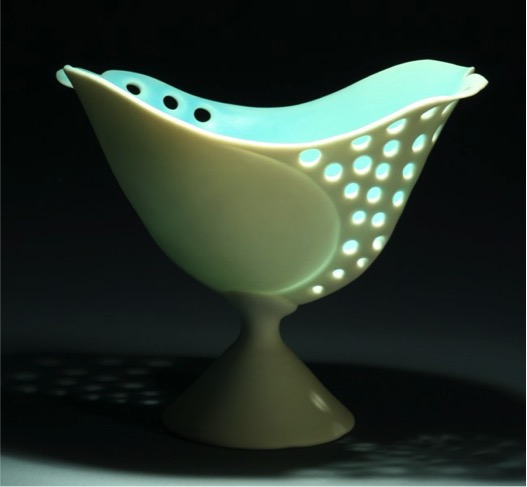
Can you explain the design process you take to make a new piece?
Much of what I do comes almost automatically, just because I am experienced with my designs, but all designs begin with some inspirational object or event, mostly directly or indirectly (a saying or a song) from nature or the lives of people around me. From there I have to either make a model or have to draw it.
This would only be the beginning, since the effectiveness of an object drawn, or modelled change as it becomes alive. I see these design processes as permission to change and re-design as I create.
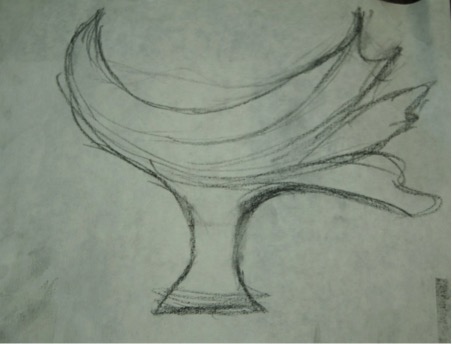
Explain how you incorporate the very old technique of pinch pots into your current work?
Pinching clay is a very underestimated and under used clay technique. I think the reason is that potters often see it as a technique to train beginners.
Just the opposite is true for me. To be able to pinch and shape a piece of clay by hand to the point where its limits are pushed and it still has a beautiful flowing quality, is a very advanced technique.
Pinching is often just the connection that is needed between two clay slabs or to extend a wheel thrown pot. It is tricky to pinch a raw piece of clay into these “smooth” surfaces and make a smooth transition. The way that one’s eye has to flow (or has to get interrupted) over a clay form, is a very important design quality that I like to use effectively and pinching clay helps to achieve that.
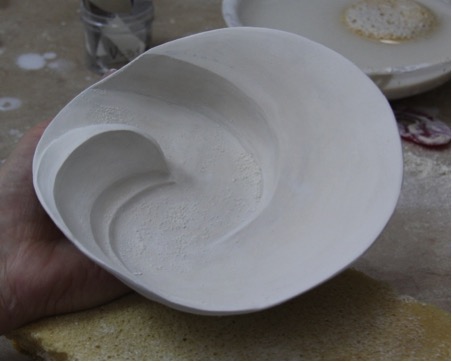
Discuss the processes you made in the firing to get the colour and glaze you require?
It is relatively easy to create porcelain glazes for high firing. The basic raw materials that will mature at 1260 are often found in porcelain clay that matures at the same temperatures. Other than stoneware and earthenware, porcelain clay and glaze becomes a single layer. The interaction of glaze and clay materials when fired to maturity makes it the strongest fired clay medium, despite its fragile appearance.
I created a few basic glazes that have a matt, satin or glassy appearance. To these basic glazes I add mason stains. I like to work along with the fashion colours of the season. I know it is not how artists are “supposed” to work, but I believe there are much more to creating art than only what I believe in. Firstly, there is no right or wrong way, but a comfortable and effective way. Art only becomes art when it resonates with someone and if colour is what attracts people, so be it.
Secondly I am personally very affected by colour. The subtle nuances of colour as it find its way through the walls of my vessels is intriguing.
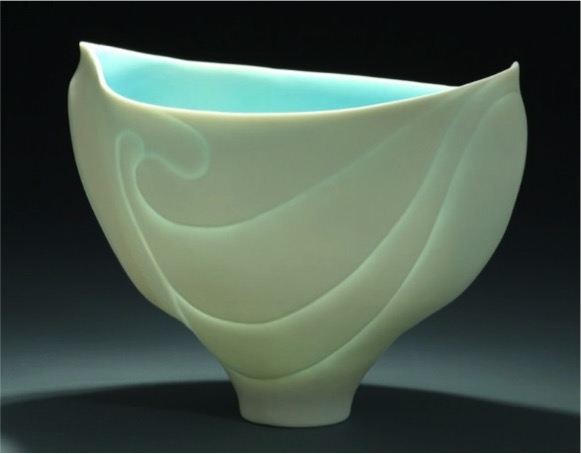
When I have to come up with a new colour, I would seldom start from scratch with a basic glaze. I would use the older mixed up glazes (I seldom mix more than 1 litre of glaze at a time) and alter it to get the required colour. An example is a soft green glaze would become a bright lime glaze the next season, just to become a yellowish old gold the year later. The challenge lies in the “reading” of the colour nuances.
It is a rule not to put more than 10% colorant into a basic glaze, so I have to keep filling the bucket up with a basic glaze. I am not always successful, but I do see one failure as an opportunity to do better next time.
Please discuss the mark you use on your work?
I allow the form of the basic vessel to lead me. Due to the nature of porcelain, I would often allow a form to find its own direction within my original design thereof. I want the viewer’s eye to move comfortably and with pleasure over smooth lines.
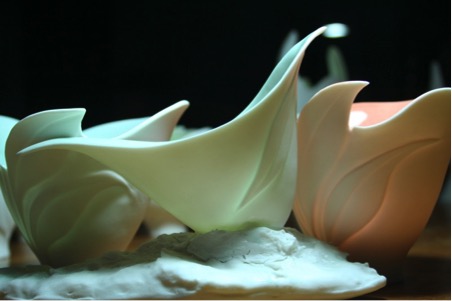
How did you develop the mark?

I use a charcoal pencil and draw lines over the leather hard clay and keep doing that until I find a pleasant line. From there I carve clay away to form a soft rounding.
Sometimes I will re-wet the clay (one of the beautiful characteristics that porcelain will allow the maker to utilize) and push parts of the wall out to place emphasis on these areas.

Where do you normally place the mark?
It depends on the form.
Sometimes I will cut parts of the rim away and follow up with incising into the wall as I described above. If it is a plate or a shallow bowl, I will carve the interior. When it is a taller object that may be seen from the side rather from inside, I will place the emphasis on the outer wall. The effects will differ, since some of it may be glazed over the marks and others will show shadow and light, mingled with colour as it seeps through the wall with the translucency.
Lately I started to carve in and out, but it is tricky, because in the translucency that may shine through, these lines has to work together to make the design successful.
What is the importance of the use of an artist’s mark?
It took me a while to develop that mark, but I believe that is what defines my communication with my viewers. I have a story/message to tell.
Nothing under this sun is new, but if I would not develop my own honest body of work within that frame, but copy someone else’s, I will not be honest to myself or anyone around me.

I trust that by looking at my work, the viewer can directly recognize an “Antoinette Badenhorst”
Can you expand on the two pots you have in the collection of the Mississippi Museum of Art?
I have one piece in the Mississippi Museum of Art collection and one in the Gumtree Museum of Art, Mississippi. The Mississippi Craftsmen’s Guild also has work in their collection.
These collectors pieces stems from my early days in the USA. At the time I was working with porcelain in a different way. I used the porcelain qualities to obtain fine
I also have works in private collections of celebrities and in Enzogama in Biei, Japan and in Museums in South Africa.
Teapots
I guess any true potter is attracted by the teapot making process, since it is a great theme for expression. It has its own design challenges and if it needs to serve as a utilitarian object too, it becomes even more complicated. Some potters will only use it as an object of ornamentation or sculpture.
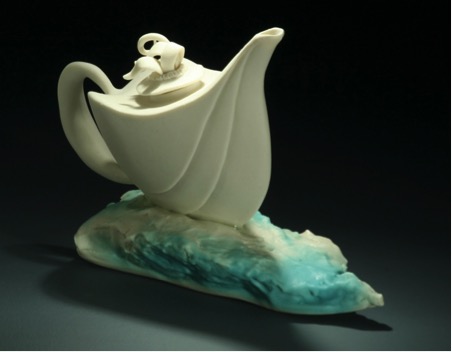
‘Teapot’
Inspiration?
Teapots fit very well into my overall theme of circles, cycles and seasons. The emotional feelings that we have often influences those around us and vice versa. It “flows” from or too us. The body of a teapot that receives liquid through an opening and then pours it out through a spout conveys the same idea.
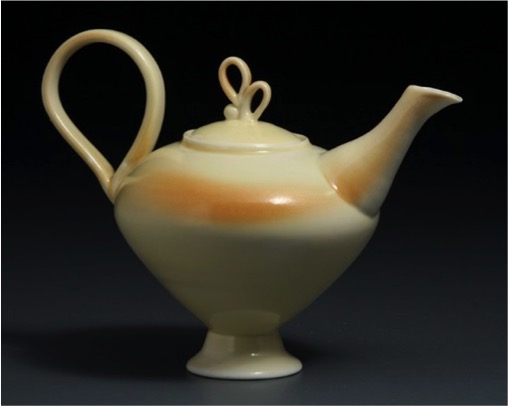
Problems in the process?
Oh, teapots have many design challenges, because it has so many parts to it that has to balance. A misplaced handle or spout will make it difficult to get a nice flow of liquid, but at the same time it may also limits a nice flow of the viewer’s eye.
Any kind of spout requires fine planning, because liquid must organize itself to move from a hollow body into a spout and out without dripping and splashing everywhere.
I have a problem with potters making heavy, oversized teapots that does not function well. Too often we may use the excuse that a heavy teapot is meant for a sculpture, but I disagree with this approach. If it looks like the real deal, it should function like the real deal.
The importance of a snug lid?
You ask questions that may get me into a very unpopular situation. LOL!

By measuring the diameter of the opening where the lid will fit and then making the flange 3/4 of the length of the opening diameter, will secure lids from falling out when pouring tea. It is a simple rule that is often ignored by teapot makers with the excuse that one should hold a teapot with both hands; on the lid and by its handle.

A frail person may prefer to hold it by its spout (there is often a little lug on the spout to help pour tea this way) and handle and not worry about a falling or spattering lid.
A snug lid with an extended flange is much more attractive than loose fitting lids. It is however important to have a little hole on the lid to allow stream to escape, or else the pressure may force it out the opening. That may cause a burning hazard.
Southern Ice Porcelain Envelopes - please explain this series?
The envelopes allow me to make larger sized pieces, without taking up too much space on a table surface. My clients like to place against a wall on a mantel or a narrow space in a cabinet or window sill. The fact that I can elevate the piece on a pedestal or stand, allow the message to grow in importance.
As a potter, I admire ancient pottery. I think the forms of my envelopes developed from antique Roman cups on pedestals, although I never hand the intention to make any replicas of any ceramic form.
There is a challenge in working with porcelain, particularly Southern Ice Porcelain. The challenge is raised with envelopes, particularly in the firing.
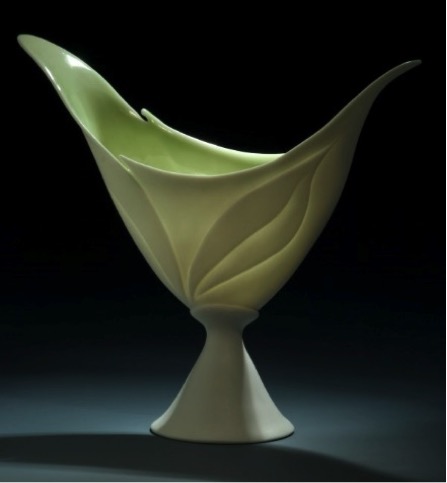
When porcelain is fired, it has a tendency to move in the kiln, because the clay becomes soft (pyro plastic). For that reason the walls of porcelain should be of even thickness and the lower parts should be stronger and sturdier to support the higher parts. My envelopes are carried by its “stem” and when it becomes soft in the firing, the top heavy part can swing into any direction and even topple over. I had to overcome this challenge by learning how to fire these pieces so that I can manipulate the movement. I love the fact that I can leave some of the movement to develop in the fire. That is part of the relationship that I built with the porcelain clay medium, but I have to be very careful in how I place the work in the kiln and not allow the “Diva” to take over completely.
As far as my marks are concerned, I use the same approach as with other clay techniques.
Do you always have a Christmas range?
Not always. In South Africa Christmas is summertime. We did not place that much emphasis on Christmas trees. Here in the States, lights brighten our days and I started out with series of ornaments some years back.
Explain your 2014 Christmas flags?
There is no true challenge in the making of it for me. I used a design that is recognized anywhere in the world, but that carry the triumph of overcoming the difficulties of immigrating to the USA. Every American that owns one of my flags, celebrate that triumph with me!
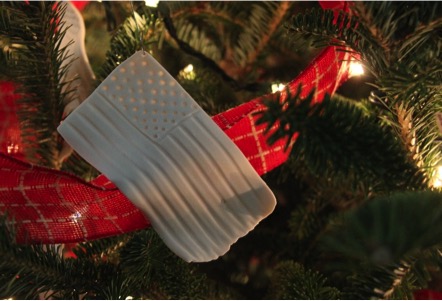
Can you tell us a little about your e-courses?
We love it. I had people contacting me from across the world to ask questions about porcelain and it is often difficult to explain, while it is so much easier to show.
In 2014 my husband Koos, who is my manager and also the person behind my porcelain images and website, and I put a curriculum together for our first “Understanding Porcelain” e-course. We decided that we want to present a workshop to potters, similar to those that I present live at ceramic schools and institutions. We knew we had the ability to bring our classes to people around the world and particularly those that may never have the opportunity to learn in another way than through the internet.
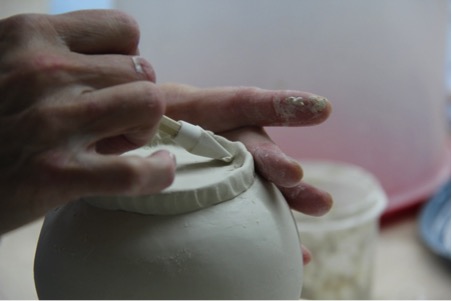
We realized that we can give every student a front row view with videos, but we also had to compete against so many “how to” videos that roam the internet.
We created a forum online through which our students can communicate with us and ask questions. We make it as personal as the internet allows us and by the end of this year we created 2 more courses; “hand building porcelain” and “hand building porcelain dinnerware” Each of these courses was per request of our students. The next logical follow-up will be “Wheel Throwing Porcelain Dinnerware” that we will launch after the re run of “Understanding Porcelain that starts January 5th.
Our classes are set up in a way that it place the emphasis on porcelain, but do not exclude students that want to work in other clay bodies, but would like to learn about clay techniques in general.
We hope to continue with more of these courses in 2015 and even expand it beyond our own studio.
“It is my ongoing task to encourage young and upcoming artists to strive for those elements in their work.” Please discuss?
I was a beginner once in my life. I try to remember that when people ask me questions. I remember how many times I opened a kiln and wanted to throw the towel in. I remember how long it took me to find my way. Other than what people often think, pottery is one of the most difficult mediums to master, because there are 3 main parts to it: learning to master techniques, learning the science behind the medium and learning to express oneself as an artist through clay. Apart from that, there is physical labour involved in pottery making, but the three parts mentioned cannot stand loose from each other if one wants to become successful as a potter.
I love to be a mentor for those potters that take their work serious and that want to grow in and through their clay work.
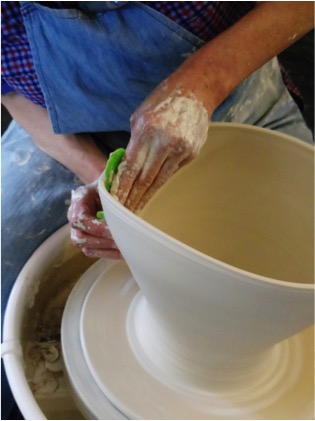
You do international workshops. Can you expand on your workshop in South Africa?
We were traveling through South Africa and Namibia over a period of 6 weeks in 2014 and had the opportunity to meet with old pottery friends and met new ones while I was presenting demonstrations and hands-on workshops in Port Elizabeth, Cape Town and Johannesburg. We stayed with potters and had a very enriching experience.

It was a great opportunity to give back to a potter’s community that raised me as a potter. I was honoured to present the knowledge that I gained here in the USA over the past 15 years to people that was previously my teachers and mentors and as it always is when one give yourself unconditionally, I got so much more back from these people that what I gave them.
Discuss salt in your work and how it relates back to cooking and your daughter?
This relates back to the science of pottery. Much of what I know today was from research that I did as a young potter. In those early days of making pottery, the whole clay process was overwhelming to me. When I learned that by using salt (as it relates to salt firing)can make a simple glaze, I thought the salt that is referred to, is the scientific name for some difficult-to- explain clay medium.

Our middle daughter is a celebrity chef. She gave me some rocks of salt that makes a beautiful display on my kitchen counter. It often reminds me of my early days, when I randomly put salt in the kiln to see what would come out, without knowing how to use it.
I also believe that salt is associated with sincerity as it is described in the Bible.
Can you discuss your thoughts on the importance of the connection between potters and chefs?
Practicing pottery as I mentioned before, is a difficult medium to master. Potters are very passionate creatures as it must have shown in my answers to you by now. Therefor we do not always realize the implications of making things that become permanent objects. Once a piece of clay is fired, it is as hard as rock and even when we break it to pieces; it will stay on earth for as long as it would take for a rock to erode.
As potters we have a responsibility towards our clients. If a food container is carrying a health hazard in some or other way, we should distance ourselves from it.
On the other hand there is something hearty and very personal about eating from a handmade plate. Just like we have our own doctors and therapists today, people had their personal potters before the industrial revolution.
There is a reliving of the art of cooking and to grow our own fruit and vegetables, so it is a perfect time to let the pottery object in households relive too. To become successful, potters should work with chefs to learn what their needs are. After all; potters, chefs and the eating public can create a perfect balanced relationship.
I have the perfect opportunity to learn from my daughter what is needed to present to chefs a perfect container, while she has the perfect opportunity to learn from me what a plate should not be.

Contact Details
www.porcelainbyAntoinette.com
Antoinette Badenhorst, Mississippi, USA
Interview by Deborah Blakeley, January, 2015
Shelley Jones
Can you discuss the journey you have taken with your three techniques to get to the combination you are currently using?
I started as a graphic artist, doing mostly print media work. During that 18 year period I seemed to have little time for making art for my own pleasure. I switched careers, getting a degree in social work, and started silversmithing as a hobby. I only had time to make jewelry at night, and had little interaction with other artists. I decided I needed to find a less cumbersome (for me) and more socially interactive medium. I began to work with glass beads and fell in love with the colors and textures. I explored a range of beading techniques on my own and in workshops. I found bead crochet and free-form beading most appealed to me. I especially like the portability of beads and the ability to work on projects as I travelled for work. I tried to include my silversmithing, and eventually took up silver metal clay, finding I could mold the silver in a way that worked for me. But I still could not quite fit the silver and beads together in a manner that was all my own.
In 2004 I took a basic felting workshop at a beading exposition and got a taste of felt. I found the colors and textures of wool spoke to me as beads had earlier. I experimented with wool, trying to make it do things I was not sure it could do, but enjoying its malleability. I began to add felted elements to my beads and silver and found the perfect combination of elements for my ongoing work.
Discuss the weight aspect of your felted jewellery?
As I continued to explore what felt could do, I especially liked the very light-weight quality of the felted work. As I added beads to the work I was pleased with the contrast between the hardness of the glass and the softness of the wool. I liked the sense of weight and playfulness in the work that I seem to always end up with.
Discuss the combination of felt and beads?
Expand on the technique you have used to create a necklace?
For my crochet ropes, I wanted to embellish them, and the addition of felt helped add dimension, yet kept the weight of the piece down. I use mostly charlotte seed beads because they have a cut side to the bead which catches the light. My choice of beads and colors tends to the less vivid and shiny, with the cut bead adding only a subtle flash of light. I often use a contrasting thread, most often an embroidery weight polyester thread that has little stretch and great strength. I must sketch out and count my beads for each design, and find I am often reflecting the colors of natural elements and creatures.
I also love dagger beads, which come in such a range of colors, many of which remind me of my garden. These are used in my dagger bead pieces, which I often top with fine silver. They have a core of felt into which I stitch the dagger beads. The cord is adjustable and embellished with felt. So I am able to use all three of my favorite mediums to make a nicely weighted neckpiece.
Can you discuss 'Bangle with Spikes'?
This was one of my first successful ventures into felt jewelry. I wanted to use colors that make me happy and make a piece that was playful, yet stretched me. It is made of merino wool and has a copper wire armature, since I was concerned it might fall out of shape. I no longer have this concern for such a simple design.
You also use semi-precious stones, such as pearls. Can you discuss the use of pearls in your work?
I am always drawn to the patina of pearls and have added them to some of my pieces. They provide such a subtle sheen and texture to felt. The gemstones I have added are also the types that have a subtle light, yet add that contrast of hardness of the gemstone to the softness of the felt that appeals to me.
You also make vessels in felt. Can you expand on one or two of your vessels?
Recently I have added decorative vessels to my repertoire. Each is made of hand-felted wool, and often decorated with stitching, beading and sometimes fine silver. I am particularly drawn to teapot inspired designs.
Roadrunner is made of hand-felted merino wool, hollow formed using a multi-level resist. The top is removable and has a fine silver base to the lid. Hand stitching with a heavy weight polyester thread I find very dependable when working on wool felt finishes off the piece. It is 12Hx11Lx4W inches in size.
Hot Pot was inspired by my forgetfulness in leaving the burner on under my tea kettle. It is hand-felted merino wool with a flame red underfelt that bleeds into the burnt grey “steel” and cerulean blue ‘enamel”. Embellished with glass seed beads to catch the light and hand stitching to attach the handle and spout. It is 12.25Hx9Lx5.5W inches in size.
Discuss the use of colour in your work?
Intuitea came about by covering a wire armature made from millinery wire with hand-felted merino wool, expressing my idea of the gridlines for a teapot. The corner beads are vintage glass nailheads. It is 9.5Hx13Lx7W inches in size.
Colour is a large part of your felting, do you do your own dying?
My pieces are relatively small, I prefer to buy wool that is already dyed. I find I can blend colours with my drum carder and layering techniques that have satisfied me so far. When I find a dyer willing to part with unusual colours or blends I take full advantage!
Please take one or two of your most current pieces and discuss the work?
My larger teapots made me think of smaller ones, so I have started a series of small teapot brooches. About 4 inches wide, they are also hollow formed and topped with a detachable lid with a fine silver base.
A fairly new series I am working on arose while looking at some old tools and found gears to be most intriguing. So I made some simple felt bangles in non-industrial colors. They are fun to stack on the wrist.
With your rings, what are your care suggestions?
My rings require little care other than that required of jewelry in general. A piece may get wet, but that is not a problem. It was made with soap and water. Just let it dry naturally and all is well. If it gets soiled it can be gently cleaned with a damp cloth. The colors will not bleed, since this has been addressed in the making of the piece. The beads are stitched using strong thread, so they would only loosen if forgotten in the pocket and tossed in the washer and dryer!
Explain your teaching and where this is done?
I teach only a couple of workshops each year: beginning felting classes and a range of wire and bead classes. I teach at the Virginia Museum of Fine Arts Studio School and in my studio at my home.
Contact details.
Shelley Jones, Richmond, Virginia, USA
Web: www.shelleyjones.net
Email: shelley1448@gmail.com
Shelley Jones, Richmond, Virginia, USA
Interview by Deborah Blakeley, January 2015
David and Jennifer Clancy
What lead you to move from being a weekend glass artist to having a full time studio and company, Clancy Designs?
David and I both value the time that was spent learning the craft of glass and working for other artists. In earlier times artisans spent years and years working under the masters before forging their own path. Once we felt we had established an aesthetic and a proficiency with the glass it was only a matter of time before we we’re going to reach for the goal of having our own studio.
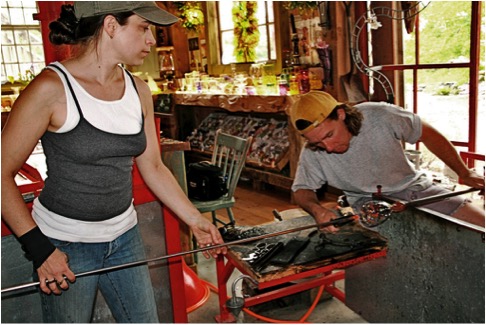
David & Jennifer at work
Is it important that much of your glass is functional?
One of the seducing qualities that the material glass offers is its magical relationship with the maker. This fluid that turns into a solid is given life and shape through the breath. The bubble’s natural expansion with the breath is a rounded shape that calls out to the hands for holding. The day after making one’s first vessel it is ready to be held in the hands of the maker and used in everyday life. A hand-blown drinking glass, especially of one’s own making, is one of the most decadent ways to experience a simple glass of water.
No matter how elaborate, technically challenging, or beautiful our Nature Sculptures get I don’t think we’ll forget the basic pleasure of using our glass every day.
Discuss the importance you share for providing customers with unique pieces in their everyday life?
Before building our glass studio, David and I spent several years renovating our 1787 home. With lots of help from family and friends we were able to do the project ourselves which was fortuitous as with not very much money we couldn’t have afforded to hire the task out. Being that intimate with the project really allowed us to pay attention to every nook and cranny of our space. This was to be our home why not take the opportunity to make it really ours, to make it special. In the end the renovation ended up being an expression of David and I’s creative nature, in and of itself it became our art. This experience has stayed with us and it is one we hope to share with all of our clients. When we work with them on a project or a custom piece we want our glass to contribute to the creation of a space that is a deeper expression of themselves. We hope our work helps transform their physical shelter into more of a home. We hope our work brings light, life, and joy.
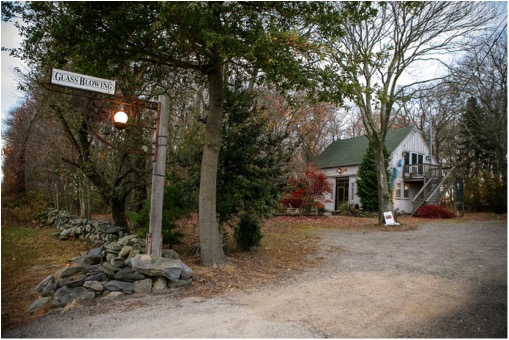
In 2004 you opened your own workplace. Can you explain how this happened?
After finishing the renovation of our home the time was right for starting on the glass studio. Luckily for us a friend who has a talent with post and beam structures offered to work with us on building our studio. David had the pleasure of working with him for weeks shaping the posts, beams, and carving out the pegs. In an afternoon a crane and a handful of helpers pulled all the pieces together and we were on our way.
Running, maintaining, and paying for a glass studio is a truly daunting task, but the commute across the lawn, past our beautiful gardens to a job we love is priceless.
Can you discuss your work Superfruit.
The Superfruit Line of tableware was designed by David before he and I met. It uses an Italian technique (pulling glass cane and cutting it into dots) and is a simplified version of Millefiori called Murrini. The goal with this line was to create functional pieces that are bright and cheerful in colour and comfortable in use. It is our most extensive line and for many years quite popular with our clientele.
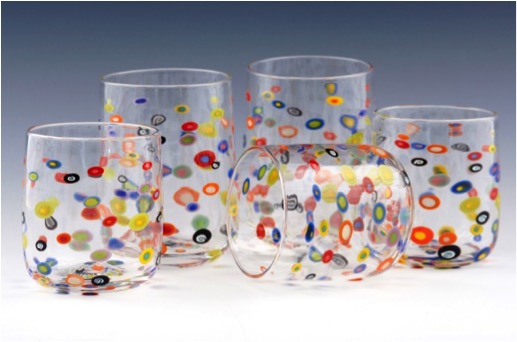
Many customers have told us (separately and without knowing each other) that they call this line their “Happy Glass” and use it joyfully and frequently.
Take two of your drink ware collections and discuss the inspiration for their design?
Pops!
The Pops Tumbler was developed to offer people a physical experience with the glass. In this piece the shape takes the lead. In what I have always thought of as Venus like curves the Pops Tumbler fits directly in the hand following the natural curve of the palm when the hand is partially closed. It is a satisfying feeling to see the look of pleasant surprise on the customers face when they first hold a Pops Tumbler. Of course we always strive for each piece to have its own physical relationship with the user, but this particular line takes the gold! We kept the Murrini for decoration because people love the spots so but made the colour more subtle so the spots wouldn’t try and steal the show.
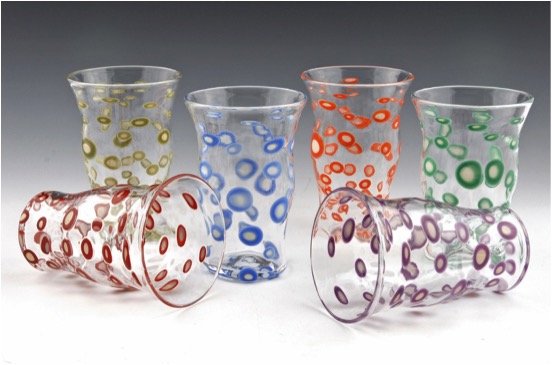
River
The River line developed when we were looking for a way to express a stripe. After years and years of dots they began to take a visual toll. Our solution was to trail colour up and down the piece thus giving it something stripe-like but also allowing the clear glass to provide a canvas for the study of colour. Each colour is represented with its neighbour on the spectrum as an accent. For example the green tumbler also has gold and blue and the blue tumbler also has green, indigo and purple. As an added bonus the trails of colour also provide ridges so all the way around the glass there is texture for the hand to enjoy.
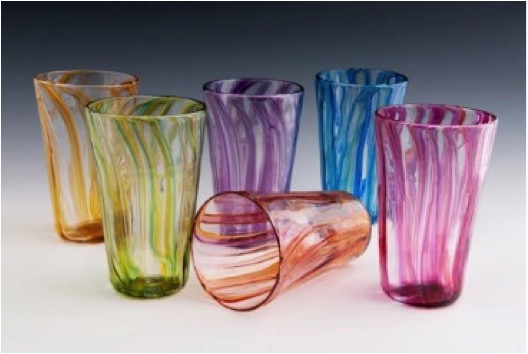
Discuss you Hoop bowls and the way you have used colour in them?

The Hoop Tumblers, Bowls, and Carafe decoration came to us while experimenting.
Experimentation in the studio is a very important part of the process as it allows for the conscious mind and the subconscious mind to play in a sort of three dimensional sketch book. Every year we hope to add an additional design to our Drinkware Line.
We have a strong representation of the dot and the vertical line but not of the horizontal line. The Hoops allow us to do that and as well, like with the River Tumblers, play with colour relationships. Although from a distance each piece seems to be “a” colour, up close one can see more complexity. For example the Red Hoops are composed of 4 different threads of coloured glass – pink, tangerine, red, and cranberry giving the overall appearance of Red a bit of contrast and vibration enriching the visual experience. On occasion we have an opportunity to play with more disparate colour and create, usually on bowls, quite unusual combinations that create beautiful and unique palettes. One of our more popular pieces gave off a vague purple hue, with a bit of earthiness thrown in. Upon closer inspection it shows threads of turquoise, lime, brick red, tangerine, purple, lavender, and off-white. In this line the combination of a clean tight shape and graphic coloured lines truly makes for a striking piece.
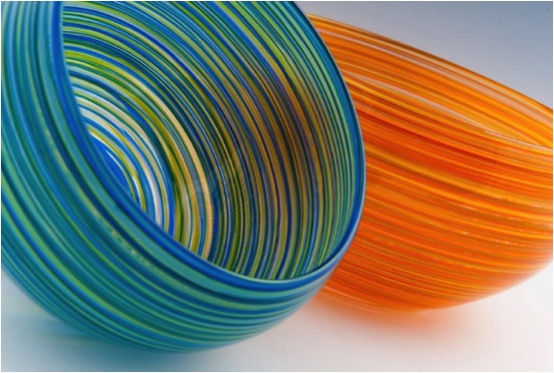
Can you explain your piece called "Hosta"?
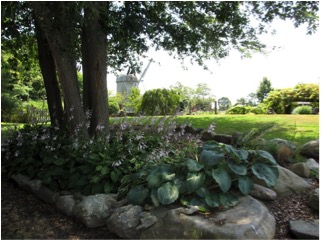
The Botanical Series came out of a love David and I have for nature. We have several gardens on our property and get much joy out of creating and tending them. It was a natural step for us to pay homage to our local flora.
Outside of the glass studio on the way to the house is a large grouping of Hosta. Every day we walk past them. They are touchstone for each season from breaking out of the soil in the spring, leafing out in the summer, and blooming early fall to dying back in the winter letting us know another year has passed. It was easy to want to try and replicate these wonderful plants with their interesting leaves and delicate spires. Trying to capture the essence of a plant provides us a challenge we can really get our teeth into. Although we are never able to create plant life as detailed as Mother Nature does, it certainly is fun trying to achieve all those nuances.
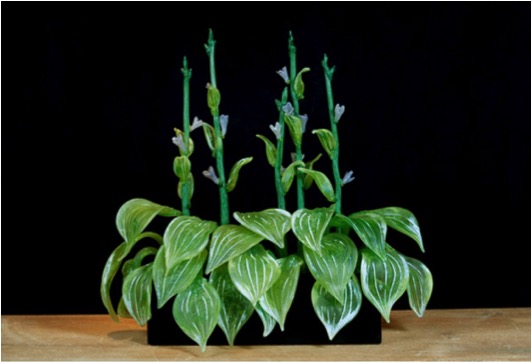
Can you explain how you have used steel and light in your work "Prairie Grass"?
I have long been taken with grass, almost to the point of obsession. One of our first botanical pieces was grass. I love the way each blade contributes to the whole of it creating the “lawn” or in the case of a prairie the “sea” of grass.
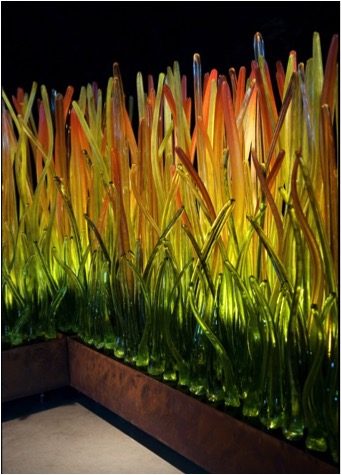
When we do it correctly one can almost image it swaying in the wind.
One of the challenges of the botanical pieces is to create a base that holds the individual pieces in place without taking away from the whole sculpture visually. In Prairie Grass the base is one of the lowest to the ground we’ve used, in the hopes of keeping the viewer’s eye on the grass itself. With the application of a patina to the steel base creating earth tones (aka “ground”) I think we have achieved that end. The beauty of the Carex Testacea (Prairie Fire Grass) is that at a certain time of the year the tips turn golden and red. Showing this piece in front of a floor to ceiling window with sunlight streaming through is quite an experience to behold but when night comes or if we’re showing it in a gallery setting back lighting with artificial light has really brought the piece to life in a powerful way - almost as if it really were on fire.
Colour is held so well in glass. Can you comment on this statement?
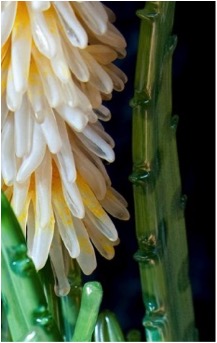
Nature provides us with an unlimited amount of colour. Some of it is bold, some subtle but all of it is alive shining from the inside out. For me glass is the only medium that captures that essence. When light shines through glass and glows it such an impactful experience on the eye. Anyone who has had the pleasure of seeing sunlight shine through rich cobalt blue glass can never erase that experience from the memory. Even frosted glass has a certain play with the light, where you can almost hear a sort of humming from the colour.
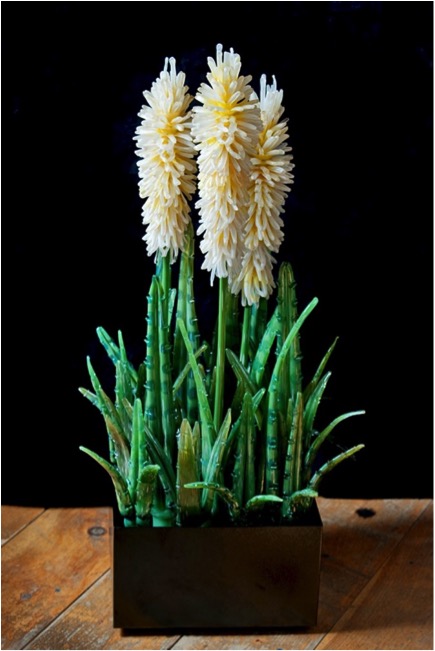
You also make custom pieces for the home and work with designers, discuss this aspect of your work?
David and I took so much care with creating the spaces we move through, both in the home, studio, and yard that we wanted to be able to do that with and for others. For a long time we’ve had home owners and designers commission sculptures and/or lighting from us. Every now and then a space needs a focal point or an added accent to what has been created there. We take this job very seriously and always enjoy getting to know the owners taste and the designers style that we may work in concert with them creating a piece of art that is ours but nods to all the members of the project and respects the space.
Expand on the importance of ‘Handmade’ to you both.
David
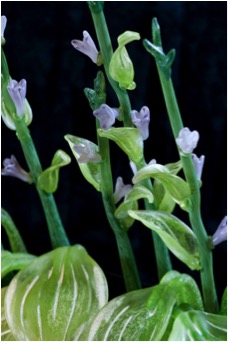
I am reminded of a quote when you ask about handmade:
“When buying from an artist/maker, you’re buying more than just an object. You are buying hundreds of hours of failures and experimentation. You are buying days, weeks, and months of frustration and moments of pure joy. You are not just buying a thing, you’re buying a moment of someone’s life. Most importantly, you’re buying the artist more time to do something they are passionate about.”
Jennifer
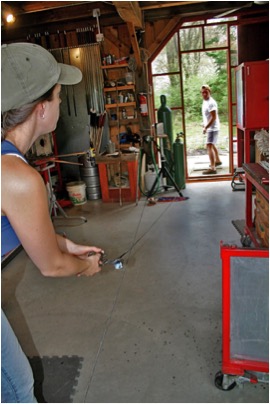
I cannot express enough how passionately I feel about the handmade. Machine made items are necessary for our lives but, they will never be able to provide the user with the kind of personal experience that a handmade item can. The handmade object has a life to it, some may even call it a spirit. Handmade items provide a depth of experience when holding or using that touches all the senses. The act of making is also important and an experience that everyone should have in order to express their own creativity and truly understand the value of other handmade objects.
Contact details:
David & Jennifer Clancy
Clancy Designs Glass Studio
382 North Road
Jamestown RI 02835 USA
401-423-1697
www.clancydesigns.com
glass@clancydesigns.com
David and Jennifer Clancy, Rhode Is, USA
Interview by Deborah Blakeley, December 2014
Kerry Spokes
Explain your involvement with mobile photography both the limitations and advantages it has given your art?
Four years ago I bought my first iphone, since then I have concentrated on using mobile devices to create imagery (iphone, ipad and apps), striving to extend the boundaries of what is possible with digital collage using photographs and apps on my ipad only.
I like to print some of my iphone work on a large scale and with the limitations of camera quality in a mobile device I have explored the use of photo and art apps to overlay filters, enhance some areas, etc to ‘mask’ over those limitations of photographic print quality, thus creating a more ‘painterly effect often.
The digital medium has become a useful tool for developing and recording ideas and concepts I want to portray, and in turn is informing my latest drawing and print works. This has been a huge advantage in my processing and recording of ideas into visual images in a quicker timeframe than my current lifestyle would otherwise permit.
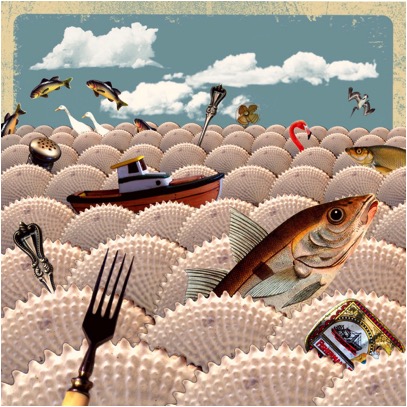
'Flotsam & Jetsam'
Please discuss the techniques you have used.
There are a number of apps and techniques used to create my digital collage like the Domestic Bliss series. I usually lay down a background in an app called Superimpose, often overlaying a few to achieve a base or if I want a room with walls and floor as a background or perhaps a landscape I have taken an image of.
I take many photos of objects, animals, flowers etc, then mask around them to delete the background around these items, save them to a mask library enabling me to use them in any number of ways in compositions. I also look for imagery on the internet that is free to use; images of particular objects etc. I may not have to hand.
Apps which specialise in applying layers of texture and/or colour along with enhancement tools are usually employed throughout this process of merging objects to build up an image.
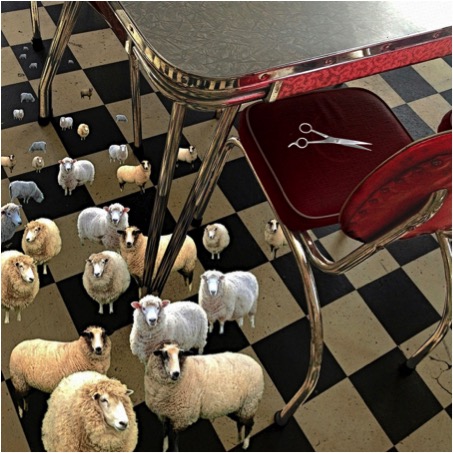
Flock
Please discuss the importance of colour in your work
My printmaking and drawing art practice has largely been based around black and white, so I have thoroughly enjoyed introducing colour to my digital works. In fact, I have hardly touched black and white as a genre of iphoneography. Colour is an all important aspect of my digital work, often altering the light, introducing shadows, higher concentrations of contrast and colour saturation, with a focus on the relationship of colours and the visual ascetics of colours working together.
Where do you get your inspiration?
The Domestic Bliss series is inspired by the idea of creating a suite of images which depict domesticity in a humorous and contemporary way, and of also using the huge number of collected items I have (often picked up enmasse in secondhand shops) and putting them to good use. I guess its a justification for being a bit of a hoarder of interesting objects, homewares, machinery, books etc etc....
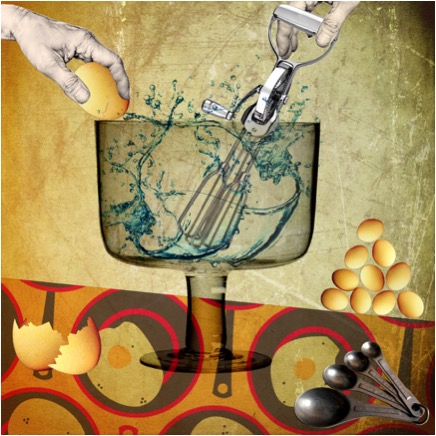
'Cooking Up a Storm'
Can you comment on your work ‘Pass the Salt’?
This work is one of a suite of images I am working on based on objects in a landscape. This body of work will be reproduced as photogravure prints for an exhibition in late 2015.
I have used a local scene of Tarwin River and introduced a domestic scene reference of stirring a large pot of soup, so to speak. It could also be interpreted as a reference to the conservation of our waterways. I often like to have an element of social comment coming through my images, however subtle or not.
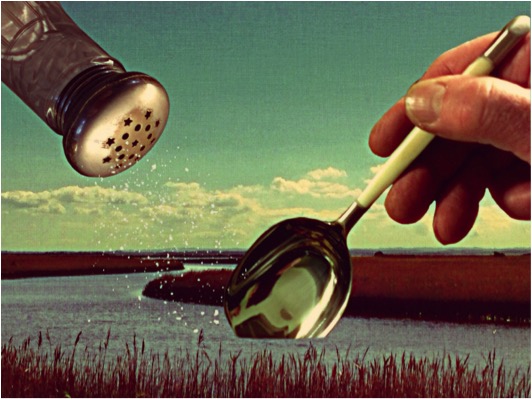
'Pass The Salt'
As we get closer to Christmas can you expand on ‘Xmas Pudding Paddock’?
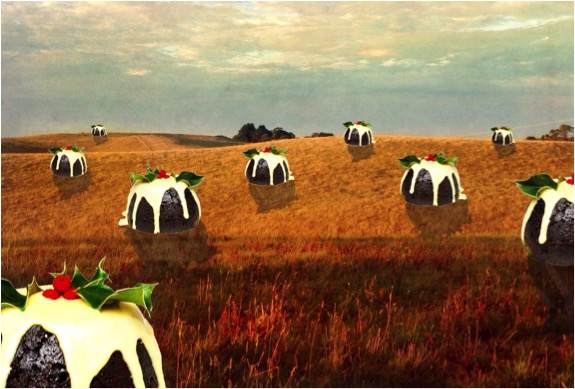
I have been making a line of Christmas cards for many years with a comical and distinctly Australian bent. Prior to my digital iphone works, small drawings and paintings were reproduced onto cards for sale. I have a bit of a thing about the commercialisation of Christmas, finding it rather obscene and out of control. I like to take a subtle dig at this in my Christmas cards.
‘Xmas Pudding Paddock’, one of 8 new designs I have released commercially this year making up a group of 12 Christmas themed cards, is based on the idea of large round hay bales sitting in paddocks ready for collection and storage. This farming activity occurs in Australia where I live, at Christmas time. Using a Christmas pudding instead of a hay bale was an obvious choice really.
http://www.kerryspokes.com.au/#!xmas-cards/c19b8
Can you explain the term Digitally Modified in relationship to photography?
I use the term ‘digitally modified’ at times rather than the term ‘iphoneography’ which is often used in American mobile photography circles.
‘ Digitally modified’ in terms of my art and in relation to photography, means photographs which have been altered in any way using filters and overlays of texture, colour, pattern and objects etc. What is termed ‘photography’ encompasses such a broad and diverse array of image making, and has merged with contemporary printmaking practices quite successfully, making for exciting times in the digital arena of art making.
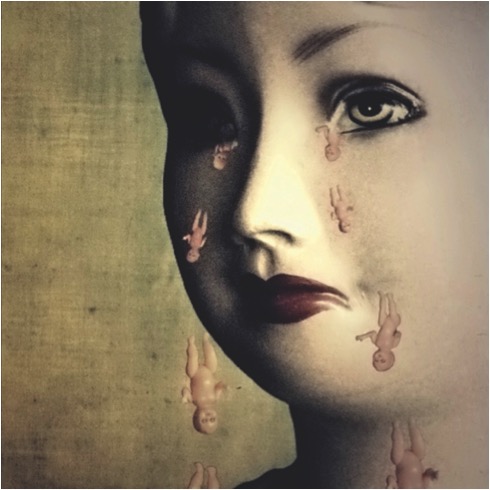
'Cry Baby'
You enter many exhibitions, can you discuss why you see this as such an important aspect of your art practice?
My art practice had a pretty big interruption when I was bringing up three children over a number of years. Exhibitions in my local area were a way of getting my small output of artwork shown without having to worry about producing a complete exhibition of works.
I still enter a number of local art shows, with the belief that contemporary art has a place in country art shows and opens up diversity of styles to the general public.
I have noticed a shift with country art shows to using more contemporary judges with sound credentials, and feel that it is important to encourage contemporary artists to be more involved in this important aspect of cultural and artistic identity.
I enter a number of selected and/or prize winning exhibitions, both nationally and internationally based on mobile photography. I have had a couple of iphone works selected for showcase exhibitions in Melbourne and Canada as part of the Mobile Photography Awards as well as a few highly commended pieces in the 2013 MPA Awards.
For me at this stage in my career as an artist using digital iphone imagery, it’s important to get my work shown on the international stage. The mobile photography movement in Australia is still in a fledgling stage I think, and I initially connected into the iphoneography scene through an American based iphone art based site called iphoneart.com where I ‘met’ many creatives also discovering the potential of iphone apps for creating artworks based on their photographs. There are a number of mobile photography competitions and exhibition opportunities in various countries worldwide, it’s just a matter of deciding which ones to pay to upload images to with the hope that they are selected for consideration of either an exhibition or prize.
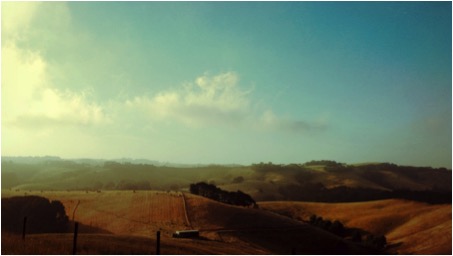
‘Late Afternoon at O’Grandys Ridge’
What are your thoughts on the importance of an artist taking up the latest technologies available and why you have embraced them?
My art practice is partly informed by the exploration of medium and technique, and mobile digital art is another ‘tool’ I am exploring in my art making. The latest technologies used in art making sit side by side other more process driven art forms and for me create an exciting mix that doesn’t necessarily lock one into a particular genre of art making.
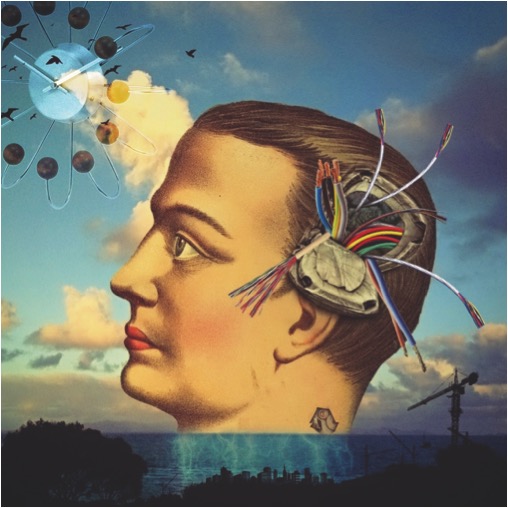
‘What Makes a Smart Meter Man’
Your original training was in printmaking and painting. How has and does this help you in your current practice?
I was always fascinated with drawing and from an early age I practised hour after hour teaching myself how to draw from looking at life, images in books and my imagination.
Form, light sources, image placement, colour relationships and a narrative are all components I employ in my printmaking, drawing and painting, and carry through into my current digital work. The more labour intensive and process driven mediums of printmaking, drawing and painting are integral to my overall art practice, whilst the more immediate digital works can be created in just about any situation – an extremely mobile art form!
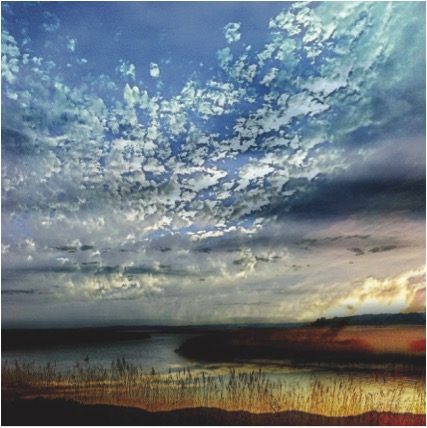
‘Tarwin River 11’
How do you use commercially available apps in your work?
I use commercially available apps in my digital work to build my digital collages from a base photograph I have taken or a background from an app I have downloaded. I also use apps for particular editing tools such as shape of images, filters, basic enhancements, and with the collage works, digital masks I cut from images.
I usually know the size I intend to print the images, so once I have completed an image I upload them to Photoshop on my laptop and resize them for print.
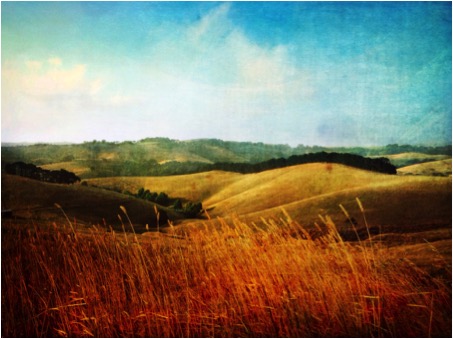
‘Summer Grass on O’Gradys Ridge’
Can you comment of the importance of printing on Digital Rag paper?
The archival properties of the digital rag papers are of importance for artists who sell their works. I treat my digital work as I would my printmaking works, editions of a smallish size, all printed to a particular size on a particular paper.
Often my images are intended to look somewhat like paintings, and the rag paper I use mostly, Moab Entrada Smooth 290gsm has a beautiful, almost smooth suede feel to it, picking up the colours of the ink in a lovely intense way. It suits a lot much of my work, although I also use a metallic finish paper for some – Slickrock by Moab Entrada.
My works are printed on a large format Epson inkjet printer with pigment based archival inks.
You also teach. Can you tell us a bit more about your classes?
I have a studio at the end of the property of Gecko Studio Gallery, set up with 2 etching presses, and where we have had a vibrant workshop schedule with guest tutors, and myself giving workshops in printmaking techniques.
I have recently begun iphoneography workshops after many enquiries from people asking for them to be made available. I guide participants through learning how to use apps for a variety of different effects.
In the future the workshops will be geared towards learning about specific apps for particular effects. There are camera apps, editing apps, apps with special effects you can apply, art apps giving painting, drawing, pens etc tools, and of course the ‘collage’ apps
At the end of a workshop, participants go home with a whole new array of creative tools to employ in their art making if they choose to, and will have created at least one image which I print for them on photo quality paper.
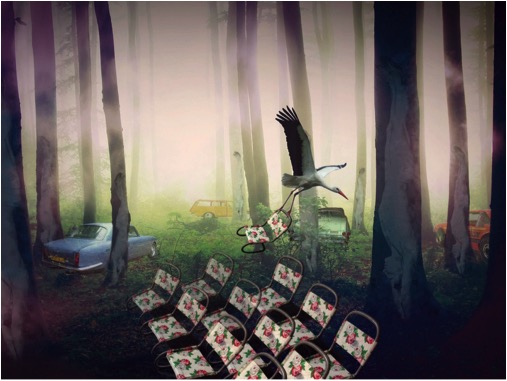
'Unnatural Selection'
You are the co-owner of Gecko Studio Gallery in rural Victoria, how do you balance your art practice and the Gallery commitments?
It’s a constant desire of mine to have more time for my art practice, and I am gradually working towards this each year, allowing myself time to fit in my art around my commitments with the gallery as well as community arts which I am involved in to a degree.
Over the eight years we have been operating come January 2015 as a small contemporary art gallery, picture framing and artist supplies business, we have steadily grown busier in all areas.
We host monthly exhibitions of contemporary art by local or national artists. Our framing is of a high quality and we employ a gun framer who we never want to retire. I used to be the framer for Gecko, but have found I am needed in the gallery daily for quotes, computer design work, art material orders etc.
We also operate a small boutique accommodation called the ArtHouse, behind Gecko, and is becoming busier as people discover the town of Fish Creek whilst looking for an artistic cultural experience as well as the amazing lush landscape and coastline of which Wilsons Promontory National Park is a part of.
I feel extremely fortunate to be in the position I am today with a business based around art and my own art practice gaining momentum as I put more time and energy into creating. To have access to an array of art materials, processes and techniques through workshops, along with meeting many interesting artists and lovers of art through the gallery, is a very rewarding way to live one’s life.
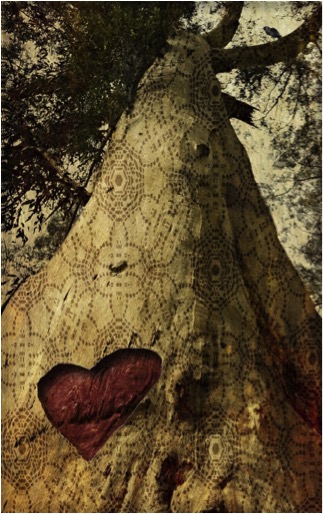
'Rapt 1'
Contact details.
Kerry Spokes
15 Falls Road Fish Creek
Ph: 0423 721 593
E: kerryspokes15@gmail.com
W: kerryspokes.com.au
Kerry Spokes, Fish Creek, Victoria, Australia
Interview by Deborah Blakeley, December, 2014
David Gerstein
Your work is all about movement discuss?
Movement is indeed essential in my sculpture works and it has to do with the special technique that I am using which render itself very well with elements of motion. One of my early inspiration was comic films while the moving figures are cut out on the celluloid and move along the background. The repetitions of the figure while moving the body was used in my metal cut outs to create the sensation of movement that was lack in almost all the art works that I came across except in the futurist movement from the early years of the 20th century and that was abandoned for more than 50 years .When I abandoned paintings for cut-out sculptural images I enjoyed the freedom of the body detached from its background that always made it stable and motionless. Than my bicycle riders started to flow and many runners joggers, football players and others sport images became the centre of my interest. Since then I used many different motives most of them had the sense of movement.
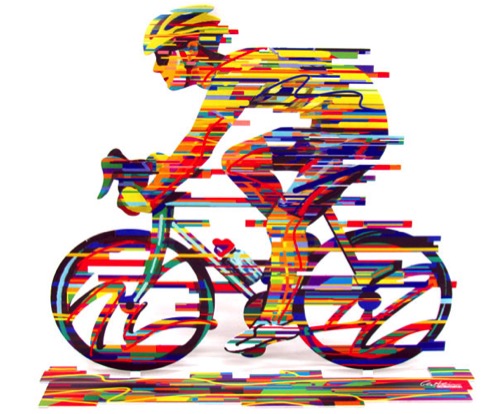
'Champion'
How and when did you take your work from 2D to 3D?
After I finishing my studies of paintings I was immersed in figurative painting, rather narrative, that dealt with my own personal life and surroundings as well as childhood memories that need to be released to the world. I did a great deal of water colours as well as oil paintings in large formats.
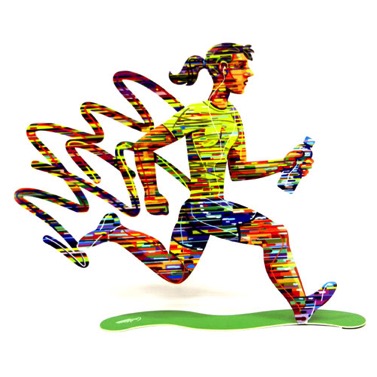
'Jogwoman'
It was unusual for a young ambitious artist not to join the very dominant conceptual or minimalistic styles in fashions at the early 70ties and I was considered as an artist away from the main stream. However I believed and insist on my ideas and paid the price for being unpopular by some one–track-mind critics. My heroes at that time were Hockney, Kitaj as well as Hopper, Lucian Froid and Picasso on top of all and they gave me the courage to do what I did. When I felt after 10 year the need to go on and find my own language I made my mind to search through sculpture a way to get my image a sense of volume and not merely illusionary. My intuitions led me to cut out the images from wood or cardboard separate them from the background and placed them in space while painting them from both sides. I also joined them together with other cut outs and enrich the scene so the viewer has to encircle the piece in order to see it all at 360 degrees and enjoy a bigger experience than what a flat painting could provide. From that moment on painting seems to me dull compare to the new possibilities the 3D could provide.
Your wall sculptures, how large can you make them?
The wall sculptures could be as large as I wish them to be. When the size grows I use thicker material to keep the strength and also could build them in parts so they joined on the wall to the required size.
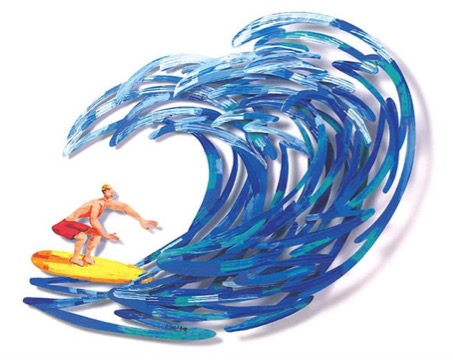
'Surfer'
Can you discuss how your wall sculptures are hung?
They are joined together by screws that go through the holes I provide in every layer. Normally it hangs by two hangers that are placed at the tip of the top screws. Mostly two hangers are enough and then I provide two screws (hooks) on the wall and hang the wall sculpture just as a painting.
A different look is ‘Sharing a Cup Cake’. Please discuss?
If you mean the bronze sculpture of the 3 pigeons sharing a cup cake then it is a comment about the street pigeons eating all day long some dry pieces of bread given to them by people walking by. The cup cake was probably left by a child and becomes a first for the hungry pigeons. It could be regarded as a comment on our society: what is kicked by one - it is a find for the other.
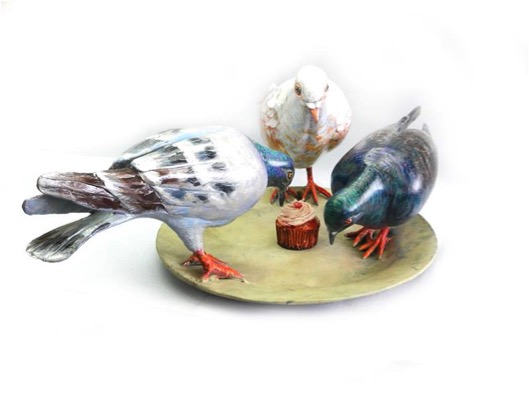
'Sharing a Cupcake'
You have 5th Avenue - do you have any other district places?
No, the name came up as a memory I had from visiting New York but it could applied to any other city in the world: Beijing, Hong Kong or London. The world becomes very crowded and it's the mirror to reflect our life in big cities.
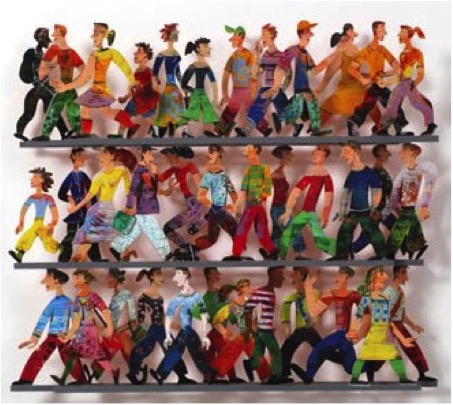
'5th Avenue'
Bicycles, do you ride? Where did this idea or inspiration come from?
'Bicycles' started as an early memory of my mother riding at the age of 3 or 4 years old. Later I became a rider myself at school and I continue to ride even today. The image developed before it became a big trend worldwide. I love the integration between a man and the machine which manifest itself so beautifully with the bicycle. I also like the groups riding at great speed which looks like some kind of animal with many heads making its way through the open landscape. It's a beauty. It became for me the meeting spot between colours and shapes and motion with emotions.
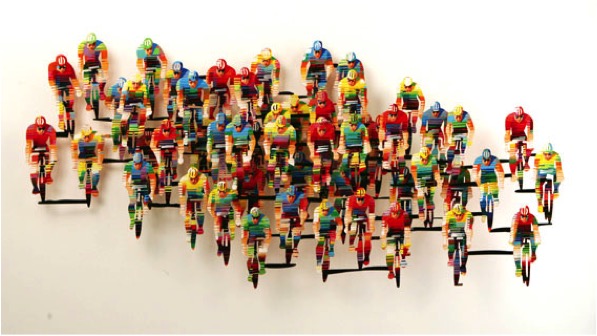
‘Tour de France' - Horizontal
Your work ‘Sun on the Beach’ has a limited edition of 150. What is your normal limit or do you do specific sculptures in limited editions?
The cut-outs in metal are done by a laser cutting technology and once it is designed (which take a great deal of time and thinking) it seems to be such a waste to do only one piece .So I decided to create a limited edition in which every piece will be hand painted differently. It also helps to reduce the price and reach to bigger audience throughout the world. It is in fact still an original painting but not one of a kind. Beside that I do one of a kind paintings or sculptures as well.
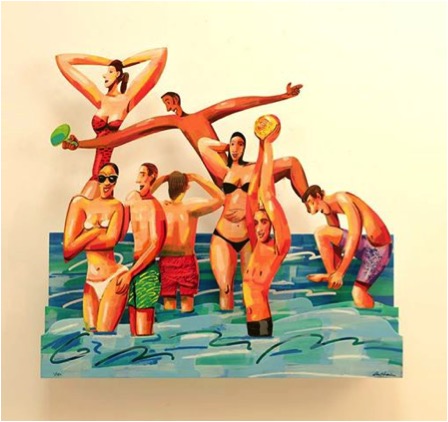
'Sun on the Beach'
You also differentiate the forms by having one part black, giving stability while the flight or moment is full of colour. Can you discuss this in relation to ‘Happy Hours’?
The idea behind that composition is to create a tension within the art work between sketch-drawing and painting, black against colours, all together are moving elements in a different media. It is all about painting which start as a drawing and ended by applying colours to get more volume. The viewer can continue the painting of the two cyclists in his mind or enjoy the lightness of the drawing. The butterflies are getting more attentions and dominate the image leaving the riders on a lower scale.
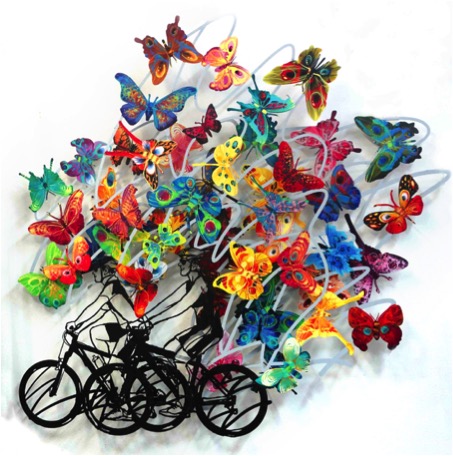
'Happy Hours'
Can you explain your installation outside the stadium in Taiwan?
How the commission came about?
What was the brief?
How was this constructed?
How was it delivered and constructed on the site?
Were you there for the construction?
Discuss the Opening?
The commission came as a result of an open international competition that I was asked to take part in and went through a few stages. My work passed the first screening and I had to do another final stage with five other finalists. Then I built models from cardboard and came to Taiwan to be interviewed by the committee which had to decide on the winner. After I got the commission I made a proper design with the help of engineers to construct it as strong as possible to make it stand any wether condition and to prevent it from collapsing.
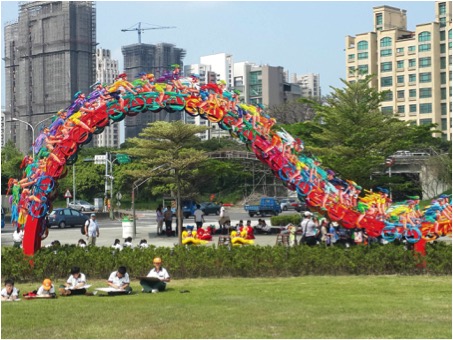
All the metal works were done in Taiwan and took about 3 months and I came from Israel with 4 assistants to do the complicated painting on the parts. We spent a month doing it and then the construction specialists assembled all the parts to erect it and made it possible.
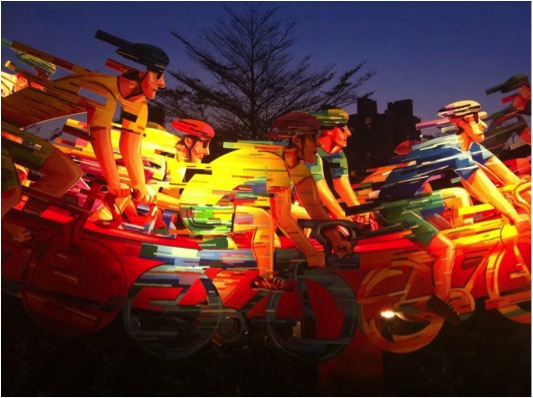
I watched the progress through pictures that were sent to me by mail and was amazed by the high quality that it was made when I finally saw it...
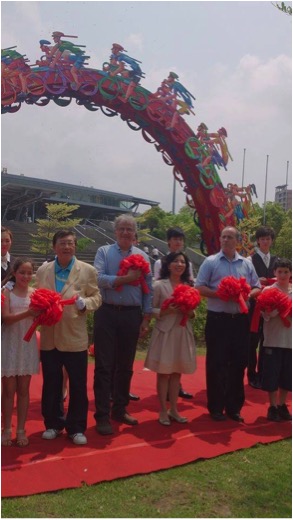 The opening was a great first with the participation of the Mayor of Sinchu and the Israeli Ambassador together with all the people who took part in the realization including my agent Ms. Virginia Hui-Ting Chen from Taipei that made it all possible. There were different performances and choral singing together with speeches in the event that lasted about 3 hours.
The opening was a great first with the participation of the Mayor of Sinchu and the Israeli Ambassador together with all the people who took part in the realization including my agent Ms. Virginia Hui-Ting Chen from Taipei that made it all possible. There were different performances and choral singing together with speeches in the event that lasted about 3 hours.
Have you ever been asked to do your work in neon?
No, I never used electric lights as part of my works and never tried it so far.
Your ‘Window’ pieces remind me of Matisse, can you discuss this?
Matisse is definitely one of many artists that inspired me throughout the years and I am sure it is rooted deep in my mind, Therefore I could only be pleased that it came out in that particular piece. I see myself a small part of huge Art machine that is shaping our understanding of the beauty of life and defines our place in the universe
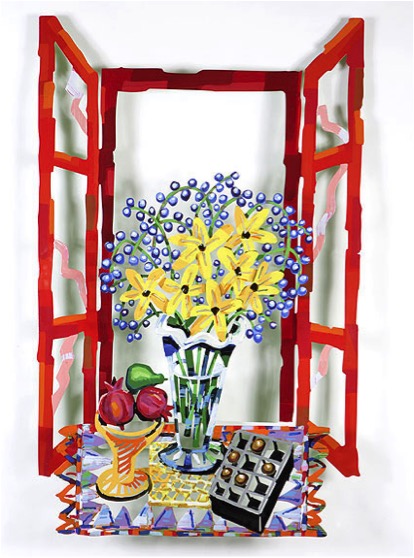
‘Table with Chocolates’
Your work is not always colour, colour and more colour. Expand on your Silk Way Sculptures in Ovda?
Using strong fresh colours is important part of my thinking and creation. In recent years it took more volume and people recognize my works from a mile away by that .However in many cases and other periods in my carrier other elements were more dominants and colours were used scarcely. In Ovdat project colours were out of the question because it was all about archaeology and ancient ruins and I wanted my works to integrate with the special atmosphere. I use colours where it is needed and not as a rule. I would even dare saying that drawing gives me more pleasure than painting.
Your work is sold in 21 countries around the world. Can you expand on one or two pieces that have given you great joy to know where they have gone and why?
It is a great pleasure to be recognized in many countries and to realize that the world accept my ideas and art without putting borders. When it appeals to a Chinese as well as someone in South America it means that I touch a mutual point that is common to human kind and that feels me with pleasure. My works speaks at eye level and are simple to understand at any level because it is honest and unpretentious. I believe that great music or literature could touch people anywhere if they reveal certain truth and reality. Sure it could not reach every one and luckily there are so many different tastes but having big audience is a great privilege.
My biggest sculpture so far is Momentum in Singapore and it brings me many regards from different people on many countries. This is why I like so much to do public works that everyone can see and experience.
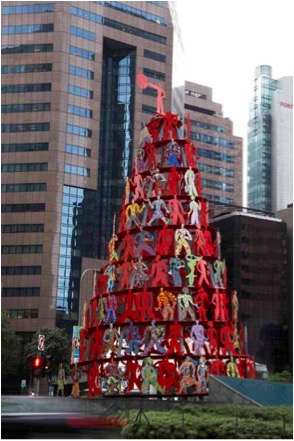
‘Momentum’
Picasso said he never searched but he finds, I like that phrase. I would say that my art comes from what my mind produces without forcing it. I let my ideas float and goes with the stream of my imagination. Places I see, things that catches my attention, art that I like, things that I read or discuss, music I listen to, all inspire my creation and help push my creativity. I do not think there is one method for stimulating the mind, it depends on every person’s personality and it is perfect as long as one listen carefully to himself.
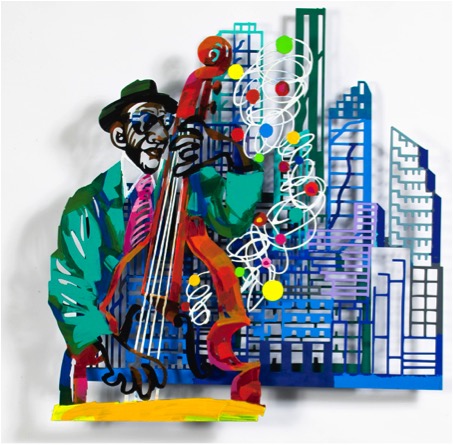
david-g‘Jazz in the City’
How do you record your ideas?
The only way I know is to draw in my sketch book. I 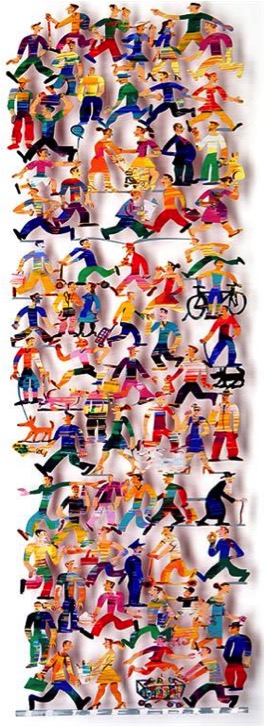 do it constantly almost every day and sometimes more than once. Than the ideas that I sketch could be forgotten even for some years and pop up again while I look through it and get excited again.
do it constantly almost every day and sometimes more than once. Than the ideas that I sketch could be forgotten even for some years and pop up again while I look through it and get excited again.
I also take photos all the time wherever I go, it is so easy today with cameras integrated in the mobile phone. The pictures reveals precious moments and reminds me of past experience or ideas that caught my attention and surely helps creativity to come to life.
I like to show my works to some people and listen to remarks, it does not mean that I would consider what people have to say but it helps to define my position and test my new ideas if they are ready to be delivered.
And last thing is that having no ideas is a good way to create something new. It throws the mind into chaos from which a new order comes out and surprises.
What are you currently working on?
I was invited to show next year in an imported museum in China and I am trying to crystallize my past ideas. On the other hand to recreate myself again, in other words to come up with something fresh and surprising .Let it be!
Contact Details:
Website:http://www.davidgerstein.com
Email: david@davidgerstein.com
David Gerstein, Jerusalem, Israel
Interview by Deborah Blakeley, November 2014
Joe Hogan
Your move to Loch na Fooey in 1978 was a complete life style change. Moving for more than just a ‘tree change’ you now have a rural life and also speak in Irish. How did this work?
I was drawn to basket making because I wanted to grow my own willow (the raw material for baskets) and I sensed that this involvement from growing through to making would prove deeply satisfying.
The opportunity to live rurally and develop a real understanding for a particular place was very important to my wife and myself. We wanted to farm and grow our own food and live in a beautiful environment. The area of the North West Connemara where we live is very beautiful and it is a real privilege to be able to live here. When we moved here Irish was still the first language of most of the community. My parents had spoken Irish to me when I was young so, although my Irish was rusty, it was not too difficult to begin to speak it again.
It is true that it was a life style change as had both met at university so it was not the obvious choice of things to do.
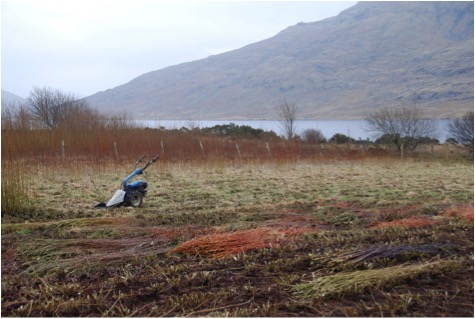
Discuss the importance of finding full-filling work and life balance, through basketry?
It seems to me that to find useful and fulfilling work is one of the most important things we can do in life. Initially I used to also spend a lot of time working on our small farm but gradually I began to find basket making more and more absorbing as I became more proficient at it. We also grow a lot of our own food so with the gardening, farming and willow growing are a contrast to being inside in the workshop.
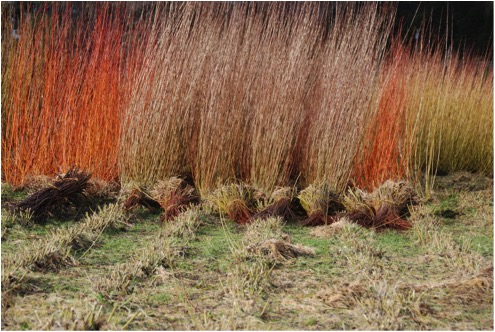
How was Tommy Joyce so instrumental in the early days in Lock na Fooey?
When we moved here I was able to make baskets but there was nothing particularly Irish or indeed personal about them. Tommy introduced me to the very rich heritage of traditional Irish baskets by showing me how to make a creel. This is a type of donkey pannier which is begun at the top or mouth of the basket with the base being formed last by interweaving the uprights. This was a revelation and it still informs my work as this method of working upside down allows me to make pieces with collars of bog wood and the like.
How has living close to the sea (The Atlantic) influenced your basket making e.g. lobster pots, skibs?
Although the Atlantic is only about 4 miles as the crow flies it is about 8 miles by road so it has not had such a profound impact. It is true that I was able to find one of the last people making lobster pots because I lived in the right place to be aware of him. The skibs are potato baskets and as such were used inland as well as by coastal communities. My own workshop overlooks a lake and the presence of water has become hugely important to me but I cannot say whether it comes through in any way in my work.
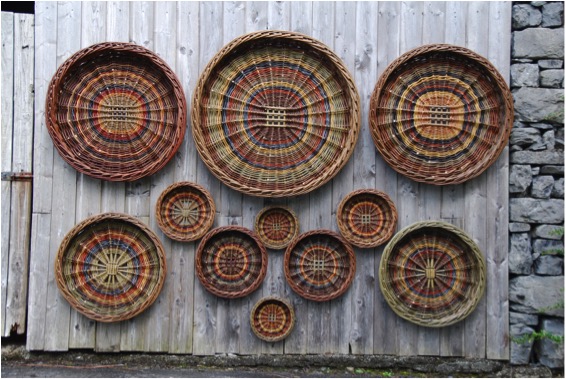
Skibs
Discuss how your understanding of ecology has affected your craft?
Over the past number of years I have become increasingly aware of how fragile this planet is.
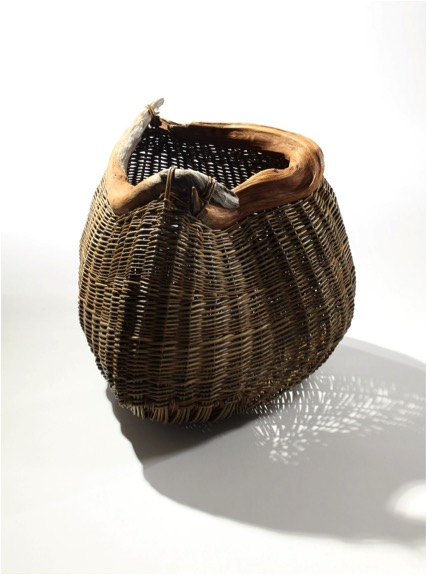
‘Swirling Root’ photo by Rory Moore’
This has largely been the impetus for working in a more artistic manner. I am currently involved with six other makers- in an exhibition called “This Beloved Earth” which is currently at the Barony, West Kilbride, Scotland www.crafttownscotland.org/thebaronycentre. This exhibition encapsulates a lot of my ecological concerns and focuses on the need to look at the earth more as an organism.
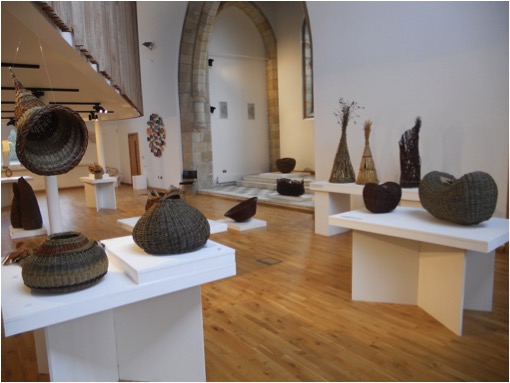
You use many local materials like bogwood. Can you explain how these are incorporated into your work?
I believe the idea you are referring to has to do with a comment I made saying that my whole life is about creating; be that creating a basket or a garden, or a photograph. I see colour and desigI find the bog wood in an a nearby area of bog land where the peat has been cut away for fuel leaving the root systems of these ancient pine trees-they are more than 3000 years old- exposed. I wanted to incorporate them in my work as I find them amazing.n, and inspiration all around me. For me, creativity and inspiration are everywhere and touch every aspect of my life.
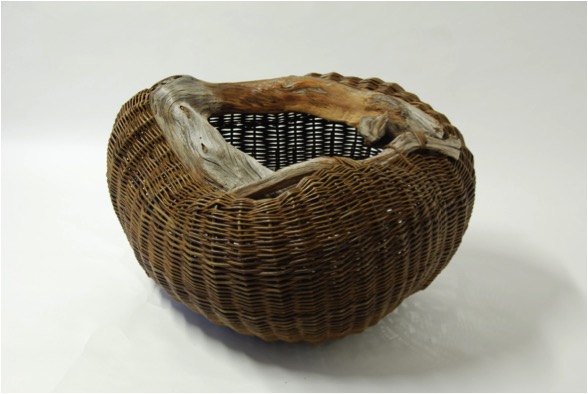
‘Ripe'
Do you only work with natural willow colours?
Yes. There is a very rich variety of natural colours of willow.
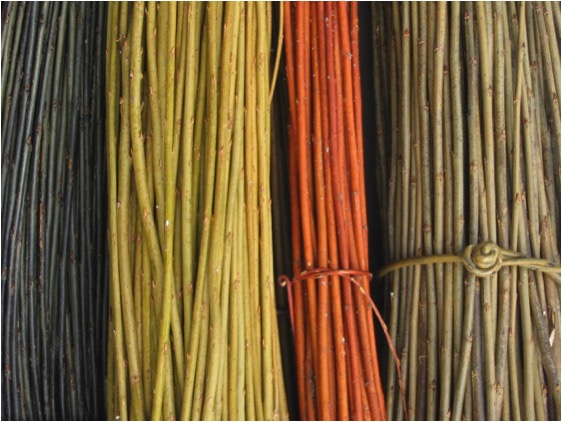
Can you explain your use of Lichen, Hazel Catkins in your work?
Again it is a fascination with the material. I really like the look of it and then I see if I can weave with it.
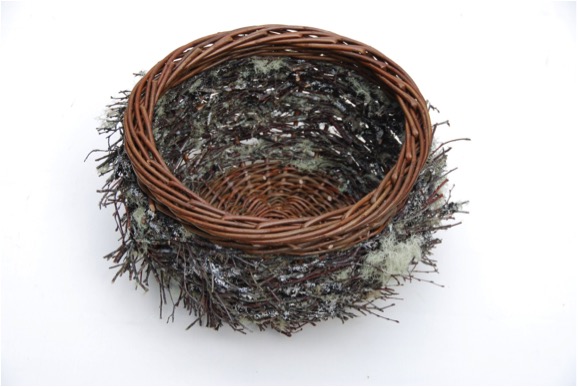
Lichen Bowl with Harrison’s Willow on the boarder
Can you explain the technique you have used in ‘Larch Bowl’?
The larch twigs are harvested in winter. I look for twigs with a good number of cones on them. I planted a good few larch trees in 1978 when we first moved here so I have a fairly good choice. I almost always use a long ladder to cut the branches I want. The twigs are then dried, soaked to make them flexible and steamed to increase the flexibility. Then it is a case of weaving them carefully to ensure I don't knock the cones off in the weaving process.
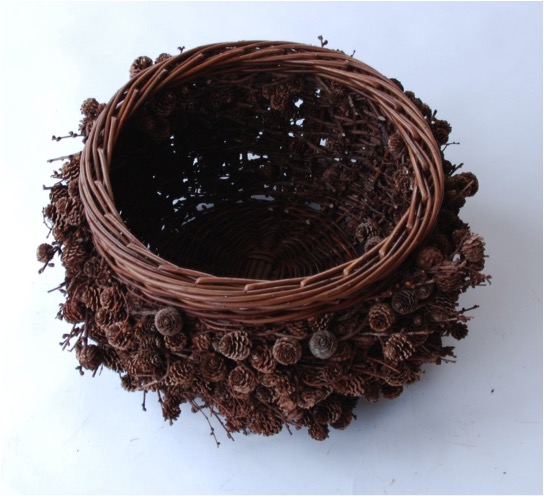
‘Larch Bowl’
How small and how large are your baskets?
Many of the baskets using bog wood are up to a metre in length. I do try to make some smaller work as well. The bowls are about 50 cm wide. I tend not to make very small work though lately I have been making a series of nests and some of these are only 10 cm in diameter.
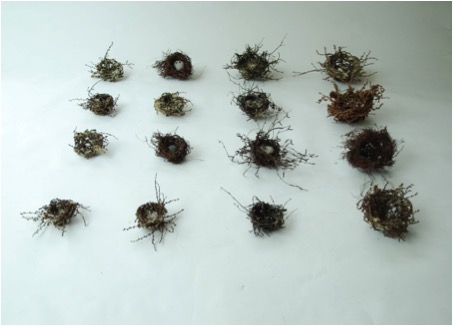
Group of Nests 10cms to 25cms Birch and Lichened Twigs
How does poetry play a part in your craft?
I find it a wonderfully rich source of inspiration. It seems to me that poetry and music can offer insights which go beyond what is purely rational or sensible towards a more intuitive view of the world.
I am influenced by environmental concerns and feel that the changes we need to make as a race will become possible only when we go beyond a merely rational analysis and begin to encompass the worlds of poetry and art to imagine new – and more responsible- ways of being in the world.
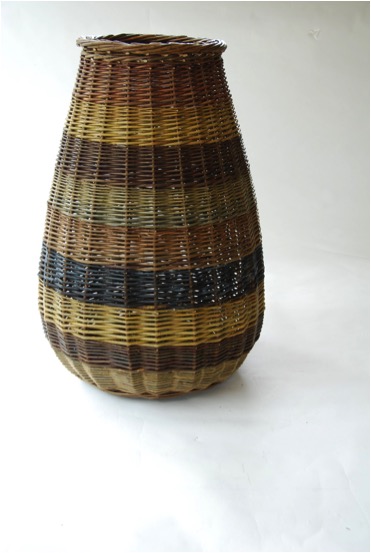
Tall Vessel 60 x 60 x 100cms
Can you expand on the importance of repetition in your craft?
Repetition is crucial in developing crafts skills. In the case of basketmaking the techniques are relatively easy to learn but one really has to practice a lot to perfect them. I think this is true of many things in life and there is great satisfaction to be gained from making better work.
You still make traditional baskets and have expended these skills to your contemporary work, discuss?
The artistic work grew out of the functional work and these baskets would not have been possible if I did not have the fluency which I developed making functional work. Even the technical solutions needed to make the bog wood baskets are informed by traditional techniques.
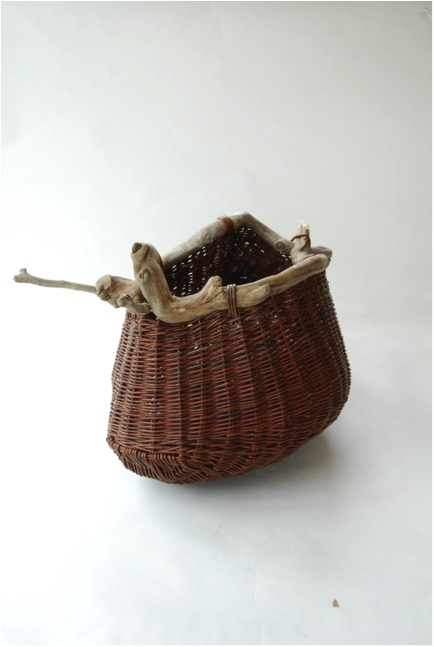
Drift wood pouch, drift wood and willow rods
Explain about your collaboration with Joanne Haynes and her 2011 Autumn / Winter collection?
Joanne was looking for something eye-catching to compliment her work and suggested a twig hat as she has seen my birch twig bowls. Once the idea was there it was not difficult to figure out a method to make it work.
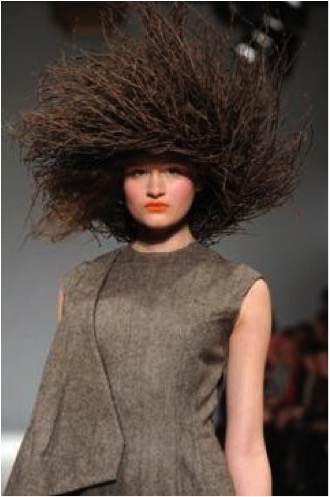
Photo by Brian O’Sullivan
Your son Ciearan is also a basket maker. Do you work together?
No. Ciaran has his own workshop in Spiddal craft centre near Galway city and he makes functional work. He did spend the best part of a year working with me a few years ago to develop his skills.
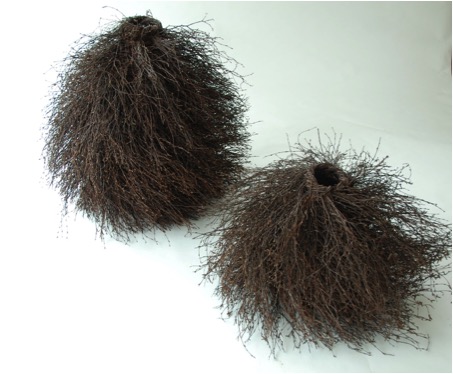
Two Birch Vessels
Contact Details
Email: joe@joehoganbaskets.com
www.joehoganbaskets.com
Joe Hogan. Loch Na Fooey, Finny, Clonbur, Co Galway. Ireland
Interview by Deborah Blakeley, November, 2014
David Frazer
You have always wanted to be a songwriter, but realized that you were more suited to Printmaking. Discuss this in relation to you comment. “I think of my work like a songwriter would produce an album”?
I wanted to be famous due I suspect to insecurity, I wanted to be popular and adored like Elvis, ha ha. I wanted to write beautiful heart felt songs and move people to tears. I really wanted to connect with people; I probably found it hard to do that the normal way. Anyway I tried song writing but couldn’t do it, I became an occasionally funny karaoke act. After art school I had discovered printmaking and found it more suitable than painting. When I saw reason and quit showbiz I decided to get back into art and focus on printmaking. I went back to art school to do an honours years in printmaking. There I discovered wood engraving and found it to be as close to song writing than any other medium. It suited poetry, narrative and storytelling. I also found I could do a series of engravings, even had some text and bind them into a book. Also what I discovered was that suddenly I had a subject. My years of trying and failing in the world of showbiz gave me that. Topics of yearning and alienation, failed ambition etc. still form the basis of my work. I’d won half the battle.
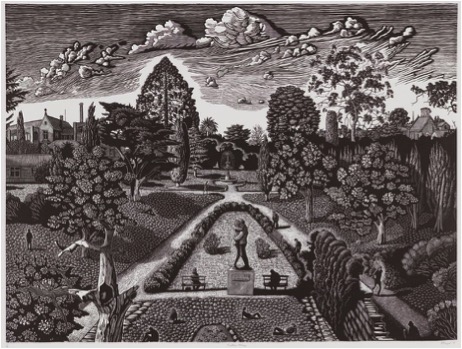
Together Alone’
You have also worked in collaboration with songwriter, Paul Kelly please expand on this and the book ‘Little Aches and Pains’?
It wasn’t really a collaboration, as Paul said when opening the launch of the book, all he did was say yes. I used the lyrics to a song he had already written for his most recent album “spring and fall”. I just found it refreshing to use someone else’s words to interpret. I also felt an affinity to the theme of a frustrated guy reminiscing about an old love or friendship that went wrong and wondering how life could have turned out different. I love the beauty in sadness and human frailty.
You have a strong formal arts background, though it has not always followed in the school - study - work pattern. Can you discuss this?
I’m not sure I understand the question. I also dispute that I had a strong formal arts background. Sure I’ve got a few letters after my name but any idiot could have got them. I learnt practically nothing in art school. I could have in first year where I was at Caulfield tech (now Monash) but I was an idiot and didn’t think I needed to learn technique. I then stupidly went to Phillip institute which was a complete waste of time. I learnt a bit back at Monash when I did my honours years. At that time there was a lot of practising printmakers there and I learnt a lot then. I stayed on there for ten year employed as a part time tech where I learnt a bit. During that time I did a masters and got a scholarship, not sure how much I got out of that but I suppose it did help me formalise my themes and approach a bit. About ten years ago I worked as an edition printer for port Jackson press and I learnt a lot there about printing. Still, I don’t exactly feel like an expert in printmaking; maybe that’s a good thing?
How do you decide on the medium you will use, eg paint, sculpture, engravings?
I’m pretty much focusing now on graphics. I struggled for years trying to paint and it felt like an exercise in torture and for all that time and effort I had a pretty small success rate. I settled on using the paintings as the scenic art, the stage for my characters and narrative that I portrayed with my prints. Seemed like a good system but in the end I just got sick of the struggle to paint. To be a good painter you have to be obsessed with paint and you have to work really hard at it, and want to. You have to be interested in aesthetics, with colour, with how you apply the paint etc. and I really didn’t give a rat’s arse about any of those things. I am only interested in the narrative really and I figured I was kidding myself trying to be a painter.
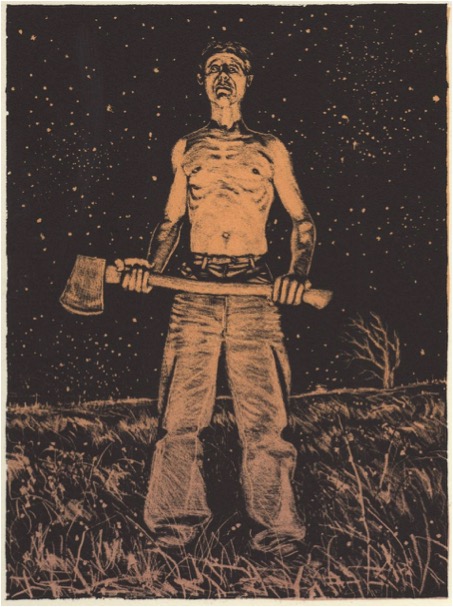
‘Skinny Man with an Axe’
Please discuss the size of your work and what the restrictions are?
Most of my prints have been small. Wood engravings are usually small due to the nature of the end grain boxwood. The smallness gives the work an intimacy, it forces people to go up close to the work and take in the detail, and maybe the poetry or narrative. I recently have started doing large scale linocuts which end up looking like huge wood engravings and provide quite an impact! It’s actually become an exciting development for me and the first big one I did “waiting for rain” sold out the edition of 50 in a year and gave me more money than I ever would have got for a painting that size. The down side is that they take ages to do. That work took me 3 months to cut, and it’s really tedious monotonous work! Still, I’d take boredom any day over the emotional torture of trying to paint! Also, I find it quite easy and I have a confidence that I never got with painting. That actually tells you something; but sometimes it takes a while for the penny to drop.
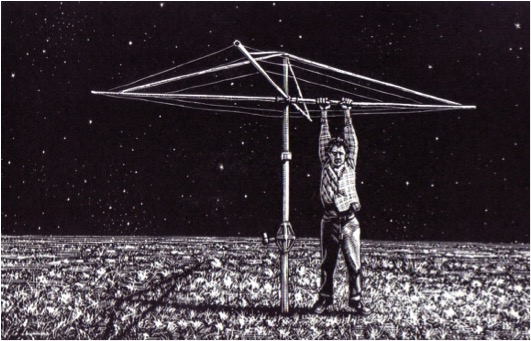
‘Another night on Earth’
In 2007 you took part in the International Print Biennale in Guanlan, China, where you became a major prize winner. How did this influence your career?
It gave me the confidence to know that my prints were technically good (at least sometimes). It was a real confidence boost getting that acknowledgement on an international stage where no one knew me from a bar of soap. I’ve been back regularly since for other biennials and artist in residencies. They think I’m a world famous artist and it’s nice to be treated like royalty once in a while. The last time I was there I was giving a show and I even got a billboard on the street, you don’t get that every day! Also it was good not only getting to meet other international artists and seeing their work but also seeing what the Chinese printmakers are doing. It was their big wood cuts that inspired me to try large scale linocuts.
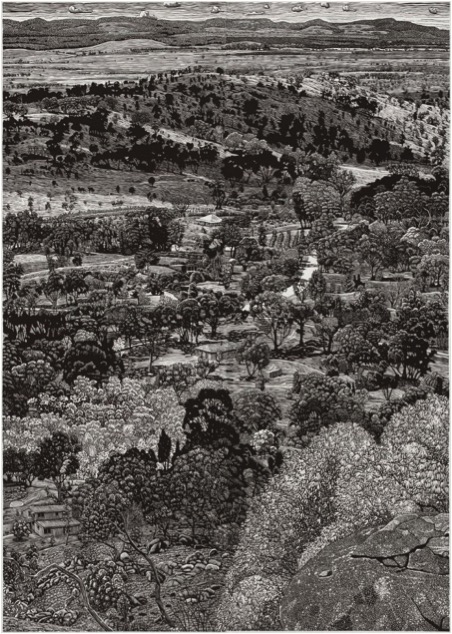
‘Waiting for Rain’
Let's discuss your prints:
The number of editions you make?
I used to do small editions but it’s really annoying when they prove popular and you don’t have enough to sell so now I do at least 50-70. I got to make a living.
What you do with the plates after the print run?
Sometimes I take my old copper plates to the metal yard as you get good money for copper now. I usually keep my wood blocks, sometimes I get them resurfaced so I can use them again. I’ll probably donate the blocks from my Paul Kelly book to the state library of Victoria.
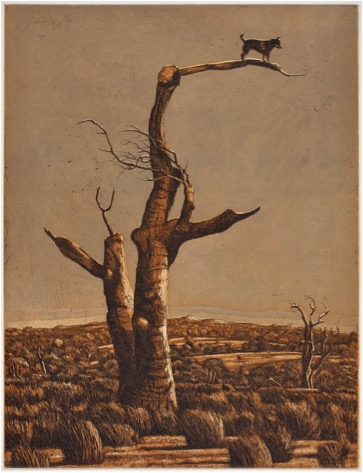
‘Lost Dog’
Your work is mainly about place. Can you discuss this common thread?
I love the duality of loving a place but wanting to escape it. I grew up in country Victoria, son of the school principal and a blow in (I’ve always been a blow in). The Wimmera where I lived in my primary school years is flat, with a certain melancholic beauty. It seeped into my system somehow and that landscape became the setting for my art. That environment though can be stifling and I used that to expand on the desires to escape it, to be somewhere more exciting and to be someone more exciting. Also I love the idea that you are afraid of leaving, and afraid of success. I used to often portray a figure flying over the landscape called “mr vertigo” who wanted to fly but was afraid of heights.
When to use colour and when to work in monotone, please discuss?
I’m on a bit of a black and white thing at the moment. Colour just distracts from the detail and the image I think.
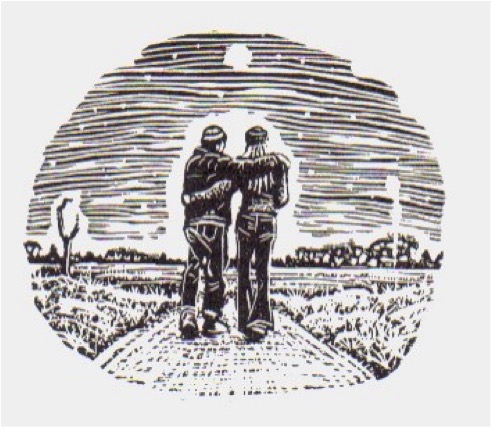
'Sweet Dream’
Can you explain the figure often seen on your roofs?
As a kid in the Wimmera I used to spend a lot of time sitting up a tree or on top of our roof, dreaming (I like to imagine) of escape. Also maybe it’s the Launchpad for flight.
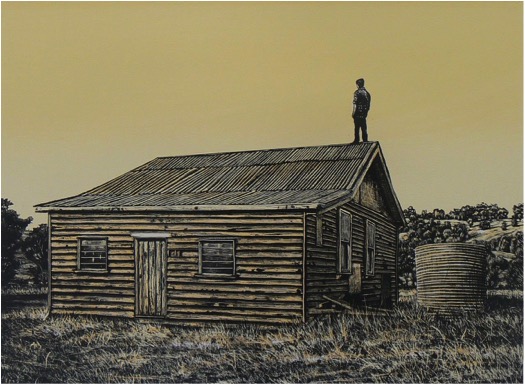
'Lonely Boy 111’
You have your work in many Galleries. Did you introduce yourself or did they approach you?
A bit of both. I was very lucky early on and galleries approached me. I’ve actually approached some galleries recently and met with rejection, it doesn’t always work out and it’s a very tough game. Also it will be harder for me now as most commercial galleries aren’t interested in taking on a printmaker. I have a couple of commercial galleries I’m with, one in Canberra, Sydney, Hong Kong and London. Port Jackson press in Melbourne sell my work and I have it spread around a fair few regional print galleries.
I’m freelancing a bit more now, most commercial galleries want you to be exclusive to them in that city and many now I find are getting worse at actually paying you and you get pretty sick of forever hassling galleries to pay you your 60%
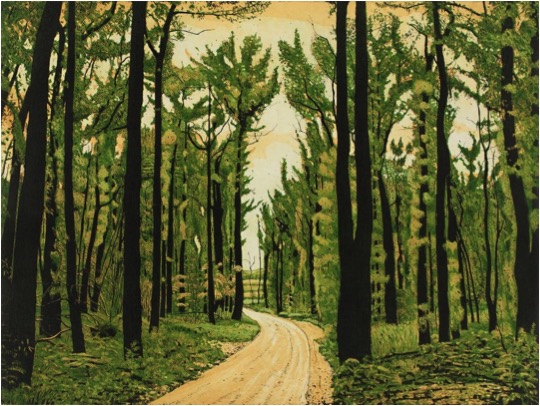
'New Life’
Explain the importance of entering acquisitive and award winning exhibitions?
I admit I’m pretty competitive so prizes have that attraction for me. It’s a lot of work though and it means bugger all really. You do get your work seen though and often it helps you to get into collections if you get acquired.
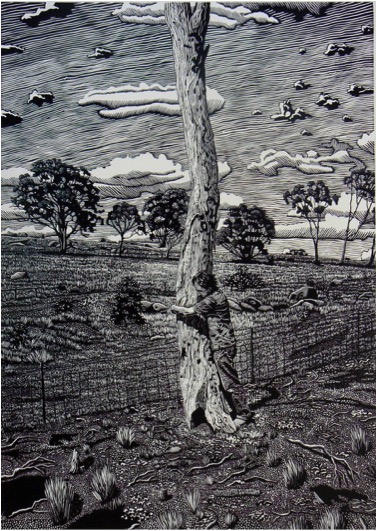
'Holding On’
Can you discuss your iconic caravans and how the first appeared and why?
There’s several things I love about caravans. One we had one as a kid and we used to have many a happy holiday in it. Also it’s such a loaded image, you can make them ambiguous, like is it for a holiday or is it a home? It creates that tension I love, like is it happy or sad, safe or menacing? They are also so humble. As well as those things they are great shapes with great colours!
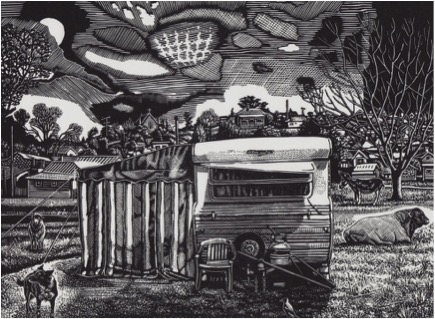
'Lost’
Discuss your work ‘Lest We Forget’. Are we likely to see a similar theme as we had on the 100 year anniversary of WW1 and our current involvement in war zones?
That image happened by accident. In 2007 the ABC (Australian Broadcasting Commission) did a doco on me as part of the artist at work series. In mine I went back to my old home town of Murtoa and go over my old haunts and make some art from it. It just happened to be Anzac day and so we filmed the formalities and the march. I loved the character of the old digger who led it and I knew it would make a great image. I intended the image to mean not just lest we forget the diggers but the old days and the old ways, the old dying towns, the old climate. It was a very moving experience. A couple of years ago that old digger actually died on Anzac day.
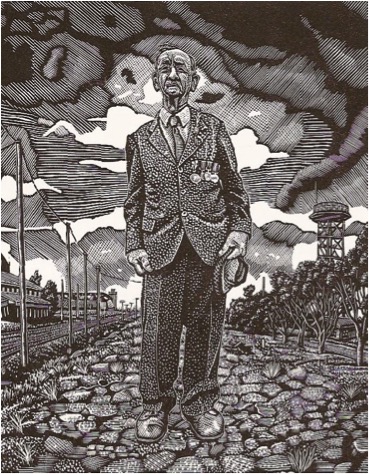
'Lest We Forget’
Humour plays a large part in your work. Please discuss?
Humour makes sadness much more powerful and accessible. I do a lot of images now on hopelessly confused and bewildered men. It’s a fertile subject, one I find sad yet also funny.
You are currently building a new home in rural Victoria, Australia. Will it include a studio? If so, what are a few of the must haves? If not, where is your studio and why do you choose not to work from home?
I’ve lived up here in Castlemaine for nearly 7 years. I was very lucky to be able to buy a relatively cheap double block with an old converted stables on it. I built a studio up one end and last year I sub-divided the place and sold the old stables. I made a bit on it and am now nearly finished building a new house. The studio is a big tin shed with a mezzanine and I’m a very lucky man. Its good working at home but the danger is that daily life issues can distract you.
I am fascinated with the daily timeline of artists, what would be a typical working day or week for your in the studio?
I try to be disciplined. I usually get into the studio by 9 and try to work a full day. I have young kids though half the week and have to do school pickups and shopping and cooking etc. My plate is pretty full! Every second weekend I have the chance to do some work too. I’m not very good at working at night. I usually just crash out in front of the telly and go to bed pretty early.
You also find time to teach. How and where are these classes held? Are you open to offers to teach in Australia or overseas?
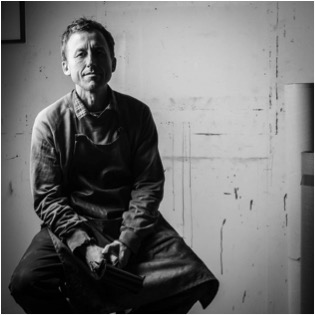 I have run lots of workshops in recent years, mostly wood engraving but sometimes linocutting and etching. I do one or two a year in my own studio and often at other peoples. I’ve done them all over Victoria and sometimes interstate. Sometimes in Sydney and Adelaide. It’s usually fun and a good way to supplement my income. I have a little press I can take in my car which means I can do a workshop anywhere (and I am happy to consider offers).
I have run lots of workshops in recent years, mostly wood engraving but sometimes linocutting and etching. I do one or two a year in my own studio and often at other peoples. I’ve done them all over Victoria and sometimes interstate. Sometimes in Sydney and Adelaide. It’s usually fun and a good way to supplement my income. I have a little press I can take in my car which means I can do a workshop anywhere (and I am happy to consider offers).
Contact details
defraz1@bigpond.com
www.dfrazer.com
David Frazer, Victoria, Australia
Interview by Deborah Blakeley, November, 2014
Elisa Confortini
Discuss your ceramic technique
What is it about clay that give you such pleasure in the creating?
What types of clay do you use?Where do you source your clay from?
Can you discuss the techniques you use with very high temperatures and how this achieves the results you want in your glazes?
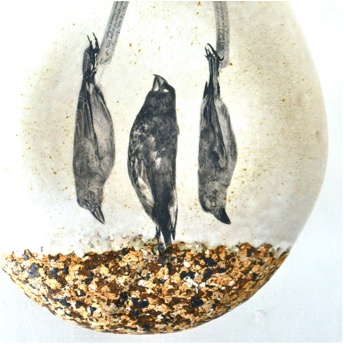
Although in Italy there is a long tradition of Majolica, and I also began using this kind of ceramic, I always loved the material resulting from high temperature firing: the color, the hardness and the strength of the earth, its sounds, and the natural colors of glazes. I use stoneware, porcelain and refractory clay, often combined as I love the contrast and the tensions that are created: the cool white of porcelain with the warm tones of the clay and the smoothness of the glaze.
The origin of the clay is various: stoneware from Germany, porcelain from France and refractory clay from Spain.
The process is manual, but in some cases I start with basic shapes, obtained in the mold, which then I complete or modify. I personally produce the glazes, preferring whites and soft colors, shades and those small imperfections that make the glaze alive and material.
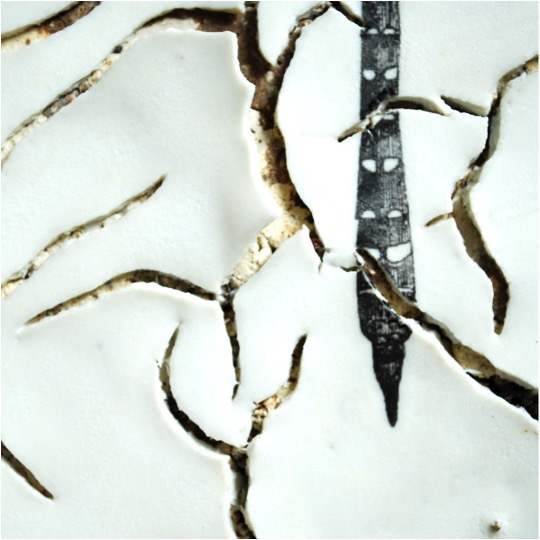
Detail
Your work has a very organic look and feel, please discuss?
I have a particular interest in exploring the sensorial, emotional and expressive qualities of natural materials. I'm passionate about collecting things even without an instant logic, listening to their form, their material, and I believe that this kind of feeling comes out even in my works.I work with synthetic and basic structures, because the primary element allows creativity to be free.Even in the world of forms there is space both for complexity and simplicity. Usually in my works complexity is delimited. Two opposite states of human soul: one calm and static, the other strong and dynamic.
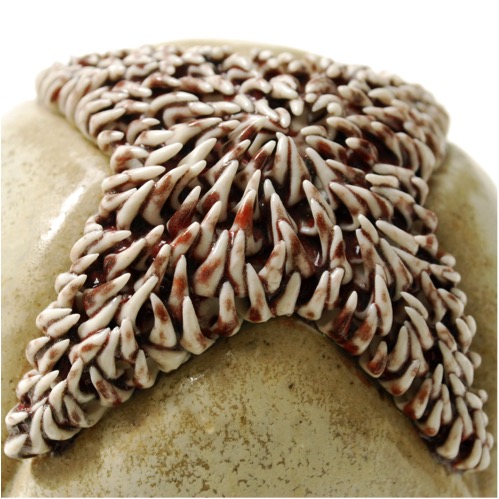
Can you explain the sizes of your work?
When making pottery, dimension of your work depend directly on dimension of the kiln you have. This could also be a limit. I realize unique pieces ranging from ten to about seventy centimeters. But I like to conceive my works as groups, combinations, starting from a theme I’m interested in and then creating a series of small changes. This allows me to go through an interesting research study, on structure or material, and to develop the creative process even during the final phase of my work. This way the pieces can have their own life either individually or as a part of a whole installation.
How did your residency in Fupling, China develop your work?
In 2008, I stayed at the Fuping Pottery Village in China. This experience was the award of the ICMEA International Ceramic Magazine Editors Association contest for rising artists. I was included in a group of Italian pottery artists working there from April to May. It was a very strong experience from both human and professional point of view. It was my first trip into a reality of life and work so different from mine and it was a turning point in my work and in my life. The people I met that time led me to new and unexpected tracks.
During the summer of the same year, I moved to Genoa for love, and not far away from the city, I started to spend time in the workshop of the sculptor Adriano Leverone. I consider him my mentor and the motive of an important professional growth. I was able to begin a research on high-temperature clays and glazes and I approached a different material - bronze - which I started using to realize some of my works.
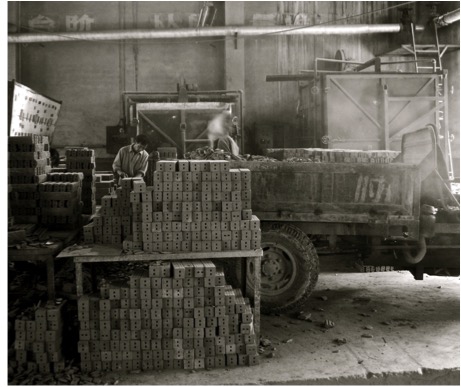
Discuss the importance of working with Enrica Negri from Milan to your art?
In the mid-90s, with Enrica Negri, my passion for ceramic material began. At the time I was working in the studio of a photographer and I remember flipping through a magazine and being fascinated by the work of this potter from Milan. I contacted her and I took a pottery class from her. I later attended other workshops, other classes but she represents my beginning in the world of ceramic, as well as Adriano Leverone has meant that in the world of sculpture.
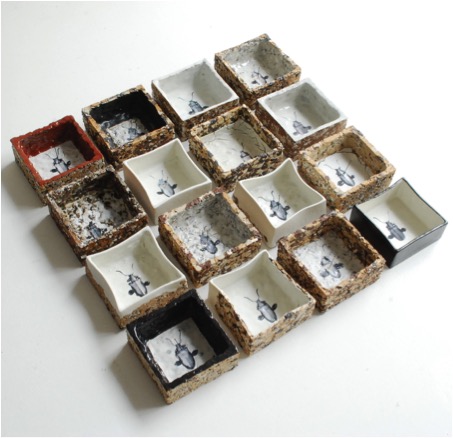
‘Entomological Collections’
Discuss the importance exhibitions have, and continue to have, on your work?
Exhibitions, biennials of pottery are the opportunity to present my work but also a comparison, a discovery. It is the way to get into the game and out of the atelier, to see my work in another context and obtain new inspiration. I consider this a fundamental moment of professional growth.
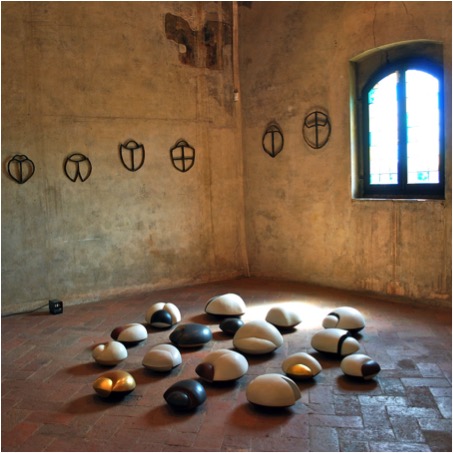
Expo Contreta 2010
Your studio
What lead you to open your workshop “Atelier99”?
How many people work in the workshop?
Can we have a peek inside the workshop?
Discuss the size (space) and the equipment
At first, I worked at home or in my garage with an outside gas kiln, or at other pottery makers. These conditions were temporary, and finally in 2011 I managed to open my workshop “Atelier99”. The room belonged to an old butcher shop, where I saved the hooks that are still on the wall. I redecorated everything to create a neutral, white space, very bright, perfect for working and highlighting the volumes and the tones of the sculptures. I work alone, the space is not very big but enough for two working tables, the 200 liters kiln, the wheel, the spray booth, and a small exposition area.
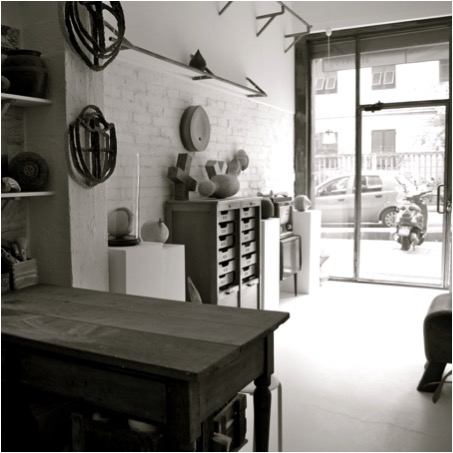
Explain the logo you have for your workshop?
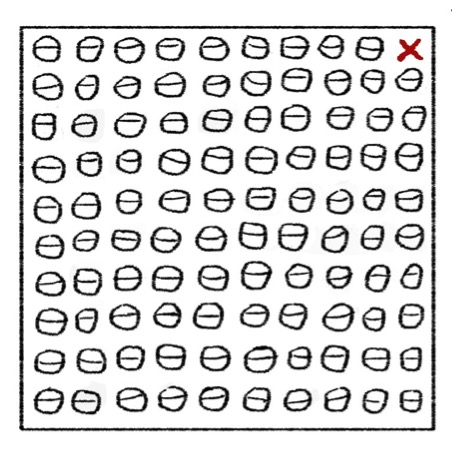
The name and logo of my workshop comes from a discovery: an old iron rack for bottles found in a country house. One hundred hooks available, but one missing: that’s why 99; 99 spaces for 99 cups. A number that becomes infinite as infinite is the variety of forms, colors, dimensions, textures to be created.
A simple object as starting point, always present, to characterize and recall the infinite possibilities. And the cup: essential, useful, universal, primordial, it bonds and becomes the symbol of present and potential creativity that accompanies us in any place and in any time.
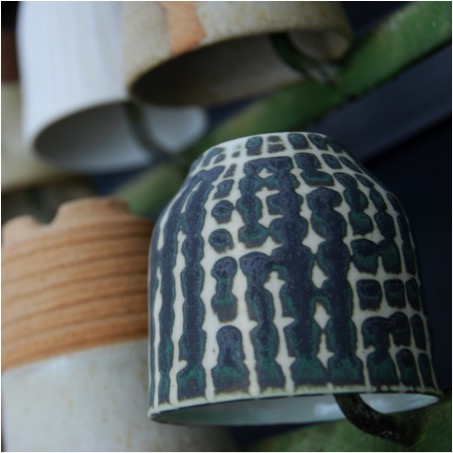
Can you discuss your current work and the addition of ‘Bug’ in the work?
Entomology has always fascinated me; I also studied it at the agricultural school. It has always been with me and now that I work with forms, it has come back to me powerfully.
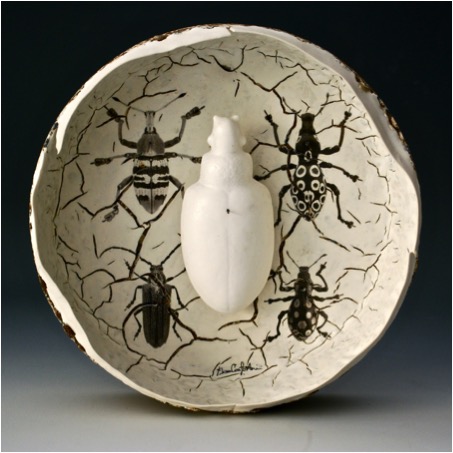
I'm fascinated by the incredible perfection, structure and variety enclosed in such small beings. They are fundamental in the balance of the world but they are considered insignificant or annoying, useless or harmful, to be eliminated or collected, but always to be killed. This is where my work starts with them: an ecological and environmentalist reflection on the use and the exploitation of living beings.
My “bugs” will lie on the ground, preserving just the memory of an event lived only by the primary spectators, leaving to everyone’s imagination the mental reconstruction of what it used to be and what it’s not anymore.

What are you currently working on?
I’m currently caring on the work about decals for the “Collezioni Entomologiche” (Entomological collections) by extending the theme to other creatures.

This way I’ve created “Vasi da Esposizione” (Pots to be exposed)
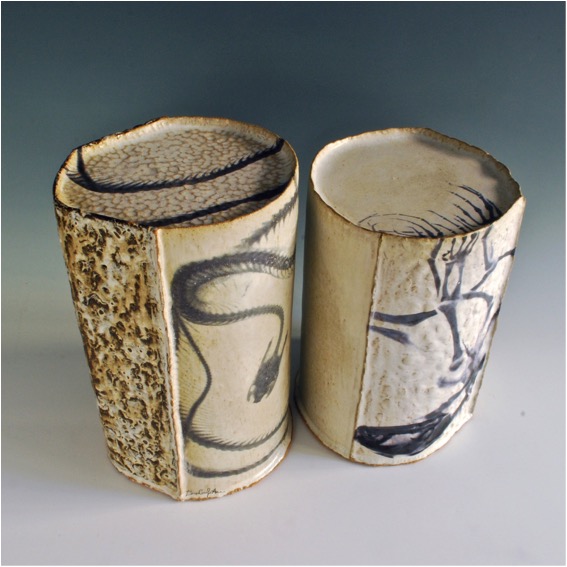
Vasi da Esposizione
“Nidi Violati” (Desecrated nests). Right now I’m working on images of birds’ skull, a meditation on the beauty and the weakness of life, between abstraction and memento mori.

Contact Details
Email:info@elisaconfortini.it
Elisa Confortini, Genova, Italy
Interview by Deborah Blakeley, November, 2014
Amy Nguyen
Please comment on your relationship with Mary Edna Fraser and where it has led you?
Mary Edna Fraser and I connected after I graduated from college. I had decided to stay in Charleston SC to work and was custom sewing for a local company. Mary Edna Fraser needed someone to sew her hand-dyed fabric into dresses for her daughters for a special occasion. I was inspired by her beautiful batiks after visiting her studio. When she visited my small studio and saw my paintings, she posed the question of putting my artwork onto fabric. I loved colour and creating on a blank surface and had grown up around textiles, so the idea was a terrific fusion of both. She planted some important seeds in my head that year and I am forever grateful to her.
I’ve seen Mary Edna Fraser just a few times since leaving Charleston. We connected at the Peabody Essex Museum, north of Boston, in conjunction with the World Batik Conference. At that time, she gave one of the best piece of advice: always do something new, no matter how small a change. I do try to practice this often. Slight changes keep me from becoming stagnant in my work.
Discuss the importance of shibori in both your early and current work?
In the beginning, shibori was the primary focus of my work. I experimented with a wide range of mark-making and colour-mixing. Now, my work is a balance of shibori and subtle textural components through stitch. The complexity in the work continues to grow. My stitching adds a layer of dimension to each piece. I will always enjoy shibori mark-making, but I will likely always enjoy, even more, the challenge of taking that traditional surface down a different path.
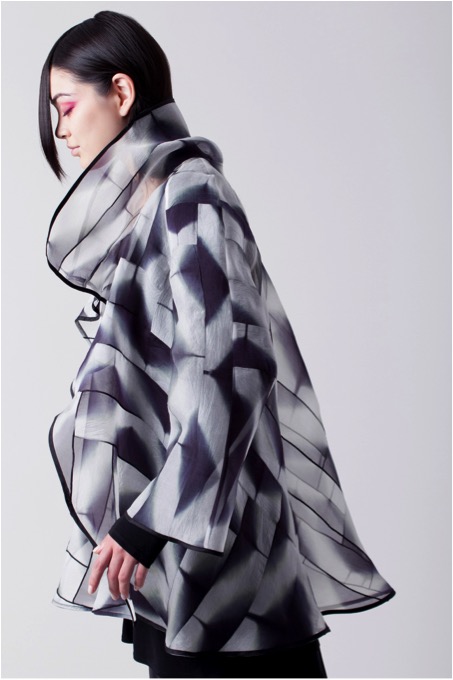 Do you still take Jason Pollen’s advice, to carve out a small bit of time each day to experiment with no outcome in mind?
Do you still take Jason Pollen’s advice, to carve out a small bit of time each day to experiment with no outcome in mind?
I really try to. Sometimes I’m not able to carve out as much time as I’d like. The business end of the arts can take an enormous amount of time with all the moving parts. But, I certainly appreciate the importance of carving out time to experiment and I come back to it as often as I’m able. I find it is always a good way to center myself when I don’t know where to begin.
Where has one of these small pieces of time lead?
These small experimentations have ended up in my sample books, to which I often refer. Each one leads to a slightly different textural technique. If I end up with a lot of the same grouping, or pieces that work together, I will use those pieces in a one-of-a-kind garment. Every thread is precious. I recently sold a one-of-a-kind coat to a favourite collector and she exclaimed, as we were admiring the piece, that it felt old and special. She had sensed the age of the fabric behind it. She sensed the soul of the piece. I suppose when you think of this question on that level, one could realize the collective importance of small things.
You work with a very limited palette, can you discuss this?
My early work was all over the place. It was not developed. I was beginning. In many ways, I feel like I stopped and went back to square one with black and white. I started to create shibori using a very limited palette. This allowed me to further develop my techniques, as limiting materials allows for more creativity in my artistic development.
I’ve always loved black and white, the contrast, the dimensionality, the tension between both. I go through periods where I love colour, but I often come back to black and white. While living in Boston I will always remember some time spent with Saundra Lane and her collection of black and white photography. Adams, Stieglitz and Weston pushed boundaries with only black and white. There is much to explore with everything and with nothing which these two opposing “colours” represent.
Explain your own shibori method of second layering?
Second layering is not part of the shibori dyeing process. I suppose it’s more abstract. It is my second part of process, or layering of process, when I deconstruct and remake the shibori by piecing, layering, tearing, or other methods of fabric manipulation. The dyed cloth is so beautiful on its own, but I find this compulsion to add weight, to make the fabric feel more grounded and to put my own mark on it. Thread is that weight. Stitching helps the piece to feel real.
What base fabrics do you use?
I love all natural fabrics. Mostly I use linen, silk, cotton and wool. When I first began creating shibori, I used man-made fabrics that could be heat-set to change the structure of the fabric. I don’t mind using man-made fabrics if they are recycled or repurposed, though the hand of natural fabrics is what I love most
Can you discuss the blending and balancing of the artistic, spiritual and physical in your work?
When I am deep into a day of dyeing and sewing, the process is very physical and repetitive and this allows me to meditate. I have recently started to practice tai chi and I find I am most focused after a class. I often find myself back in the studio. When my head is clear, artistic inspiration can spring up from doing the most basic daily things. Artistic, spiritual and physical all can become one in a moment of flow. Or, they can at least influence each other. There is a balance that must exist in order for me to create.
Explain your thoughts on keeping age old textile traditions within modern fashion?
I believe we have a need to retain tradition, pride in our community and our history. Modern fashion must exist as well, but with careful consideration of its effects on the environment. There should be a balance of old and new. For example, my dye techniques are by hand. Some of my stitching techniques are by machine. We are small-scale and care about every piece. It shows.
I don’t agree with disposable fashion. We have become a society of much waste and fast-paced consumption that is affecting the earth. I like the idea of having few pieces, well-made that express who you are. I certainly recognize that items like socks, underwear, leggings, basic black clothing need to be affordable. These items can be mass-produced as long as the company that is producing them stands behind protection of the environment, sustainable practice, and fair pay. As consumers, we should be asking where things were made, how they were made, who made them? In order to keep some of the old tradition, we can ask these questions of designers and support those who work the most fairly. We can support local stores. We can support smaller stores. And when we buy those particular pieces to express who we are, I think we should buy less of them…and really cherish what we have.
You emphasise the importance of handmade in your work. Why is this such a major part of your textiles and finished garments?
I’ll never forget the collector who recognized the soul in the coat I’d made – who sensed there was older fabric in the piece. Part of the cloth that went into that particular piece was from my mother’s stash of sewing fabrics. It was a beautiful silk/linen ivory cloth intended to be a suit she had wanted to make but never got around to making. This was a special moment for me – to have someone truly understand the soul of a piece. That is also why part of my work is handmade. There is an inexplicable soul in anything made by hand. I firmly believe in this. It is in direct opposition to fast consumption. We slow down – not just those making it, but those wearing the pieces as well.
Explain your interpretation of ‘Slow Textiles Movement’?
Slow movements, in general, represent a cultural shift towards slowing down the pace. The slow food movement has gained considerable momentum and now, I believe, slow fashion is following. We should know where our food comes from and how it was handled. We should know who makes our clothing and where it comes from. It really is just about being more present and more aware of the world that surrounds us. This is the main premise behind the slow textiles movement. I’m also paying attention to how we work in the studio, what I pay my interns, what we recycle and, most importantly, the quality that is going to a collector.
There is another layer to this for my work. Many of the pieces that we create are considered wearable art. Additionally, they involve an aspect of art, of craft and of fashion. These pieces have emotion behind them, they are made up of highly skilled technical craft and they are relevant today. Adding all of these additional layers creates pieces that are true works of art. They are authentic and people deserve this.
Couture is a word that we relate to high fashion. Your work has that very high finish. Can you discuss the importance of this?
Many processes, technical skill and collaborative work are all certainly a part of the pieces created here in the studio. The same could be said of couture. We have 4 different aspects of process and each one is of equal importance. First, the creation of the surface design work – the dyeing of the cloth. Next, the fabric manipulation and intricate stitching of the cloth. Third, the patternmaking of the garment shapes – turning two-dimensional into three-dimensional. And last, the finishing or very detailed final touches. Couture pieces are a true reflection of the artist. I feel each piece made should be both a true reflection of myself as well as of my respect for the craft and history behind each aspect of process.
The photography of your work is beautiful. Can you explain how you achieve such wonderful images?
In the beginning, my husband and I took our own photographs, which were flat and lacking in dimensionality. After viewing numerous headless shots with mediocre lighting, I came to the realization that we needed to collaborate with professionals who understood the emotions I was trying convey. I strive to create masterful work in the studio. Each person with whom I collaborate is doing the same in their own field. When great collaboration happens, it’s because the ego disappears and each person understands their role and yet has respect for each other. This ensures that each photograph evokes the feeling that existed in the creation of the piece. My goal is to seek the best in every aspect of what we create and to know that I cannot do it all. I’m not the photographer or the artistic director or the stylist, yet we all have a similar vision. In that room, I am only the artist/designer, one part of the whole.
Do you design seasonally? How do you add to the collection?
I add to the collection as process develops or changes or if something inspires me. I don’t create collections such as fall, resort and spring. Most of my pieces can be worn at least three seasons in different ways. That’s what I like in my own clothing. I find the less clothing I own, the better I feel. When I update a piece in my own wardrobe, another piece gets donated. I find it’s best to have pieces that work well and can be worn often that are loved each time they’re worn. When we love our clothing, we possess a wonderful energy. I care more about creating the garment with thought and care then making sure I have a collection available on a particular date. Each season does influence us some and I always offer some aspect of work that makes sense within the season. I love linen, for example. People say it’s only for summer. What about quilted linen?
What is one basic garment you would not be without?
A wrap (which can become a garment). I use one in the summer, in the winter crinkled and bunched as a scarf and during meditation.
Contact details.
amynguyentextiles@gmail.com
www.amynguyentextiles.com
Amy Nguyen, Boston, MA, USA
Interview by Deborah Blakeley, October, 2014
Athena Jahantigh
Poetic Gazelles - series
Can you discuss the way you have been able to use simple gestures of the gazelles, to give different characters to these beautiful animals?
I started with a gazelle first with its head turned backwards. It was a slightly different reproduction of a model I had previously made in porcelain. Here I wanted to change, I wanted to give it a little bit more movement while remaining close to the main forms of the first model. I wanted it to have the look of a true gazelle turning its head down, looking left or right or raising its head etc... I had fun changing the movements of my imaginary gazelle in an exaggerated way and that's where we can realize the power of imagination in creation.
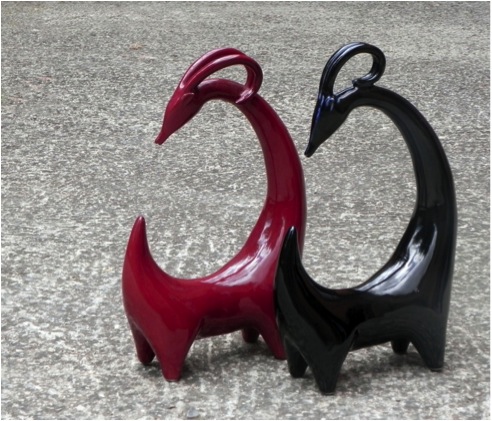
The size of the work:
The tallest gazelles in the series "Poetic Gazelle" can reach 30 cm.
The technique you have used to make the gazelles:
The gazelles are made in black faience and hand built, from clay slab strips. I always start with the legs and I finish by the horns or ears...
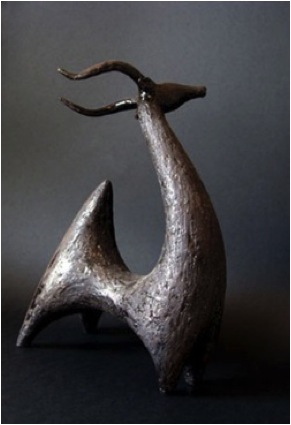
What animals do you use in some of the series?
To date, the animals I've made are categorized as follows: horses, gazelles, bulls, rams and goats, and birds. Apart from these few animals, I made a cat one time. I think that there are cultural and symbolic reasons.
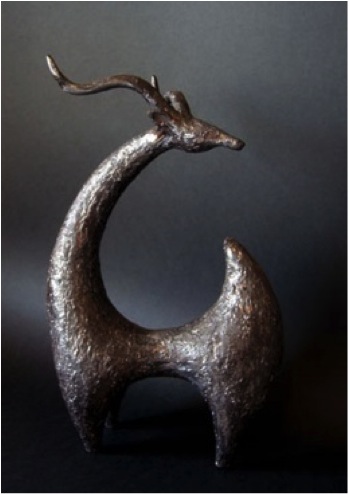
Why not make an elephant or a rabbit? I can say that I love almost all animals in the nature, some because of their beauty, and others for their strength. Some amaze me with their intelligence and others by their affectionate or extraordinary side. There are too many things to see, to observe and to feel to be able to express them in a sculpture. I don’t see any point to present in my work all kinds of animals because I make animal sculptures, I prefer to focus on those that have a special meaning to me. The four legs (the general term I use for some of my animals) mentioned above are animals that have existed for thousands of years in Iran, my land of birth. They are drawn and made in sculpture since the time of my ancestors until today. Of course there are others, but here comes my choice and my personal desire.
Where did you watch and study gazelles?
During my art studies in Iran, for the theoretical part of my thesis, I studied the drawings on ancient pottery in Iran. One of the cities studied, "Shahr-e Soukhteh" (meaning Burnt City) which was founded in 3000 BC, had many drawings of gazelles with a characteristic: the tail of these gazelles raised up. It is from these drawings that I imagined and drew my first gazelles.

Shahr-e Sukhté (meaning "[The] Burnt City"), also spelled as Shahr-e Sukhteh and Shahr-i Shukhta, is an archaeological site of a sizable Bronze Age urban settlement, associated with the Jiroft culture. It is located in Sistan and Baluchistan Province, the southeastern part of Iran, on the bank of the Helmand River, near the Zahedan-Zabol Road. In July 2014 it was placed on the World Heritage List of UNESCO.
The reasons for the unexpected rise and fall of the Burnt City are still wrapped in mystery. Artifacts recovered from the city demonstrate a peculiar incongruity with nearby civilizations of the time and it has been speculated that Shahr-e-Sookhteh might ultimately provide concrete evidence of a civilization east of prehistoric Persia that was independent of ancient Mesopotamia.
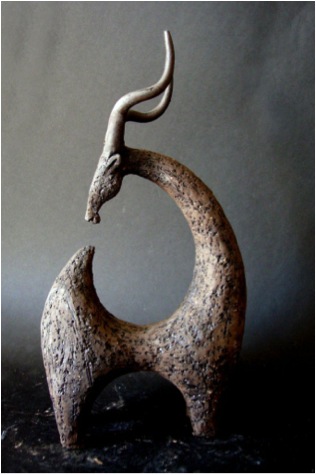
Do you work from sketch books or photographs?
Sometimes I study pictures of animals or observe them in real and near. But there is above all the legacy left generously by our ancestors all over the world (and particularly in Iran for my work): designs on pottery, on the cave walls, large and small sculptures or containers in the shape of animals. That forms a magical mix that whets my imagination and allows me to draw. My work is never made from a specific drawing or photo, although sometimes consciously or unconsciously I’m close more or less to an already existing form.
From Legs without Leg – series
Your series ‘From Legs Without Leg’ - where did this simple but exciting idea come from?
My animals are divided into two groups: birds and four legs. "Four legs without legs" was a series made for an exhibition in Paris. It started with some stylized rams up to the point that their legs disappeared and then some goats and other animals in the same spirit, they were different from those that I used to achieve. So I decided to name them by their differences.
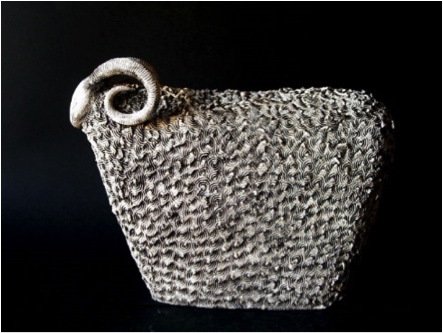
Through the use of texture and curved horns you have allowed the viewer to know the animal. Can you expand on this idea?
The horns, in addition to being beautiful and delicate, are also the symbol of the strength of the animal. But it is the hair and the texture created to imitate them that make this animal looks like a ram or a goat instead of a gazelle or antelope. Although in this series the horns and the hair texture are two main elements to recognize the animal, in the end, it is a whole set of elements that reminds us of a particular animal. For example, I do not see myself making a gazelle with a rectangular body.
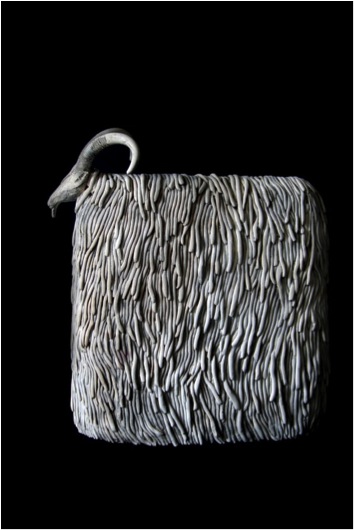
What is the material you have used?
Most of the pieces in this series are half- glazed white faience. The enamel is used to give more color to the piece but particularly to bring out the texture.
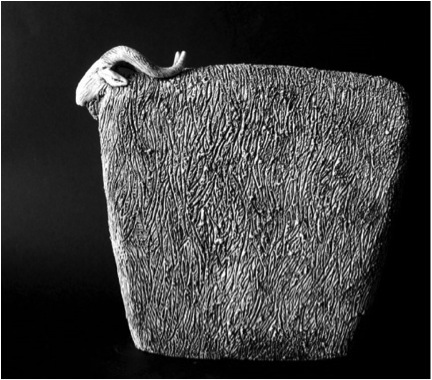
Can you discuss the size of this work?
The height of the pieces of the series varies from 20 cm to 40 cm.
Discuss, the simplifying of shape in this series?
In "The four legs without legs" series, I tried to remove a maximum of detail in terms of shape, as when we are watching a herd from a distance: details are gone. The body of a “four legs” can practically fit into a rectangle. The fact that some “four legs” have hair such as a ram makes it easier to make their legs disappear and get them into this rectangular shape, and this accentuates at the same time their skin and texture characteristic .
Birds - series
Are they actual birds or rather representations?
My birds are only representations and do not correspond to a particular species. Some are limited to a form which can remind us of a bird. Since nearly always, a bird is the symbol of freedom, especially the flying bird, I prefer to represent it sitting, resting or asleep. These symbols of freedom will remain forever at rest and at peace: they do not need to fly to be free.
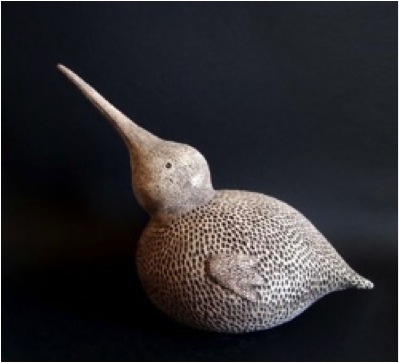
Again explain the importance of texture to get the feel of feathers?
One of the first reasons I added a texture to a piece has been to overcome a technical problem. At first, I didn’t have the opportunity to work sandstone, only faience. I didn’t like the texture of the pottery after firing, and I prefer sculptures without enamel and without patina. I looked for another solution to cover the works: texture. In the end, texture had become an indispensable part of my work, as if not adding any texture left the animal naked. A passion that requires to be patient, and I continue to used it in my work even on sandstone
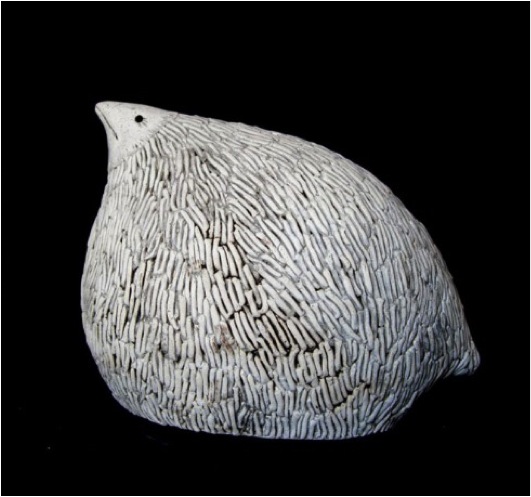
Sandstone Animals - series
Can you discuss the difference in your sandstone animals?
My latest works are presented in the series of sandstone animals. My inspiration travels between past and present, between my roots and my imagination. My sources have not changed, regards the technique, there was a big change.
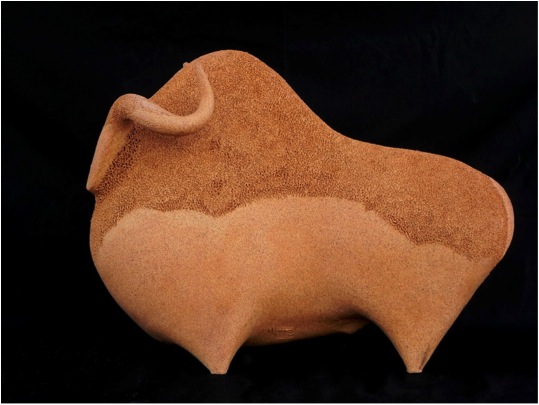
Thanks to this new clay, I was able to significantly increase the size of my works, limited only by the height of my oven (71 cm). There are different colors of clay that are beautiful, but as I mentioned above, it has become difficult for me to make a piece without texture, so most of the time they are “dressed” with texture. These are often created by repetitive movements cutting or adding material and they do not take precedence over the main shape. The texture becomes the poem offered to the earth…
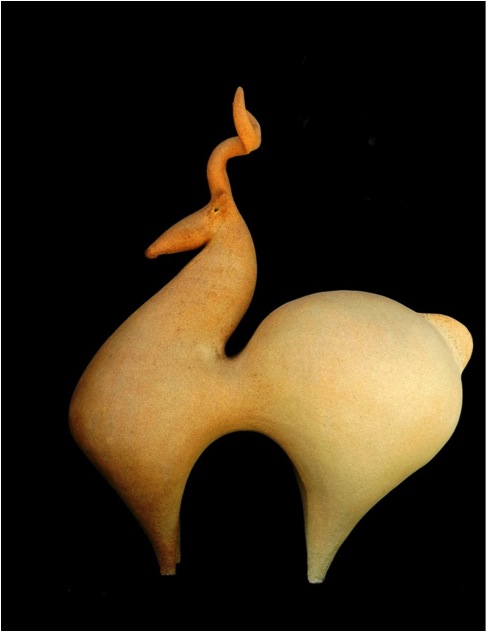
The pieces are fired at 1280 ° in a gas oven with oxygen reduction. They are manufactured and hand-modeled with clay slab strips. I always start with the legs and I finish with the ears or horns.
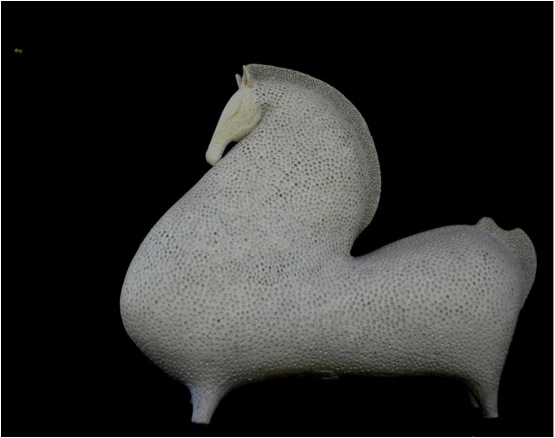
You began your studies in Iran, can you briefly discuss the academic availability for yourself in Iran up to 2006?
I studied Art for four years in Iran. My father, a painter and art teacher, allowed me to have some knowledge about art and gave me the desire to go on in this way. I started my studies in 1996 at the University of Art in Iran, during which I specialized in ceramics.
What was the factor in you going to France to study at the Sorbonne in 2005, and then to go onto your Masters of Fine Arts there?
Since I was young, I wanted to go to France or Italy to study. At that time, the history of Art in these countries, their museums and cultures fascinated me, especially France, which I had read several historical novels. Finally, I had the opportunity to come to France to follow at first a master of fine arts in 2005 and then a doctorate in fine arts that I got in 2012. At the beginning, I wanted to do graduate studies in ceramics, which was not possible in France. I chose the visual arts, a choice I do not regret because it allowed me to know other artistic universes.
Discuss the importance of Art and international travel for a woman from Iran?
It is not always easy to go to another country to study, especially from Iran. I think the opportunity to make art and to travel to learn more and be able to interact with strangers, whether you are a woman or a man, regardless of where you come from, it's an extraordinary chance.
About fifteen years ago, an unmarried Iranian woman needed the permission of her father to get out of Iran. Today this law no longer exists, and there are many more girls who are studying art than boys.
Can you expand on your own position as an Iranian woman artist in today’s climate?
Being an artist in Iran is not at all difficult. Art and poetry are an inseparable part of our culture with all its ups and downs. Whether, you are a man or a woman, you can continue your art without any worry under the condition; that the object of your art does not criticize the current politics or religion, also your art is not about nudity.
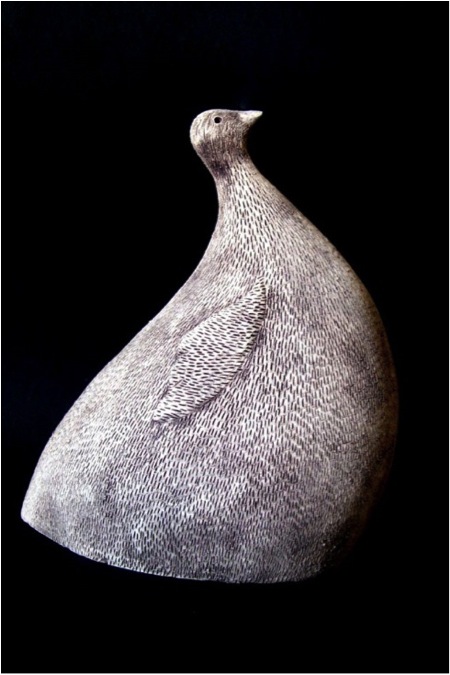
Contact Details
Email: athenajahan@gmail.com
Web: http://www.athenajahan.com
Athena Jahantigh, Iran & France
Interview by Deborah Blakeley, October, 2014
Meg Little
Explain the importance your move to Cornwall, in the UK, was to the development of your art in rug making?
I moved to Cornwall in 1984 right after getting my Masters Degree from Rhode Island School of Design. I walked into Plymouth College of Art and Design and introduced myself to the Crafts faculty and I eventually taught there. One of the lecturers told me that there was another American weaver living nearby: Grace Eckhert. She was a tapestry weaver who was beginning to experiment with hand tufting. We became friends and she let me use her tufter while she was on holiday. I had taught myself to weave in high school and have two textile degrees but in those years I’d also started to paint. Painting is more immediate than weaving and using the tufter gave me the same freedom as painting but in my preferred medium. It was a revelation. We spent 6 years in Cornwall and I do feel as if I also absorbed some of the design sensibilities of other UK artists.
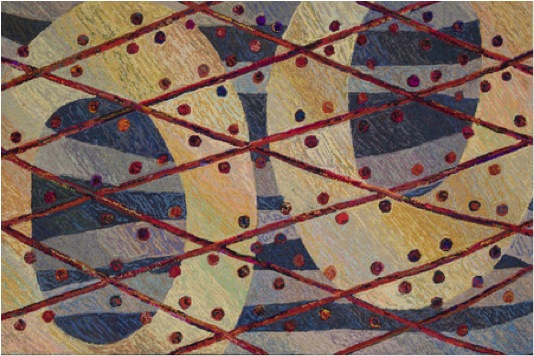
'Sudd’
Can you discuss the relationship you see between rug making and tapestry?
In both traditional tapestry and woven pile rugs, one makes the web of the cloth while also laying in the design which covers up the web. Hand tufting is actually more like embroidery; one decorates the previously woven web. This means that the design is not laid in on a grid and is free of that underlying structure. Weaving is a very linear process and any design gets built in that way. With hand tufting that constraint is lifted.
Explain the actual mechanical process of tufting, as you do it?
Hand tufting is the way that commercial area rugs are made if they aren’t woven. My tufter is electric and has two hollow needles that the yarns slide between. The top needle has a point that spreads the web of a backing cloth which is stretched tight on a frame, and the bottom needle has a tongue that shoots the yarn into that space. In front of the needles is a foot like on a sewing machine that helps advance the tufter forward. The yarn is shot into the cloth in a continuous loop following the direction of the foot.
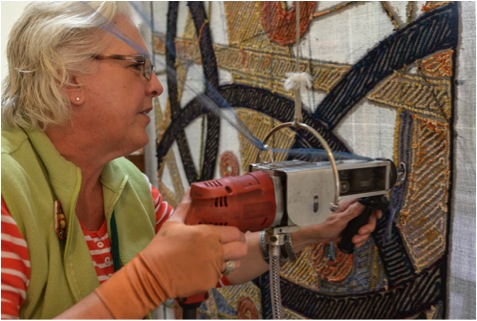
Meg at work in her studio
Discuss how this process has allowed you to use textiles as your paint brush?
The cloth can be filled in with whatever gesture one likes. I personally use a forty-five degree angle to fill in for the most part, which is similar to the way I sketch. Although the process is nonlinear it differs from painting in that the details are applied first and the background goes in last. And unlike weaving, there is the possibility to change elements after they have been layer in which I couldn’t do with my weaving.
The process is very similar to the French Tapestry method – you work from the back. Can you show how the work looks from both sides, how you manage to work “back to front” and why it is done this way?
Working from the back is dictated by the technology.
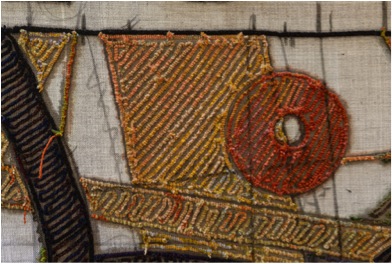
Back of the work
I always reverse my drawings so that the front of the rug is true and I tend to run around to the front frequently to see how things are progressing.
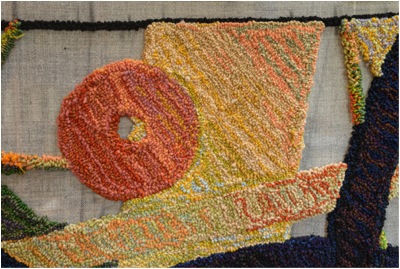
Front of the work
You work on a horizontal loom and not a vertical loom. Can you explain why?
They aren’t woven- no loom. I work upright so that I can get to the middle of the rugs and so I can see the front easily. The tufter really couldn’t be used any other way.
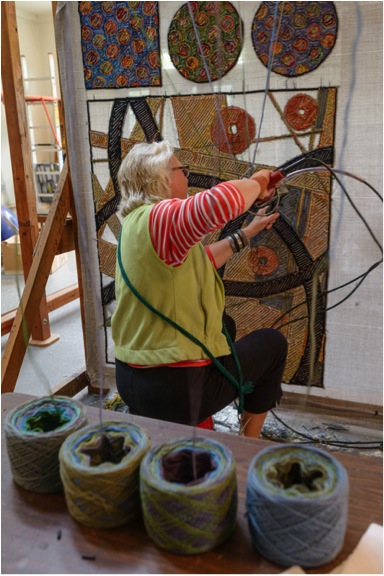
Meg at work in her studio
What type of yarn do you use and why?
I use 2 and 3 ply rug wools made specifically for carpets and rugs. I mix all the yarns in very complex color combinations blending four balls of yarn together in the tufter. Each ball has a different combination of related yarns, sometimes with some very surprising “wild cards”. As a former weaver I can never resist a complex optical color mix- more is more! Each color mix has about twenty-five different yarns in it.
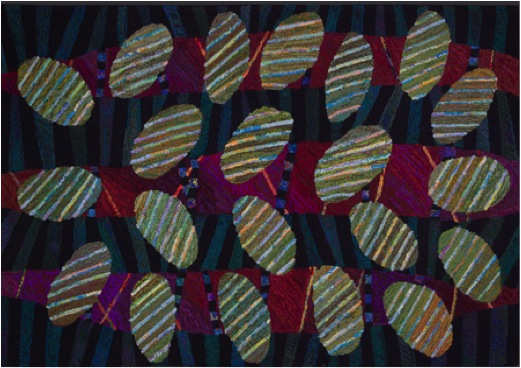
'Arborvitae'
How about the dying of the yarn, do you dye or purchase pre dyed yarn?
All the yarn is commercially spun and dyed for the carpet industry. Hand tufting is an industrial process and I follow industry standards in making my work. I may make them myself but the rugs are definitely meant to be walked on.
Discuss the limitations of size in your work?
I can make any size rug up to 15’ x 20’. The cloth that I buy from Germany for hand tufting comes 17 1/2’ wide so one dimension needs to be 15’ or smaller. I put a cap at 15’ x 20’- that seemed a good place to draw the line. I’ve made one rug that big and it was a beast! I’ve made lots of big rugs, including round rugs up to 10’ diameter and hall runners as long as 25’. Recently I had an exhibition of only room sized rugs. It was wonderful to see them on such a grand scale.
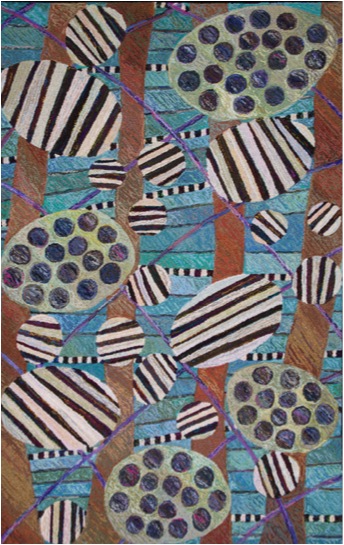 'Paradise'
'Paradise'
Expand on how you are now constructing the “whole” rather than working a design on the background.
I came to hand tufting with very little idea of what to “put on” a rug. My previous weavings were minimal sculptural pieces although very concerned with color. I had very little recent experience with pattern although I’d been apprenticed to an ecclesiastical embroiderer before going to Tyler School of Art in Philadelphia. As I found my way, I discovered that through every culture and across all time there’s a common pattern language. The building blocks are the dot, the line, the square, the circle. I was delighted to find examples from every corner of the world and I have explored all the permutations. I love that I can be a part of a long continuation of makers and that my work reflects an ancient decorative tradition or some other part of the world.
For the past dozen years I’ve only been interested in the expressive geometric. As I mined the various combinations and re-combinations of these shapes I became aware that even though my designs were constantly evolving that one thing hadn’t changed. It goes back to the idea of embellishing the backing cloth. I usually took my wonderful jazzy circles, stripes etcetera and put them on some kind of mostly static background. I don’t necessarily think of “decorative” as a dirty word, but I did recognize eventually that there was something missing. If you think of the way music is layered, it was as if the bottom notes were missing. After that thought I began to demand more of the backgrounds. I didn’t wish for the rugs to become more pictorial, I just wanted the whole band instead of the trio. It gave me endless possibilities for the good old circle, square, spot and stripe to meet up in new and surprising ways.

'Taiga'
Some of your rugs have text - how and when do you use text and why?
I’ve been using text off and on since the beginning. It’s a challenge; the letters are all put in backwards and also sometimes upside down. My interest comes from an admiration for the Bayeaux Tapestry which has written commentary and for Matisse’s cut outs which sometimes included words. The words are another form of pattern and a narrative too. On the last rug I made with words the only way to read it on the floor is to walk all the way around the edge. This seemed appropriate since the rug is a journey through the four seasons. I’ll let you in on a secret- along with the initial charcoal underdrawing on the backing cloth I sometimes include poems or prayers. You’ll have to get an x-ray to see those!
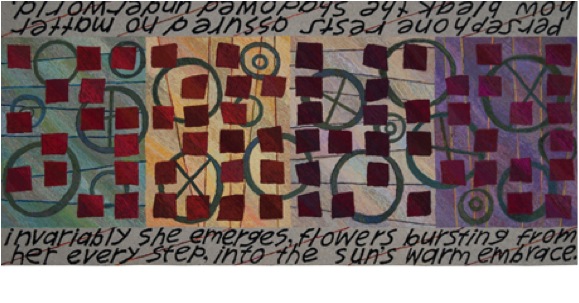
'Another Year'
Your rugs are designed to be walked on but many are hung. Can you tell us your thoughts on both and also the method you suggest to hang a rug?
I love the way my rugs look on the floor. They get better looking as they get older and they are very luxurious under foot. I know my work has changed a lot from the days when the rugs were just artful to now where they are considered art. The rugs may now have a more profound meaning but they’re made the same way as when they were strictly decorative. So it seems specious to me to say they are “too pretty to walk on”. They are still perfectly functional and why wouldn’t you want something beautiful under your feet?
Hang it or don’t, it’s up to you, but as to hanging- it’s easily done with some carpet tack strip and some tiny nails.
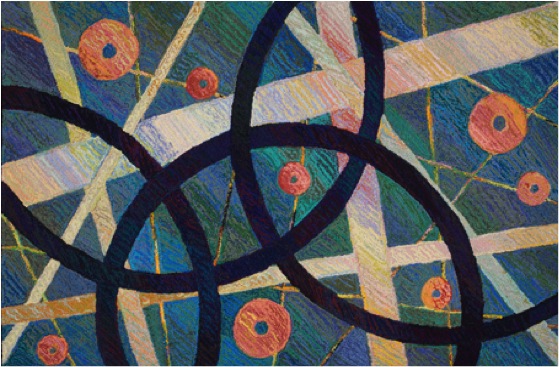
'Cassiopeia'
You are very interested in having handmade around us. Please expand on this?
When I was writing my Masters thesis I researched why humans spent the extra time to decorate objects for us when it would have been quicker to make plain things. The answer seems to be that there is a human drive to make things “special”, to make the ordinary extraordinary, to celebrate and consecrate our daily lives. Even if you go back to prehistoric times you will find special objects for use including fancy bits of weaving.
People buy my work because it was made by a person and more so, one that they’ve probably met. That’s the kind of object I want in my house and I know I’m not alone.
Do you exhibit?
I exhibit as often as I can. Besides museums and galleries I show my work at high end retail craft shows- about a half dozen a year.
Do you do commissions?
A lot of my work has been commissioned. In the early days there was a lot of tinkering by my clients. Now that the work has such a distinctive look the requests are generally for a special size. I love working with people and seeing their houses if possible. It would be great fun to make a giant piece for the lobby of a building either floor or wall!
Explain the importance of Sketchbooks to the development of your work - from inspiration to finished piece?
I keep at least one sketchbook on the go at any time. I draw in pencil with a yellow No. 2 pencil (for those not in the States- that’s an HB with an eraser). In fact if we can only take one thing on the spaceship to Mars, that’s what I’d take. I draw to scale: an inch to a foot. No color- that comes later when I gather the yarns. I used to feel weird about that until I read that Bonnard would go for a walk, make his pencil sketch and then pick a palette from one of his porcelain plates of color. He’s got to be up at the top in terms of color.
I’ve had the habit of keeping a sketchbook since my undergraduate years at Tyler. Some days are good drawing days and I’ll make a whole series of sketches. I spend a lot of time gathering inspiration by looking at other artists and cultures. It all ends up in my sketchbooks. I’ve found if the drawing is good, then the rug will be good. If the drawing is unresolved then I usually leave it. When I’m ready to make a new rug I’ll riffle through the drawings and find one that speaks. At that point I decide the mood of the colors. I consider the drawing to be the bones and the color to be the meat. Recently I’ve realized that I treat my smaller sized rugs, the 3’ x 5’ size, as an extension of my sketchbook. This is where I try out new color combinations since they’re pretty quick to make.
Contact details.
www.meglittle.com
onthespot260@gmail.com
Meg Little, Rhode Island, USA
Interview by Deborah Blakeley, October, 2014
Gráinne Cuffe
Can you discuss the techniques you are currently working with?
I am currently working with traditional etching techniques: aquatint and line. I use Ferric acid, and work on copper plates.
Over the years you have taken inspiration and academic direction form far and wide. Discuss the importance this diversity has had on your art?
Especially as a younger person, I felt a huge need to leave the comfort zone of familiar surroundings, be that studio or home town. An appetite for academic direction led me to the Tamarind Institute, in New Mexico, where I successfully completed a Master Printer course in Lithography. In hindsight, even more formative an influence than the Tamarind experience was the Fulbright Scholarship with was a brief visit to Gemini Editions in Los Angeles, where I saw gorgeous huge etchings of David Hockney’s beautiful simple silhouettes, profiles of heads. These etchings were approximately 4 Feet x 4 Feet. Plus an exhibition of James McNeill Whistler’s etchings, in the Boston Museum of Fine Arts, which I saw on the return leg of the Tamarind trip to the States, was also a huge influence.
Every studio I have ever worked in has its own ethics and set of reverences. In Giorgio Upiglio’s Grafico Uno in Milan, an Italian government Scholarship, I was intensely impressed by the woodcuts of Mimo Palladino, their graphic sophistication and simplicity, and mostly the intensity of saturated colour, and their large scale. While Central St. Martins in the late eighties opened my eyes to tonal value with aquatint.
Coming in more closely, can you comment on the influence Norman Ackroyd had on you art?
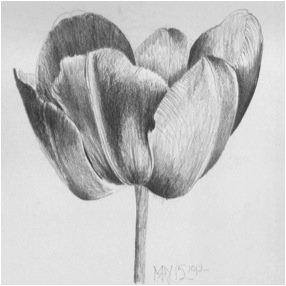 Norman’s theory was that you could get all the colour you wanted using black ink, and white paper. He was strict about this. He taught me for 2 years at Central St. Martins, London. I added a touch of blue, or green to the black, to survive the restrictions. He wanted us students to push those tonal values as far as possible, and using tone to make light/colour. This generated a love of the mesmeric qualities of aquatint.
Norman’s theory was that you could get all the colour you wanted using black ink, and white paper. He was strict about this. He taught me for 2 years at Central St. Martins, London. I added a touch of blue, or green to the black, to survive the restrictions. He wanted us students to push those tonal values as far as possible, and using tone to make light/colour. This generated a love of the mesmeric qualities of aquatint.
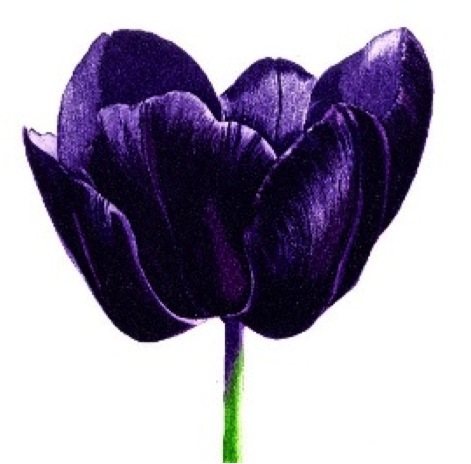 The Chester Beatty Museum is a worldwide must-visit while in Dublin and a generous supporter of the art world. Discuss the exhibition and your involvement with the Chester Beatty Museum?
The Chester Beatty Museum is a worldwide must-visit while in Dublin and a generous supporter of the art world. Discuss the exhibition and your involvement with the Chester Beatty Museum?
How did you become involved?
From my first visit as a 12 year old to the Chester Beatty Museum, I had felt a strong connection to the graphic work I had seen there, especially an iconic Japanese screen of staggered irises, a show of Albrecht Durer’s etchings, Mughal paintings, and many precious and beautiful watercolours and prints from Japan. Frequent visits to the Museum never fail to amaze, always feeding the visual appetite for more...this collection has fired the imaginations of many members of the Graphic Studio, and the delights of gardens seemed to be an interest common to both the collection, and to our members.
We felt that collaboration between the two institutions could benefit both, and make for a successful show. Hugely generous with their time, curators of varying sections of the collections introduced the artists to pieces we had not seen before.
What it was like to become a co-organizer of Gardens of Earthly Delight?
It takes a lot of meetings to organise a show like this. It is great to work out all the many details together, and exciting when the show is up and selling. It feels like one is giving back to the Studio. It was a hugely successful show, and a wonderful collaboration between 2 iconic Dublin institutions.
Can you tell us a little about the Chester Beatty (for those who don't know about its collection)
Sir Alfred Chester Beatty 1875 -1968 collected treasures of beauty and wonder dating from 2,700 BC to the present day. Egyptian papyrus texts, Japanese woodblock prints, European medieval and Renaissance manuscripts, Books of the Ancient world…now in this vibrantly run, small Museum. Housed in a purpose built building within the confines of Dublin Castle in the City Centre, The Chester Beatty is always an inviting treasure chest to visit.
What's it like having your work in their collection?
It is a huge honour and I am extremely proud and pleased to have 2 pieces of my work in the Chester Beatty Collection.
You joined the Graphic Studio in 1979. Explain the importance of both the studio, and collaboration with other printmakers has and still has on your art?
The Graphic Studio offers me all these positives:
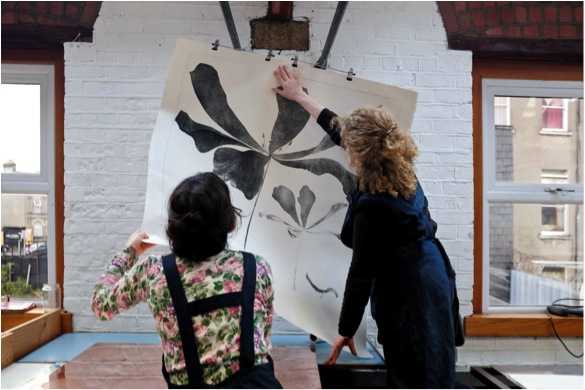
- Sharing technical information about the work.
- Being in an atmosphere of work.

- Exposure to approaches radically different to one’s own to the making of an etched image.
- A wide variety of visual language in terms of the final image.
- The talk about the making of an image.
- The enthusiasm about visual language.
- The shared love of paper, colour, the end effect.
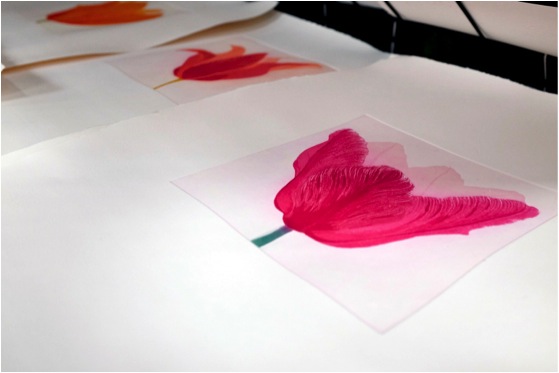
- The shared fascination of the progress of an etched image from start to finish.
- Constantly meeting Painters and Sculptors who come there to work collaboratively with Master Printers on the Visiting Artists program.
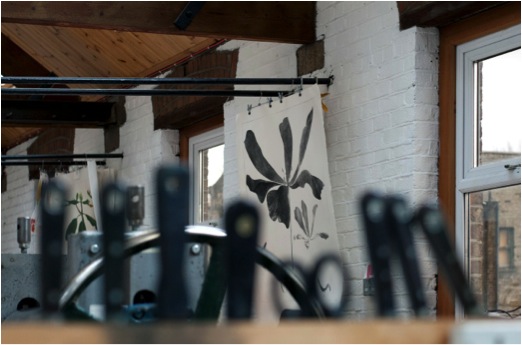
The Graphic Studio Gallery which the Studio owns, show my work.
Collaboration with other printmakers in my case currently means I need to work with another well trained printmaker on the larger pieces because it would be physically impossible to achieve the printing a successful print on my own. The weight of the large plates is considerable. They need 2 people to handle them. It would be counter- productive to work on these on my own. It is at the colour proofing and editing stage that I need to ask a skilled printmaker to work with me. Inking up the plate may take hours, and you have to be time-aware, because some ink colours dry and will not print properly.
Your work is described as BIG can you explain the constrictions that size place on your art within the printmaking field?
The main constriction is the size of the press bed in Graphic Studio. My metre square plates fit easily, with ample room around the plate. As I use my studio in Wicklow for working on the plates, I have recently invested in a wonderful new acid bath from Polymetaal, Holland, which easily fits the larger plates. I love BIG. The generosity and expansiveness is good.
Expand on your work ‘Delphinium 11?
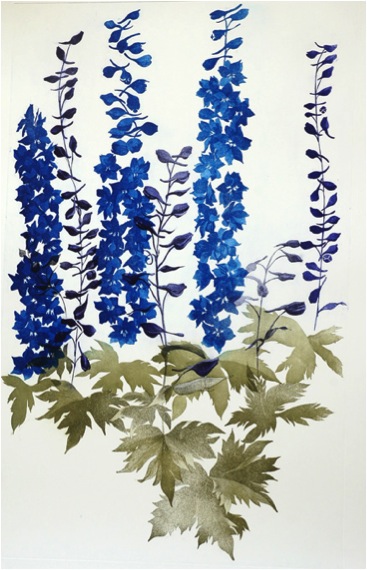
Thinking I was totally finished with Delphiniums, recently having completed Delphiniums I, Delphinium II was inspired by a large stand of wondrously stunning delphiniums on a sunny June day in a neighbour’s garden. The leaves articulation is different to Delphinium I, more 3dimensional, and with a variety of bright greens. The blues and purple-blues are also different. In that garden, I felt a bit more could be said to honour the Delphinium statement. I felt I hadn’t said it all, yet.
You call ‘Clematis orientalist’ “the big one”. Can you explain this?
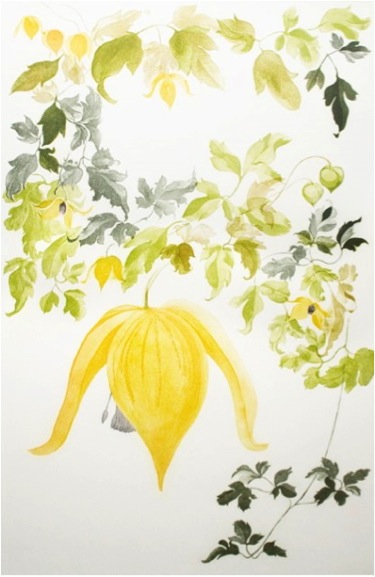
Clematis Orientalis III is a large rectangular 4’6”high x 3’wide etching. I have made 2 smaller etchings of the same plant, for A Natural Selection - a show which was originally a fund raiser for the Studio, 100 artists contributing a limited edition print, image inspired by National Botanical Gardens, Dublin.
You work with both plants and flowers how would you categorize your work?
In describing my work, the most accurate words are: Loosely Botanical.
That might be a category?
By adding that Georgia O’Keefe, the American painter, has been an influence will give a sense of clarity.
I have never been able to describe my work with accuracy, using words.
Your work has such a very strong Botanical aspect, discuss?
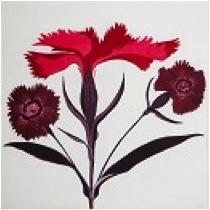 Adding in explanatory elements of visual interest is a nod towards Botanical illustration of the past, where much information is on the page. My extra elements are there because they balance a composition, and are very carefully balanced in themselves. They are not intended to be botanically accurate. Some plant elements are extremely sensuous visually and although tiny, are magnificently beautiful: wonders of design, and the Bauhaus principle ‘Form follows function’.
Adding in explanatory elements of visual interest is a nod towards Botanical illustration of the past, where much information is on the page. My extra elements are there because they balance a composition, and are very carefully balanced in themselves. They are not intended to be botanically accurate. Some plant elements are extremely sensuous visually and although tiny, are magnificently beautiful: wonders of design, and the Bauhaus principle ‘Form follows function’.
When working on both exhibition layout and print size how do you decide on the size of the work?
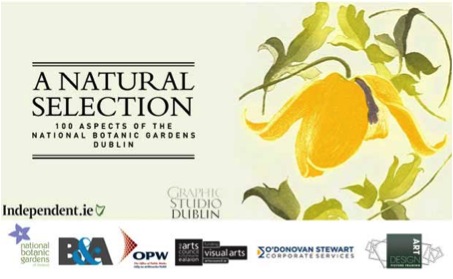 Exhibition layout is usually a balance between large and small works, depending on the constraints of the gallery. In deciding about the size of an etching, if I feel an image of a plant will make an adequate visual impact, then the large format will work. At the drawing stage this is assessed. Drawings may start on a small scale, then develop into a larger format. The plant also has to have enough visual drama to hold its own on a large scale. Often, holding a magnifying glass to a plant is the only way to see the detail.
Exhibition layout is usually a balance between large and small works, depending on the constraints of the gallery. In deciding about the size of an etching, if I feel an image of a plant will make an adequate visual impact, then the large format will work. At the drawing stage this is assessed. Drawings may start on a small scale, then develop into a larger format. The plant also has to have enough visual drama to hold its own on a large scale. Often, holding a magnifying glass to a plant is the only way to see the detail.
If you want this detail to be a part of the image, scaling up is the only solution. Degrees of admiration and wonder and recognition of a magnificence [to do with the visual impact] play a part.
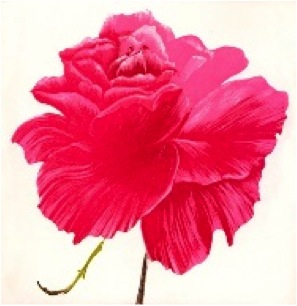
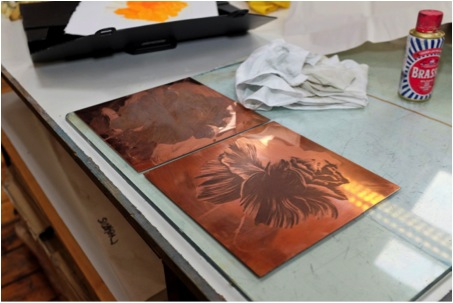 Where do you find your subjects (plants and flowers)? Are you, like many, a keen gardener?
Where do you find your subjects (plants and flowers)? Are you, like many, a keen gardener?
As a great admirer of the world of plants and flowers, yes, my subjects are mostly from my garden. If I was to let myself get swallowed up by my very wild garden and the notions it inspires, I would never get an etching either started or finished.
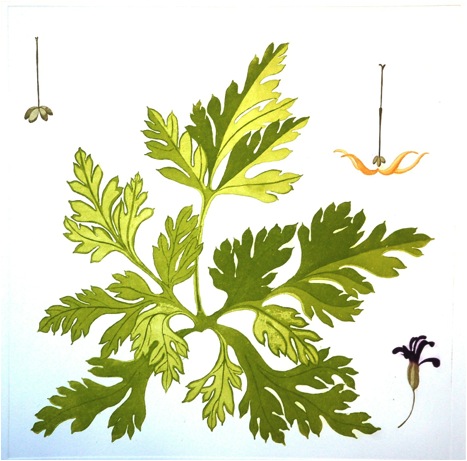 Many of your works can be found in hospitals and also at the Dublin Family Law Courts. Do you see your work as calming? How would you describe it?
Many of your works can be found in hospitals and also at the Dublin Family Law Courts. Do you see your work as calming? How would you describe it?
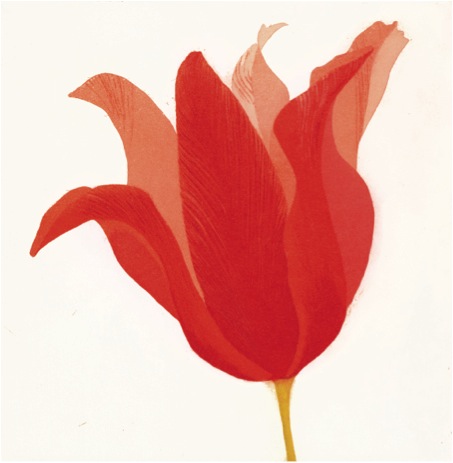
Some of my work is calming. I relish calm. In calm, I get space to think thoughts, have new ideas, and make progress with the etchings.
Calm lets people breathe about the goodness of themselves, potential for happiness and positivity of life.
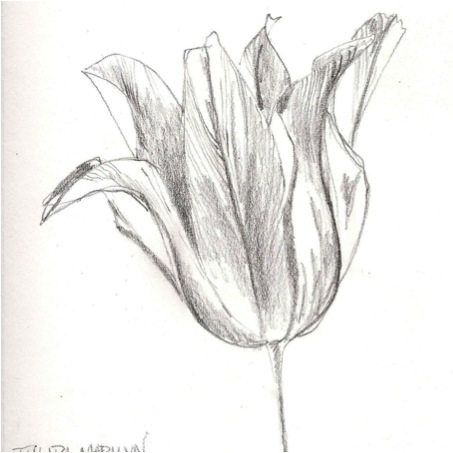
When the ingredients of balance, calm, sensuousness are at an optimum in a piece that is when I feel it is acceptable. A visual harmony has been worked towards and concluded.
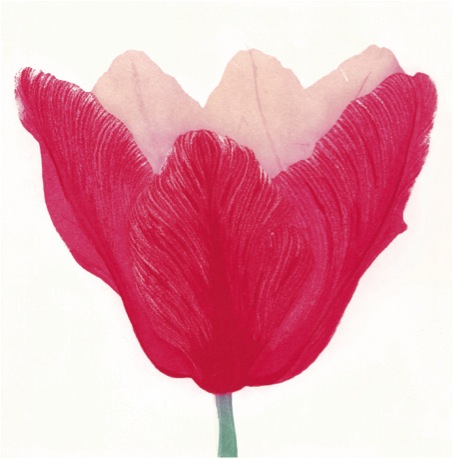
Although being collected by Museums etc. is wonderful, having my work in places where people are stressed is important to me. I have had excellent feedback about my work in the above; a settling down of upset and raw nerves.
Contact details
grainnecuffe@gmail.com
http://www.grainnecuffe.ie
Gráinne Cuffe, Dublin, Ireland
Interview by Deborah Blakeley, October, 2014

